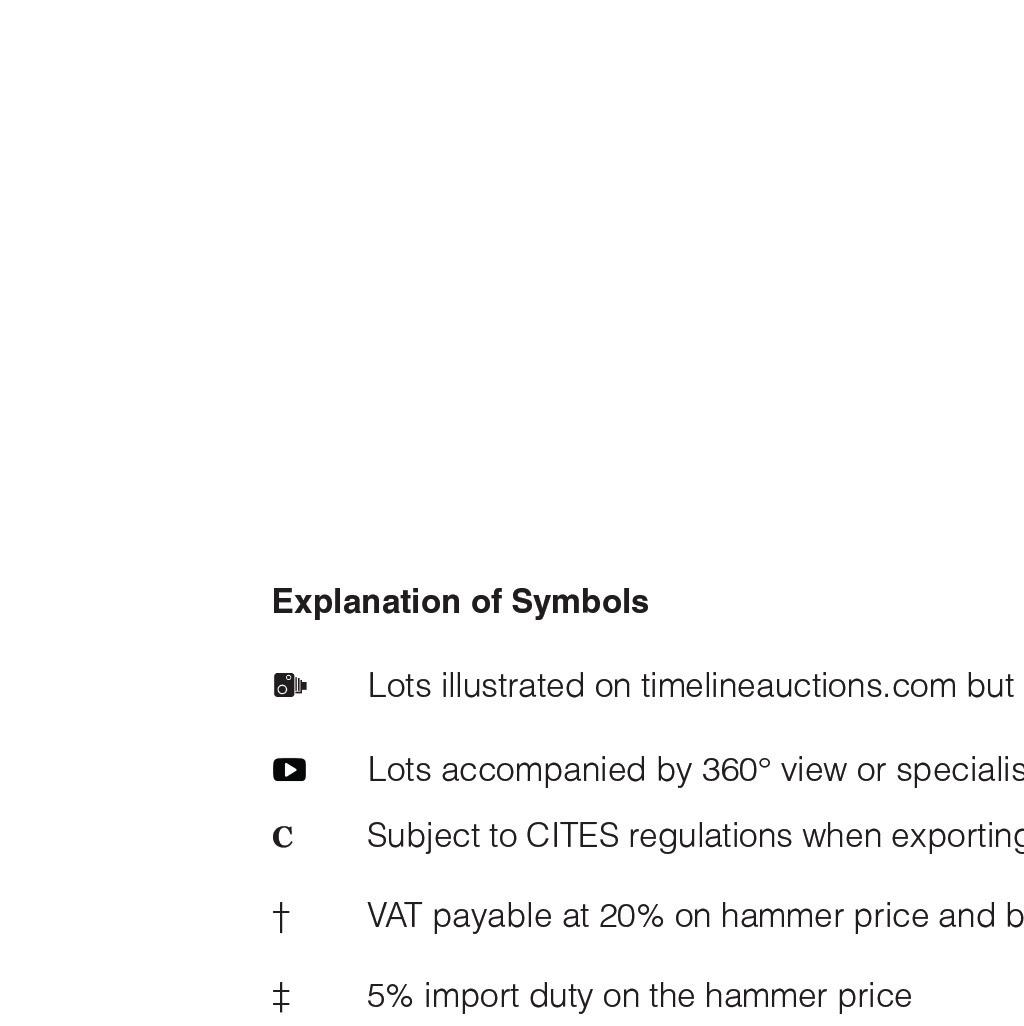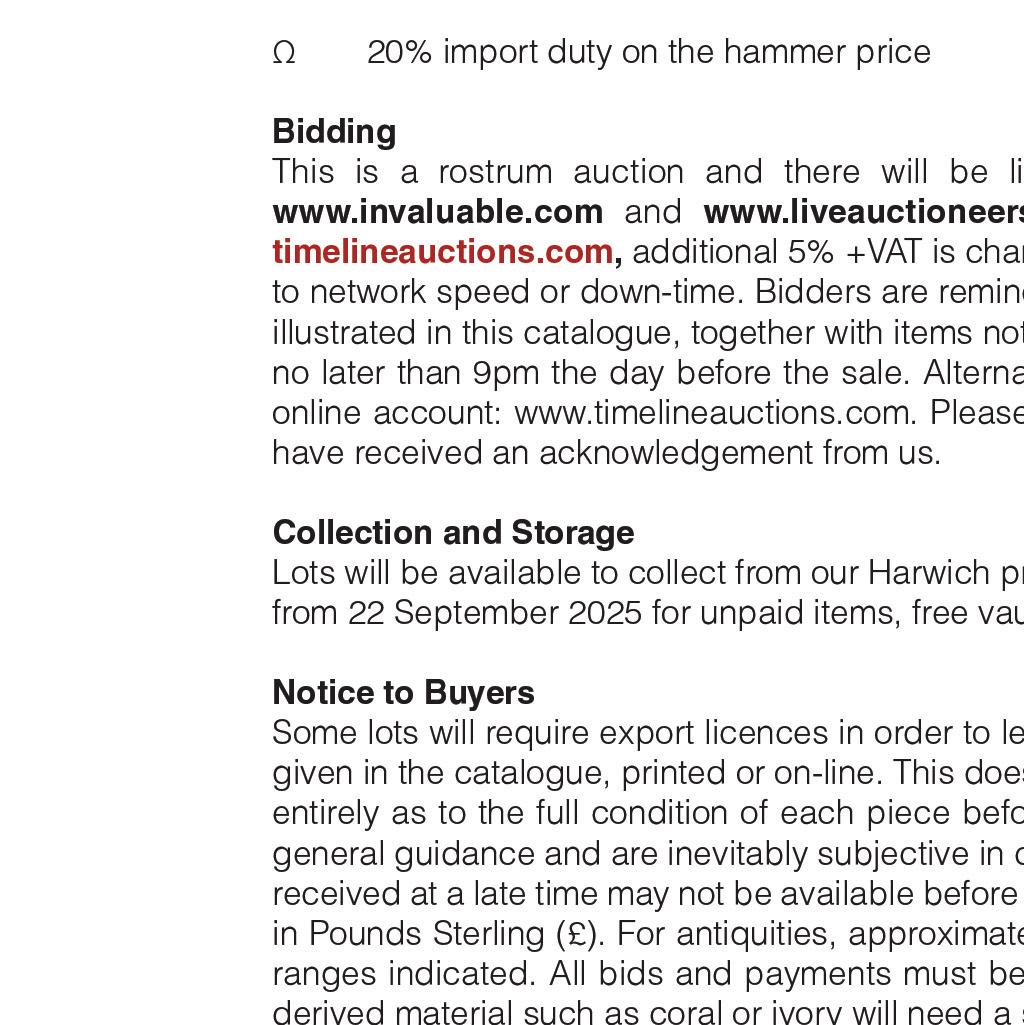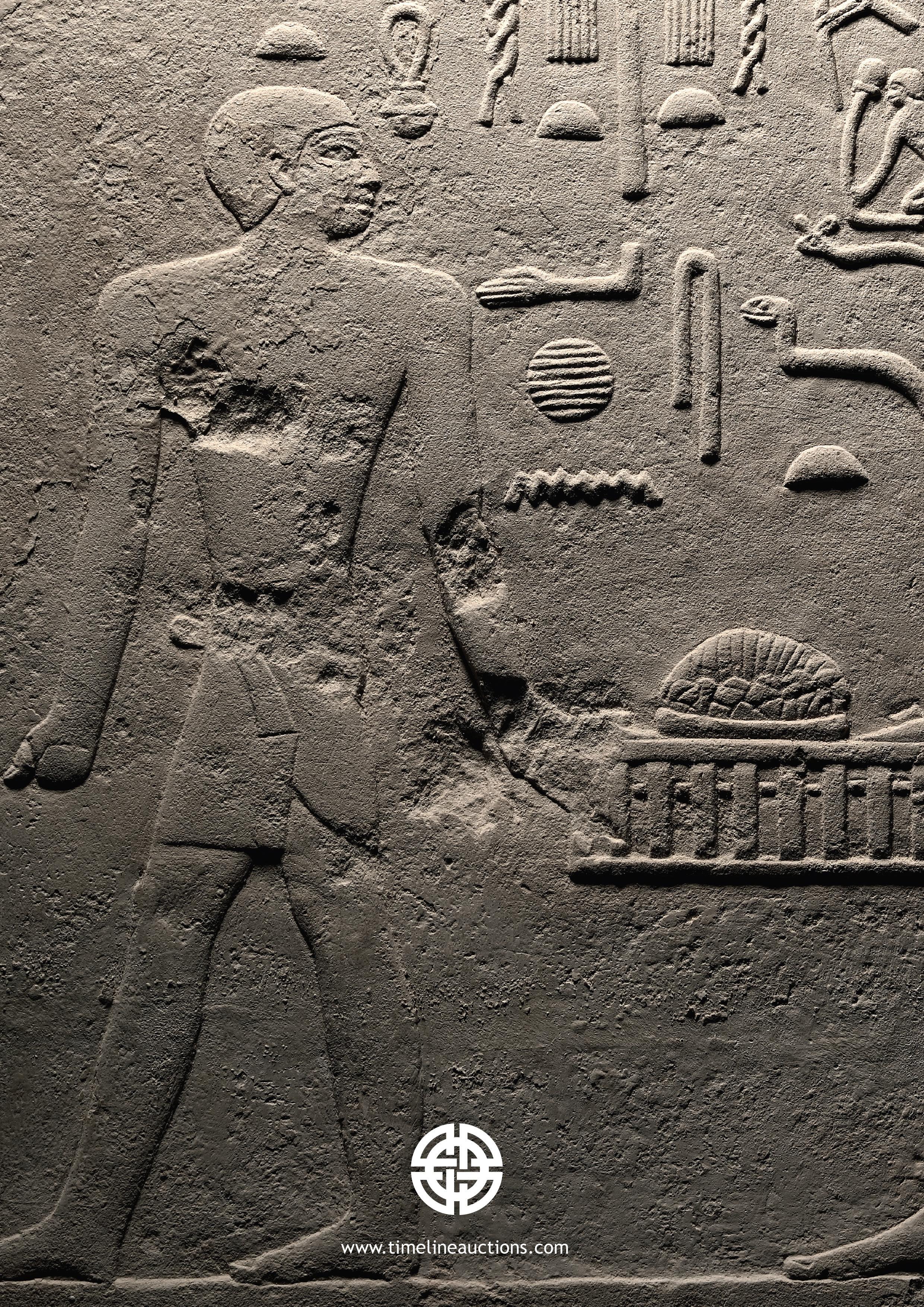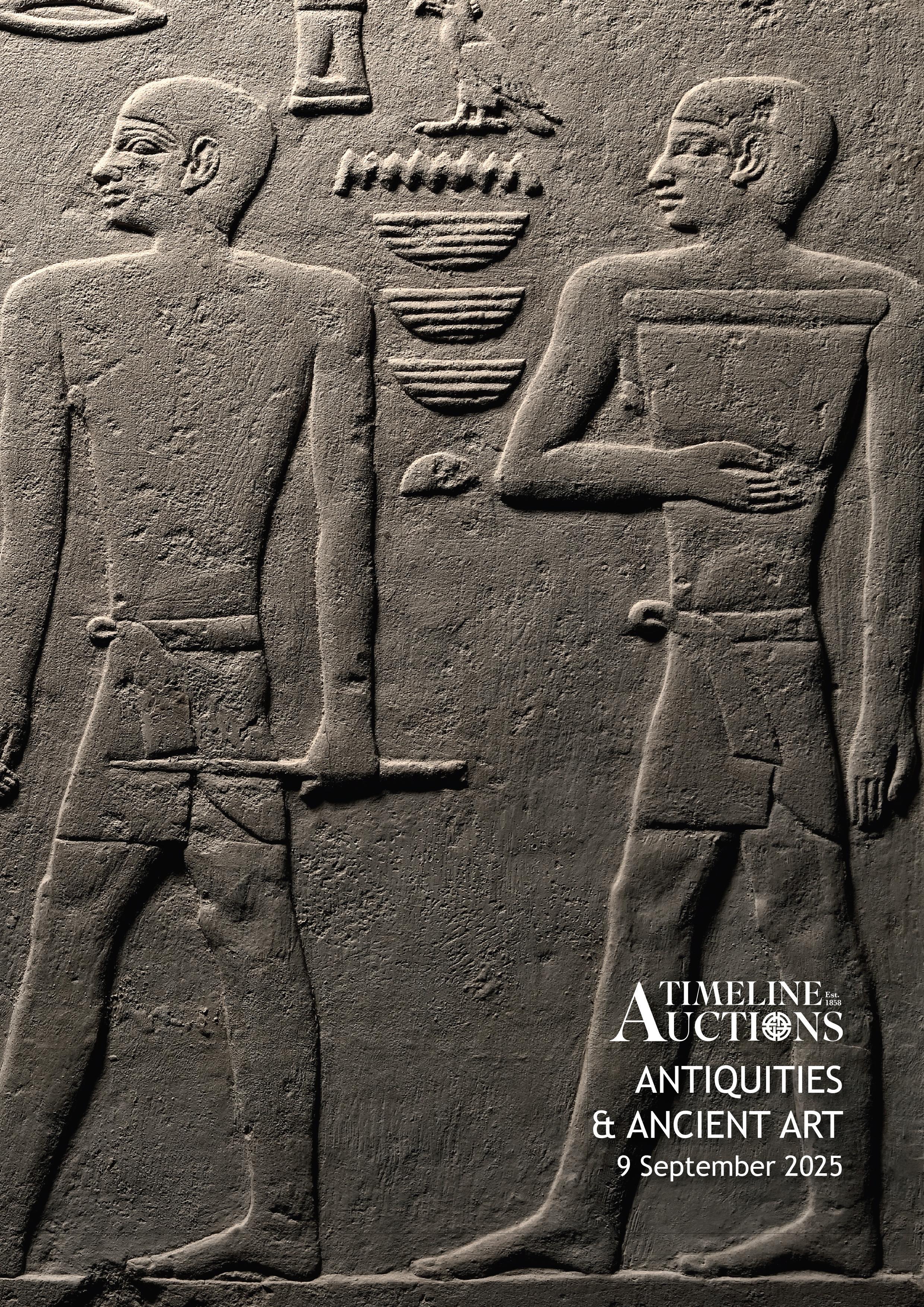
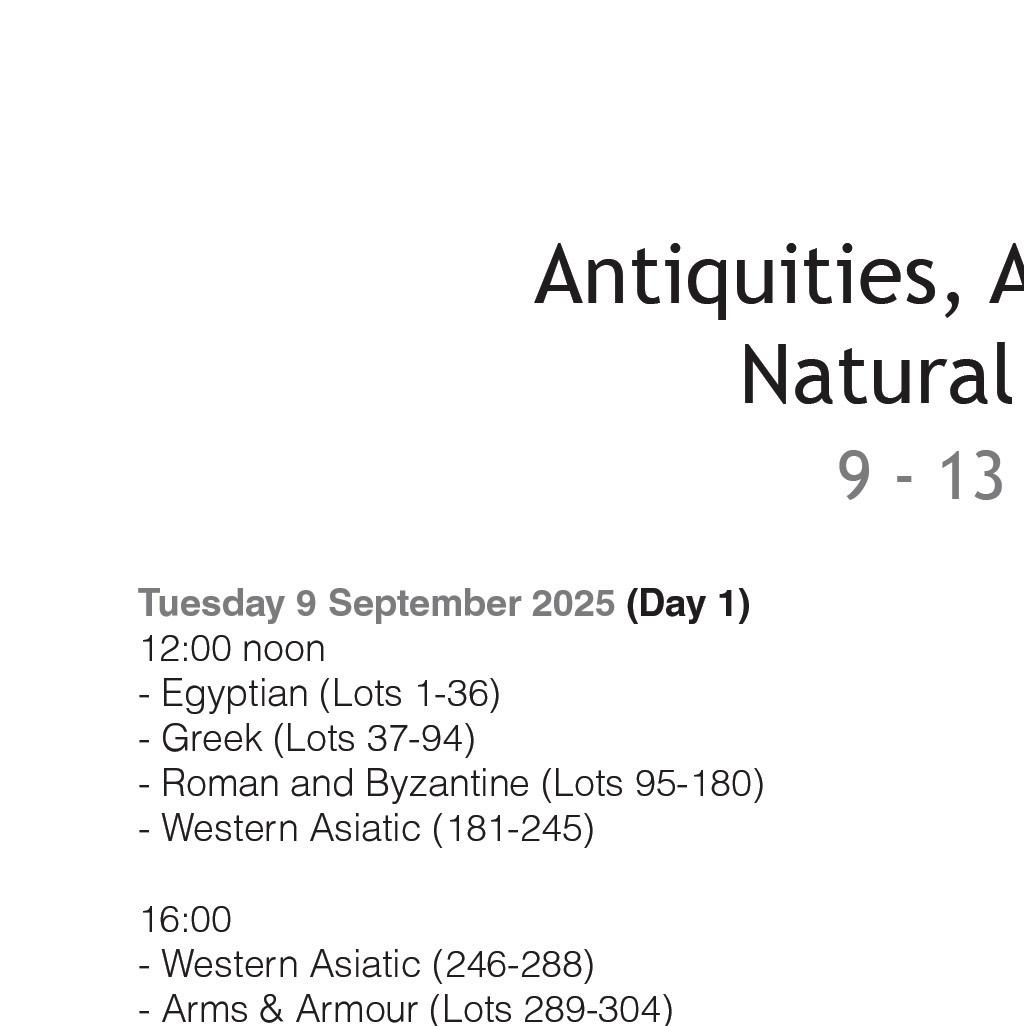
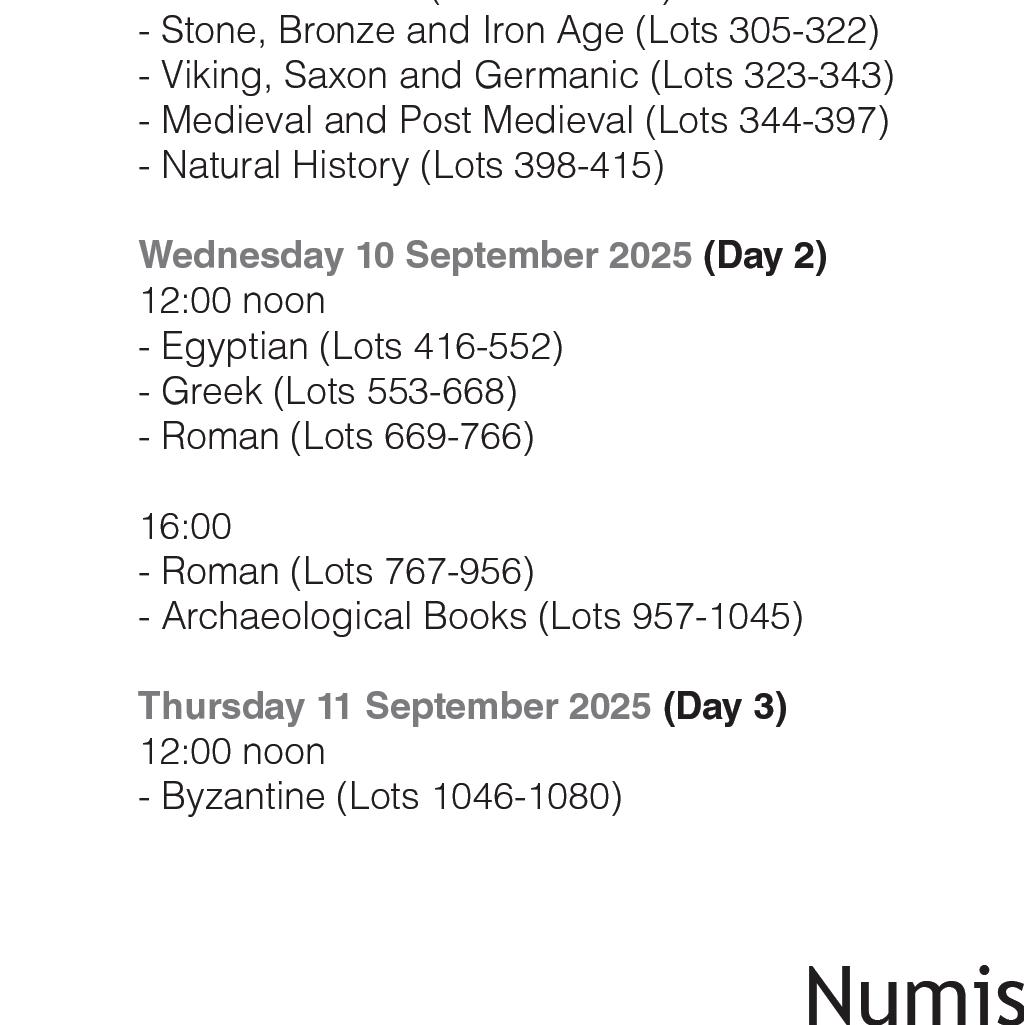



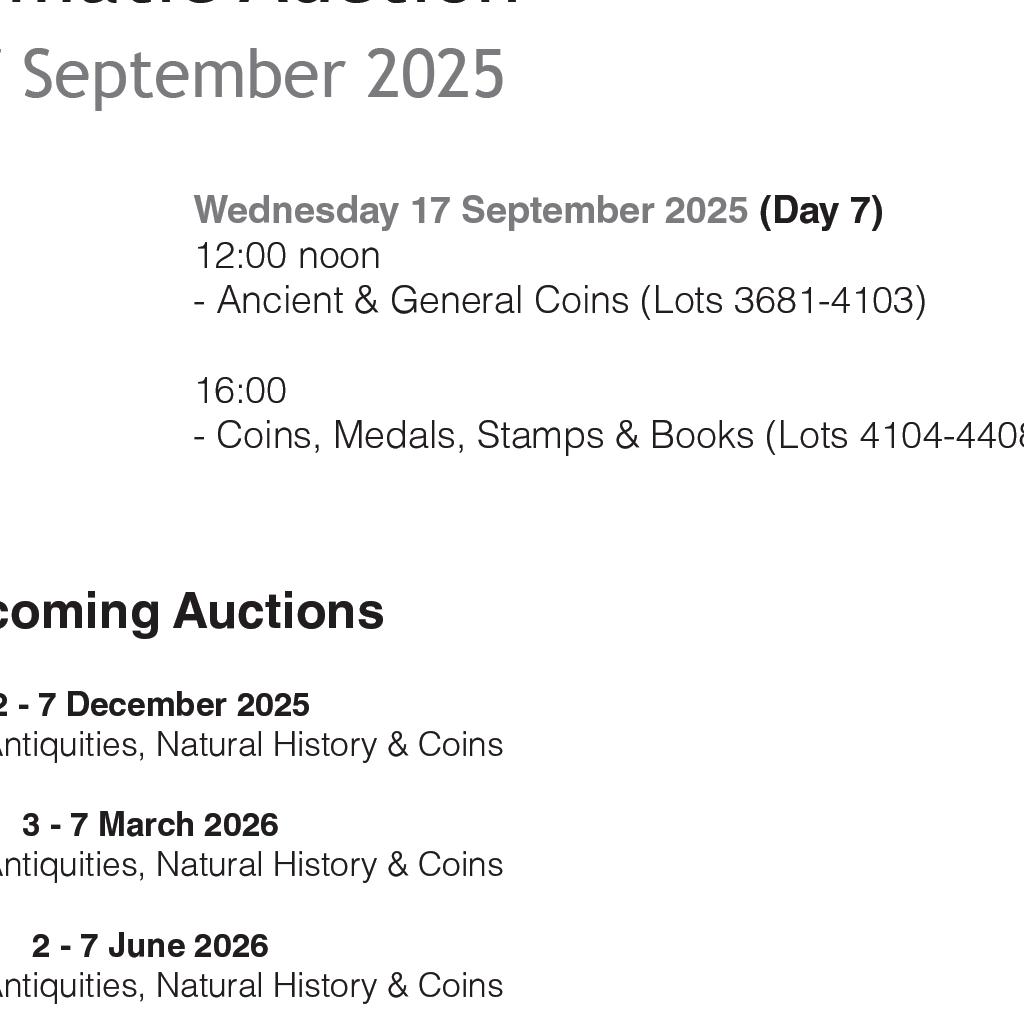



Head Office
TimeLine Auctions Limited
The Court House
363 Main Road
Harwich, Essex
CO12 4DN, UK
Tel: +44 (0)1277 815121
Website www.timelineauctions.com
Antiquities Auction
Tuesday 9 September 12 noon (Lots 1 - 415)
Wednesday 10 September 12 noon (Lots 416 - 1045)
Thursday 11 September 12 noon (Lots 1046 - 1666)
Friday 12 September 12 noon (Lots 1667 - 2300)
Saturday 13 September 12 noon (Lots 2301 - 2949)
Numismatic Auction
Tuesday 16 - 17 September 12 noon (Lots 2950 - 4408)
Viewing & Champagne Reception
The Institute of Directors
116 Pall Mall, St James's 2 & 3 September 2025
Bids
+44 (0)1277 815121
+44 (0)1277 814122 fax bids@timelineauctions.com
Telephone bidding by prior arrangement.
Please see back of the catalogue for Terms & Conditions
Consignments
+44 (0)1277 815121 consignments@timelineauctions.com
Illustrations
Cover: Lot 30
Sale Number: 290
Catalogue Production & Layout
Damir & Davor Radic DRs d.o.o.
Photography & Video Production
Michael Healy, Kyle Elmer, Jason Williams
The
Antiquities Department
Dr Raffaele D'Amato (Head of Department)
Stephen Pollington (Cataloguer)
Michaela Simonova, MA (Cataloguer)
Tanja Maijala (Cataloguer)
Numismatic Department
Periklis Mastrangelis, MA (Head of Department)
Dane Kurth (Greek & Roman Coins & Antiquities)
Michaela Simonova, MA (Cataloguer)
Brett Hammond, FRSA
Consultants
Professor Neritan Ceka (Classical & General Antiquities)
Professor Dr phil. Peter Rothenhoefer (Classical Archaeology, Chinese Antiquities, and Coins)

Professor Livio Zerbini (Classical Archaeology & Roman Epigraphy)
Dr Ronald Bonewitz (Antiquities & Geological)
Dr Manuel Ceccarelli (Western Asiatic Antiquities)
Dr Robert Chandler (Paleontology)
Dr Paul A. Fox, MA, FSA (Heraldry)
Dr Brian Gilmour (Arms & Armour & General Antiquities)
Dr Ittai Gradel (Classical & General Antiquities)
Dr Malcolm Jones (Medieval & Later Antiquities)
Dr Alberto Pollastrini (Egyptian & Associated Antiquities)
Dr Laura Proffitt (Classical & General Antiquities)
Dr Laura Vigna (Ancient Jewellery, Ceramics & Marble)
Laetitia Delaloye, MA (Egyptian & General Antiquities)
Michaela Simonova, MA (Mesoamerica, Viking & Religious)
Thomas Sturm, MA (Cylinder Seals)
Paul Whelan, MA (Egyptian Antiquities)
Peter Bufton (Far Eastern, Islamic & Ethnographic)
Peter Clayton, FCILIP, Dip, Arch, FSA, FRNS (Egyptian)
Richard Falkiner, FSA (Jewellery & General Antiquities)
Michael Howgate, B.Sc. M.Sc. PGCE FLS (Natural History)
Igor Gorokhovsky (Metallurgist & General Antiquities)
Joseph Hubbard (Natural History)
Dane Kurth (Greek & Roman Coins & Antiquities)
Stephen Pollington (Anglo-Saxon & Viking Antiquities)
Amin Rezai (Western Asiatic & General Antiquities)
Richard Roy (Ancient Americas)
Simon Schmidt (Jewellery & General Antiquities)
Mehdy Shaddel (Western Asiatic & Islamic Antiquities)
Stefany Tomalin (Beads & Associated Jewellery)
For further information and biographies see: www.timelineauctions.com
Team
Chief Executive Officer: Brett Hammond, FRSA
Chief Operating Officer: Aaron Hammond
Head of Administration: Tanja Maijala
Client Account Manager: Lisa Fricker
Admin Assistants: Law Yuen Ying, Heather O’Neil


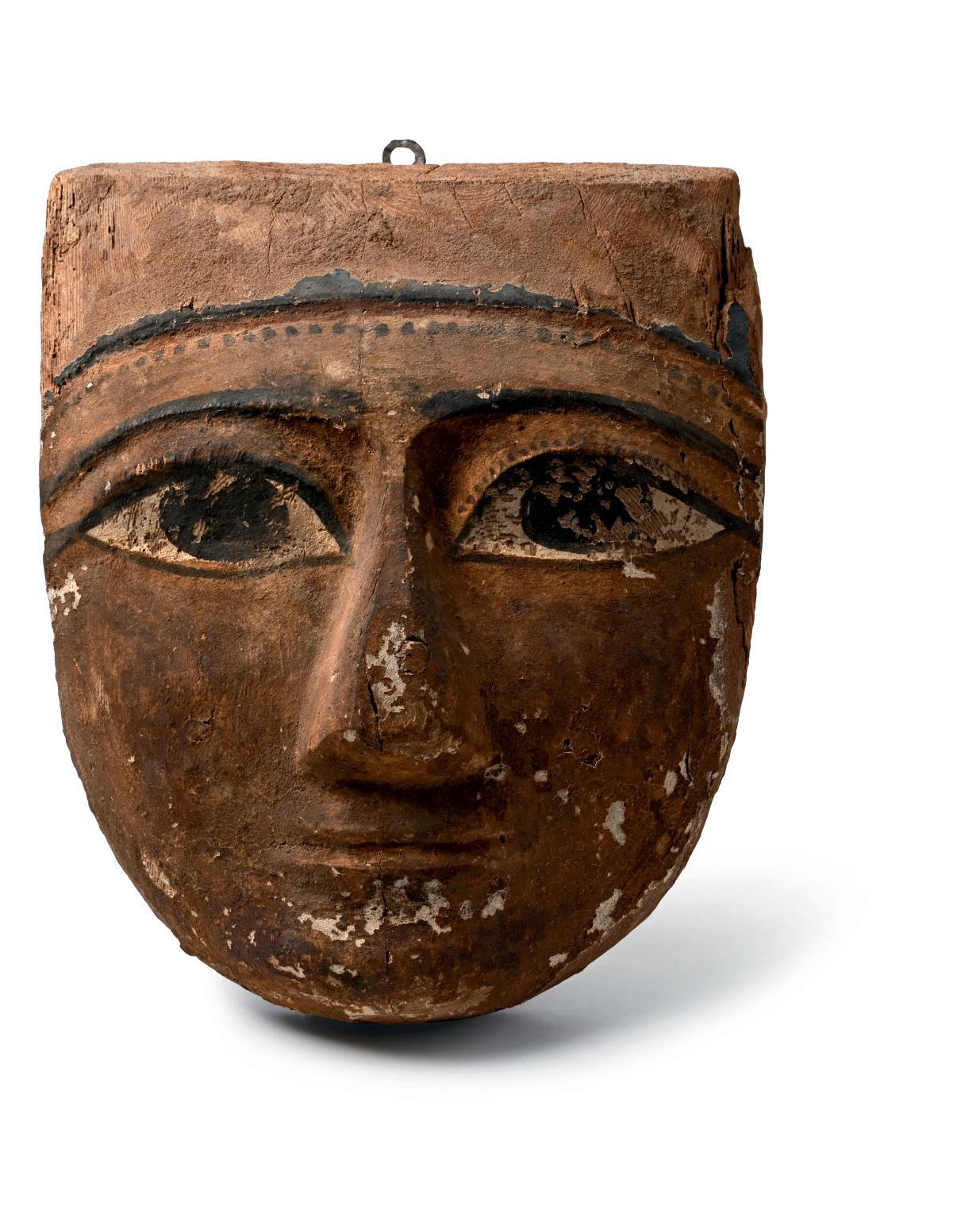
1
EGYPTIAN WOODEN SHABTI WITH HIEROGLYPHIC INSCRIPTION
NEW KINGDOM, LATE 18TH-19TH DYNASTY, CIRCA 1350-1200 B.C.
9 in. (147 grams, 23 cm)
Carved in the round with a detailed tripartite wig, segmented collar, and seed bag across the back, the figure has hands crossed at the chest, each holding a hoe, and wrists adorned with bracelets; eight bands of hieroglyphic text encircle the lower body, interrupted by a vertical column at the front, running from midriff to feet; mounted on a later copper base.
£2,800 - 3,600
PROVENANCE:
From the collection of Mrs Kilvert, who fled from France to England during the French Revolution.
Received by gift to the Hodge family from Mrs Kilvert at Bath in 1864-1865; thence by descent to the grandchildren of Mr John Hodge, a private London tutor.
From the collection of a New Zealand family; thence by descent.
2
EGYPTIAN WOODEN SHABTI
NEW KINGDOM, 19TH DYNASTY, 1293-1185 B.C.
10 in. (332 grams, 26.9 cm)
Carved in the round with detailed tripartite wig, hands crossed at the chest; some painted and gilded(?) plaster surface; mounted on a later base.
£1,800 - 2,400
PROVENANCE:
From the collection of Mrs Kilvert, who fled from France to England during the French Revolution.
Received by gift to the Hodge family from Mrs Kilvert at Bath in 1864-1865; thence by descent to the grandchildren of Mr John Hodge, a private London tutor.
From the collection of a New Zealand family; thence by descent.
FOOTNOTES:
A shabti, also known as ushabti or shawabti, is a small funerary figurine found in ancient Egyptian tombs, dating from around 2000 BCE to 30 BCE. Its main purpose was to serve as a servant for the deceased in the afterlife, carrying out manual tasks such as farming or irrigation. Shabtis were often inscribed with a magical formula from the Book of the Dead to ensure they would animate when summoned. The distinctive, lighter-coloured, and previously part-gilded upper body decoration, contrasting with the black used for the rest of the figure, may symbolise the moment of rebirth, when the face of the deceased was bathed in the sun’s rays.
3
EGYPTIAN PAINTED WOODEN MASK ‡ PTOLEMAIC PERIOD, CIRCA 3RD CENTURY B.C.
11¾ in. (1.04 kg, 30 cm)
D-shaped in plan with carved facial detailing, thick nose and full lips; painted bands to brow pierced in three places for attachment.
£2,500 - 3,500
PROVENANCE:
Swiss private collection, Zurich, assembled in the 1950s.
Private collection.
Acquired on the Zurich art market in 2013.

4
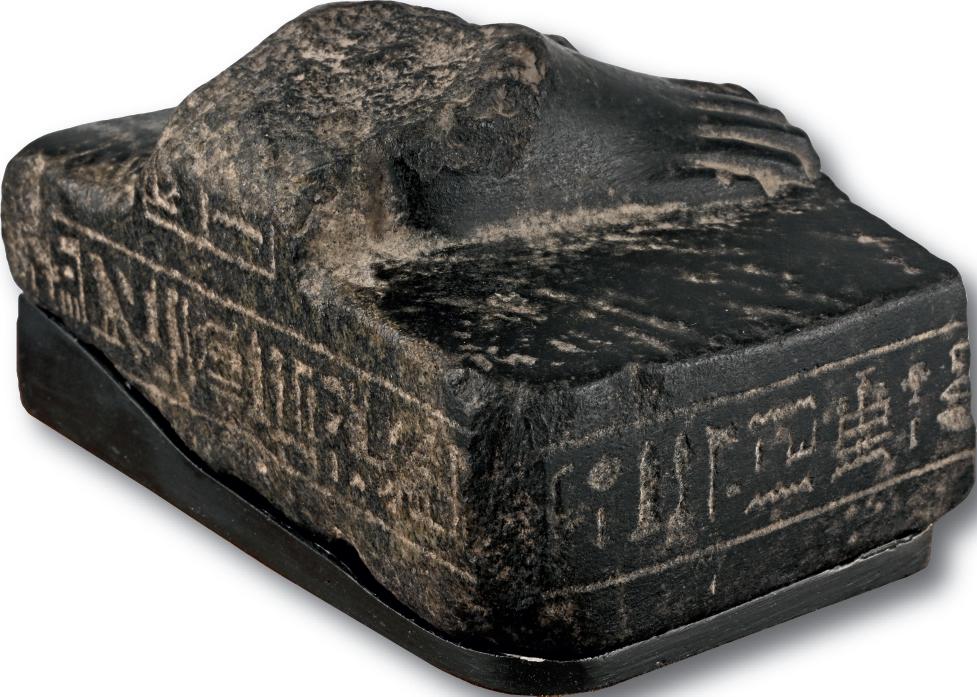
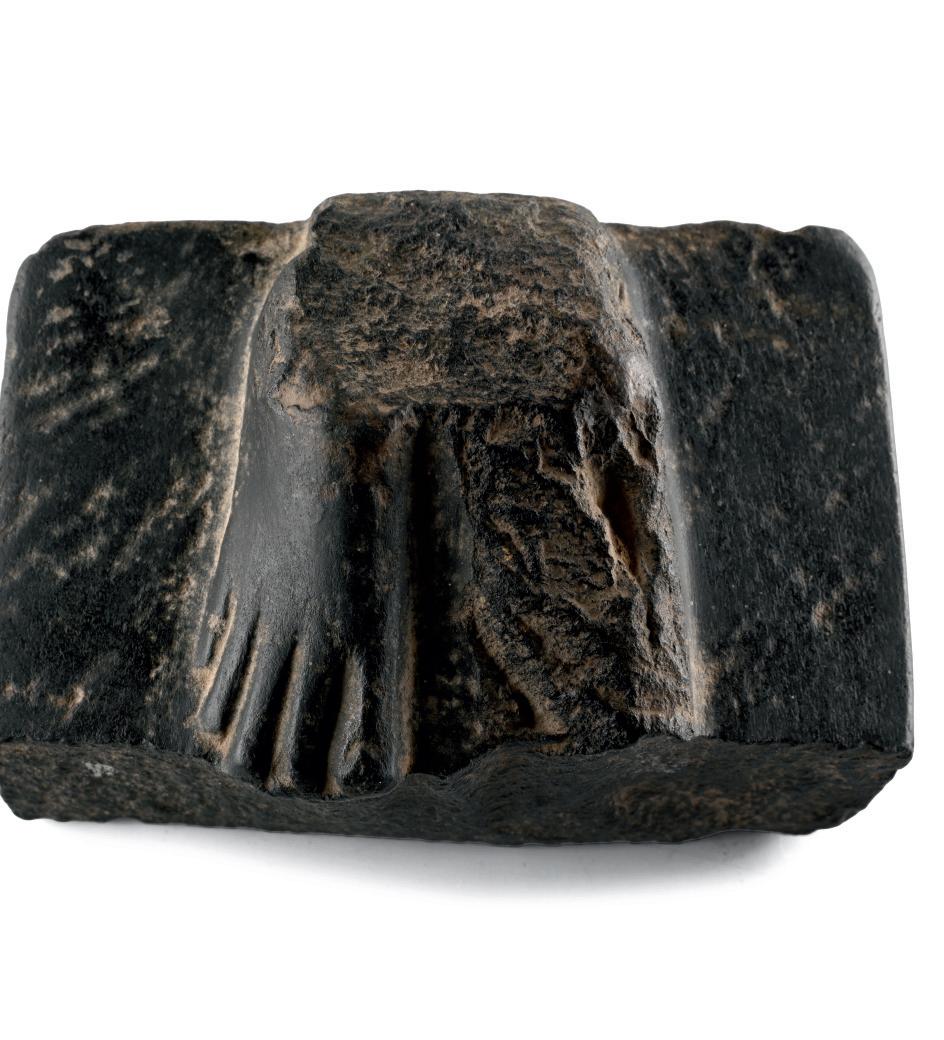

EGYPTIAN BASALT STATUE BASE FOR THE PRIEST HOR-SAASETI
LATE PERIOD, 664-332 B.C.
5 in. (9 in.) (1.37 kg, 12.9 cm (4.08 kg total, 25 cm including stand))
Fragment of the rectangular base of a statue, preserving an integral pair of feet on the upper surface; lower end of dorsal column inscription at the rear with two hieroglyphs; below, a horizontal band of hieroglyphic text extending onto both short sides including part of an offering formula for the m-n r ıwnw-sm r-s - stı (the priest [of the] Southern Heliopolis [i.e., Thebes], Hor-sa-aseti); old collectors’ labels on the underside; supplied with a custom-made wooden display stand.
£4,000 - 6,000
5
EGYPTIAN GRANITE SEATED FIGURE ‡
LATE PERIOD, 664-332 B.C.
7 in. (4.1 kg, 18.7 cm)
Fragment of a statue of an official, comprising the torso and legs clad in an ankle-length robe and seated on a rectangular-section seat with stepped base and short, curved backrest and rear dorsal pillar; the left hand carved with the palm resting along the thigh; the right hand similarly placed but with the hand gripping a folded piece of cloth of which the ends are draped over the lower thigh above the knee; traces of an old label to reverse.
£3,500 - 4,500
PROVENANCE:
Private collection, Europe. with Bonhams & Brooks, 8th November 2001, no.265. Private collection, Europe.
Accompanied by copies of the relevant Bonhams & Brooks catalogue pages.
FOOTNOTES:
The official would have been shown wearing a longer cloak-like garment rather than a waist-height kilt, as the line of the folded edge is visible above where a waistband would typically be.
PROVENANCE:
Private New York, USA, collection, 1970.
Ex Adrian Burns, Columus, Ohio, USA, from an old estate collection.
Ex Art for Eternity gallery, New York, USA.
Ex Art Primativo, Auction 16, 2001, no.430.
Ex private New York, USA, collection. Private collection, London, UK.
Accompanied by an academic report by Egyptologist Paul Whelan.

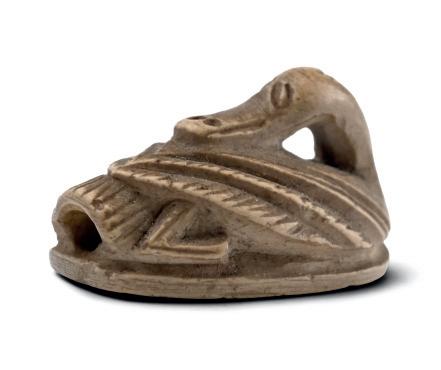

6
EGYPTIAN FAIENCE DUCK AMULET ‡ THIRD INTERMEDIATE-LATE PERIOD, 750-332 B.C. in. (1.18 grams, 15 mm)


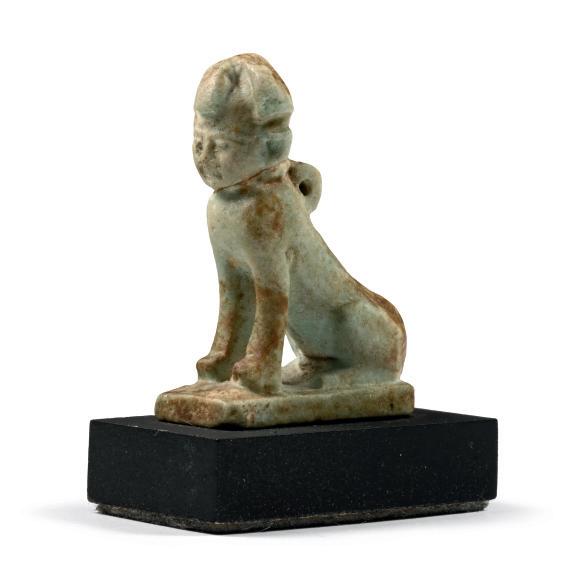
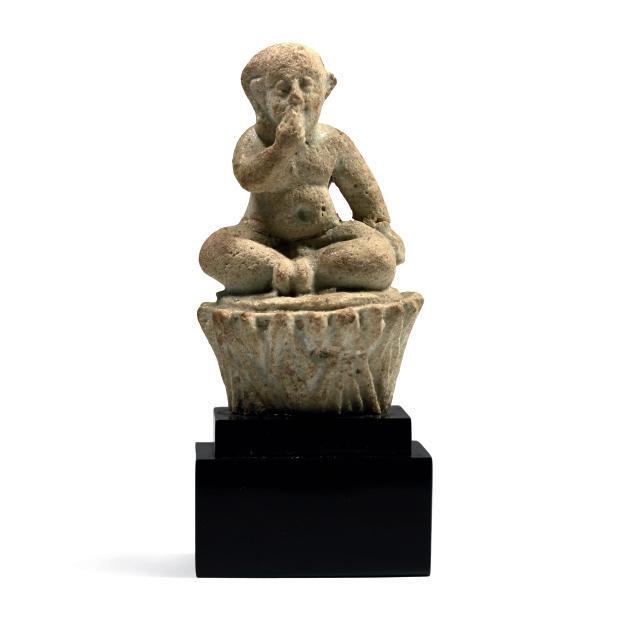
PROVENANCE:
From the collection of a gentleman, acquired on the London art market in the 1990s.
FOOTNOTES:
Modelled in the round, the head placed resting along the spine, loop formed by the neck; underside with hieroglyphic text.
£500 - 700
PROVENANCE:
Old private French collection.
Anonymous sale, Beaussant Lefevre, Paris, 2015. Private European collection, acquired in 2015.
7
EGYPTIAN FAIENCE FIGURE OF NEFERTUM ‡ PTOLEMAIC PERIOD, 332-30 B.C.
5 in. (71 grams total, 13 cm including stand)
In a striding pose with arms at the sides, sporting a black coloured tripartite wig surmounted by the god’s distinctive headdress consisting of a lotus flower with two plumes on top; a suspension loop at the back; repaired.
£500 - 700
PROVENANCE:
Property from an American deceased estate, acquired between 1970 and 1989. with Bonham’s, London, 28 October 2009, no.81 [Part].
FOOTNOTES:
Nefertum was closely associated with the creator god Ptah and the goddesses Sekhmet and Bastet. He represented the first sunlight and the sweet scent of the Egyptian blue lotus flower (nymphaea caerulea). According to beliefs, the sun rose from the bloom of a blue lotus, embodying notions of rebirth and rejuvenation. Additionally, as the lotus was seen as a symbol of fertility, it is possible that this amulet was also worn for that purpose.
8
EGYPTIAN BRONZE SEATED HARPOCRATES
LATE PERIOD, 664-332 B.C.
6 in. (389 grams, 16.2 cm)
Substantial cast figurine modelled in the round of Harpocrates sitting with hands on his thighs, double crown and sidelock.
£1,000 - 1,400
Harpocrates is the Greek rendering of the Egyptian Hor-pa-khered, which means ‘Horus the Child’. This name refers to Horus as the divine infant of Isis and Osiris. Wearing an amulet of Harpocrates was believed to give the wearer the same protection that Isis offered to her beloved son. Larger bronze statuettes probably served as votive offerings to Harpocrates to secure his favour and protection.
9

EGYPTIAN GREEN GLAZED FAIENCE AMULET OF A SEATED SPHINX
KUSHITE KINGDOM, 25TH DYNASTY, CIRCA 747-656 B.C.
2 in. (17.48 grams total, 51 mm including stand)
Figure of a sphinx in seated pose on a tongue-shaped base, with loop between the shoulders and Nubian hairstyle.
£800 - 1,000
PROVENANCE: with Charles Ede Ltd, London, UK.
Private collection, London, UK, acquired from the above on 28 April 1994.
Accompanied by a copy of the Charles Ede invoice.
FOOTNOTES: The ‘Nubian’ hairstyle was worn by young women in connection with birth, nursing babies and applying cosmetics.
10

EGYPTIAN GREEN GLAZED FAIENCE FIGURE OF HARPOCRATES LATE PERIOD, 664-332 B.C.
2 in. (39.7 grams total, 68 mm including stand)
Modelled in the round, the nude seated figure of the child Somtous, with one hand to his lips and a prominent sidelock, emerging from a lotus flower; mounted on a custom-made stand.
£800 - 1,000
PROVENANCE: with Noriuchi Horiuchi, Tokyo, Japan.
Private collection, London, UK, acquired from the above in 1993.
11
EGYPTIAN BRONZE CAT HEAD WITH INCISED SCARAB
LATE PERIOD, 664-332 B.C.
2¼ in. (92.5 grams, 58 mm)
The head of goddess Bastet modelled in the round with alert ears and eyes, fine whisker detailing to the gently elongated muzzle, hair detailing to the inner edges of the ears and the lower outer edges pierced to accept separate earrings, incised scarab on the top of the head.
£4,000 - 6,000
PROVENANCE: Elizabeth Helene Demarest Osten Driesen (1892-1931).
Given as a gift to her granddaughter, Lady Annabel Sutherland, by descent in the late 1960s.
FOOTNOTES:
In ancient Egypt, the cat was venerated as the sacred animal of the goddess Bastet, whose principal cult centre was Bubastis in the Nile Delta. Although cats were once part of folk practice, their veneration as part of formal cults spread across Egypt during the Late Period. Bastet was closely linked to lion-headed goddesses like Sekhmet, Tefnut, and Pakhet, and the cat itself became associated with solar imagery: the Book of the Dead portrays the sun god as a Great Cat vanquishing Apophis beneath the sacred Ished Tree. The cat could also embody the Eye of the Sun or, more often in Bastet’s case, the Eye of the Moon. Mummified cats were frequently dedicated as votive offerings, and some of their feline-shaped coffins were adorned with finely crafted bronze heads to enhance their divine likeness.
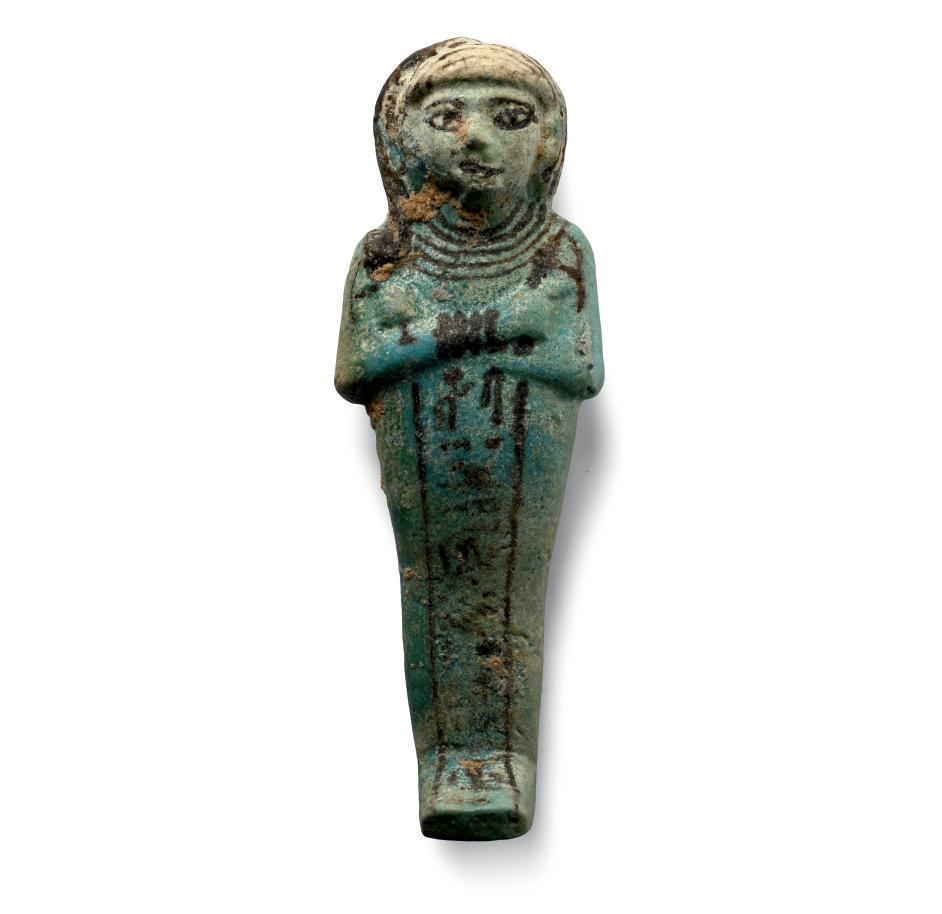
13
EGYPTIAN FAIENCE SHABTI FOR PADIPEPET LATE PERIOD, 26TH DYNASTY, 664-525 B.C. 6¾ in. (210 grams, 17 cm)
Mummiform figure wearing a tripartite wig and false beard, with arms crossed and hands holding a pick, hoe, and the cord of a seed bag slung over the left shoulder; dorsal pillar with two columns of hieroglyphic text reading: ‘O this ushabti, if the Osiris Padipepet, born of Bastet-ir-dis, [is called], ‘Behold me’ you shall say’; display stand with legend ‘Padipepet / XXVI Dyn[asty]’. [No Reserve]
£1,000 - 1,400
PROVENANCE:
From the private collection of a Canadian gentleman living in Essex, UK, formed since the 1920s-circa 1990.
Property of an Essex lady until the late 1990s; thence by descent. From the private collection of an Essex gentleman since the late 1990s.
FOOTNOTES:
A shabti (also known as ushabti or shawabti) is a small funerary figurine found in ancient Egyptian tombs, dating from around 2000 BCE to 30 BCE. Its primary purpose was to serve as a helper for the deceased in the afterlife, performing manual tasks like farming or irrigation. Shabtis were often inscribed with a magical formula from the Book of the Dead to ensure they would come to life when summoned. The relatively short inscription on this example includes the opening and closing parts of the spell.
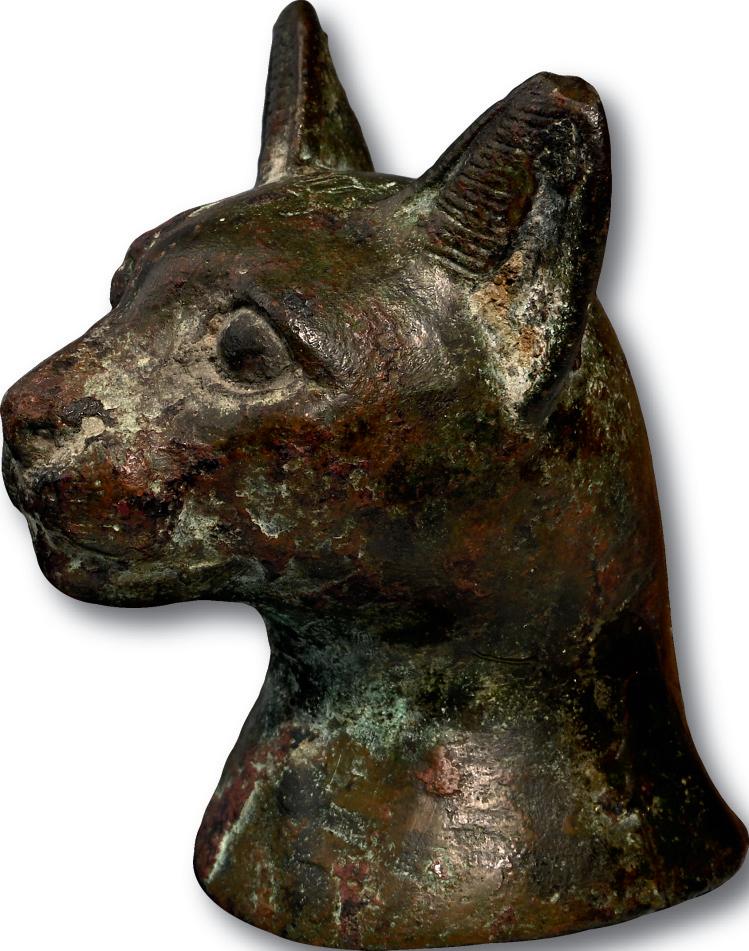

EGYPTIAN FAIENCE USHABTI ‡ 2ND MILLENNIUM B.C. 5 in. (134 grams, 15 cm)
Mummiform figure with black-pigment facial detailing, sidelock, tripartite wig, dorsal seed-net, tiered collar and vertical panel of hieroglyphic text.
£2,000 - 3,000
PROVENANCE: Acquired in the mid 1980s.
Private collection, Switzerland, thence by descent. Private collection, since the late 1990s
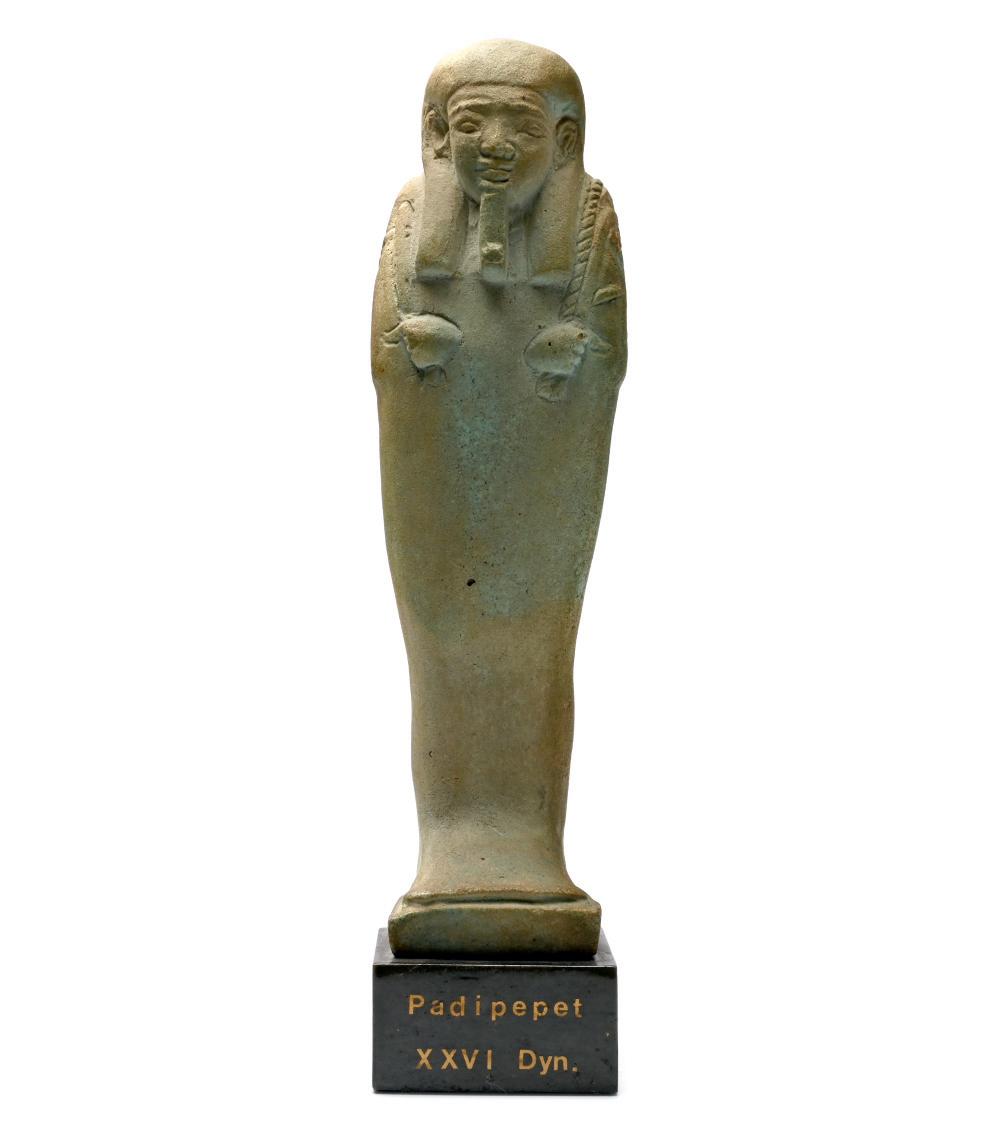

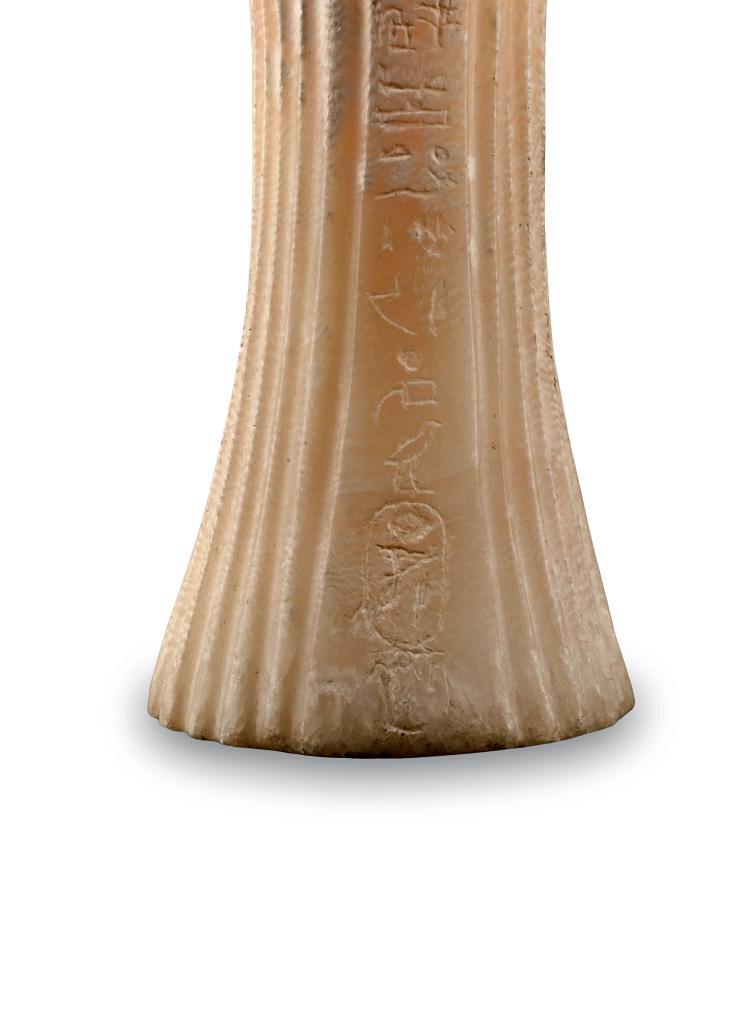

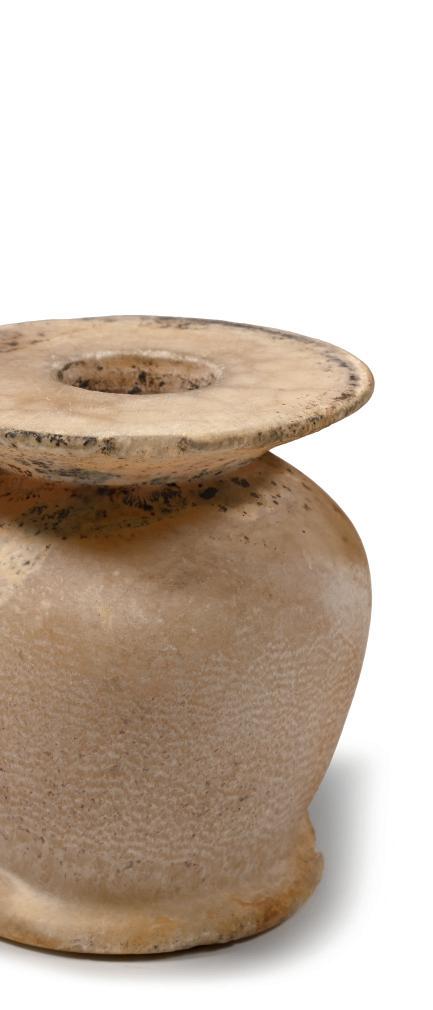
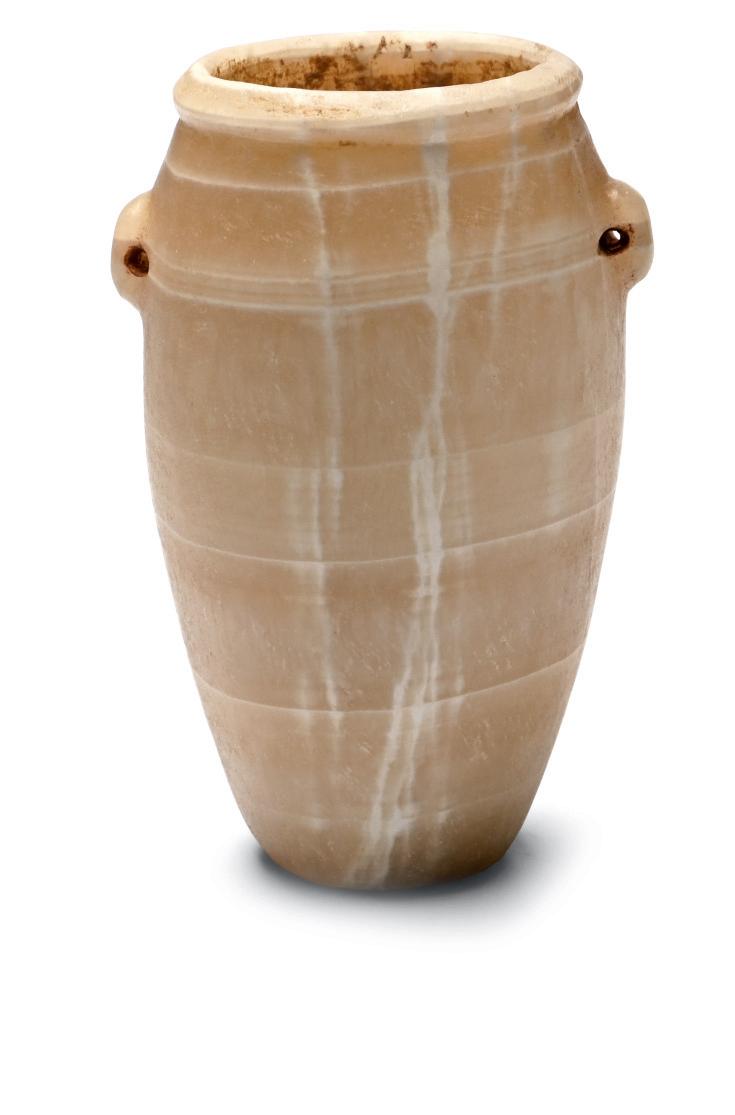

14

EGYPTIAN ALABASTER HEADREST PILLAR WITH HIEROGLYPHIC INSCRIPTION ‡
OLD KINGDOM, 5TH-6TH DYNASTY, 2494-2181 B.C.
4¾ in. (628 grams, 12 cm)
Formed as a carved cone with fluting to the vertical face; plain panel with incised hieroglyphic text and cartouche; one part of a head-rest assembly.
£2,000 - 3,000
PROVENANCE:
Private collection of Mr A., Montreal, acquired in the early 1980s. Private collection, Switzerland, acquired from the above in 1993. Thence by descent, family collection, from the late 1990s.
15
EGYPTIAN ALABASTER KOHL JAR
LATE PERIOD, 664-332 B.C.
3 in. (458 grams, 76 mm)
Ovoid body with discoid foot and a wide flattened lip.
£600 - 800
PROVENANCE:
Private collection of Mr K.A., acquired in the 1990s-early 2000s.
16
EGYPTIAN ALABASTER COSMETIC JAR
DYNASTY 1, CIRCA 3050-2890 B.C.
4 in. (413 grams, 11 cm)
With narrow base, curved sidewall and rolled rim, two lateral pierced lug handles. [No Reserve]
£500 - 700
PROVENANCE:
From the private collection of a Canadian gentleman living in Essex, UK, formed since the 1920s-circa 1990.
Property of an Essex lady until the late 1990s; thence by descent.
From the private collection of an Essex gentleman since the late 1990s.
17
EGYPTIAN MUMMY SHROUD SECTION WITH HIERATIC TEXT
LATE-PTOLEMAIC PERIOD, CIRCA 480-30 B.C.
6¼ in. (5.61 grams, 16 cm)
A section of woven linen textile featuring lines of neat hieratic text in black.
£1,000 - 1,400
PROVENANCE:
From the collection of a gentleman, acquired on the London art market in the 1990s.
2 in. (209 grams, 68 mm)
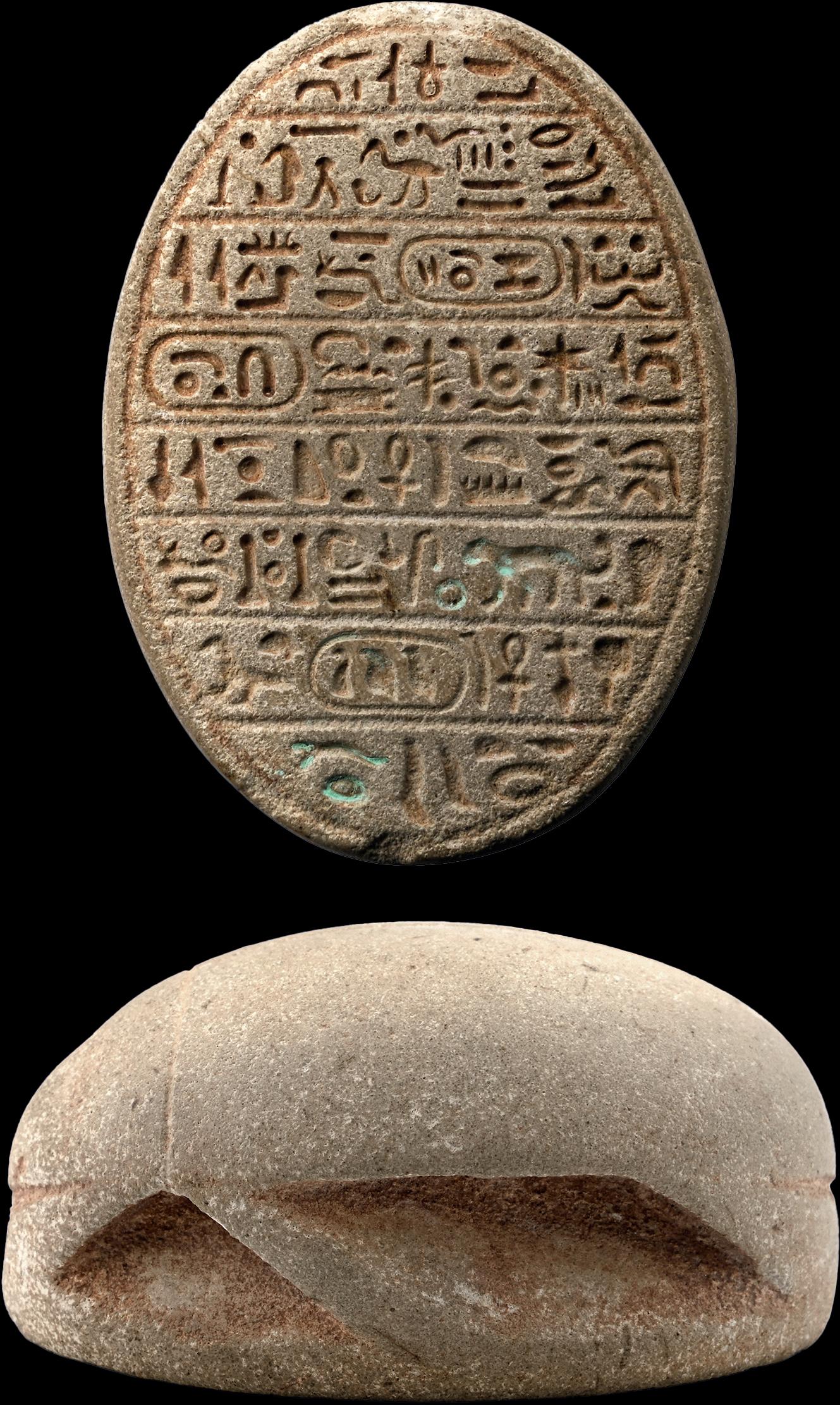
18 VERY LARGE PHOENICIAN STONE SCARAB WITH HIEROGLYPHICS ‡ 8TH-7TH CENTURY B.C.
Plano-convex in section with segmented carapace and longitudinal piercing; underside with dense eight-line hieroglyphic text.
£8,000 - 10,000
PROVENANCE: Private collection, Switzerland, circa 1980. Acquired in 1994.
Private collection, Switzerland, thence by descent. Private collection, since the late 1990s.

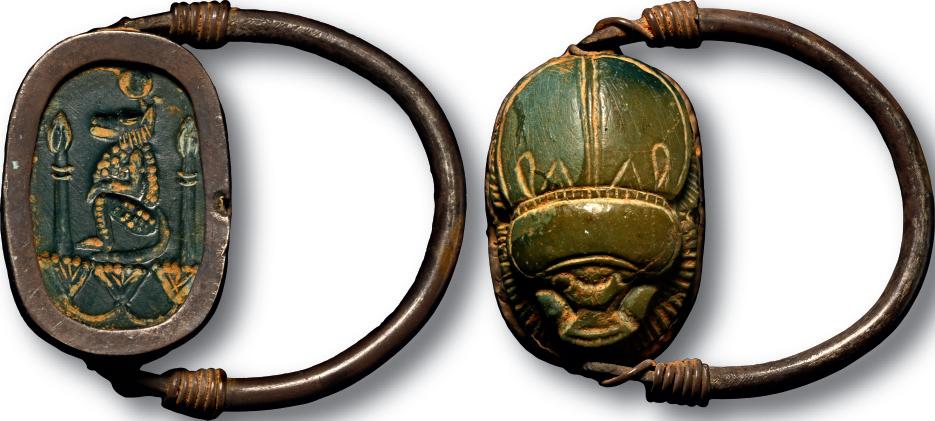


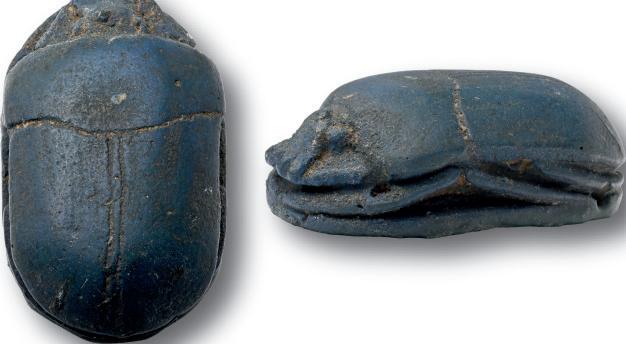

19
EGYPTIAN GREEN STONE SCARAB IN SILVER SWIVEL RING
LATE-PTOLEMAIC PERIOD, 664-30 B.C.
1 in. (7.59 grams, 29.99 mm overall, 23.51 x 18.24 mm internal diameter (approximate size British S, USA 9, Europe 20, Japan 19))
With round-section hoop, green stone scarab in swivel mount, the underside with incused image of a seated baboon flanked by torches(?), with sun disc above, and lotus flowers beneath.
£1,500 - 2,000
PROVENANCE:
From the late S M collection, London, UK, 1969-1999.
20
LARGE EGYPTIAN STEATITE SCARAB
LATE PERIOD, 664-332 B.C.
1¾ in. (33.76 grams, 46 mm)
With a detailed carapace, mouth, and legs; the underside decorated with a line border enclosing a large central sma motif in the upper half, followed by a neb, men, and Khepri beetle hieroglyphs, flanked by rearing cobras.
£500 - 700
PROVENANCE:
From the collection of a gentleman, acquired on the London art market in the 1990s.
21
EGYPTIAN LAPIS LAZULI SCARAB ‡
750-332 B.C.
1 in. (34.6 grams, 48 mm)
Modelled in the round with detailed head and legs, plaque with attachment hole at each corner.
£1,000 - 1,400
PROVENANCE:
Old private French collection.
Anonymous sale, Beaussant Lefevre, Paris, 2015. Private European collection, 2015.

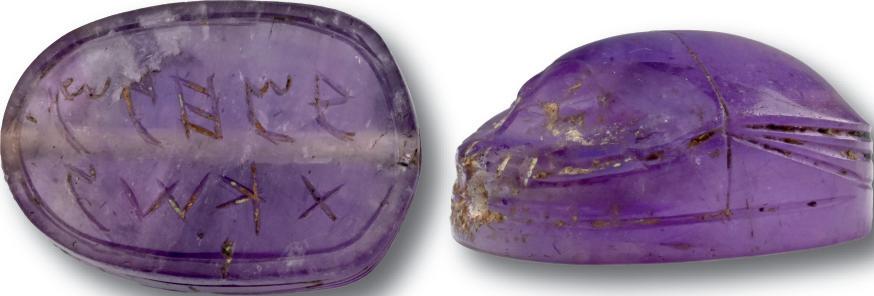
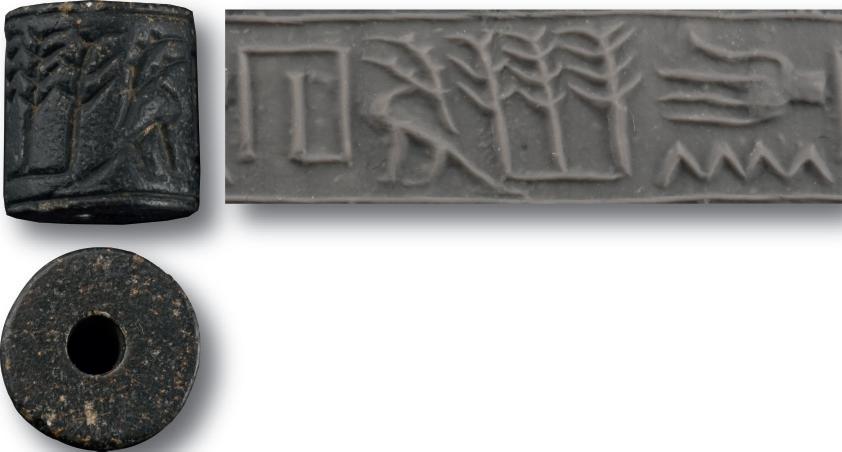

22
PHOENICIAN AMETHYST SCARAB ‡ 8TH CENTURY B.C.
¾ in. (3.21 grams, 18 mm)
Plano-convex in section with carved carapace to upper face; two lines of Phoenician script to underside.
£3,000 - 4,000
PROVENANCE: Acquired in 1992.
Private collection, Switzerland, thence by descent. Private collection, since the late 1990s.
23
EGYPTIAN BLACK STONE CYLINDER SEAL INSCRIBED WITH HIEROGLYPHS FOR THE NAME DENEH
CIRCA 2900 B.C.
½ in. (6.5 grams, 14 mm)
With hieroglyphic inscription, restrung pair of red stone beads, old handwritten label ‘1633’; accompanied by a copy of an old scholarly note, typed and signed by W.G. Lambert, late Professor of Assyriology, University of Birmingham, 1970-1993, which states: ‘Cylinder Seal of Soft Black Stone, 15 x 13.5 mm. Between upper and lower rules five Egyptian hieroglyphs are engraved skillfully. The bird is ‘akh’, soul, the following house, hand and wavey line, are probably a personal name Deneh or Dehen, and the remaining sign consisting of three trees or plants may be a title. This is an old Egyptian cylinder seal from the Second Dynasty, c. 2900 B.C., and the inscriptions are still in the process of being deciphered. The occurrence of soul suggests mortuary use, but the Egyptians made preparations for such things during life, so the owner may well have had this object during his life. It is in fine state of preservation.’; accompanied by a museumquality impression. [No Reserve]
£400 - 600
PROVENANCE:
UK private collection, acquired 1980-1983.
Accompanied by a copy of a scholarly note, typed and signed by Professor Wilfrid George Lambert in 1992.
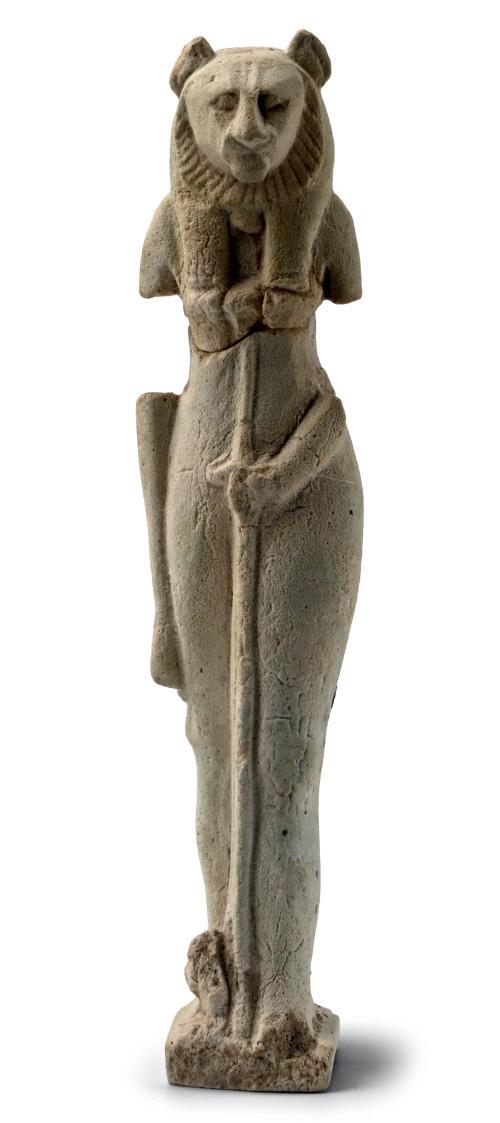
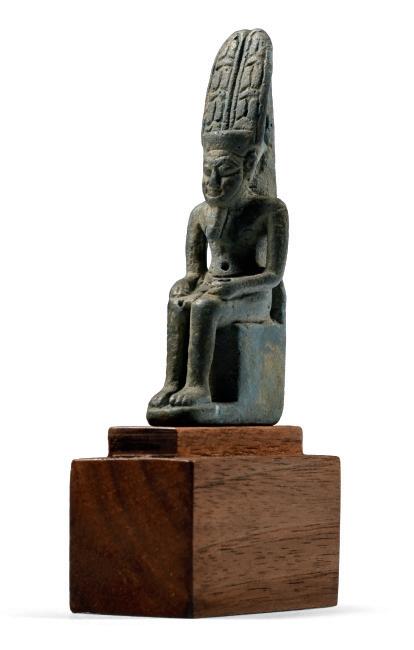
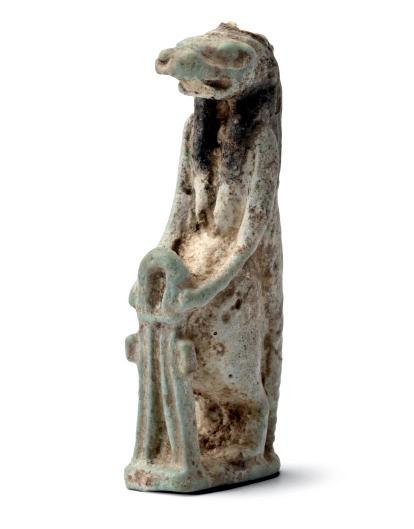
24
LARGE EGYPTIAN FAIENCE FIGURE OF SEKHMET ‡
1ST MILLENNIUM B.C.
5½ in. (79 grams, 14 cm)
Modelled in the round standing, holding an ankh in her right hand, the other holding a slender staff, lion-headed, wearing an ankle-length skirt; loop behind her neck.
£3,000 - 4,000
PROVENANCE:
Acquired in the late 1980s. Private collection, thence by descent. Private collection, since the late 1990s.
25

EGYPTIAN BLUE AMULET OF AMUN LATE PERIOD, 26TH DYNASTY, CIRCA 664-525 B.C.
2¾ in. (15.75 grams total, 71 mm including stand)
The god modelled seated on a throne with a dorsal pillar, hands resting on his knees, wearing a short kilt and a two-plume feather crown; mounted on a wooden stand.
£1,500 - 2,000
PROVENANCE: with Charles Ede Ltd, London, UK. Private collection, London, UK, acquired from the above on 12 July 1994.
Accompanied by a copy of the Charles Ede invoice.
FOOTNOTES:
The amulet of the god Amun served both religious and protective purposes in ancient Egypt. Amun was a major deity associated with creation, kingship, and hidden power. Wearing an amulet bearing his image or name was believed to invoke his divine protection, grant strength, and confer favour or legitimacy. Such amulets were also placed among burial goods to ensure the deceased was protected and guided in the afterlife.
26
EGYPTIAN FAIENCE AMULET REPRESENTING SOBEK ‡ LATE PERIOD, 664-332 B.C.
2 in. (9.82 grams, 54 mm)
On a rectangular base, Sobek standing in crocodile form with human arms resting on an ankh symbol.
£600 - 800
PROVENANCE:
Private collection, Carouge, Switzerland, assembled in the 1980s-1990s. Thence by descent to the collection of Mr S.P., since 2020.
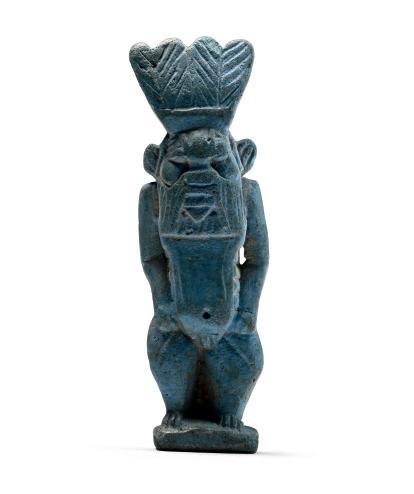
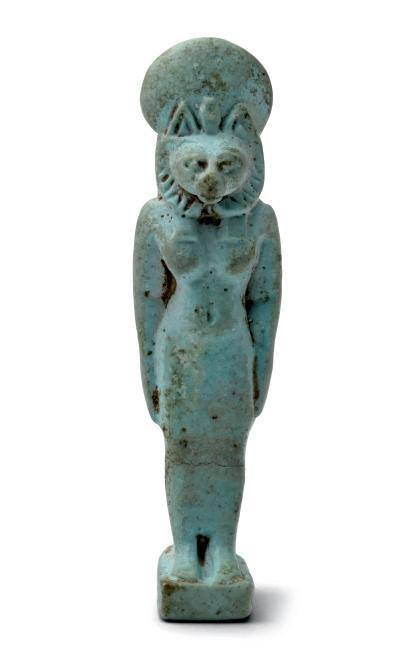
27

EGYPTIAN BLUE AMULET OF BES THIRD INTERMEDIATE PERIOD, CIRCA 1069-735 B.C.
1¾ in. (4.13 grams, 44 mm)
Modelled in the round, Bes standing nude with a lion’s tail, wearing a feathered headdress.
£800 - 1,000
PROVENANCE:
Archéologie; François de Ricqlès, Paris, 30 September-1 October 1996, no.322 (part).
Private collection, London, UK, acquired from the above sale.
Accompanied by a copy of a French cultural passport, dated 30 September 1996.
Accompanied by a copy of the François de Ricqlès invoice.
28
EGYPTIAN FAIENCE AMULET REPRESENTING SEKHMET ‡ LATE PERIOD, 664-332 B.C.
2 in. (9.98 grams, 60 mm)
With rectangular base and dorsal pillar pierced behind the shoulders, standing figure of the goddess in lioness-headed form with tripartite wig and solar disc, human body.
£500 - 700
PROVENANCE:
Private collection, Carouge, Switzerland, assembled in the 1980s-1990s. Thence by descent to the collection of Mr S.P., since 2020.
29
EGYPTIAN APPLIQUÉ WITH APHRODITE ‡ PTOLEMAIC PERIOD, 332-30 B.C. 3 in. (85 grams, 86 mm)
Fragment from a representation of the nude Aphrodite in high-relief, crouching with her left knee raised and her right knee touching the ground, holding her long hair with her hands and wearing a diadem on her head; an appliqué from a vessel with minor filling at the right thigh.
£600 - 800
PROVENANCE:
Private collection, Somerset, England. with M.B., Los Angeles County, acquired 2014-2015 at a sale in the UK. with Ancient Resource, USA, Auction 70, 06 October 2018, no.7.


EGYPTIAN LIMESTONE BAS-RELIEF PANEL OF PTAH PRESIDING OVER THE SMELTING OF METALS
OLD KINGDOM, 5TH DYNASTY, 2498-2345 B.C. 21 in. (21.35 kg total, 53.5 cm wide including stand)
This expertly carved high-relief scene depicts three male figures with short hairstyles, each wearing a short kilt tied at the waist; the left and central figures carry a small furnace by curved handles, preparing to smelt copper; the central figure also holds a metal poker in his free hand; the figure on the left supports a large container at chest level with one hand; finely rendered hieroglyphic inscriptions in front of each figure record a dialogue among the three metalworkers; the leftmost figure, facing the others, declares “Ptah could not have done better”; the central figure responds with three lines of text “Ptah loves him to pour (into) the brazier of the flame”; the inscription before the rightmost figure reads “copper of the baskets”; together, the second and third texts may be interpreted as “Ptah would love him to pour copper from the baskets into the furnace”; the composition likely formed part of a larger scene illustrating metalworking activities; supplied with a custom-made stand.
£80,000 - 100,000
PROVENANCE: with Toufic Arakji, Hamburg, by circa 1980.
Private collection, acquired from the above, circa 1980-1994. with Sotheby’s, New York, Antiquities and Islamic Art, 8 June 1994, no.23. Private collection, 1994-2010, acquired at the above sale.
with David Aaron, London, UK, 2010-2011. with Daniel Katz Gallery, London, UK. UK private collection.
Accompanied by an academic report by Egyptologist Sylvie Caroff. Accompanied by a copy of an Art Loss Register certificate no.S00142449.
FOOTNOTES:
The mention of Ptah – patron god of craftsmen – links this piece to Memphis, suggesting it came from the tomb of a high-ranking official or priest.
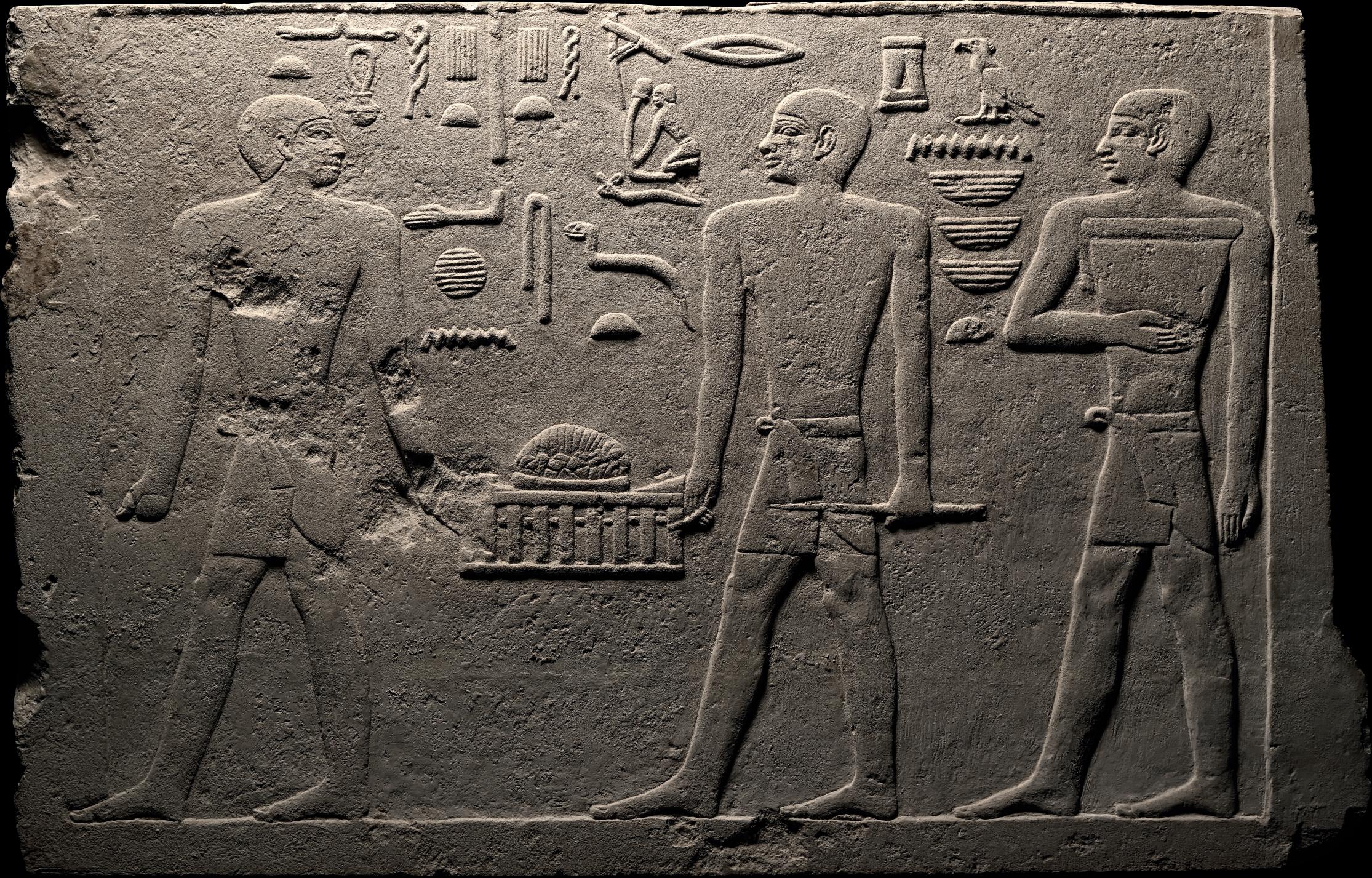

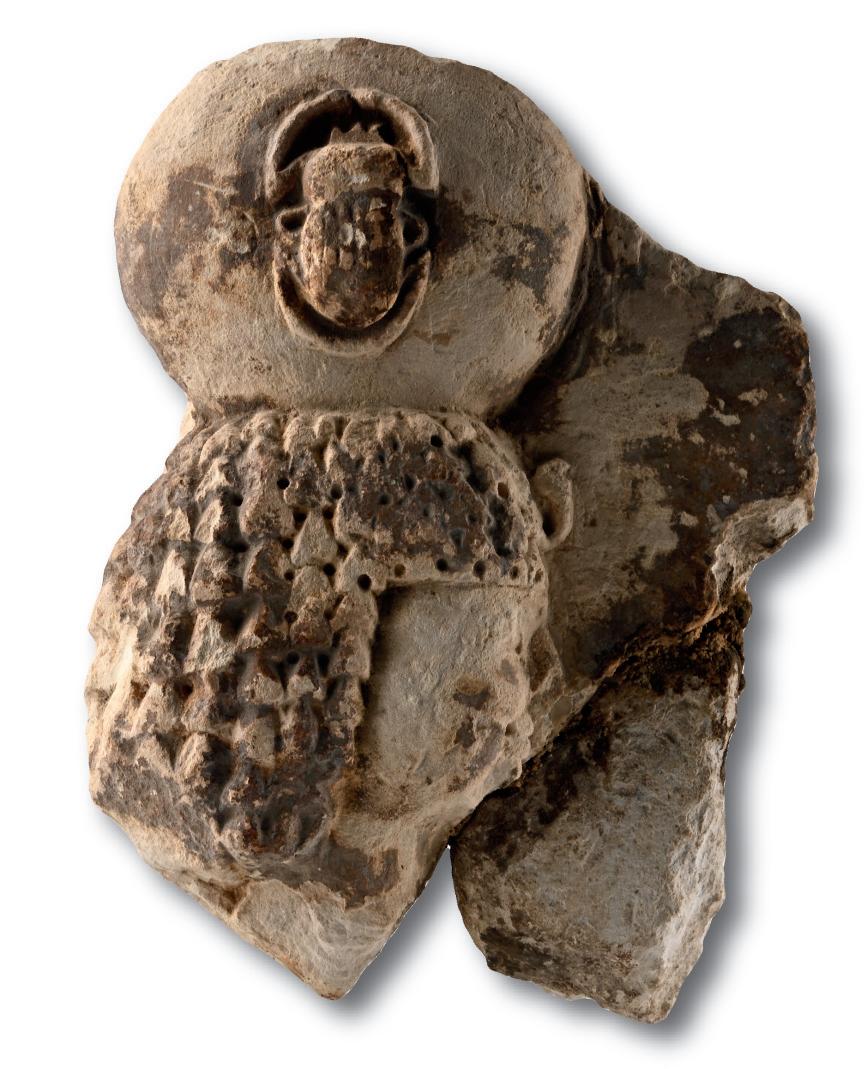
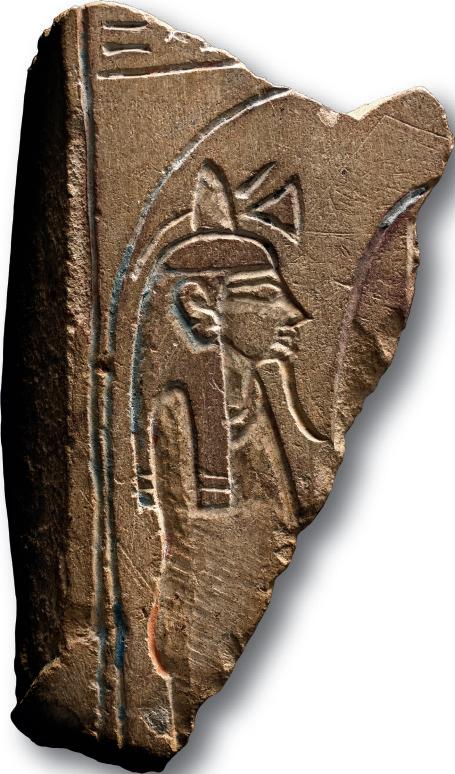

31
EGYPTIAN LIMESTONE RELIEF ‡
LATE-PTOLEMAIC PERIOD, 664-30 B.C.
8¾ in. (1.61 kg total, 22.2 cm including stand)
Relief fragment comprising: a sun disc with high-relief scarab motif to the centre; below this, a head in profile wearing a tiered wig with uraeus to the brow; mounted on a custom-made stand.
£1,000 - 1,400
PROVENANCE: Collection of Mr C., Geneva, Switzerland (1936-2016), assembled between 1985 and 2010.
32
EGYPTIAN LIMESTONE FRAGMENT ‡ NEW KINGDOM, 1550-1295 B.C.
4¼ in. (190 grams, 10.8 cm)
Architectural fragment with two dressed faces; incised design comprising: vertical border to the left; a band of hieroglyphic text at the top; an arch enclosing a seated figure in profile wearing a tripartite wig and collar with curved beard, head cone and frond above; curved linear element meeting the end of the beard; traces of white, blue, red-brown and other pigments; chamfered edge pierced in modern times for mounting.
£1,500 - 2,000
PROVENANCE:
From the estate of a deceased American, acquired between 1970-1989. with Bonham’s, London, Knightsbridge, 28 October 2009, no.23 [part].
33
EGYPTIAN HAEMATITE MACE HEAD
4TH-3RD MILLENNIUM B.C.
2 3/5 in. (457 grams total, mace: 60 mm high)
Globular body with short socket and thickened rim; accompanied by a custom-made display stand.
£600 - 800
PROVENANCE: Ex Norman Fargo collection. with Olympia Auctions, 26 June 2024, no.119.
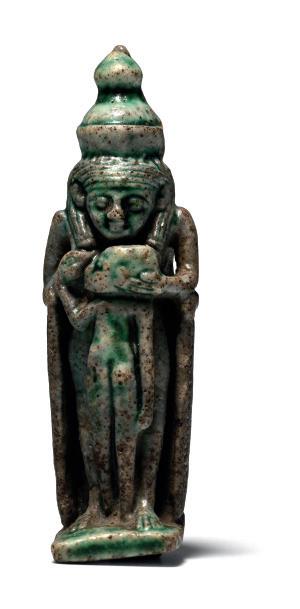
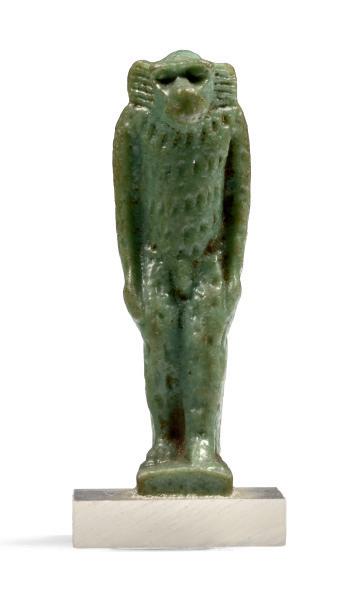
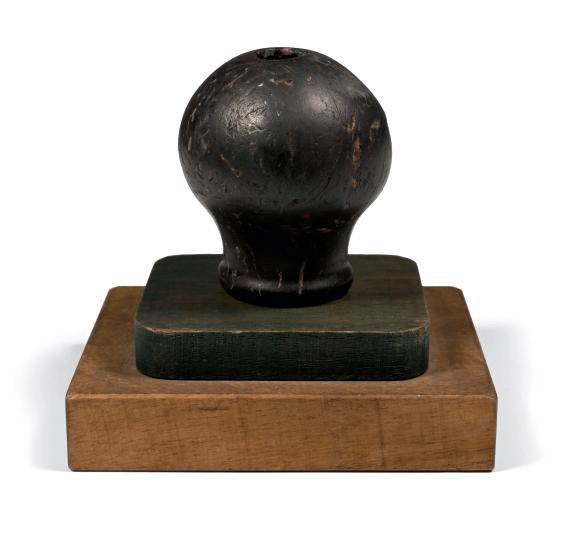
34
EGYPTIAN GREEN GLAZED STEATITE SYNCRETIC AMULET OF MUT
THIRD INTERMEDIATE PERIOD, CIRCA 1069-735 B.C.
2 in. (22.6 grams, 61 mm)
Modelled in the round, formed as the goddess standing before a highbacked throne cradling the head of a standing naked child to her chest; the goddess with tiered double-crown and tripartite wig; throne with low-relief figure of the lioness-headed goddess Sekhmet to the rear with spread wings forming the arms of the chair.
£2,000 - 3,000
PROVENANCE: with Jean-Phillipe Mariaud de Serres, Paris, France. Private collection, London, UK, acquired from the above in 1992.
FOOTNOTES:
Mut was a prominent mother goddess in ancient Egyptian religion, associated with creation, motherhood, and the sky. She was the consort of the god Amun and the mother of Khonsu, forming the Theban triad with them in Thebes. Mut’s name (mother in ancient Egyptian), reflects her role as a divine mother and patroness of motherhood. Sekhmet was revered as a powerful and fierce protector. Her presence was believed to ward off evil and safeguard the people from harm. In ancient Egyptian mythology, Sekhmet was also a manifestation of Hathor, another powerful birth goddess.
35
EGYPTIAN GREEN GLAZED FAIENCE AMULET OF A MONKEY THIRD INTERMEDIATE PERIOD, CIRCA 1069-735 B.C.
1 in. (6.1 grams total, 43 mm including stand)
Modelled in the round with dorsal pillar and loop, small base.
£800 - 1,000
PROVENANCE:
Collection of Monsieur M.; Etude Tajan, Paris, 26 February 1996, no.101. Private collection, London, UK, acquired from the above sale.
Accompanied by a copy of a French cultural passport, dated 21 March 1996.
FOOTNOTES: The vervet monkey was a symbol of love and sexual fulfilment.
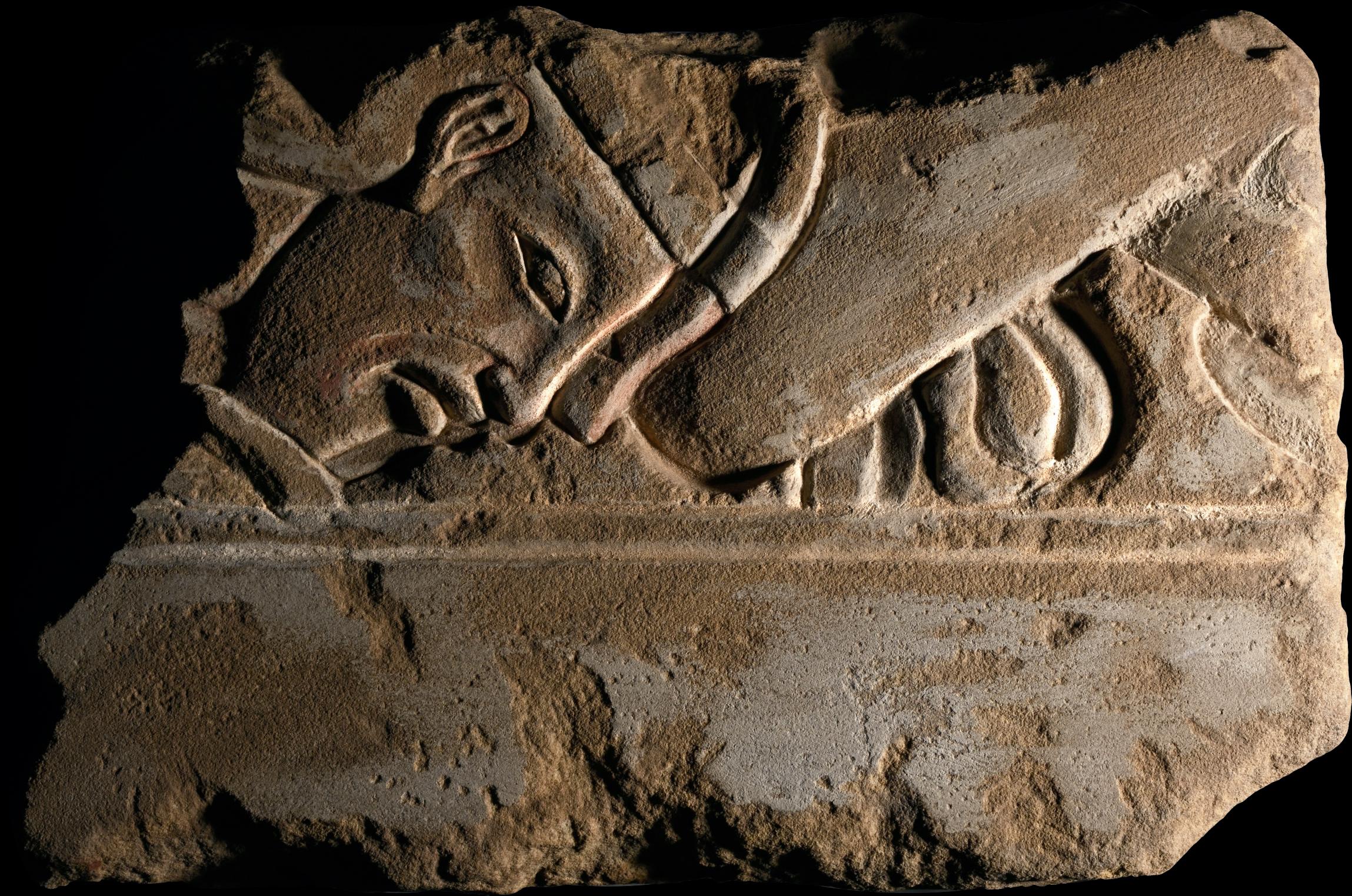

EGYPTIAN AMARNA LIMESTONE RELIEF FRAGMENT ‡ NEW KINGDOM, 18TH DYNASTY, 14TH CENTURY B.C. 13 in. (5.11 kg, 33 cm)
Rectangular in plan with irregular left and lower edge; carved in lowrelief in two registers with narrow border; lower register - plain with cream-white pigment; upper register – a combat or possibly post battle or tribute scene depicting two profile male heads with stern features, lentoid eye, strong mouth and chin, wearing brow-bands, probably Western Asiatics; with the leg of a kneeling(?) figure to the right; the reverse dressed but undecorated; two modern mounting holes to the long edge.
£15,000 - 20,000
PROVENANCE: Private collection, 1980s. Private European collection, 2008.
FOOTNOTES:
Scenes of captured enemies and especially foreign envoys in audience with the pharaoh depict figures in various humiliating, supplicatory poses, including prostration and kneeling.
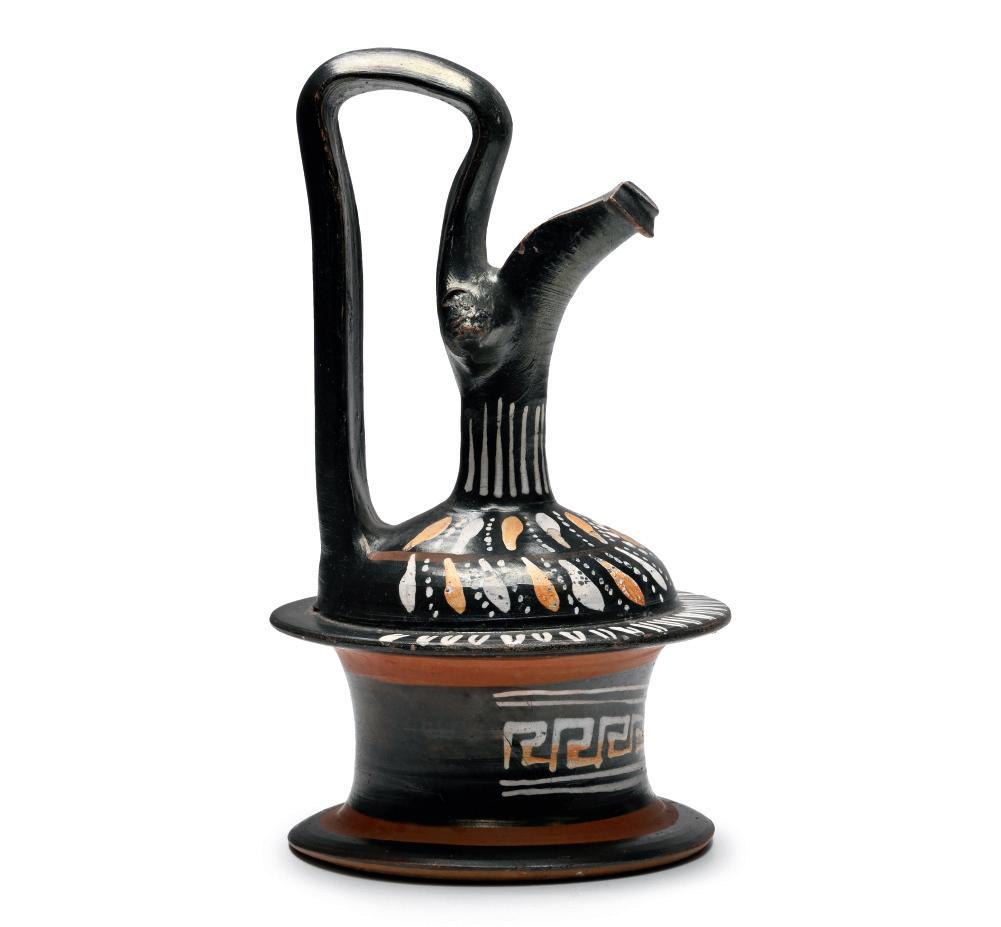
38

GREEK APULIAN BLACK-GLAZED EPICHYSIS WITH EROS
SOUTH ITALIC, CIRCA 325-300 B.C.
6¾ in. (255 grams, 17 cm)
Blackware with spool base, domed upper face, tall neck with spout and strap handle to the rear; the spool with laurel-leaf band in white, the upper face with tendrils in cream and ochre, winged Eros crouching holding up a mirror; repaired with some repainting. [No Reserve]
£500 - 700
PROVENANCE:
From the private collection of a Canadian gentleman living in Essex, UK, formed since the 1920s-circa 1990.
Property of an Essex lady until the late 1990s; thence by descent.
From the private collection of an Essex gentleman since the late 1990s.
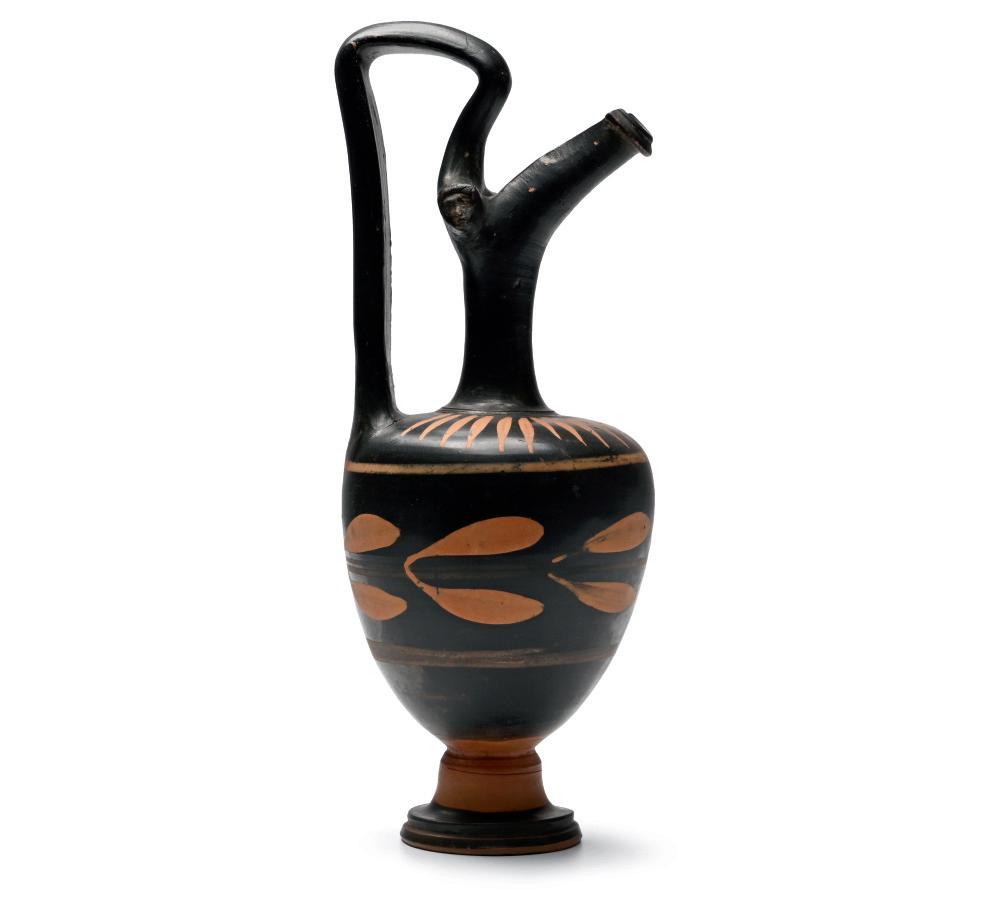
40

GREEK APULIAN RED-FIGURED PROCHOUS WITH LADY OF FASHION
SOUTH ITALIC, CIRCA 4TH CENTURY B.C.
8 in. (362 grams, 20.8 cm)
With pedestal base, piriform body, tapering neck with beak-like spout and tall strap handle to the rear; the body painted with palmette spray beneath the handle and profile bust of a lady of fashion with cream and white detailing, restored. [No Reserve]
£500 - 700
PROVENANCE:
From the private collection of a Canadian gentleman living in Essex, UK, formed since the 1920s-circa 1990.
Property of an Essex lady until the late 1990s; thence by descent.
From the private collection of an Essex gentleman since the late 1990s.
37

GREEK APULIAN BLACKWARE EPICHYSIS
SOUTH ITALIC, CIRCA 4TH CENTURY B.C.
5¾ in. (183 grams, 14.5 cm)
With spool base, domed upper face, tall neck with spout and strap handle to the rear; the spool with meander band in cream and white, the upper face with frond pattern in cream and white, parallel vertical strokes to the base of the spout. [No Reserve]
£400 - 600
PROVENANCE:
From the private collection of a Canadian gentleman living in Essex, UK, formed since the 1920s-circa 1990.
Property of an Essex lady until the late 1990s; thence by descent.
From the private collection of an Essex gentleman since the late 1990s.

39

GREEK APULIAN BLACKWARE PROCHOUS WITH LAUREL LEAVES
SOUTH ITALIC, CIRCA 4TH CENTURY B.C.
7 in. (172 grams, 18 cm)
With pedestal base, bulbous body, broad shoulder, tapering neck with beak-like spout and tall strap handle to the rear; the body painted with a laurel-leaf frond. [No Reserve]
£400 - 600
PROVENANCE:
From the private collection of a Canadian gentleman living in Essex, UK, formed since the 1920s-circa 1990.
Property of an Essex lady until the late 1990s; thence by descent. From the private collection of an Essex gentleman since the late 1990s.
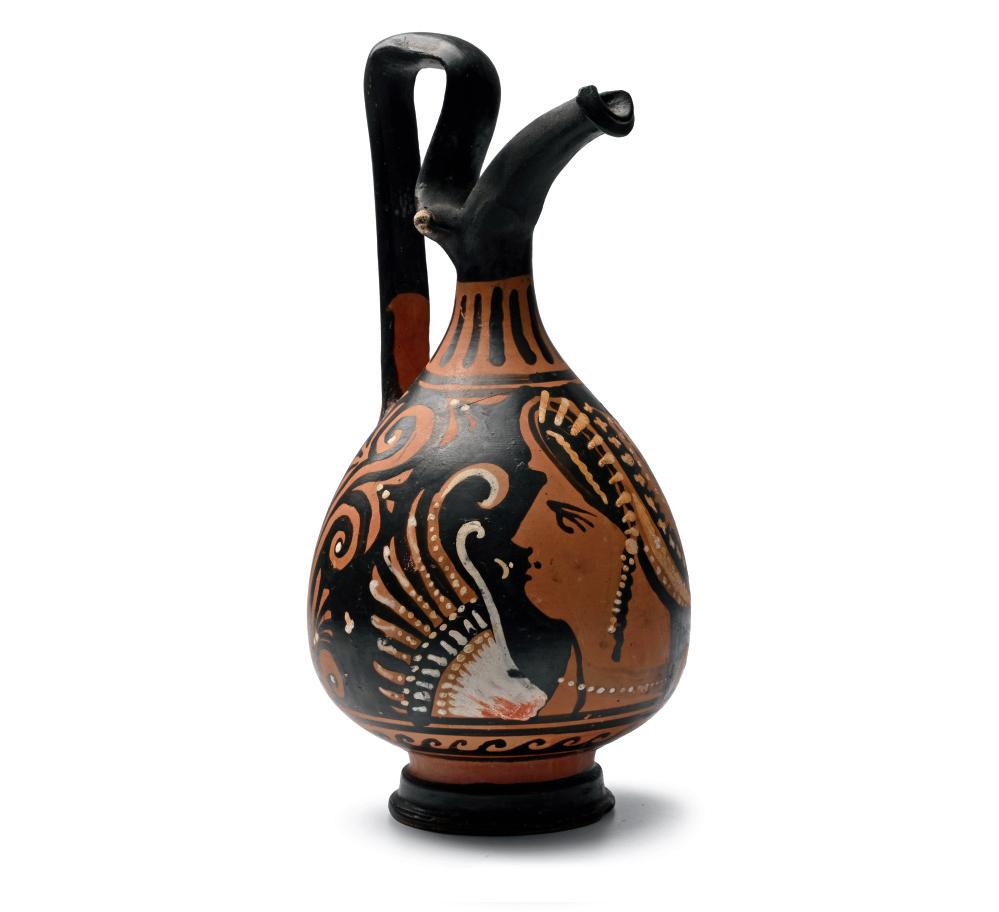
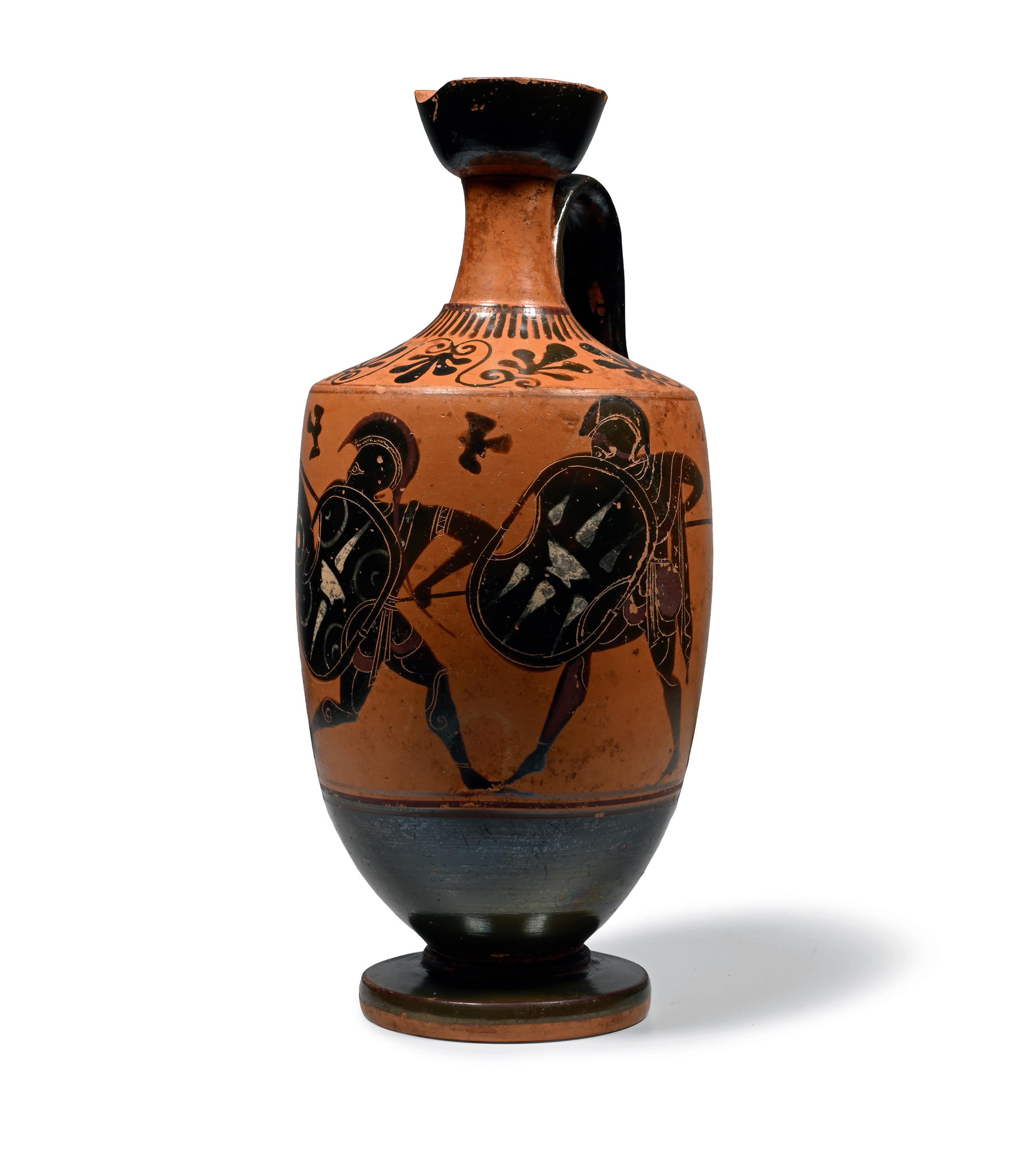

GREEK ATTIC BLACK-FIGURE LEKYTHOS WITH COMBAT SCENE ‡ CIRCA 520 B.C.
10 in. (481 grams, 26.5 cm)
The ovoid body decorated with a combat scene, band of tendrils and leaves to the shoulder and vertical bands to the slender neck, trumpet-shaped mouth, strap handle and discoid foot; the scene comprising three Hoplites, the first in tall-crested Corinthian helmet, cuirass and greaves, xiphos hanging on his right side, thrusting with his long spear over his ellipsoid shield towards the middle figure, running forwards but with his helmetted head turned towards his attacker, using his Boeotian shield to ward off the blow while manoeuvring his own spear blocked by the third figure advancing against him, with spear held underarm, with birds in flight above.
£18,000 - 24,000
PROVENANCE: Private collection, Southern Germany, acquired in 1960s. with Paul-Francis Jacquier, Numismatique Antique, Münzen und Kunst der Antique, 13 September 2013. Acquired by the present owner at the above sale.
FOOTNOTES:
The clothing and weapons of the hoplites are detailed copies of hoplites of late decades of 6th century B.C. The left warrior wears a Corinthian helmet with a high crest, a richly decorated robe and greaves. His round Attic shield, from which a richly pleated chlamys hangs down, is decorated with large circles. The middle and the right hoplite wear Corinthian helmets with a lower crest, and also beautifully decorated robes and greaves. They hold very large, Boeotianshaped shields with striking bundles of lightning and ‘flames’. As a beautiful counterpart to the left fighter, the right warrior carries a chlamys with long folds over his shoulder.

43
GREEK TERRACOTTA FEMALE ANTEFIX ‡ ARCHAIC, 6TH-5TH CENTURY B.C.
10½ in. (411 grams, 26 cm)
Mould-made figure of a female upper body with tall curved and conical headdress, hair dressed in braids falling to her shoulders and flanking her breasts, arms spread and right hand curled to grip a handle or sword-hilt; beneath, a tapering mounting peg for attachment to a roof.
£2,000 - 3,000
PROVENANCE:
Acquired in the mid 1980s-1990s.
Private collection, Switzerland, thence by descent. Private collection, since the late 1990s.
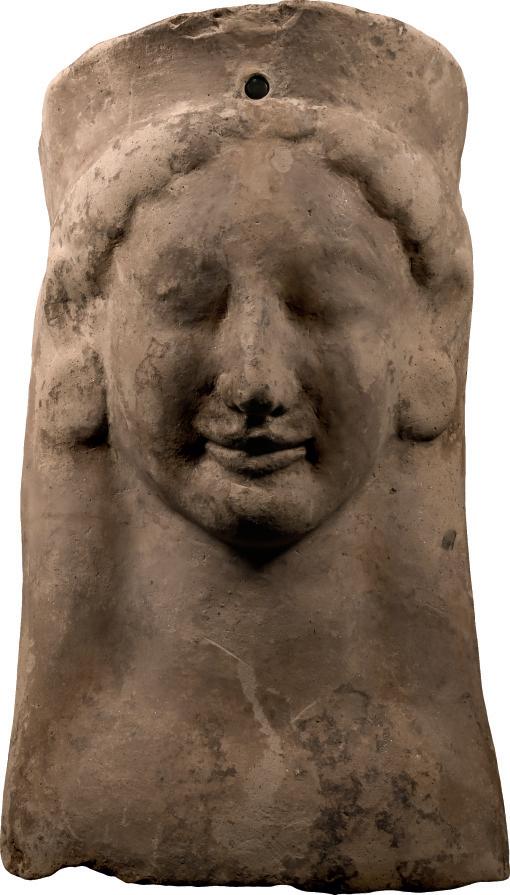
42

MASSIVE ARCHAIC GREEK TERRACOTTA STATUETTE OF A SEATED GODDESS DEMETER ‡ LATE 6TH CENTURY B.C.
22¾ in. (2.02 kg, 57.7 cm)
Seated on a high-backed throne, wearing a polos headdress with two long braids falling from underneath the headdress, wearing a long chiton fastened by a belt, the left arm raised, possibly once holding a dove; well marked facial features, slightly almond-shaped large symmetrical eyes with slightly raised eyelids, straight nose, strongly pronounced mouth with fleshy lips and shallow ears; traces of brown slip, repaired.
£3,000 - 4,000
PROVENANCE: with H.A.C., Basel, prior 1999.
Accompanied by a thermoluminescence analysis report no.N125a51 from Oxford Authentication.
FOOTNOTES:
One of the most typical 6th century B.C. terracotta female figurines was that of a standing or seated woman wearing a chiton and a himation over it. It was a votive figure offered at the shrines or temples, usually representing the goddess Demeter. Attica was one of the principal centres of figurine production, but Corinth continued to produce solid standing or seated females with moulded fronts and flat backs. The mass production of such terracotta was also typical of Magna Graecia.
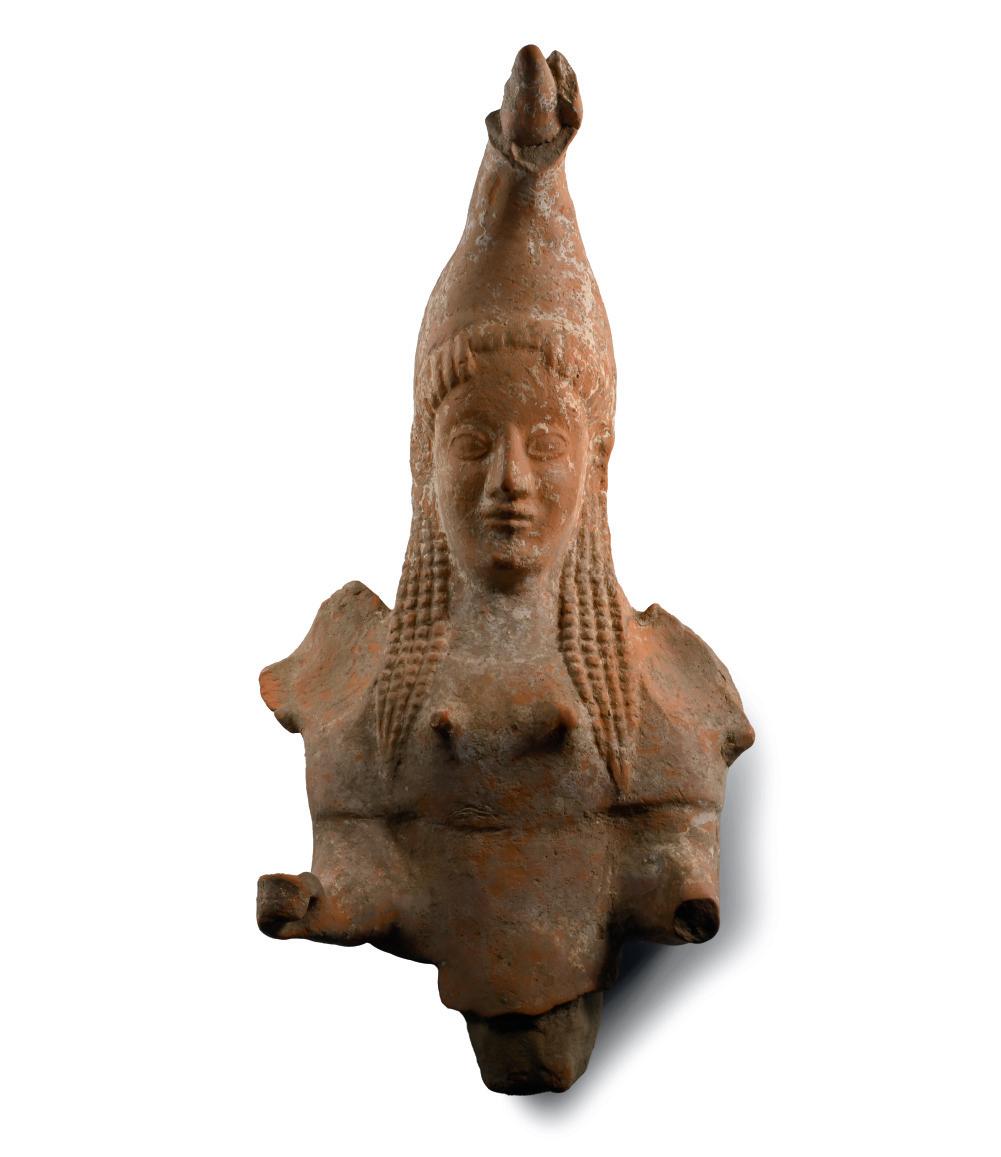
44
GREEK TERRACOTTA FEMALE PROTOME ‡
EARLY 5TH CENTURY B.C.
7¾ in. (606 grams, 19.5 cm)
Mould-made female protome with oval face, graceful nose and typical archaic smile; forehead framed by snail-shell curls descending to shoulder-height; with a low polos with a central perforation and large disc earrings.
£1,500 - 2,000
PROVENANCE: Ex Herbert A. Cahn, Kunst der Antike, Basel, 1997. with Paul and Vreny Vosseler-Studer, Riehen.
Accompanied by a copy of an Art Loss Register certificate no.S00057826.
PUBLISHED:
Cat.9, Griechische und Etruskische Kunstwerke archaischer Zeit, (Basel 1998) no.19.
45

GREEK SILVER RHYTON WITH MYTHOLOGICAL SCENES AND GLASS INLAYS
NORTH-EASTERN PONTIC AREA, 1ST-2ND CENTURY
10½ in. (157 grams, 26.5 cm)
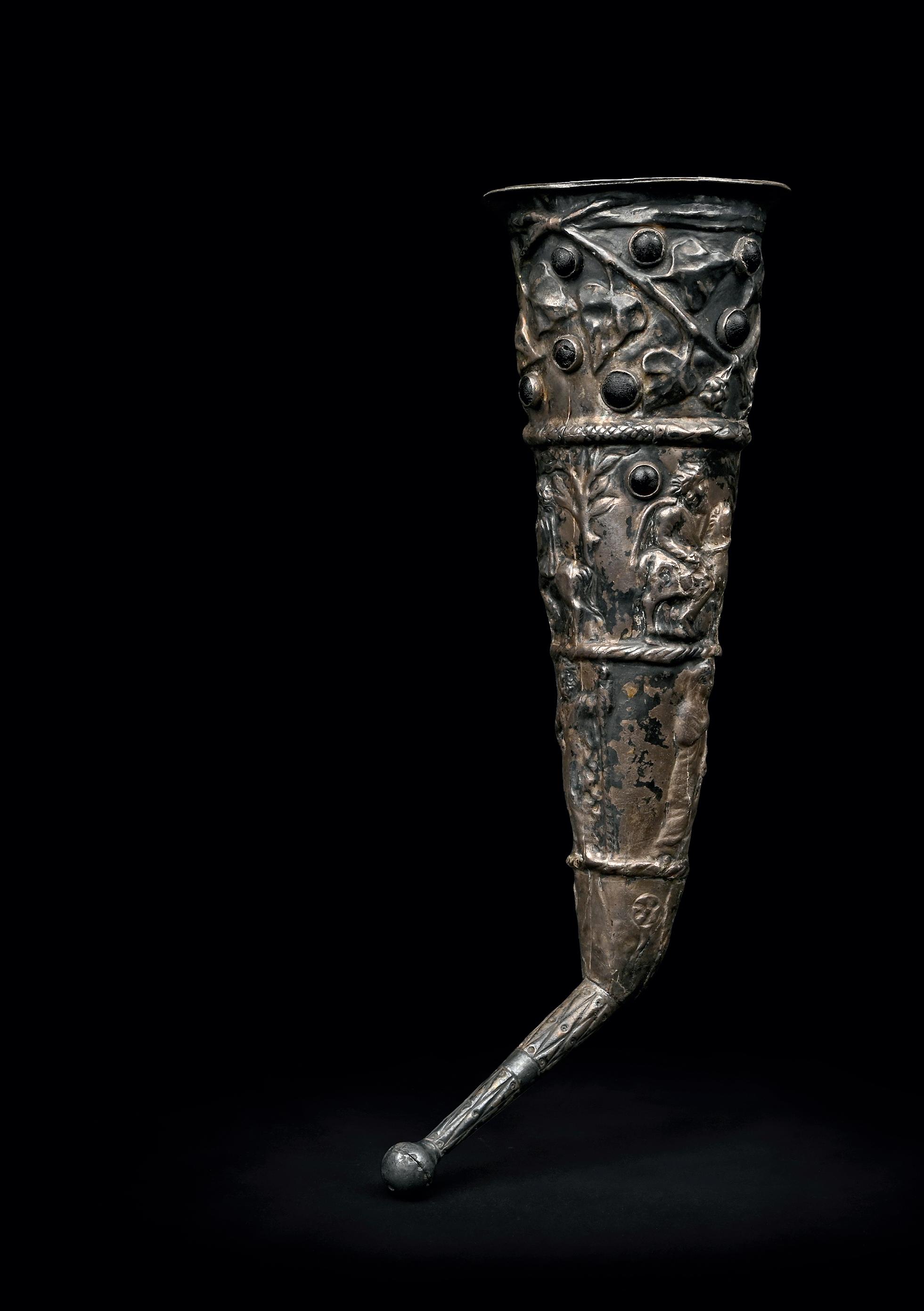
A.D.
Comprising a conical body, a flat out-turned rim and a tubular spout with a ball-shaped terminal, made in two halves hammered over a relief matrix and then soldered together; the body divided into four horizontal registers separated by narrow bands in high-relief, the uppermost band formed as a stylised garland and the lower two ornamented with oblique notches; the upper register decorated with a bound garland of ivy weaving between applied cells filled with inlays of blue and red glass; the register below bearing a figural frieze with (from left to right, starting from the join): a tree with short branches and large leaves, a rider to the right, another tree, Athena moving to the left, wearing a Corinthian helmet, with an aegis on her breast and carrying a round shield and a spear, another tree, a rider moving to the left with the right hand stretched forward and upwards; the central lower register also decorated with a figural frieze: a swathed female figure standing with a sceptre in the right hand, a male figure turned to the left wearing a Corinthian helmet and carrying a spear, a bearded male figure wearing a chiton and himation with a phiale in the right hand, leaning on a vertical staff; the lower register decorated with elongated triangular leaves alternating with stemmed buds in relief, stamped with heart-shaped petals; the spout decorated with two zones of elongated lozenges stamped with ring-and-dot motifs and separated by an undecorated band; the ball terminal made in two halves with a soldered join disguised with a band of punched rings and dots; housed in a custom-made velvet-lined box.
£18,000 - 24,000
PROVENANCE: North European private collection, 1980s. Private collection, acquired in 2005.
PUBLISHED: Masterpieces of Ancient Eurasian Art - Volume 1, 2008.
FOOTNOTES: Bronze matrices for such horns were found at the turn of the century in the vicinity of Tuapse on the eastern coast of the Black Sea; these are now kept in the Hermitage. While the style of the decoration suggests that the craftsman who made the matrices had a distant knowledge of the type of late Hellenistic ornament figured on objects of Parthian manufacture, its provincial presentation suggests that the matrices cannot have been made earlier than the 1st century A.D. The decoration of the tube finds a parallel on the tube of a silver-gilt rhyton of a similar construction with four decorative friezes on the horn, including the motifs, wide-spread in the art of the Roman Empire, such as amours carrying garlands, which was exhibited at the Christie’s in New York in 2003. A defining feature of this rhyton is the glass inlays in the upper two registers which are placed randomly, primarily in the upper field below the rim. Such inlaid cells were widely used on jewellery and vessels made of precious metals in the late Hellenistic period, as for example on the mounts and belt tabs from Zubov barrow no. 1 in the Kuban area. They were also employed in the 1st to 2nd centuries A.D. in the North Pontic area, and it seems possible that the matrices and the rhyton date to this period and were executed in a workshop located on the fringe of the Roman world. This is likely to have been one of the local workshops, whose products catered to the tastes of the populations of the foothills of the north-western Caucasus. The images of the deities represented on the rhyton are of considerable importance for understanding the culture and religious beliefs of the populations of this area.
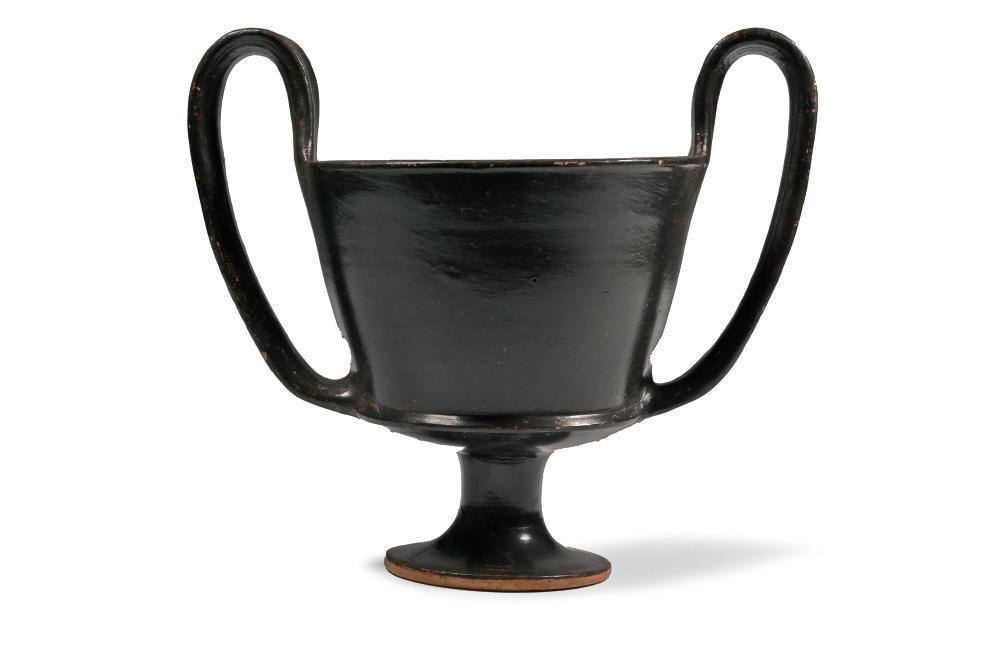
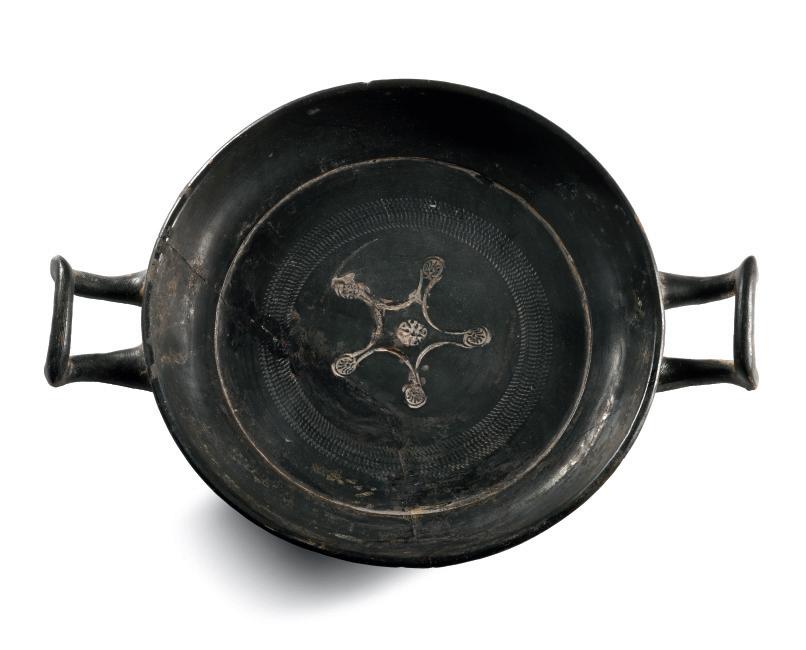

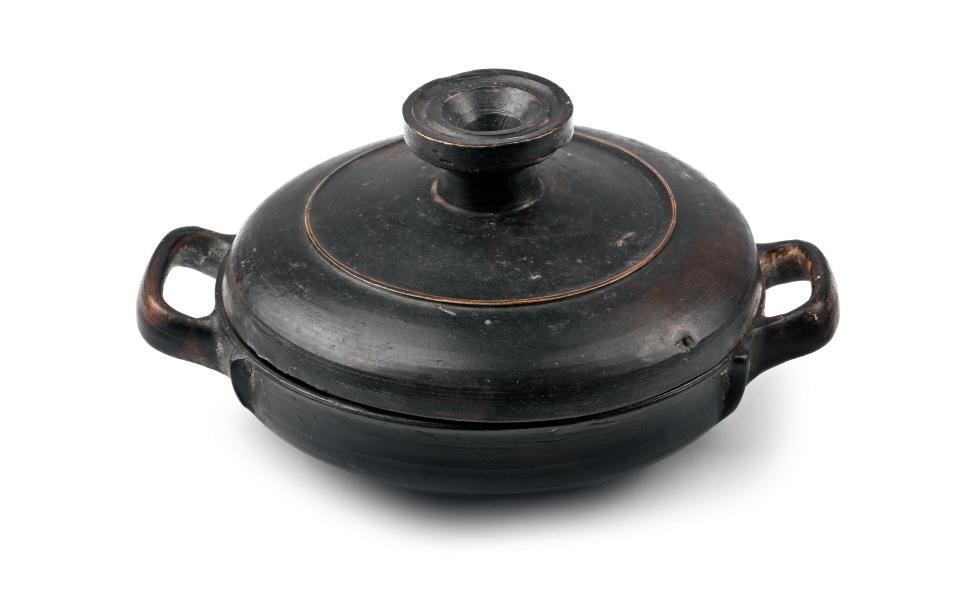
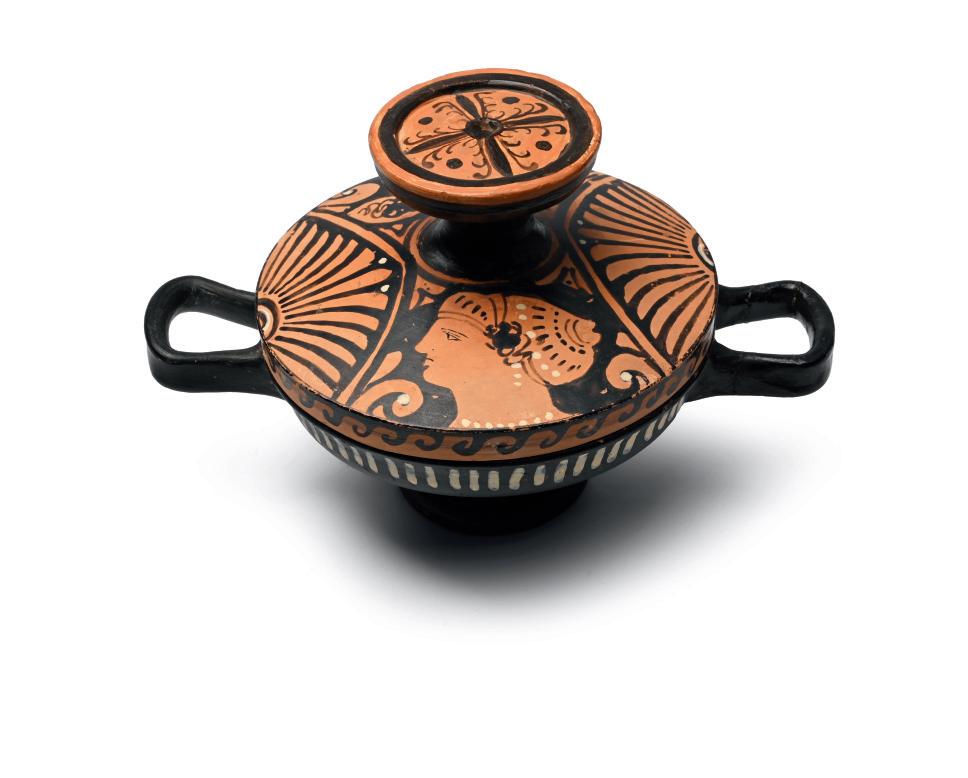
46
GREEK TERRACOTTA BLACK-GLAZED KANTHAROS ‡ BOEOTIA, 5TH CENTURY B.C.
7¾ in. (360 grams, 19.5 cm wide)
With a tall flared foot, tapering body and two lateral high strap handles, the sidewall set off from the foot by a carination; reassembled from fragments.
£700 - 900
PROVENANCE:
Ex Mr Bohler, Bern, Switzerland, prior 2001.
Accompanied by a copy of an Art Loss Register certificate no.S00074898.
47
GREEK TERRACOTTA BLACK-GLAZED STEMLESS CUP ‡ CAMPANIAN, CIRCA 4TH CENTURY B.C.
8 in. (227 grams, 20.5 cm)
With two lateral handles on a low, profiled ring foot; incised and stamped decoration to the interior comprising a central blossom surrounded by palmettes connected by curved lines, the whole framed by a concentric circle made up of dashes; restored.
£700 - 900
PROVENANCE: with S.C., Basel, prior 2003.
Accompanied by a copy of an Art Loss Register certificate no.S00075178.
48
GREEK BLACK-GLAZED KYLIX WITH FLORAL DESIGN CAMPANIAN, CIRCA 4TH CENTURY B.C.
8 in. (283 grams, 22.5 cm)
Comprising a low foot of rare profile, with two toruses; five interconnected palmettes to the tondo; concentric rib on the interior, looped handles. [No Reserve]
£400 - 600
PROVENANCE:
From the private collection of a Canadian gentleman living in Essex, UK, formed since the 1920s-circa 1990.
Property of an Essex lady until the late 1990s; thence by descent.
From the private collection of an Essex gentleman since the late 1990s.
49
GREEK ATTIC BLACK-GLAZED LIDDED LEKANIS
SOUTH ITALIC, CIRCA 450-440 B.C.
7½ in. (500 grams, 19 cm wide)
Comprising a squat bowl with two loop handles and flanking vertical ribs, domed lid with raised collar and knop handle. [No Reserve]
£500 - 700
PROVENANCE:
From the private collection of a Canadian gentleman living in Essex, UK, formed since the 1920s-circa 1990.
Property of an Essex lady until the late 1990s; thence by descent.
From the private collection of an Essex gentleman since the late 1990s.
50
GREEK APULIAN RED-FIGURE LEKANIS WITH LADIES OF FASHION
SOUTH ITALIC, CIRCA 4TH CENTURY B.C.
6½ in. (249 grams, 16.5 cm wide)
With black-glazed body and matching lid decorated with two heads of ladies of fashion, palmettes between, radial lines on the knob handle and a wave-band around the rim; square strap handles at the shoulder. [No Reserve]
£400 - 600
PROVENANCE:
From the private collection of a Canadian gentleman living in Essex, UK, formed since the 1920s-circa 1990.
Property of an Essex lady until the late 1990s; thence by descent.
From the private collection of an Essex gentleman since the late 1990s.
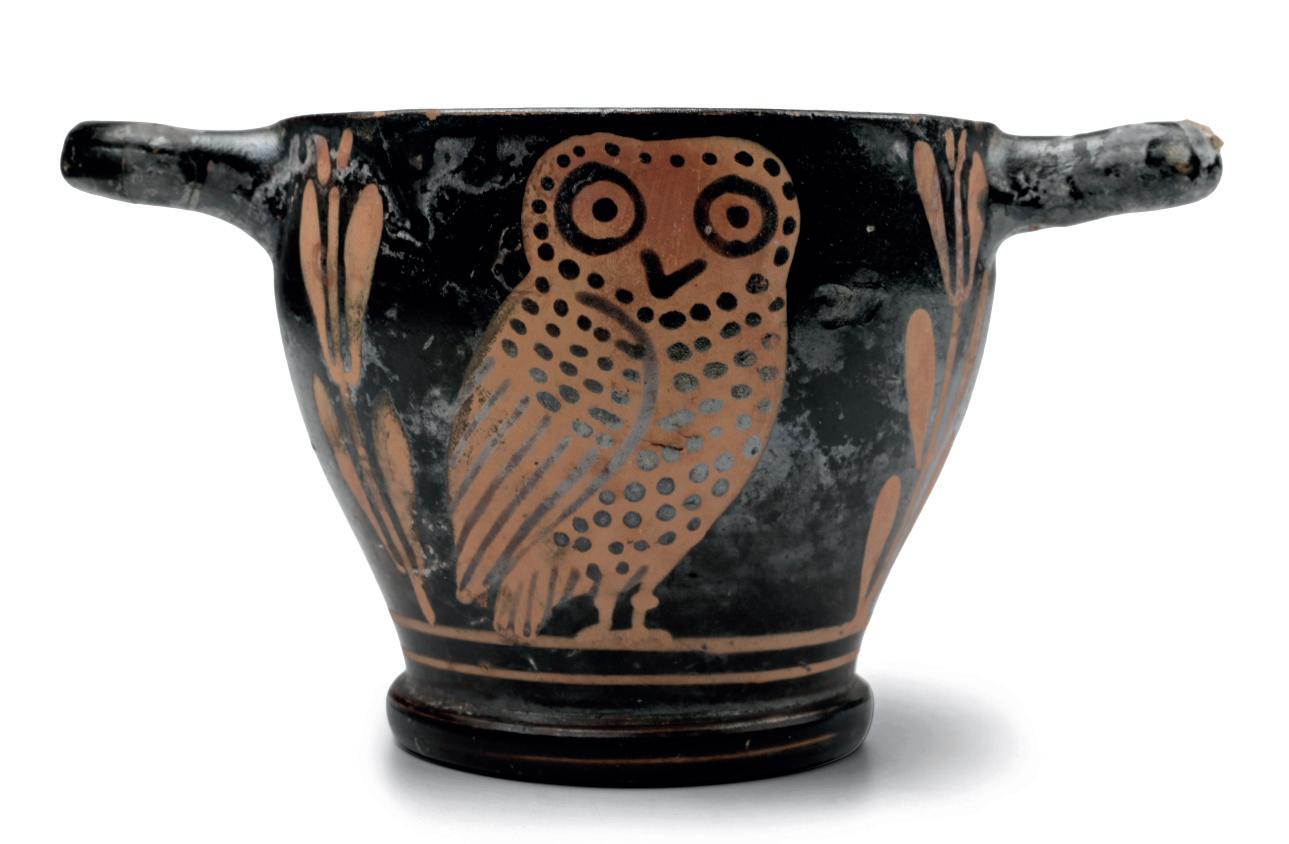
51

SOUTH ITALIAN RED-FIGURE SKYPHOS WITH OWL ‡
5TH-4TH CENTURY B.C.
6 in. (239 grams, 17.5 cm)
With mammiform body, pedestal base and two loop handles; each side with a facing image of an owl between laurel fronds.
£3,000 - 4,000
PROVENANCE:

Swiss private collection, assembled in the 1960s-1970s.
Private collection, acquired in 2013.
52

GREEK RED-FIGURE EPICHYSIS ‡
4TH-2ND CENTURY B.C.
7½ in. (175 grams, 19.1 cm)
With pedestal foot, bulbous body, flared neck, pinched rim with lateral lugs and extended pouring lip, ribbed strap handle to the reverse; radiating white pellets and vertical red strokes to the neck, palmette to the reverse and profile seated figure of a lady of fashion with stephane and necklace, holding a wreath in one hand and a platter in the other; objects in the field; old collector’s references to underside.
£1,500 - 2,000
PROVENANCE:
From the estate of a deceased American, acquired between 1970-1989. with Bonham’s, London, Knightsbridge, 28 October 2009, no.23 [part].
53

GREEK CORINTHIAN ARYBALLOS WITH WINGED DEITY AND SWAN
7TH-6TH CENTURY B.C.
5¾ in. (180 grams, 14.7 cm)
Piriform in shape with flattened bottom and rosette; the neck narrow with wide flat rim, pierced lug handle; the body with lively decoration featuring a central winged harpy with head in profile, body turned to the right and wings spread, rosettes in the field, all painted in a dark brown and purplish brown slip with sgraffito highlights; reverse with standing swan with sgraffito detailing.
£1,200 - 1,700
PROVENANCE:
Acquired on the European art market in the early 2000s. with Galerie Rhéa, Zurich, Switzerland.
54

GREEK TARENTINE JUG IN THE SHAPE OF A DOLPHIN ‡
4TH-3RD CENTURY B.C.
5¾ in. (170 grams, 14.6 cm)
Hollow-formed as a stylised dolphin with trumpet-shaped filler hole above, ribbed loop handle to one side, socle base and scooped tail forming the spout.
£4,000 - 6,000
PROVENANCE: Acquired in 1992.
Private collection, thence by descent. Private collection, since the late 1990s.


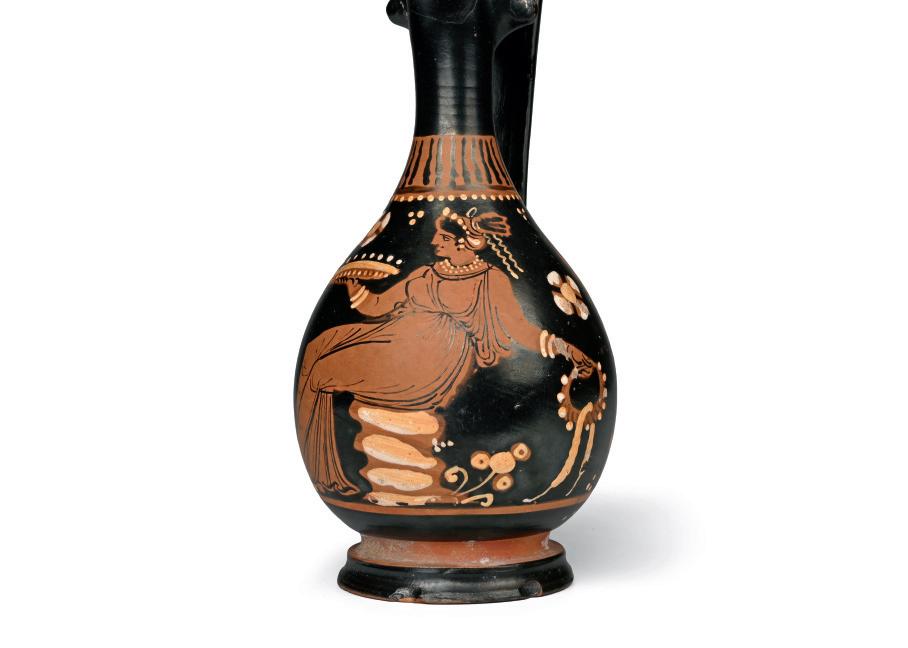
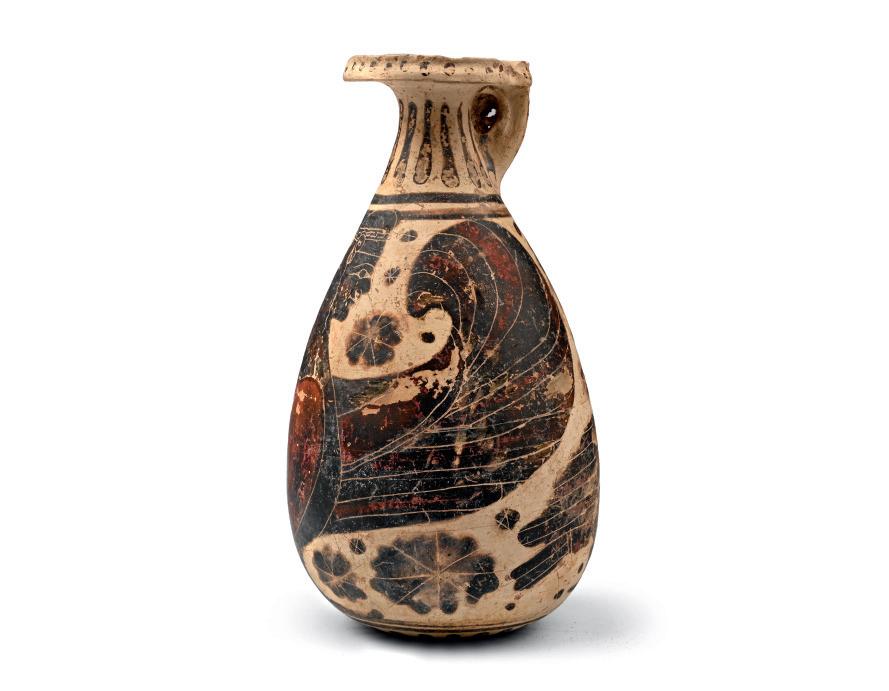
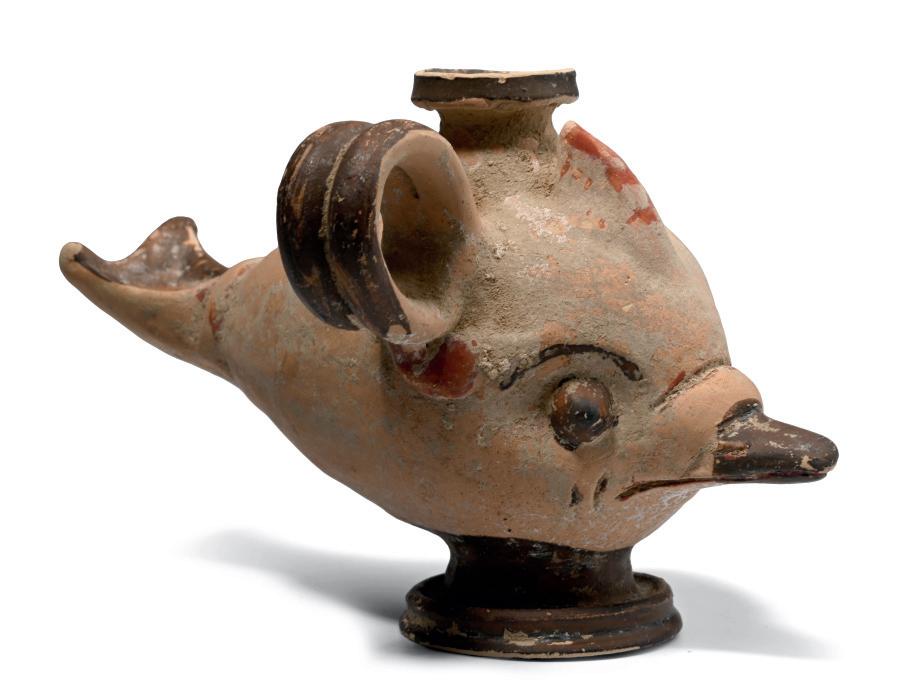
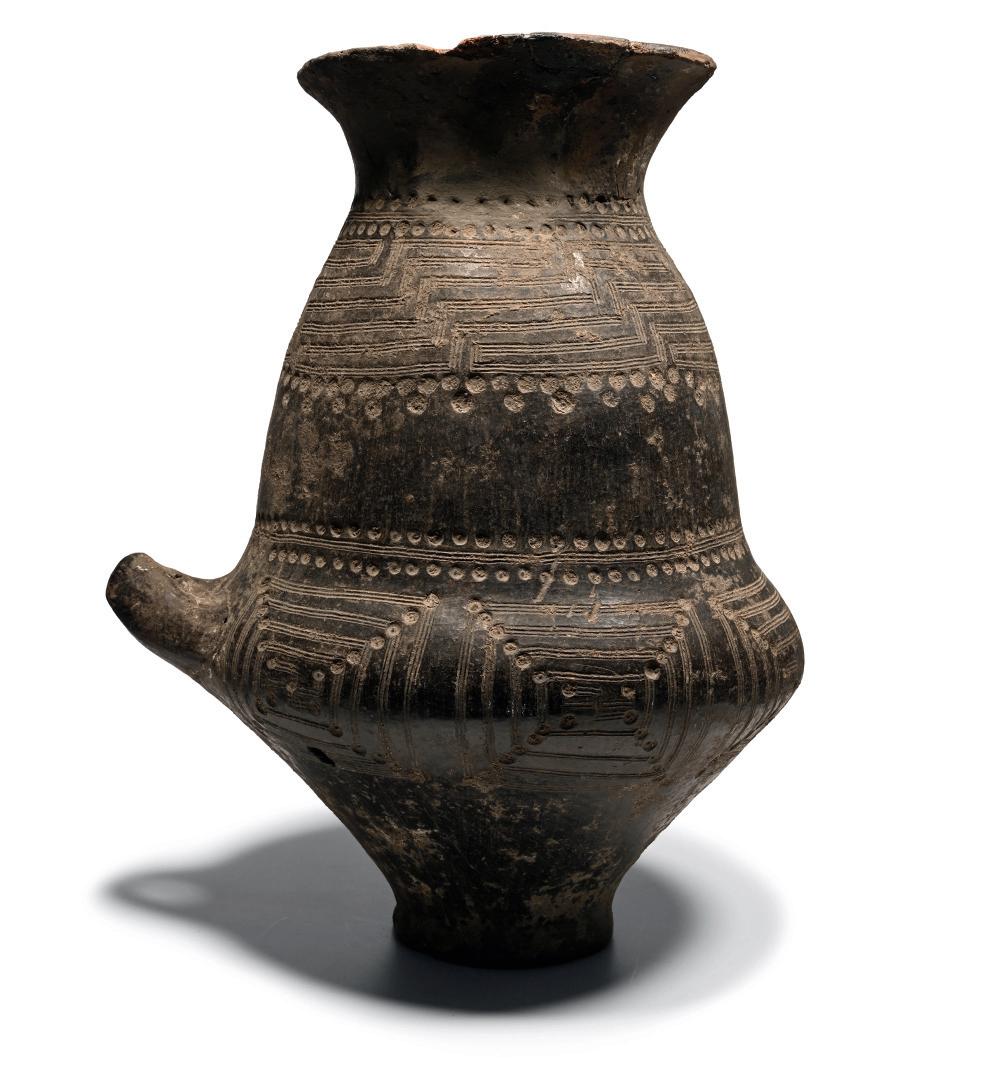
55

LARGE VILLANOVAN GEOMETRIC BLACK-GLAZED VASE WITH HANDLE ‡
9TH-8TH CENTURY B.C.
16¼ in. (4.5 kg, 41 cm)
Biconical impasto body with broad flaring rim, bell-shaped upper section with bands of incised geometric decoration and impressed roundels, lower section tiered and sharply funicular with narrow flat base, a lateral upturned loop handle; small hole beneath the carination, rim partly restored.
£1,800 - 2,400
PROVENANCE:
Dr. Gonik and the late Mr. Wirth, Geneva, Switzerland. European private collection.
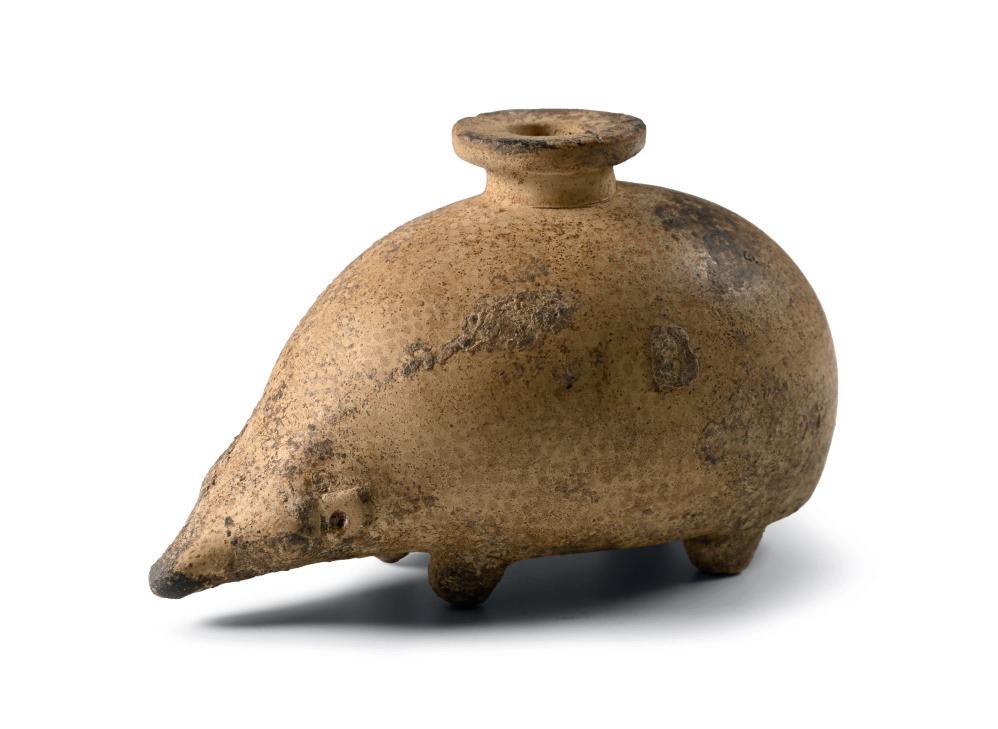
57
GREEK CORINTHIAN TERRACOTTA HEDGEHOG ARYBALLOS ‡
6TH CENTURY B.C.
3¾ in. (55 grams, 98 mm)
Hollow-formed with textured body and four stub legs, conical nose and lateral flanges with impressed point eyes; discoid flange rim to the neck with incised petal detailing.
£1,200 - 1,700
PROVENANCE:
Ex Mrs IM collection, nr 18 (widow of Leo Mildenberg), formed in Zurich, gift from her husband between 1975-2000. Acquired by the present owner from the above.

56
HELLENISTIC TERRACOTTA KOHL VESSEL
2ND CENTURY B.C.
4 in. (86 grams, 10.2 cm)
Hollow-formed as a nude figure rising from a prone position on an ellipsoid base; rosettes to foot; flared tubular mouth pinched into a trefoil.
£400 - 600
PROVENANCE:
Acquired on the European art market in the early 2000s. with Galerie Rhéa, Zurich, Switzerland.
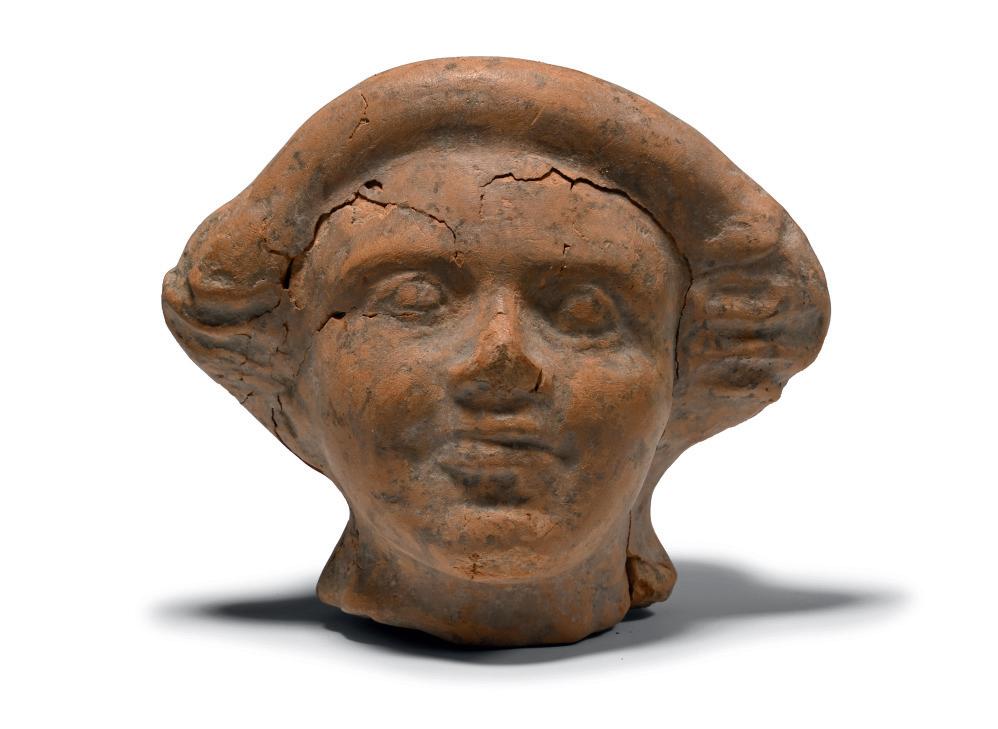
58
HELLENISTIC TERRACOTTA HEAD OF A WOMAN ‡
3RD-1ST CENTURY B.C.
4¾ in. (499 grams, 12.3 cm wide)
Hollow-formed with flared neck, moulded face with shallow lentoid eyes, snub nose and wide mouth with enigmatic smile; band of hair framing the face.
£600 - 800
PROVENANCE:
Acquired in the mid 1980s-1990s. Private collection, Switzerland, thence by descent. Private collection, since the late 1990s.
59

GREEK BLACK-GLAZED OINOCHOE
5TH CENTURY B.C.
8 in. (407 grams, 22 cm)
With trefoil mouth, applied D-section handle and tiered foot.
£5,000 - 7,000
PROVENANCE: Property from a private collection. with Sotheby’s, New York, 9 December 2003, no.9.
Accompanied by copies of the relevant Sotheby’s catalogue pages.
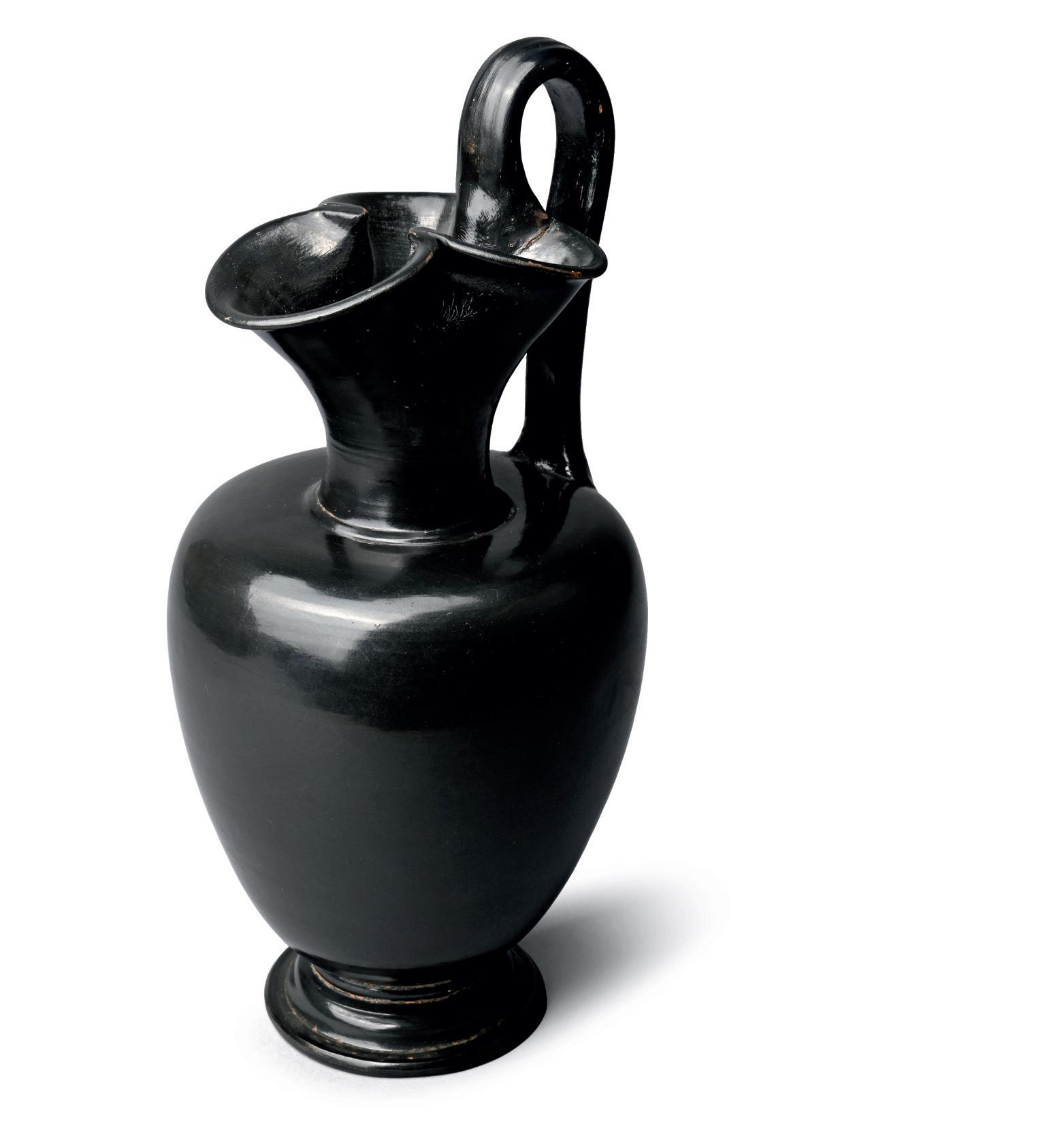
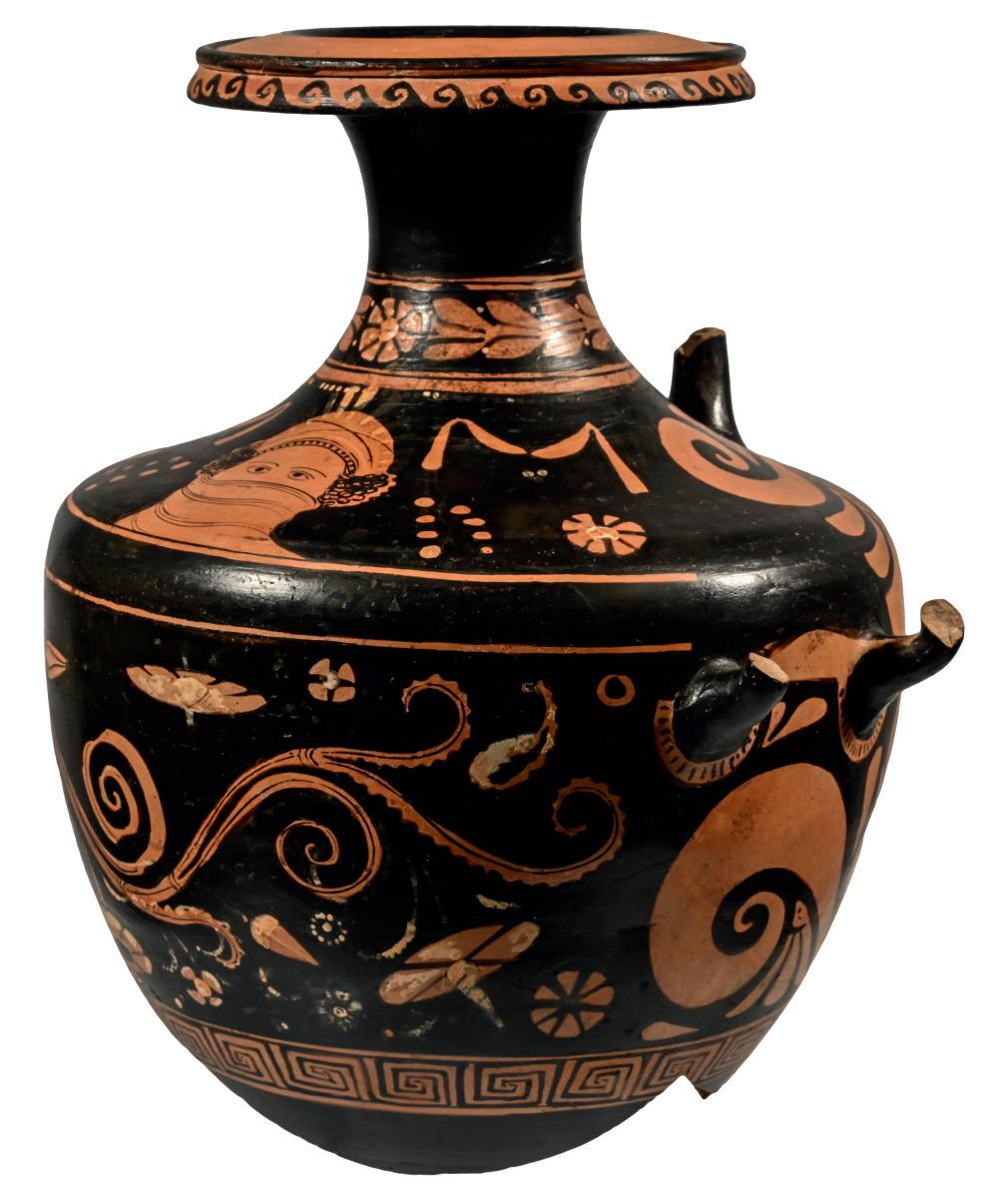
60

GREEK FRAGMENTARY TERRACOTTA RED-FIGURE HYDRIA ‡ PAESTAN OR APULIAN, 4TH CENTURY B.C.
12¼ in. (18¾ in.) (1.95 kg, 31 cm (2.6 kg total, 47.5 cm high including stand))
Comprising the upper two thirds of the vessel; on the shoulder a facing woman’s head with diadem and half-veiled face; rosettes to left and right, with suspended ribbons and dots; vine motif around the body with floral ornaments; to the reverse, palmettes and vines; band of laurel with rosettes around the neck and wavy band at the mouth; reassembled from various fragments with three large areas of restoration, only the beginnings of the handles preserved; mounted on a custom-made stand.
£5,000 - 6,000
PROVENANCE: Ex Herbert A. Cahn, Basel, 1990s.
FOOTNOTES:
The face-veiling gesture is a known marriage rite; the diadem may suggest that she is intended to represent Persephone. Alternatively, the veiled woman might be a dancer as many terracotta figurines of dancing women are shown with face-coverings. However, the floral ornaments could indicate a funeral or sepulchral context.
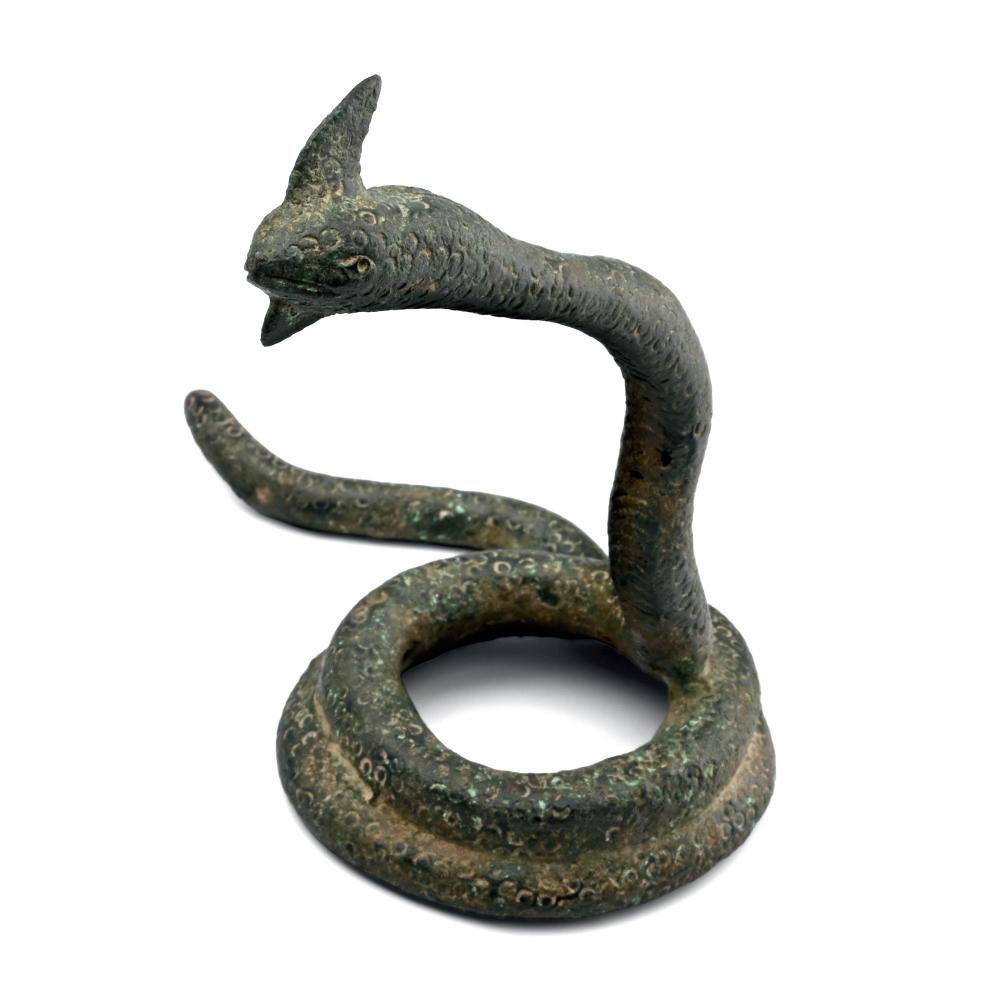
61

ARCHAIC GREEK BRONZE SNAKE ‡
6TH-5TH CENTURY B.C.
4¼ in. (312 grams, 11 cm)
Modelled in the round with coiled body and rearing head, barbed fin to the forehead, punched annulet texturing on the body.
£6,000 - 8,000
PROVENANCE:
Private collection, Neuchâtel, Switzerland, assembled in the 1980s. Acquired in 1995 by a European private collector. Private collection, since the late 1990s.
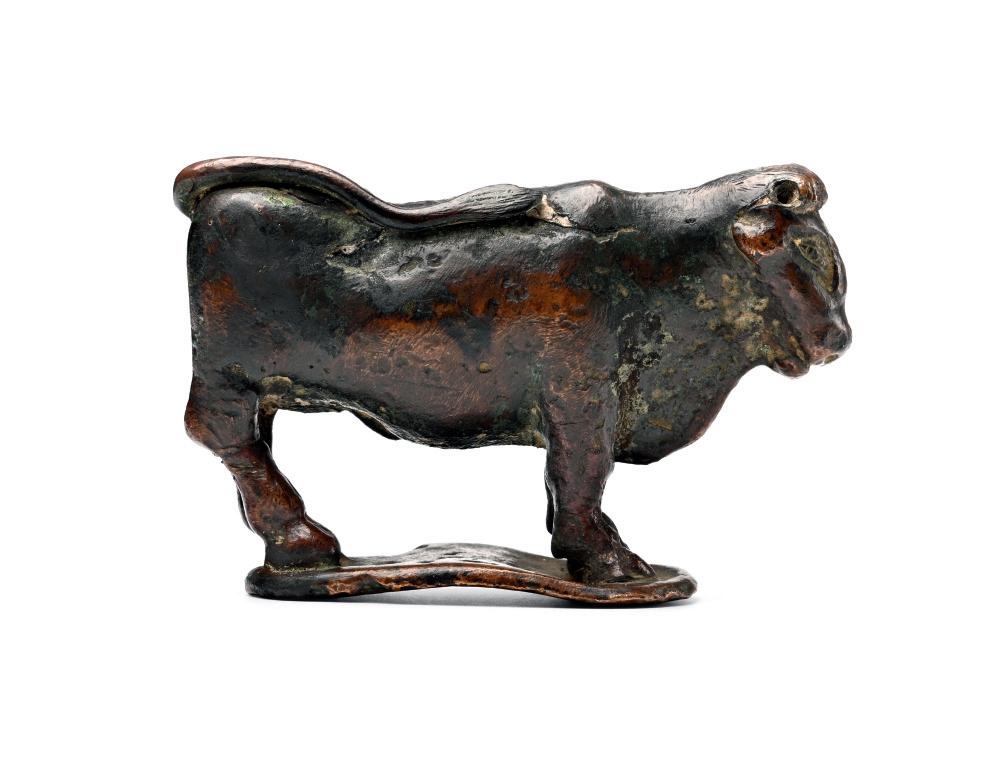
63
GREEK BRONZE SACRED BULL STATUETTE
4TH-3RD CENTURY B.C.
3¼ in. (331 grams, 82 mm)
Modelled standing on an ellipsoid base, sockets to the brow to accept separately modelled horns.
£500 - 700
PROVENANCE:
Acquired on the European art market in the early 2000s. with Galerie Rhéa, Zurich, Switzerland.

62
GREEK BRONZE VESSEL HANDLE WITH MEDUSA
4TH-3RD CENTURY B.C.
3¾ in. (257 grams, 94 mm)
Comprising an ellipsoid domed plaque with grotesque gorgoneion in high-relief, ribbed loop handle.
£500 - 700
PROVENANCE:
Acquired on the European art market in the early 2000s. with Galerie Rhéa, Zurich, Switzerland.
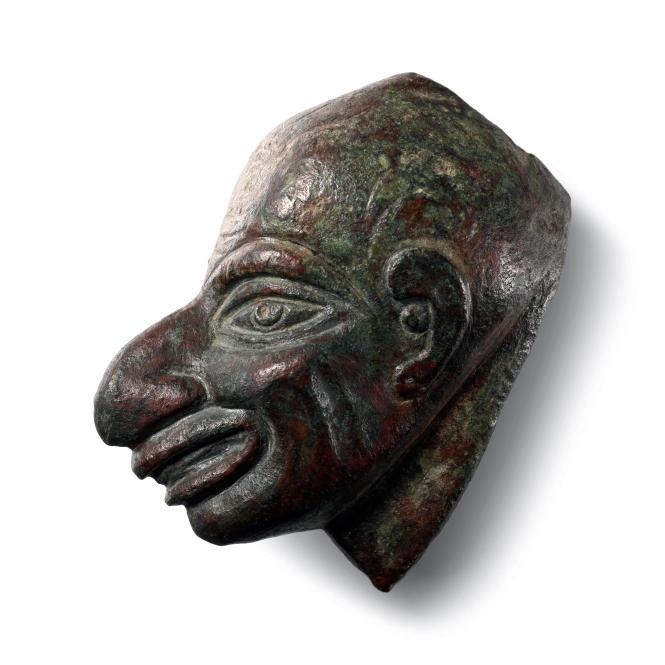
64
GREEK BRONZE HEAD OF A GROTESQUE MAN ‡ 3RD CENTURY B.C.
1 in. (67 grams, 48 mm)
Hollow-formed ‘moneybox’ with exaggerated nose and lips, small crescent-and-pellet ears, low-relief eyes with impressed pupils, small lock of hair to the scalp, vesica-shaped socket to the underside; pierced at the scalp and at the right ear.
£2,000 - 3,000
PROVENANCE: with Artemis Gallery, Munich, before 1998. Acquired by the present owner from the above in 2003.
65

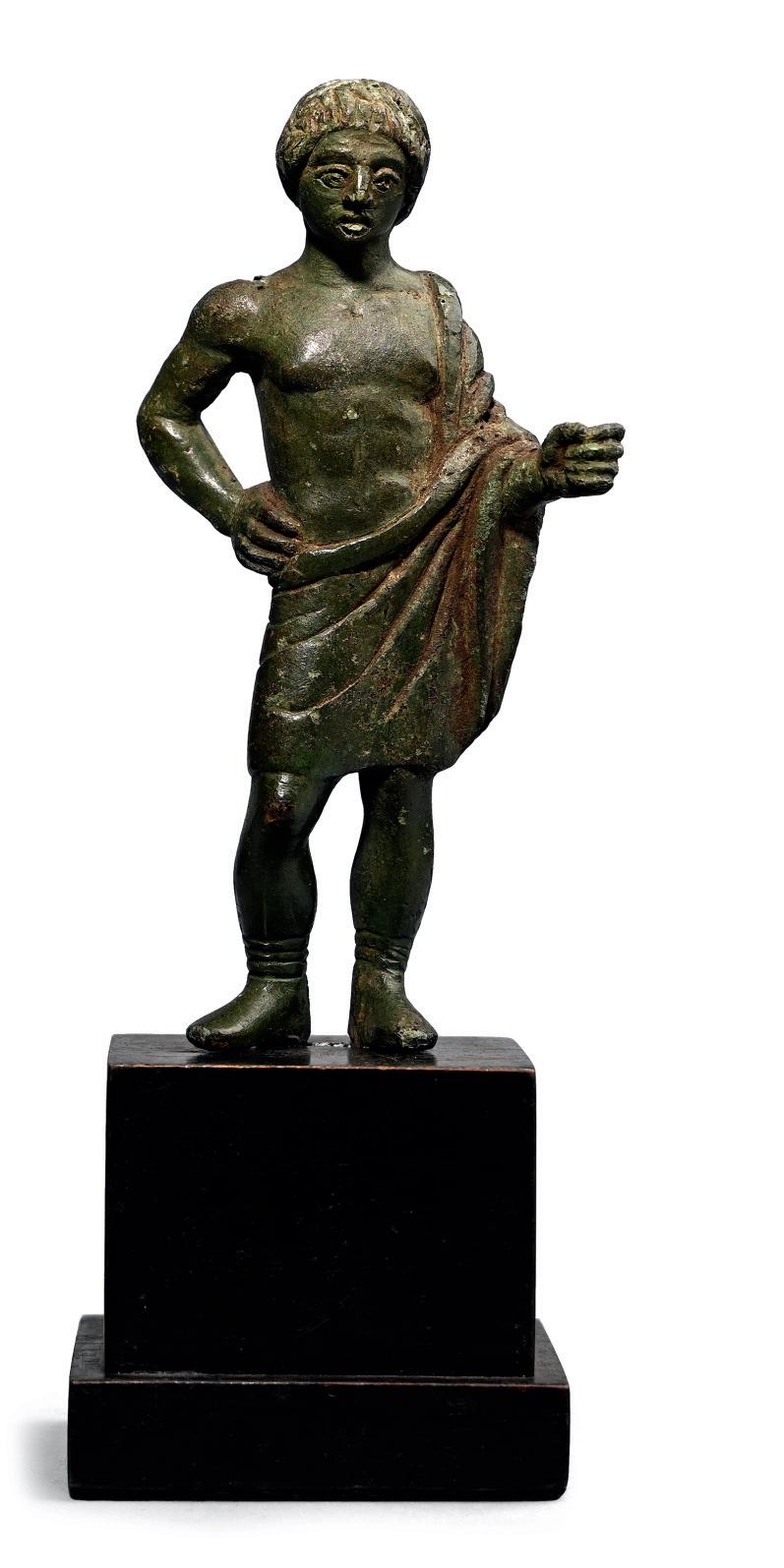
ETRUSCAN BRONZE STATUETTE OF A DRAPED HERO ‡
4TH-3RD CENTURY B.C.
7 in. (506 grams total, 18.7 cm including stand)
Modelled in the round standing erect with right hand on his hip and left arm extending from the elbow resting on the left hip and with fingers curled to hold a staff or handle, wearing a loosely draped cloth over the left shoulder and drawn around the body to hang over the arms; ribbed cuffs to the boots; youthful face with tousled hair and slightly exaggerated lentoid eyes; C-shaped staple beneath the feet for attachment; supplied with a custom-made display stand.
£15,000 - 20,000
PROVENANCE:
with Sotheby’s, Antiquities, London, 6 July 1995, no.130.
Acquired by the present owner at the above sale.
FOOTNOTES:
The statue was probably a cult offering and presents an archaic Etruscan hairstyle, being part of the Italic statuettes produced as votive offering to the temples or for private lararia. His warrior status can be confirmed by his boots, typical of Etruscan and Latin warriors of archaic times.
66

HELLENISTIC BRONZE FIGURE OF A BOUND CAPTIVE ‡
2ND CENTURY B.C.
6 in. (491 grams, 17 cm including stand)
Modelled in the round nude male standing with hands bound behind his back; with short cropped hair and slender figure; left foot absent; mounted on a custom-made stand.
£3,500 - 4,500
PROVENANCE: Ex S.K. collection.
Acquired on the German art market, July 1995.
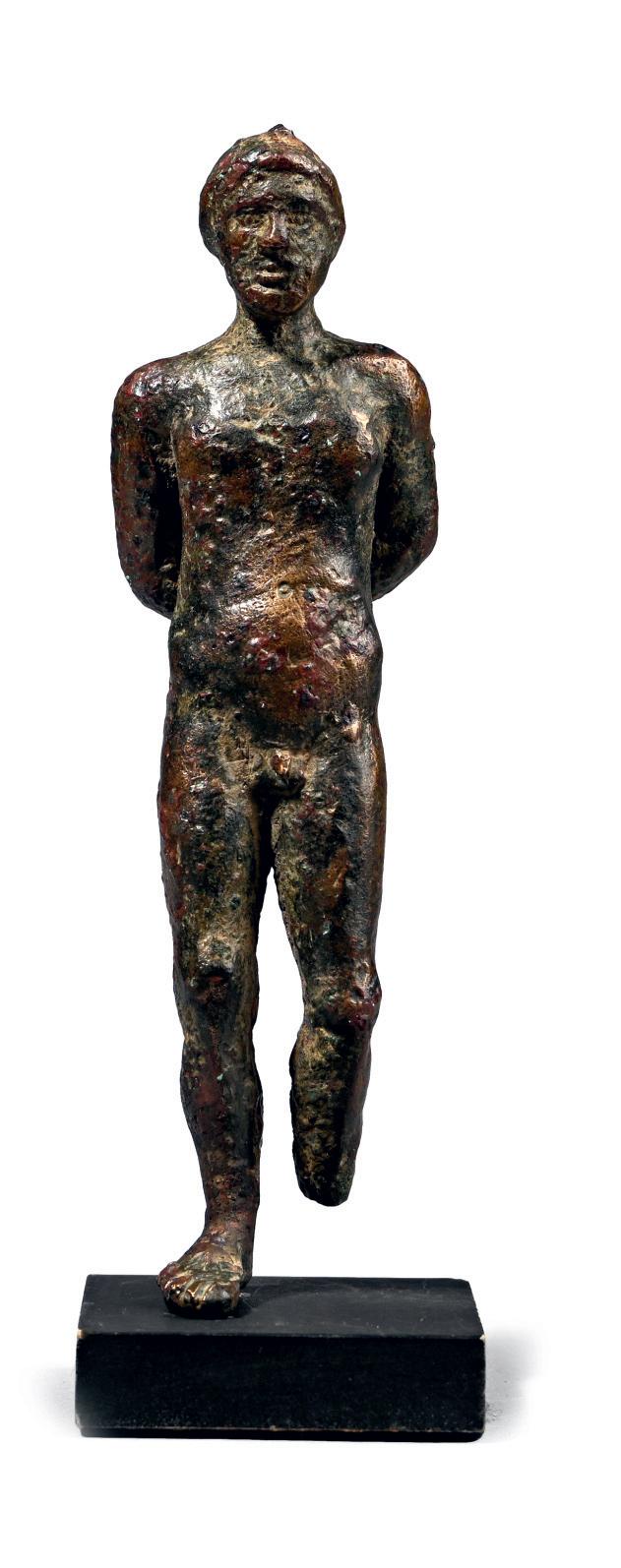
67
ETRUSCAN BRONZE CERES STATUETTE ‡
3RD-2ND CENTURY B.C.
2¾ in. (86 grams, 71 mm)
Female with hair drawn up in a chignon, palla wrapped tightly around the upper body hiding the right arm bent with the hand at the shoulder, lower hem of robe flared; fixing lug to underside.
£700 - 900
PROVENANCE: Acquired in the mid 1980s-1990s. Private collection, Switzerland, thence by descent. Private collection, since the late 1990s.
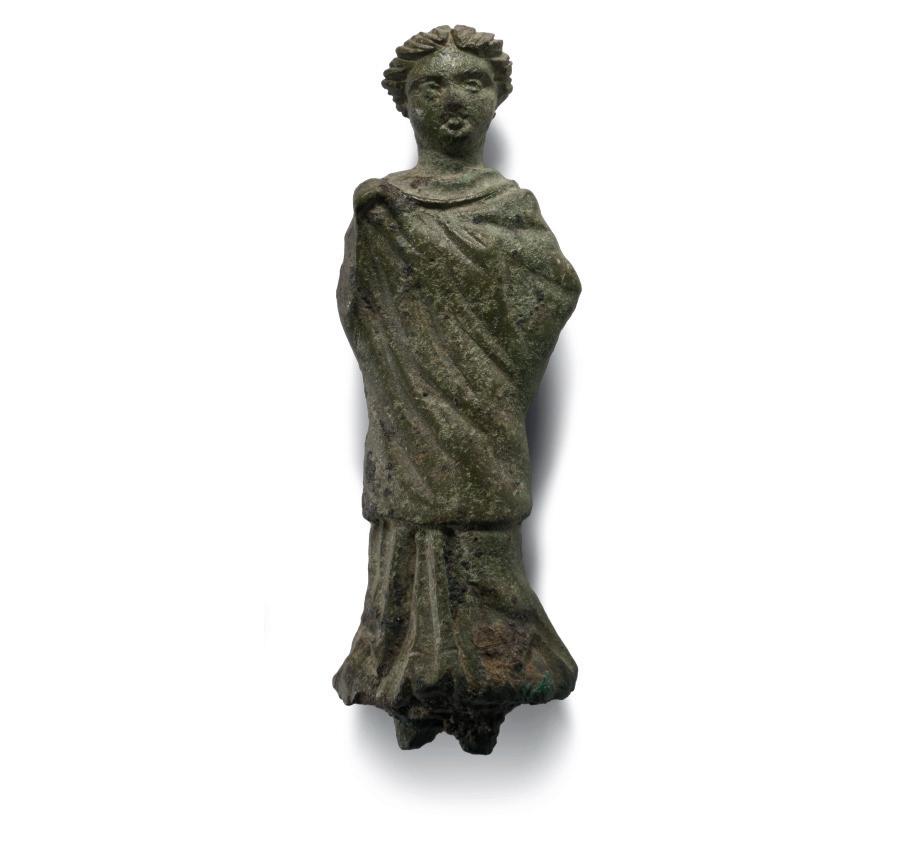
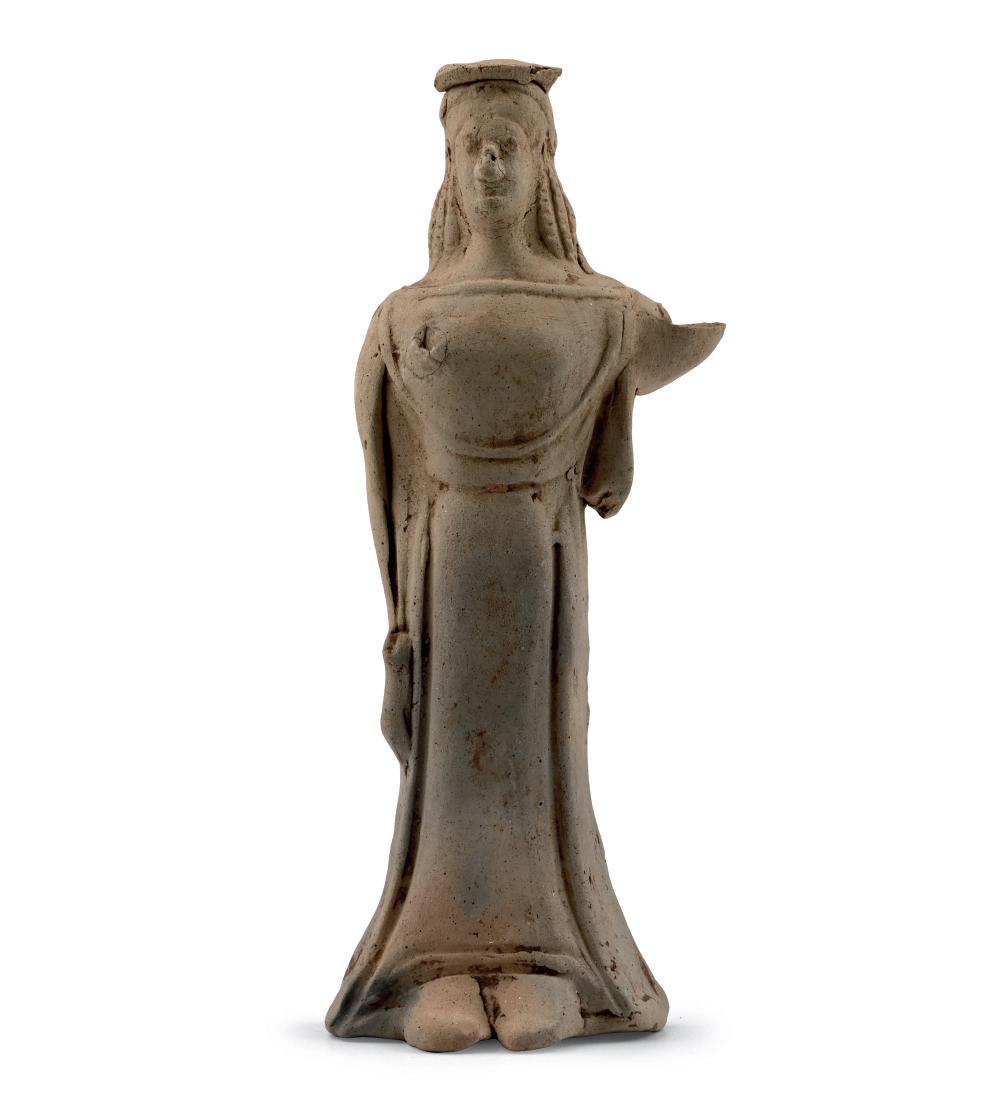

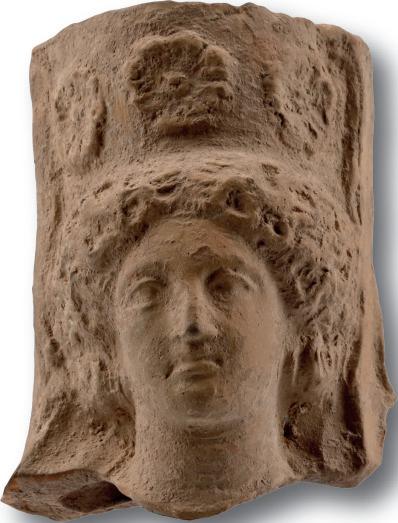
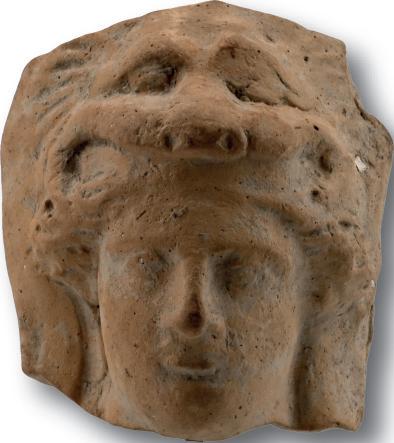



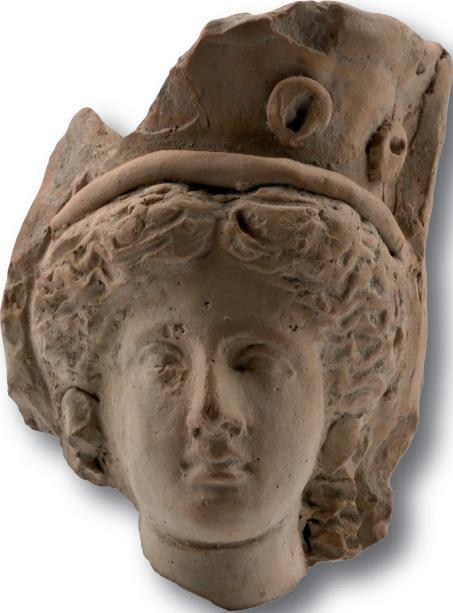
GREEK TERRACOTTA FIGURE OF A KORE
5TH CENTURY B.C.
7 in. (173 grams, 18 cm)
Hollow-formed moulded figure of a maiden standing, wearing a long peplos robe, with carefully dressed hair in hanks; right arm holding a pouch, left arm absent.
£400 - 600
PROVENANCE:
Acquired on the European art market in the early 2000s. with Galerie Rhéa, Zurich, Switzerland.
69
GREEK TERRACOTTA HEAD OF A GODDESS
5TH-3RD CENTURY B.C.
7 in. (228 grams total, 18.8 cm including stand)
Hollow-formed female head with flared headdress, applied collar and annulets; mounted on a custom-made stand.
£400 - 600
PROVENANCE: Acquired on the European art market in the early 2000s. with Galerie Rhéa, Zurich, Switzerland.
70
GREEK TERRACOTTA HEAD OF A GODDESS
5TH-3RD CENTURY B.C.
6¼ in. (149 grams total, 16 cm including stand)
Hollow-formed moulded head of a goddess with band of rosettes above; mounted on a custom-made stand.
£300 - 400
PROVENANCE: Acquired on the European art market in the early 2000s. with Galerie Rhéa, Zurich, Switzerland.
71
GREEK TERRACOTTA HEAD OF A GODDESS
5TH-3RD CENTURY B.C.
6¼ in. (154 grams total, 16 cm including stand)

Hollow to the reverse, with high-relief female mask wearing a lionhead headdress; mounted on a custom-made stand.
£300 - 400
PROVENANCE:
Acquired on the European art market in the early 2000s. with Galerie Rhéa, Zurich, Switzerland.
72
GREEK TERRACOTTA BUST OF A GODDESS
5TH-3RD CENTURY B.C.
7¼ in. (155 grams total, 18.5 cm including stand)
Hollow-formed with moulded obverse detailing of a female with copious hair and a thyrsus at her right shoulder.
£300 - 400
PROVENANCE:
Acquired on the European art market in the early 2000s. with Galerie Rhéa, Zurich, Switzerland.
73
GREEK BRONZE HEAD OF ALEXANDER ‘THE GREAT’ ‡
3RD-2ND CENTURY B.C.
4 in. (142 grams total, 10.2 cm including stand)
Modelled in the round with wavy hair brushed forwards, large lentoid eyes in low-relief, angular nose and small mouth; attachment lug to underside; mounted on a custom-made stand.
£8,000 - 10,000
PROVENANCE:
Collection of Mr C., Geneva, Switzerland (1936-2016), assembled between 1985 and 2010.


74

PARTHIAN BRONZE BATILLUM WITH A
RECLINING BANQUETEER
HOLDING A SKYPHOS AND RHYTON
3RD-1ST CENTURY B.C.
10 in. (1.58 kg, 25 cm)
Comprising a square base with a raised border and supported by four stub feet, each originally surmounted by poppy-head finials (one now absent); a hollow-formed figure of a banqueteer reclining elegantly with his weight resting on his left elbow, his proper right leg drawn up beneath the folds of a finely pleated robe; in his right hand, a ram’s head rhyton and his left hand cradling a skyphos; his bearded head with a laurel wreath.
£6,000 - 8,000
PROVENANCE: Private New York collection, formed in the 1960s. Acquired on the North American art market, 1990s. with Cahn Auktionen AG, Basel, Switzerland, 13 November 2015, no.84 (CHF 18,000).
FOOTNOTES:
The composition reflects the iconography of elite banquet culture in the ancient world, capturing both refinement and ritual in a single expressive figure. The Greek ‘ μπ ’ ‘symposium’ was the later part of a formal banquet which took place after the food had been consumed, when the serving of strong drink was accompanied by music, dancing, poetic composition or recital or earnest conversation. The custom has similarities with the Roman convivium and with the customs of many Mediterranean and Western Asiatic people. The Parthian Empire was culturally diverse and included many Hellenic groups; the Arsacid court adopted a range of aspects of contemporary Greek culture, among them Greek military structures and the Greek language as a lingua franca alongside the Parthian (Iranian) language and Aramaic.

75
GREEK TERRACOTTA HEAD OF A GODDESS
5TH-3RD CENTURY B.C.
6 in. (164 grams total, 15.5 cm including stand)
Hollow-formed female head in high-relief moulding with hair swept back, mounted on a custom-made stand.
£400 - 600
PROVENANCE:
Acquired on the European art market in the early 2000s. with Galerie Rhéa, Zurich, Switzerland.
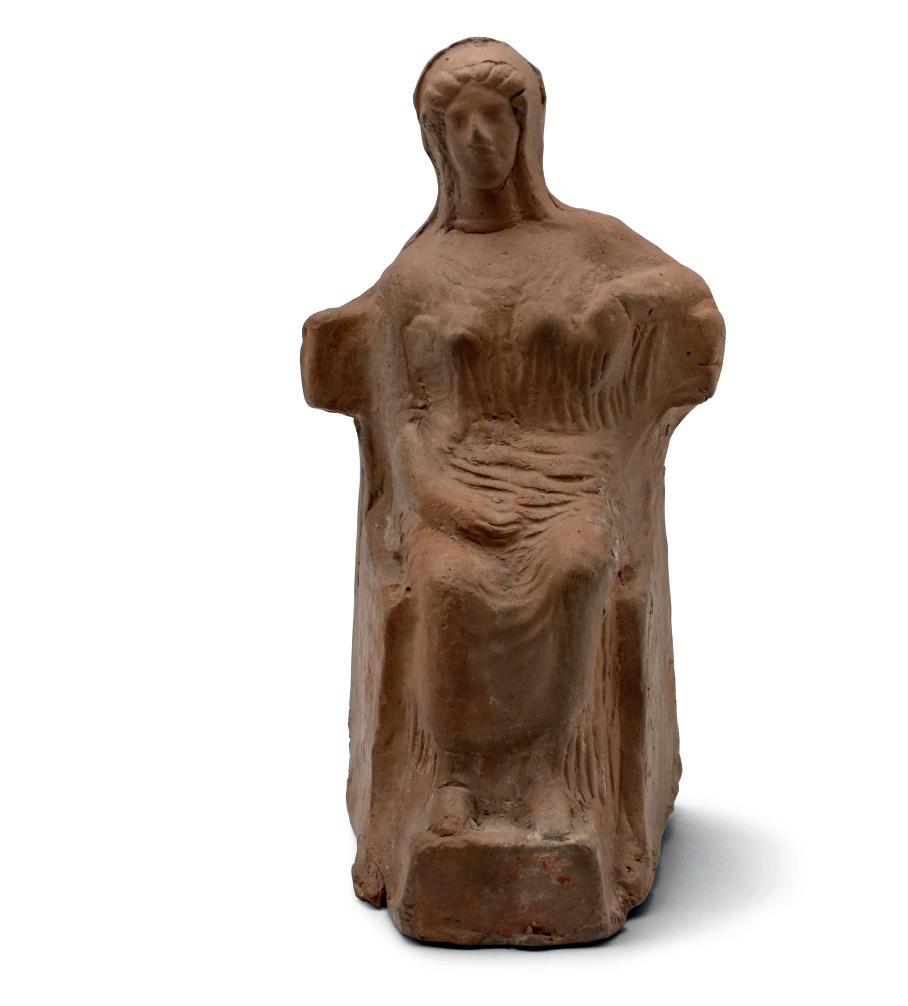
77
GREEK TERRACOTTA FIGURE OF A SEATED GODDESS ‡
3RD-2ND CENTURY B.C.
5½ in. (255 grams, 13.8 cm)

76
GREEK TERRACOTTA HEAD OF A GODDESS
5TH-3RD CENTURY B.C.
6 in. (334 grams total, 17.5 cm including stand)
Hollow-formed with moulded detail to the obverse, plain reverse; female head with earrings, bouffant hairstyle and modius, flanked by a torch with flared rim and flame; mounted on a custom-made stand.
£500 - 700
PROVENANCE: Acquired on the European art market in the early 2000s. with Galerie Rhéa, Zurich, Switzerland.
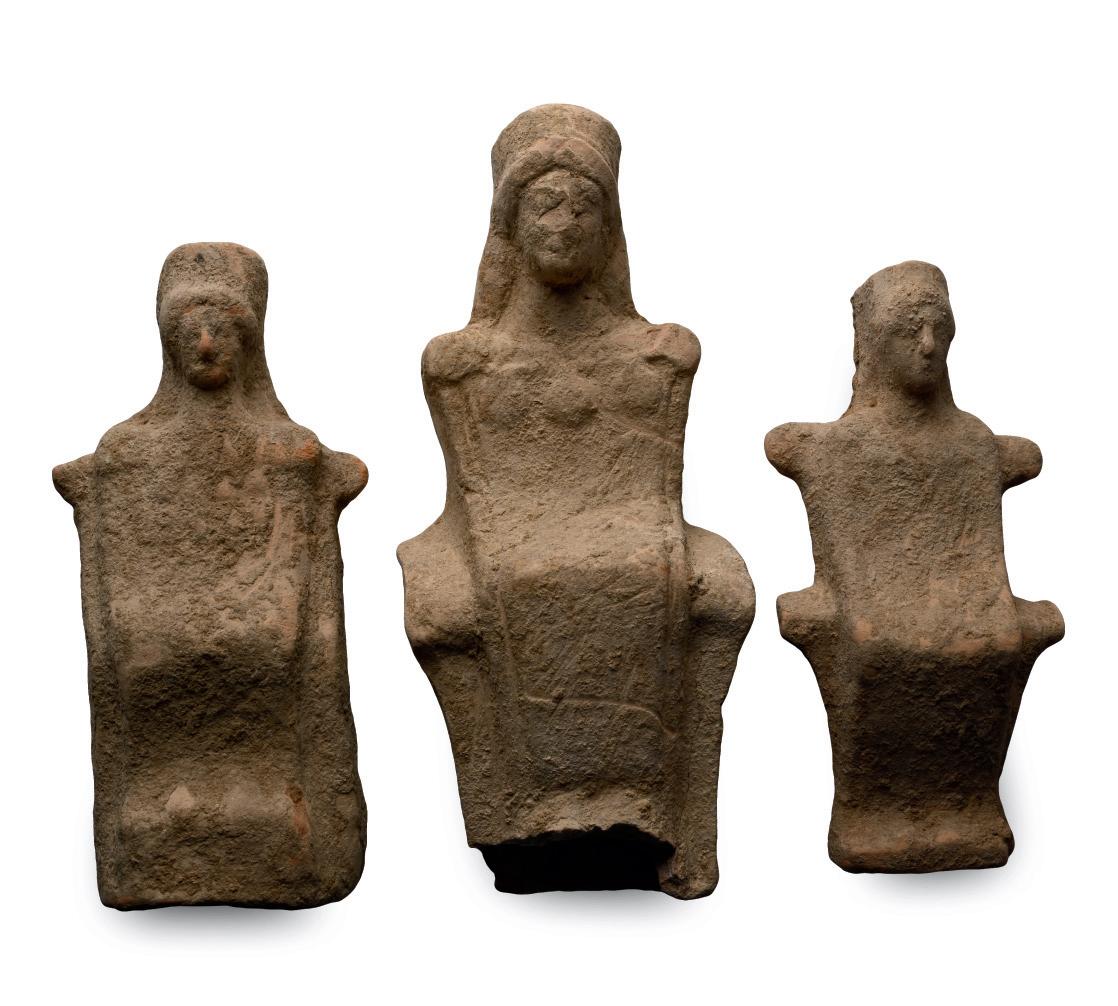
78
ARCHAIC GREEK TERRACOTTA SEATED GODDESS GROUP
5TH CENTURY B.C.
6 - 7 in. (778 grams total, 15.5-20 cm)
Hollow-formed figurine of a female wearing a himation seated on a high-backed chair with right hand in her lap and left arm bent over the back of the chair; triangular vent to reverse, hollow underside; Tanagra type.
£600 - 800
PROVENANCE:
Collection of Mr C., Geneva, Switzerland (1936-2016), assembled between 1985 and 2010.
Each depicting a goddess seated on a wide high-backed throne and wearing a long dress, her hands resting on the lap. [3, No Reserve]
£600 - 800
PROVENANCE: with H.A.C., Basel, prior 1999.
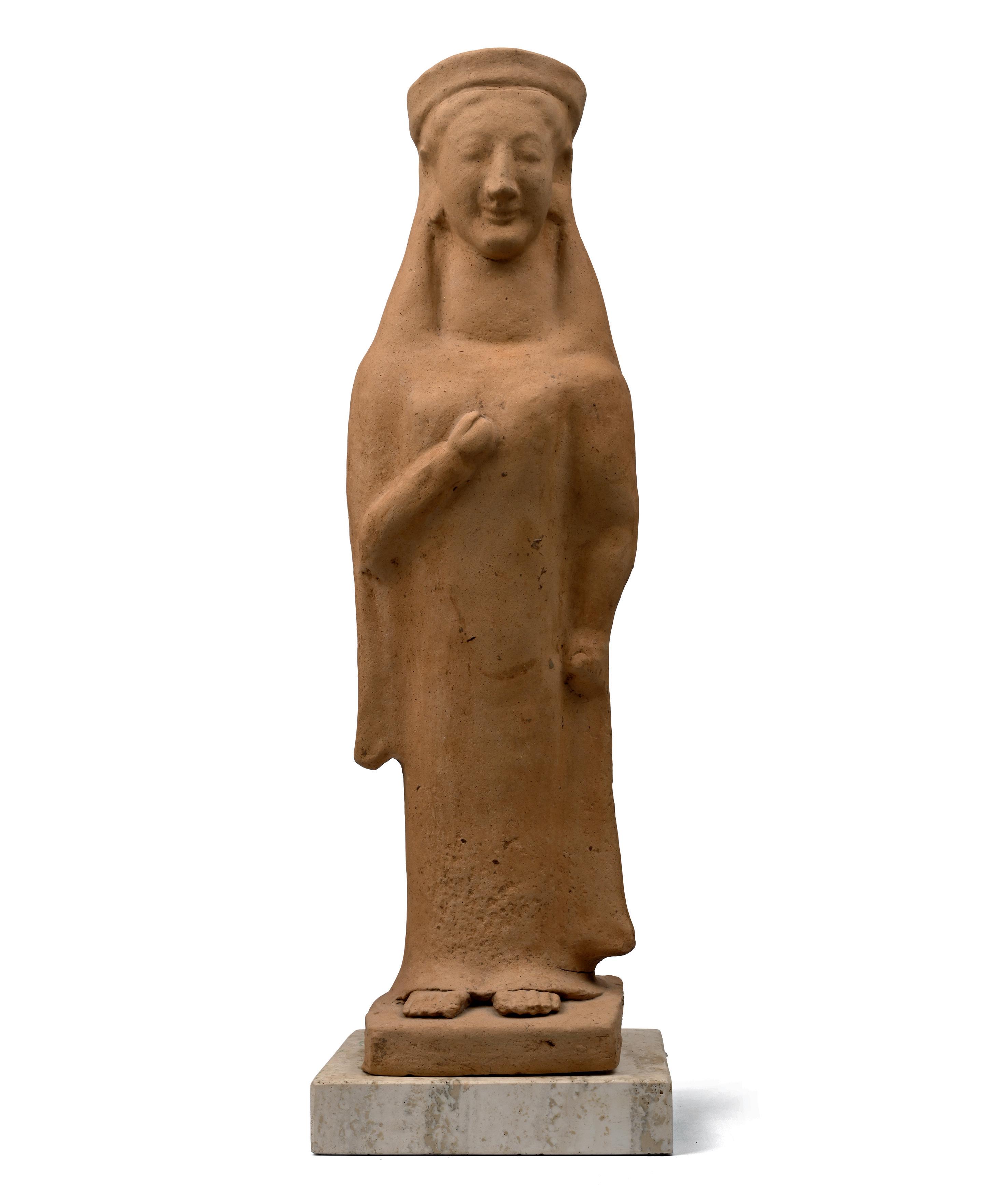
GREEK TERRACOTTA FIGURE OF A KORE ‡
22½ in. (6.7 kg total, 57 cm including stand)
Hollow-formed with scaphoid headdress, long hair hanging behind the shoulders, heavy peplos dress extending to the floor with splayed hem and feet visible beneath; left hand held straight at the thigh, right hand in a fist between the breasts; mounted on a custom-made stand. £6,000 - 8,000
PROVENANCE: Swiss private collection, assembled in the 1970s-1980s. with Galerie Serodine, Ascona, Switzerland, 1993. Collection of Dr E.N., Zug, acquired in 1995.


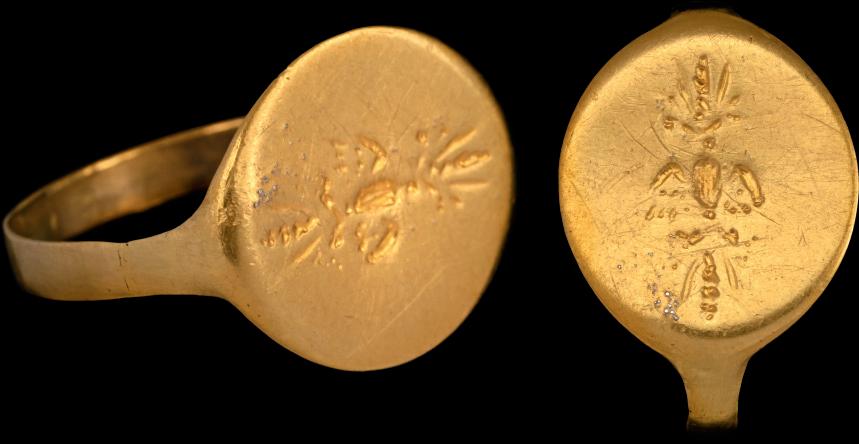
80
HELLENISTIC PALE GREEN GLASS BOWL
CIRCA MID 2ND-EARLY 1ST CENTURY B.C.
6 in. (375 grams, 15.7 cm)
Conical bowl with three horizontal grooves cut to the inner rim, a pair of concentric circles to the underside; remains of iridescence.
£4,000 - 6,000
PROVENANCE: Dr Jutaro Kawabe, Nagoya, Japan, his collection formed in the 1960s-1970s. with Hoshigaoka Gallery until the late 1990s. Private collection, London, UK.
FOOTNOTES: Kunina notes that this form imitates metallic prototypes of the late Hellenistic period.
81

HELLENISTIC GOLD RING WITH ARTEMIS GEMSTONE ‡
2ND-1ST CENTURY B.C.
1 in. (11.27 grams, 26.91 mm overall, 17.95 x 20.72 mm internal diameter (approximate size British R, USA 8½, Europe 18¾, Japan 18))
Hollow-formed shank with broad plaque and inset garnet cabochon intaglio profile bust of Artemis in high-relief.
£4,000 - 6,000
PROVENANCE: European art market.
82
GREEK GOLD RING WITH THUNDERBOLT
4TH-3RD CENTURY B.C.
¾ in. (3.78 grams, 21.88 mm overall, 20.32 mm internal diameter (approximate size British R½, USA 8¾, Europe 19.38, Japan 18))
Flat-section hoop expanding to a flat discoid bezel with engraved stylised Zeus’s thunderbolt.
£1,500 - 2,000
PROVENANCE:
UK private collection before 2000. Acquired on the UK art market.
Private collection, London, UK.
83
THRACIAN GOLD CLAD RIBBED TORC WITH DECORATED TERMINALS
4TH-3RD CENTURY B.C.
11 in. (467 grams, 29 cm)
Penannular in form with round-section shank and flat tongue-shaped terminals; the shank formed as a series of transverse rings modelled to represent granulation; the outer face of each terminal formed with punched detailing to the border and transverse final bars, two rows of punched annulets separated by a median gusset; some modern polishing.
£5,000 - 7,000
PROVENANCE:
Swiss private collection, 1987. Private collection, London.

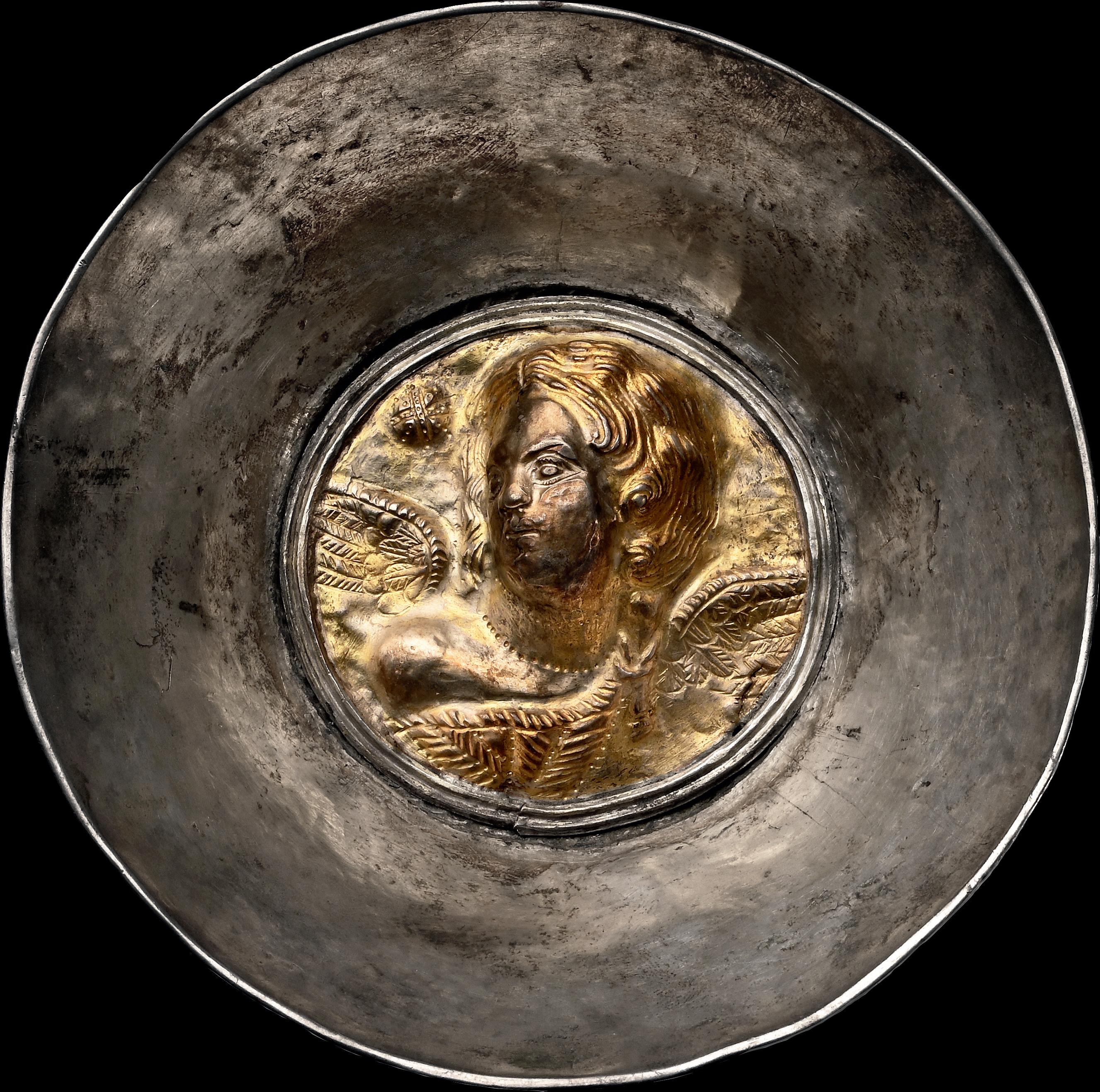

HELLENISTIC SILVER-GILT CUP WITH NIKE
2ND-1ST CENTURY B.C.
5 in. (96.8 grams, 12.6 cm wide)
A hammered, chased and soldered silver-gilt cup with central medallion of Nike in high-relief; the bowl formed as a truncated cone with a shallow foot comprising an irregular circular ‘ropework’ border enclosing a floral motif, or double rosette; the bust of Nike showing the goddess draped in a goat skin with knot and ungulate leg with hoof at right shoulder, wings spread, hair dressed in curls, torc at neck, gazing left; face with almond-shaped eyes, straight nose and full, closed lips; with the exception of the face, all elements of the central medallion were originally gilt; housed in a custom-made velvetlined box.
£7,000 - 9,000
PROVENANCE: Private collection, Mainz, Germany, 1980s.
Acquired by the current owner from the above, 2006.
Accompanied by a copy of a seven page examination report number 114/2019 by Dr Habil Mikhail Treister.
FOOTNOTES: Nike was the winged goddess of victory. Goat-skin clothing was an attribute of Artemis, but here it is worn by Nike, attesting to the syncretic nature of the art embodied by this object. The workmanship of this piece suggests a local workshop in the Kuban basin.
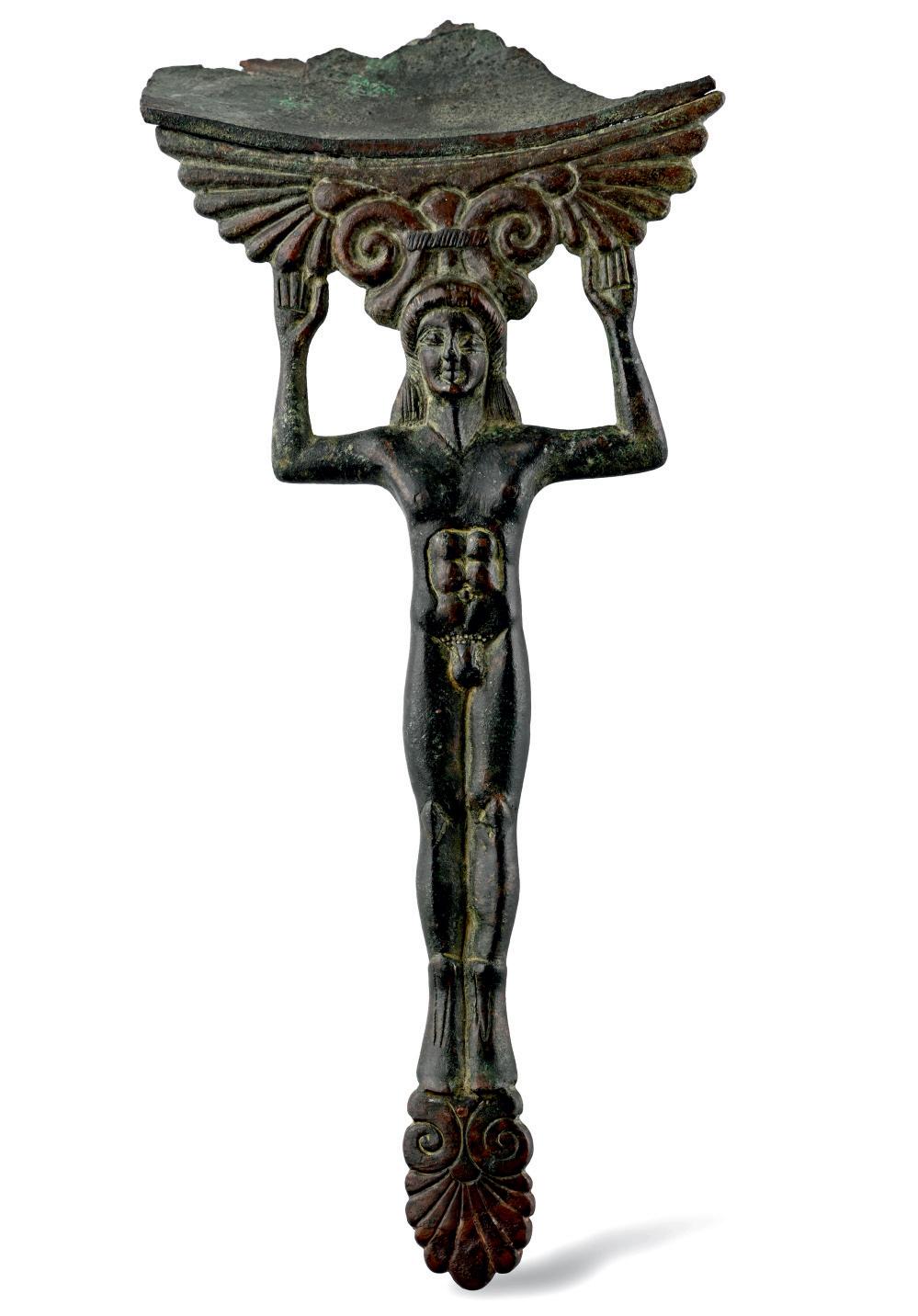
85
ARCHAIC GREEK BRONZE KOUROS HANDLE ‡
WESTERN GREEK, CIRCA 480 B.C.
17 in. (1.35 kg total, 45.5 cm high including stand)
The handle formed as a nude youth supporting a panel of double volutes and half-palmettes, long braided hair falling at the back of the neck and on his forehead; the legs joined and ankles extended, the feet enclosed in pointed shoes, palmette below; accompanied by the basin with inverted rim, a pair of parallel lines to the outer rim; the handle and part of the rim detached and mounted separately on the custom-made display stand.
£8,000 - 10,000
PROVENANCE: with Herbert A. Cahn, Basel, 1990s.
Accompanied by a copy of an Art Loss Register certificate no.S00075168.

86
GREEK BRONZE WINE STRAINER WITH SWAN-HEAD HANDLES ‡
4TH-3RD CENTURY B.C.
7¾ in. (402 grams total, 19.7 cm including stand)
Comprising a shallow bowl and broad flange rim, two integral scalloped handles with lateral scrolled flourishes, each tapering to a S-curved handle with swan-head terminals with incised eye and beak detailing; perforated whirl within roundel to interior base; accompanied by a custom-made display stand with mirror.
£7,000 - 9,000
PROVENANCE: with Hôtel des ventes de Belfort Sarl, October 2011, no.16. Acquired by the present owner at the above sale.
87

HELLENISTIC MARBLE FIGURE OF APHRODITE ‡
2ND-1ST CENTURY B.C.
12¾ in. (1.2 kg, 32.7 cm)
Carved in the round figure of the goddess standing nude with one hand on her elbow and the other on her pudendum, her hair gathered into a chignon with lateral bunches on the crown and with voids to allow for the suspension of small gold earrings; putto at her left knee; light hand partly absent; remounted on a socle base.
£6,000 - 8,000
PROVENANCE:
Acquired in the 1992.
Private collection, Switzerland, thence by descent. Private collection, since the late 1990s.


88
SCYTHIAN BRONZE MIRROR WITH EAGLE HANDLE
6TH CENTURY B.C.
8 in. (12¼ in.) (980 grams, 21.2 cm (1.91 kg total, 31.3 cm including stand))
With one polished face; lip to rim on reverse, central disc handle mounted on two spigots, high-relief splayed eagle motif; mounted on a custom-made stand.
£5,000 - 7,000
PROVENANCE:
Private collection, UK. Acquired from David Aaron, 2017. Private collection, London.


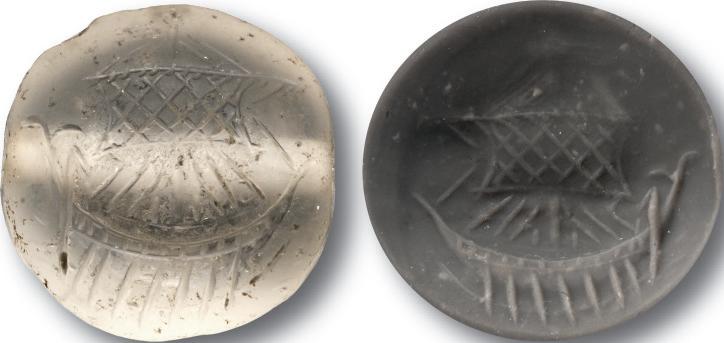


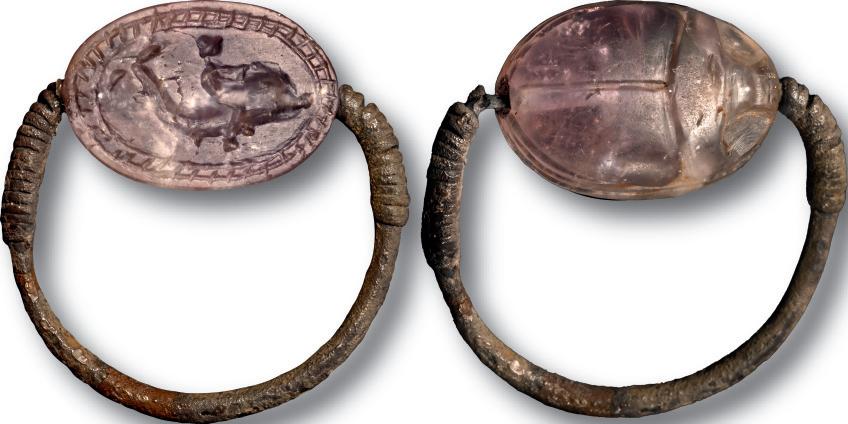

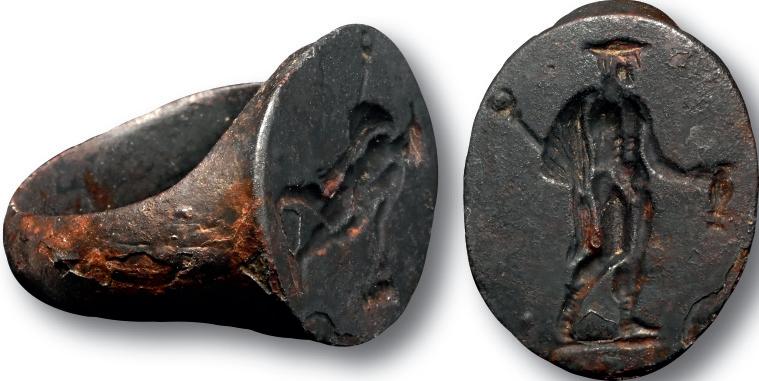

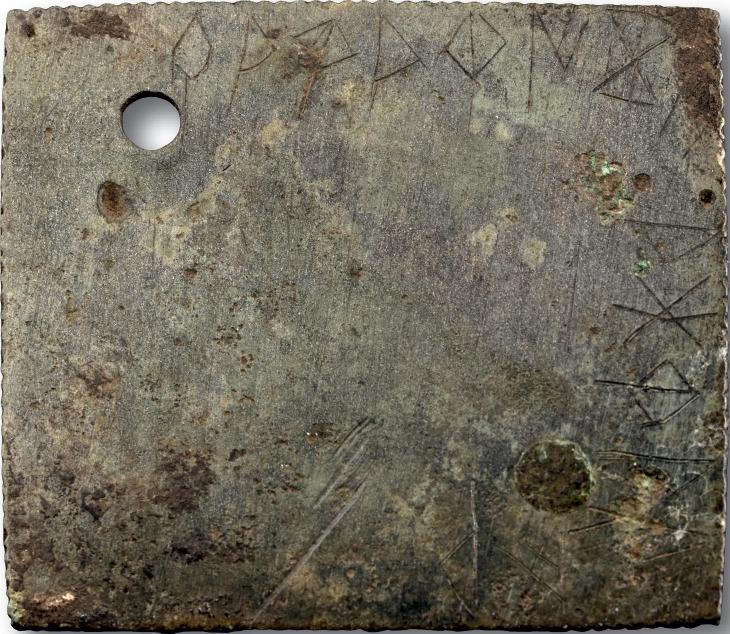
89
MINOAN CARNELIAN STAMP SEAL
2ND MILLENNIUM B.C.
½ in. (1.98 grams, 14 mm)
Discoid type with incuse motif of two stags placed symmetrically with their horns pointing inwards to the centre; supplied with a museumquality impression.
£3,000 - 4,000
PROVENANCE:
From the private collection of the late R Priday, Brookman Hall, Hertfordshire, UK; thence by descent.
90
MINOAN ROCK CRYSTAL GEMSTONE WITH SHIP
1500-1200 B.C. in. (3.1 grams, 16 mm)
Discoid body, on one face engraving of a ship with curved body, paddles and cross-hatched sail; pierced vertically for suspension. [No Reserve]
£800 - 1,000
PROVENANCE:
From an old London, UK, collection formed before 1975. Property of a Middlesex, UK, gentleman antiquarian.
91
ETRUSCAN SILVER RING WITH AMETHYST SCARAB SEAL
4TH CENTURY B.C.
1 in. (5.44 grams, 30.77 mm overall, 25.27 mm internal diameter (approximate size British W, USA 11, Europe 25, Japan 24))
Wire hoop with ends wound round the shank at each shoulder with one end detached, swivel-mounted amethyst scarab seal with flat underside, segmented border around a dolphin with putto mounted on its back.
£500 - 700
PROVENANCE:
From the private collection of Mr K.A., acquired in the 1990s-early 2000s.
FOOTNOTES:
Egyptian-style scarabs and scaraboids were characteristic of Etruscan art from the 8th century B.C. Originally made in Phoenicia, Cyprus or Rhodes, these objects were made of faience, blue paste, glass paste and bone, or semiprecious stones of varying hardness, from steatite to quartz, onyx and jasper. Mounted in settings on revolving pendants of precious metal, which were later imitated by Etruscan goldsmiths, these Egyptianising items performed prophylactic-religious functions, through the use of sacred or magical imagery taken from hieroglyphic language: royal names or titles, theonyms, sacred symbols, and auspicious formulas.
92
GREEK BRONZE RING WITH STANDING HERMES ‡
4TH-3RD CENTURY B.C.
1 in. (11.41 grams, 25.26 mm overall, 20.87 mm internal diameter (approximate size British P, USA 7½, Europe 16.23, Japan 15))
Ellipsoid plaque with intaglio Hermes standing on a baseline with petasos, marsupium and caduceus; supplied with a museum-quality impression.
£1,500 - 2,000
PROVENANCE: European private collection, 1980s.
Private collection, acquired on the German art market in 2001.
93
NORTHEASTERN
IBERIAN VOTIVE PLAQUE WITH INSCRIPTION
3RD-2ND CENTURY B.C.
1 in. (25.78 grams, 43 mm)
Rectangular in plan with hatched edges; two rivet holes, one with rivet in situ; legend in Northeastern Iberian around, apparently: r-a-r-a-r-ico-[..]-a-bo-r-a-[..]-ca-a. [No Reserve]
£800 - 1,000
PROVENANCE:
From an old London, UK, collection since circa 1985.
SCYTHIAN BRONZE MILITARY STANDARD
FINIAL WITH ANIMALS
4TH CENTURY B.C.
19¼ in. (2.39 kg total, 49 cm including stand)
An elaborate finial, likely from a ceremonial staff or pole, comprising a vertical shaft supporting an openwork plate in the form of stylised stag’s antlers; shaft with a sculpted stag’s head with elongated ears and simplified features, extending to antlers with four branches on each side; flat plate above with ornament consisting of four graduated tiers of scrolled ‘antlers’, each with detailed decorative chasing (incised bands with diagonal lines); above, a crescent (possibly representing wings) flanking a frontal raptor’s head with a hooked beak and engraved notching (probably a symbolic addition); a horizontal tube or sleeve passing through the base of the plate, decorated with transverse grooves with bells suspended below and from small loops near the stag’s head; each bell made from thin bronze sheet, conical in shape; accompanied by a custom-made display stand.
£12,000 - 17,000
PROVENANCE: Franz Heger (1853–1931), Austrian traveller and ethnographer, acquired in the Caucasus during his 1890 expedition.
Believed to have been gifted circa 1930 to Franz Hancar (1893–1968), noted scholar and expert in ancient Caucasian cultures.
Thence by descent, acquired in the 1950s by Mr R.D., Vienna.
Acquired from the above in 1998 by N.M., former Israeli Ambassador to Austria (1998–2000).
Accompanied by a copy of a nine page examination report number 137/2015 by Dr Habil Mikhail Treister.
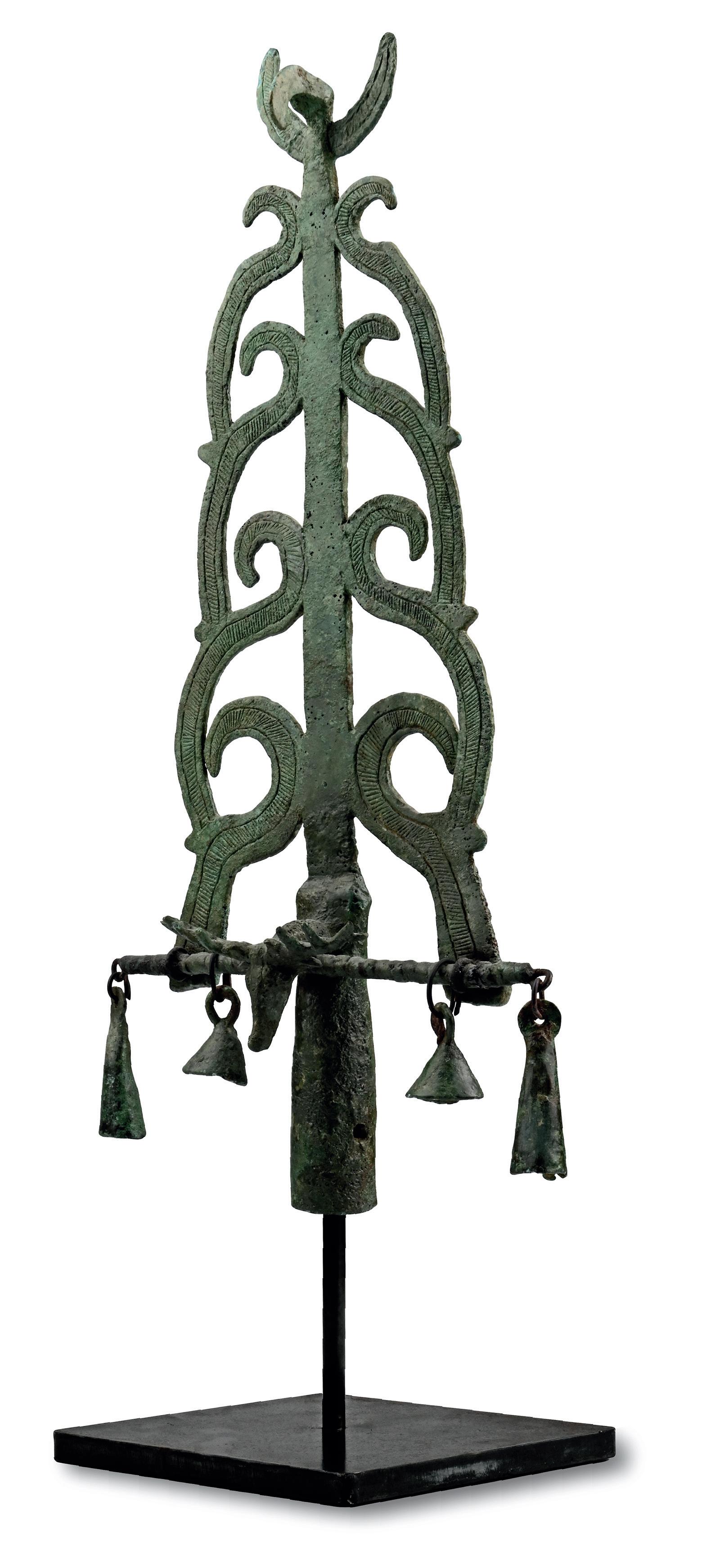



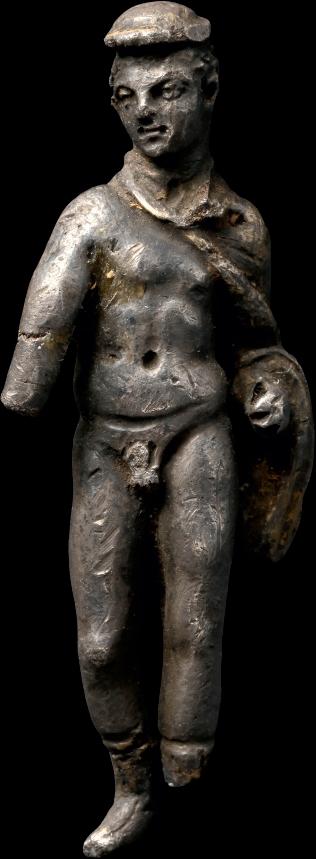




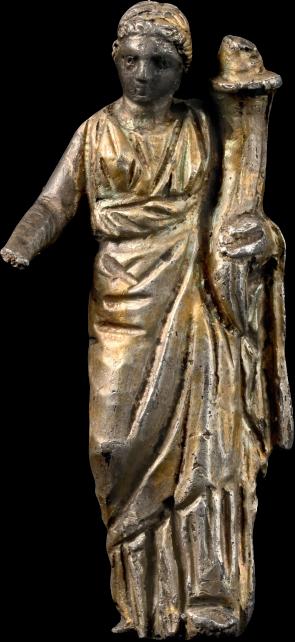
ROMAN SILVER-GILT STATUETTE OF HARPOCRATES
1ST-2ND CENTURY A.D.
1¼ in. (7.19 grams, 32 mm)
Standing nude with his right forefinger to his mouth, with crescent headdress and cornucopia supported on his left arm.
£600 - 800
PROVENANCE:
Acquired in the late 1980s-early 1990s. Private collection, London, UK.
96
ROMAN SILVER-GILT STATUETTE OF FORTUNA
1ST-2ND CENTURY A.D.
1½ in. (18.48 grams, 39 mm)
Modelled in the round and finely detailed, the goddess standing with a cornucopia in the crook of her left arm, wearing a floor-length palla
£700 - 900
PROVENANCE: Acquired in the late 1980s-early 1990s. Private collection, London, UK.
97
ROMAN SILVER-GILT STATUETTE OF MERCURY
1ST-2ND CENTURY A.D.
1½ in. (8.76 grams, 37 mm)
Modelled in the round in advancing pose, with traveling cloak wrapped around his shoulder and left arm; petasos covering his hair and talaria on his feet.
£600 - 800
PROVENANCE: Acquired in the late 1980s-early 1990s. Private collection, London, UK.

98
ROMAN SILVER-GILT PIN WITH NUDE CUPID HOLDING BEE
1ST-2ND CENTURY A.D.
3 in. (12.31 grams, 76 mm)
Comprising a tapering shank and square head supporting a nude Cupid in conical hat clutching a winged insect to his chest.
£600 - 800
PROVENANCE: Acquired in the late 1980s-early 1990s. Private collection, London, UK.
99
ROMAN SILVER-GILT PIN WITH EAGLE OF ZEUS
1ST-2ND CENTURY A.D.
1 in. (6.28 grams, 42 mm)
With short, sturdy shank to the pin, plaque with granulated border, perching eagle with wings folded.
£600 - 800
PROVENANCE: Acquired in the late 1980s-early 1990s. Private collection, London, UK.

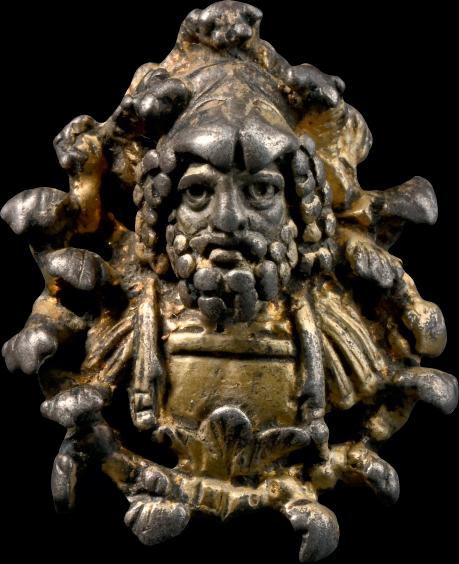

100
ROMAN SILVER-GILT MILITARY MOUNT WITH MARS ULTOR 2ND CENTURY A.D.
1¼ in. (18.79 grams, 32 mm)
D-shaped plaque with bust modelled in the round with openwork foliage to the border.
£1,500 - 2,000
PROVENANCE:
UK private collection, acquired in New York in the 1980s.
101
ROMAN SILVER-GILT STATUETTE OF JUPITER
1ST-2ND CENTURY A.D.
2 in. (20.63 grams, 51 mm)
Modelled standing nude with wreath to the luxuriant hair, full beard and in erect pose; staff in the left hand (part absent); thunderbolt in the right hand with looped tendril.
£1,500 - 2,000
PROVENANCE: Acquired in the late 1980s-early 1990s.
102
ROMAN SILVER PRIESTESS STATUETTE ‡
1ST-3RD CENTURY A.D.
1 in. (11.8 grams, 41 mm)
Solid cast standing female wearing a loosely draped robe draped over her head, the hem gathered at her waist and held in her left hand, right hand raised in greeting.
£1,500 - 2,000
PROVENANCE: Acquired in the mid 1980s-1990s. Private collection, Switzerland, thence by descent.
103
ROMAN SILVER-GILT BROOCH WITH DIANA 1ST-2ND CENTURY A.D.
1½ in. (14.09 grams, 40 mm)
Modelled in the half-round figure of Diana reaching behind her shoulder to draw an arrow, her left hand reaching towards a hound; catch and spring-plate to the reverse.
£1,000 - 1,400
PROVENANCE: Acquired in the late 1980s-early 1990s.
104
ROMAN SILVER STATUETTE OF CYBELE
1ST-2ND CENTURY A.D.
1 in. (14.01 grams, 34 mm)
Modelled in the round wearing a floor-length palla draped over her head and over her robe, with staff (broken) in her left hand and patera in her right; thick dorsal loop.
£500 - 700
PROVENANCE: Acquired in the late 1980s-early 1990s.

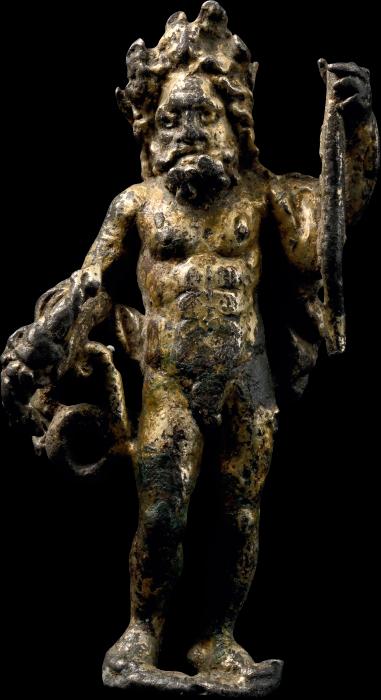


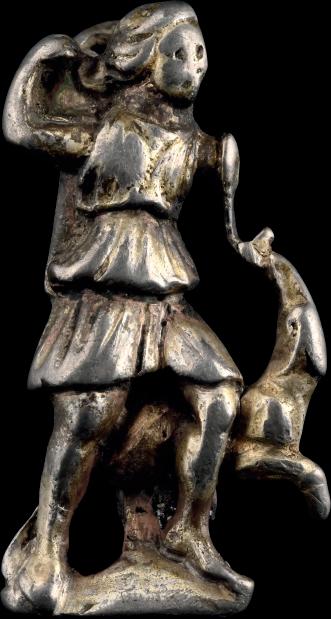

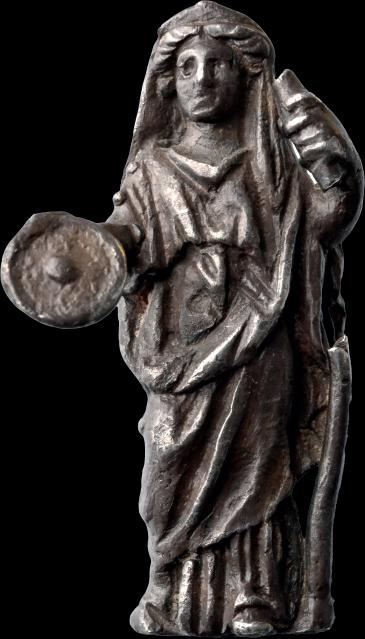
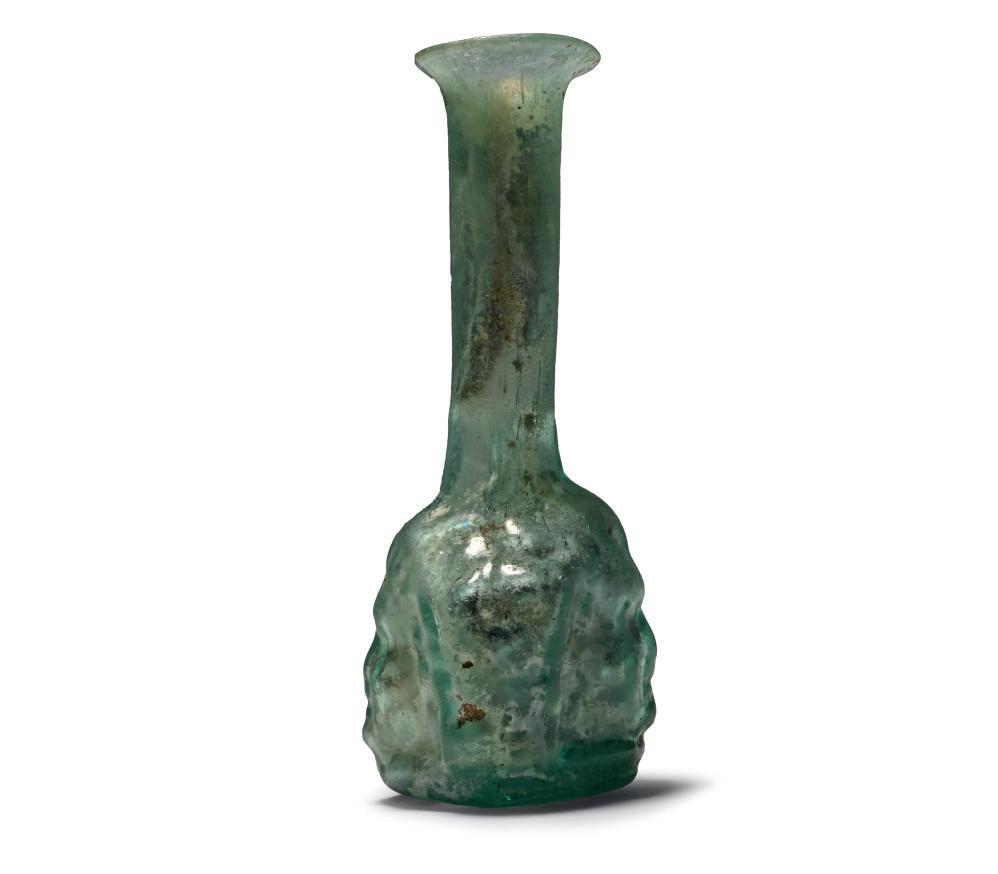
106
LARGE ROMAN DIMPLE-SIDED GLASS FLASK
1ST-4TH CENTURY A.D.
9 in. (240 grams, 24.5 cm)
Comprising a piriform body with vertical fluting, flat base, tapering tubular neck with pinched and everted rim.
£1,200 - 1,700
PROVENANCE:
Ex Mayfair, London, UK, gallery, 1990s-2000s.
From an important collection of glass, the property of a London gentleman.
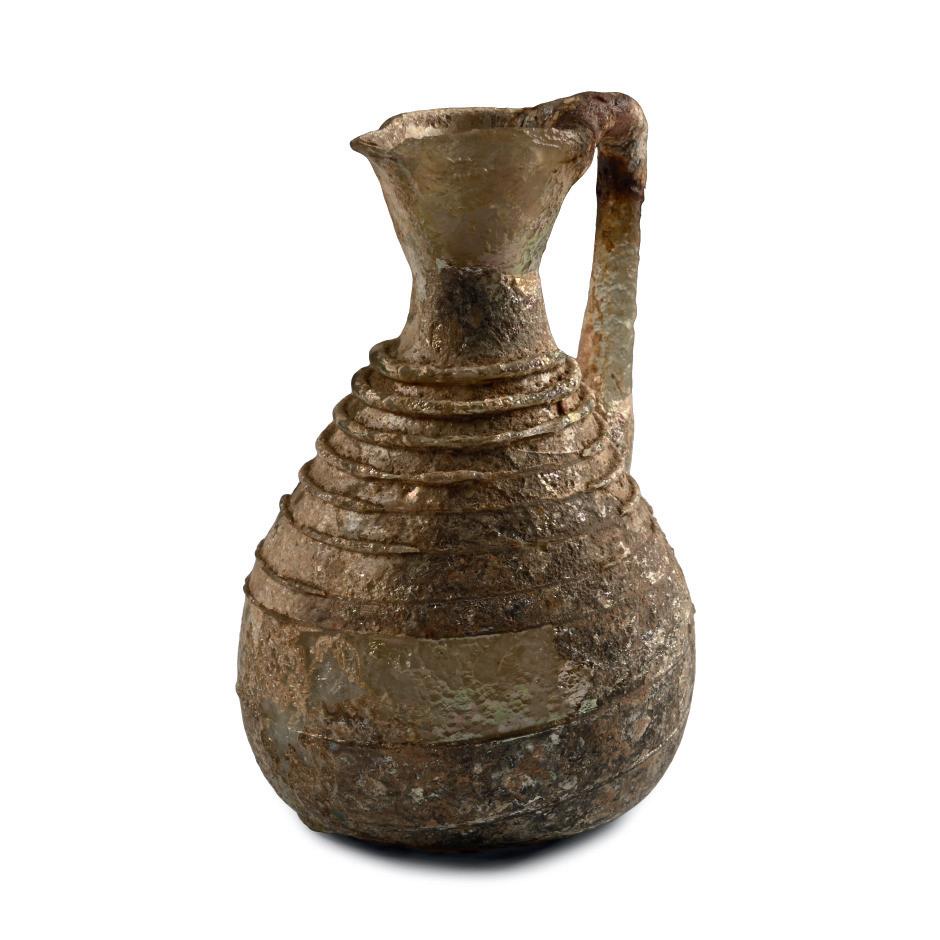
108
ROMAN FINE GLASS FLASK
3RD-4TH CENTURY A.D.
5½ in. (83 grams, 14.5 cm)
Comprising a bulbous body with applied ring to the base, tapering neck, flared mouth with applied rim, applied ribbed handle to the rear and collar to shoulder.
£600 - 800
PROVENANCE:
Ex Mayfair, London, UK, gallery, 1990s-2000s.
From an important collection of glass, the property of a London gentleman.
105
ROMAN GLASS JANIFORM AMPULLA ‡
3RD CENTURY A.D.
4 in. (48.9 grams, 11 cm)
Body formed as two addorsed putto-heads with long, narrow neck separated from the body by a constriction; funicular mouth.
£700 - 900
PROVENANCE:
Ex Anita Zürrer-Bass (1928-2018), Switzerland, formed 1960s-1990s. Thence by descent.
FOOTNOTES:
The body of this type of vessel is formed from two heads joined together at the back. The faces have protruding chins, full cheeks and turned-up noses. The hair, filling the space between the faces, is arranged into spherical curls. This kind of products were often realised in Syrian workshops and widespread across the empire. They are usually dated to the 3rd century A.D.

107
ROMAN GLASS JUG WITH TRAILS ‡
4TH-5TH CENTURY A.D.
2 in. (32 grams, 74 mm)
A small pale yellow collared globular jug with short neck, angular ribbon handle with two narrow prominent ribs, folded upper attachment to the cylindrical neck, several horizontal lines on the globular body, trefoil mouth.
£700 - 900
PROVENANCE: with H.A.C., Basel, prior 1999.
FOOTNOTES:
These globular jugs were typical of the Eastern Mediterranean in the late Roman period. Ornamental threads were decorating the body, and the employment of these jugs was often similar to those of pilgrim flasks, destined to collect oil and water from early Christian sanctuaries.
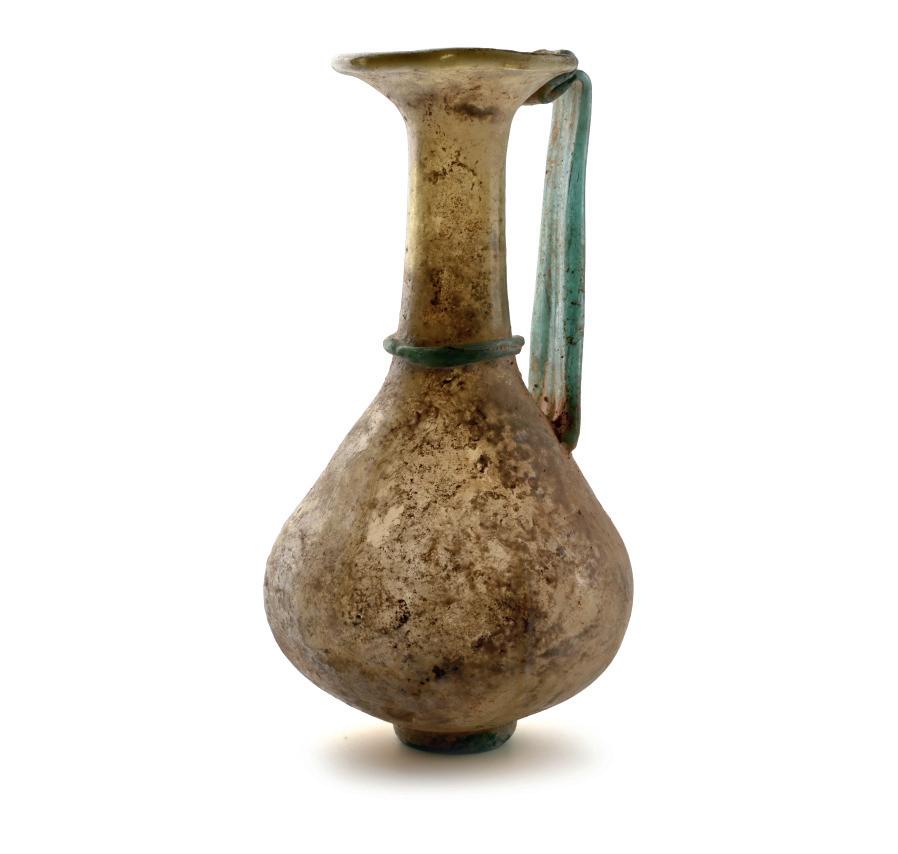
109

ROMAN GREEN GLAZED TERRACOTTA CUP WITH SIGNATURE
1ST-2ND CENTURY A.D.
6 in. (273 grams, 16.2 cm)
Barrel-shaped in profile with low flared foot, stepped inner rim, two loop handles below the rim with palmette detailing; sidewall with applied motifs: clusters of discs, rosette, seated bearded man in long robe, winged female in profile, human foot - one with neatly incised retrograde legend ‘[T]POKO ’ (abbreviated maker’s name).
£4,000 - 6,000
PROVENANCE:
UK private collection before 2000. Acquired on the UK art market. Private collection, London, UK.
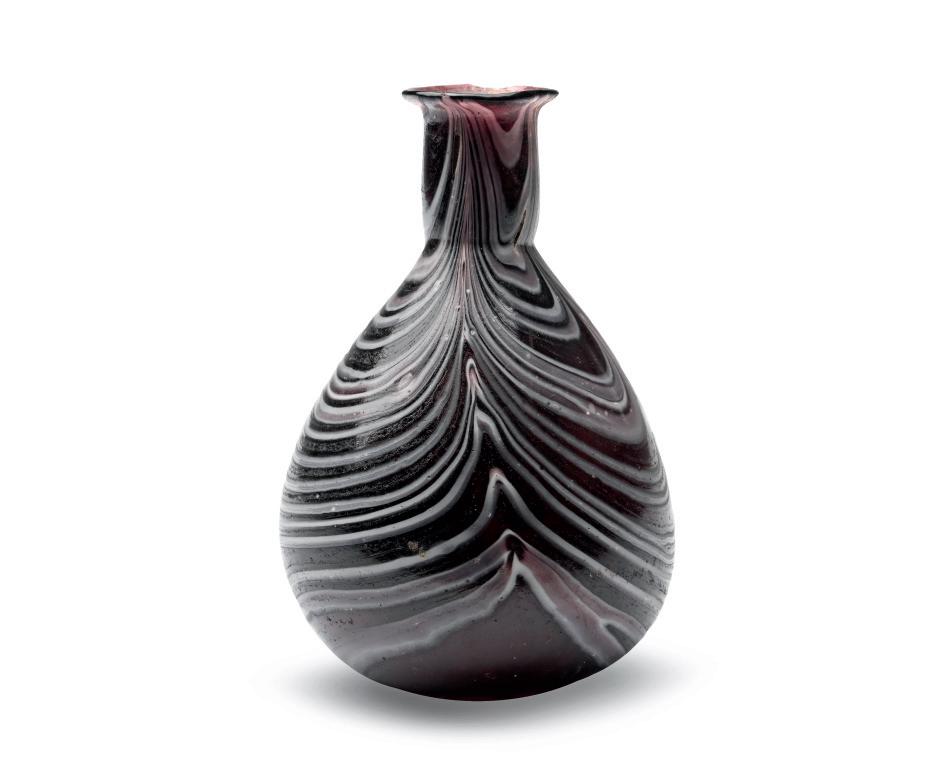
111
ROMAN MOULD-BLOWN
MARBLED GLASS FLASK
1ST CENTURY A.D.
4 in. (80 grams, 10 cm)
Wide body and tall tubular neck with everted rim, formed of marbled glass in shades of brown and white; restored.
£1,000 - 1,400
PROVENANCE:
From the F.D. collection, 1990s. Ex Mayfair, London, UK, dealership. Ex collection of a London, UK, gentleman.
FOOTNOTES:
This specimen belongs to the types of colour band piriform bottles of glass strips, fused and blown. After cooling, slices were cut from the rod cross-wise, then arranged side-by-side and fused together to create a multi-coloured and multi-patterned sheet of glass. Alternatively, the craftsman, instead of cutting the glass chords, could place them side by side and fuse them together in strips.
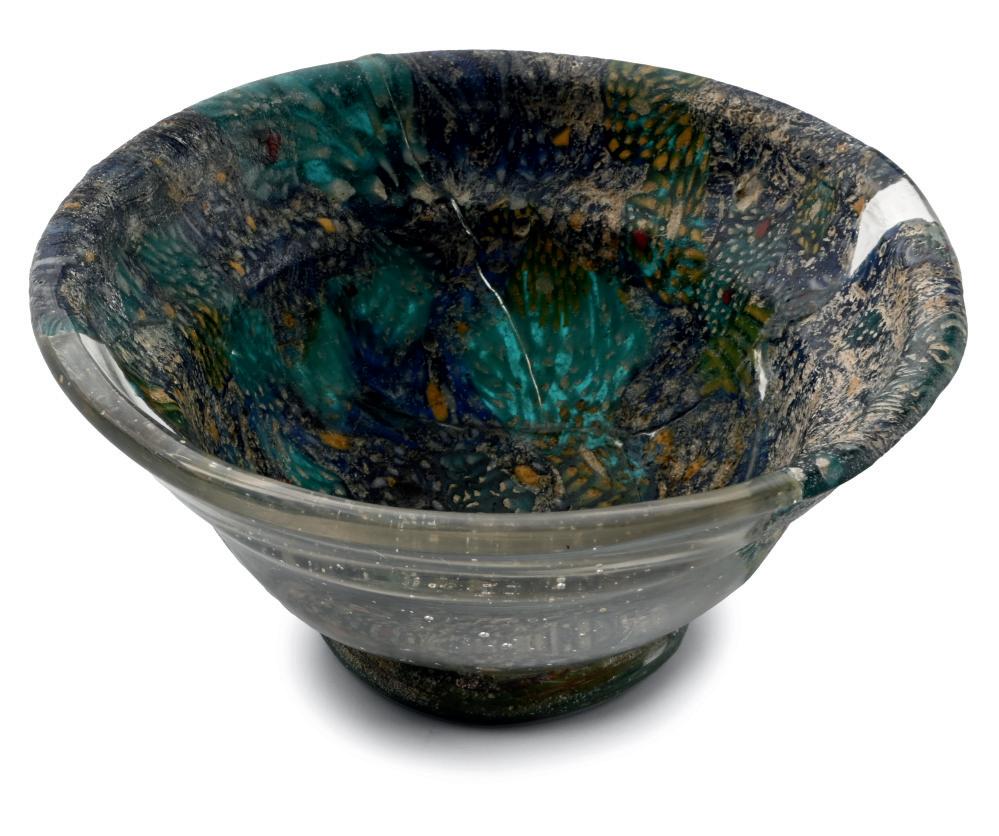
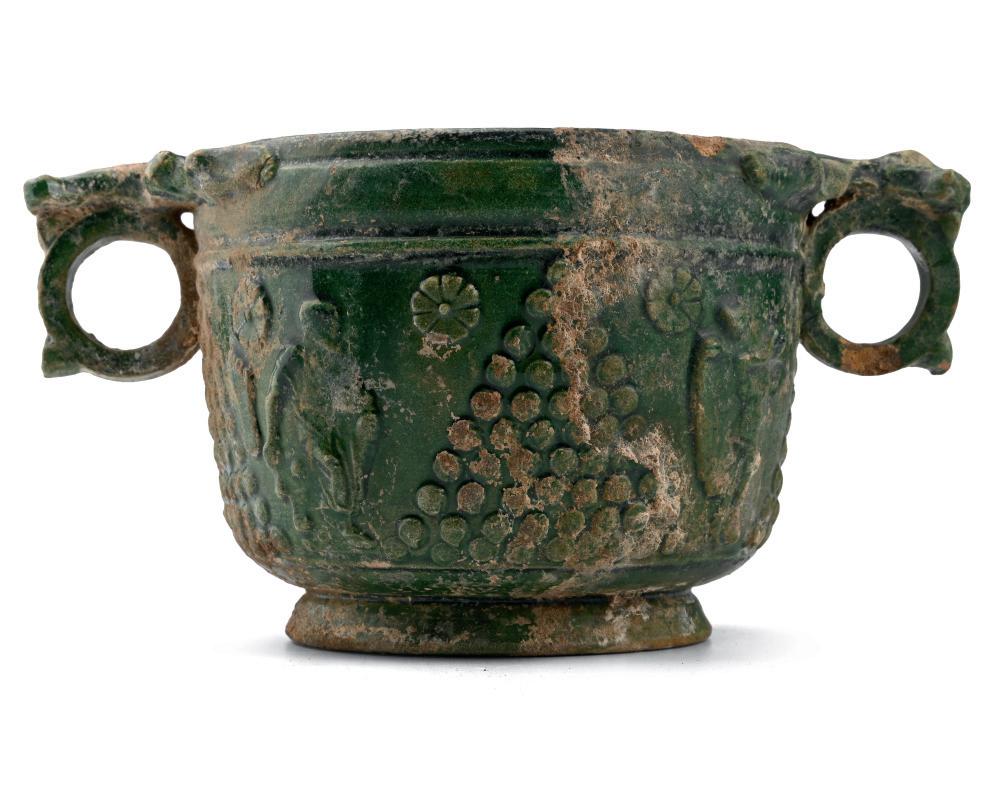
110

ROMAN AUBERGINE-BANDED GLASS VASE
1ST CENTURY A.D.
2 in. (32.58 grams, 73 mm)
Piriform in profile with tapering cylindrical neck, flared rim and rolled lip, with dragged trails; rim chipped.
£1,000 - 1,400
PROVENANCE: Private collection, 1982. Acquired by the present owner through the UK art market.
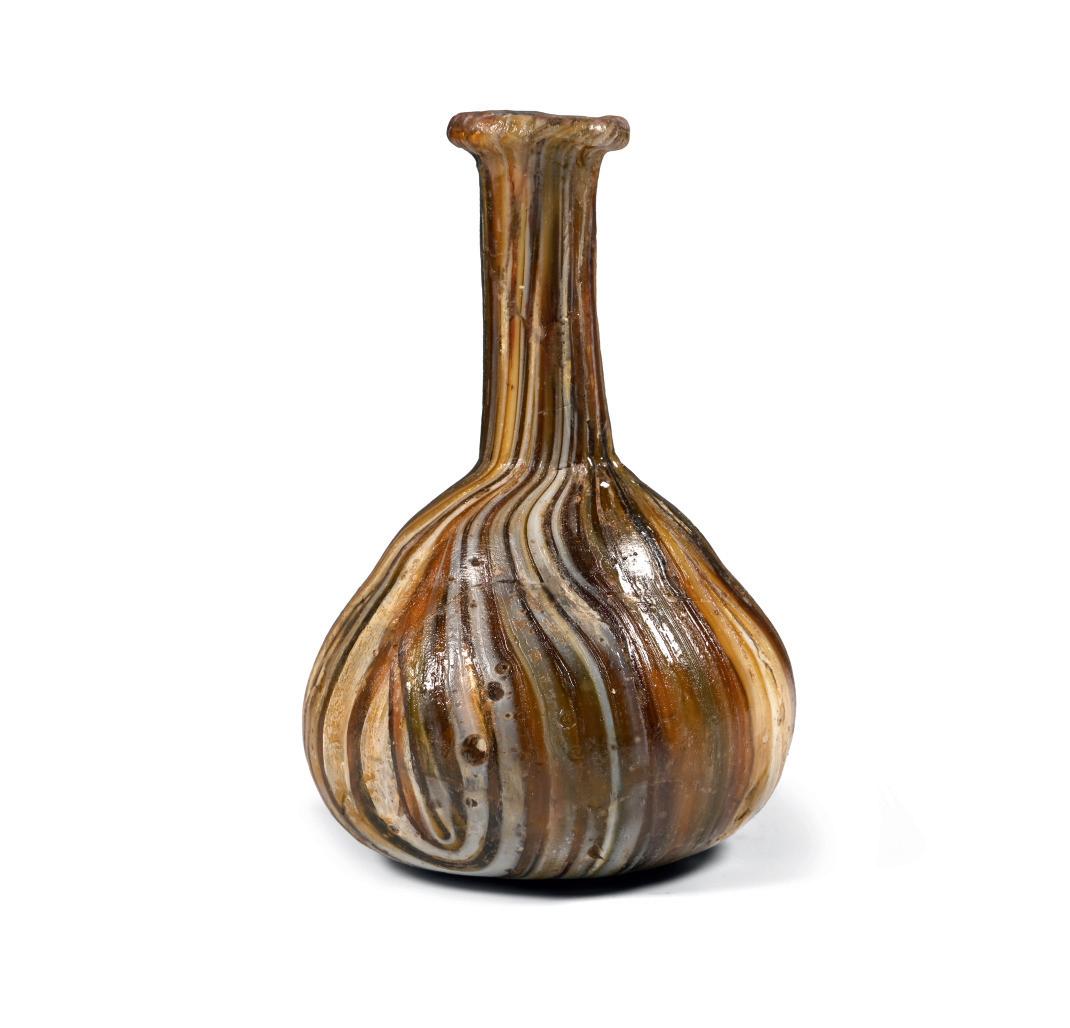
112
ROMAN TURQUOISE MOSAIC GLASS PATELLA CUP
1ST CENTURY B.C.-1ST CENTURY A.D.
3¾ in. (68 grams, 94 mm wide)
Bell-shaped in profile with carinated shoulder, applied trail foot; formed from mosaic glass panels with floral and other motifs; repaired with modern aqua glass. [No Reserve]
£1,000 - 1,400
PROVENANCE: Acquired on the UK art market, 1977-1979. Private collection, London.
113
ROMANO-GANDHARAN SILVER PHIALE WITH POINTILLÉ KAROSHTI INSCRIPTION
1ST CENTURY B.C.-1ST CENTURY A.D.
8 in. (281 grams, 20.7 cm wide)
Broad dished body with carinated rim; legend to the exterior rim, the inscription meaning ‘(Property) of Virghosa, sadera 15, drachma 2, dhanea 3, a(NDikA)2.’
£1,500 - 2,000
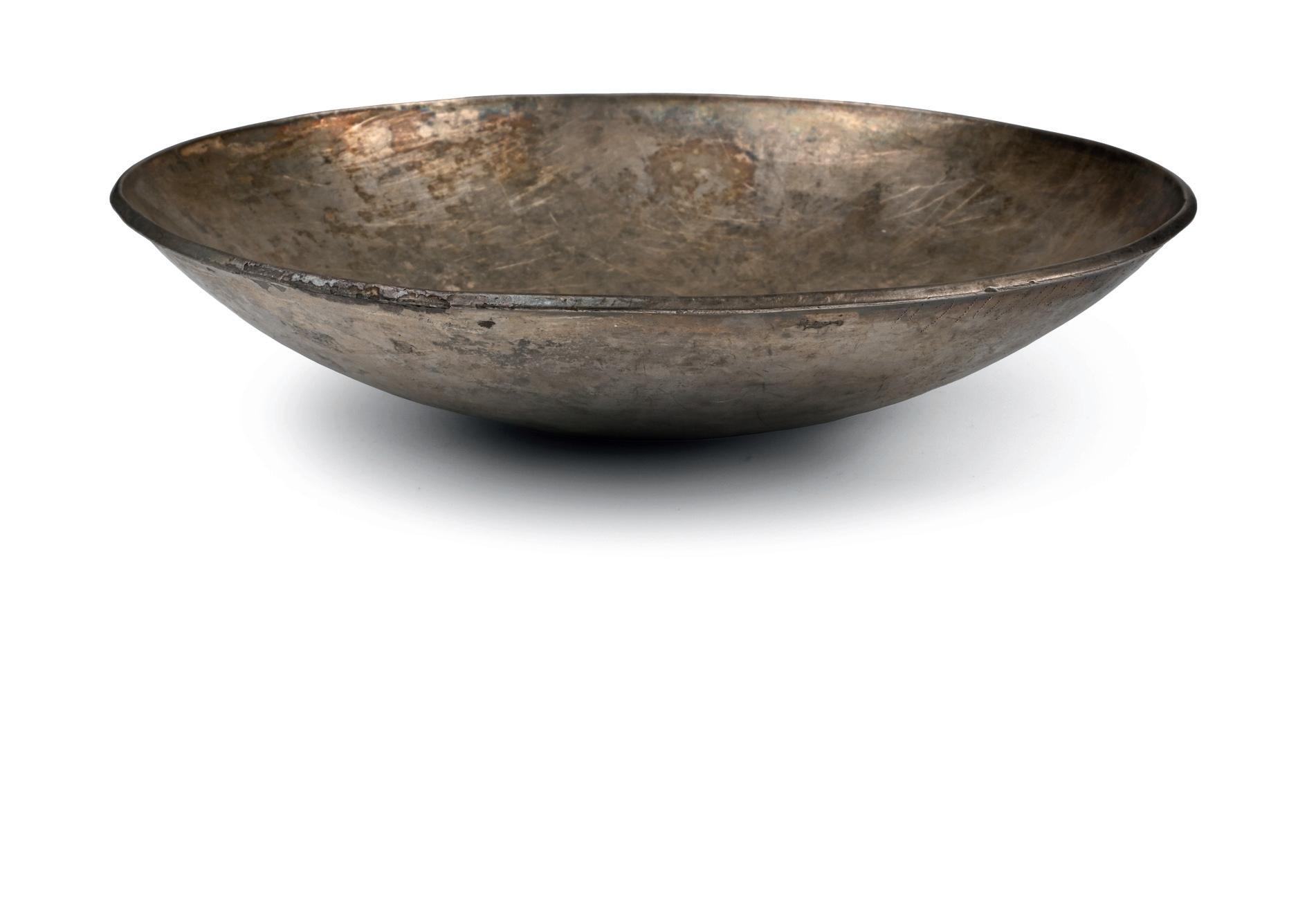
PROVENANCE:
Acquired from a private UK collection prior to 1979.
Ex Julian Sherrier collection, a leading figure in Gandharan art.
Ex Christie’s, New York, 14th September 2010, no.35 (part).
114
ROMANO-GANDHARAN SILVER CUP AND TRAY
1ST CENTURY B.C.-1ST CENTURY A.D.
2 - 5¼ in. (118 grams total, 6.7-13.2 cm)
Rectangular in plan with two shallow bowls, separate deep insert with flange rim. [2]
£1,500 - 2,000
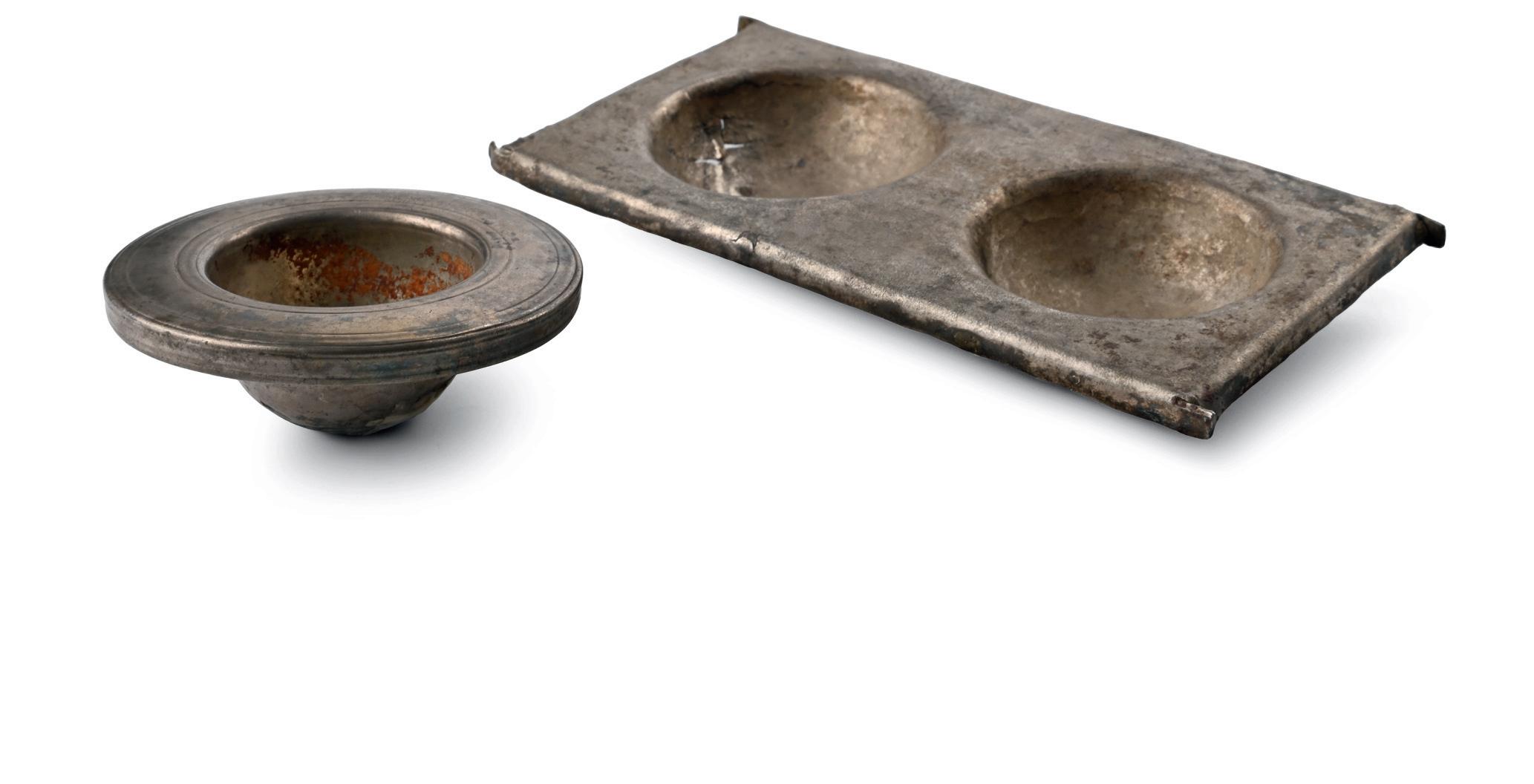
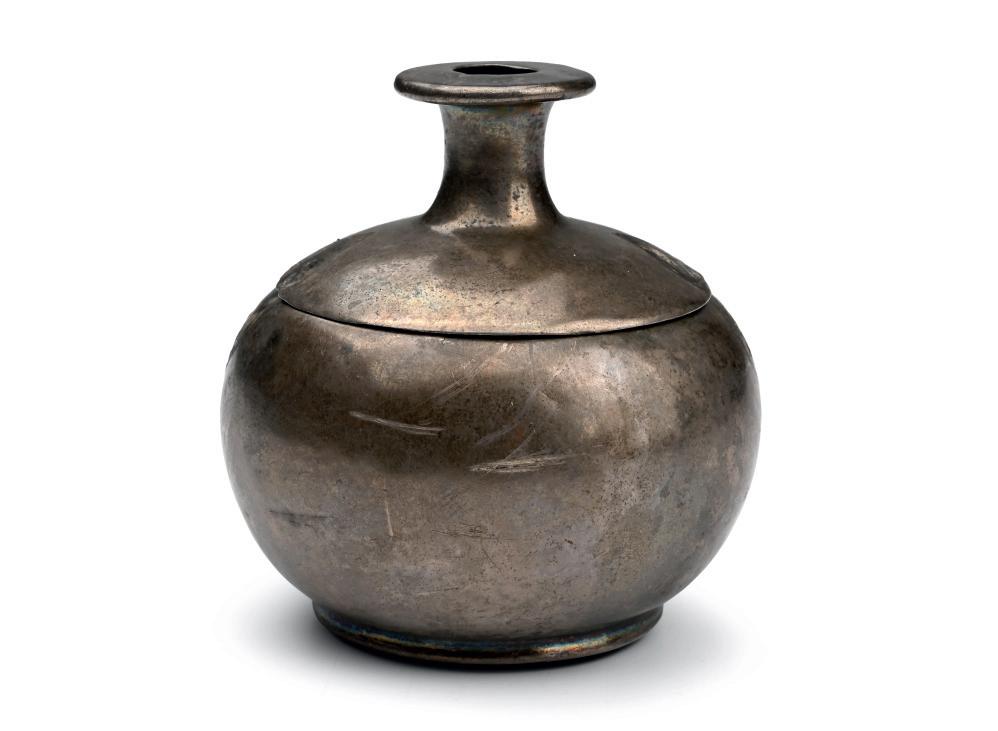
PROVENANCE:
Acquired from a private UK collection prior to 1979.
Ex Julian Sherrier collection, a leading figure in Gandharan art.
Ex Christie’s, New York, 14th September 2010, no.35 (part).
115
ROMANO-GANDHARAN SILVER ARYBALLOS WITH COVER
1ST CENTURY B.C.-1ST CENTURY A.D.
2¾ in. (80 grams, 71 mm high)
Squat in profile with discoid base, separate inset lid with trumpetshaped handle.
£1,000 - 1,400
PROVENANCE:
Acquired from a private UK collection prior to 1979.
Ex Julian Sherrier collection, a leading figure in Gandharan art.
Ex Christie’s, New York, 14th September 2010, no.40 (part).
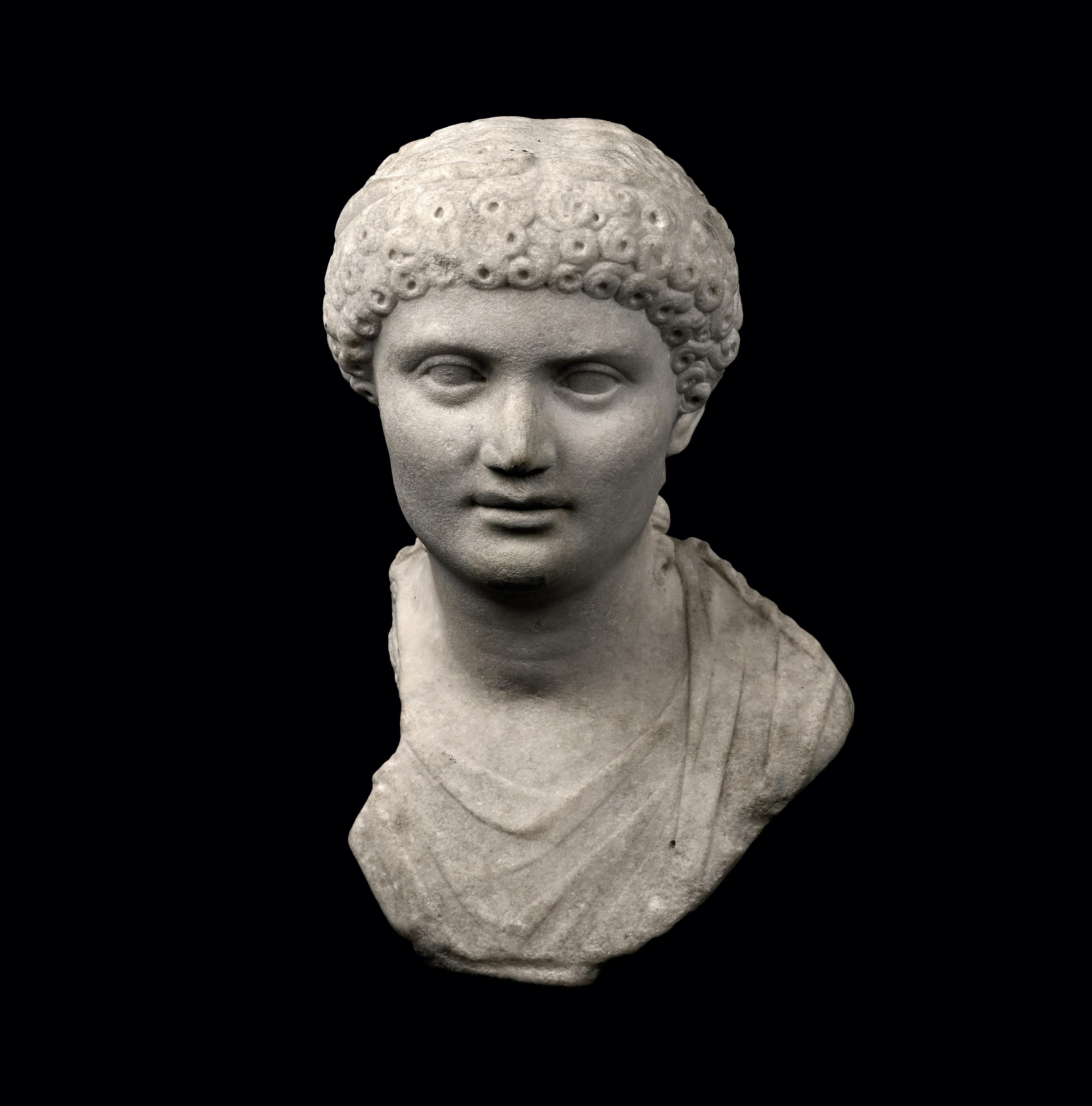

ROMAN MARBLE PORTRAIT BUST OF AN ARISTOCRATIC WOMAN
JULIO-CLAUDIAN PERIOD, CIRCA 50-60 A.D. 17 in. (37.35 kg total, 43.5 cm including stand)
A life-size bust showing the head turned slightly to the left, an expression of dignity on her face with broad cheeks and pronounced cheekbones, heavy eyelids with narrow eyes, gentle depressions around the full lips; hair arranged in tight curls leaving the ears exposed, small braids gathered and tied at the back with a double thong with two corkscrew curls falling on each side of the neck; the lower part of the neck framed by delicate folds of a tunic, palla covering her left shoulder; mounted on a custom-made display stand.
£30,000 - 40,000
PROVENANCE:
Professor Elia Volpi (1858-1938) collection, Florence, prior to 1910. Vente de la Collection Elie Volpi; Hotel de Ventes Jandolo & Tavazzi, Florence, 25 April-3 May 1910, no.53, pl. XCII (illustrated).
Private collection, France, likely Château de Beaumesnil, near Rouen. Provenant du Château de Beaumesnil et du Château de T...Objets d’Art et de Bel Ameublement Principalement du XVIIIe, Palais des Congres, Rouen, 20 February 1983.
Anonymous sale; Hindman, Chicago, 25 May 2023, no,194.
Acquired by the present owner at the above sale.
PUBLISHED: Various, Illustrations du Catalogue des Précieuses Collections d’Objets d’Art Appartenant au Prof. Elie Volpi (Exhibition Catalogue), Florence, 1910, no.53; Various, La Gazette de L’Hôtel Drouot, edition 5 (Gazette), Paris, 4 February 1983, p.36; Freyer-Schauenburg, B., ‘Porträtbüste einer Dame in Schweizer Privatbesitz’ in Varkıvanç, B. (ed), Baki Ö ün’e Arma an - Melanges offerts a Baki Ö ün - CALBIS, Ankara, 2007, pp.97-108.
FOOTNOTES:
This portrait is striking due to the delicate yet exotic features of the subject and her elaborate coiffure. The sculpture was produced during a formative and highly sophisticated phase of Roman art, and during a time when portraits of women are much less common than those from later Imperial times. The preparation for a patch at the back of the head is seemingly ancient. Although she remains anonymous, given the sculpture’s scale and scope, one can assume it portrays a person of note, who wished to be represented with the ideal and distinctive features of a Roman aristocrat. For a comparable portrait bust, see Agrippina Minor at the NY Carlsberg Glyptotek, Copenhagen (Acc. no.755).

118
ROMAN BRONZE ZEBU STATUETTE ‡
3RD-4TH CENTURY A.D.
1 in. (61 grams, 47 mm)
Hollow-formed in reclining pose with the legs folded beneath the body, tail curled over the rump, hump to rear of neck.
£1,200 - 1,700
PROVENANCE: Acquired in 1992.
Private collection, thence by descent.
Private collection, since the late 1990s.
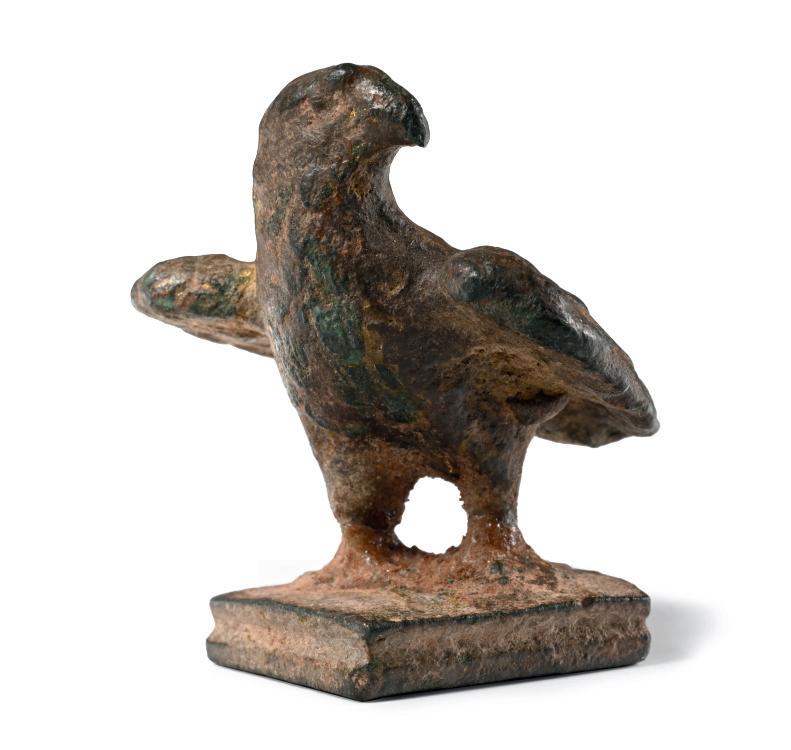
120
ROMAN BRONZE LEGIONARY EAGLE STAFF FINIAL ‡
2ND-3RD CENTURY A.D.
3 in. (236 grams, 81 mm)
Comprising a hollow-formed knop with collar to the socket, eagle modelled in the round perching on the knop with wings spread and head turned; socket behind the shoulders.
£1,200 - 1,700
PROVENANCE:
Acquired in the mid 1980s-1990s.
Private collection, Switzerland, thence by descent. Private collection, since the late 1990s.
117

ROMAN BRONZE STATUE OF A BEAR KILLING A DEER
1ST-2ND CENTURY A.D.
4 in. (398 grams, 10 cm)
On a stepped triangular base, bear with head raised, forepaws round the neck of a deer with legs folded beneath the body.
£1,000 - 1,700
PROVENANCE: Nicolas Koutoulakis (1910-1996).
Private collection of Mr K.A.
EXHIBITED:
Harwich Museum, Harwich, Essex, UK, 26th May-15th September 2025; accompanied by a copy of a photograph of the artefacts on display.
FOOTNOTES:
Combat between large animals was a popular theme in Roman art. The staging of such fights in the Flavian Amphitheatre in the heart of Rome is evidenced. Furthermore, the 3rd-4th century A.D. mosaic floor unearthed at Lod, Israel, in 1996 shows several scenes with ferocious wild animal - a lion and lioness, an elephant, a giraffe, a rhinoceros, a tiger, and a wild bull - all arranging themselves for a colossal fight to the death. The mosaic was lifted intact and is on display in the Metropolitan Museum of Art, New York.
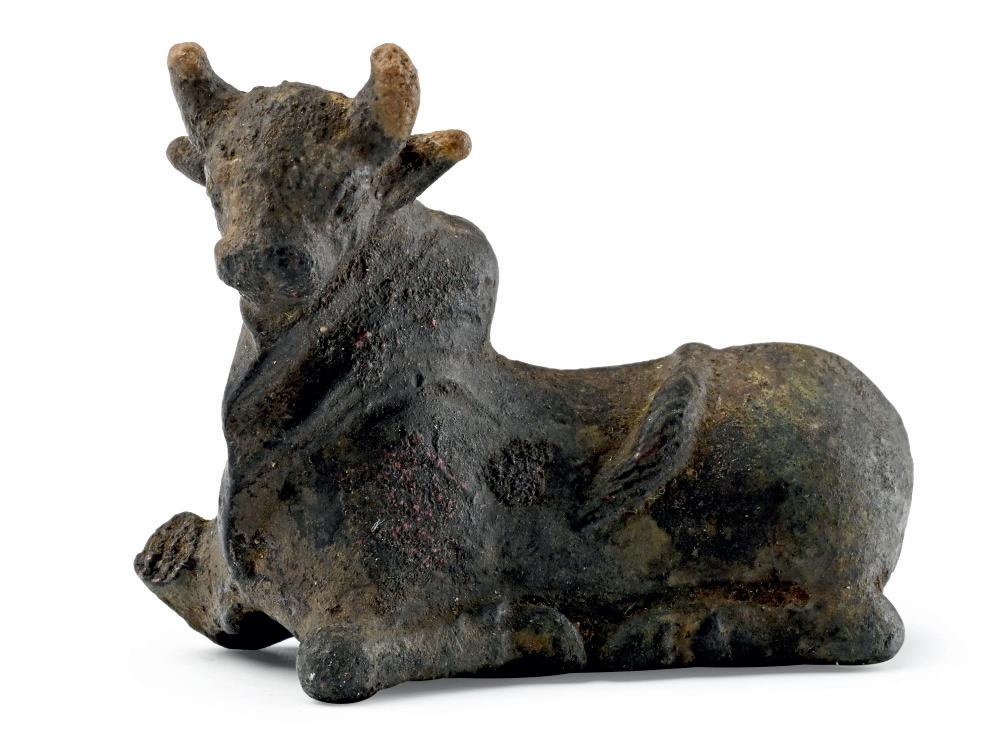
119
ROMAN GILT BRONZE EAGLE STATUETTE ‡
2ND-3RD CENTURY A.D.
1 in. (104 grams, 47 mm)
Modelled in the round on a square base with gusseted sides, standing with head turned and wings spread.
£1,200 - 1,700
PROVENANCE:
Acquired in the mid 1980s-1990s. Private collection, Switzerland, thence by descent. Private collection, since the late 1990s.
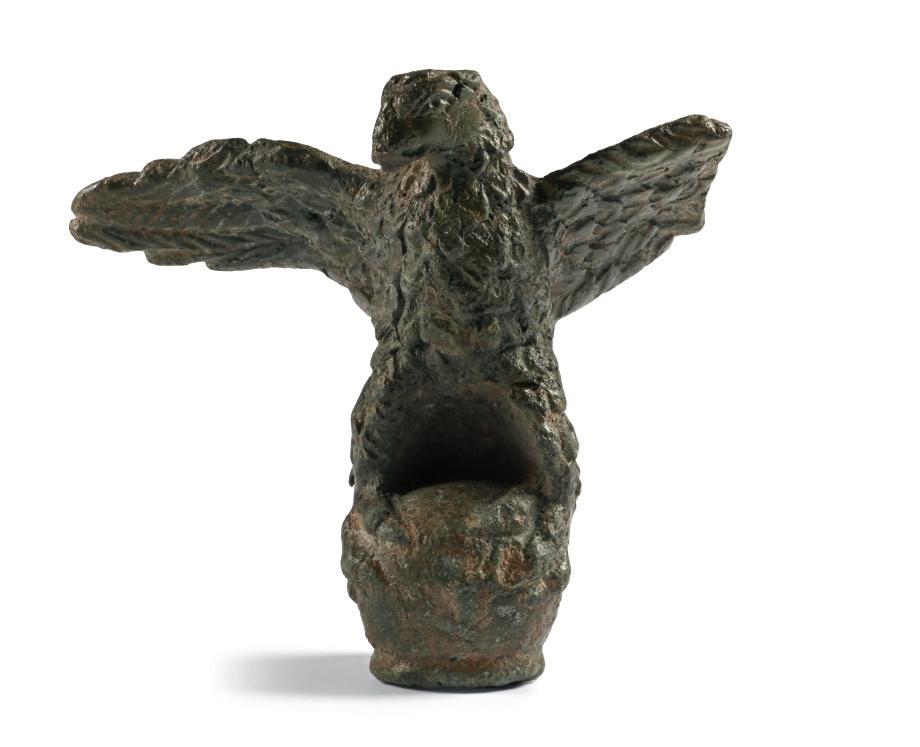
121

LARGE ROMAN BRONZE STATUE OF VENUS
1ST-2ND CENTURY A.D.
10¾ in. (996 grams, 27.3 cm)
Modelled in the round, the goddess standing nude on a socle base and holding a frond in her extended left hand; right hand with thumb and forefinger extended; crown of oak leaves encompassing her chignon.
£6,000 - 8,000
PROVENANCE: with Sotheby’s, New York, 7 December 1973, no.78. Private collection, London.
Accompanied by copies of the relevant Sotheby’s catalogue pages.
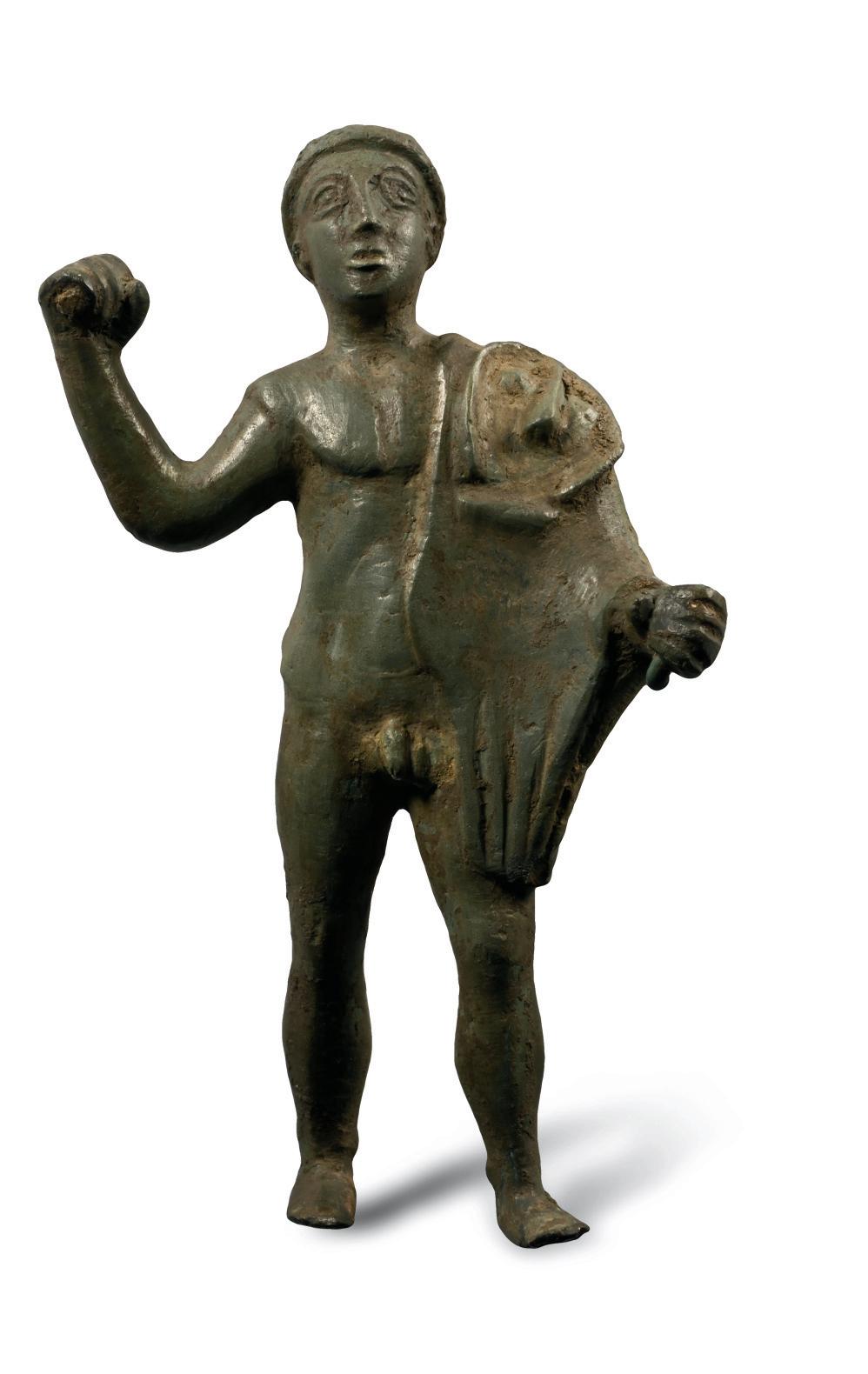
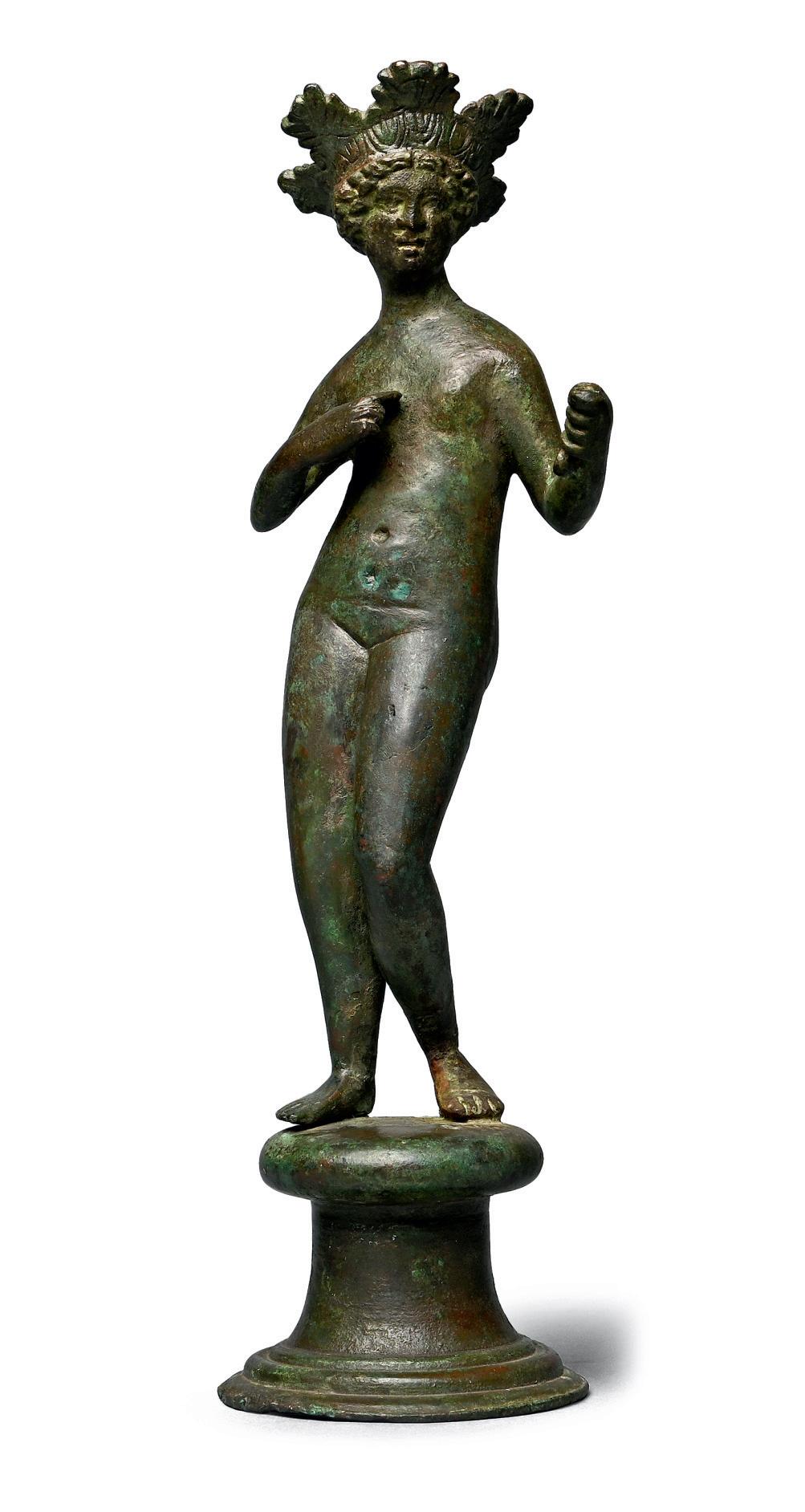
122

ETRUSCO-ITALIC BRONZE FIGURE OF YOUNG HERCULES ‡ ARCHAIC STYLE, CIRCA 4TH-3RD CENTURY B.C.
4 in. (307 grams, 12 cm)
Modelled in the round figure standing in advancing pose with the right hand raised and fist clenched; left shoulder and arm covered with the skin of the Nemean lion and left hand modelled hollow; hair cut short and textured.
£5,000 - 7,000
PROVENANCE: Acquired in the mid 1980s-1990s. Private collection, Switzerland, thence by descent. Private collection, since the late 1990s.
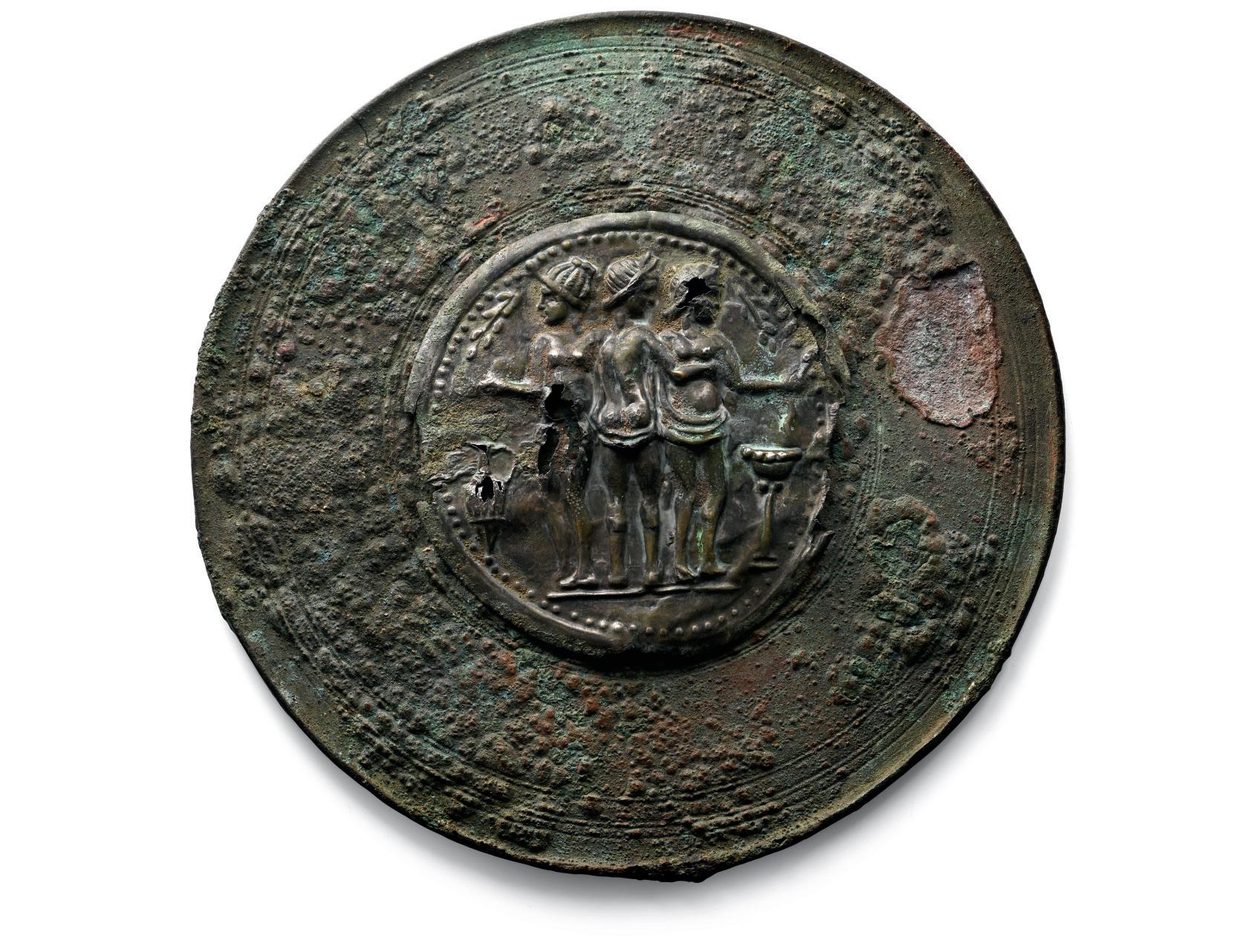
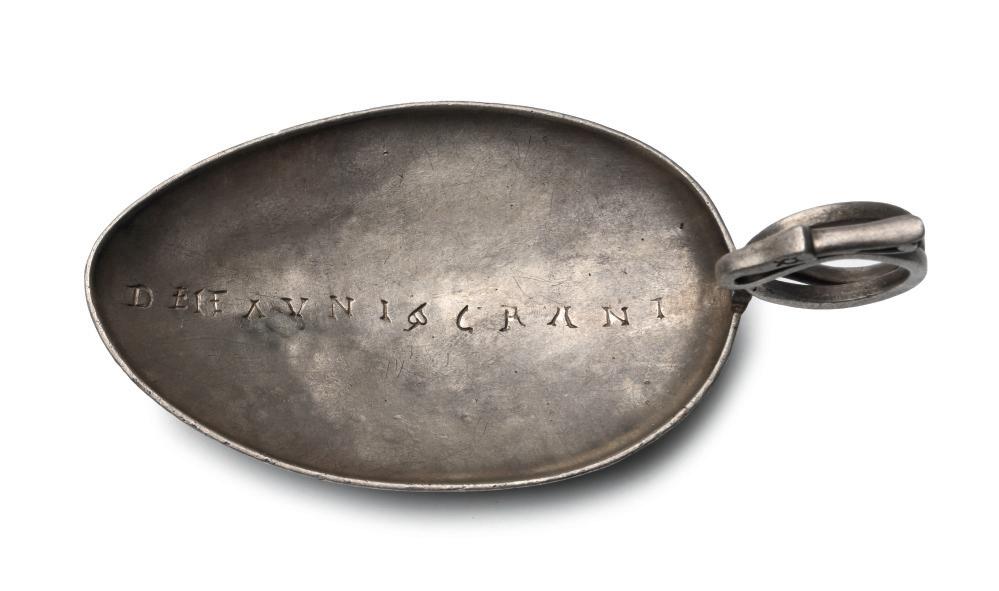
123
LARGE ROMAN BRONZE MIRROR WITH THREE GRACES
1ST-4TH CENTURY A.D.
6½ in. (497 grams, 16.6 cm)
Discoid in plan with raised rim and concentric rings; central applied sheet-silver plaque with three standing females between a jug and a bowl, each on a stand; pelletted rim.
£600 - 800
PROVENANCE:
Ex German art market, 2000s.
Acquired from an EU collector living in London. From the collection of a Surrey, UK, gentleman.
124
ROMAN SILVER SPOON PROPERTY OF THE GOD FAUNUS CRANUS
4TH CENTURY A.D.
3½ in. (32 grams, 91 mm)
Shallow oval bowl with a coiled handle and a duck or swan head facing outwards, Latin inscription ‘DEIFAVNI CRANI’, ‘(Property) of the god Faunus Cranus’.
£800 - 1,000
PROVENANCE:
UK private collection, 1990s. with Artemission, London, UK. Private collection, London, UK.
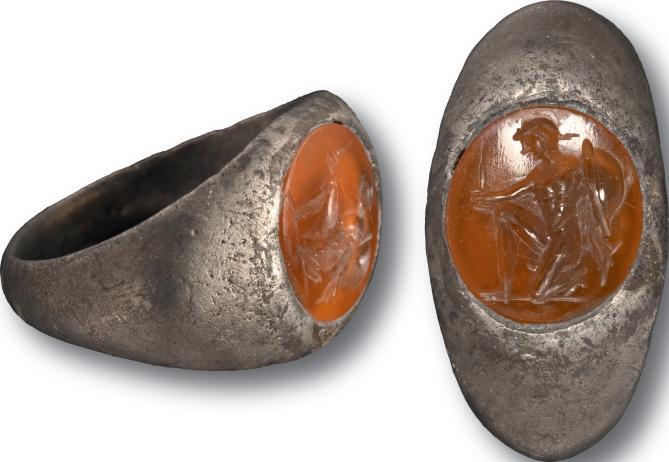

125
ROMAN SILVER RING WITH WARRIOR GEMSTONE
2ND-3RD CENTURY A.D.
1 in. (8.11 grams, 27.11 mm overall, 20.96 mm internal diameter (approximate size British N½, USA 6¾, Europe 14.35, Japan 13))
With ellipsoid plaque and inset carnelian cloison with intaglio kneeling warrior with Pseudo-Attic helmet pushed back from the face, domed shield on one arm and sword held upright in the other hand supported by the knee.
£800 - 1,000
PROVENANCE:
Acquired on the European art market in the 1990s. UK collection of a European gentleman.
FOOTNOTES: The motif of a nude kneeling warrior with weapons is certainly visible in the repertory of the Greek gemstones since the Archaic and classical age. The scene possibly alludes to the incident in the Trojan Cycle where Achilles is wounded by an arrow in his heel, the only part of his body which was not impervious to injury.


126
ROMAN INKED WOODEN TABLET WITH TESTAMENTARY DISPOSITIONS OF EMILIUS VERNUCIUS
CIRCA 300 A.D.
8¼ x 7 in. (99 grams, 21 x 19.5 cm)
Well preserved square tablet with a recessed panel to each face and two holes to accept thongs, probably the third tablet of a Roman will made by Emilius Vernucius around 300 A.D., two small holes at the upper rim (for binding the tablets of this document together); the text of the inner and first half of the outer face consisting of testamentary dispositions always starting with the verbs do lego, slaves, fields, buildings, and sums of money are mentioned; at the end the mancipatory formula of Roman testaments can be read, mentioned are the familiae emptor and the libripens, as well as the first of the witnesses, Emilius Cerealius. [No Reserve]
£3,000 - 4,000
PROVENANCE:
Acquired by Albert Sfez in the early 1950s.
Formerly the property of Monsieur Alain Sfez, a Belgian collector; acquired by gift from his father Albert Sfez, in 1965.
Acquired by a London dealer in 1973.
From an important London collection since 1975; thence by descent.
Accompanied by a copy of a four page academic report by Professor Dr phil. Peter Rothenhöfer.
EXHIBITED: Harwich Museum, Harwich, Essex, UK, 26th May-15th September 2025; accompanied by a copy of a photograph of the artefacts on display.
127

ROMAN INKED WOODEN TABLET REGARDING THE MARRIAGE BETWEEN DONATILLA AND IULIUS DONATILLUS AND THE GIFT OF A SLAVE GIRL
LATE 318 A.D.
9 x 5 in. (86 grams, 24.5 x 14.2 cm)
Well preserved rectangular tablet inscribed in Roman cursive script on one side, the text documents legal acts in the context of a wedding: first a counter-promise concerning the dowry between the father of the bride together with the bride, Donatilla, on the one hand and the groom on the other; then a gift from the bride’s mother to her daughter, a 6 year old young slave girl, the transfer taking the form of a mancipatio with Iulius Rogatianus as scale holder (libripens) and with the involvement of witnesses. [No Reserve]
£5,000 - 7,000
PROVENANCE:
Acquired by Albert Sfez in the early 1950s. Formerly the property of Monsieur Alain Sfez, a Belgian collector; acquired by gift from his father Albert Sfez, in 1965.
Acquired by a London dealer in 1973.
From an important London collection since 1975; thence by descent.
Accompanied by a copy of a three page illustrated academic report by Professor Dr phil. Peter Rothenhöfer.
EXHIBITED:
Harwich Museum, Harwich, Essex, UK, 26th May-15th September 2025; accompanied by a copy of a photograph of the artefacts on display.


TWICE THE LIFE-SIZE MARBLE PORTRAIT OF EMPEROR
HADRIAN
HADRIANIC PERIOD, 126-140 A.D.
23 in. (56.4 kg total, 60 cm high including stand)
A characteristic portrait of the Emperor Hadrian, his hair arranged in wavy strands swept forward from the crown, ending in a row of lively curls that frame his forehead and temples; his narrow eyes slightly shaded by the pupils and by the sharply defined upper eyelids, giving him a thoughtful expression; thick beard composed of tight curls and covering his chin, extending high up the full cheeks; a gently waved moustache above his closed lips; thick neck with the preserved start of the right shoulder suggesting his head was turned slightly to the right, indicating that the portrait once belonged to a full-length statue or to a bust; mounted on a custom-made display stand.
£80,000 - 100,000
PROVENANCE:
Swiss art market, February 1988.
Private collection, Liechtenstein.
Accompanied by a copy of an Art Loss Register certificate no.S00122139.
FOOTNOTES:
Born in AD 76, Publius Aelius Hadrianus became emperor in AD 117, following the death of his adoptive father, Trajan. Portrait heads of Hadrian, like the present example, were often made for statues that stood in temples or public buildings, either to honour the emperor before an official visit or to commemorate his presence afterward. This particular portrait is a striking depiction of Hadrian, showing him with balanced and compact facial features. His hair is arranged in wavy strands swept forward from the crown, ending in a row of lively curls that frame his forehead and temples. His narrow eyes are slightly shaded by the sharply defined upper eyelids, giving him a thoughtful expression. The thick beard is composed of tight curls and covers his chin, extending high up the cheeks, which remain full and show little sign of age. A gently waved moustache sits above his closed lips. His neck is thick, and the preserved start of the right shoulder suggests his head was turned slightly to the right, indicating that the portrait once belonged to a full-length statue. Hadrian is one of the most frequently depicted Roman emperors in surviving portraits, second only to Augustus. His long reign and extensive travels across the empire led many cities to erect statues in his honour, either in anticipation of his arrival or as a tribute after his departure. Unlike the expansionist emperors who came before him, Hadrian focused on strengthening and securing the empire. He travelled widely, visiting regions including Spain, Greece, Asia Minor and Egypt. Even though he ruled for over 20 years, Hadrian is almost always shown in the prime of middle age. He was the first emperor to wear a beard in his official portraiture, likely a reflection of his admiration for Greek culture. This choice marked a significant change in imperial image-making and became the norm for later emperors. His hair typically falls in soft waves, ending in neatly defined curls across the brow. Scholars have identified six major portrait types of Hadrian, distinguished by subtle differences in the way his hair is arranged.

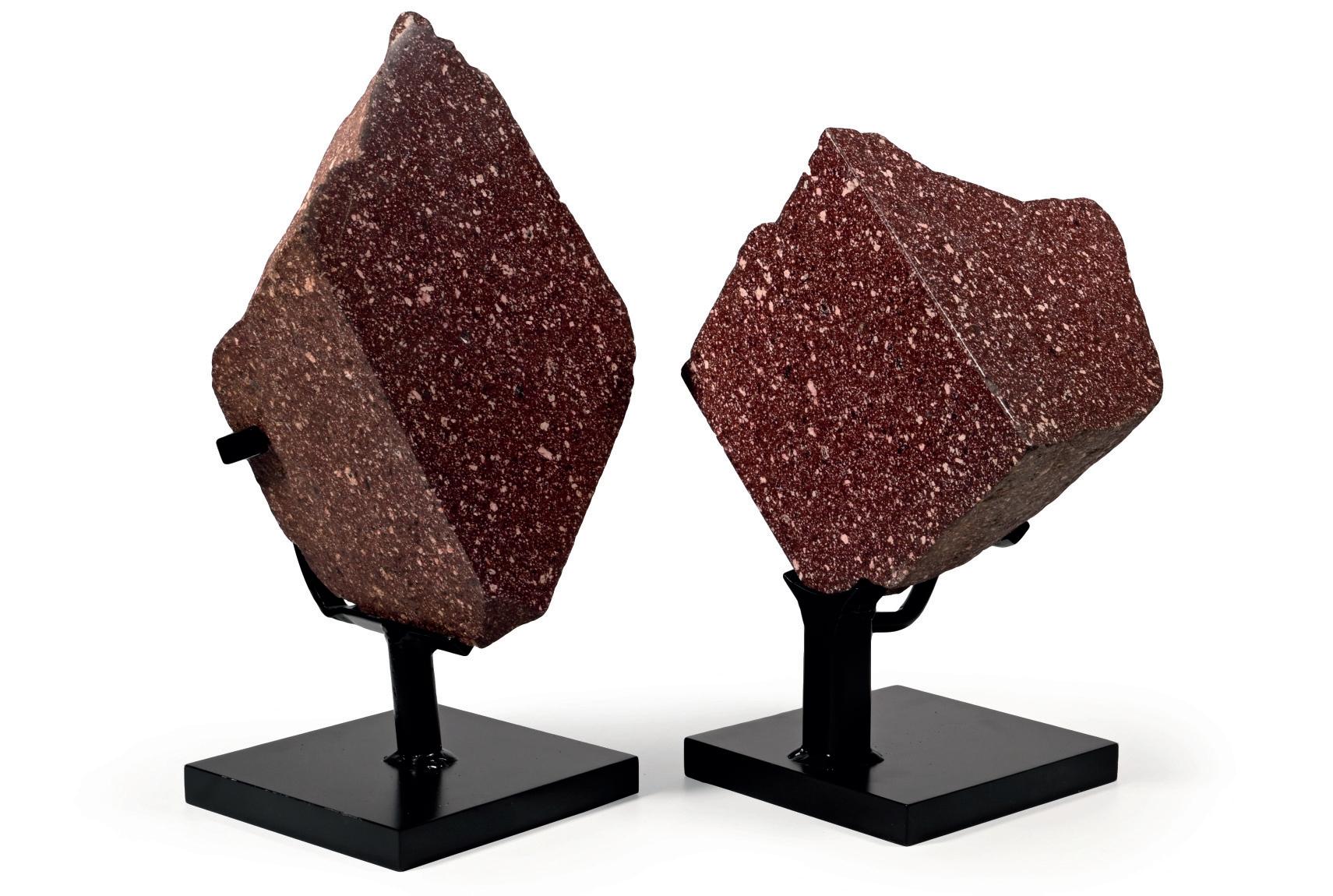

129
LATE ROMAN IMPERIAL PORPHYRY FRAGMENTS
4TH-6TH CENTURY A.D.
22¼ - 14 in. (44.75 kg total, 31-36 cm including stands)
Comprising two imposing slabs, the first formed as an irregular block with three possibly later polished sides, with the other three sides presenting a descending wall and two hollows carved in the upper and lower part; the second one formed as a parallelepiped with round corner having a possibly later polished side and the other three sides straight and round, with signs of carving; probably from an Imperial sarcophagus or monument; both mounted on a custom-made stand.
£3,000 - 4,000
PROVENANCE:
Acquired from the private collection of a Somerset gentleman who was related to Sir Arthur Evans.
From the private collection of a UK gentleman since before 2005.
FOOTNOTES:
For the Romans, porphyry was the Imperial marble par excellence, and from Constantine the great until the end of the 5th century, but probably also later, it was used to create sarcophagi for the emperors and members of the Imperial families. This particular stone was connected with the Imperial family because of its red colour, recalling the violet and red shades of the purple (porphyra), the precious colour assigned only to emperors and their relatives. In Constantinople, a room of the Imperial palace was called Porphýra, located on one of the palace terraces overlooking the Sea of Marmara and the Bosphorus. It was perfectly square in shape with a pyramidal ceiling and was entirely covered in purple porphyry speckled with white dots: this was the room where
the empresses gave birth to the heir of the Roman Empire, called Porphyrogénn tos, meaning ‘born in the purple room’. Porphyry was widely used for building churches in the Christian Empire, and Justinian exhausted the supplies from Egypt by building the great Church of Hagia Sophia, where still today a great amount of this material can be seen. The impressive Imperial sarcophagi were kept in the Church of the Holy Apostles, as well as the great porphyry sarcophagus of Constantine the Great, of which only a small fragment survives today in the Archaeological Museum of Istanbul.
130
ROMAN LEAD SHIP’S ANCHOR
LATE 2ND-EARLY 1ST CENTURY B.C.
24¼ in. (14.4 kg, 61.5 cm)
Comprising a square-section socket with inner crossmember, long square-section horn to each side; some marine accretion to the surface.
£2,000 - 3,000
PROVENANCE:
Acquired in the 1970s-early 1980s.
From the collection of a Plymouth, UK, gentleman; thence by descent. Ex property of Philip Smith, UK.
From a Cambridgeshire, UK, private collection.
FOOTNOTES:
Roman ships often used a type of anchor with a wooden shank and a lead stock at the top. This lead stock provided weight to help the anchor lay flat on the seabed and dig in. This exact type of anchor was already out of use by the time of the Roman conquest of Britain.

131




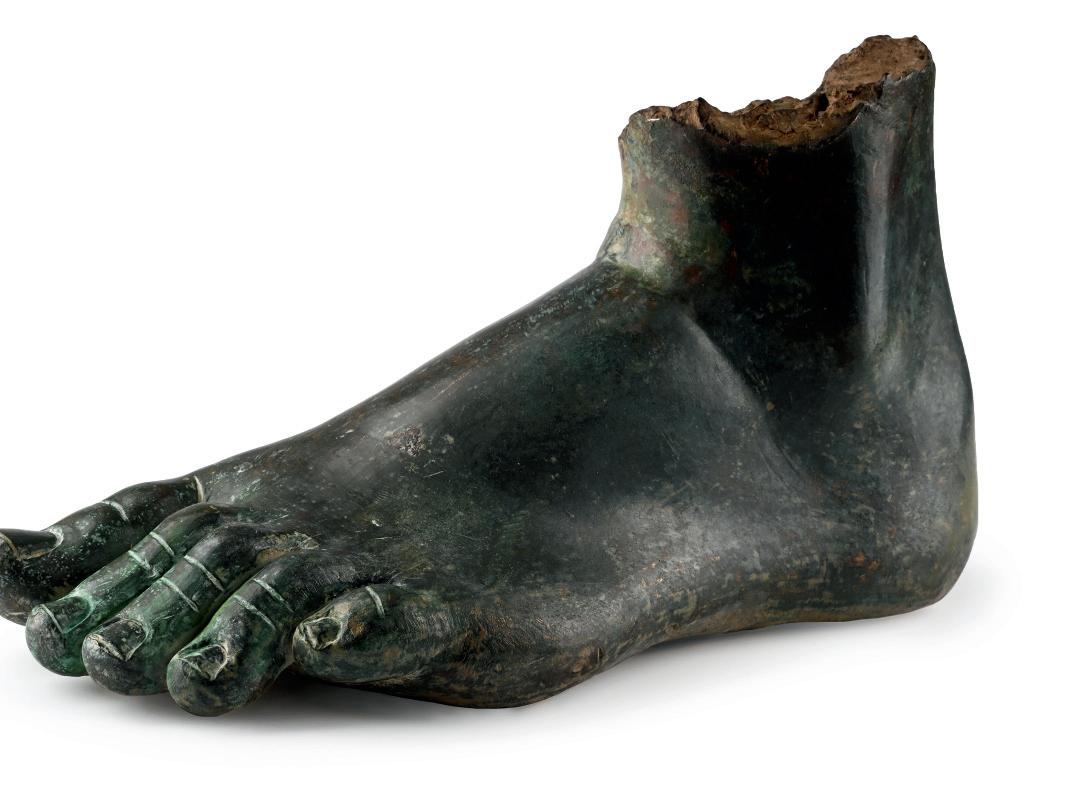
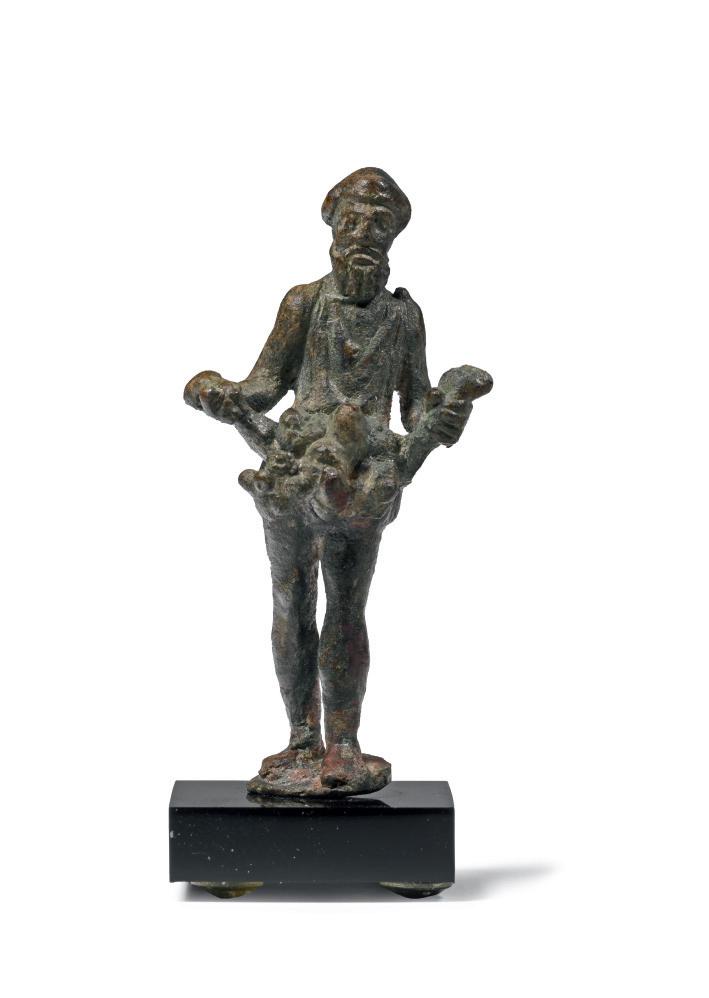
133
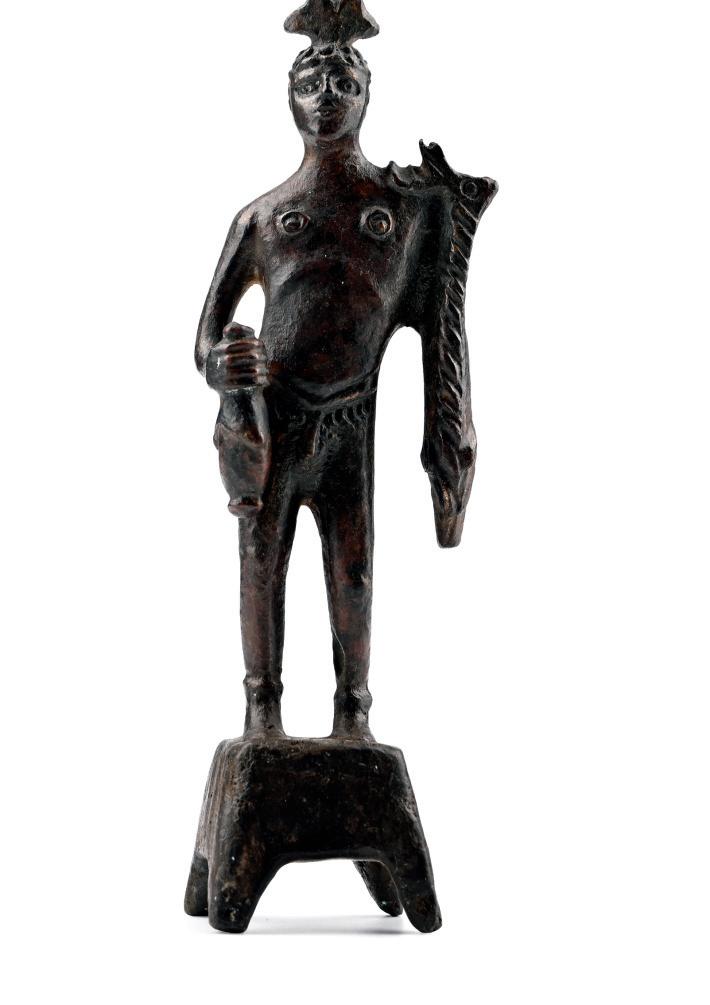
LIFE-SIZE ROMAN STATUE FOOT OF A YOUNG ATHLETE
1ST CENTURY B.C.-2ND CENTURY A.D.
8 in. (5.73 kg, 22 cm)
Comprising the left foot and ankle with finely modelled anatomical detailing, filled with lead and originally attached to a base from the sole of the foot.
£4,000 - 6,000
PROVENANCE:
From a London, UK, collection that was formed the 1980s. Acquired from Alan Darer, Mayfair, London, UK, 2016. From the private collection of a Beckenham, UK, lady.
132

ROMAN BRONZE FIGURE OF A BATHING YOUNG GIRL ‡
3RD-4TH CENTURY A.D.
6 in. (448 grams total, 17.4 cm including stand)
Standing nude female figure with hair dressed in a chignon, left hand clasped to the chest and right arm bent; mounted on a tiered display stand.
£3,000 - 4,000
PROVENANCE: Acquired in the late 1980s. Private collection, since the late 1990s.
ROMAN BRONZE STANDING FIGURE OF PRIAPUS
1ST-2ND CENTURY A.D.
2½ in. (31.7 grams total, 63 mm including stand)
Modelled in the round standing, wearing a paenula, his two hands holding up the hem to support a pile of fruits on his erect penis; mounted on a custom-made stand.
£1,000 - 1,400
PROVENANCE: From the private collection of Mr K.A., acquired in the 1990s-early 2000s.
FOOTNOTES:
This is one of the most characteristic representations of Priapus: standing, with long, smooth hair, his head covered by a traveller’s pilos (usually made of felt). With his hands he raises his tunic revealing his phallus, a symbol of fertility and good luck, and carries the first fruits of the earth on the hem of his tunic.
134
ROMAN BRONZE MERCURY STATUETTE EASTERN PROVINCIAL, 3RD-4TH CENTURY A.D.
4 in. (102 grams, 10 cm)
Modelled in the round, standing nude with attributes, cloak and caduceus on the left arm, coin-purse in the right hand; winged diadem; on a square base with stub legs.
£600 - 800
PROVENANCE: Ex German art market, 2000s. Acquired from an EU collector living in London. From the collection of a Surrey, UK, gentleman.
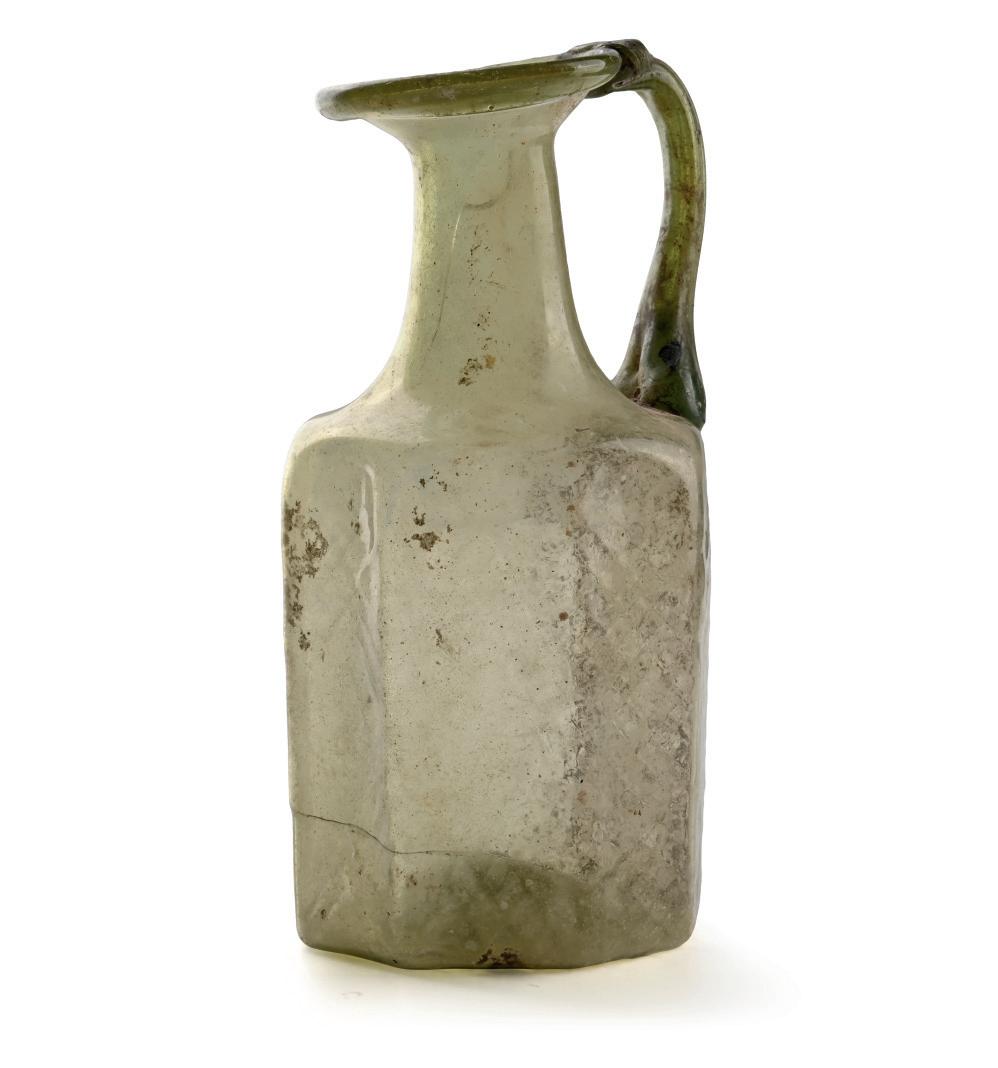
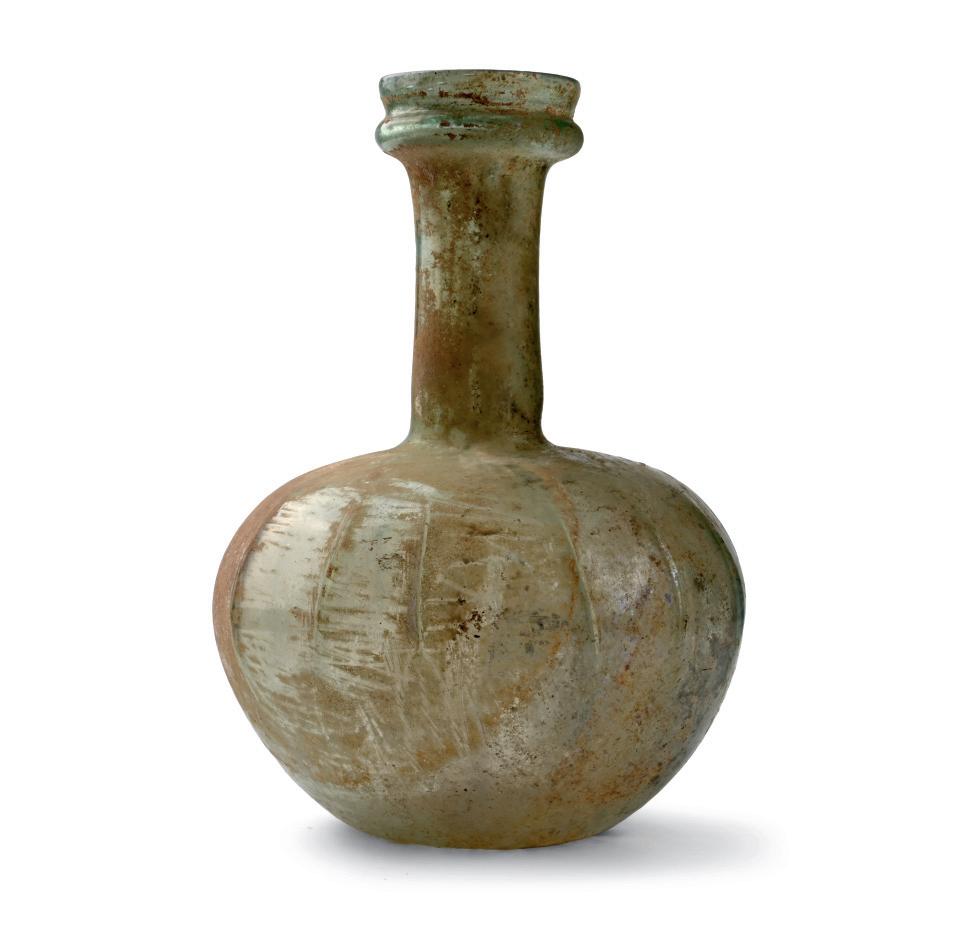

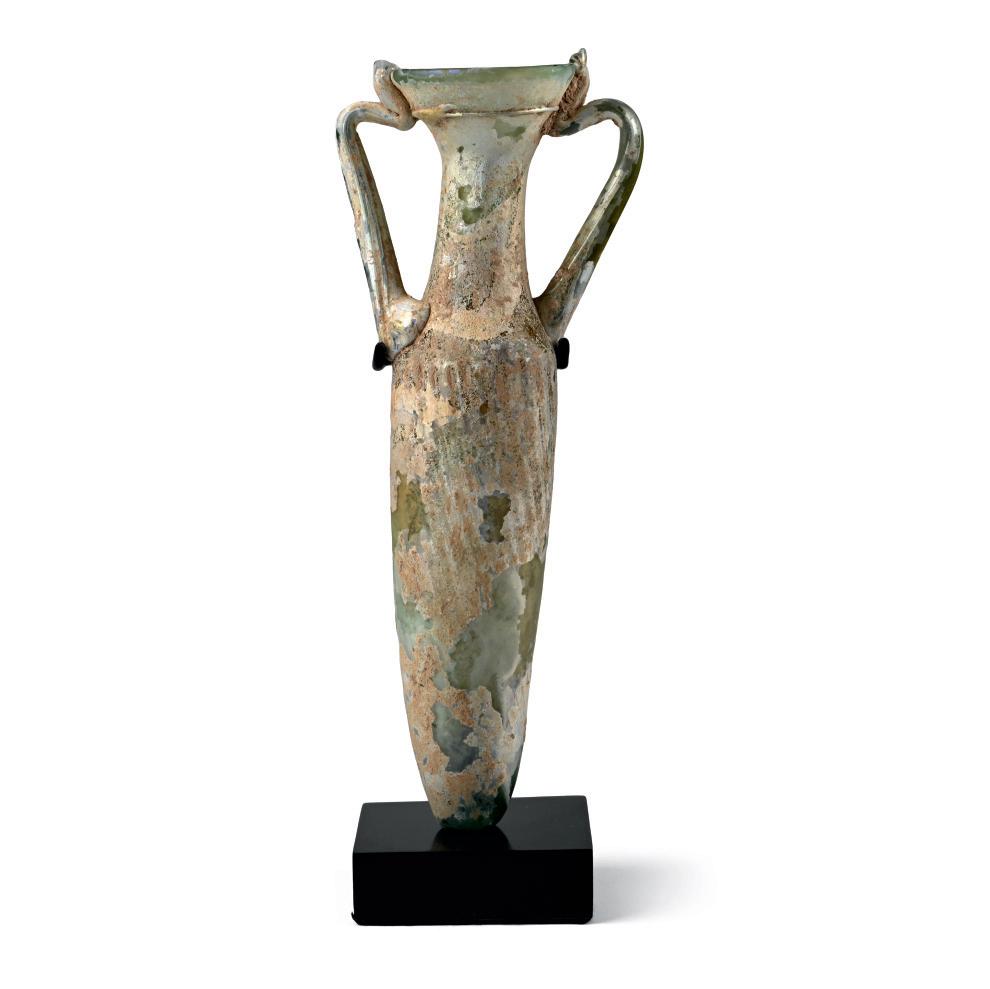
135
LARGE ROMAN OCTAGONAL GLASS FLASK
5TH CENTURY A.D.
6 in. (131 grams, 17.3 cm)
With a short tubular neck and trumpet-shaped mouth, strap handle to the rear; octagonal-section facetted body, dimple base.
£1,500 - 2,000
PROVENANCE:
Ex Mayfair, London, UK, gallery, 1990s-2000s.
From an important collection of glass, the property of a London gentleman.
136
ROMAN FINE GLASS AMPHORA
1ST-3RD CENTURY A.D.
8¾ in. (250 grams total, 22.3 cm including stand)
Aqua glass with sloping rounded shoulder, tubular body tapering to a rounded base, cylindrical neck and everted rim, applied scrolling handles; iridescent surfaces; mounted on a custom-made stand.
£1,200 - 1,700
PROVENANCE:
Ex Mayfair, London, UK, gallery, 1990s-2000s.
From an important collection of glass, the property of a London gentleman.
137
ROMAN RIBBED GLASS BOTTLE ‡
3RD-4TH CENTURY A.D.
7½ in. (174 grams, 19 cm)
With globular body, dimple foot, slight vertical ribbing to body, broad funicular mouth with folded rim.
£600 - 800
PROVENANCE:
Acquired in the late 1980s.
Private collection, thence by descent.
Private collection, since the late 1990s.
138
ROMAN IRIDESCENT GLASS DOUBLE UNGUENTARIUM ‡
2ND-3RD CENTURY A.D.
6¾ in. (59 grams, 17 cm)
With rolled rim to each tapering tube, applied trail detailing to the body, lateral angled handles and large applied loop handle above; iridescent surface.
£600 - 800
PROVENANCE: Acquired in the mid 1980s-1990s.
Private collection, Switzerland, thence by descent.
Private collection, since the late 1990s.

139

LARGE ROMAN GREEN GLASS FLASK WITH IRIDESCENCE
2ND-3RD CENTURY A.D.
11¼ in. (964 grams, 28.7 cm)
Thick conical body with short tubular neck, everted rim with bevelled lip, neck decorated with horizontally incised bands; some iridescence.
£5,000 - 7,000
PROVENANCE:
From the Xavier Guerrand-Hermès private collection. with Artcurial, Paris, 25 March 2014, no.39. Private collection, London, UK.
140
LARGE LATE ROMAN GLASS LAMP OR BEAKER
4TH-5TH CENTURY A.D.
7¼ in. (293 grams, 18.5 cm)
Conical body with pontil base, five horizontal grooves cut around the body; traces of iridescence.
£4,000 - 6,000
PROVENANCE: Dr Jutaro Kawabe, Nagoya, Japan, his collection formed in the 1960s-1970s. with Hoshigaoka Gallery until the late 1990s. Private collection, London, UK.
141
LARGE ROMAN AUBERGINE GLASS JUG
2ND-4TH CENTURY A.D.
9¼ in. (274 grams, 23.5 cm)
Piriform body on disc foot, tapering neck and applied collar to each end, broad everted rim, strap handle to the rear; in amber-coloured iridescent glass.
£1,200 - 1,700
PROVENANCE: Mayfair, London, UK, gallery, 2000s. Ex Surrey, UK, gentleman.

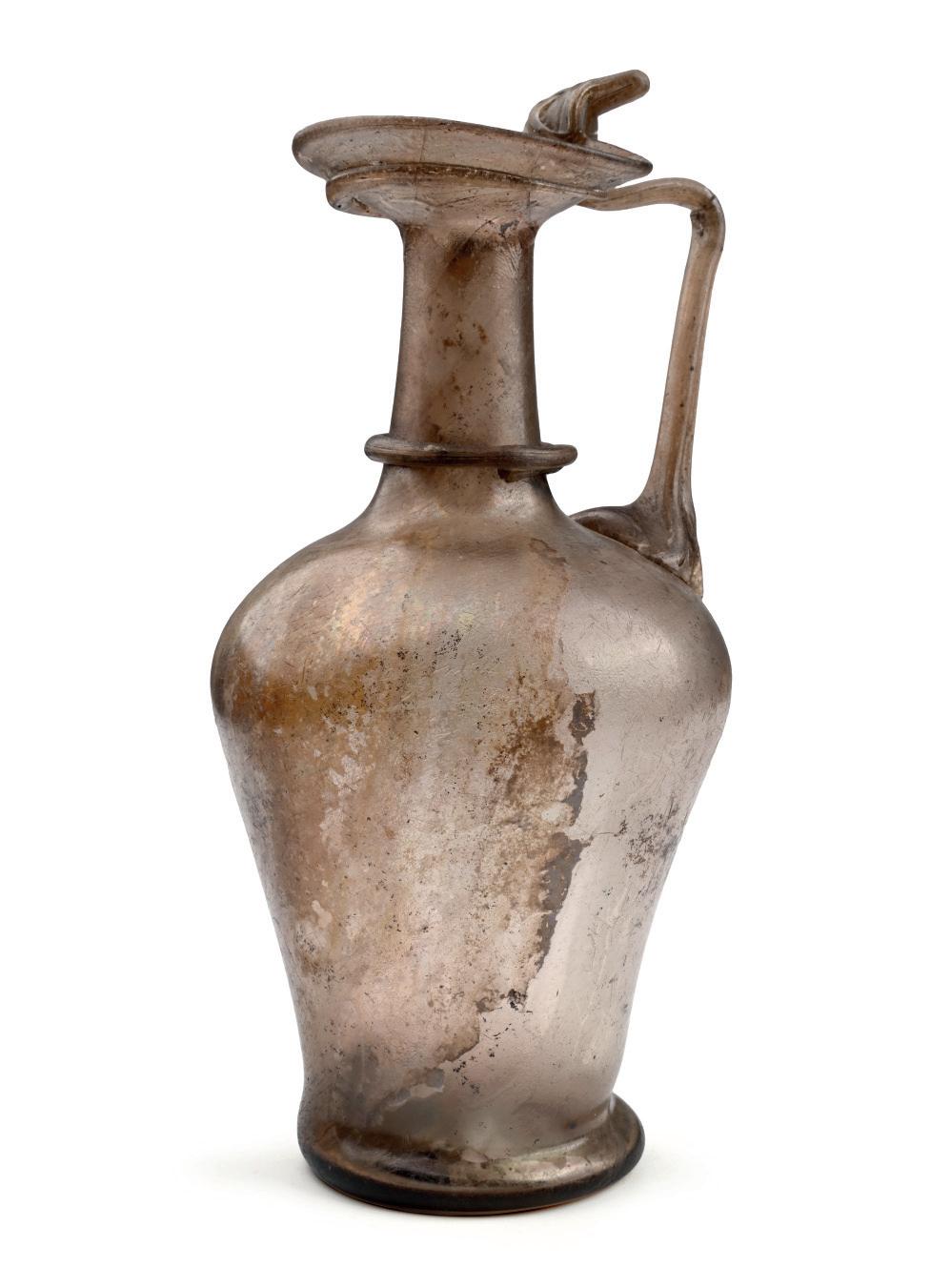

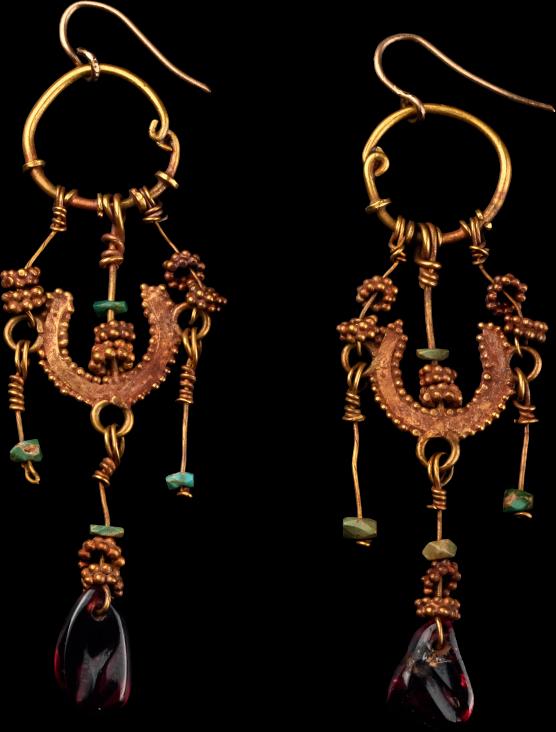

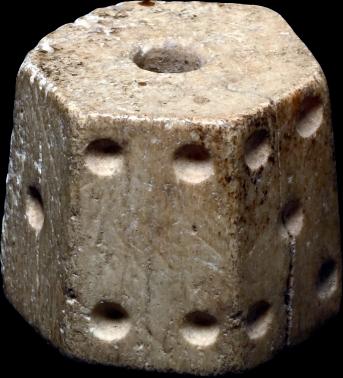
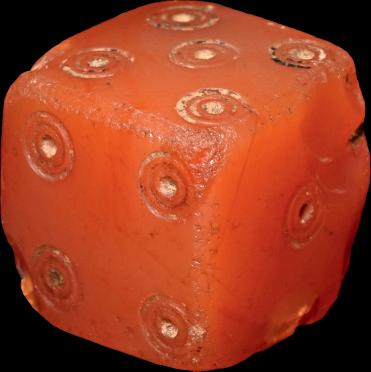
142
ROMAN GOLD ‘BUNCHED GRAPE’ JEWELLERY SET
1ST CENTURY A.D.
1 - 1¼ in. (8.83 grams total, 24-32 mm)
Group of three gold pendants comprising: two formed as a cluster of granules with three lobes, larger granule to each apex and coiled wire suspension; one of similar profile, larger with filigree lines and coils to both faces, trumpet-shaped finial with loop; two repaired; housed in a custom-made display case.
£4,500 - 5,500
PROVENANCE:
Acquired in the late 1980s-early 1990s.
Private collection, London, UK.
FOOTNOTES:
Typologically related earrings were particularly common in the Caucasus, where they have been dated by archaeologists to the first centuries A.D. This was mainly a product of Hellenised workers of the area of Pontus or Asia Minor, and the material culture of the Greek cities of the North Pontus region was completely absorbed by their new Roman rulers and largely diffused in style and orientation in the Eastern Roman provinces.
143
ROMAN GOLD EARRING PAIR WITH GEMSTONE DROPS ‡
2ND-3RD CENTURY A.D.
2 in. (9.32 grams total, 60-62 mm)
Matched pair, each a hoop and suspension hook; a crescent plaque supported by filigree wires with granulated collars, lateral dangles with turquoise seed beads and median longer dangle with granulated collars and gemstone finial. [2]
£2,000 - 3,000
PROVENANCE: Acquired in 1995.
Private collection, thence by descent.
Private collection, since the late 1990s.
144
ROMAN GOLD PIN ‡
1ST-3RD CENTURY A.D. 3 in. (4.77 grams, 80 mm)
Comprising a slightly dished discoid head and slender shank with baluster.
£1,000 - 1,400
PROVENANCE: Acquired in the 1992.
Private collection, Switzerland, thence by descent.
Private collection, since the late 1990s.
145
ROMAN HEXAGONAL BONE GAMING DICE ‡
1ST-4TH CENTURY A.D.
½ in. (2.6 grams, 14 mm)
Hexagonal in plan and pierced centrally, shallow spots disposed 1:6, 2:5, 3:4; old collector’s label ‘Clermont’ and inked number ‘1258’.
£400 - 600
PROVENANCE: Louis-Gabriel Bellon (1819–1899), Paris.
Anonymous sale, France, 2009.
Private European collection, acquired at the above sale.
146
ROMAN CARNELIAN GAMING DICE ‡
2ND CENTURY A.D. in. (9.15 grams, 16 mm)
Cuboid with incised ring-and-dot motifs disposed 1:6, 2:5, 3:4.
£1,000 - 1,400
PROVENANCE:
Private collection of Contessa L.J., since the 1980s.
Private collection, acquired in 2001.
147
GRAECO-ROMAN GOLD RING WITH GARNETS AND EMERALDS
1ST CENTURY A.D.
¾ in. (7.27 grams, 23.17 mm overall, 16.94 mm internal diameter
(approximate size British K, USA 5¼, Europe 9.95, Japan 9))
Comprising a tapering hoop formed with convergent bands filled with scrolls, granule at the junction to the reverse; beaded wire frame to the square bezel with central panel and teardrop-cell to each corner; inset cabochon to each corner cell, later green cabochon to centre; shoulder repaired in antiquity with gold strap.
£5,000 - 7,000
PROVENANCE: with Gorny & Mosch, Auction 119, 16 October 2002, no.3072. Private collection, London.
148

ROMAN GOLD RING WITH NICOLO MERCURY GEMSTONE
2ND-3RD CENTURY A.D.
in. (6.44 grams, 22.32 mm overall, 18.37 mm internal diameter (approximate size British M, USA 6, Europe 12.46, Japan 12))
D-section hoop with flared bezel, set with blue nicolo intaglio bearing a profile bust of a young male wearing a hat, possibly god Mercury.
£2,000 - 3,000
PROVENANCE:
UK private collection before 2000. Acquired on the UK art market. Private collection, London, UK.
149

ROMAN GOLD RING WITH GRYLLUS GEMSTONE ‡
1ST-4TH CENTURY A.D.
1¼ in. (6.68 grams, 30.11 mm overall, 20.51 mm internal diameter (approximate size British P, USA 7½, Europe 16.23, Japan 15))
Hollow-formed ring with inset jasper cloison, intaglio janiform human heads in profile with bird’s head above and legs below; supplied with a museum-quality impression.
£2,500 - 3,500
PROVENANCE: Acquired in 1993.
Private collection, thence by descent. Private collection, since the late 1990s.
150
ROMAN GOLD RING WITH GARNETS ‡
2ND-3RD CENTURY A.D. in. (1.38 grams, 17.03 mm overall, 14.85 mm internal diameter (approximate size British G½, USA 3½, Europe 5.55, Japan 5))
Comprising two parallel hoops connected with angled filigree struts with a granule to each node, annulets to the shoulders, irregular circular cells each set with a cabochon garnet; hoop cracked at underside.
£800 - 1,000
PROVENANCE: Acquired in the 1992.
Private collection, Switzerland, thence by descent. Private collection, since the late 1990s.
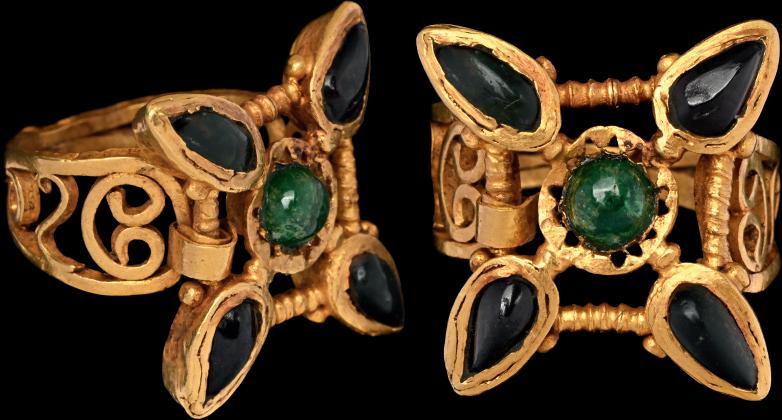



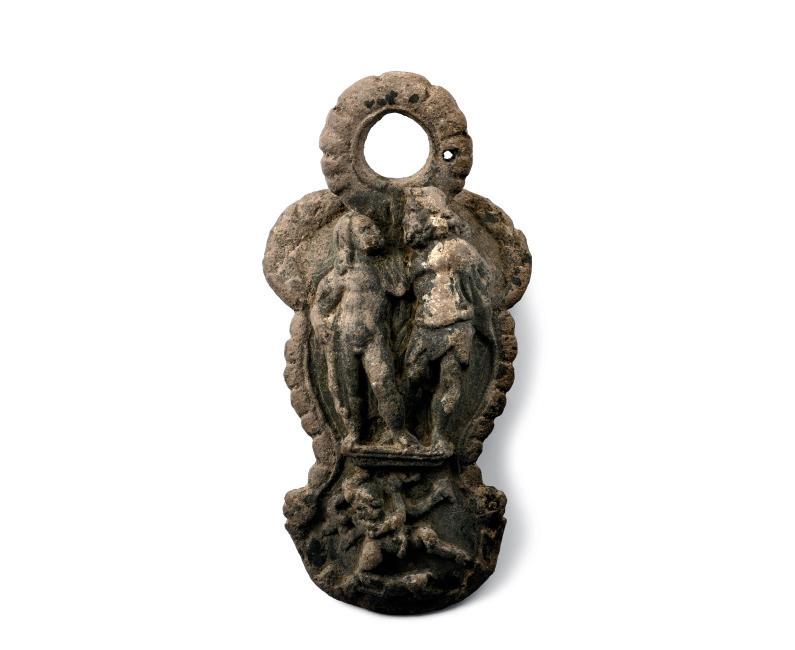
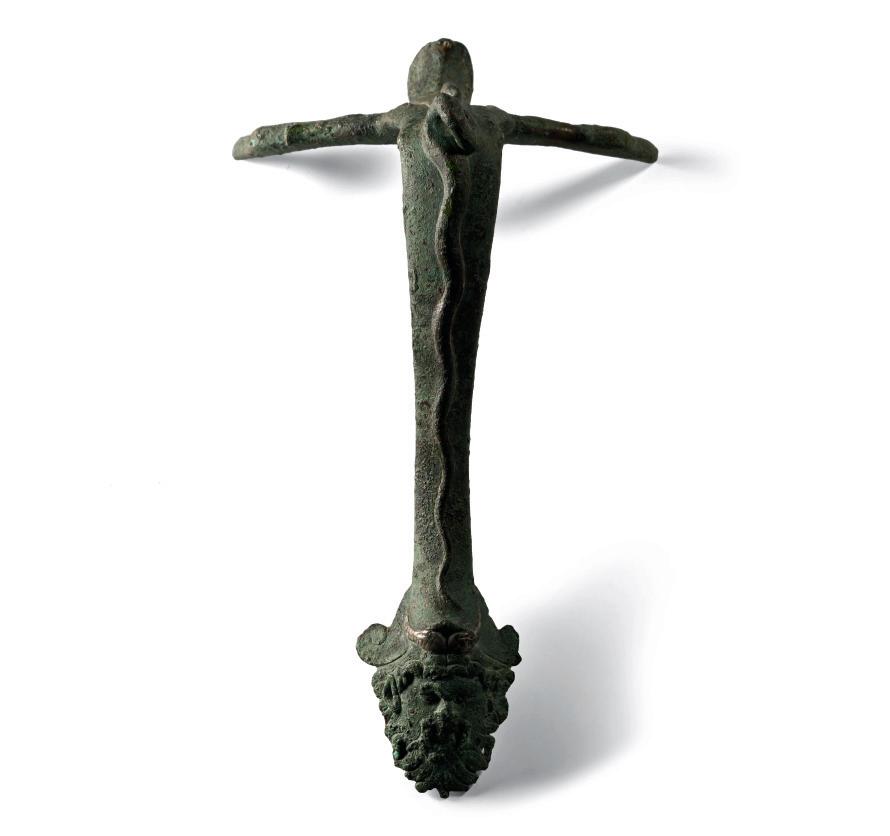
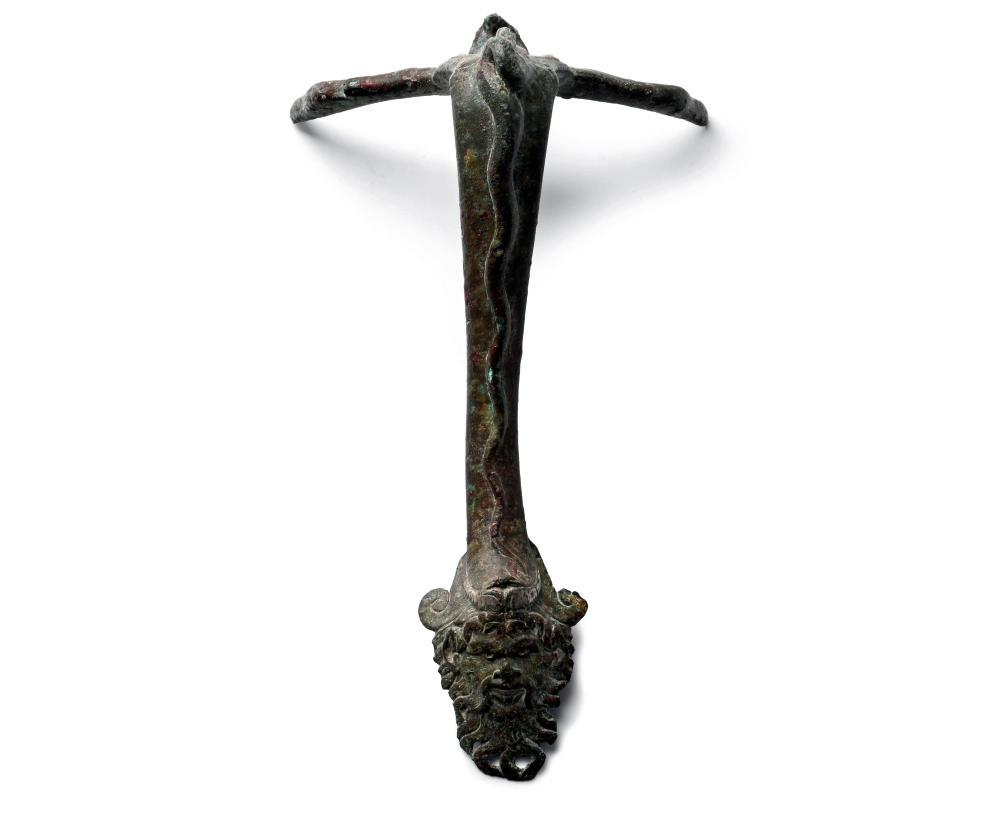
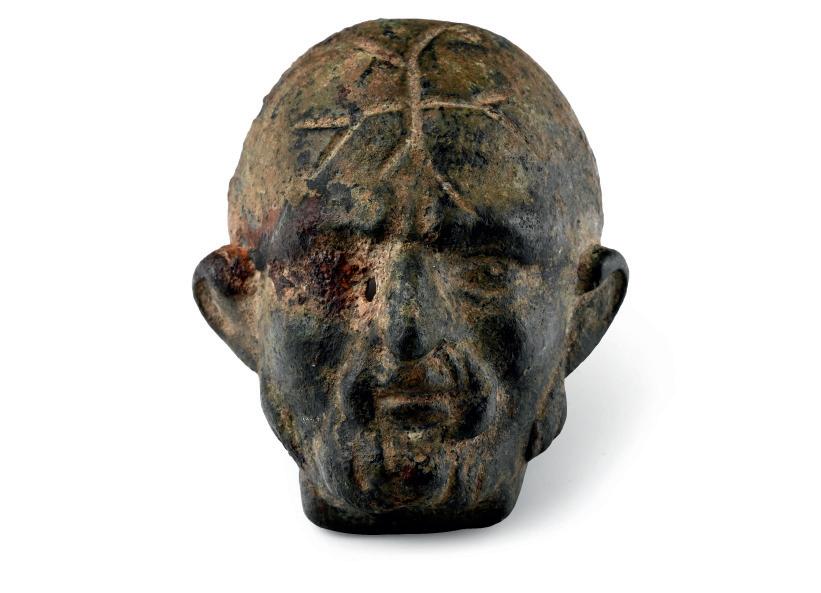
151
ROMAN BRONZE THREE-DIMENSIONAL VESSEL MOUNT ‡ 2ND-3RD CENTURY A.D.
5 in. (286 grams, 13.8 cm)
Comprising a plaque of three conjoined lobes with segmented border; at the top, a loop with segmented rim; vignette with a nude male with shoulder-length hair embracing a taller bearded figure with kilt and mantle to left shoulder (Hercules?); below, a satyr with horns and goat’s legs beset by hunting dogs.
£3,000 - 4,000
PROVENANCE:
Acquired in 1992.
Private collection, thence by descent.
Private collection, since the late 1990s.
152
ROMAN BRONZE VESSEL HANDLE WITH FACE ‡ 1ST CENTURY A.D.
5 in. (110 grams, 14.2 cm)
Swept in profile comprising a horizontal crescentic panel to attach to the rim, with inlaid silver detailing, recurved cobra-shaped thumb pad, raised serpent to the outer face of the tapering handle, finial a mask of Bacchus or Pan, facing with volute scrolls to the brow and thick splayed beard; silver diadem and eyes.
£1,200 - 1,700
PROVENANCE:
Private collection.
with Christie’s, London, 11 June 1997, no.97. (part) with Bonhams, 13 April 2000, no.198.
Private collection, Europe.
Accompanied by copies of the relevant Christie’s and Bonhams catalogue pages.
153
ROMAN BRONZE VESSEL HANDLE WITH FACE ‡ 1ST CENTURY A.D.
5 in. (118 grams, 14.4 cm)
Swept in profile comprising a horizontal crescentic panel to attach to the rim, with inlaid silver detailing, recurved cobra-shaped thumb pad, raised serpent to the outer face of the tapering handle, finial a mask of Bacchus or Pan, facing with volute scrolls to the brow and thick splayed beard; silver diadem.
£1,200 - 1,700
PROVENANCE:
Private collection. with Christie’s, London, 11 June 1997, no.97. (part) with Bonhams, 13 April 2000, no.198. Private collection, Europe.
154
ROMAN BRONZE ‘MONEY’ BOX WITH CROSS ‡ 4TH CENTURY A.D. OR LATER
2 in. (89 grams, 54 mm)
Hollow-formed model male head with aperture to underside; with short beard and incised cross fourchee to the brow.
£3,000 - 4,000
PROVENANCE: German private collection, 1980s. with Artemis Gallery, 1990s. Private collection, acquired in 1999.
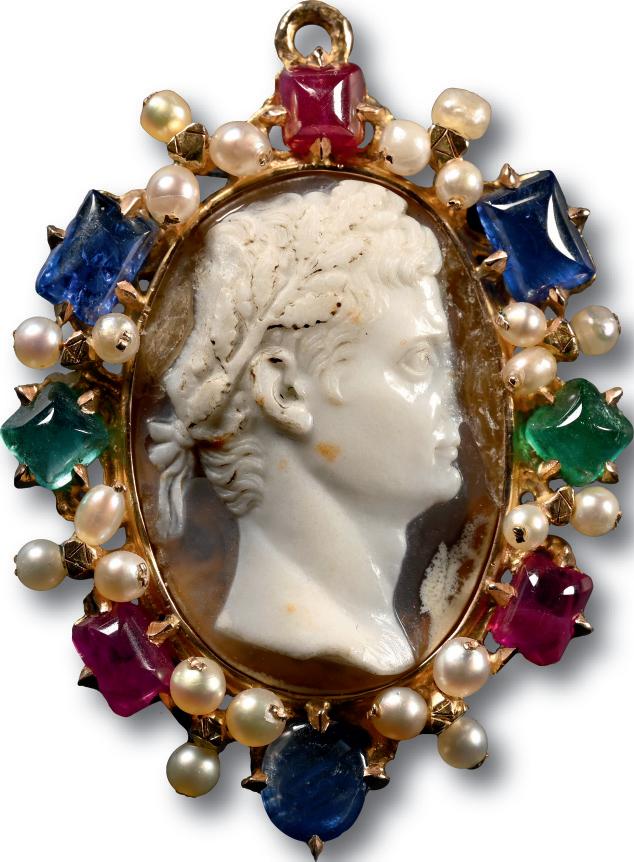

155

ROMAN AGATE CAMEO OF AUGUSTUS ‡ 1ST CENTURY A.D.
3 in. (99 grams total, 92 mm including stand, pendant: 50 mm)
Ellipsoid cameo with profile portrait bust in antique gold pendant frame with surrounding cabochons: emerald, sapphire, ruby - and clusters of pearls; marked to reverse ‘750’, in a rectangle ‘Bd G’ (believed to be an upstate New York jeweller’s stamp) and an indeterminate third mark; supplied with a custom-made display stand.
£25,000 - 35,000

156
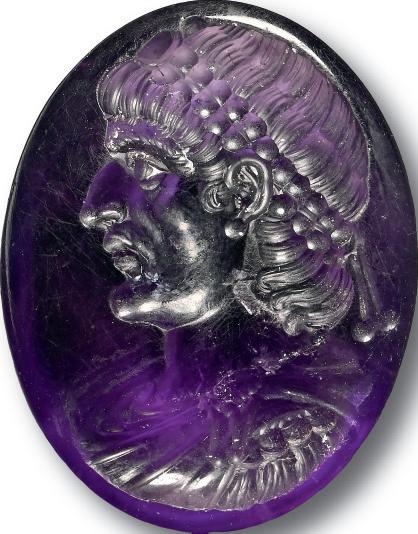
AMETHYST GEMSTONE WITH PORTRAIT OF CONSTANTINE THE GREAT ROMAN, 4TH CENTURY A.D. OR LATER
1 in. (5.36 grams, 26 mm)
With intaglio profile bust of Constantine with pteruges and cloak clasped at the shoulder; supplied with a museum-quality impression.
£4,000 - 6,000
PROVENANCE: Acquired in the late 1970s. Property of a London, UK, private collector. From an old London, UK, collection.
PROVENANCE:
American collection, early 20th century, New York. with Robert Haber Gallery, New York, 1990. Ex Jean Clostre, Geneva, Switzerland.
Accompanied by a scholarly report by Dr Ittai Gradel.
FOOTNOTES:
Dr Ittai Gradel says: ‘The cameo, of exquisite technical quality, has a close parallel in the Cabinet des médailles, Paris .. The TimeLine auction cameo is not, however, an exact copy .. though details are so close to the larger Paris cameo that the same gem carver, or at least workshop, probably produced both.’
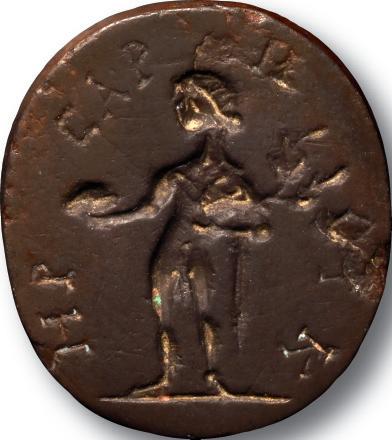

157
LATE ROMAN GNOSTIC HEMATITE GEMSTONE WITH STANDING FIGURE ‡
3RD CENTURY A.D.
¾ in. (3 grams, 20 mm)
Discoid with chamfered edge, standing youth on a baseline with patera in one hand, sword at his hip, enigmatic legend above ‘HICAPH[.]K’; supplied with a museumquality impression.
£1,500 - 2,000
PROVENANCE: Acquired in 1994.
Private collection, thence by descent. Private collection, since the late 1990s.
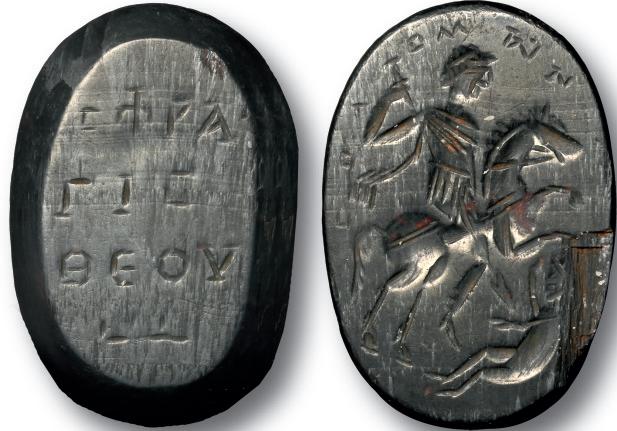

158
LATE ROMAN HEMATITE GNOSTIC GEMSTONE ‡
3RD CENTURY A.D.
1 in. (6 grams, 27 mm)
Ellipsoid bifacial cloison with chamfered edge; obverse - horseman with spear pointing at a fallen enemy with legend ‘ Ω ’; reverse - retrograde legend ‘ C [..]’; supplied with a museumquality impression.
£2,000 - 3,000
PROVENANCE: Acquired in 1994.
Private collection, thence by descent. Private collection, since the late 1990s.
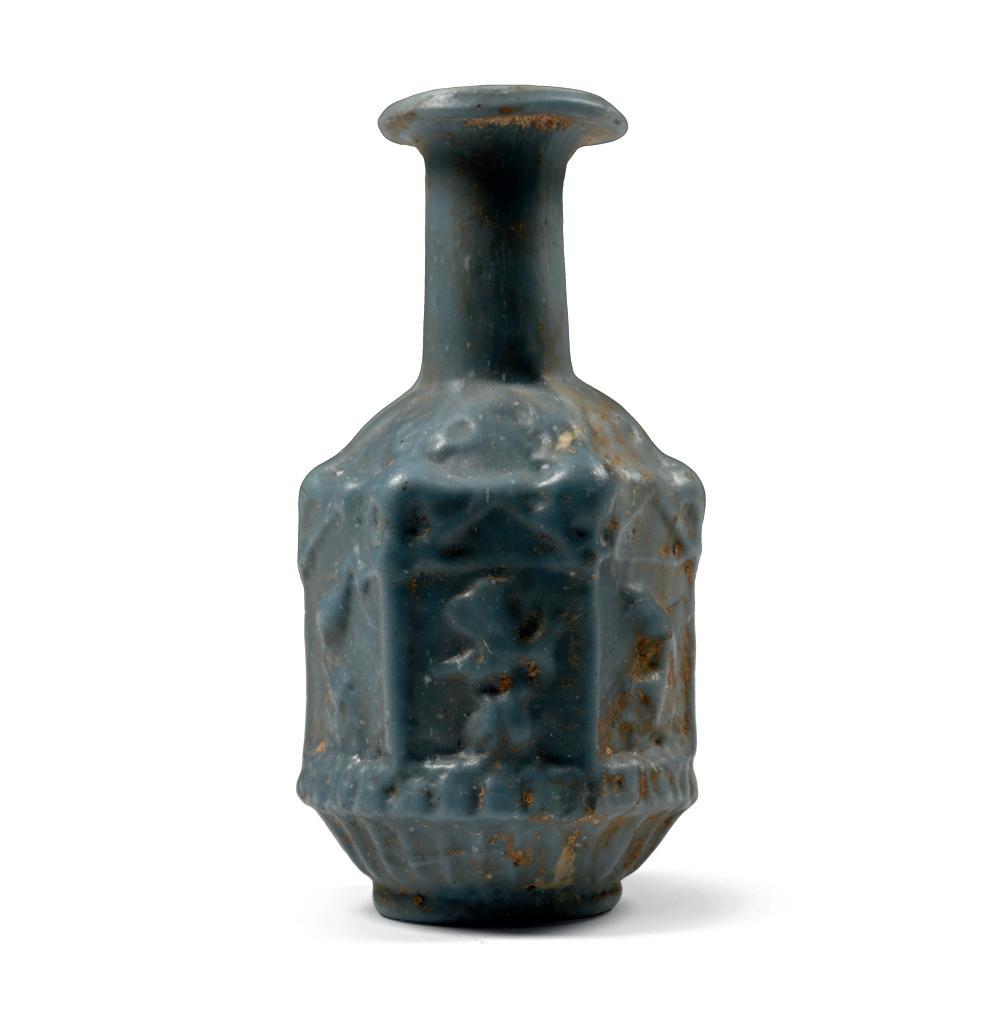
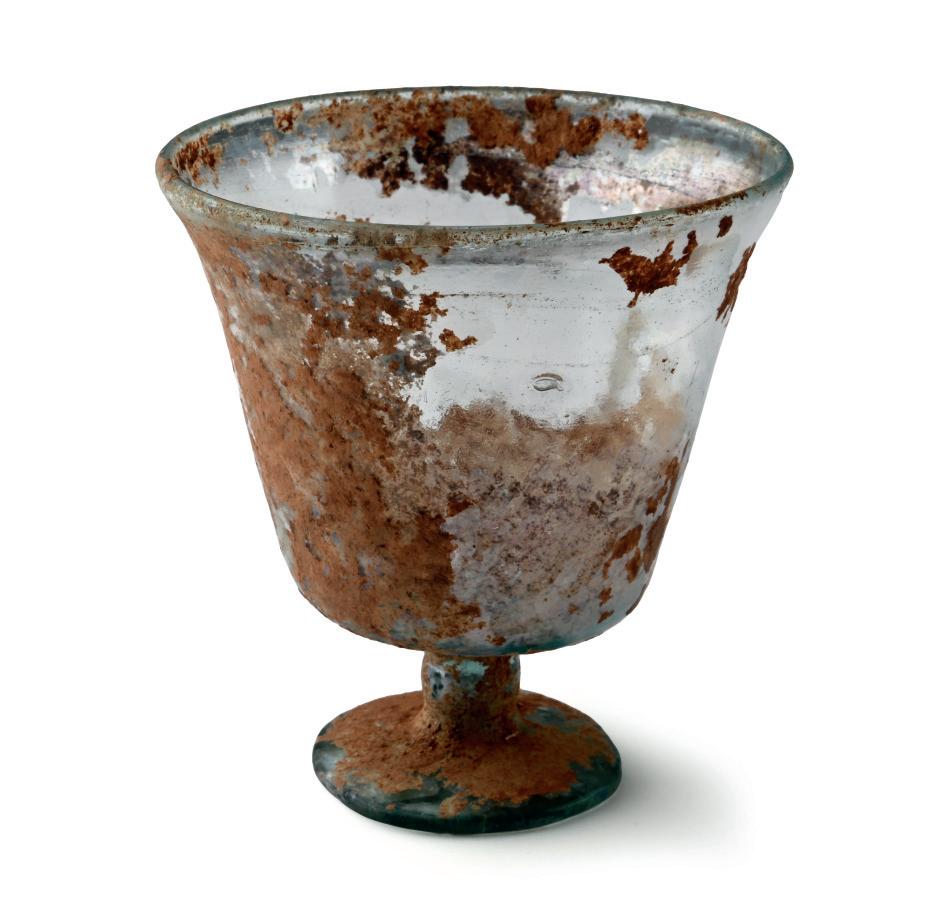

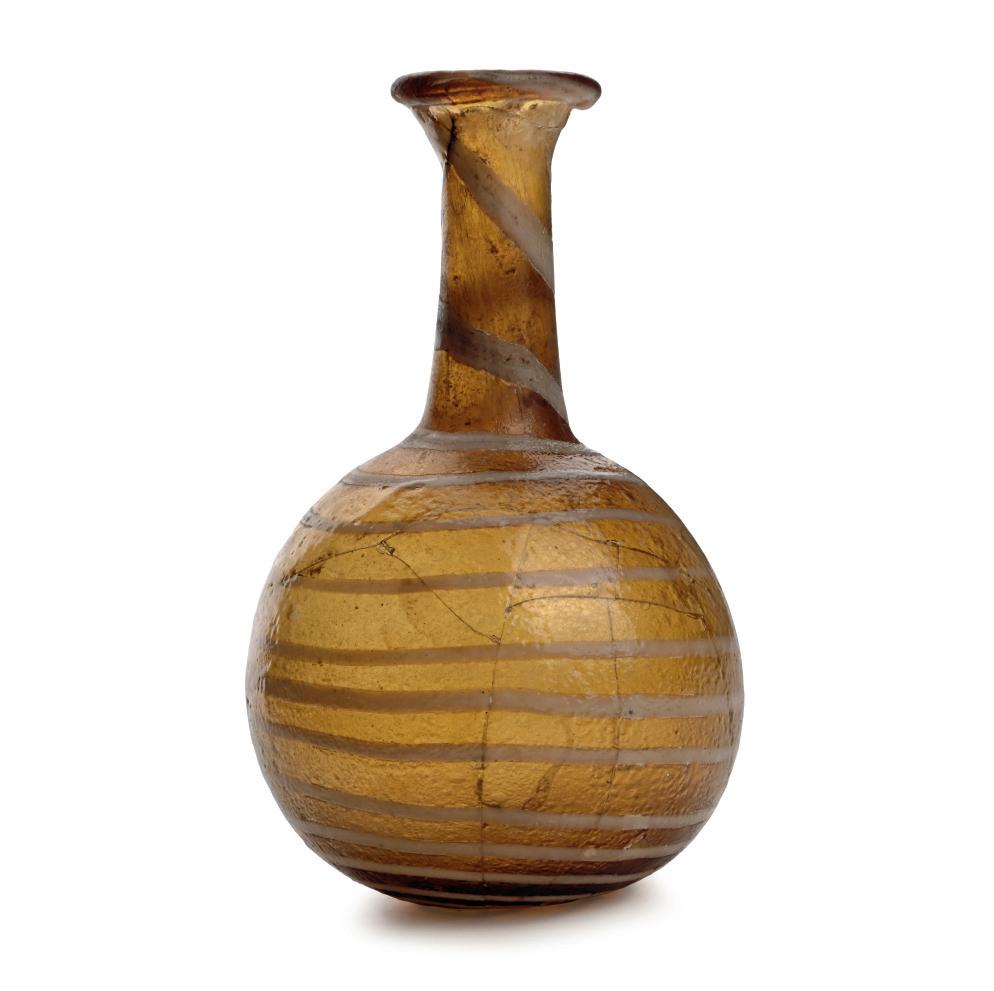
159

ROMAN SIDONIAN OPAQUE LIGHT BLUE GLASS FLASK ‡
1ST CENTURY A.D.
3 in. (31 grams, 80 mm)
Hexagonal in plan with tall tubular neck and flared and folded rim, disc base with moulding seams; broad sloping shoulder above a sidewall of panels each with a low-relief avian image (bird in flight, bird perching on a branch, etc.).
£3,000 - 4,000
PROVENANCE:
Ex private collection, Israel. Acquired from Archaeological Center, Auction 60, no.204.
160
ROMAN HONEY-COLOURED FLASK WITH WHITE TRAIL
1ST CENTURY B.C.-1ST CENTURY A.D.
4¾ in. (65 grams, 12 cm)
With globular body, tall tubular neck with everted rolled rim, applied helical white glass trail from rim to base.
£500 - 170
PROVENANCE: Mayfair, London, UK, gallery, 2000s. Ex Surrey, UK, gentleman.
161
ROMAN GLASS WINE CUP
1ST CENTURY A.D.
3½ in. (15 grams, 90 mm)
Aqua glass cup with squat bell-shaped sidewall, rounded neck, footed base.
£600 - 800
PROVENANCE:
Ex Mayfair, London, UK, gallery, 1990s-2000s.
From an important collection of glass, the property of a London gentleman.
162
ROMAN GLASS TWO-HANDLED JAR
1ST-4TH CENTURY A.D.
4¾ in. (132 grams, 12.2 cm high)
Comprising a bulbous body with dimple base, bell-shaped neck with rolled rim, two applied strap handles.
£500 - 700
PROVENANCE:
Ex Mayfair, London, UK, gallery, 1990s-2000s.
From an important collection of glass, the property of a London gentleman.

163
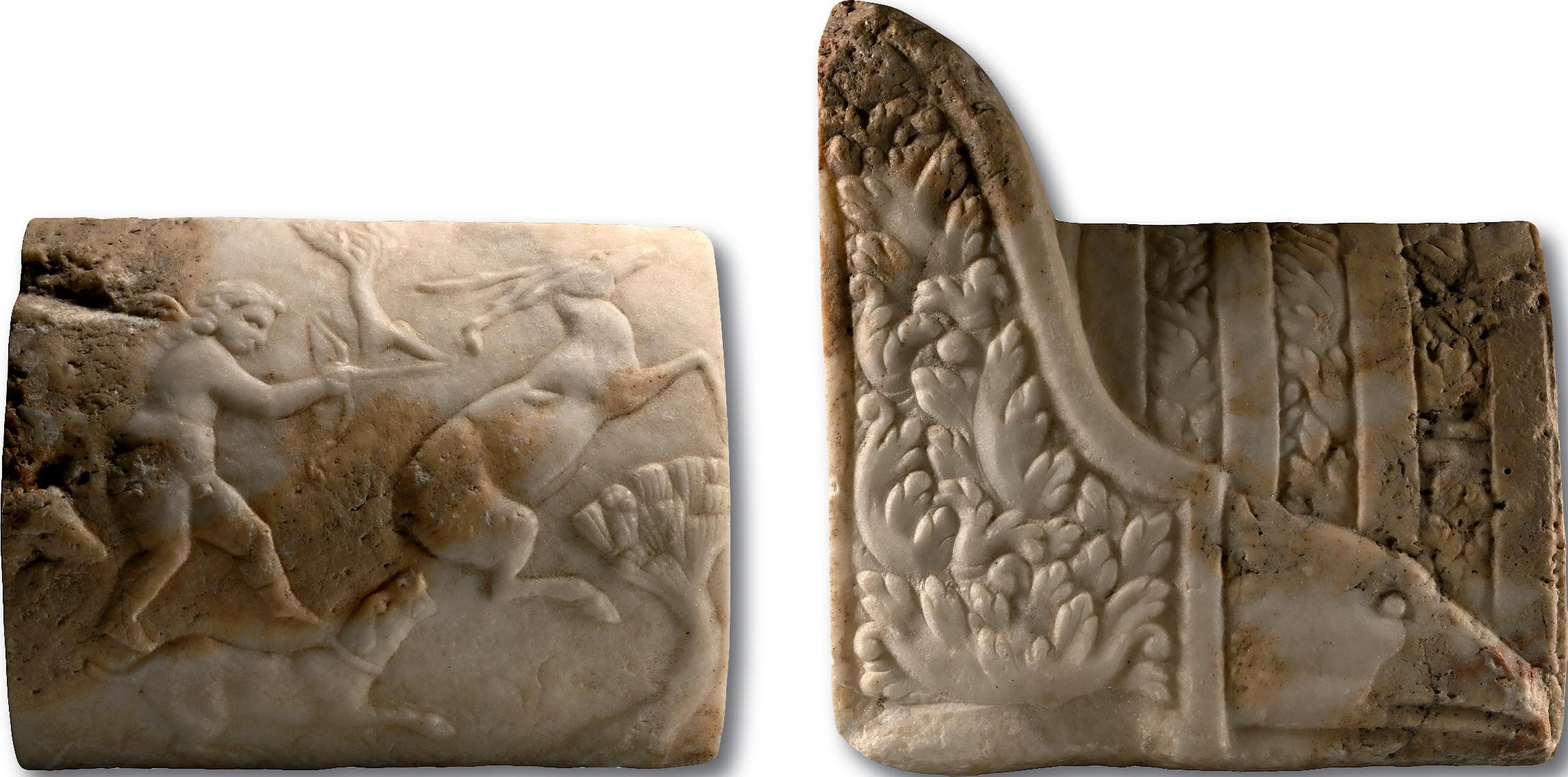
EASTERN ROMAN MARBLE FRAGMENTS FROM A SARCOPHAGUS
3RD-4TH CENTURY A.D.
8½ - 11¾ in. (36.8 kg total, 21.6-30 cm including stand)
Two rectangular fragments from a sarcophagus in classical style, comprising: an element serving as a corner, with the left part raised and decorated inside with floral and vegetal ornaments, enclosed within a border, on the base a griffin’s head in low-relief; the body decorated with vertical streaks alternating with vegetal elements; a second element consisting of a slightly convex body, with a sculpted decoration in low-relief depicting a putto armed with a bow and his dog hunting a rearing deer; vegetal elements in the background. [2]
£7,000 - 9,000
PROVENANCE: with Hermann Historica, Munchen, 19 October 2005, no.197.
Private collection, UK.
FOOTNOTES:
Many sarcophagi from Roman times depict hunting scenes. As a rule, the main figure among the hunters is on the sarcophagus itself, riding a horse; other hunters may also be on horseback. Non-standard types could have been chosen for the depiction of the hunt, like erotes hunting animals. The popularity of scenes depicting figures such as playful erotes and mythological couples lasted until the early 4th century, eventually waning in favour of scenes that displayed the aristocrat’s wealth and property.
164
LIFE-SIZE ROMAN MARBLE HEAD
2ND -3RD CENTURY A.D.
11¾ in. (21.8 kg, 30 cm)
Carved in the round with full beard and head of curly hair, deep-set eyes and small mouth, possibly the philosopher Aristotle.
£3,000 - 4,000
PROVENANCE:
Acquired between the 1970s and 1980s.
From the private collection of John Watson, Cambridge, UK.
165
ROMAN MARBLE FACE FRAGMENT ‡
1st century A.D.
6 in. (1.21 kg, 15.5 cm)
Plano-convex in section with exaggerated puffy cheeks and small pursed mouth; possibly from a putto in a figural frieze.
£1,500 - 2,000
PROVENANCE: Acquired in the 1992.
Private collection, Switzerland, thence by descent. Private collection, since the late 1990s.
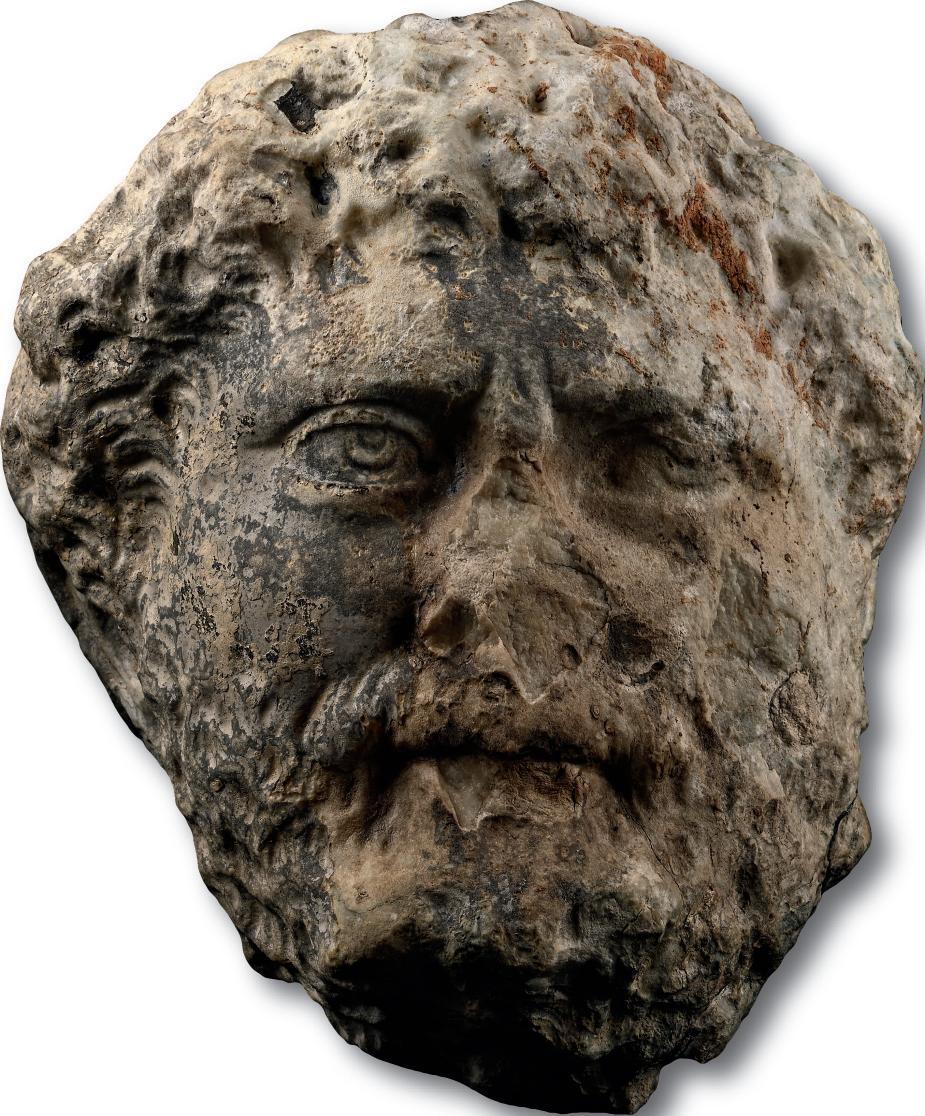

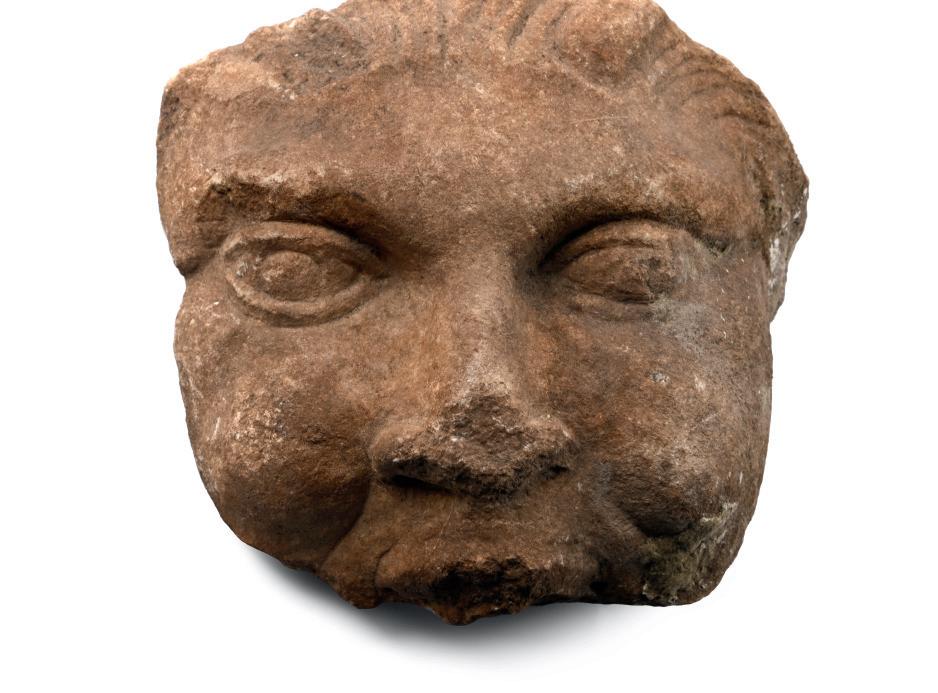



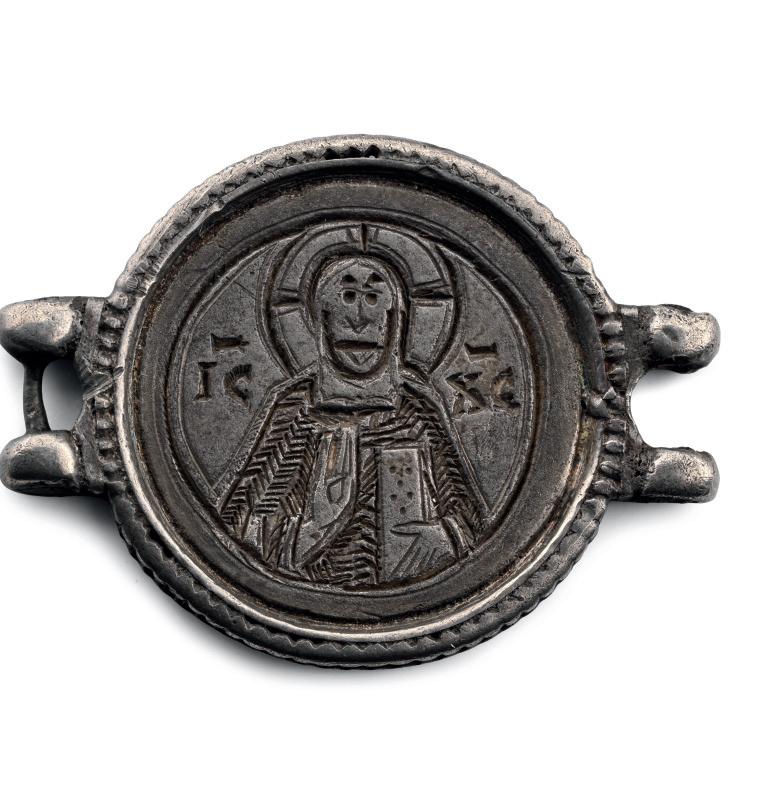

166
BYZANTINE SILVER-GILT PLAQUE WITH SAINT GREGORY 11TH-12TH CENTURY A.D.
3 in. (13.76 grams, 74 mm)
Rectangular with repoussé parcel-gilt nimbate figure in draped robe and holding a book in both hands, flanked by legend ‘A / ’ (Hagios Gregorios, Saint Gregory). [No Reserve]
£2,000 - 3,000
PROVENANCE:
Ex Rupert Wace, 2010. Ex central London gallery.
167
BYZANTINE ROCK CRYSTAL STAMP SEAL IN SILVER PENDANT WITH MILITARY SAINT ON HORSEBACK
CIRCA 6TH-7TH CENTURY A.D.
1¼ in. (7.9 grams, 30 mm)
With a tapering octagonal body, the military saint on horseback holding a long spear, the horse wearing a detailed harness; set in a conical silver frame with suspension loop and crenellated edge.
£2,000 - 3,000
PROVENANCE:
From an old New Zealand private collection. Acquired on the New Zealand art market circa 2014. Property of a New Zealand legal professional.
FOOTNOTES:
The motif of a saint on horseback was common in the Romano-Christian culture of the 6th-7th centuries. The figure of a saint symbolised protection of the local church or monastery and its community, and could also be related to the priest leader of the community, as their personal seal.
168
BYZANTINE SILVER SWAN-NECKED LIGULA WITH CROSS ‡ 5TH-7TH CENTURY A.D.
9 in. (46 grams, 22.7 cm)
Shallow piriform bowl attached to a stepped baluster, hexagonalsection handle with spike finial; engraved cross potent to either side of the junction.
£1,500 - 2,000
PROVENANCE: French private collection. Acquired on the French art market in 2011. Acquired by the present owner at the above.
FOOTNOTES:
The lateral incised cross motifs suggest that the spoon may have had a liturgical purpose, possibly associated with baptism.
169
BYZANTINE SILVER MEDALLION WITH CHRIST & VIRGIN MARY CONSTANTINOPLE, CIRCA 10TH CENTURY A.D.
1 in. (8.5 grams, 35 mm)
Discoid bifacial panel in a braided frame with pairs of lateral lugs; obverse with facing nimbate figure of Christ holding a book, flanked by legend ‘IC XC’; reverse with Mary enthroned with flanking legend ‘MET / aeov’. [No Reserve]
£600 - 800
PROVENANCE:
Ex Antiquarium Ltd., New York, USA, 2005. Ex central London, UK, gallery.
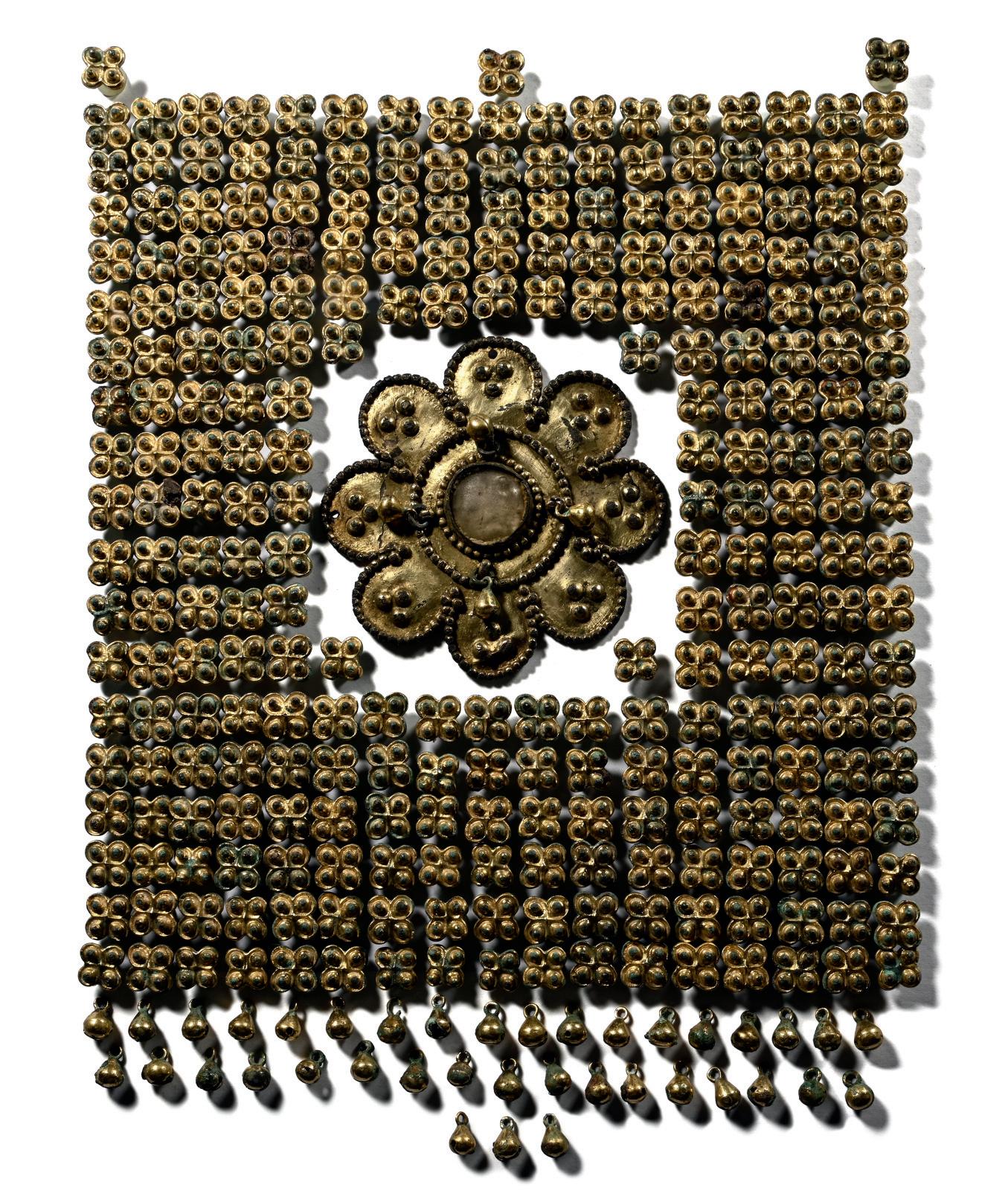
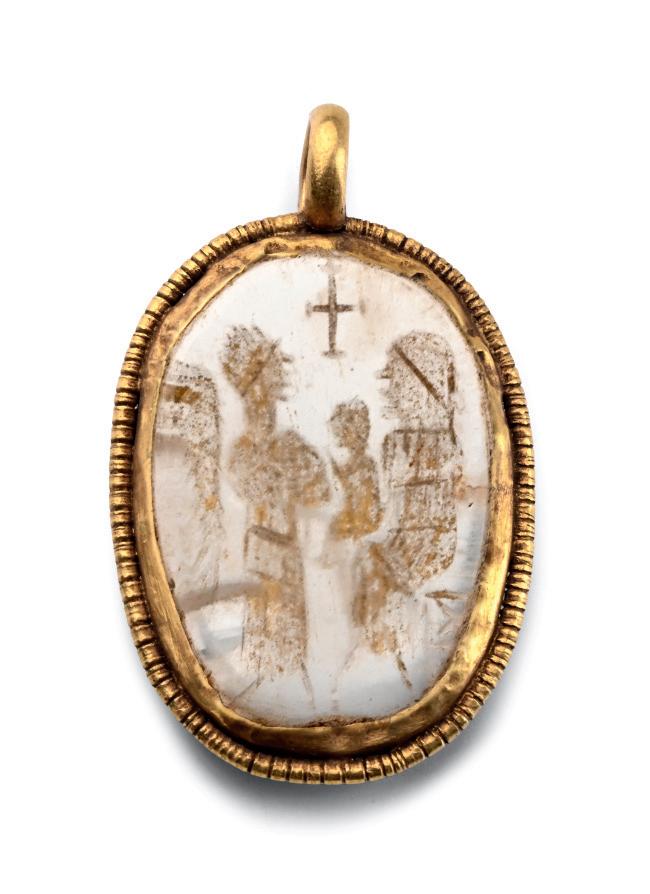

170
BYZANTINE GILT BRONZE HORSE HARNESS DECORATION SET
8TH-10TH CENTURY A.D.
- 3 in. (556 grams total, 11-92 mm)
Comprising: a large octofoil harness frontal plate with beaded rim and granulation; studs with quatrefoil plates; bell-shaped dangles.
£3,000 - 4,000
PROVENANCE:
From the private collection of a London gentleman, from his grandfather's collection formed before the early 1970s.
171
BYZANTINE GOLD AND ROCK CRYSTAL PENDANT WITH ADORATION SCENE
LATE 6TH CENTURY A.D.
1 in. (9.35 grams, 36 mm)
Ellipsoid intaglio with adoration scene comprising of seated Virgin holding an infant Christ on her lap, opposite a standing crowned figure holding a shield(?), cross to the upper centre of the scene; set in a golden frame with ribbed border and suspension loop to the top.
£3,000 - 4,000
PROVENANCE:
Ex an important collection of Christian artefacts, from a Surrey, UK, gentleman, 1980-1990s.
172
BYZANTINE ENGRAVED STONE PENDANT BEAD
6TH-8TH CENTURY A.D.
1 in. (6.45 grams, 27 mm)
Piriform in profile and plano-convex in section with incised motif to each face: above - cross fourchee within a balustered arch; belowfacing nimbate bust of Christ with book in one hand and fingers in the gesture of blessing, ‘IC XC’ legend flanking; supplied with a museumquality impression.
£5,000 - 7,000
PROVENANCE: Acquired in London before 2000.
From the collection of a Mayfair, London, UK, gentleman.
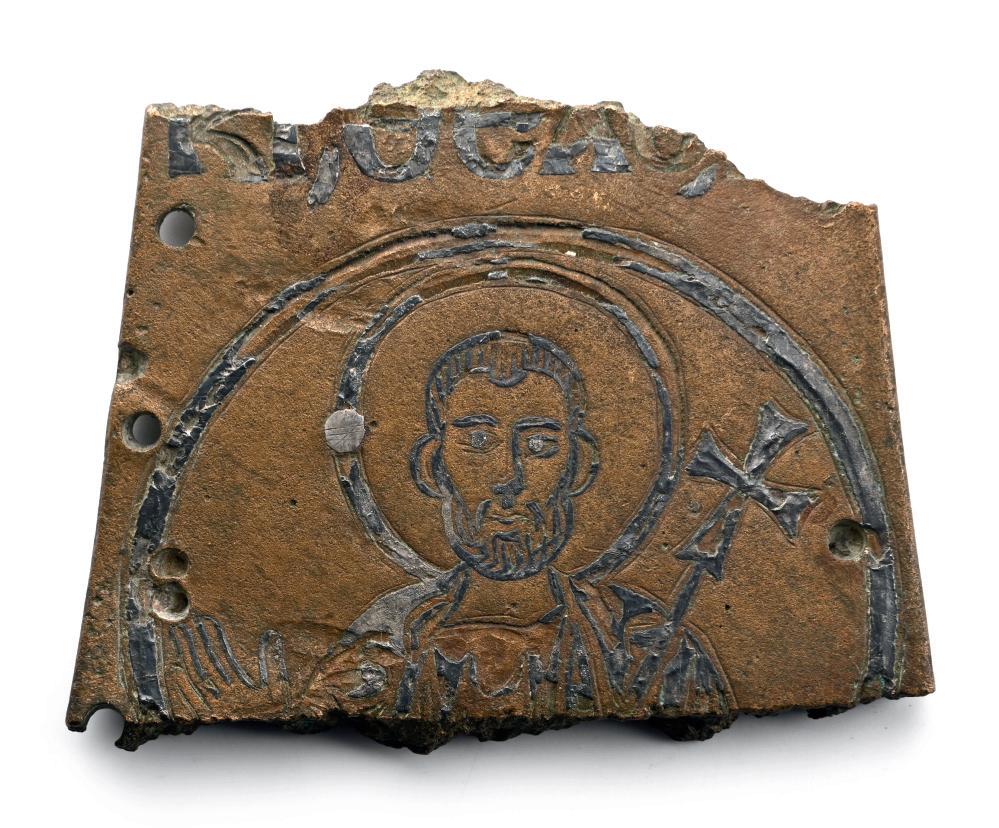
174
BYZANTINE BRONZE MEDALLION WITH THE VIRGIN AND CHILD
11TH-12TH CENTURY A.D.
1 in. (17.8 grams, 34 mm)
Square in plan with loop above; obverse with Mary Theotokos in a scrolled frame; reverse with cross pommee flanked by saltires and other signs. [No Reserve]
£600 - 800
PROVENANCE:
From Phoenix Ancient Art SA, New York, USA, 2004. Ex central London, UK, gallery.
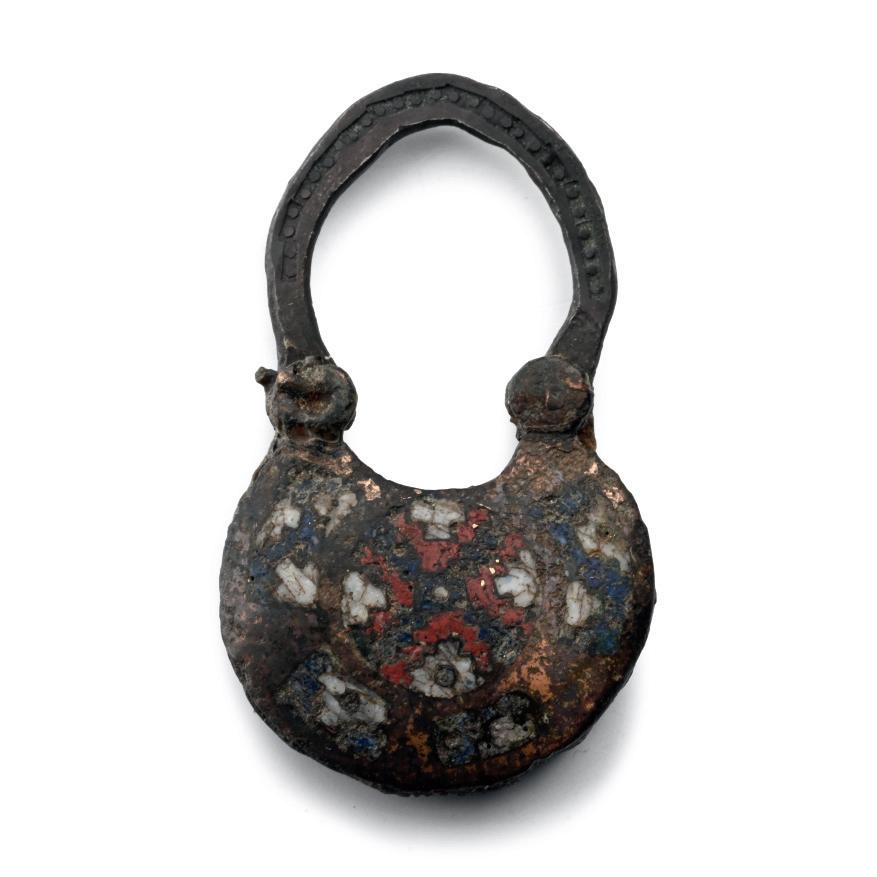
176
BYZANTINE BRONZE PUNCH WITH MENORAH AND HEBREW INSCRIPTION
CIRCA 5TH-6TH CENTURY A.D.
1¼ in. (18.8 grams, 31 mm)
Columnar stem with conical base extending to a square-section shank.
£1,000 - 1,400
PROVENANCE:
From the collection of a gentleman, acquired on the London art market in the 1990s.
173
BYZANTINE BRONZE PROCESSIONAL CROSS FRAGMENT WITH INLAID SILVER BUST
10TH CENTURY A.D.
2½ in. (121 grams, 64 mm)
Irregular fragment with attachment holes along both lateral edges; inlaid silver nimbate bust with processional cross to the left shoulder, inside an arched border; inlaid legend above, possibly Coptic script; perhaps used as a trade-weight. [No Reserve]
£600 - 800
PROVENANCE:
Ex Ariadne Galleries, New York, USA, 2009. Ex central London gallery.

175
BYZANTINE ENAMELLED BRONZE BIFACIAL TEMPLE RING 11TH-12TH CENTURY A.D.
1 in. (13 grams, 42 mm)
Crescentic with bifacial motif of saltire cross, panels of blue, red and yellow enamel; flat hoop with pelletted decoration; possibly Kievan Rus workmanship. [No Reserve]
£600 - 800
PROVENANCE:
From the private collection of a London gentleman, from his grandfather’s collection formed before the early 1970s.


177
BYZANTINE STONE CARVING OF SAINT PETER
6TH-7TH CENTURY A.D.
4 in. (4½ in.) (103 grams, 10.4 cm (132 grams total, 11.7 cm including stand))
Rectangular marble panel with half-round figure of standing Saint Peter between two columns, holding ring with three keys and scroll in one hand, inscription ‘ TPOC’ to the upper right corner; finely carved low-relief cross with wide arms to the reverse; repaired and mounted on a custom-made display stand.
£3,000 - 4,000
PROVENANCE:
with The Bactria Corp., NYC, USA, 1970s. Private collection, New York, USA. with Arte Primitivo, New York, USA, 17 March 2021, no.619 ($9,920.00). Private collection, London, UK.
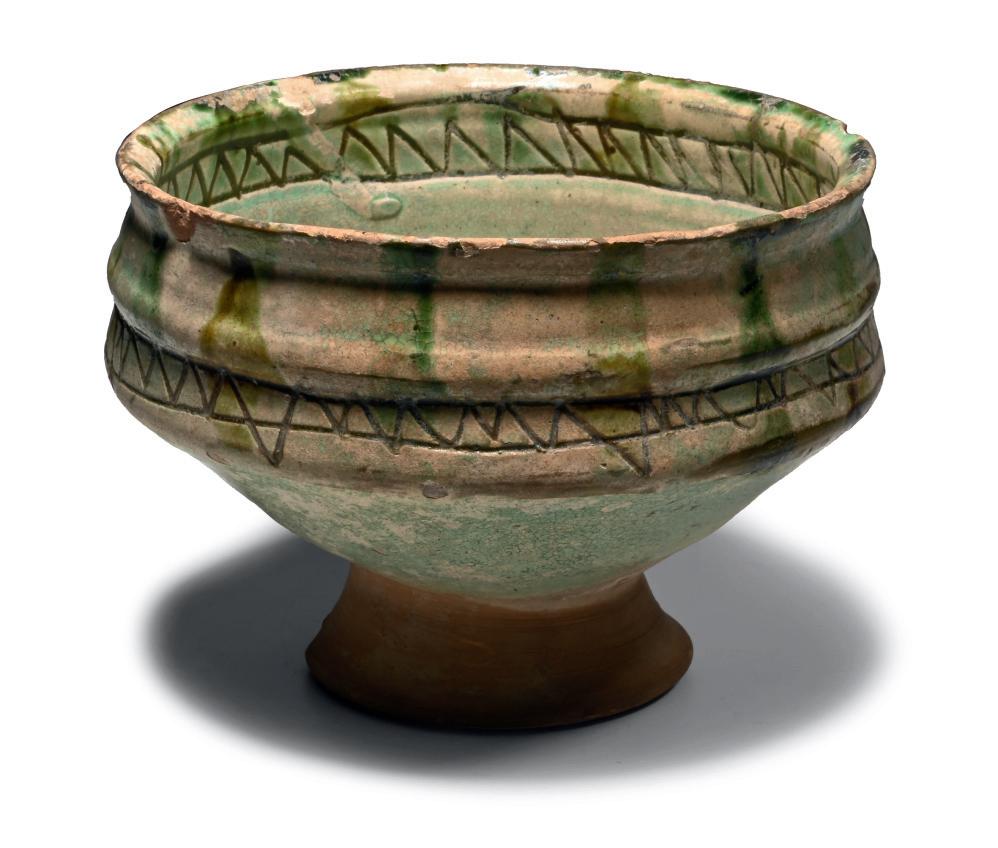
179
BYZANTINE GOLD RING WITH SAINT 12TH-14TH CENTURY A.D.
1 in. (8.20 grams, 26.24 mm overall, 21.65 mm internal diameter (approximate size British V½, USA 10¾, Europe 24.4, Japan 23))
A pair of granules to each shoulder flanking a discoid bezel with niellofilled facing bust of a nimbate saint.
£1,200 - 1,700
PROVENANCE:
Ex German art market, 2000s. Acquired from an EU collector living in London. From the collection of a Surrey, UK, gentleman.

UK private collection before 2000. Acquired on the UK art market. Private collection, London, UK. 177 178
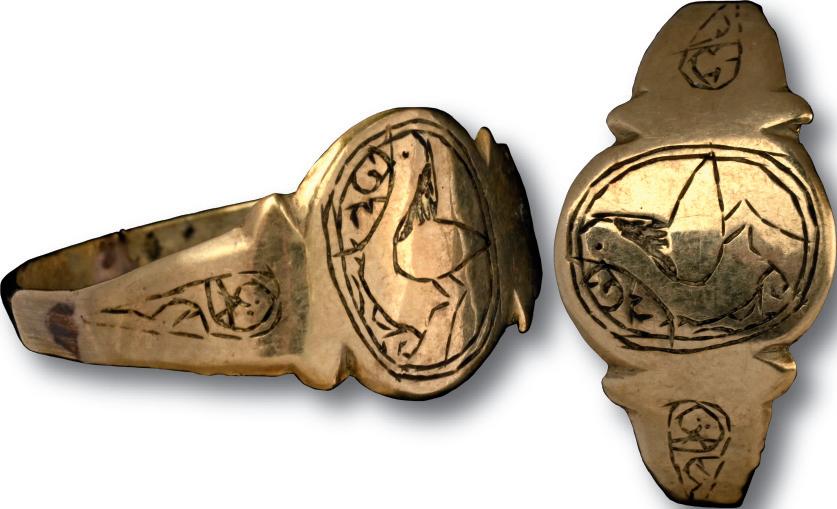
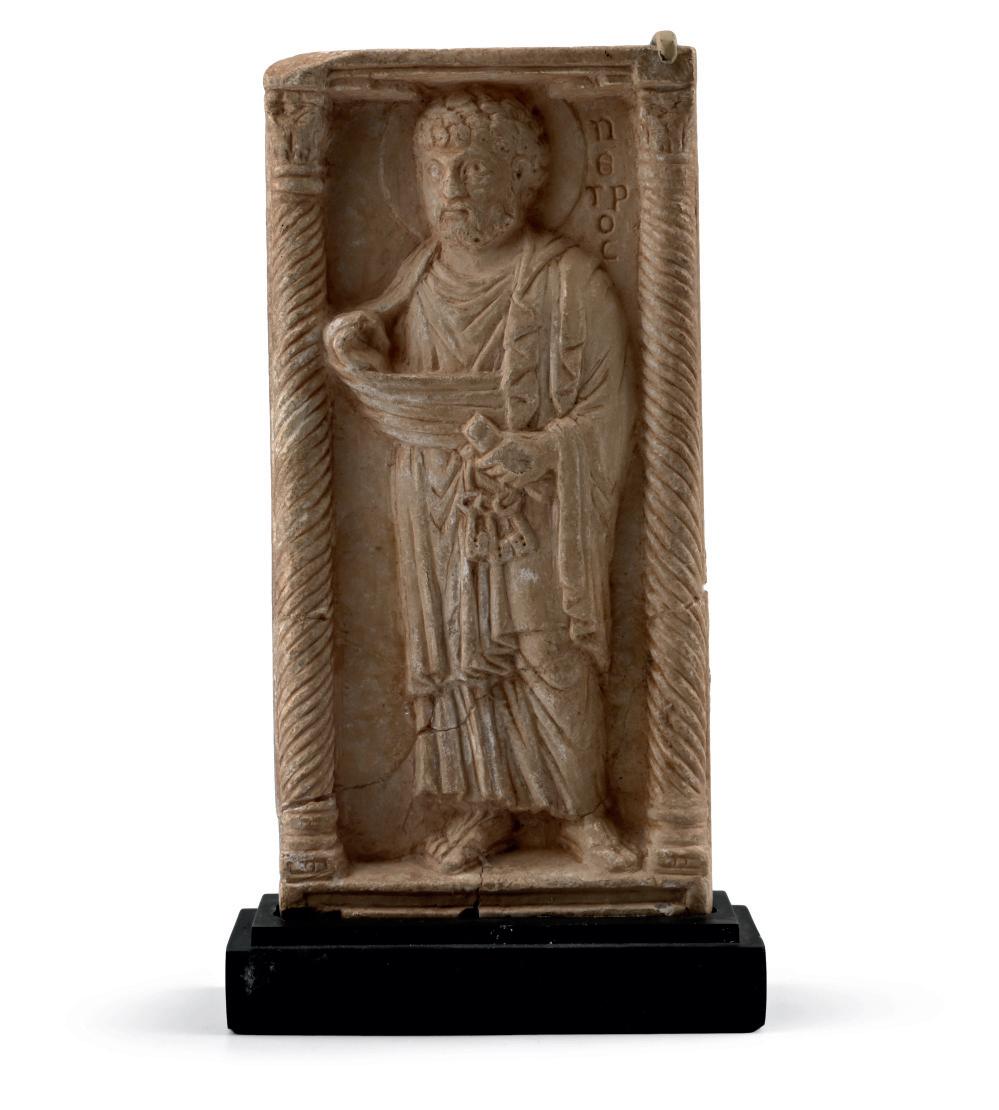
178
BYZANTINE GREEN GLAZED SGRAFFITO FOOTED BOWL ‡ 13TH CENTURY A.D.
5 in. (372 grams, 13 cm)
Carinated in profile with narrow flared base, green-glazed upper body; to the inner face a central roundel with zigzag fill and a zigzag band above the gallery, to the outer face horizontal zigzag band to the shoulder; old Christie’s label with ‘144/2 5540’.
£700 - 900
PROVENANCE:
Ex Charles Gillot (1853-1903). with Christie’s, Paris, 2008. European private collection.


180
EASTERN BYZANTINE GOLD RING WITH DOVE 6TH-8TH CENTURY A.D.
¾ in. (1.28 grams, 18.38 mm overall, 17.20 mm internal diameter (approximate size British N, USA 6½, Europe 13.72, Japan 13))
Narrow tapering hoop with discoid bezel, engraved scroll to each shoulder, reserved dove image to the bezel; ancient repair.
£600 - 800
PROVENANCE:

181
GIGANTIC WESTERN ASIATIC POTTERY JAR
CIRCA 3000 B.C.
24 in. (14.85 kg, 62 cm high)
Cylindrical in plan and bullet-shaped in profile, sidewall decorated in dark brown with dense hatched filet below the rim and broad band of D-shaped voids and other detailing.
£3,000 - 4,000
PROVENANCE: With Mahboubian Gallery, London, UK, 1974.
182
GIGANTIC WESTERN ASIATIC POTTERY JAR
CIRCA 3000 B.C.
21 in. (11.9 kg, 53 cm high)
Barrel-shaped in profile with low rim to the mouth; painted dentilled band to the shoulder with eight panels below alternating plain and hatched; similar pattern to the sidewall, the plain panels with swallowtail motif.
£3,000 - 4,000
PROVENANCE: with Mahboubian Gallery, London, 1974.

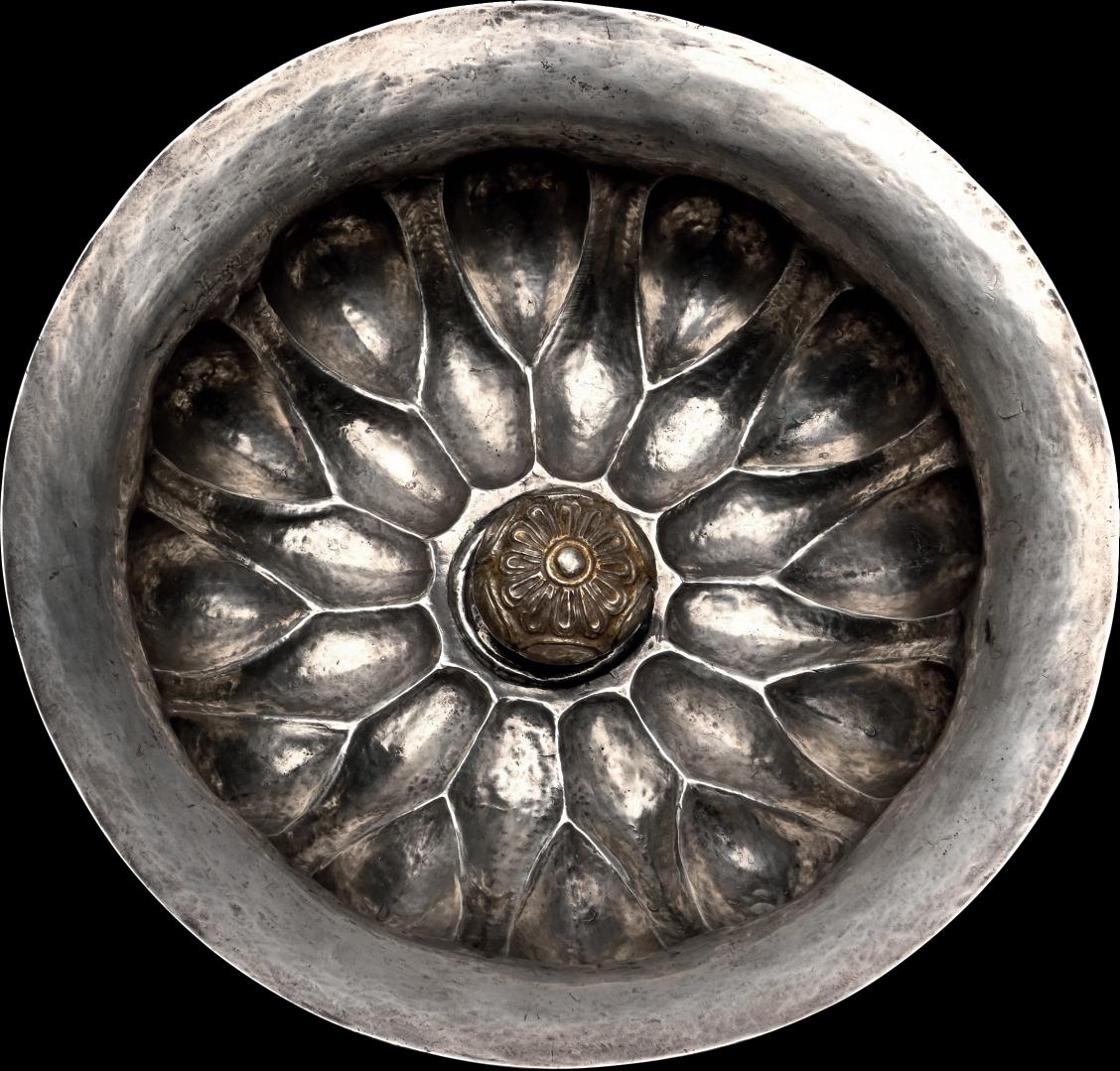
183
NEO-ELAMITE SILVER REPOUSSÉ FINIAL PAIR
6TH CENTURY B.C.
2 in. (184 grams total, 49-51 mm)
Each bell-shaped in profile with broad socket; underside with savage beast in profile, coiled to fit the tondo, with high-relief claws and head. [2]
£6,000 - 8,000
PROVENANCE:
Private collection of a London gentleman, acquired between 1965-2020.
FOOTNOTES:
These intricate lion head appliqués offer a glimpse into the ancient artistry and symbolism of Khuzistan (Susiana). They are embodying the cultural reverence for lions as symbols of power and protection. These omphaloi could have been used as furniture decoration or on top of a religious staff or sceptre. The lion heads are common in Neo-Elamite art. The heads of our lions find good parallels with a gold bracelet with lion-head terminals from the Jubaji tomb (Wicks, pl.8).
184

ACHAEMENID SILVER PHIALE WITH CENTRAL ROSETTE
5TH CENTURY B.C.
8 in. (283 grams, 20.7 cm wide)
Squat lotiform bowl with wide everted rim, central domed mesomphalos with rosette detailing, traces of gilding.
£5,000 - 7,000
PROVENANCE: English private collection, formed 1940s. Private collection, UK.
185

ELAMITE SILVER STAFF TERMINAL WITH INTERLACED DRAGONS
1ST MILLENNIUM B.C.
7 in. (45 grams total, 20 cm including stand)
Hollow-formed with bulb finial, low-relief image of opposed dragons with detailed scale texture; circumferential band with incised guilloche below; mounted on a custom-made stand.
£1,500 - 2,000
PROVENANCE: London, UK gallery, 1971-early 2000s.

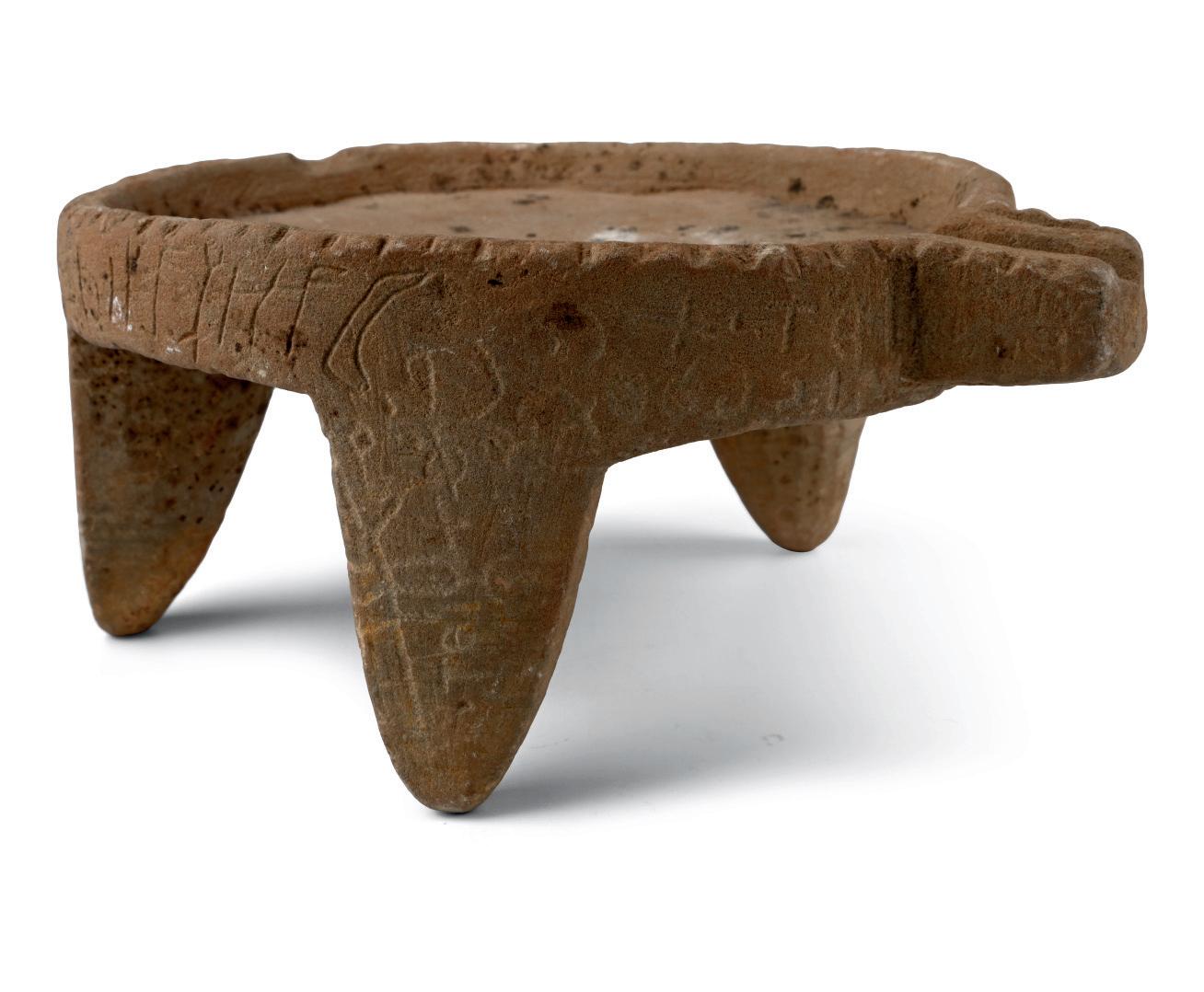
187
SOUTH ARABIAN ALABASTER BOWL WITH DECORATIONS
5TH-3RD CENTURY B.C.
5 in. (217 grams, 12.9 cm)
Shallow in profile with chamfered rim, concentric circles to inner face with arcading in two tiers; marine encrustation to exterior.
£800 - 1,000
PROVENANCE:
UK private collection before 2000.
Acquired on the UK art market.
Private collection, London, UK.
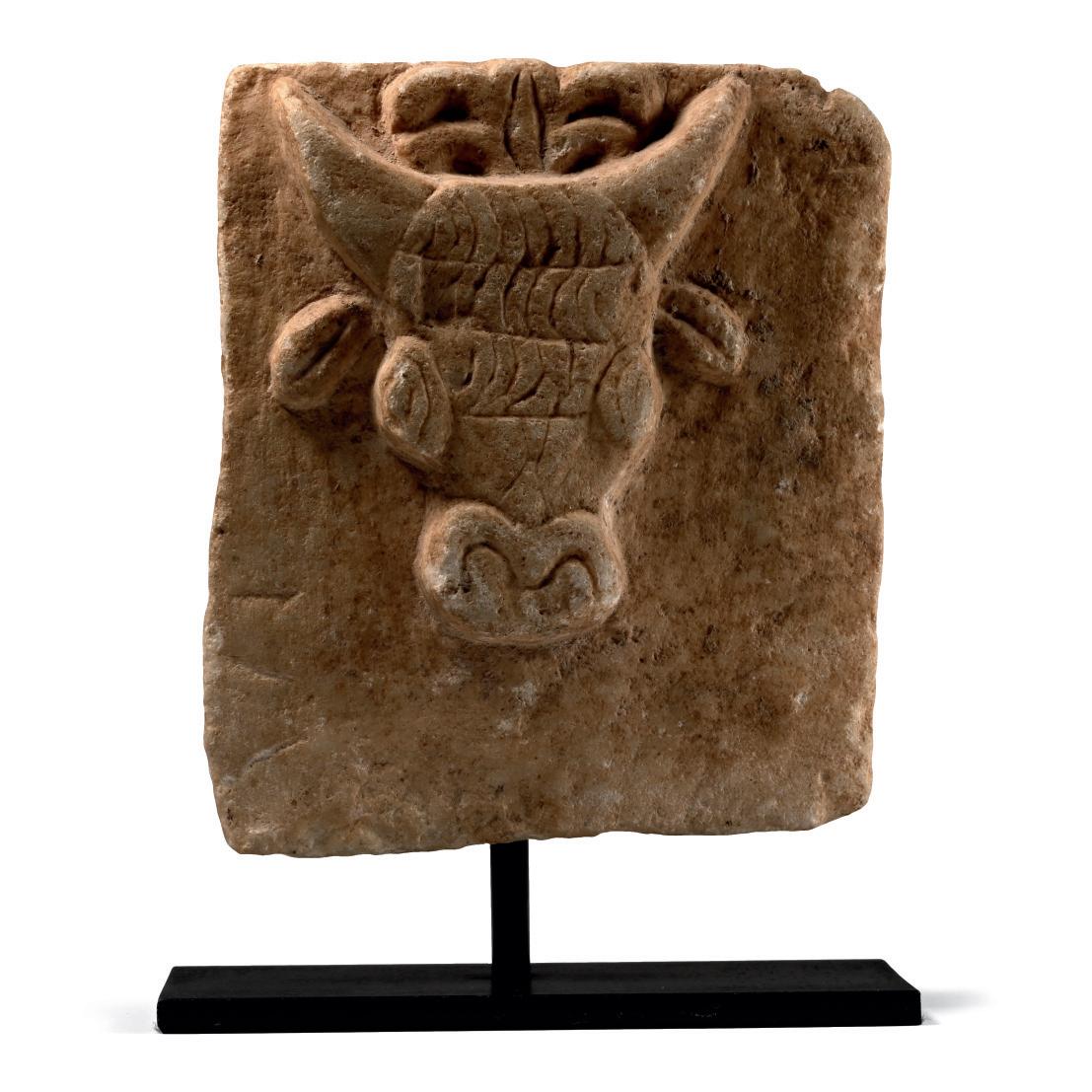
186
SOUTH ARABIAN OFFERING TABLE WITH INSCRIPTION
6TH CENTURY B.C.
8¼ in. (1.47 kg, 21 cm)
With three D-section stub legs and channel with pouring lip; incised Phoenician or proto-Hebrew inscription, in reverse, to the notched rim.
£2,000 - 3,000
PROVENANCE:
Private collection, Canada, acquired by descent from the collection of the present owner’s father, formed 1965-1990.
Acquired from the above by the current owner, 2020.
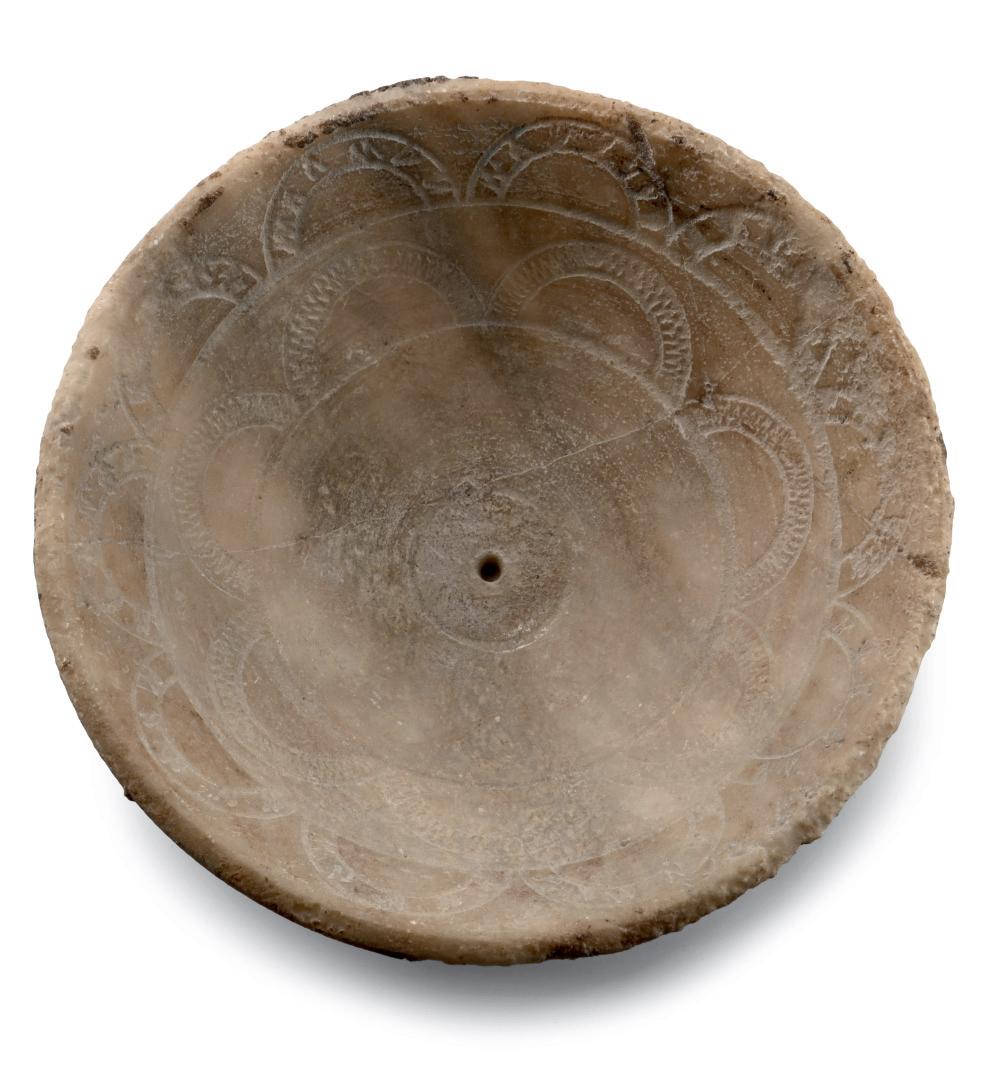
188
SOUTH ARABIAN ALABASTER PLAQUE WITH BULL’S HEAD
3RD-1ST CENTURY B.C.
7¾ in. (2.18 kg total, 19.7 cm including stand)
Comprising a square panel with a bull’s head in low-relief, striated eyes and flaring nostrils, a thick tuft of hair arranged between the eyes, acanthus leaf between curved horns; mounted on a custommade display stand.
£500 - 700
PROVENANCE:
UK collection, 1990s.
Acquired on the UK art market, before 2000.
Private collection, Mr M.V., a London-based businessman.
FOOTNOTES:
Along with the ibex, the bull is one of the most frequently represented animals in the sculpture found in the Arabian cemeteries, like Timna.
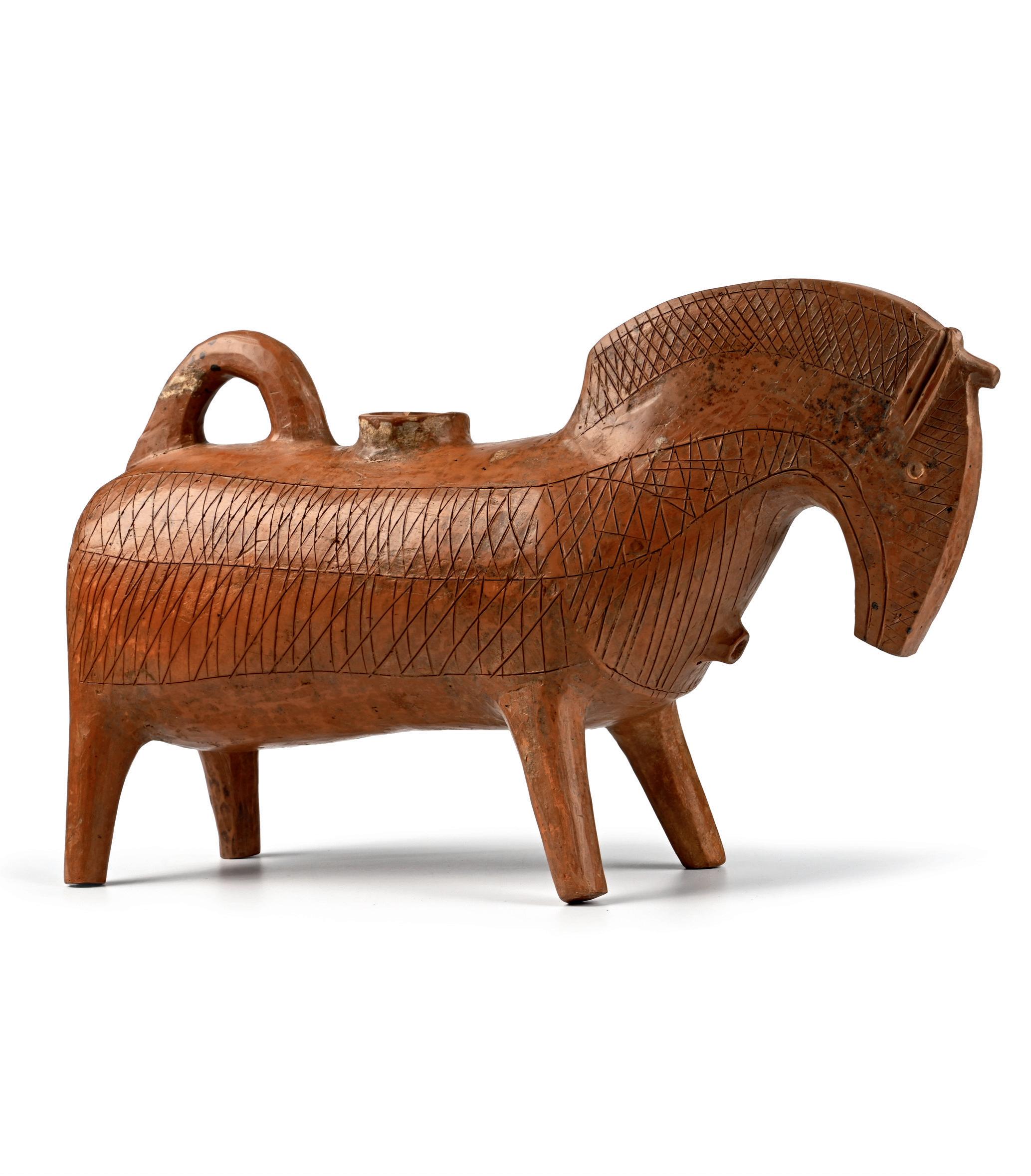

Hollow-formed rhyton with four splayed legs, curved neck with tall mane, loop handle forming the tail; filler hole to middle of back, spout to the chest; incised hatched bands to the mane and flanks. £8,000 - 10,000
PROVENANCE: Sakae Art Gallery, Nagoya, Japan, 1982. with Aaron Gallery, acquired from the above.
Accompanied by thermoluminescence analysis report no.N121q65 by Oxford Authentication.
LITERATURE:
Cf. for a Parthian Pottery Horse Vessel of similar typology, Christie’s, Antiquities, 1st October 2015, catalogue, London, 2015, no.50 p.35.
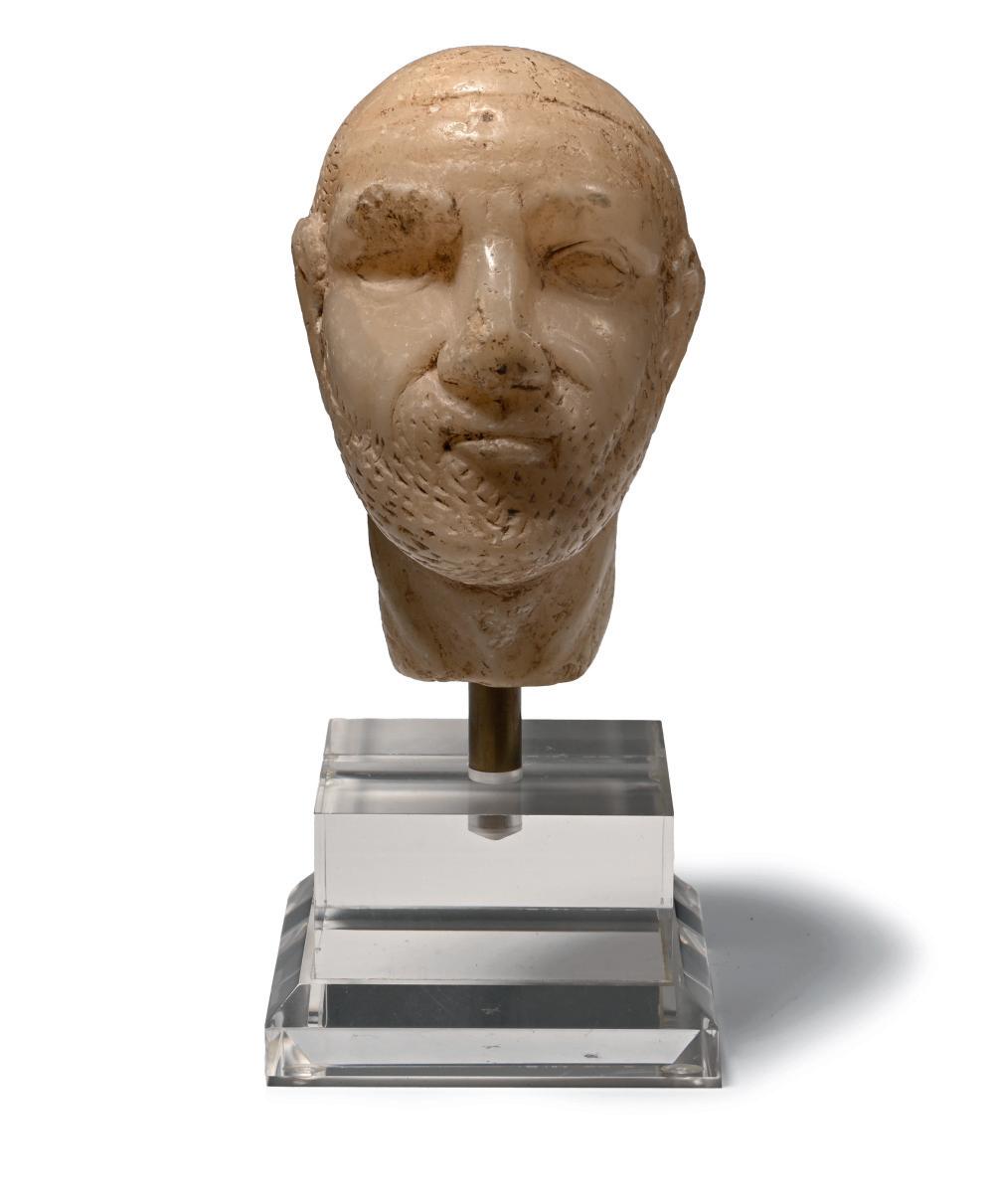
191
SOUTH ARABIAN ALABASTER SCULPTURE OF A MAN WITH INSCRIPTION
3RD-1ST CENTURY B.C.
10 in. (3.62 kg total, 27.1 cm including stand)
On a rectangular background, shallow sockets and grooved eyebrows, elongated nose and face, mouth faintly indicated by a straight incised line, large, protruding ears; traces of beard under the chin, vertical lines representing hair; name engraved in Arabian letters beneath the chin; mounted on a custom-made display stand.
£800 - 1,000
PROVENANCE:
UK collection, 1990s.
Acquired on the UK art market, before 2000.
Private collection, Mr M.V., a London-based businessman.

190

SOUTH ARABIAN ALABASTER MALE HEAD ‡
LATE 2ND-3RD CENTURY A.D.
7 in. (1.17 kg total, 18 cm high including stand)
Carved in the round with deep-set eyes and broad aquiline nose; hair and short beard modelled with stippled surface; slender neck; mounted on a custom-made display stand.
£4,500 - 5,500
PROVENANCE:
Formerly private European collection. with Christie’s, New York, 7 December 1995, no.116.
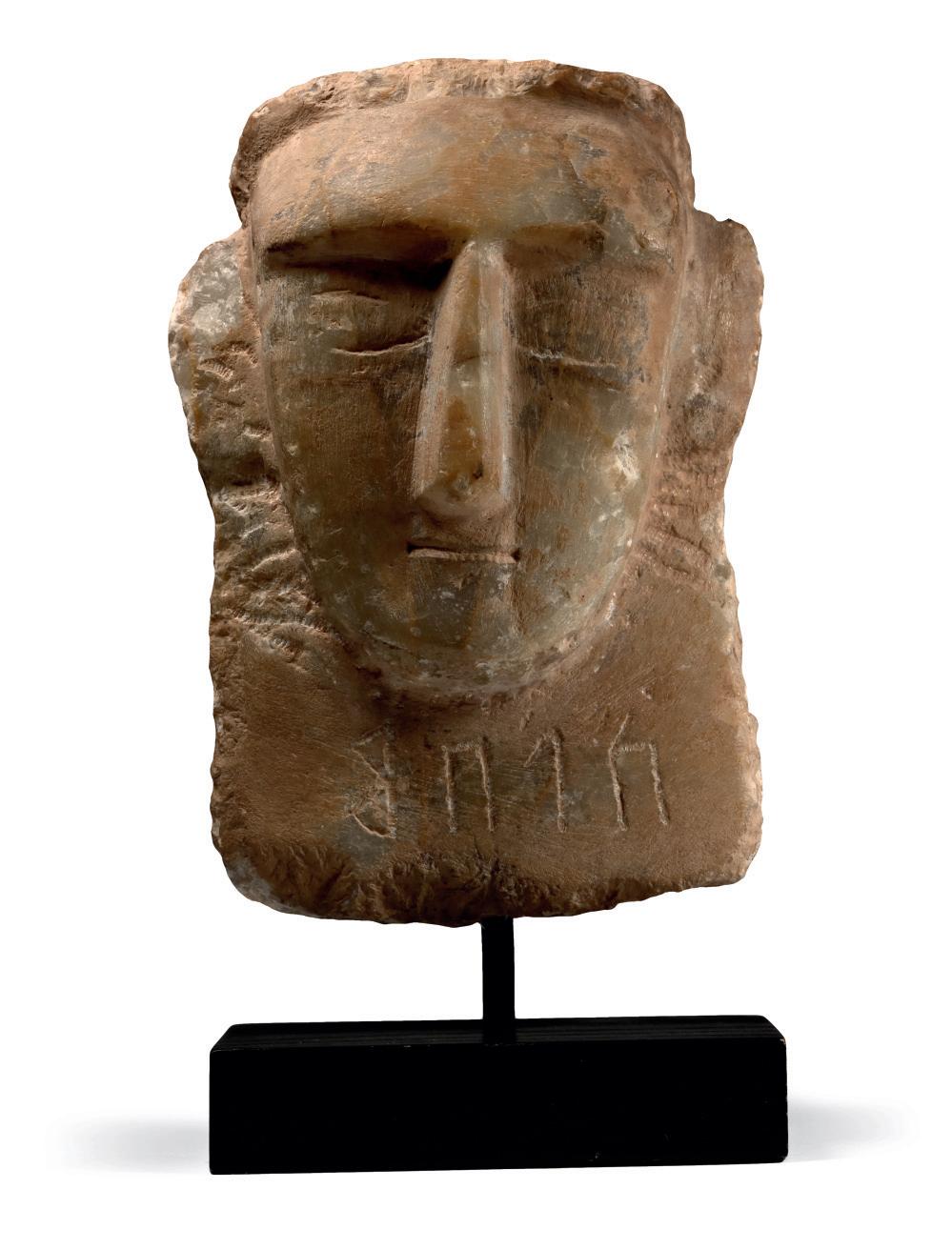
192
SOUTH ARABIAN ALABASTER HEAD OF A MAN
3RD-1ST CENTURY B.C.
7 in. (2.12 kg total, 18.7 cm including stand)
Small mouth raised sharply in the middle, large nose with angular depressions for the nostrils, deep eye sockets to accept inlay, upper and lower eyelids with rounded ridges, eyebrows tapering towards the outer end; chiselled ears, top of the head cut off flat at the hair line, back of the head left roughly tooled with central vertical insertion pin; mounted on a custom-made display stand.
£500 - 700
PROVENANCE:
UK collection, 1990s.
Acquired on the UK art market, before 2000.
Private collection, Mr M.V., a London-based businessman.
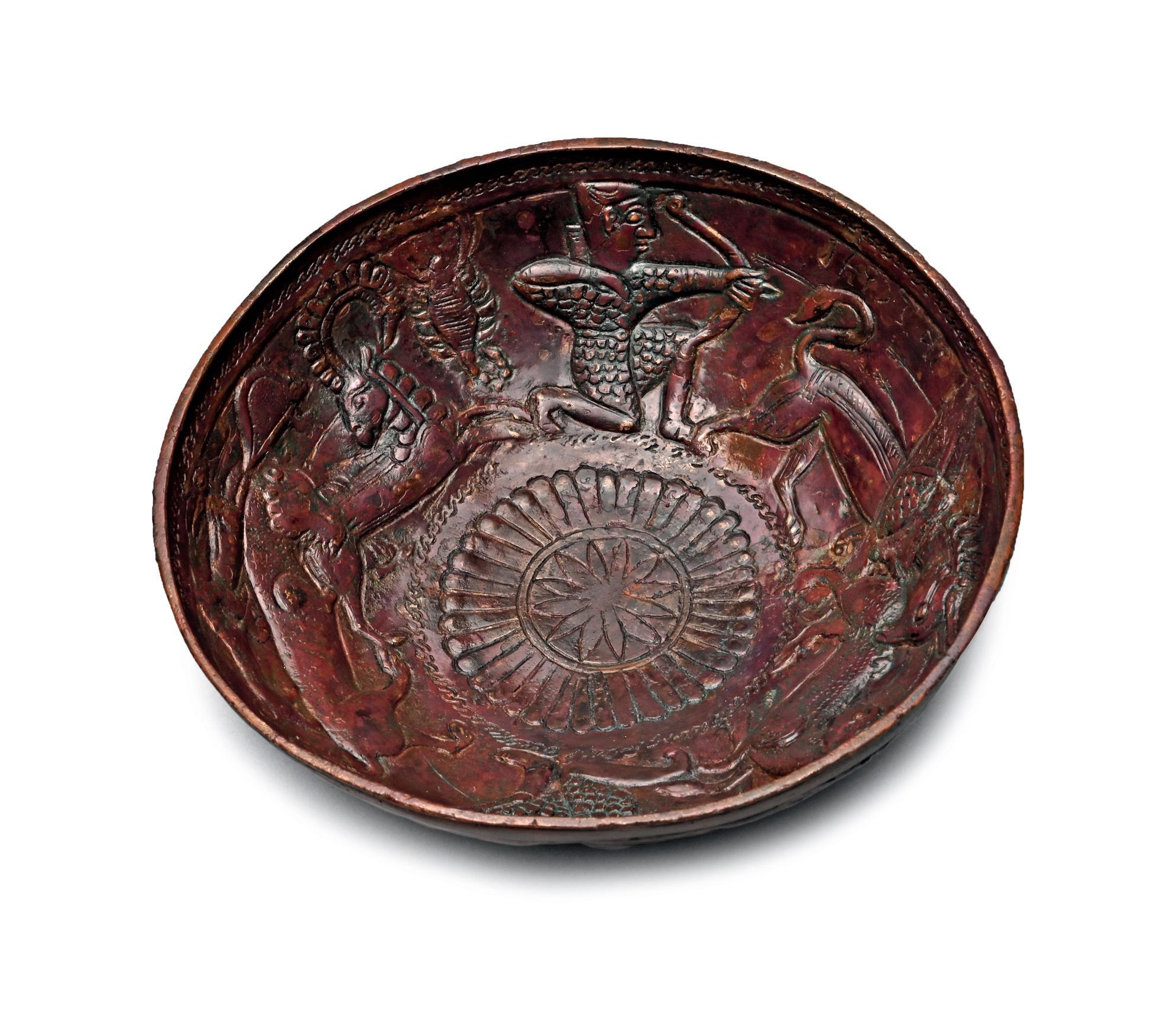
CIRCA 3RD CENTURY B.C.-2ND CENTURY A.D.
6 in. (277 grams, 15.5 cm)
Broad and squat with impressed guilloche below the inner rim, repoussé frieze with fleeing ibex attacked by a gryphon and kneeling archer to the rear; central rosette; seven incised characters to inner face and four to outer face.
£7,000 - 9,000
PROVENANCE:
The Saleh Collection, Germany, formed 1972. Private collection, UK.
FOOTNOTES:
The presence of decorated bronze bowls during the later Pre-Islamic period, mainly in the territories of the modern Emirates, is well documented. Many decorated bowls and bowl fragments were discovered at Mleiha, one or more possible fragments were found at ed-Dur and a single bowl comes from a PreIslamic period C tomb in Dibba. They are also similar to the so-called Phoenician - or more correctly Levantine - bowls produced in the 9th-early 7th century B.C. They combine local Levantine elements with imagery borrowed from Mesopotamia and Egypt, and local Arabian themes, such as camel and horse riding, often composed in radial zones.
194

SOUTH ARABIAN EROTIC FIGURES ‡
1ST CENTURY B.C.-1ST CENTURY A.D.
5¼ in. (380 grams total, 13.3 cm including stand)
Modelled in the round two figures embracing, the upper figure with a pseudo inscription to the back; mounted on a custom-made stand.
£6,000 - 8,000
PROVENANCE: Formerly in the collection of Mr K. Ex collection of Mr H., acquired in Switzerland in the early 2000s. Private collection, Switzerland, acquired in 2010.

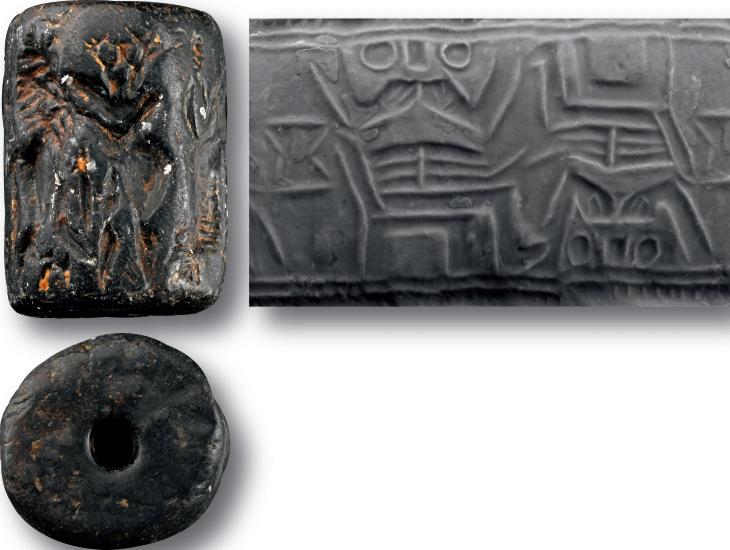


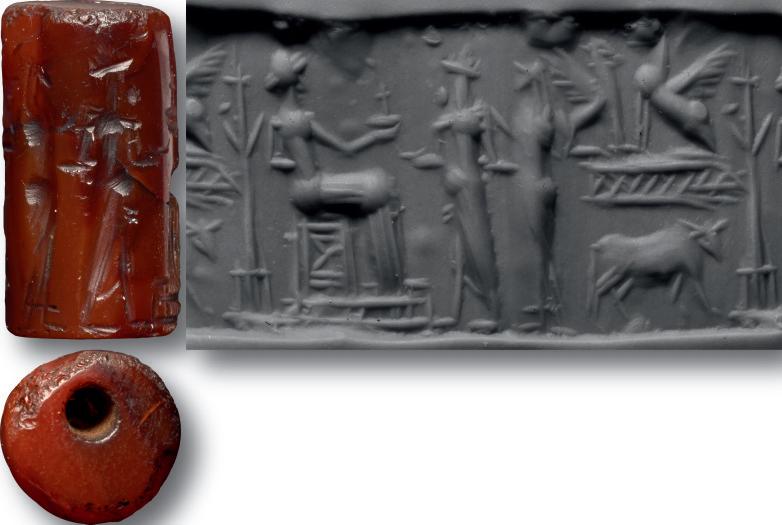

195
MESOPOTAMIAN STONE CYLINDER SEAL
2ND-1ST MILLENNIUM B.C.
1½ in. (72.1 grams, 40 mm)
With frieze depicting a facing anthropomorphic figure placed têtebêche with another; supplied with a museum-quality impression.
£1,000 - 1,400
PROVENANCE:
From the collection of the late S, London, UK, 1970-2000.
Examined by Professor Wilfrid George Lambert FBA (1926-2011), historian, archaeologist, and specialist in Assyriology and Near Eastern archaeology, in the 1990s.
196
EARLY PARTHIAN STONE CYLINDER SEAL
LATE 1ST MILLENNIUM B.C.
1 in. (8.75 grams, 24 mm)
With frieze depicting galloping horseman and fleeing stag, with a second horse confronting the first, repaired; supplied with a museumquality impression.
£500 - 700
PROVENANCE:
From the collection of the late S., London, UK, 1970-2000.
Examined by Professor Wilfrid George Lambert FBA (1926-2011), historian, archaeologist, and specialist in Assyriology and Near Eastern archaeology, in the 1990s.

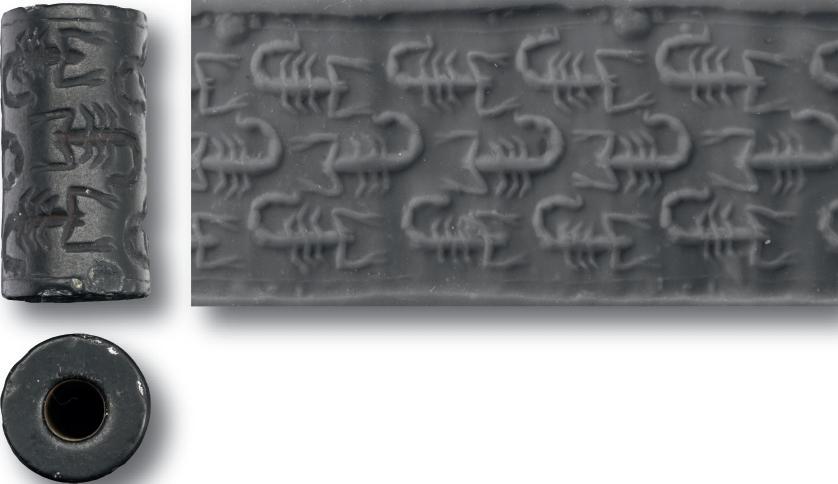

197
OLD BABYLONIAN RED STONE CYLINDER SEAL
2ND MILLENNIUM B.C.
¾ in. (3.41 grams, 19 mm)
Frieze in three registers: two crouching gryphons facing each other on a hatched base; below, advancing ox; court scene with a profile figure seated on a dais holding a vessel and facing two advancing figures in robes with open front, one leg exposed; sapling scenedivider; supplied with a museum-quality impression.
£1,000 - 1,400
PROVENANCE:
From the ‘S’ collection, acquired 1970-1990s.
The collection was seen and studied by W.G. Lambert, late Professor of Assyriology at the University of Birmingham, 1970-1993.
198
SYRIAN HEMATITE CYLINDER SEAL WITH SCORPIONS
1800-1500 B.C.
¾ in. (5.4 grams, 18 mm)
With scorpions and restrung pair of red stone beads, old handwritten label ‘1628’; accompanied by an copy of an old scholarly note, typed and signed by W.G. Lambert, late Professor of Assyriology, University of Birmingham, 1970-1993, which states: ‘Cylinder Seal of Hematite, 18x9.5 mm. This seal shows three rows of three scorpions, the middle row facing the opposite direction from the other two. This is a Syrian seal c. 1800-1500 B.C., of an unusual type. It is in fine state of preservation, and the insects are well engraved. The scorpion was a divine symbol ln the Ancient Near East, but in Syria it is not known of which deity it was the symbol. The design is in fact very old, being found in Jemdet Nasr seals c. 3000 B.C., and in Syria artists copied older motifs on many occasions.’; accompanied by a museum-quality impression. [No Reserve]
£300 - 400
PROVENANCE:
UK private collection, acquired 1980-1983.
Accompanied by a copy of a scholarly note, typed and signed by Professor Wilfrid George Lambert in 1992.





199
ACHAEMENID SILVER CYLINDER SEAL CASE WITH BATTLE SCENE
5TH CENTURY B.C.
1¼ in. (17.4 grams, 32 mm)
Depicting a combat scene comprising of a standing richly dressed royal figure with a bow-case, one hand holding wrist and other piercing shoulder of a kneeling soldier; standing helmetted archer holding his other shoulder; two bearded men lying face down beneath; winged sun disc above and date palm behind; supplied with a museum-quality impression.
£2,500 - 3,500
PROVENANCE:
From the collection of the late S, London, UK, 1970-2000.
Examined by Professor Wilfrid George Lambert FBA (1926-2011), historian, archaeologist, and specialist in Assyriology and Near Eastern archaeology, in the 1990s.
200
MESOPOTAMIAN STONE CYLINDER SEAL
2ND-1ST MILLENNIUM B.C.
1½ in. (8.81 grams, 39 mm)
With frieze in two registers: above - opposed ibexes with frond between their chests, rosette above their rumps; below - geese in a landscape with vegetation; supplied with a museum-quality impression.
£500 - 700
PROVENANCE:
From the collection of the late S, London, UK, 1970-2000.
Examined by Professor Wilfrid George Lambert FBA (1926-2011), historian, archaeologist, and specialist in Assyriology and Near Eastern archaeology, in the 1990s.



201
NORTH-SYRIAN BLACK STONE CYLINDER SEAL WITH STORM GOD
CIRCA 2000-1800 B.C.
1½ in.(30.8 grams, 40 mm)
Cylinder with standing figures and animals, restrung pair of red stone beads, old handwritten label '1659'; accompanied by a copy of an old scholarly note, typed and signed by W.G. Lambert, late Professor of Assyriology, University of Birmingham, which states: '... The deeply engraved design shows two warrior gods, standing, wearing short kilts with one hand raised the other holding an object the one holding a spear, the other an unidentified item represented by a vertical line. Before each standing warrior god is a sideways horned animal in one case and a sideways donkey in the other. There is a row of symbols along the top of the area: a circle with cross inside, an inverted crescent and dot, and a bull's head...'; accompanied by a museumquality impression. [No Reserve]
£400 - 600
PROVENANCE: Armand Trampitsch, Glyptique Archéologie, Paris, Hôtel Drouot, 13-14 May 1992, no.23 [Part].
Accompanied by a copy of a scholarly note, typed and signed by Professor Wilfrid George Lambert in 1992.
202
SUMERIAN LAPIS LAZULI CYLINDER SEAL WITH GODS AND ATTENDANT
3RD MILLENNIUM B.C.
1¼ in. (12.4 grams, 33 mm)
With two sections, upper section with two seated figures and two attendants, lower section with standing figure among animals; supplied with a museum-quality impression.
£700 - 900
PROVENANCE:
From the collection of the late S, London, UK, 1970-2000.
Examined by Professor Wilfrid George Lambert FBA (1926-2011), historian, archaeologist, and specialist in Assyriology and Near Eastern archaeology, in the 1990s.





203
OLD BABYLONIAN HAEMATITE CYLINDER SEAL ‡
2000-1800 B.C.
1 in. (11 grams, 25 mm)
Columnar in form with frieze depicting a standing Lamma goddess in flounced robe facing towards a god wearing a pleated garment and holding a mace at his hip; disc-and-crescent motif above; behind, the storm-god Adad with one foot on a mound, wielding a lightning bolt in his raised hand.
£2,500 - 3,500
PROVENANCE:
Private collection, Europe. with Bonhams, London, 22 April 1999, no.538. Acquired by the present owner from the above.
Accompanied by copies of the relevant Bonhams catalogue pages.
204
AKKADIAN BLACK STONE CYLINDER SEAL WITH TWO NUDE LAKHMUS
CIRCA 2300-2200 B.C.
1½ in. (49 grams, 40 mm)
With hero and animals, restrung pair of red stone beads, old handwritten label ‘1664’; accompanied by a copy of an old scholarly note, typed and signed by W.G. Lambert, late Professor of Assyriology, University of Birmingham, 1970-1993, which states: ‘Cylinder of Black Stone, 40 x 25.5 mm. The design shows three pairs of animal and divine hero fighting. A bull man consisting of a bovine body with human face is grappling with a reared-up lion; a nude hero wearing only a belt around the waist, with much hair around the face, is grappling with a water-buffalo; and a second hero of the same type is grappling with a bull. This is an Akkadian seal, c. 2300-2200 B.C. from southern Iraq or a neighbouring area. It is a large example of the best Akkadian style, and though work the beauty of the carving can still be seen. The two nude heroes are called Lakhmus, a kind of minor god of which many were conceived to exist’; accompanied by a museum-quality impression. [No Reserve]
£800 - 1,000
PROVENANCE:
UK private collection, acquired 1980-1983.
Accompanied by a copy of a scholarly note, typed and signed by Professor Wilfrid George Lambert in 1992.
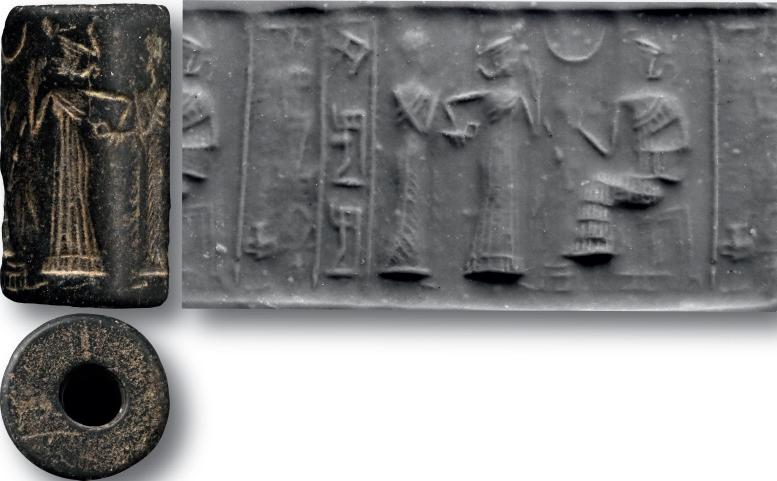

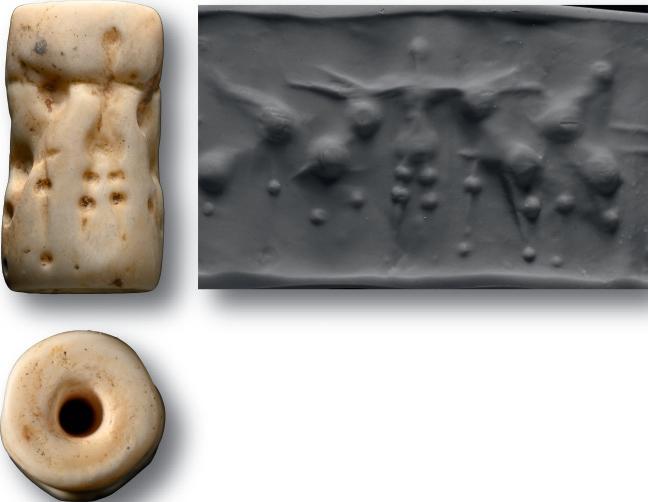
205 KASSITE STONE CYLINDER SEAL WITH HADADA, SON OF LUGAL...NA INSCRIPTION
CIRCA 16TH-12TH CENTURY B.C.
1 in. (12.6 grams, 28 mm)
With frieze depicting two standing robed figures facing a seated figure in flounced robe, objects in the field; two columns of cuneiform text, reading ‘Hadada, son of Lugal...na’; supplied with a museum-quality impression.
£500 - 700
PROVENANCE:
From the collection of the late S, London, UK, 1970-2000. Examined by Professor Wilfrid George Lambert FBA (1926-2011), historian, archaeologist, and specialist in Assyriology and Near Eastern archaeology, in the 1990s.
206 EARLY AKKADIAN SHELL CYLINDER SEAL WITH ATTACKING LIONS
2400-2200 B.C.
¼ - 1 in. (16.1 grams total, 8.1-29.57 mm)
With cord and bead handles; accompanied by a copy of an old scholarly note, typed and signed by W.G. Lambert, late Professor of Assyriology, University of Birmingham, 1970-1993, which states: ‘Description of Cylinder Seal of Fossil Shell 30 x 16.5 mm. A god standing in the centre succours a domestic animal on either side which is being attack[ed] in turn by a lion. Terminal: two line[s] below vacant description panel. The seal is of late ED III or early Akkad date, c. 2400-2200 B.C. The cutting is marked by a strong use of the drill. The seal is worn, though the design clear. The meaning of the design is based on real life. Lions were a real threat to the herds and flocks of the community, and it was hoped that the depiction of a god coming to the rescue of the domestic creatures would mean that in real life their animals would be similarly saved by divine help.’; accompanied by a museum-quality impression. [No Reserve]
£500 - 700
PROVENANCE: UK private collection, acquired 1980-1983.
Accompanied by a copy of a scholarly note, typed and signed by Professor Wilfrid George Lambert in August 1990.
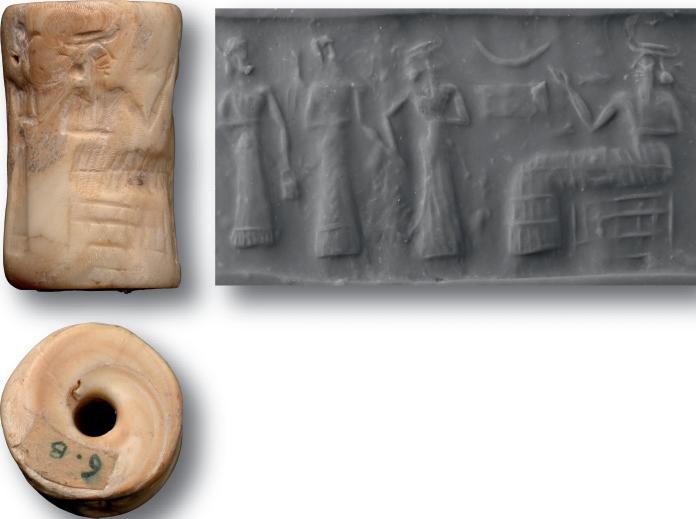




207
EARLY AKKADIAN SHELL CYLINDER SEAL WITH PRESENTATION SCENE
CIRCA 2300-2200 B.C.
1 in. (30.9 grams, 35 mm)
Depicting seated god facing three standing figures, restrung pair of red stone beads, old handwritten label ‘1648’; accompanied by a copy of an old scholarly note, typed and signed by W.G. Lambert, late Professor of Assyriology, University of Birmingham, 1970-1993; accompanied by a museum-quality impression. [No Reserve]
£600 - 800
PROVENANCE:
Armand Trampitsch, Glyptique Archéologie, Paris, Hôtel Drouot, 13-14 May 1992, no.23 [Part].
Accompanied by a copy of a scholarly note, typed and signed by Professor Wilfrid George Lambert in 1992.
208
EARLY AKKADIAN SHELL CYLINDER SEAL WITH UNCLASSIFIED SNAKE GOD
CIRCA 2300-2200 B.C.
1 in. (30 grams, 35 mm)
With figures and fire altar, restrung pair of red stone beads, old handwritten label ‘1649’; accompanied by a copy of an old scholarly note, typed and signed by W.G. Lambert, late Professor of Assyriology, University of Birmingham, 1970-1993, which states: ‘Cylinder Seal of Fawn Fossil Shell, 35 x 20.5 mm. On the right sits a snake god: human body above the waist, curling snake below, with one hand extended. Facing him stands a god in long robe with bottom fringe, also extending one hand. Between them is a fire altar. Behind each god is a sideboard for holding food and drink ready to consume. There is a lunar crescent in the sky. This is an Akkadian seal from Mesopotamia or Western Iran, c. 2300-2200 B.C. The snake god is not yet identified from texts, but is a fascinating item of Akkadian mythology.’; accompanied by a museum-quality impression. [No Reserve]
£400 - 600
PROVENANCE: Armand Trampitsch, Glyptique Archéologie, Paris, Hôtel Drouot, 13-14 May 1992, no.23 [Part].
Accompanied by a copy of a scholarly note, typed and signed by Professor Wilfrid George Lambert in 1992.
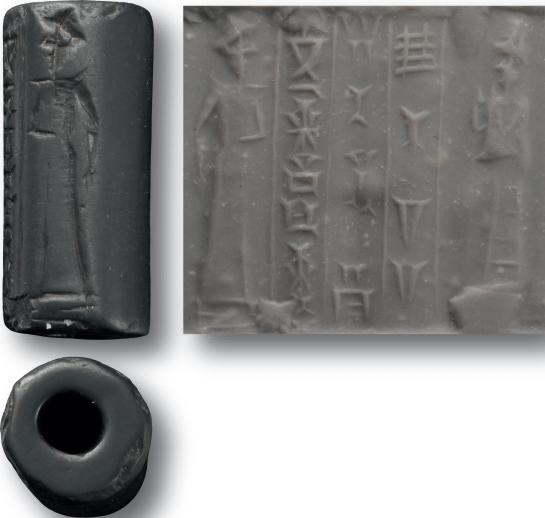
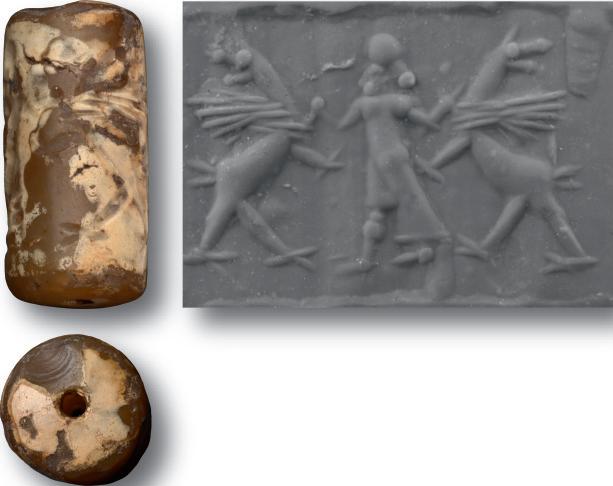

209
OLD BABYLONIAN STONE CYLINDER SEAL FOR SHERUM-ILI, SON OF BEGUM, SERVANT OF NINSIANNA
2ND-1ST MILLENNIUM B.C.
1 in. (9.53 grams, 25 mm)
With three columns of cuneiform inscription, reading ‘Sherum-ili, son of Begum, servant of Ninsianna’, a standing robed figure on each side; accompanied by a museum-quality impression.
£500 - 700
PROVENANCE:
From the collection of the late S, London, UK, 1970-2000. Examined by Professor Wilfrid George Lambert FBA (1926-2011), historian, archaeologist, and specialist in Assyriology and Near Eastern archaeology, in the 1990s.
210
LATE ASSYRIAN YELLOW CHALCEDONY CYLINDER SEAL WITH STANDING GOD
800-600 B.C.
1¼ in. (16.7 grams, 33 mm)
With standing divine figure and animals, restrung pair of red stone beads, old handwritten label ‘1605’; accompanied by a copy of an old scholarly note, typed and signed by W.G. Lambert, late Professor of Assyriology, University of Birmingham, 1970-1993, which states: ‘Cylinder Seal of Yellow Chalcedony with Ivory Coating in Part. 33 x 16 mm. The engraving shows a standing god dressed in a long robe open at the front, from which one leg projects, holding off on either side a winged quadruped which is facing backwards. This is typical Late Assyrian or Late Babylonian seal dating c. 800-600 B.C., engraved with a combination of cutting wheel and drill. The purpose of the scene is to display the power of the god, no doubt meant as the god of the seal owner, but there is nothing to indicate exactly which god the seal engraver had in mind. Apart from a chip off the upper edge not reaching the design, the seal is in very good state of preservation.’; accompanied by a museum-quality impression. [No Reserve]
£300 - 400
PROVENANCE:
UK private collection, acquired 1980-1983.
Accompanied by a copy of a scholarly note, typed and signed by Professor Wilfrid George Lambert in 1991.

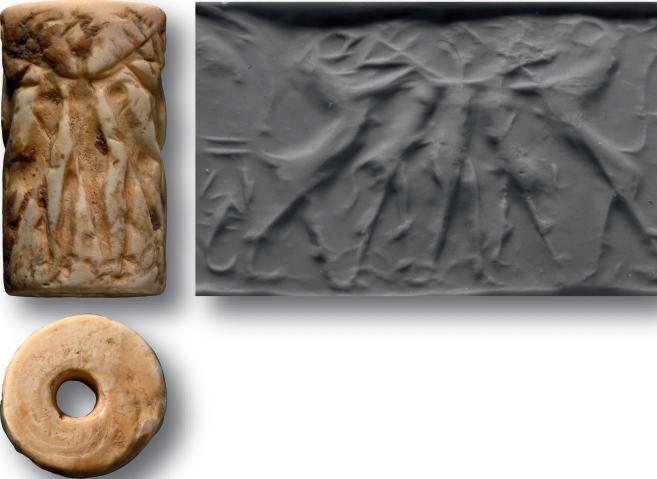


SUMERIAN SHELL CYLINDER SEAL WITH HEROES
2600-2300 B.C.
¼ - 1 in. (14.9 grams total, 8.1-27.78 mm)
With cord and bead handles; accompanied by a copy of an old scholarly note, typed and signed by W.G. Lambert, late Professor of Assyriology, University of Birmingham, 1970-1993, which states: ‘Cylinder seal of fossil shell. 28 x 16 mm., condition good. Contest scene: standing hero succours reared up domestic animal on either side as they are attacked by lions, a second hero pulls the tail of the right-hand lion from behind; terminal scorpion below double line. This well known type of Sumerian seal occurs at the very end of the Early Dynastic periods, and on into the beginning of the Akkad dynasty. The scene involves divine heroes, and it was hoped that in actual life such figures would save domestic herds from attacks of lions.’; accompanied by a museum-quality impression. [No Reserve]
£600 - 800
PROVENANCE:
UK private collection, acquired 1980-1983.
Accompanied by a copy of a scholarly note, typed and signed by Professor Wilfrid George Lambert in August 1990.
212
EARLY AKKADIAN SHELL CYLINDER SEAL WITH DIVINE HERO
CIRCA 2300 B.C.
1 in. (37.6 grams, 37 mm)
Cylinder with standing male figure with a pair of animals to each side, restrung pair of red stone beads, old handwritten label ‘1647’; accompanied by a copy of an old scholarly note, typed and signed by W.G. Lambert, late Professor of Assyriology, University of Birmingham, 1970-1993, which states: ‘Cylinder Seal of Cream Fossil Shell, 37 x 22 mm. In the centre stands a divine hero, nude, and gripping the neck of a horned animal on either side, each of which is being attacked by a lion with erect tail. For a terminal there stands a tall tree. This is an early Akkadian seal from Mesopotamia or West Iran, c. 2300 B.C. The symbolism comes from temple herds, which were liable to be attacked by lions at this time. They believed that certain gods and divine heroes could rescue their animals from such attacks, and by showing such scene on their seals they hoped to achieve the result be sympathetic magic.’; accompanied by a museum-quality impression. [No Reserve]
£400 - 600
PROVENANCE: Armand Trampitsch, Glyptique Archéologie, Paris, Hôtel Drouot, 13-14 May 1992, no.23 [Part].
Accompanied by a copy of a scholarly note, typed and signed by Professor Wilfrid George Lambert in 1992.

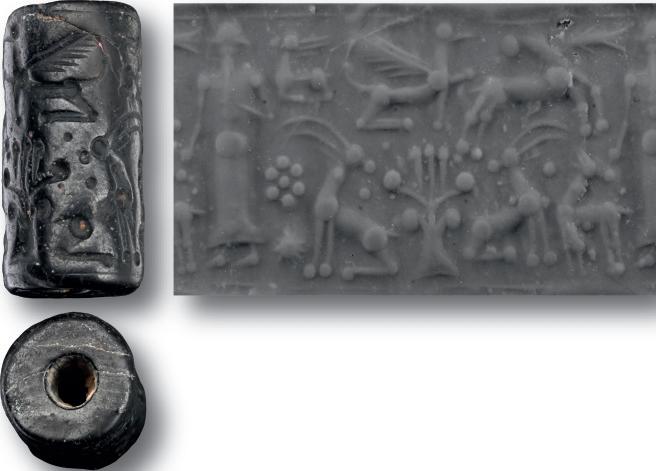
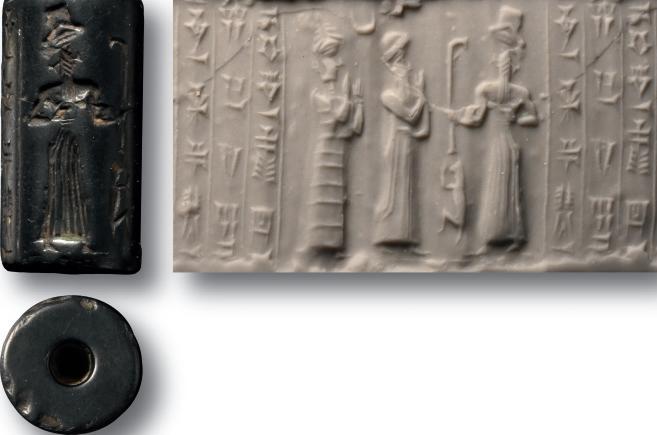

MITANNI HEMATITE CYLINDER SEAL WITH GRIFFIN ATTACKING QUADRUPED
1500-1200 B.C.
¾ in. (6.2 grams, 19 mm)
With animals and standing figure, restrung pair of red stone beads, old handwritten label ‘1614’; accompanied by a copy of an old scholarly note, typed and signed by W.G. Lambert, late Professor of Assyriology, University of Birmingham, 1970-1993, which states: ‘Cylinder Seal of Hematite, 19.5.x9.5 mm. The design consists of one item occupying the full height of the space, the other items being in effect in two registers. The human figure is full-height, wearing a robe to the ground, holding one hand to the waist, the other up. The lower register consists mainly of two recumbent horned animals, each facing backwards towards a sacred- tree. To the right is a smaller quadruped, to the left a rosette and star. Above a griffin is attacking a quadruped, while behind. The griffin is another quadruped, but horned and recumbent. This seal is Mitanni Elaborate Style, c. 1500-1200 B.C. from Syria or north Mesopotamia. It is cut, as normal for this type of seal, mainly with the cutting wheel and drill, and is a fine example of its kind.’; accompanied by a museum-quality impression. [No Reserve]
£300 - 400
PROVENANCE: UK private collection, acquired 1980-1983.
Accompanied by a copy of a scholarly note, typed and signed by Professor Wilfrid George Lambert in 1991.
214
OLD BABYLONIAN HEMATITE CYLINDER SEAL FOR AHISHAGISH, SON OF SINIA, SERVANT OF AMURRU
2ND MILLENNIUM B.C. 1 in. (14.4 grams, 26 mm)
With three columns of cuneiform text: ‘Ahi-shagish, son of Sinia, Servant of Amurru’, standing figure of a god holding sceptre facing a worshipper accompanied by a goddess wearing long robe and horned crown; supplied with a museum-quality impression.
£500 - 700
PROVENANCE:
From the collection of the late S, London, UK, 1970-2000.
Examined by Professor Wilfrid George Lambert FBA (1926-2011), historian, archaeologist, and specialist in Assyriology and Near Eastern archaeology, in the 1990s.


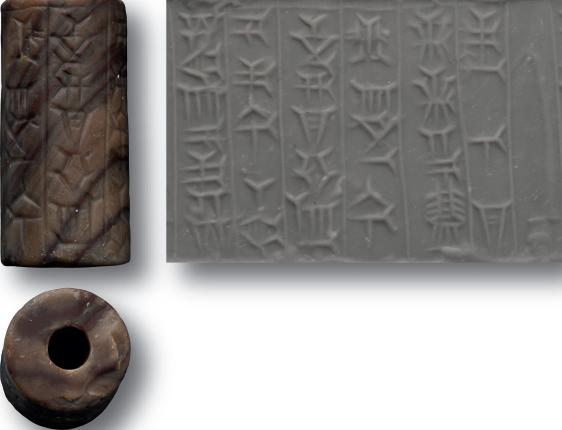

LEVANTINE STYLE RED JASPER CYLINDER SEAL WITH RECUMBENT QUADRUPEDS
1500-1000 B.C.
1 in. (10.2 grams, 37 mm)
With two rows of human and animal figures, restrung pair of red stone beads, old handwritten label ‘1544’; accompanied by a copy of an old scholarly note, typed and signed by W.G. Lambert, late Professor of Assyriology, University of Birmingham, 1970-1993, which states: ’Description of Cylinder Seal of Red Jasper, 37 x 12 mm. The upper register shows a seated figure with one arm raised, the other resting on the waist, a human hand(?) between knees and raised arm; two recumbent quadrupeds one above the other, one winged; two standing stags sideways, with heads turned back. The lower register shows, in a scene marked off by a ladder pattern, three standing humans with both hands raised before a tent-like structure with some object affixed to its upper front, two dots behind the structure. The registers are separated by a line with a row of simple crosses beneath it. This is in a rare Levantine style of c. 1500-1000 B.C. The lower register seems to show an act of worship. The condition is almost fine save for a little chipping at the bottom’; accompanied by a museumquality impression. [No Reserve]
£400 - 600
PROVENANCE:
UK private collection, acquired 1980-1983.
Accompanied by a copy of a scholarly note, typed and signed by Professor Wilfrid George Lambert in 1987.
216
MESOPOTAMIAN STONE CYLINDER SEAL WITH MERCIFUL IS ANAMURRU, GIVER OF HEALTH INSCRIPTION
2ND-1ST MILLENNIUM B.C.
1 in. (7.91 grams, 26 mm)
With six columns of cuneiform inscription, reading ‘Merciful is AnAmurru, giver of health — his reverent servant, Ahushina, son of Itti-Ea-...’; accompanied by a museum-quality impression.
£700 - 900
PROVENANCE:
From the collection of the late S, London, UK, 1970-2000. Examined by Professor Wilfrid George Lambert FBA (1926-2011), historian, archaeologist, and specialist in Assyriology and Near Eastern archaeology, in the 1990s.


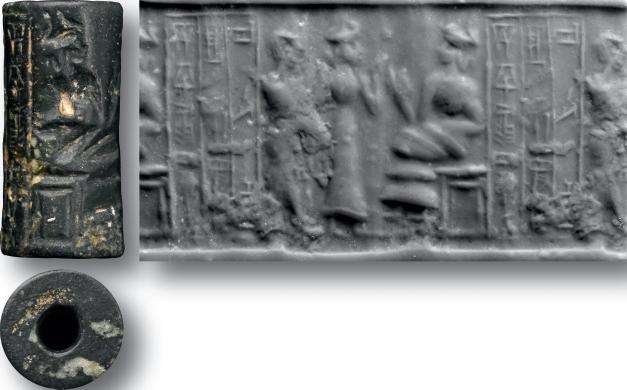

MITANNI HEMATITE CYLINDER SEAL WITH STANDING DEITY OPPOSING SPHINX
1500-1200 B.C.
¾ in. (4.6 grams, 19 mm)
With standing figure, sphinx and horned animal, restrung pair of red stone beads, old handwritten label ‘1629’; accompanied by a copy of an old scholarly note, typed and signed by W.G. Lambert, late Professor of Assyriology, University of Birmingham, 1970-1993, which states: ‘Cylinder Seal of Hematite, 19 x 7.5 mm. On the right stands a human figure in a hat with broad brim and wearing a robe to the feet. In one hand he holds an elaborate mace, no doubt the symbol of a deity. On the left is a reared up sphynx with raised wings and resting its front paws on the head of a recumbent horned animal. between the tops of the horns is a star. Two other filling motifs are: a dot and something like the horned animal’s head with a long line rising above it. The design is put between upper and lower rules. This is a Mitanni ‘elaborate style’ seal, c. 1500-1200 B.C. It is in fine condition and is an interesting specimen of its type.’; accompanied by a museumquality impression. [No Reserve]
£300 - 400
PROVENANCE:
UK private collection, acquired 1980-1983.
Accompanied by a copy of a scholarly note, typed and signed by Professor Wilfrid George Lambert in 1992.
218
MESOPOTAMIAN STONE CYLINDER SEAL FOR A ROYAL SOLDIER, SON OF BAGI
2ND-1ST MILLENNIUM B.C. 1 in. (6.03 grams, 25 mm)
With frieze depicting two figures in floor-length robes addressing a seated figure in flounced robe; panel with three columns of cuneiform text, reading ‘Kudum(?), royal soldier, son of Bagi, officer’; supplied with a museum-quality impression.
£500 - 700
PROVENANCE:
From the collection of the late S, London, UK, 1970-2000. Examined by Professor Wilfrid George Lambert FBA (1926-2011), historian, archaeologist, and specialist in Assyriology and Near Eastern archaeology, in the 1990s.
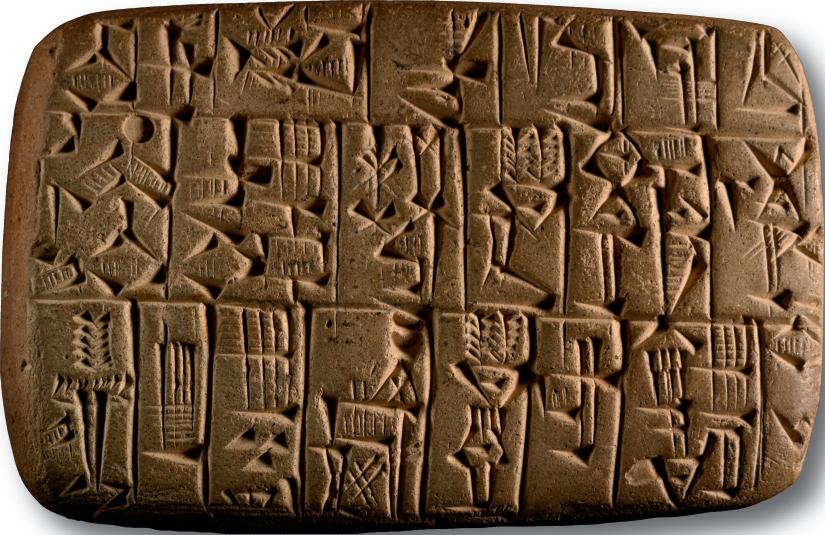

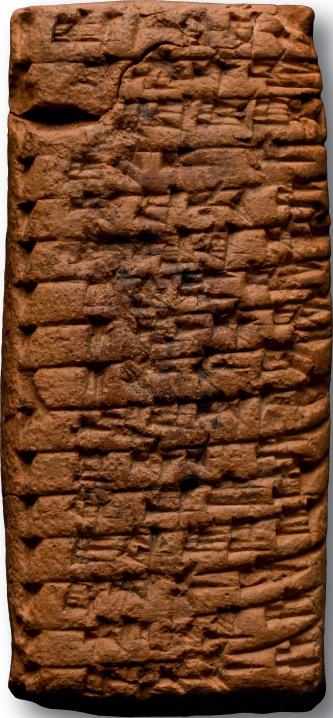


219
OLD BABYLONIAN CUNEIFORM TERRACOTTA TABLET ‡
SUMERIAN, 2600-2400 B.C.
3¾ in. (138 grams, 96 mm)
Rectangular clay tablet with cuneiform text to both broad faces.
£1,800 - 2,400
PROVENANCE:
Ex Oriental Dar Antiques, Jerusalem, 1967. European private collection.
Accompanied by a thermoluminescence analysis report no.N125e33 from Oxford Authentication.
220
OLD BABYLONIAN TERRACOTTA CUNEIFORM TABLET
19TH-16TH CENTURY B.C.
3¾ in. (146 grams, 96 mm)
Pillow-shaped with impressed cuneiform text to one broad face, one end and the upper part of the reverse. [No Reserve]
£400 - 600
PROVENANCE:
From the private collection of a Canadian gentleman living in Essex, UK, formed since the 1920s-circa 1990.
Property of an Essex lady until the late 1990s; thence by descent. From the private collection of an Essex gentleman since the late 1990s.
221
SUMERIAN PICTOGRAPHIC TABLET FRAGMENT LISTING SHEEP AND GOATS
JEMDET NASR PERIOD, CIRCA 3000 B.C.
2¼ in. (39 grams, 58 mm)
Pillow-shaped tablet fragment with script to one face; accompanied by an old scholarly note, typed and signed by W.G. Lambert, late
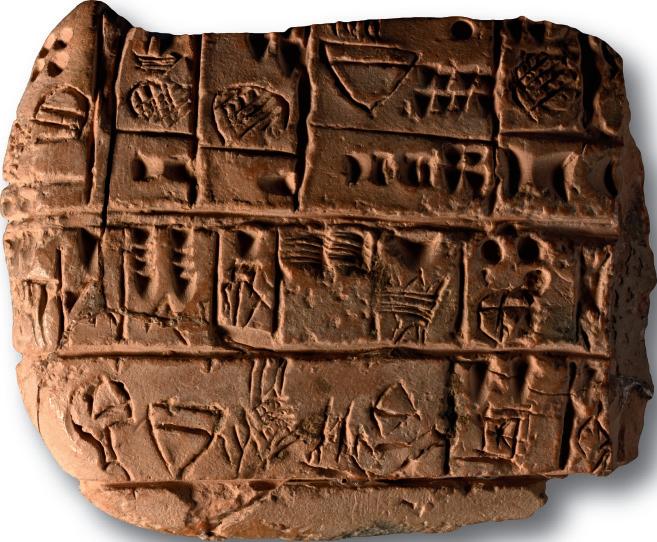

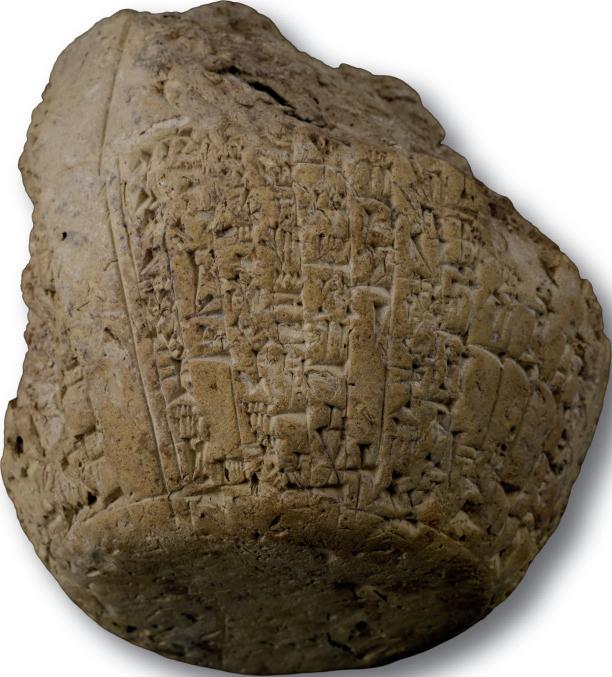
Professor of Assyriology, University of Birmingham, 1970-1993, which states: ‘Portion of Clay tablet with Pictographic Script. 57x48 mm. This is an oblong tablet with rounded side and corners. Most of the obverse is preserved, only the top and left edges are missing. Most of the surface of the reverse is lost, but it was not written so the loss is not important. The obverse is divided into three columns, the first being a double column: each compartment has a smaller one beside it with figures alone. This is an administrative document from some town in Sumer, dating to the Jemdet Nasr period, c. 3000 B.C. Not everything can yet be understood, but some things are clear. The purpose of the double column is not known, but in the second column there are two immediately clear lines: 30 sheep; 1 (or:60) goat(s) The first two columns and the beginning of the third consist of compartments with signs for things and numbers, but the rest of the last column has more complex writing devices, and must be some kind of different statement. such as the name of the official in charge of the things listed, or the name of the office dealing with these matters, or also the name of the place where this listing was made. This tablet has been conserved by firing, and is in good condition.’
£600 - 800
PROVENANCE:
Ex private collection of Mr S H; thence by descent,1980-1990.
222
MESOPOTAMIAN CUNEIFORM BARREL FRAGMENT WITH ROYAL TEXT
2ND MILLENNIUM B.C. 4 in. (414 grams, 10.4 cm)
A large fragment of a ceramic barrel with cuneiform inscription to the outer face, flattened circular base.
£600 - 800
PROVENANCE:
From an important collection pre 1988. From a private UK collection.
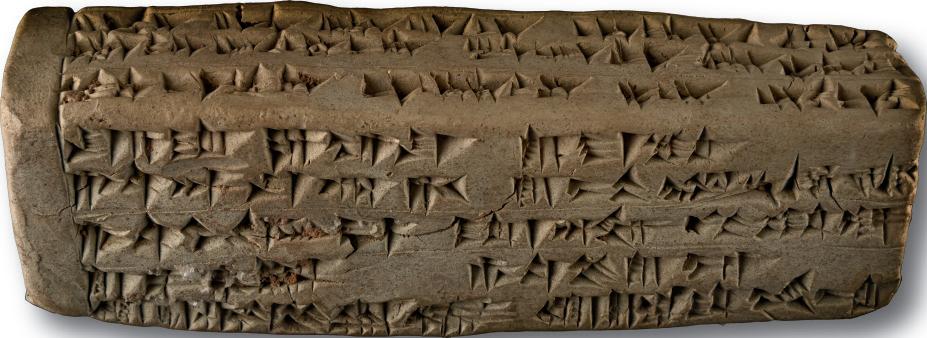

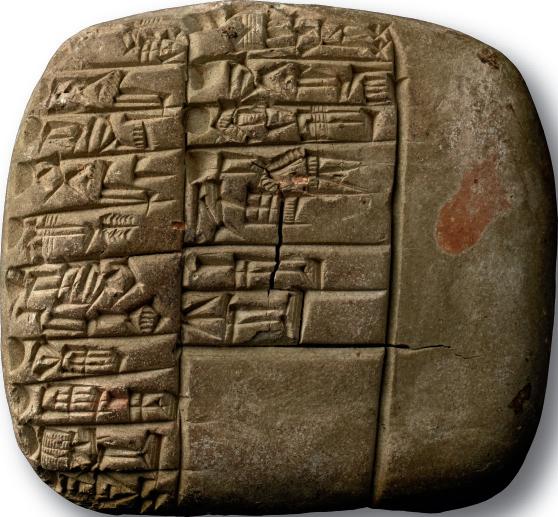

223

NEO-SUMERIAN TERRACOTTA CUNEIFORM TABLET ‡ 1ST MILLENNIUM B.C.
5 in. (333 grams, 14.3 cm)
Rectangular in plan and in section with impressed cuneiform text covering three vertical faces, single column to the fourth face; continuation of one column over the top.
£6,000 - 8,000
PROVENANCE: Acquired in the 1996.
Private collection, Switzerland, thence by descent. Private collection, since the late 1990s.
224
SUMERIAN CUNEIFORM TABLET LISTING GOODS INCLUDING 10 SHEKELS OF SILVER AKKADIAN PERIOD, CIRCA 2300-2200 B.C. 2¼ in. (68 grams, 58 mm)
Pillow-shaped ceramic tablet with one segmented surface; accompanied by an old scholarly note, typed and signed by W.G. Lambert, late Professor of Assyriology, University of Birmingham, 1970-1993, which states: ‘Clay tablet, 53x57 mm, with 16 Lines of Sumerian Cuneiform. There are two columns of writing on the obverse only, the second not quite complete. The script dates the tablet to the Akkadian period, c.2300-2200 B.C. There is a chip off the lower edge, but all the writing is in perfect state of preservation. The text is a scholarly list of words and phrases such as scribed writing ur legal and commercial documents might use. Not everything has been understood so far, but some things are perfectly clear: A pot of lard; Bronze; x* of a mina of copper * apparently a fraction; Female kid; Male kid; Its silver 10 shekels; Bed of oak? Scholarly tablets of this kind are extremely rare for the Old Akkadian period. They are part of the scholarly list tradition which is a prominent feature of this civilization.’
£600 - 800
PROVENANCE:
Ex private collection of Mr S H; thence by descent,1980-1990.
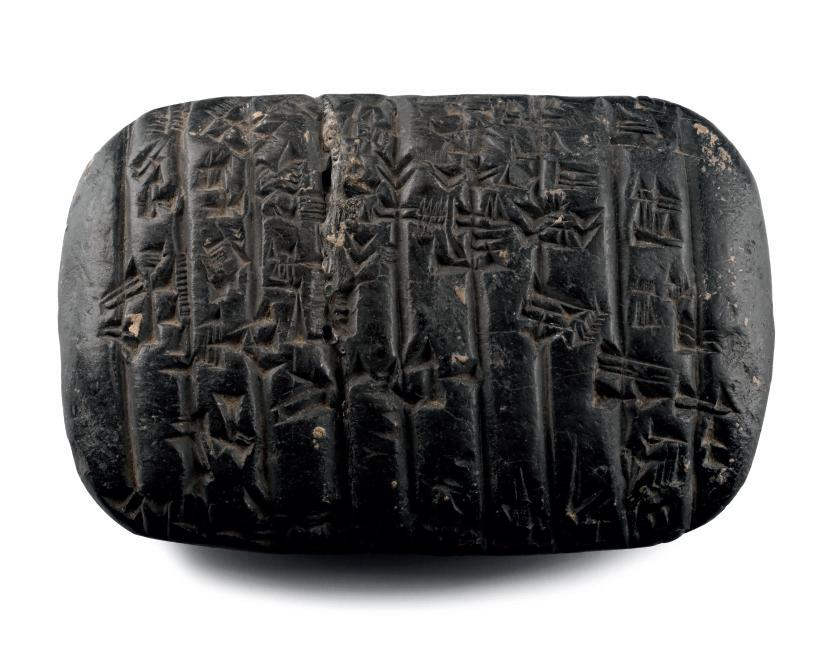

225
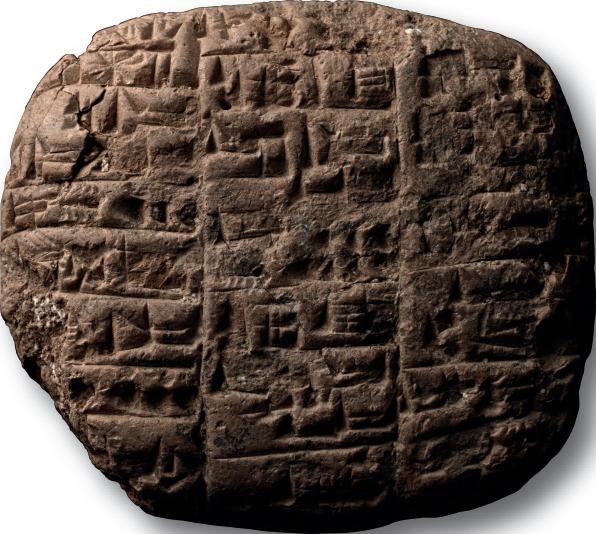
WESTERN ASIATIC TERRACOTTA CUNEIFORM TABLET ‡ 2ND MILLENNIUM B.C. 2½ in. (57.2 grams, 63 mm)
Pillow-shaped with columnar ribbing to the broad faces, dense cuneiform text in the columns.
£2,000 - 3,000
PROVENANCE:
Private collection of Mr K., Maryland, USA.
Private collection, Switzerland, acquired in 2000.
226
SUMERIAN CUNEIFORM TABLET LISTING GOODS INCLUDING 1 SHEKEL OF REFINED SILVER FROM MR ENSHAGA
EARLY DYNASTIC PERIOD, CIRCA 2500 B.C. 2½ in. (95 grams, 64 mm)
Pillow-shaped with impressed text to both faces; accompanied by an old scholarly note, typed and signed by W.G. Lambert, late Professor of Assyriology, University of Birmingham, 1970-1993, which states: ‘Clay tablet 58x64 mm. with 26 Compartments and One Column of Sumerian Cuneiform. This is oblong with rounded sides and edges. each side is divided into 3 columns, and all but the last two are filled with script. This is some kind of legal document from a Sumerian city not so far known for such texts. The first five columns list items, each with a number and followed by a compartment of a different kind. The last column, on the reverse, is different from the others in giving the name and title of an official who in some way presided over the transaction here recorded. Since it is without exact parallel, it is difficult to translate even when the text is clear (there is some surface damage and one corner is broken off). The items given start with one donkey, and include a quantity of barley (3 gur of barley), one shekel of refined silver, and two iku (acres of agricultural land) is the last item. after which the document concludes: Mr Enshaga was their seller...’ £600 - 800
PROVENANCE: Ex private collection of Mr S H; thence by descent,1980-1990.

228
ASSYRIAN TERRACOTTA HEAD OF PAZUZU
8TH-6TH CENTURY B.C.
3¼ in. (89 grams, 83 mm)
Zoomorphic head with two rows of triangular teeth in gaping mouth, tear-shaped eyes with wide border, pair of crescentic ears, snub nose, hatched beard and pair of curved horns; pierced at the top for suspension.
£600 - 800
PROVENANCE:
UK private collection before 2000. Acquired on the UK art market. Private collection, London, UK.

230
SYRO-HITTITE TERRACOTTA FIGURINE WITH ANIMAL
CIRCA 2ND MILLENNIUM B.C.
5 in. (56 grams, 12.6 cm high)
An abstract figure modelled standing, carrying a small animal in its arms, possibly a kid, with a pinched head, large circular eyes, conical headpiece, discoid ear ornaments and a neck ornament.
£1,200 - 1,700
PROVENANCE: Collection of a deceased London gentleman, 1979-1999, by descent. From the private collection of John Meredith, acquired since the 1990s; thence by descent.
Accompanied by an original thermoluminescence analysis report no. N122e89 from Oxford Authentication.
227
OLD BABYLONIAN TERRACOTTA HEAD OF A DEMON ‡ 1900-1800 B.C.
3 in. (191 grams, 87 mm)
Modelled in the round depicting the (severed?) head of the Mesopotamian demon Humbaba, with iconic facial features in relief; hollow with vent to the neck; produced from a two-piece mould, with median seam through the facial features.
£2,000 - 3,000
PROVENANCE:
Private collection, Israel. with Holy Land House of Antiquities, Jerusalem, 1980s. Acquired by the current owner from the above, 2001.
FOOTNOTES:
Within traditional Mesopotamian religion, Humbaba was a creature regarded as Guardian of the Cedar forest and the brother of Pazuzu. He was represented as a giant who had been raised by the sun god, Shamash.
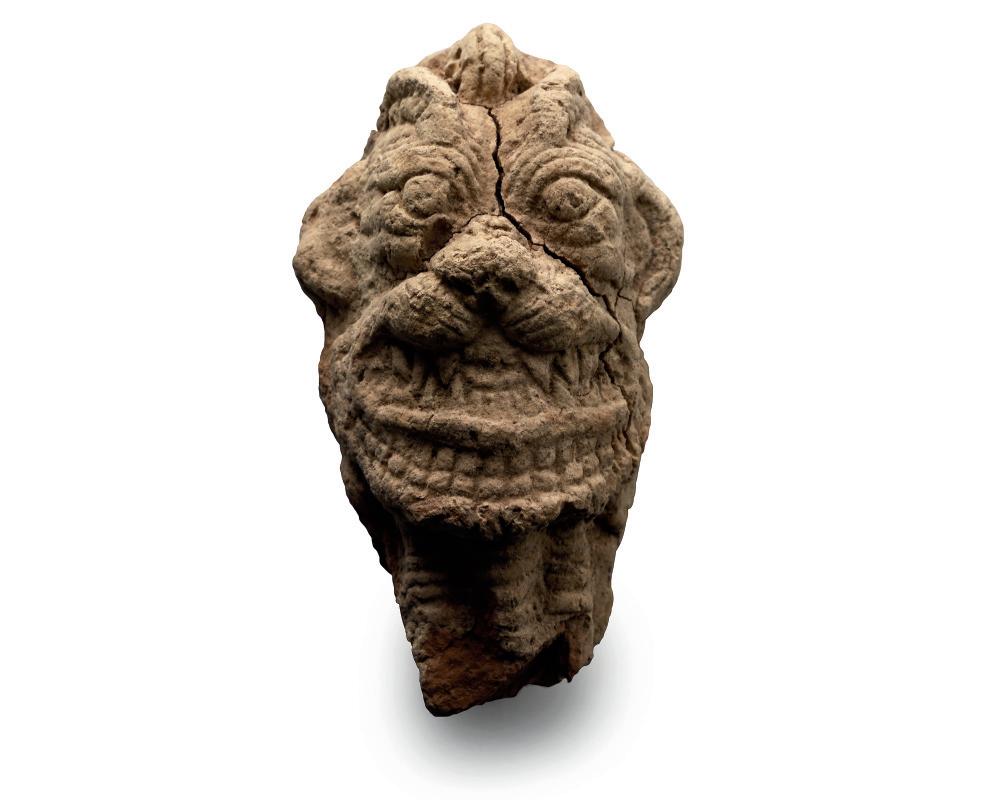
229
CHALCOLITHIC TERRACOTTA FIGURE
CIRCA 3RD MILLENNIUM B.C.
6 in. (173 grams, 17.5 cm high)
Modelled in the round with columnar head and neck, pinched and impressed facial details, applied headdress, collar and calf-length skirt, stub arms. [No Reserve]
£600 - 800
PROVENANCE: From the property of the late Mr SM, London, UK, 1969-1999. From the private collection of John Meredith, acquired since the 1990s; thence by descent.
Accompanied by a thermoluminescence analysis report no.N122k33 from Oxford Authentication.
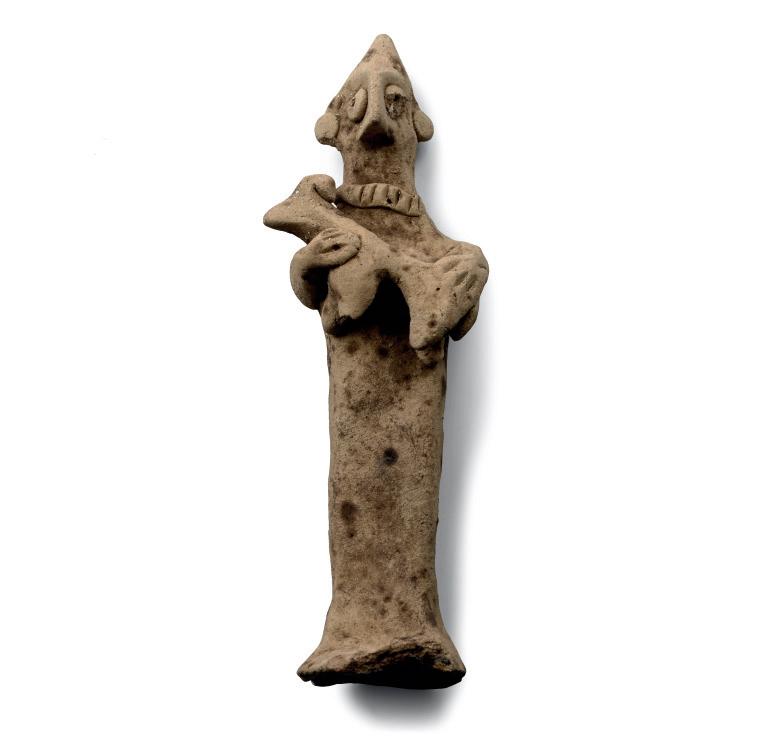
231
AMLASH TERRACOTTA ANIMAL BOWL
CIRCA 1100 B.C.
12½ in. (2.03 kg, 31.5 cm wide)
Comprising a broad bowl with pedestal base, the rim with three small lugged bowls, three horned bovine heads, two birds and a complete bovine; restored.
£800 - 1,000
PROVENANCE:
From a London gentleman’s collection, 2000s. Ex London, UK, gallery.
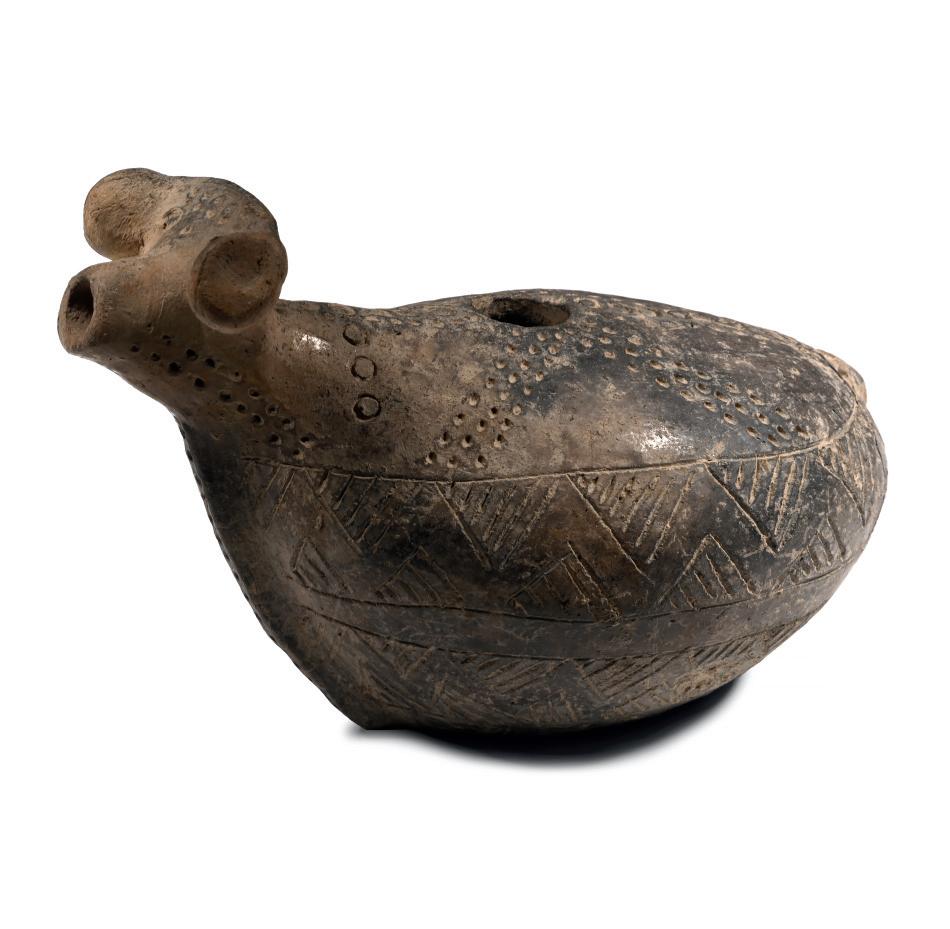
233

AMLASH TERRACOTTA SINGLE-HANDLED JUG WITH HEAD ATTACHMENT ‡
10TH-8TH CENTURY B.C.
8 in. (723 grams, 20.6 cm)
Comprising a rounded body resting on three stub legs; funicular mouth and short neck; beneath the rim a mask with pinched nose and two pointed ears, impressed circular eyes and mouth; three vertical decorative strips impressed with the same tool as formed the eyes and mouth; tiered strap handle with two finger-grips to the outer face and impressed detailing running from the neck to the shoulder; rim and one foot partly restored.
£800 - 1,000
PROVENANCE:
Ex Zackary, Los Angeles, 1960s. Thereafter London art market, 1992.
Accompanied by a copy of an Art Loss Register certificate no.S00079639.
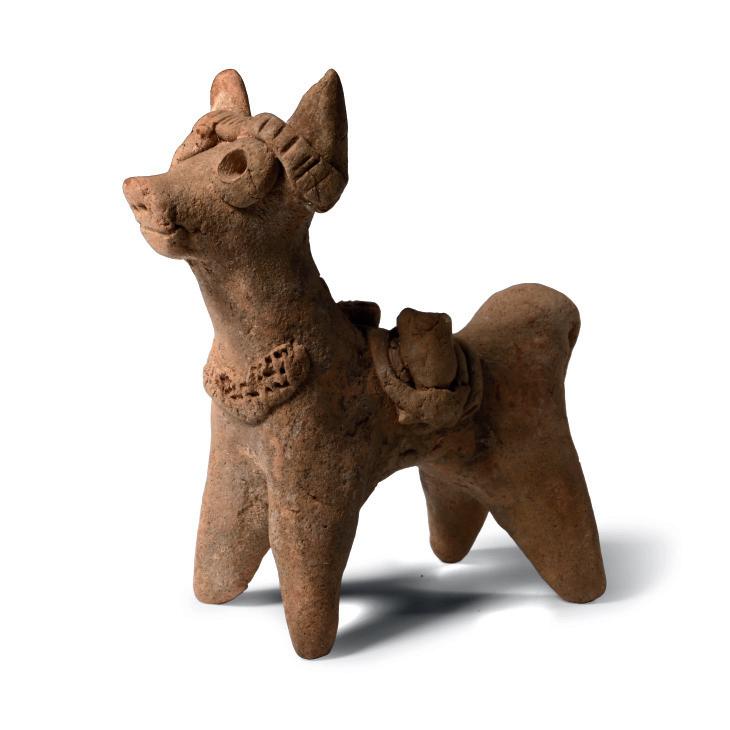
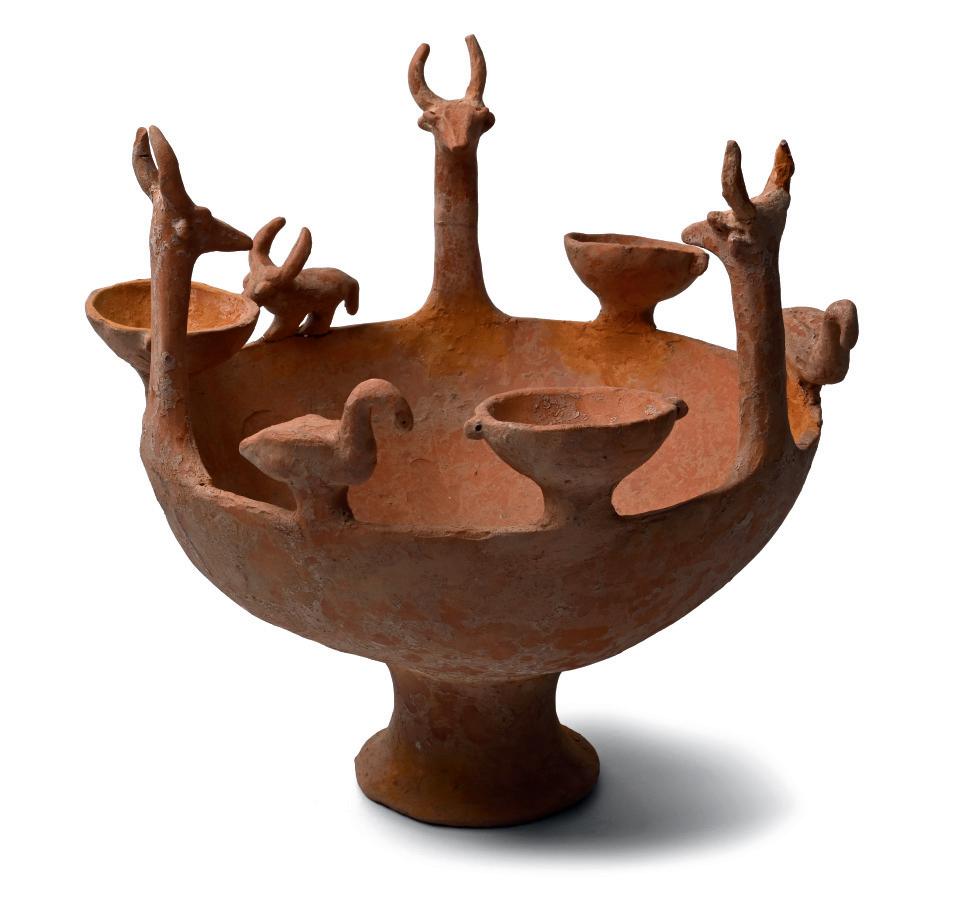
232
ANATOLIAN TERRACOTTA RAM RHYTON ‡
19TH-18TH CENTURY B.C.
8 in. (578 grams, 20.5 cm)
Ovoid in plan with ram-head finial and spout, filling-hole to the centre back and stub tail forming a handle; hatched panels to the sidewall with reserved running zigzag, radiating bands of impressed point ornament, head with forward-facing curled horns.
£2,500 - 3,500
PROVENANCE: with Artemis gallery, Münich. Acquired by the present owner from the above in 1992.
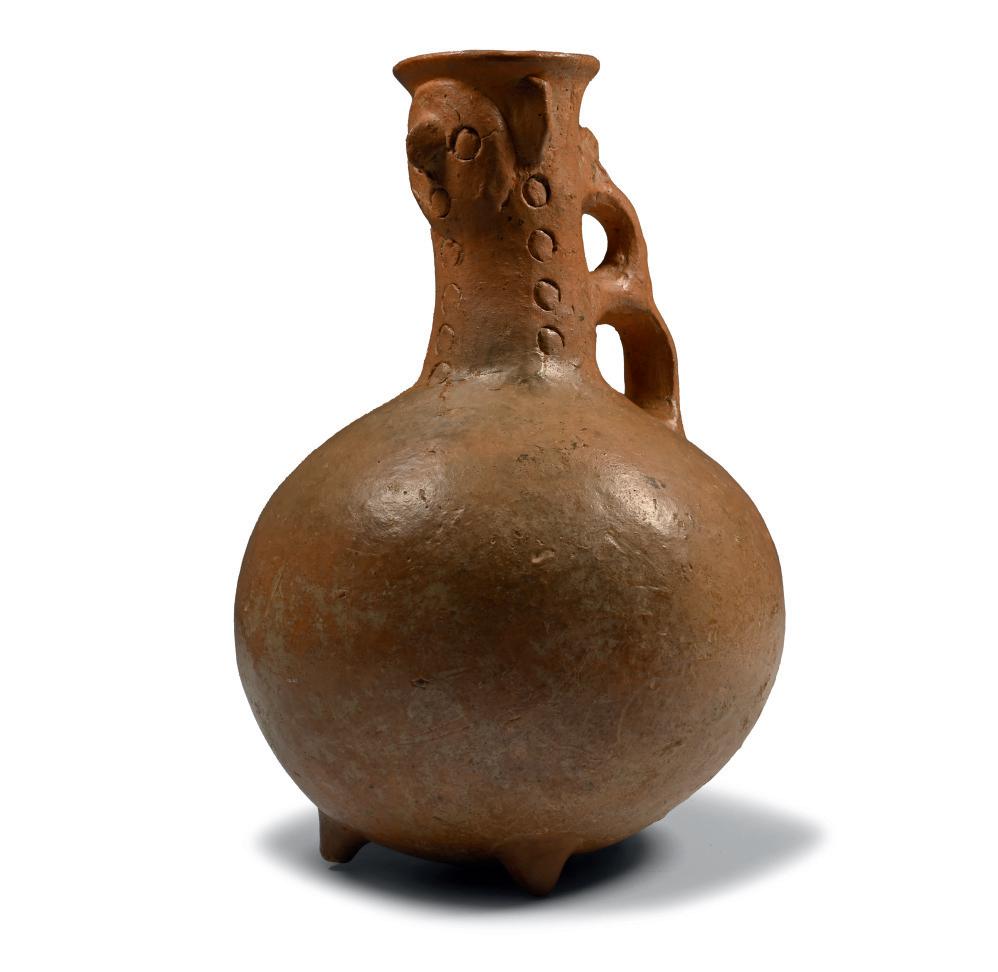
234
AMORITE TERRACOTTA SADDLED ANIMAL ‡ 1800-1600 B.C.
3¼ in. (88 grams, 85 mm)
Modelled in the round with halter to the chest, strap to the brow and saddle with two lateral containers and straps.
£600 - 800
PROVENANCE: Acquired in the mid 1980s-1990s. Private collection, Switzerland, thence by descent. Private collection, since the late 1990s.

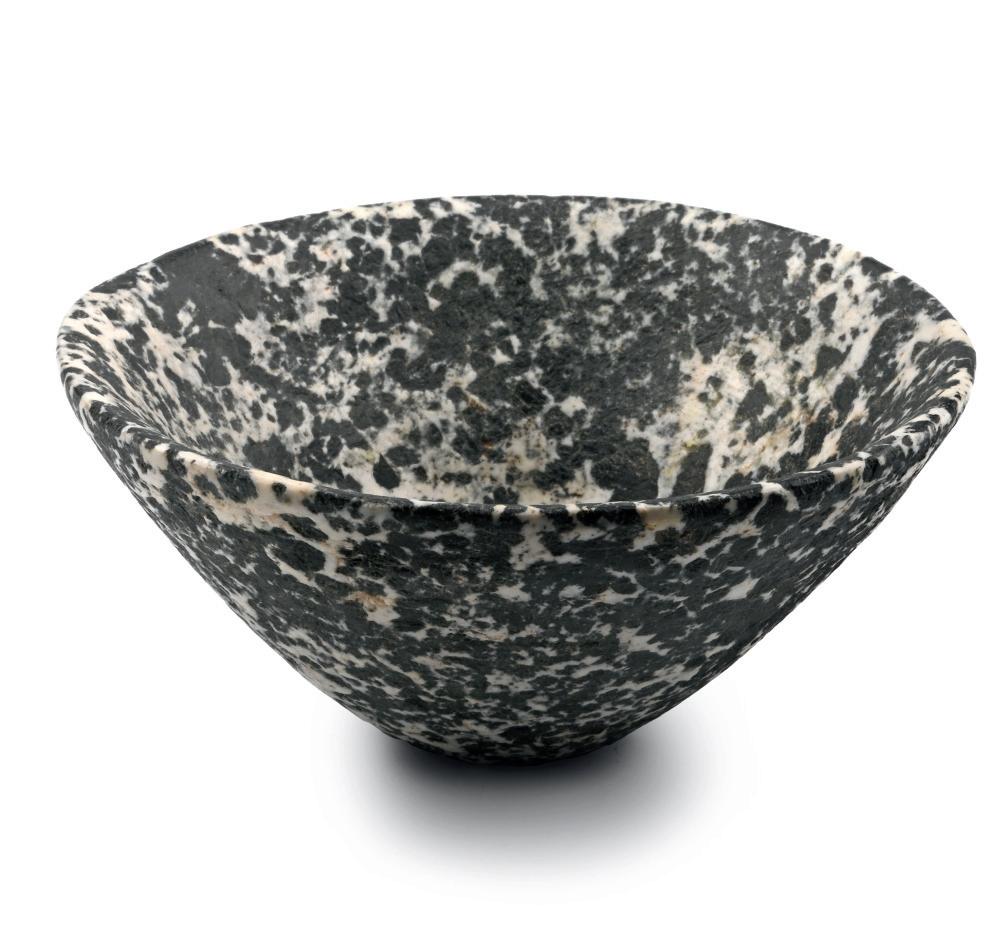
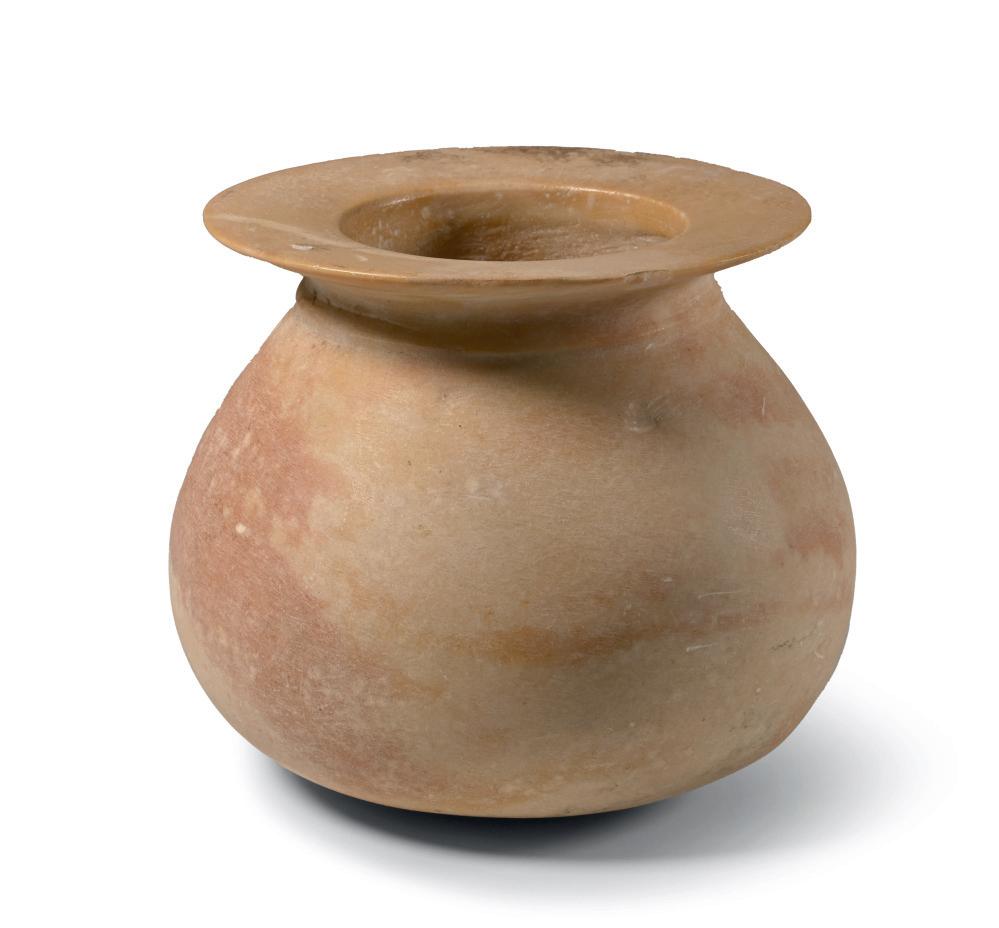

235
HITTITE LIMESTONE ALTAR ‡
2ND-1ST MILLENNIUM B.C.
10 in. (3.5 kg, 26.3 cm wide)
Carved from a limestone block with three trapezoidal stub legs, horizontal dished centre with notched edge to the raised rim and Usection pouring lip; panel of geometric linear ornament to the outer face of the body and legs; integral T-shaped reinforcing arms to underside.
£700 - 900
PROVENANCE:
Private collection, Israel. with Archaeological Centre, Auction 59, no.433.
Accompanied by a copy of the Archaeological Centre online catalogue page.
236
SUMERIAN ALABASTER BOWL ‡
3RD MILLENNIUM B.C.
6¼ in. (1.09 kg, 16 cm wide)
Conical with rounded rim and slightly rounded base.
£1,000 - 1,400
PROVENANCE:
Ex private collection, Contessa L.J., since the 1980s. Private collection, Switzerland, 2001.
237
SUMERIAN DIORITE BOWL ‡
4TH-3RD MILLENNIUM B.C.
4½ in. (362 grams, 11.6 cm wide)
Conical in profile with narrow base and rounded rim.
£800 - 1,000
PROVENANCE:
Ex private collection, Contessa L.J., since the 1980s. Private collection, Switzerland, 2001.
238
MESOPOTAMIAN BULBOUS MARBLE VASE ‡
4RD-3RD MILLENNIUM B.C.
5 in. (1.95 kg, 13.7 cm)
Squat-bodied with a broad, rounded shoulder and base, short neck and flat everted rim.
£1,500 - 2,000
PROVENANCE: with Gerhard Hirsch Nachf, Germany, Auction 238|239, February 2005, no.107. Acquired by the present owner from the above.
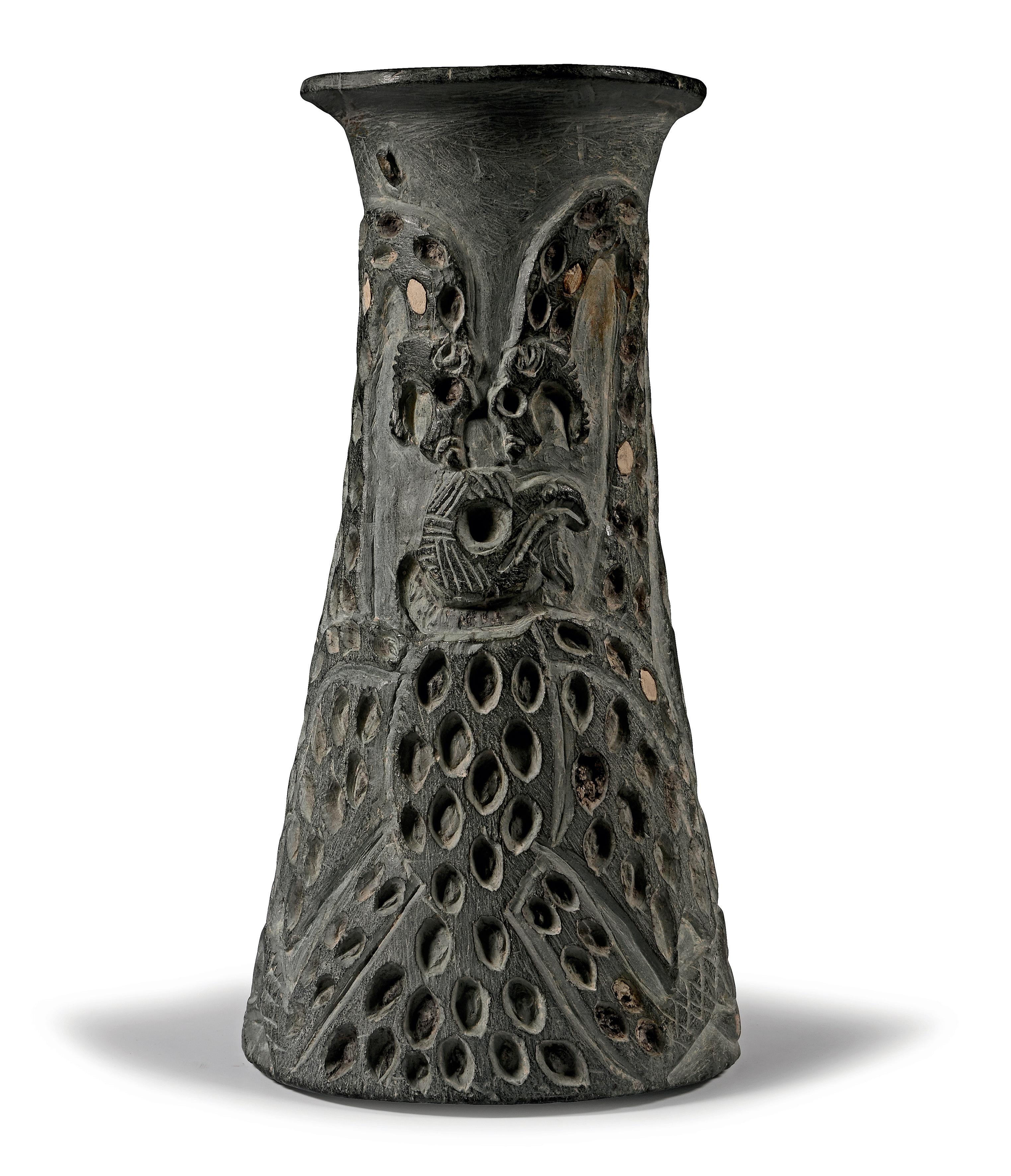

BACTRIAN CHLORITE VESSEL WITH OPPOSING SERPENTS
3RD MILLENNIUM B.C. 9 in. (2.3 kg, 23 cm)
With a frieze comprising an eagle with spread wings, two rearing lionheaded serpents above with open jaws; the bodies of the beasts with shallow sockets to accept inserts, some still present. [No Reserve]
£8,000 - 10,000
PROVENANCE: with Gallery Rosen Ancient Art, Tel Aviv, 1960s. Ex London, UK, gallery, 1971-early 2000s. London, UK, collection.
FOOTNOTES:
The chlorite stone vessels of early Bactria were kidney-shaped vessels with simple geometric decoration often representing snakes and other animals. Small cylindrical vases were used as cosmetic containers, together with chlorite cosmetic flasks. Interestingly the eyes and the bodies of the animals were destined to receive inlay, as can be seen on our specimen where some are still in situ.
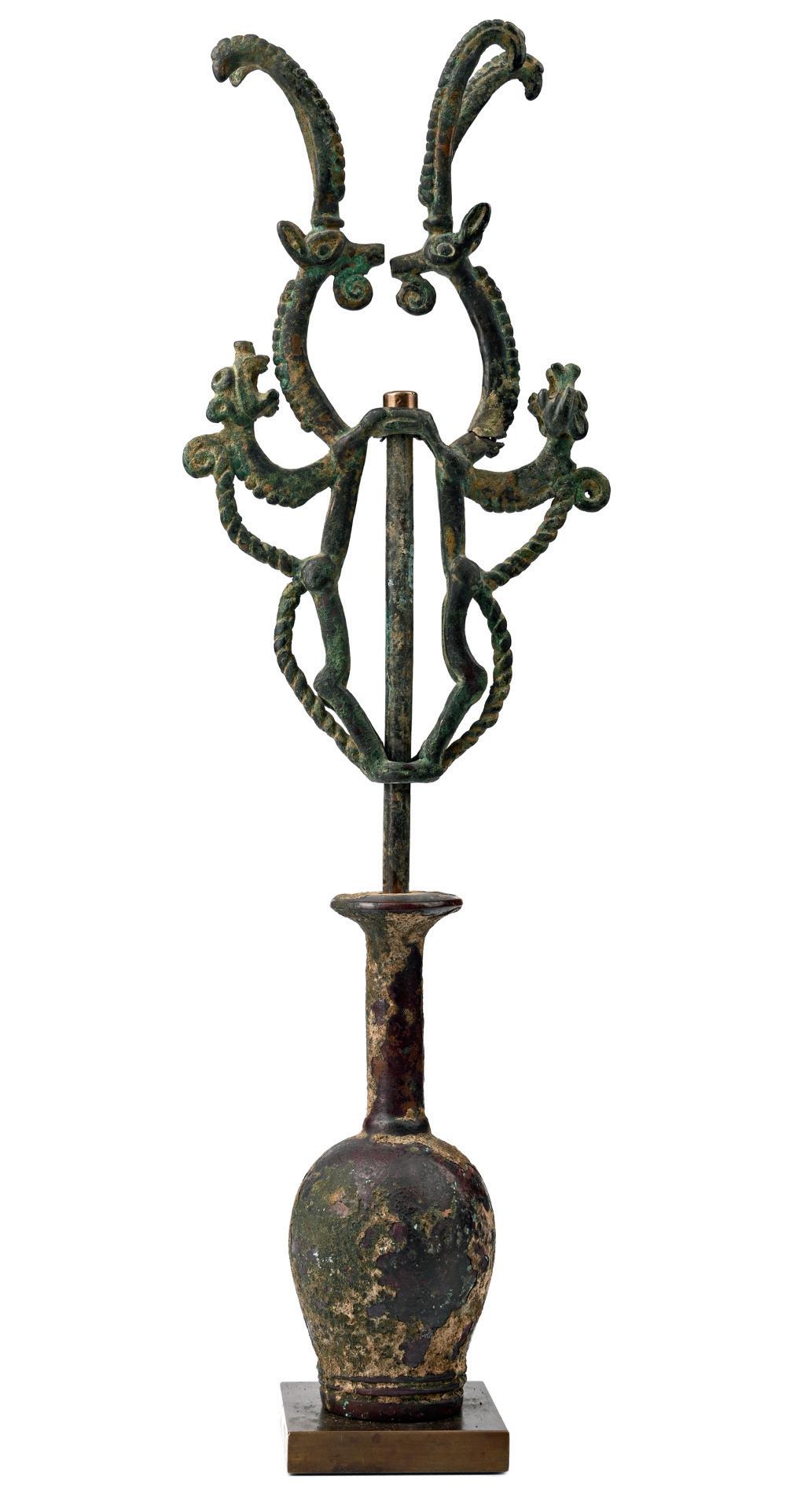
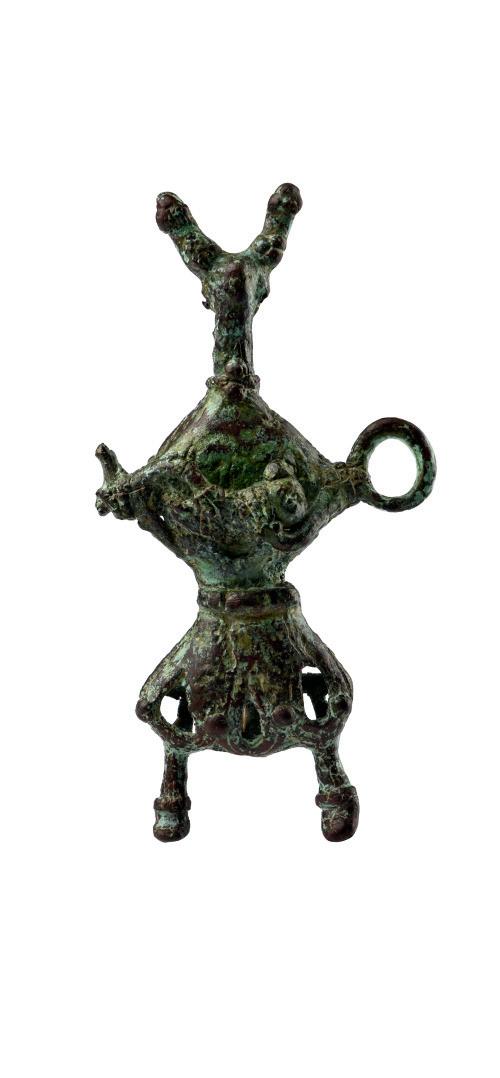
240
WESTERN ASIATIC BRONZE FINIAL WITH ANIMALS ‡ 1200-800 B.C.
14 in. (860 grams total, 36 cm including stand)
A bifacial sceptre head formed as a collared tubular stem with bulb foot; above, two opposed ibexes with segmented horns and coiled beards each attacked from behind by a mountain lion with gaping jaws, slender body and ropework tail; mounted on a custom-made stand.
£3,000 - 4,000
PROVENANCE: with Manouchehr Soleiman Aaron, Tehran, 1967. Brought to the U.S. prior to 1974. American private collection. with Christie’s, New York, 7 December 2011, no.16. European private collection.
241
AMLASH BRONZE FIGURE WITH CHILD ‡ 8TH-6TH CENTURY B.C.
4 in. (5 in.) (47 grams, 99 mm (90 grams total, 13 cm including stand))
Formed as a standing figure cradling an infant; stylised facial and anatomical detailing; openwork cage structure and remains of suspension loop to reverse; accompanied by a custom-made display stand.
£800 - 1,000
PROVENANCE: with Dr Amnon Rosenfeld, Jerusalem, Israel. European private collection, acquired in 2015.
242
AMLASH BRONZE FIGURE OF FERTILITY
13TH-12TH CENTURY B.C.
3½ in. (4 in.) (41 grams, 89 mm (74 grams total, 10 cm including stand))
Comprising: plaque formed as a facing figure holding a bird to the chest, cast with pellet detailing to the eyes, hair, belt and other features; loop to rear of neck and openwork cage to rear of chest; lateral loops to shoulders; mounted on a custom-made stand.
£800 - 1,000
PROVENANCE: with ArtAncient, 2010. Private collection, London, UK.
243
WESTERN ASIATIC ARAMAIC PENDANT SEAL MATRIX
MID 1ST MILLENNIUM A.D.
1 in. (10.77 grams, 24 mm)
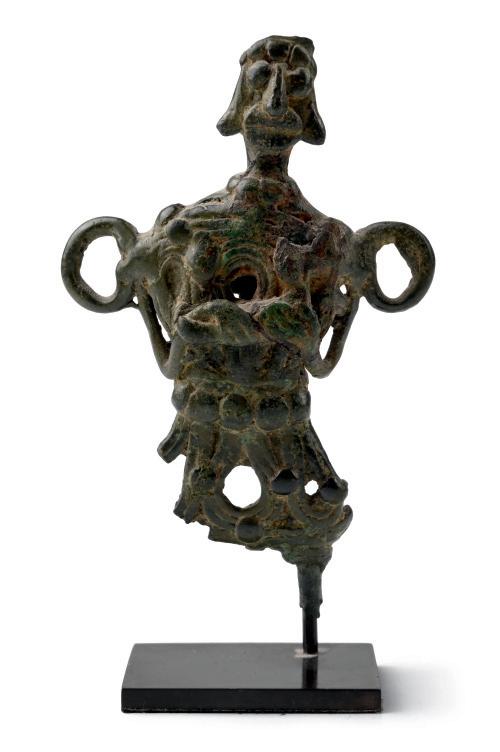
Discoid in plan with lug to upper face and suspension loop; underside with incuse pellets to the rim surrounding a tondo with two lines of incised text.
£1,800 - 2,400
PROVENANCE: From the collection of a gentleman, acquired on the London art market in the 1990s.
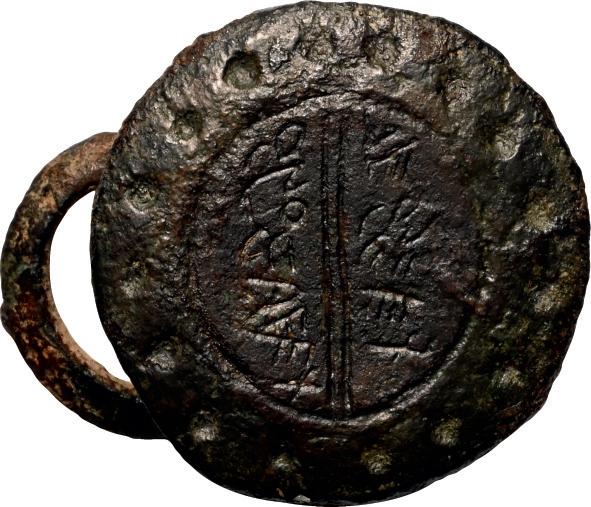


URARTU COPPER FIGURE OF A GODDESS ‡
8TH-7TH CENTURY B.C.
3 in. (3¾ in.) (115 grams, 76 mm (130 grams, 95 mm including stand))
Columnar in form with bulbous hairstyle descending to a tapering tail; stub arms to the sides and small right-angled feet; impressed herringbone texture to the hair; robe with hatched detailing to the collar, belt and hem, rosette and other detailing; supplied with a custom-made display stand.
£6,000 - 8,000
PROVENANCE:
Private collection, Europe. Acquired in 2003.
245

WESTERN ASIATIC BRONZE BOWL WITH DANCING FIGURES ‡ 1ST CENTURY B.C.-1ST CENTURY A.D.
6 in. (121 grams, 15.2 cm wide)
Hemispherical in profile with stepped inner rim above a repoussé frieze of horned monsters each wearing a kilt and linking hands with his neighbours; below, a bilinear band enclosing a bull-headed figure sitting with legs crossed on a rectangular mat(?).
£4,000 - 6,000
PROVENANCE: German private collection, 1990s. with Bonhams, London, 3 October 2000, no.338. Private collection, Europe.
246
BACTRIAN COPPER STANDING BULL 3RD-2ND MILLENNIUM B.C.
4 in. (4 in.). (215 grams, 11.1 cm wide (357 grams total, 11.7 cm including stand))
Figure of a zebu standing with head raised, dewlap to the chin and chest, angled hump behind the shoulders; mounted on a custommade stand.
£1,500 - 2,000
PROVENANCE: Acquired before 1972. with a London, UK gallery.
247

URARTIAN BRONZE RECUMBENT BULL
8TH-7TH CENTURY B.C.
4½ in. (485 grams, 11.4 cm)
Hollow-formed figure of a bull resting with its legs folded beneath its body, head turned; on a stepped rectangular base.
£1,500 - 2,000
PROVENANCE: Nicolas Koutoulakis (1910-1996), thence by descent. Ex Galerie Dominique Thirion, Brussels, Belgium. Private collection of Mr K.A.
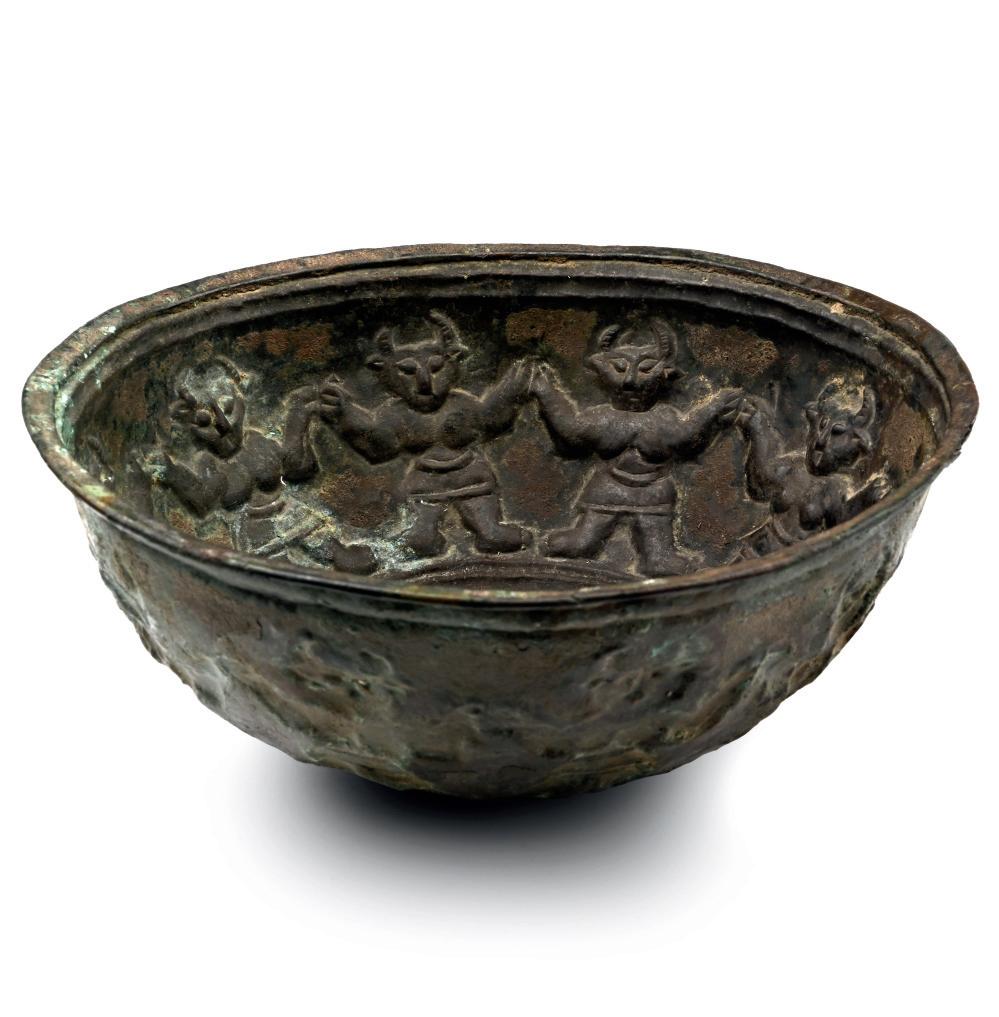
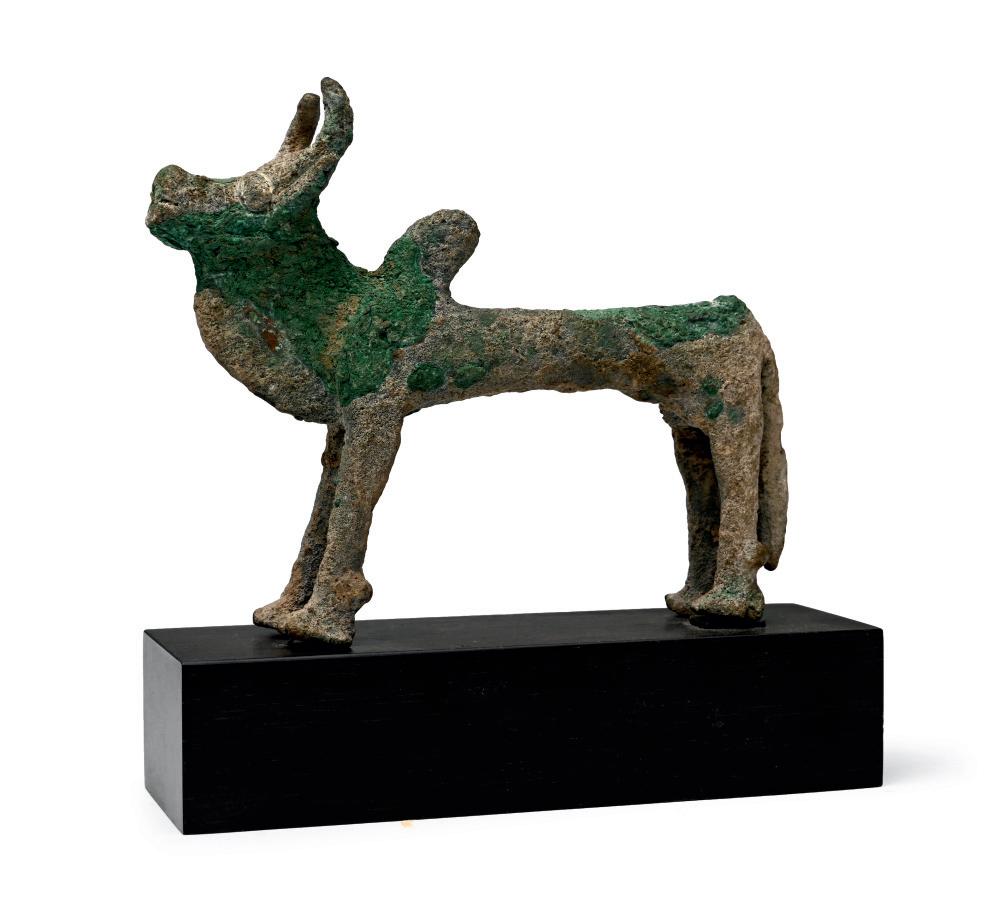
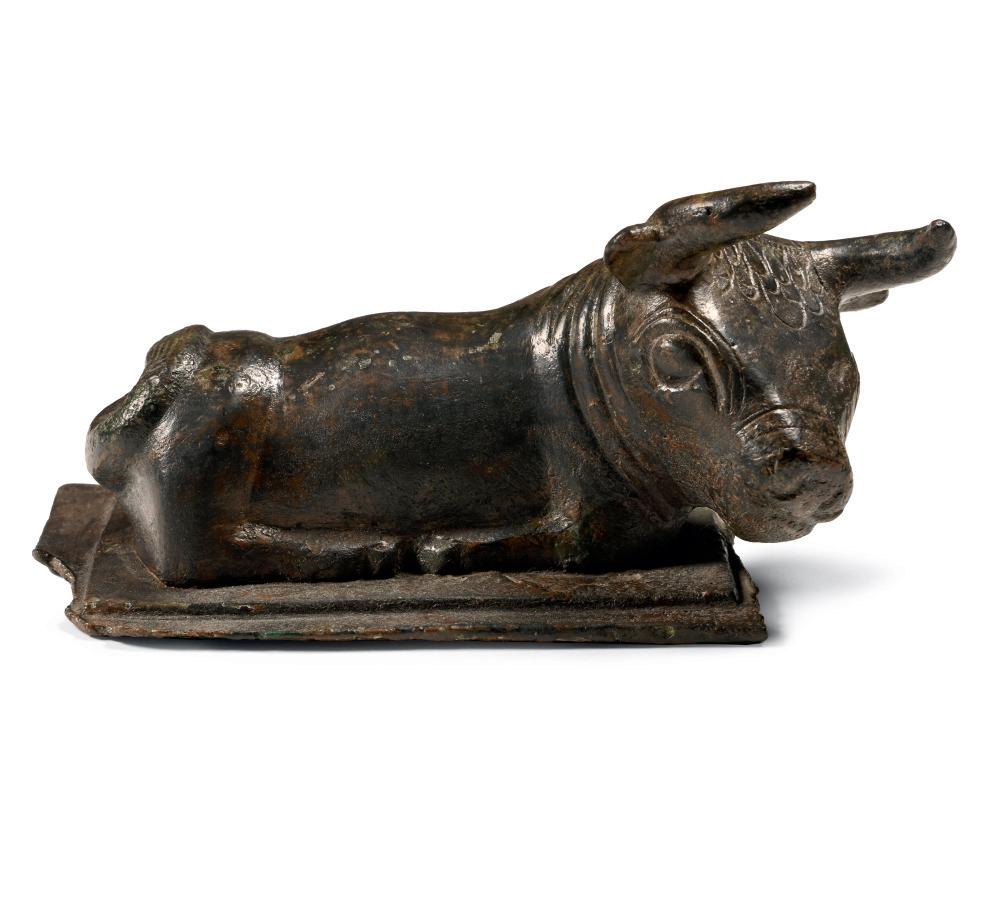
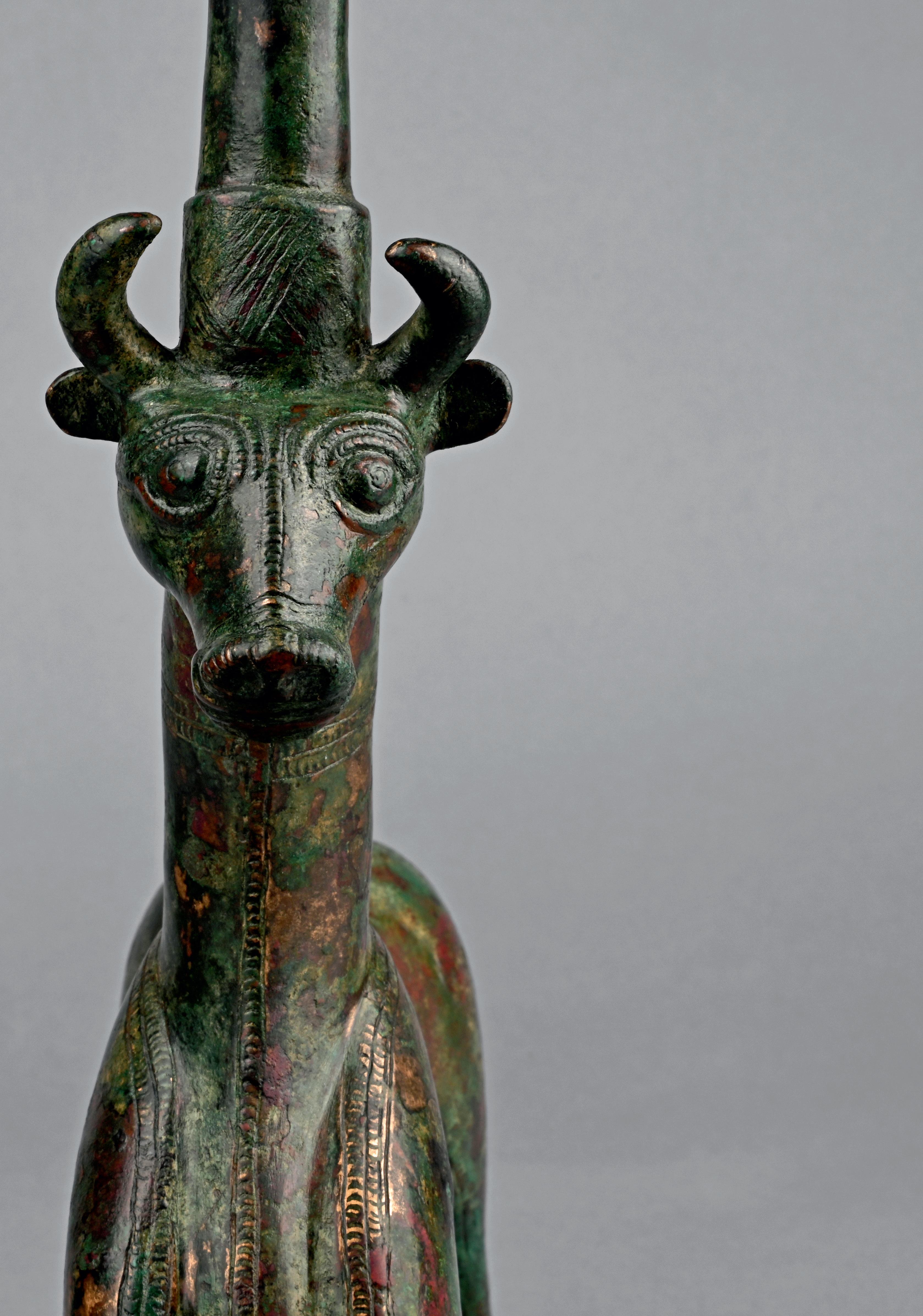
248

LARGE MESOPOTAMIAN BRONZE TORCH BEARER
EARLY DYNASTIC PERIOD II, MID 3RD MILLENNIUM B.C.
16 in. (3.44 kg, 42.8 cm)
Depicting a bull standing with legs splayed and firmly planted, tail extending to the ground, billetted bands to the neck, chest, shoulders, rump and hips, rosette sun wheel to each shoulder and hip; mounted on the brow a tubular socket, extended stem with three median collars, and three more at the top; three radiating feline figures each supporting a post with gusseted ring above.
£70,000 - 90,000
PROVENANCE:
Acquired before 1983.
Ex London gallery, 1990s. Private collection, London.
FOOTNOTES:
The artefact belongs to a series of bronze works attesting the wide regional trade existing in the mid to late 3rd millennium B.C. in the Mesopotamian lands. They were realised with human or animal figures planted on a rectangular stand with a massive armature or candelabra issuing from the back.

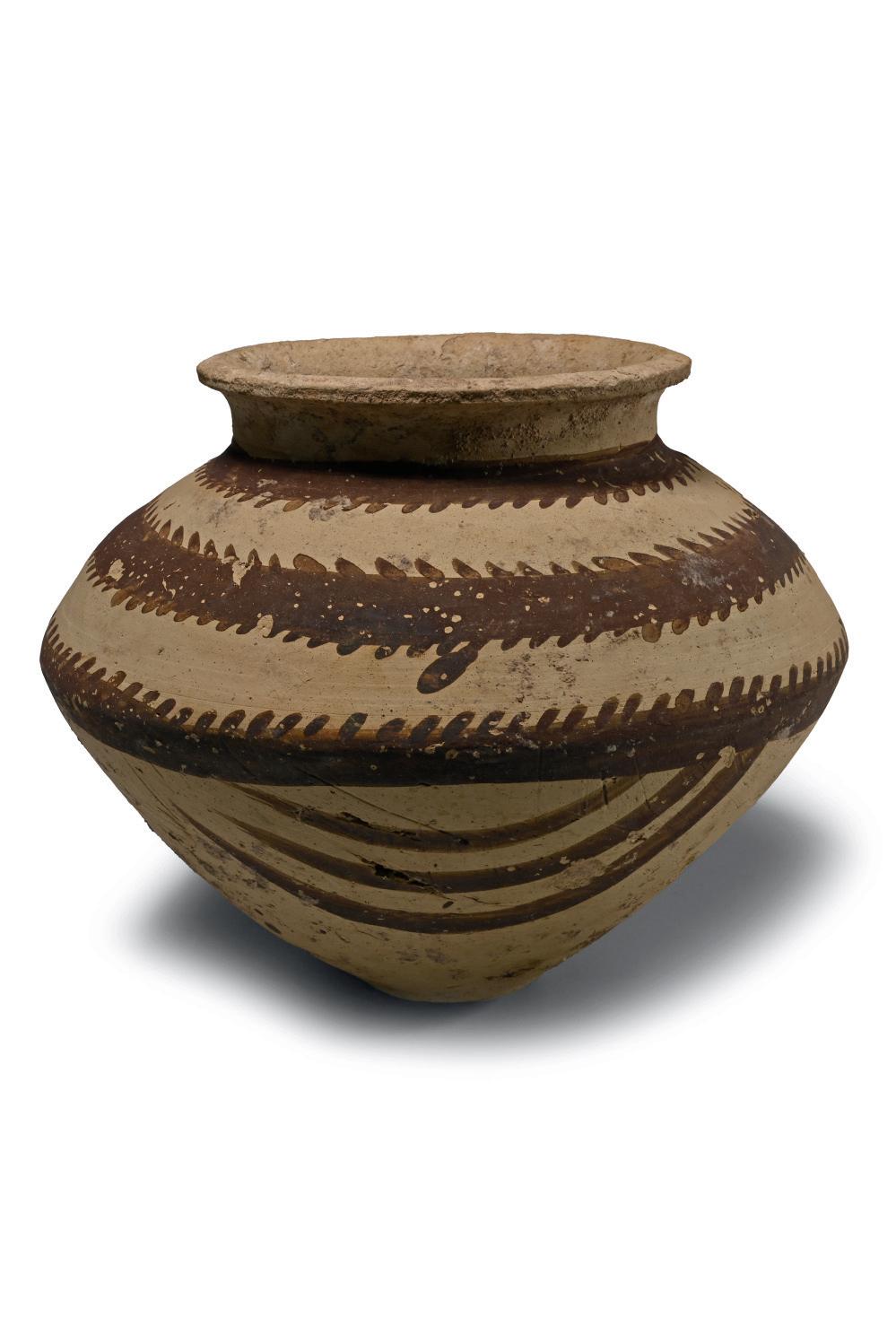
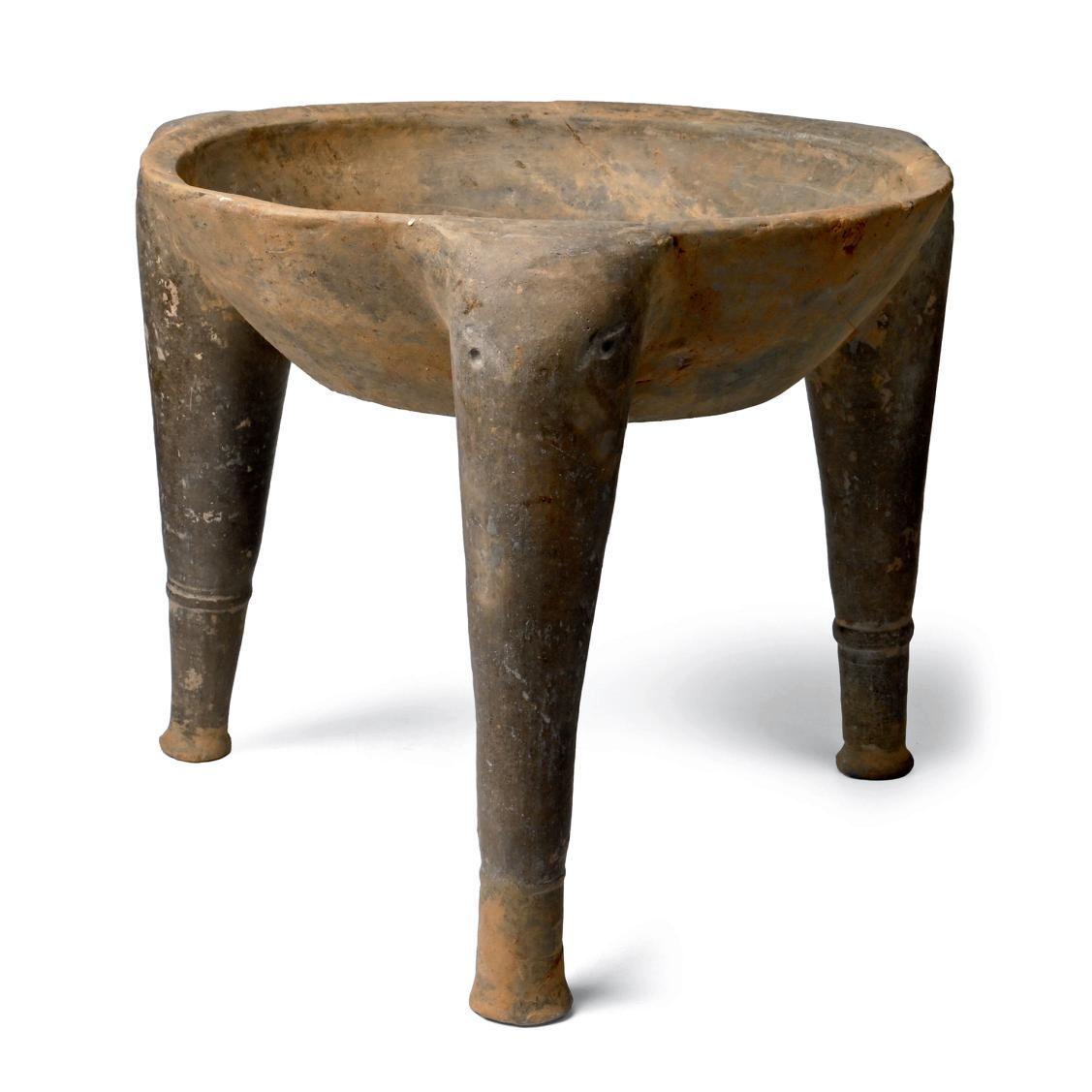

249
TELL HALAF PAINTED TERRACOTTA VESSEL ‡
2900-2500 B.C.
7 in. (712 grams, 18 cm wide)
Biconical in profile with narrow base, broad shoulder and everted flared rim; painted concentric herringbone band to the shoulder and swags beneath.
£1,500 - 2,000
PROVENANCE: Acquired in the mid 1980s-1990s.
Private collection, Switzerland, thence by descent. Private collection, since the late 1990s.
250
AZERBAIJAN HASANLU TEPE POTTERY VESSEL
1ST MILLENNIUM B.C.
14 in. (5.45 kg, 36 cm)
Comprising a broad hemispherical bowl with single lug to the rim, columnar body with four bands of impressed teardrop and other motifs; gusseted band below and three radiating scooped legs supported by an integral median ring.
£2,000 - 3,000
PROVENANCE: with Mahboubian Gallery, London, UK, 1974.
251
WESTERN ASIATIC TERRACOTTA TRIPOD VESSEL WITH ELEPHANTS
2ND MILLENNIUM B.C.
12¼ in. (2.9 kg, 31 cm wide).
With gently rounded and tapering sidewall to the shallow bowl, three integral tapering legs formed as stylised elephant-heads each with a long trunk and simple facial detailing; the flared ends of the trunks forming splayed feet.
£700 - 900
PROVENANCE: with a London, UK gallery 1971-early 2000s.
Accompanied by an original thermoluminescence analysis report no.N123k2 from Oxford Authentication.

10 in. (718 grams, 25.5 cm)
With trumpet-shaped broad end, tapering sidewalls and thick pierced finial; mounted in a custom-made wooden case.
£10,000 - 14,000
PROVENANCE: Japanese private collection, prior 1979. with Aaron Gallery, Iran, prior 1970. with Aaron Gallery, London, 19 September 1980.
LITERATURE:
Cf. a similar Sassanian Rython, but in embossed and in silver, in Carter, Martha L. ‘Three Silver Vessels from Tibet's Earliest Historical Era: A Preliminary Study’ in Cleveland Studies in the History of Art. 3 (1998) 22-47. figs. 1, 5a-9c.
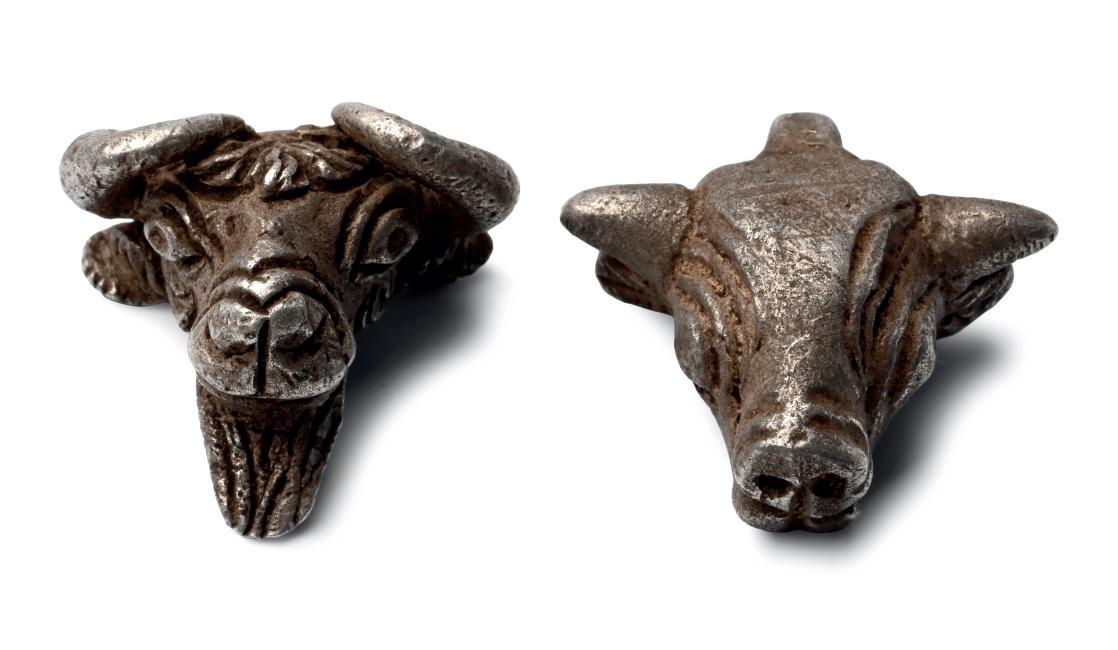

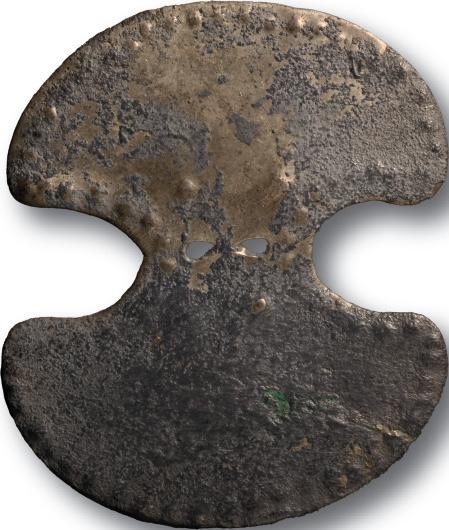

253
PROTO-ELAMITE SILVER BOVINE HEAD MOUNTS
EARLY 3RD MILLENNIUM B.C.
¾ in. (22.5 grams total, 18-20 mm)
A pair of mounts formed as a bull and a cow with incised details to the face; bull with beard and hair detail, cow with curved attachment hook to the top. [2]
£1,200 - 1,700
PROVENANCE:
UK private collection before 2000. Acquired on the UK art market. Private collection, London, UK.
254
WESTERN ASIATIC TWISTED SILVER BRACELET PAIR ‡
10TH-12TH CENTURY A.D.
3 in. (259 grams total, 75-78 mm)
Each a penannular round-section band with a twisted filigree band coiled around the shank; clubbed finials, one with closure clip fitting.
£800 - 1,000
PROVENANCE:
Acquired in the mid 1980s-1990s.
Private collection, Switzerland, thence by descent.
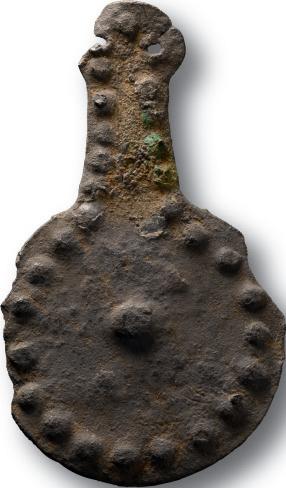

Private collection, since the late 1990s. 255
EARLY BRONZE AGE SILVER IDOL
CIRCA 2400-2100 B.C.
2½ in. (17.88 grams, 64 mm)
Of unusual double pelta type, symbolising a female human body, embossed dots to the perimeter and two holes to the centre.
£2,000 - 3,000
PROVENANCE:
From a private family collection formed since the early 19th century, thence by descent.
Property of a New Zealand legal professional.
256
EARLY BRONZE AGE SILVER IDOL
CIRCA 2400-2100 B.C.
2½ in. (5.34 grams, 62 mm)
Violin-shaped with round body, long neck and stylised head, symbolising a female body, perforated with two holes at the top representing the eyes, embossed with dots around the perimeter.
£1,200 - 1,700
PROVENANCE:
From a private family collection formed since the early 19th century, thence by descent.
Property of a New Zealand legal professional.
257

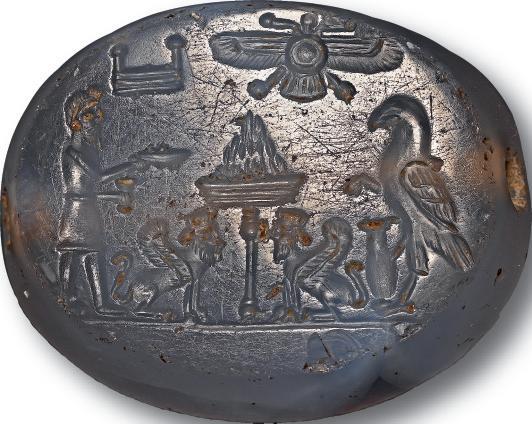
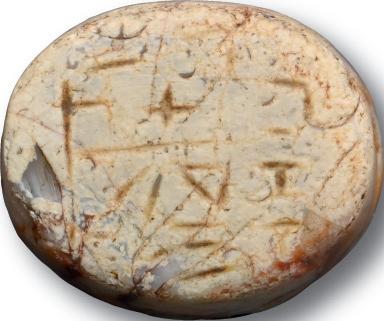


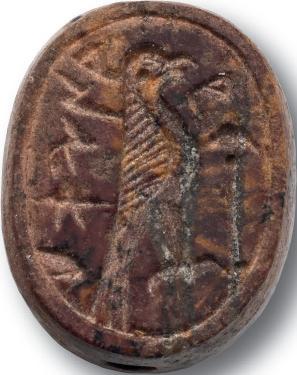

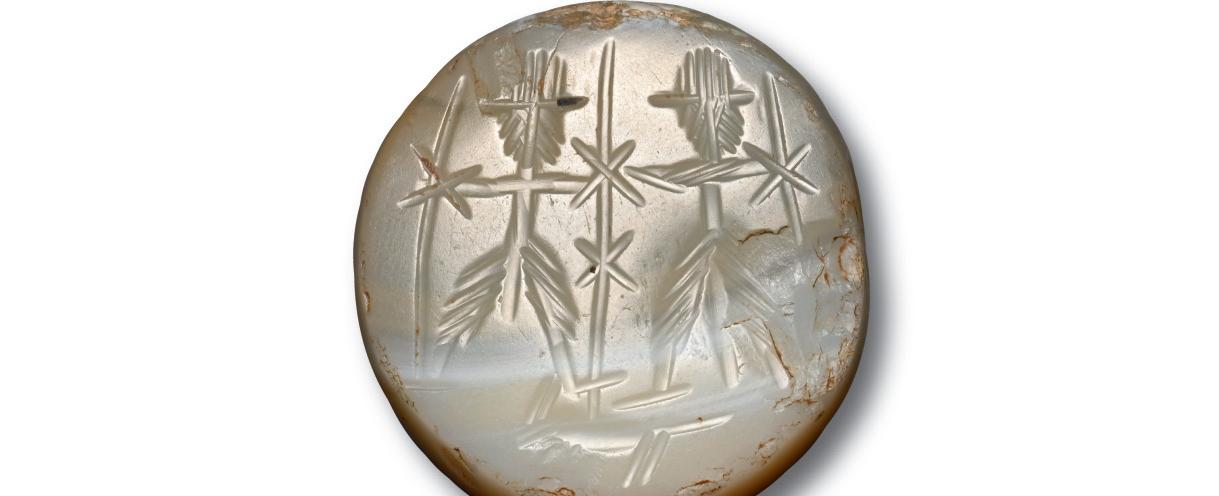
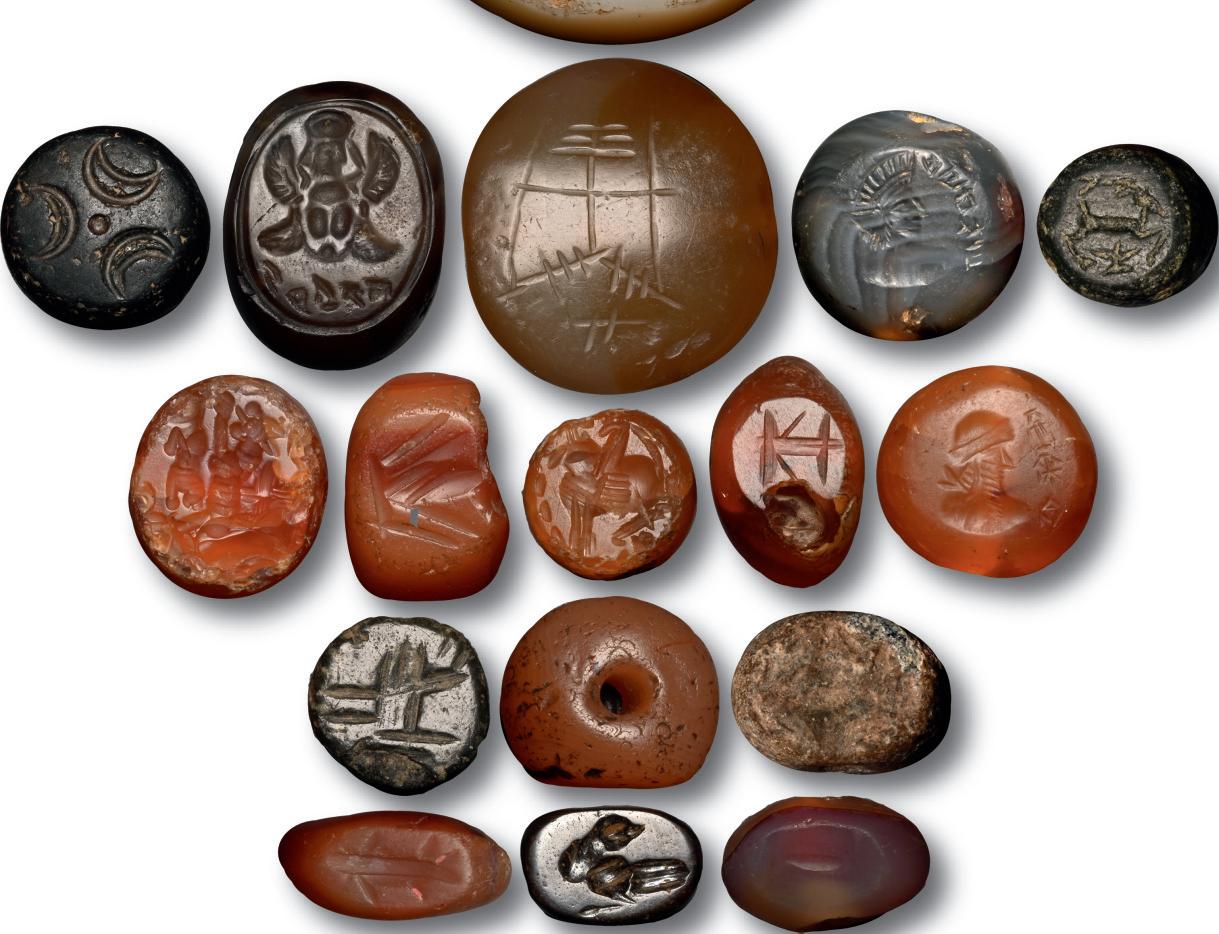

259
ACHAEMENID CHALCEDONY STAMP SEAL
CIRCA 530 B.C.
1¼ in. (18.4 grams, 32 mm)
Ellipsoid in plan and plano-convex in section, reverse with invocation scene: on a baseline a kilted figure advancing towards an altar with flames, holding a cup and a plate; altar flanked by two crouching winged bulls with human heads; perching eagle to right with amphora; above a winged sun-disc and rectangular object; supplied with a museum-quality impression.
£4,000 - 6,000
PROVENANCE:
From the Fadel family collection, London, UK, 1970s.
FOOTNOTES:
The seal shows elements belonging to the period of the Achaemenid dynasty: the winged solar disc, symbol of the supreme god, Ormadz; the fire altar in the centre, a typically Zoroastrian element. The costume of the offerant is also decidedly Persian, with a short tunic at the knees and trousers of the saravara type.
258
WESTERN ASIATIC STONE SCARABOID WITH ARAMAIC INSCRIPTION
LATE 1ST MILLENNIUM B.C. in. (3.42 grams, 17 mm)
With deep sidewall, underside with three lines of lightly incised text; supplied with a museum-quality inscription.
£500 - 700
PROVENANCE: From the collection of a gentleman, acquired on the London art market in the 1990s.
ARAMAIC STONE INSCRIBED SCARABOID SEAL
6TH-4TH CENTURY B.C. in. (2.83 grams, 16 mm)
Intaglio perching bird to underside with legend.
£1,000 - 1,400
PROVENANCE: Ex London, UK, gentleman 1980-1990s.
260
SASANIAN STONE STAMP SEAL COLLECTION
5TH-7TH CENTURY A.D. - 1 in. (124 grams total, 11-36 mm)
Comprising mainly plano-convex types in carnelian and other materials with various symbols and designs, some with Pahlavi legends. [17]
£1,800 - 2,400
PROVENANCE: UK private collection before 2000. Acquired on the UK art market. Private collection, London, UK.
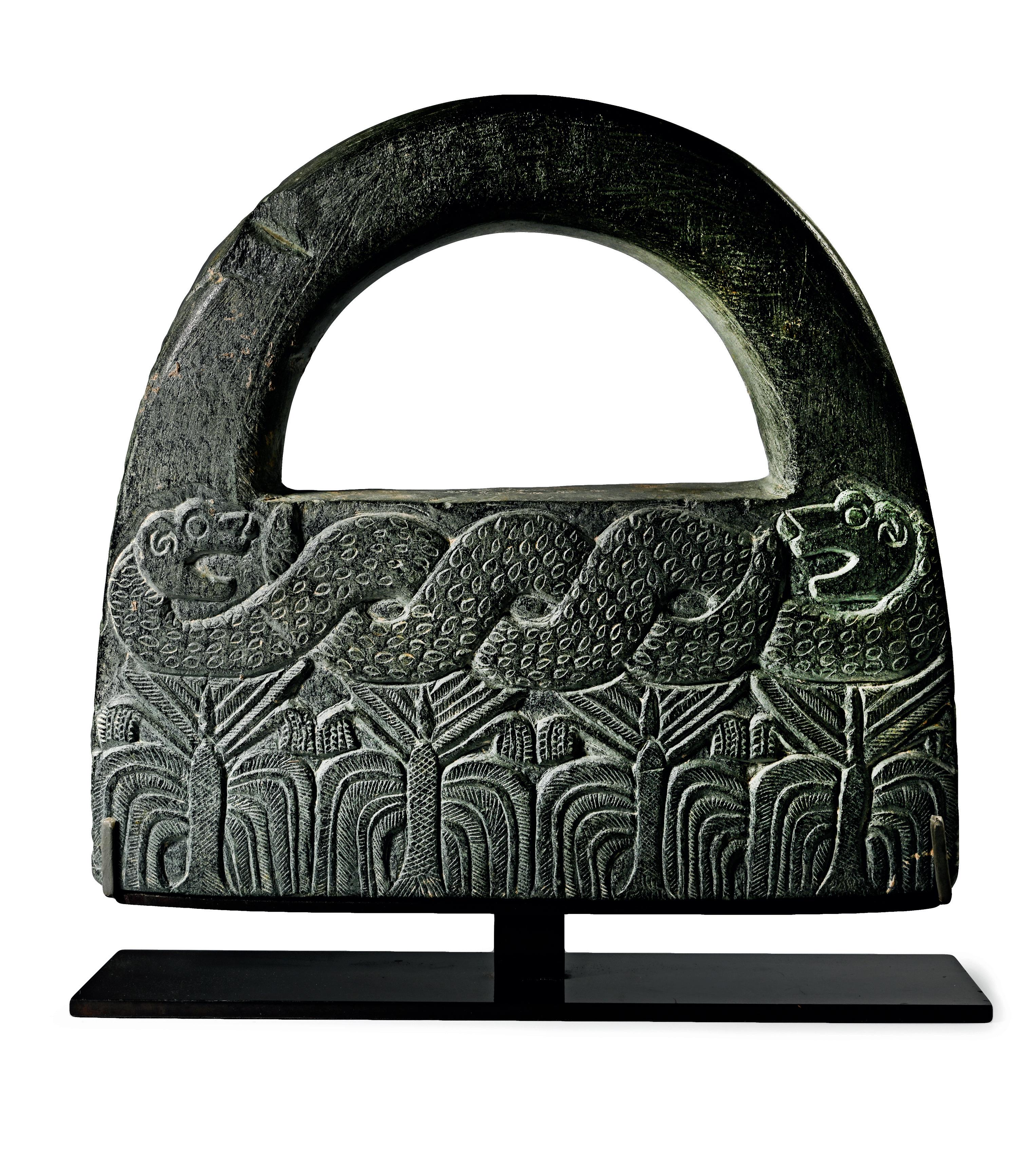

LARGE BACTRIAN BLACK CHLORITE ‘HAND BAG’ CEREMONIAL WEIGHT
3RD MILLENNIUM B.C.
9½ in. (10 in.) (4.8 kg total, 24 cm high (27 cm including stand))
D-shaped in profile with void below the curved edge, obverse with reserved serpents above a frieze of trees; reverse with rearing serpents above geometric panels; mounted on a custom-made stand. [No Reserve]
£15,000 - 20,000
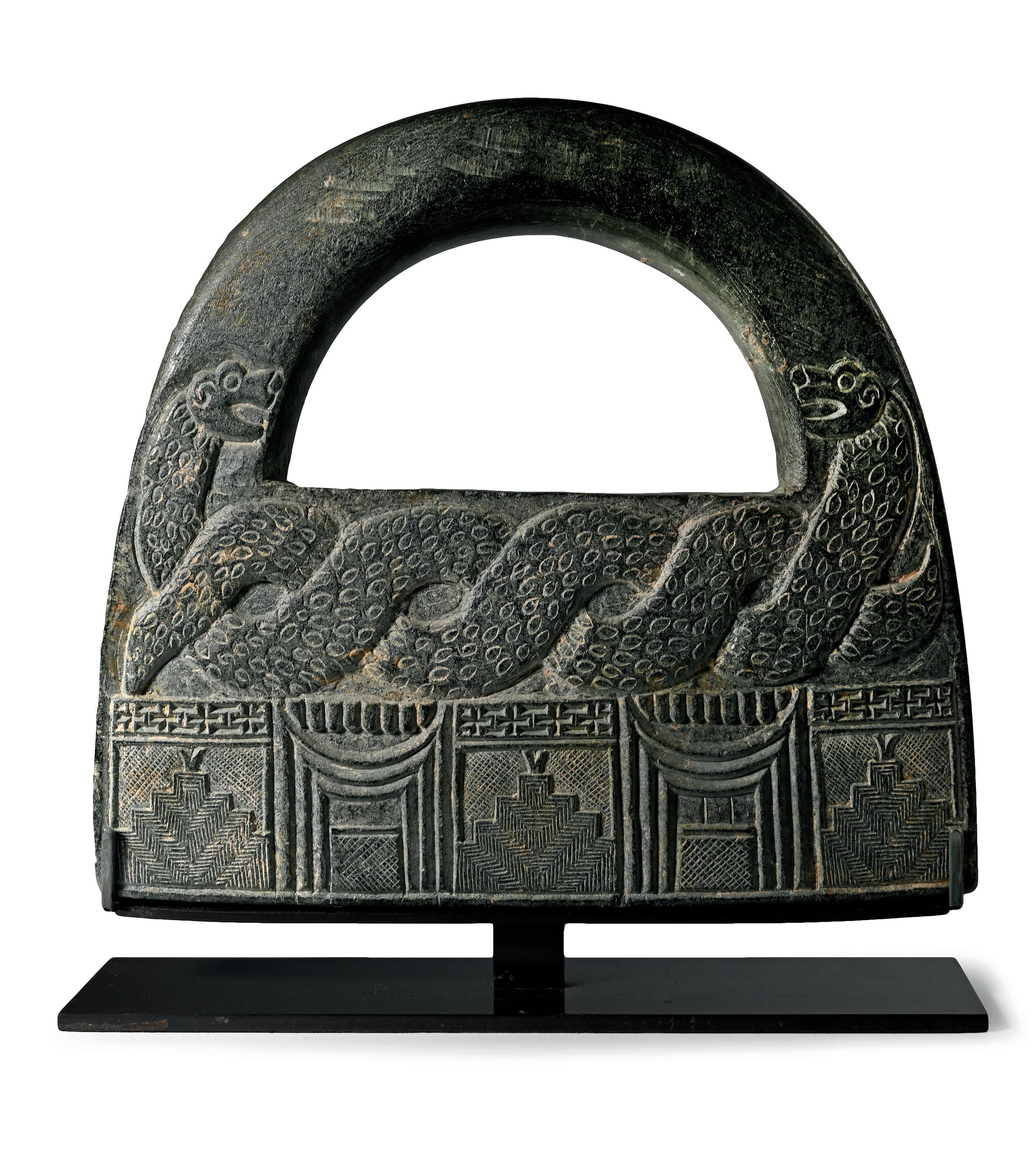
PROVENANCE: with Gallery Rosen Ancient Art, Tel Aviv, 1968. Ex London, UK, gallery, 1971-early 2000s. London, UK, collection.
Accompanied by a copy of an original invoice from Gallery Rosen Ancient Art, 25 December 1968.
FOOTNOTES:
The object could have been carried or swung in ceremonies or processions. This is also suggested by the side in which the snakes overlook buildings of a religious place, which have the clear structure of the Ziggurats, while other sections are representing the doors of a temple.
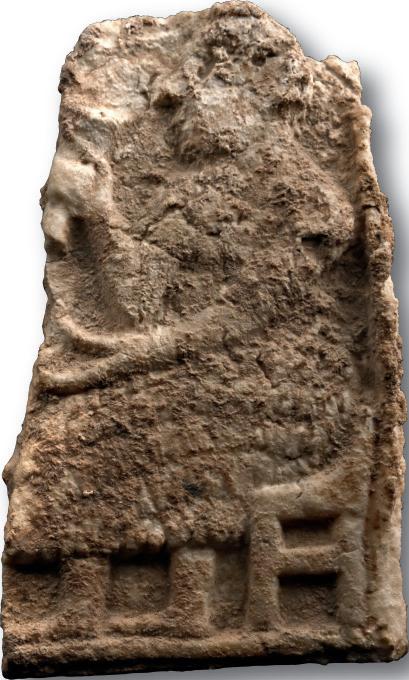

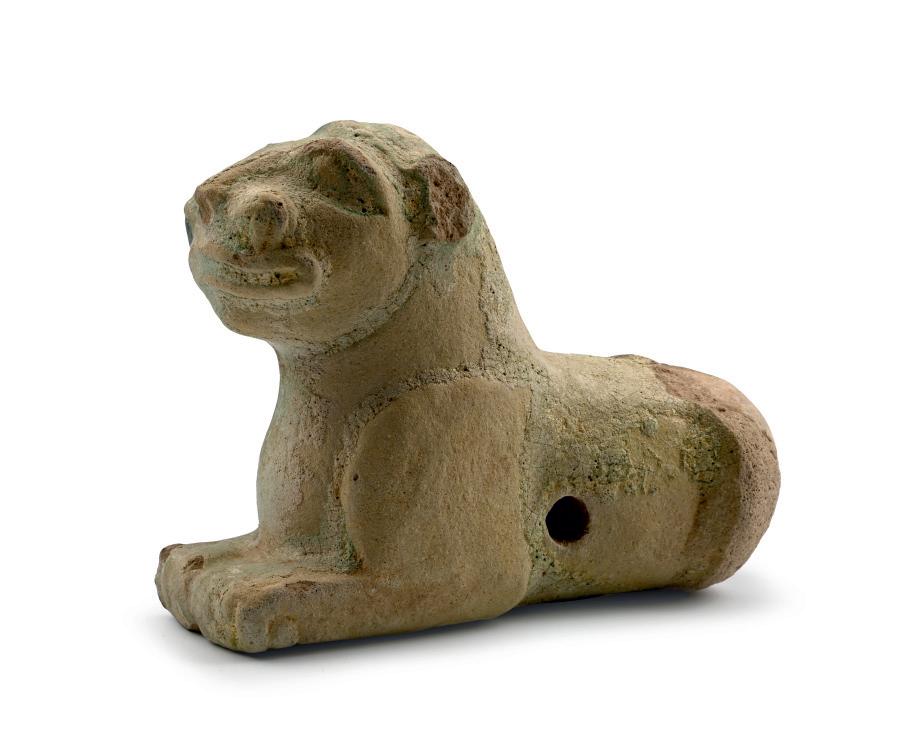


262
SUMERIAN ALABASTER PLAQUE WITH SEATED MAN ‡ CIRCA 2800-2600 B.C.
3¾ in. (108 grams, 94 mm)
Rectangular fragment with border to right and bottom edges; scene with reserved figure in profile sitting on a framed chair wearing a flounced garment and taking or holding a drinking horn in one hand, the other resting on his leg.
£1,000 - 1,400
PROVENANCE:
Private collection, Contessa L.J., since the 1980s. Private collection, Switzerland, 2001.
263
ZIWIYE FAIENCE LION FIGURINE
8TH-7TH CENTURY B.C.
5½ in. (603 grams, 14.1 cm)
Modelled in the round, foreparts and head of a crouching lion with head erect; pierced behind the shoulders, tubular body to rear.
£1,500 - 2,000
PROVENANCE:
Atigh Gallery, UK. with Aaron Gallery, acquired from the above on 23 February 1984.
264

SASANIAN CUT GLASS BOWL
5TH CENTURY A.D.
3¾ in. (192 grams, 97 mm)
Translucent and U-shaped in cross-section, graduated decorative wheel-cut facets on a lattice arrangement.
£3,000 - 4,000
PROVENANCE: London art market, 1989. Private collection, London.
265
MESOPOTAMIAN STONE ANIMAL-HEADED IMPLEMENT
3RD-2ND MILLENNIUM B.C.
6 in. (42.4 grams, 15.1 cm)
Square-section long body with rounded edges, tapered and flattened to one end; stylised zoomorphic finial to the other end with one white eye inlay, pierced for suspension.
£600 - 800
PROVENANCE: From an important collection pre 1988. From a private UK collection.
266
ANATOLIAN BLACK STONE IDOL ‡
3RD MILLENNIUM B.C.
4 in. (156 grams, 10.1 cm)
Carved in the half-round with hatched detailing to the tunic and belt, discoid head with reserved annulet eyes and trapezoidal nose, lateral stub ears.
£4,000 - 6,000
PROVENANCE:
Ex Swiss European collection, 1980s. Private collection, 1994. Private collection, since the late 1990s.
267
SUMERIAN GREEN STONE AMULET ‡
4TH MILLENNIUM B.C.
1 in. (13.2 grams, 41 mm)
Carved in the round as a rectangular block with slit to upper edge, vertical spike with two annulet ‘eyes’; pierced for suspension.
£3,500 - 4,500
PROVENANCE: with M. Petropoulos, Zurich, early 1990s. with Rhéa gallery.
Private collection, acquired in 1999.
268
ANATOLIAN OBSIDIAN IDOL ‡
5TH-4TH MILLENNIUM B.C.
1¾ in. (48.4 grams, 46 mm)
Squat and rounded in profile with hands resting on the knees.
£800 - 1,000
PROVENANCE:
Private collection, Austria. Private collection, Europe.
269
NEO-BABYLONIAN AGATE DUCK WEIGHT COLLECTION ‡
700-600 B.C.
- in. (6.67 grams total, 17-22 mm)
Each carved in the round as a duck with its head laid back along its spine. [2]
£1,000 - 1,400
PROVENANCE:
Private collection, Israel. with Holy Land House of Antiquities, Jerusalem, 1990s. Private European collection, acquired from the above in 2001.
270
NEO-BABYLONIAN AGATE DUCK WEIGHT ‡
700-600 B.C.
1 in. (4.76 grams, 23 mm)
Carved in banded agate so that the head and upper back are in opaque white stone, the rest in translucent orange-tan stone.
£1,000 - 1,400
PROVENANCE: Acquired in 1996.
Private collection, Switzerland, thence by descent. Private collection, since the late 1990s.

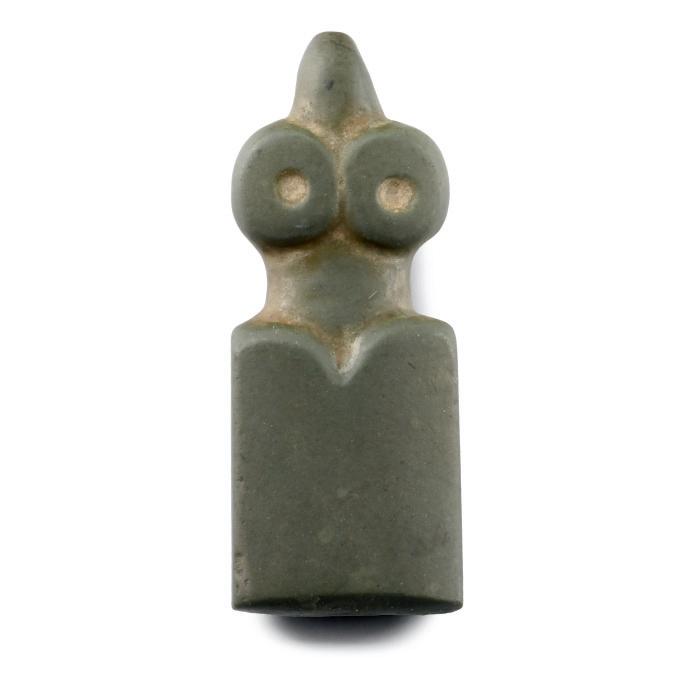
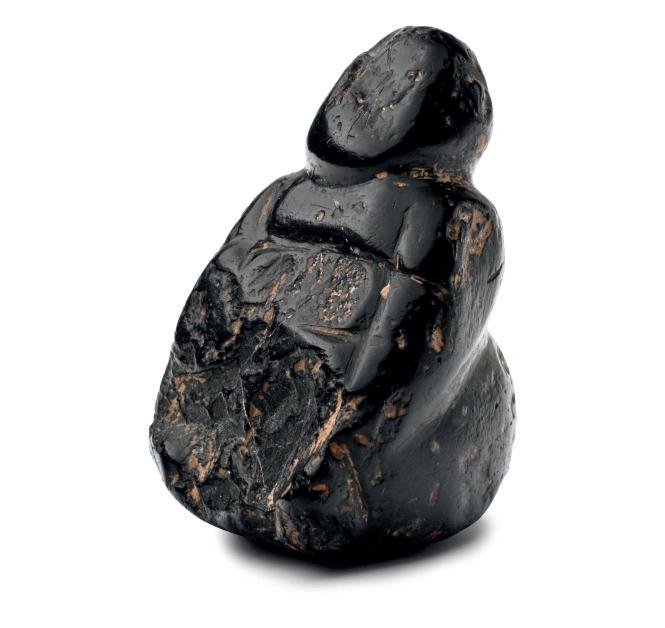
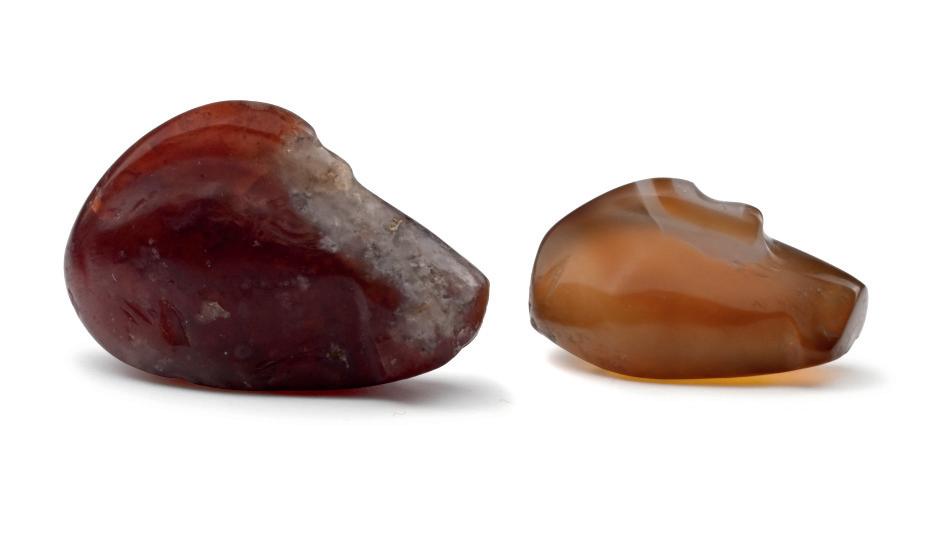
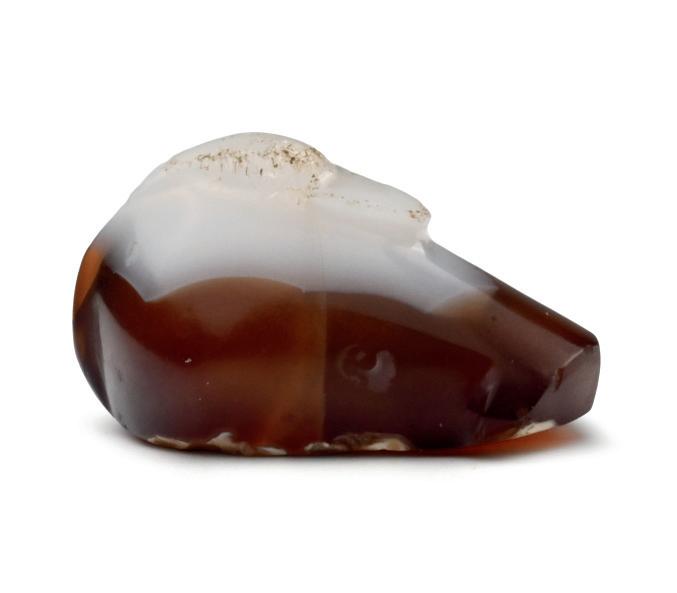
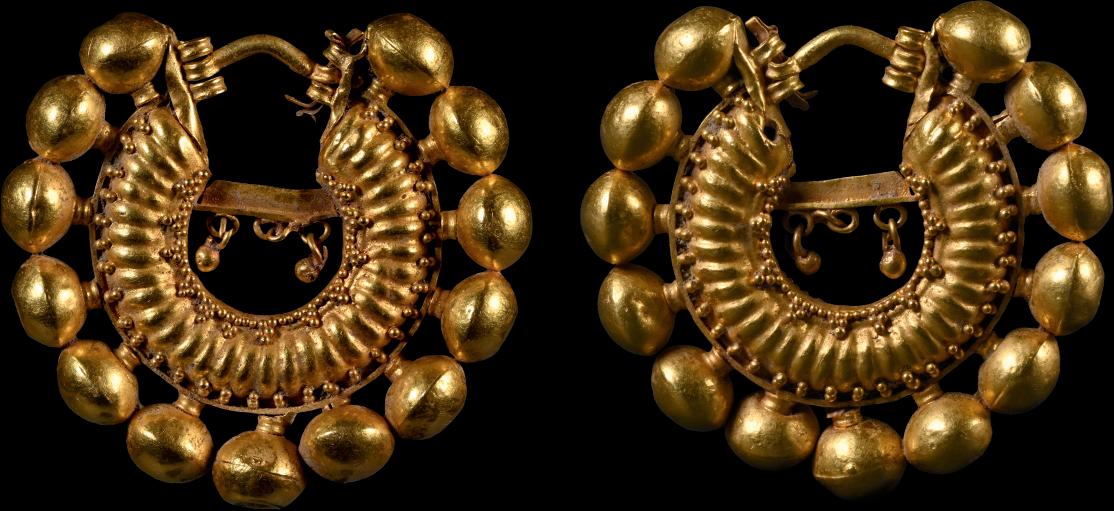
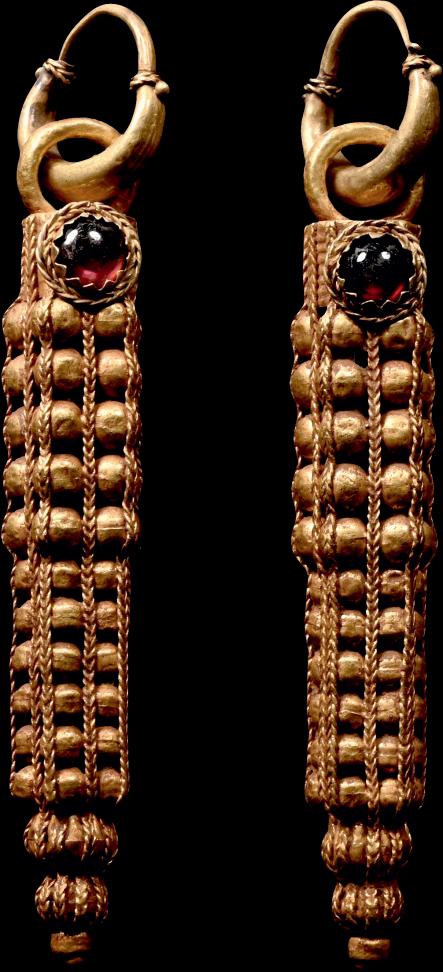
271
ACHAEMENID HEAVY GOLD EARRING PAIR
CIRCA 6TH-4TH CENTURY B.C.
1½ in. (23.78 grams total, 38 mm each)
A matched pair of large earrings decorated with pomegranates on the outer edge, the crescentic body divided in transversal grooves representing the abdomen of a bee, with granulation on the inner and outer edge, a horizontal gold wire with circlets to the centre. [2]
£2,000 - 3,000
PROVENANCE:
From a private family collection formed since the early 19th century, thence by descent.
Property of a New Zealand legal professional.
FOOTNOTES:
Fruit were generally considered to be a symbol of sensuality, temptation and fertility; the giving and accepting of fruit may be regarded as a symbolic sexual act, or at least a prelude to marriage. It follows naturally that the pomegranate, with its innumerable fleshy seeds symbolising life and fecundity, was an attribute of Aphrodite.
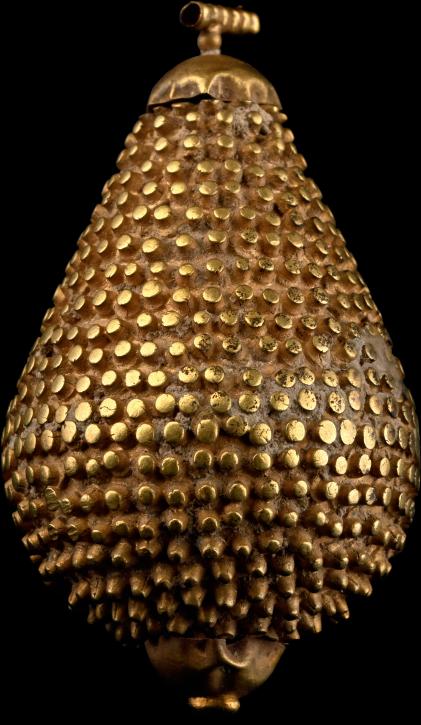
272
LARGE HOLY LAND GOLD AND GARNET DROP EARRINGS
1ST MILLENNIUM B.C.
3½ in. (34.90 grams total, 91 mm each)
Each a crescent hoop with lateral collars and granule, long columnar drop formed as six columns of stacked granules with filigree braided bands to the outer face, graduated bulb finial; discoid cell above with inset replicant garnet cabochon and the hoops added later.
£3,500 - 4,500
PROVENANCE:
From a North American gentleman’s collection, 1980-1990s.
273
BACTRIAN GOLD PENDANT ‡
3RD MILLENNIUM B.C.
1 in. (14.53 grams, 41 mm)
Biconvex in profile with ribbed suspension bar above, rows of regularly applied granules to the sidewall, domed end with granule finial.
£1,200 - 1,700
PROVENANCE: Ex private European collection, 1980s. Private collection, Switzerland, acquired in 1998.
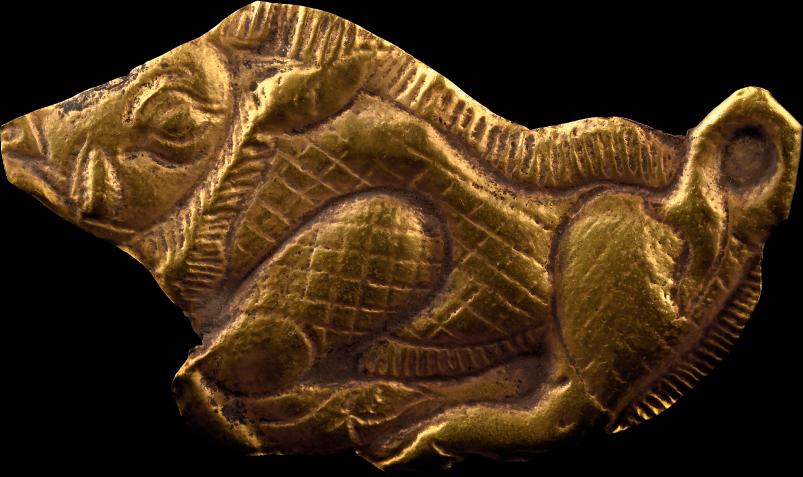
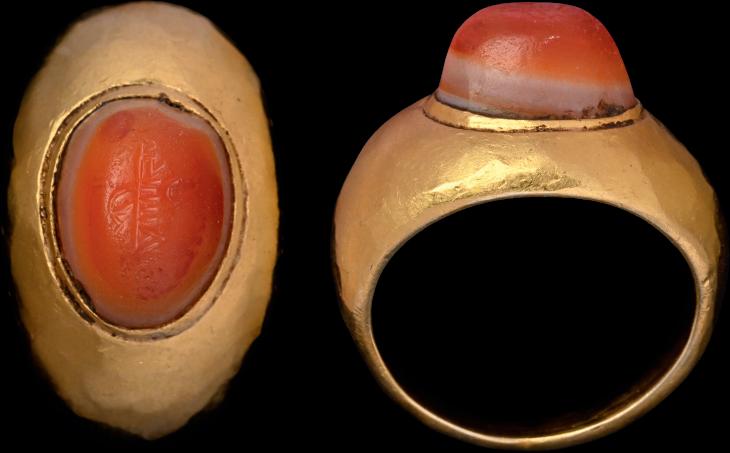

274
ACHAEMENID GOLD REPOUSSÉ BOAR MOUNT
6TH-4TH CENTURY B.C.
1 in. (5 in.) (2.07 grams, 48 mm (449 grams total, 15 cm including stand))
Sheet gold appliqué with repoussé detailing of a running boar in profile with hatching to the body; to the reverse, two applied mounting strips; mounted on a custom-made stand.
£1,500 - 2,000
PROVENANCE:
UK private collection before 2000. Acquired on the UK art market.
Private collection, London, UK.
275
WESTERN ASIATIC INSCRIBED CARNELIAN GEMSTONE IN GOLD RING
12TH-13TH CENTURY A.D.
1 in. (12.92 grams, 28.32 mm overall, 19.55 mm internal diameter
(approximate size British O, USA 7, Europe 14.98, Japan 14))
Incised Kufic inscription in high cut oval gemstone, set into a later hollow-formed ring with central stud to the bezel.
£1,000 - 1,400
PROVENANCE:
Private collection of Mr K.A., acquired in the 1990s-early 2000s.
276
WESTERN ASIATIC BANDED AGATE BEAD ‡ 2ND-1ST MILLENNIUM B.C.
3¼ in. (88 grams total, 84 mm wide including stand)
Discoid in plan and pierced transversely with later D-shaped later gold cap to each end; mounted on a custom-made stand.
£3,000 - 4,000
PROVENANCE:
Private collection, acquired on the UK art market, 2000. Private collection, Switzerland.

277
LARGE LURISTAN BRONZE FINAL WITH MASTER OF ANIMALS
8TH-7TH CENTURY B.C. 16 in. (930 grams total, 43 cm including stand)
Bifacial Master of Animals motif atop a collared tubular stem with flared foot; comprising two addorsed rams with their forelegs tied together; two addorsed birds standing on the rams’ backs looking towards two birds’ heads facing downwards and joined to slender crescentic boars with ridged backs and gaping mouths, each in the grip of the Master standing crowned between them; the Master with tubular body, animal-like ears, prominent nose above a small mouth and wearing collars, neck rings and tiered headdress; waisted socket below; mounted on a display stand.
£3,000 - 4,000
PROVENANCE:
Acquired in Iran, 1967.
Private collection, UK.
FOOTNOTES:
According to current knowledge, one type of Luristan standards consisted of two symmetrical animal figures standing upright on their hind legs and facing each other with an anthropomorphic character at the centre. Like the zoomorphic standards, the zoomorphic standards with a human head and the idols, this type has two faces, which means that it was conceived to be viewed from all sides.

278
OLD BABYLONIAN BRONZE FROG ‡ CIRCA 2400-1700 B.C. in. (24.6 grams, 22 mm)
Modelled in the round with anatomical detailing, undercut between legs and stomach; feet forming a wedge-shaped panel.
£2,000 - 3,000
PROVENANCE:
Private collection of Contessa L.J., since the 1980s. Private collection, acquired in 2001.
ASSYRIAN GYPSUM RELIEF WITH HEAD OF A BEARDED MAN ‡
704-681 B.C.
4½ in. (530 grams total, 11.6 cm including stand)
Rectangular frieze fragment with low-relief carving of a profile bust with short straight hair confined by a brow-band, segmented curls forming the beard, furrowed brow, one arm extended; handwritten label to rear ‘from the Koyunjik palace of Sennacherib at Nineveh and incised legend ‘KOUYUNJIK’ and ‘A’; mounted on a custom-made stand.
£8,000 - 10,000
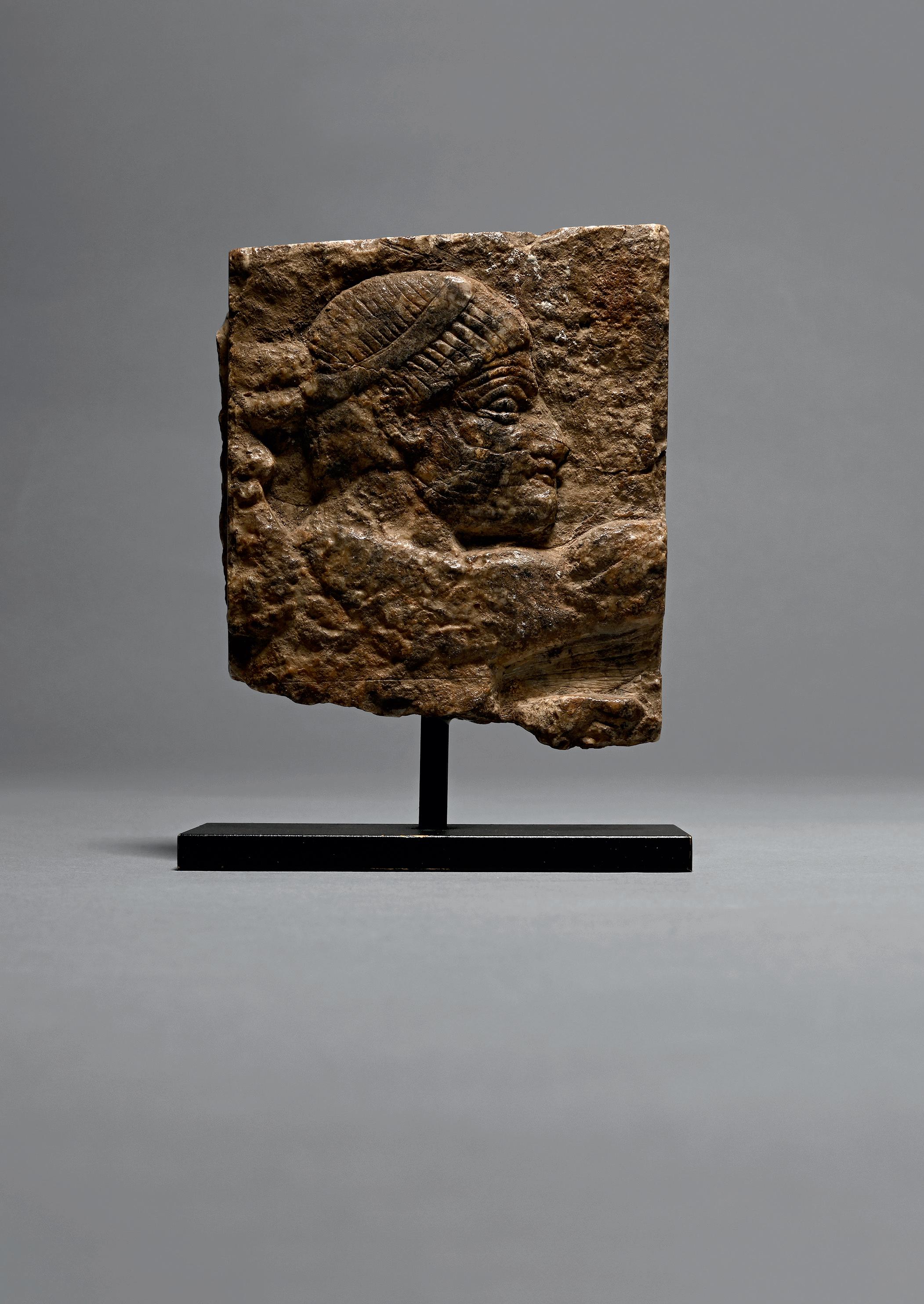
PROVENANCE: Allegedly found in the Koyunjik Palace of Sennacherib.
Ex property of a gentleman, UK, acquired in the 1970s.
Ex private collection, Oxfordshire, UK, 1988.
Anonymous sale, with Christie’s, London, 7 December 1994, no.235.
Art market, New York.
Ex private collection, Tokyo, Japan.
Private European collection, 2009.


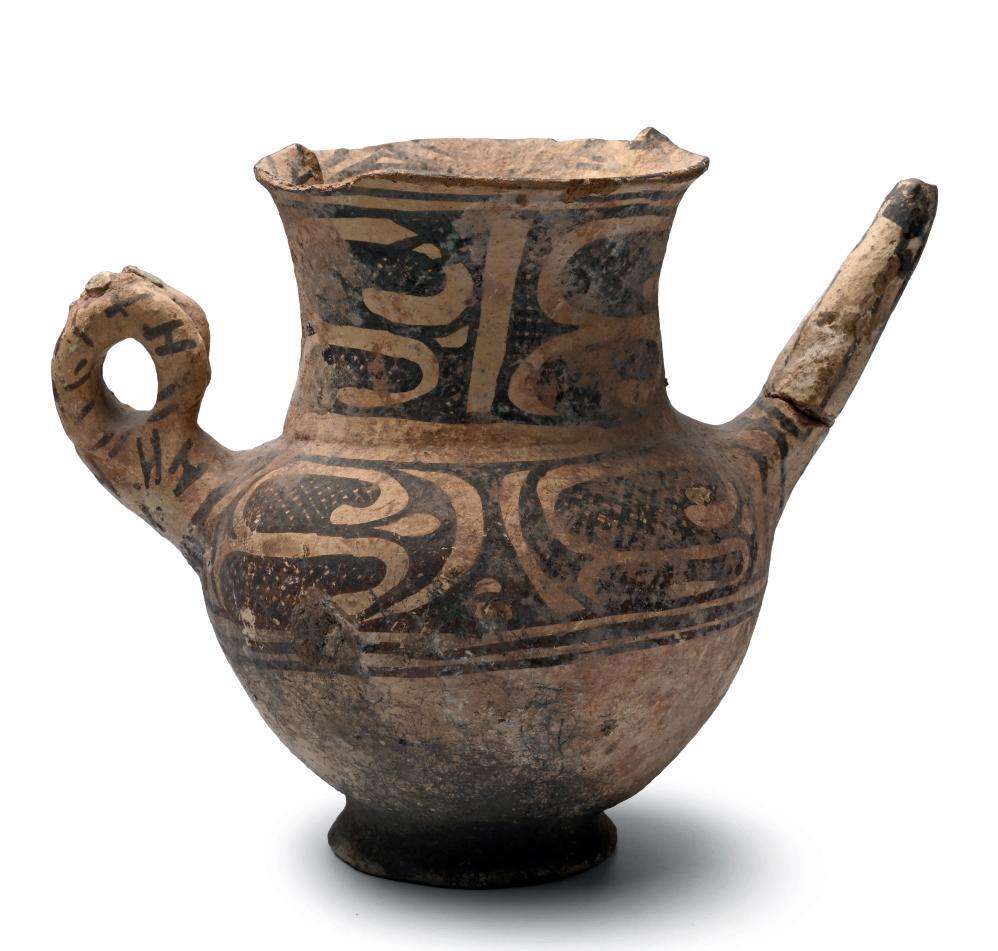
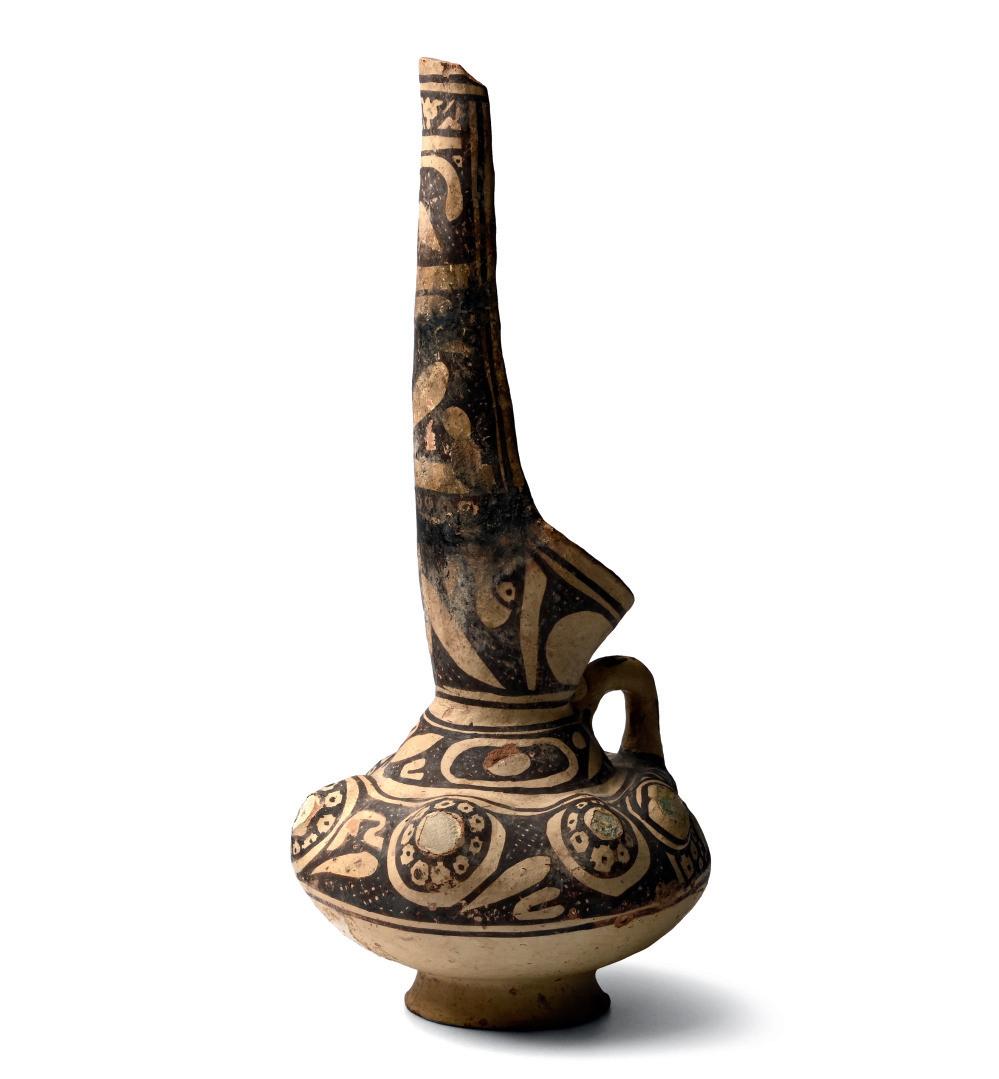
280
LARGE WESTERN ASIATIC TERRACOTTA BICHROME VESSEL
8TH-9TH CENTURY A.D.
9 in. (1.14 kg, 23 cm high)
With trumpet-shaped base, flared bulbous body, tapering spout with crested bar and strap handle connected to the waisted filler; dense painted scroll and floral designs with reserved scrolls and bands.
£600 - 800
PROVENANCE:
UK collection, 1990s.
Acquired on the UK art market, before 2000.
Private collection, Mr M.V., a London-based businessman.
281
WESTERN ASIATIC TERRACOTTA ZOOMORPHIC VESSEL
8TH-9TH CENTURY A.D.
12 in. (717 grams, 31.5 cm)
Broad and squat with flared foot, loop handle, all U-section spout and strainer; raised bosses to shoulder each set with a glass inlay; reserved tendrils and flowers on a black field.
£500 - 700
PROVENANCE:
UK collection, 1990s.
Acquired on the UK art market, before 2000.
282
WESTERN ASIATIC TERRACOTTA BICHROME BIRD VESSEL
8TH-9TH CENTURY A.D.
6¾ in. (387 grams, 17 cm)
Lentoid in plan with central loop handle, spout formed as a bird-head with coiled crest, rear a broad vent with openwork strainer; painted foliage and reserved bands.
£400 - 600
PROVENANCE:
UK collection, 1990s.
Acquired on the UK art market, before 2000.
283
WESTERN ASIATIC TERRACOTTA SPOUTED VESSEL
8TH-9TH CENTURY A.D.
7¼ in. (523 grams, 18.5 cm wide)
With bulbous body, looped handle and tapering spout, broad columnar neck with crimped detailing, bands of reserved tendrils on a hatched field.
£400 - 600
PROVENANCE:
UK collection, 1990s.
Acquired on the UK art market, before 2000.
284
WESTERN ASIATIC ROUNDEL FOR ADMINISTRATIVE PURPOSES OR A WEIGHT UNIT
9TH-11TH CENTURY A.D.
3½ - 4 in. (280 grams total, 9-10.3 cm)
Iridescent blue glass disc with low-relief central quatrefoil, four advancing felines with heater-shaped heads; clay mould for the production of a very similar design, plano-convex in section with knop handle; both in a custom-made lined presentation case with hinged lid. [2, No Reserve]
£1,000 - 1,400
PROVENANCE: Acquired in the 1960s-1970s. Kept in the UK since 1981.
285
KASHAN GLAZED HANDLED JUG 12TH-13TH CENTURY A.D.
6¼ in. (445 grams, 15.8 cm)
Spherical body on short ring foot, thin tubular neck, flared spout with D-section handle, blue and white glazed vertical stripes with iridescence; an old label to the underside; repaired. [No Reserve]
£400 - 600
PROVENANCE:
From the private family collection of Ersula Barter-Hemmerich, the longest serving member of staff working at the United Nations, her private collection formed in the 1950s and 1960s; thence by descent to her grandson.
286
KASHAN TURQUOISE GLAZED BOWL
13TH CENTURY A.D.
6 in. (203 grams, 15.3 cm wide)
Glazed hemispherical bowl with deep basal ring, painted scroll and dot decoration to the inner face, punched decoration to the outer face, old inked label ‘XIII cnt, 750’; repaired. [No Reserve]
£300 - 400
PROVENANCE:
From the private family collection of Ersula Barter-Hemmerich, the longest serving member of staff working at the United Nations, her private collection formed in the 1950s and 1960s; thence by descent to her grandson.
287
WESTERN ASIATIC GOLD RING WITH LION 12TH-13TH CENTURY A.D.
¾ in. (4.19 grams, 20.66 mm overall, 16.79 mm internal diameter (approximate size British M, USA 6, Europe 12.46, Japan 12))
Slender hoop with ellipsoid plaque, die-struck image of a couchant lion with pelletted detailing.
£1,200 - 1,700
PROVENANCE: UK private collection before 2000. Acquired on the UK art market. Private collection, London, UK.
288
AYYUBID GLAZED BOWL 12TH-13TH CENTURY A.D.
7 in. (249 grams, 17.8 cm wide)
Conical profile with wide foot, white glaze and ribbed decoration to the inner face; some restoration. [No Reserve]
£300 - 400
PROVENANCE:
From the private family collection of Ersula Barter-Hemmerich, the longest serving member of staff working at the United Nations, her private collection formed in the 1950s and 1960s; thence by descent to her grandson.
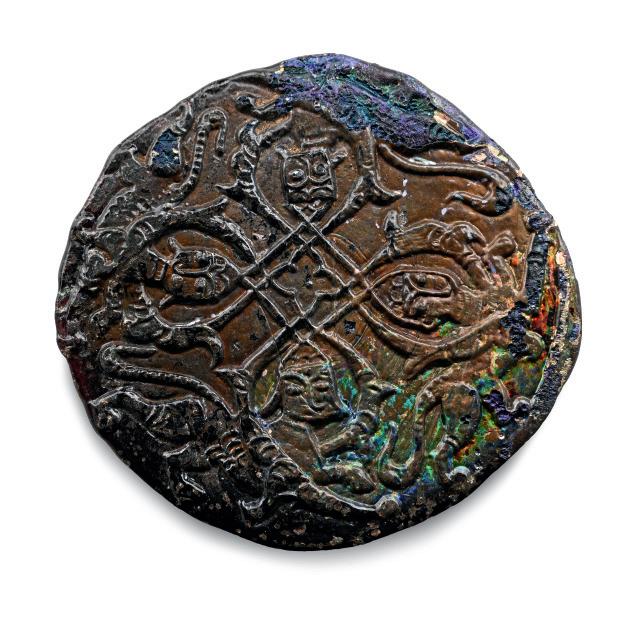
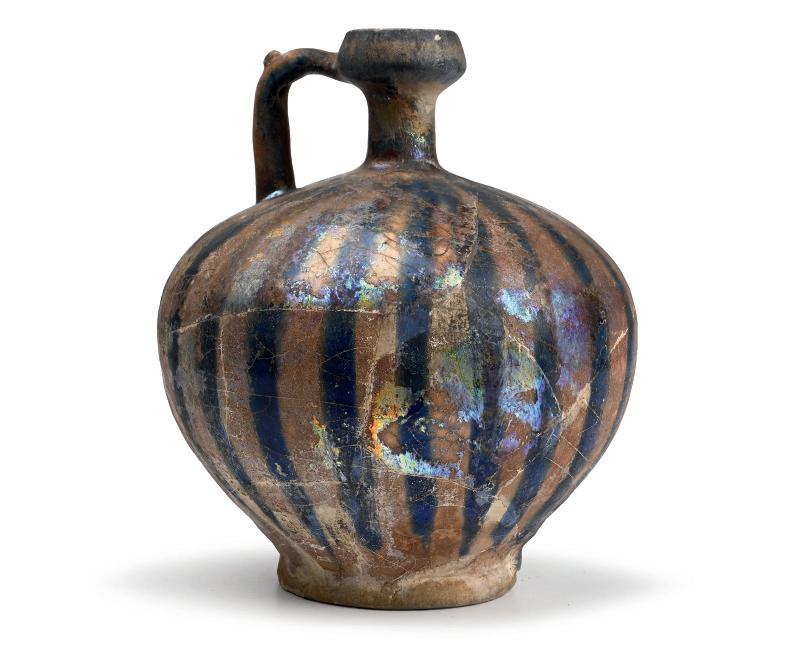
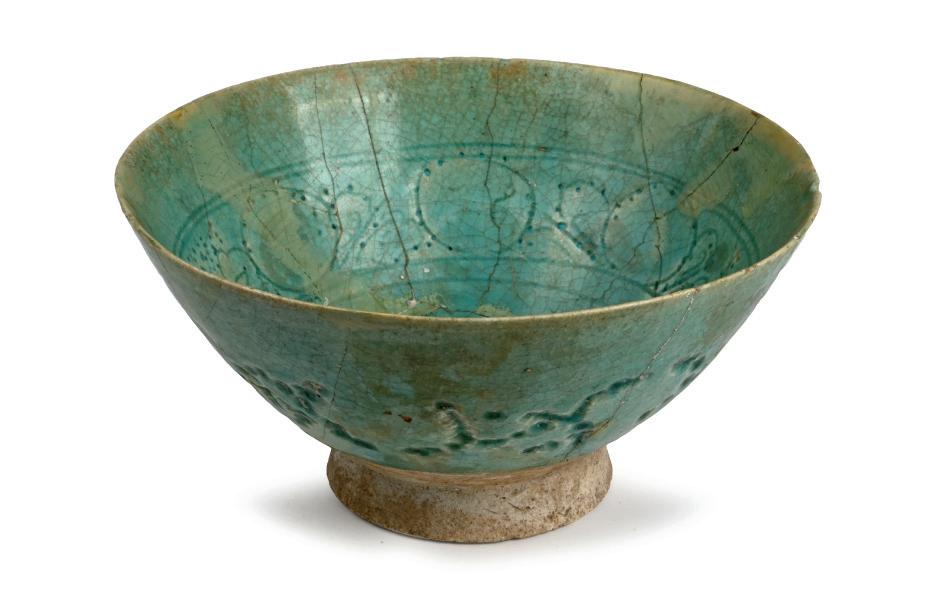

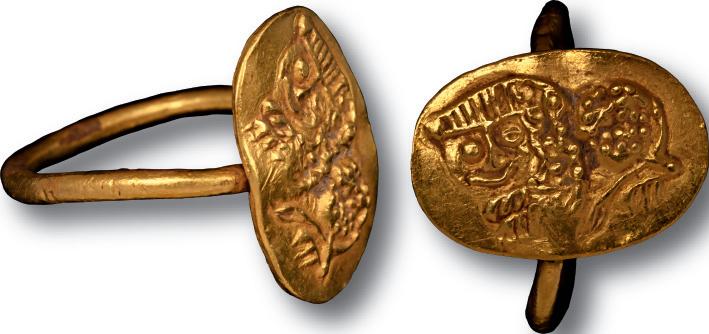
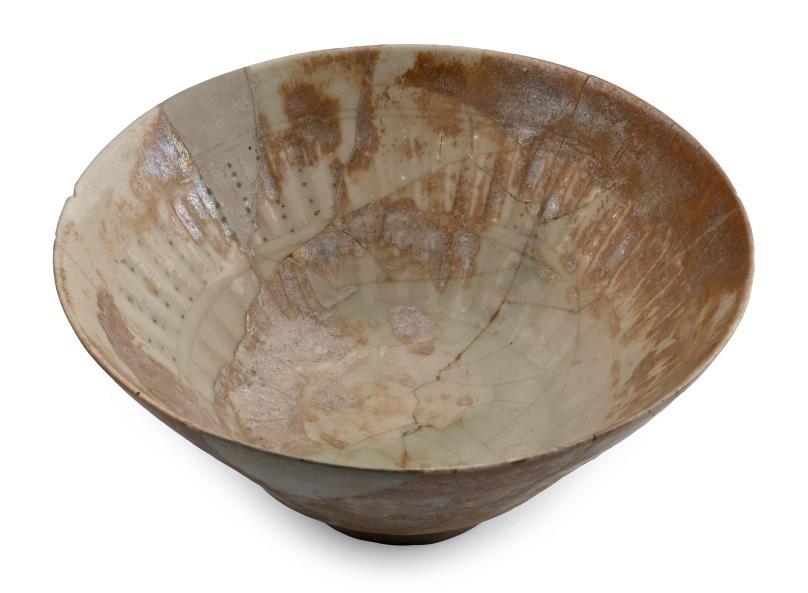

GREEK PONTIC TINNED BRONZE CHALCIDIAN HELMET
5TH-3RD CENTURY B.C.
17 in. (2.15 kg total, 43 cm high including stand)
The bowl forged from a single piece and fitted with removable cheekpieces; the dome divided into two halves by a carinated ridge, the peaked crown separated from the lower helmet wall by an indented ridge; cut-outs for ears and eyes with raised edges; short, angular neck-guard and short nose-guard extending to the eyebrows; the cheek-pieces with contoured front edge, holes for a chin-strap; remains of textile on the left side of the bowl; accompanied by a display stand.
£8,000 - 10,000

PROVENANCE:
From the collection of T.K., Germany, 1970s.
Acquired in 1992 by Mr R.K.
Acquired by the present owner on the UK art market.
FOOTNOTES:
Hinged cheek-pieces, like in our specimen, appeared in Thracia during the 4th century, but prototypes from the Pontic area and wider Greece show them already in use in the 5th century B.C. The traces of textile on the left part of our helmet show that it was stored inside a protective item -perhaps a case or bag - guarding it against atmospheric agents or possible damage when not in use.
290

ROMAN IMPERIAL BRONZE LEGIONARY HELMET
LATE 1ST CENTURY B.C.-EARLY 1ST CENTURY A.D.
10 in. (1.03 kg, 26.5 cm front to back)
A relatively heavy legionary helmet (cassis) of ‘Imperial Gallic Type’ with deep rounded bowl, simple C-shaped cut-outs for the ears, integral flared horizontal neck-guard extending some way along the sides, two corrugated ribs to the occipital area at the rear, intermitted by two bronze rivets, and four corrugated embossed ‘wings’ or prominent curved eyebrows flanking three riveted bosses arranged vertically; three studs on the rear of the neck-guard for attaching suspension loops to the preserved clasps of the cheek-guards (bucculae); hinged bracket at each temple once attaching the cheekguard; embossed beaded brow band running from one ear opening to the other; mounted on a custom-made stand.
£20,000 - 30,000
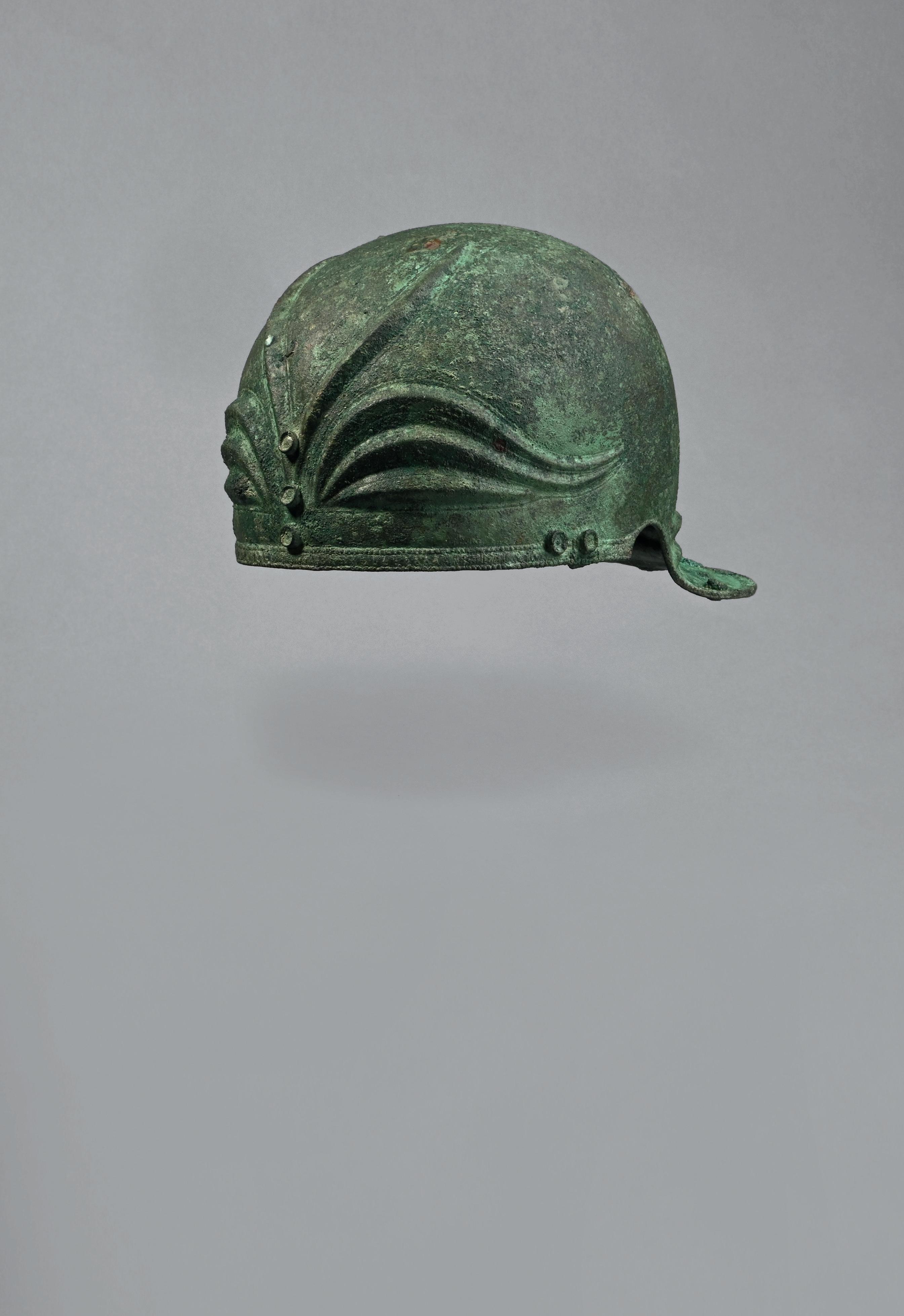
PROVENANCE:
Ex John Moore, York, UK, 1997. Property of a North London, UK, gentleman.
FOOTNOTES:
This early category of helmets was characterised by a hemispherical calotte and a slightly sloping neck guard. They were fitted with a pair of prominent curved eyebrows (symbolising the wings of Jupiter’s thunderbolts) flanking rivetted bosses.
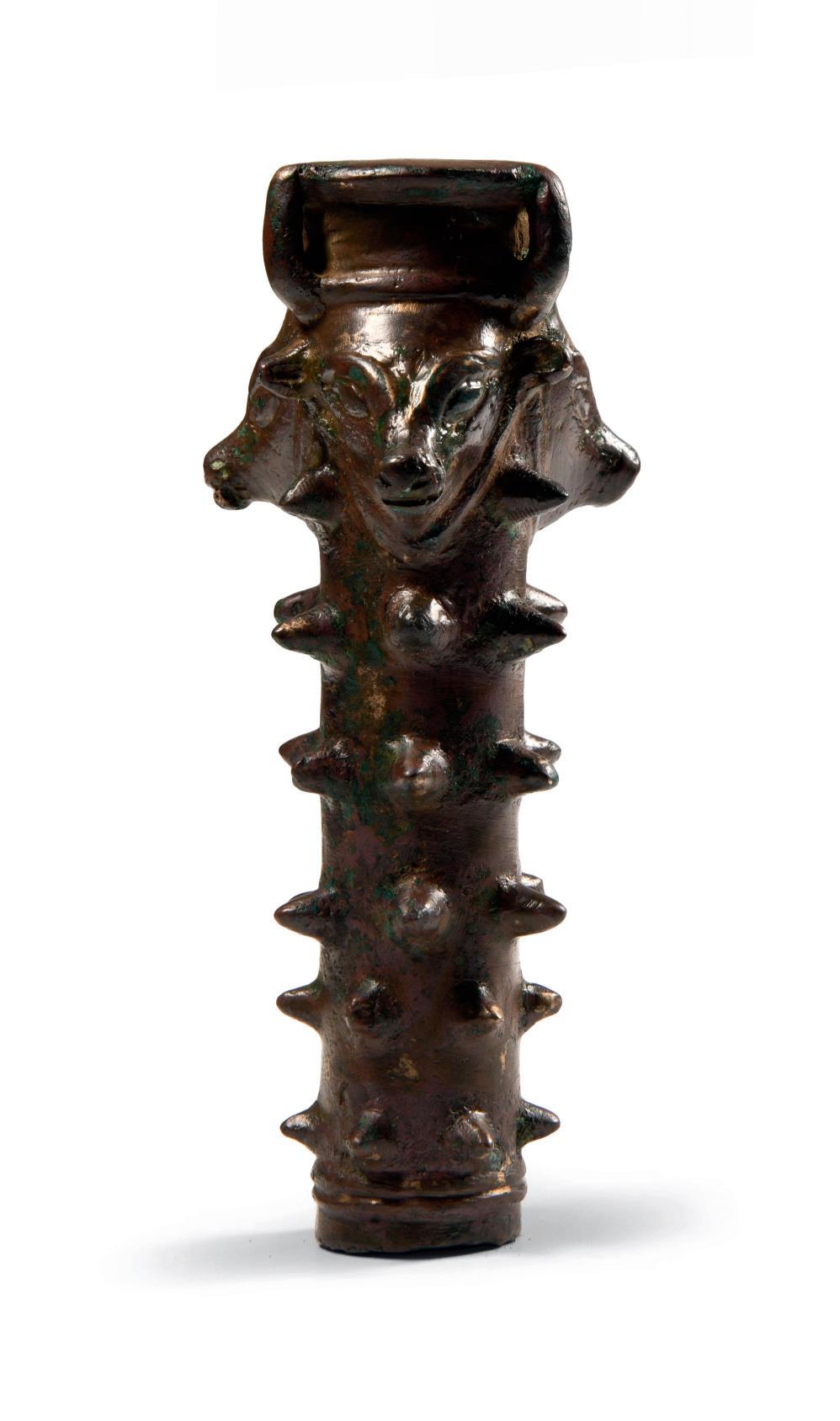
291

ELAMITE BRONZE SPIKED MACEHEAD WITH BULLS
2ND MILLENNIUM B.C.
5¾ in. (349 grams, 14.5 cm)
With three adjoining bull heads in high-relief to the top, with three ears and three horns serving all the three heads; the horns curving towards the rim of the closed top; the shaft adorned with vertical rows of pointed spikes; hollow socket tube with ring collar at the base.
£1,500 - 2,000
PROVENANCE: Ex London, UK gallery, 1971-early 2000s.
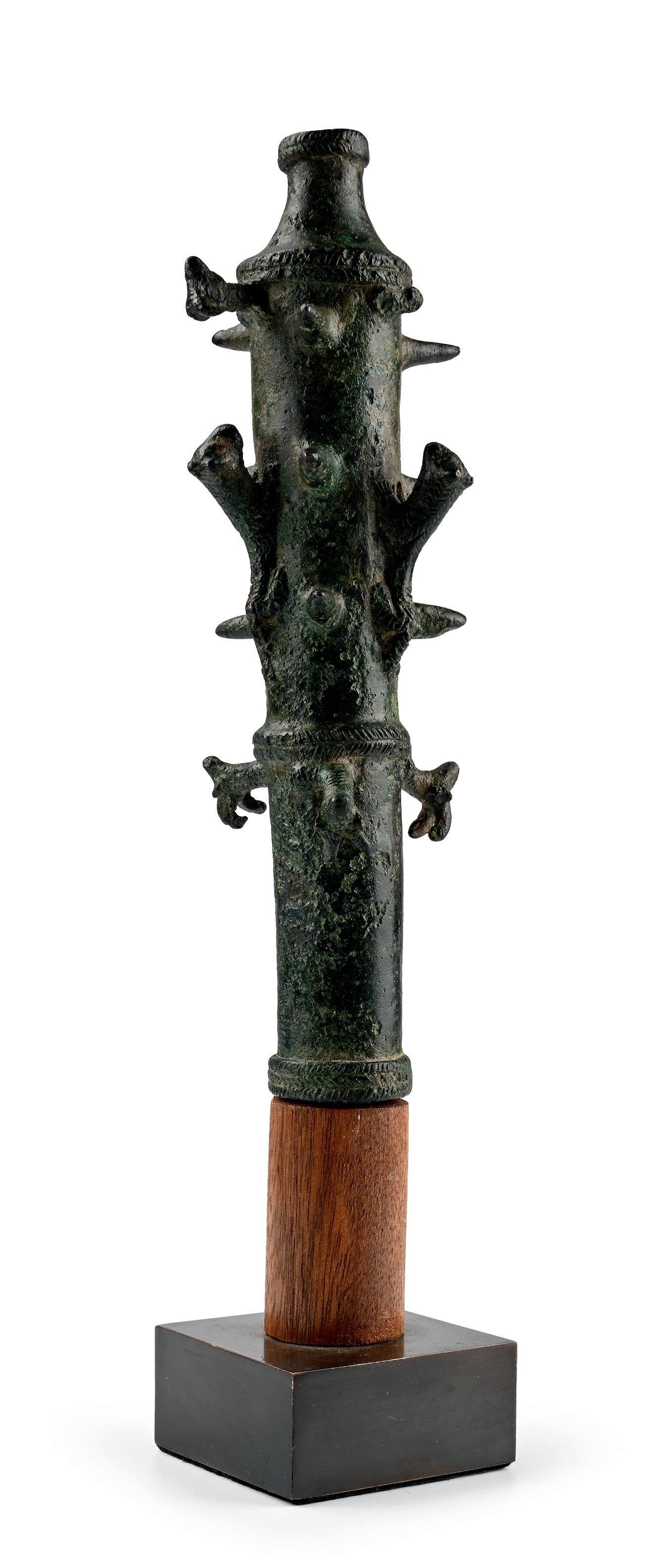
292
ELAMITE BRONZE PARADE MACEHEAD WITH ANIMALS
2ND MILLENNIUM B.C.
7½ in. (10¼ in.) (519 grams, 19 cm (647 grams total, 26 cm including stand))
Tubular sleeve with ribbed collars to the mouth and shank; scooped upper end narrowing to the top; three vertical lines of conical spikes with interstitial crawling lions, rams’ heads at the top, ibex heads below the lower collar; mounted on a custom-made stand.
£1,000 - 1,400
PROVENANCE: Kuizenga collection, the Netherlands, acquired Hamburg 22 December 1995. Private collection, London, UK.
293

CAUCASIAN AXEHEAD WITH ENGRAVED DRAGON HEADS
KOBAN CULTURE, 12TH-8TH CENTURY B.C.
7 in. (806 grams total including stand, axehead: 18.8 cm)
Comprising a swept curved edge, slender neck with faceting, bulb socket and small striking face to the butt; frieze of hatched serpentine necks and heads to each face of the blade, with reserved triangles; band of hatched chevrons to the neck, horizontal fluting to the socket; mounted on a custom-made stand.
£15,000 - 20,000
PROVENANCE: Franz Heger (1853-1931), Austrian traveller and ethnographer, acquired in the Caucasus during his 1890 expedition.
Believed to have been gifted circa 1930 to Franz Hancar (1893-1968), noted scholar and expert in ancient Caucasian cultures.
Thence by descent, acquired in the 1950s by Mr R.D., Vienna, Austria.
Acquired from the above in 1998 by N.M., former Israeli Ambassador to Austria (1998-2000).
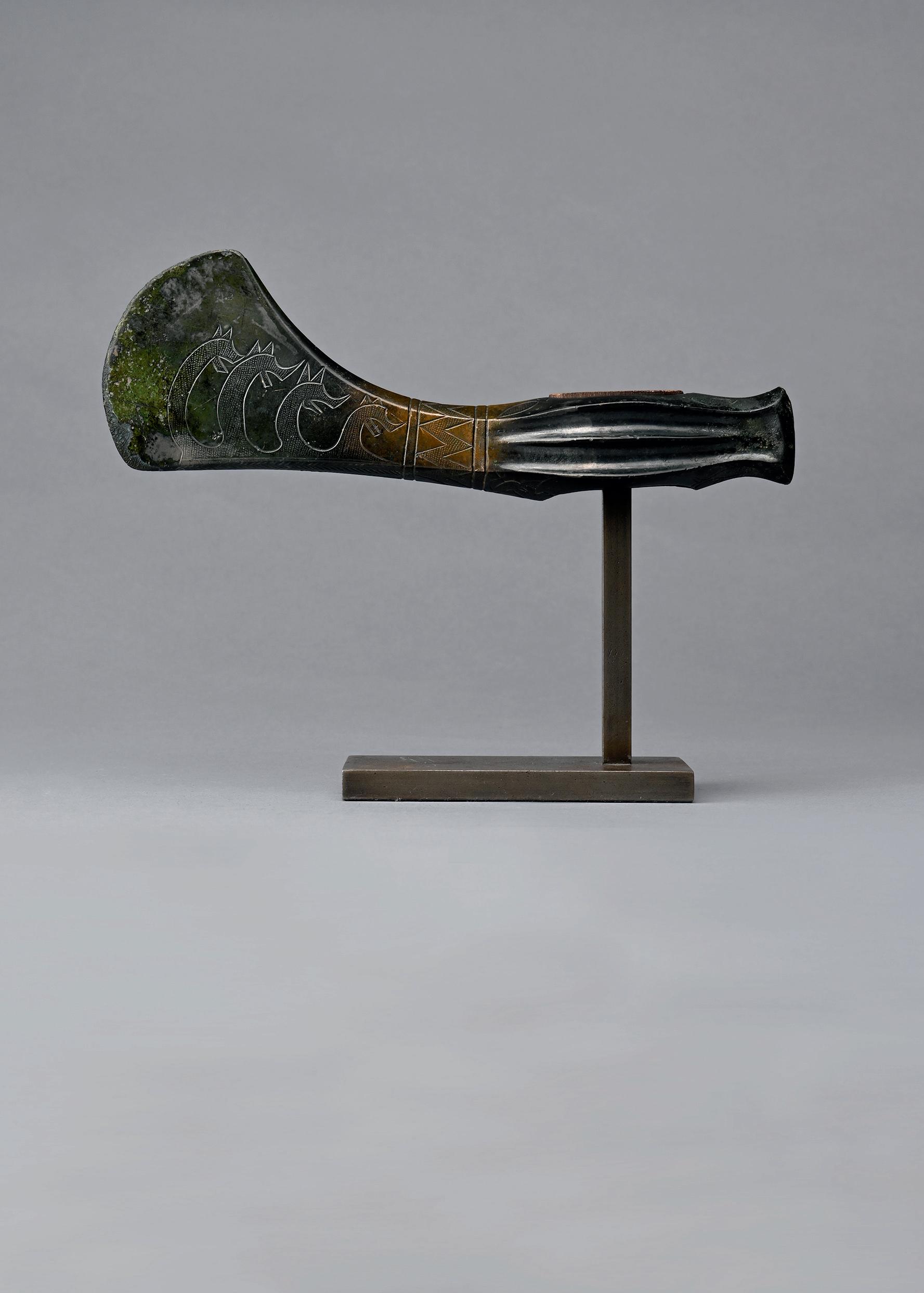
PUBLISHED: Featured in Apollo Magazine, May 2019.
FOOTNOTES: During the latter half of the 2nd millennium B.C., one type of axe head dominated in the region of the Eastern European steppes. It had a narrow horizontal blade, a short blade and a tube-shaped handle. Examples have been found across the steppes of Eastern Europe from Transcaucasia. From the middle of the second millennium B.C., the spread of the type in the Eastern Steppes was connected with the movement of Iranian-speaking nomads, maybe the Tocharo-speaking tribes, who used two-wheeled horse-drawn war chariots.
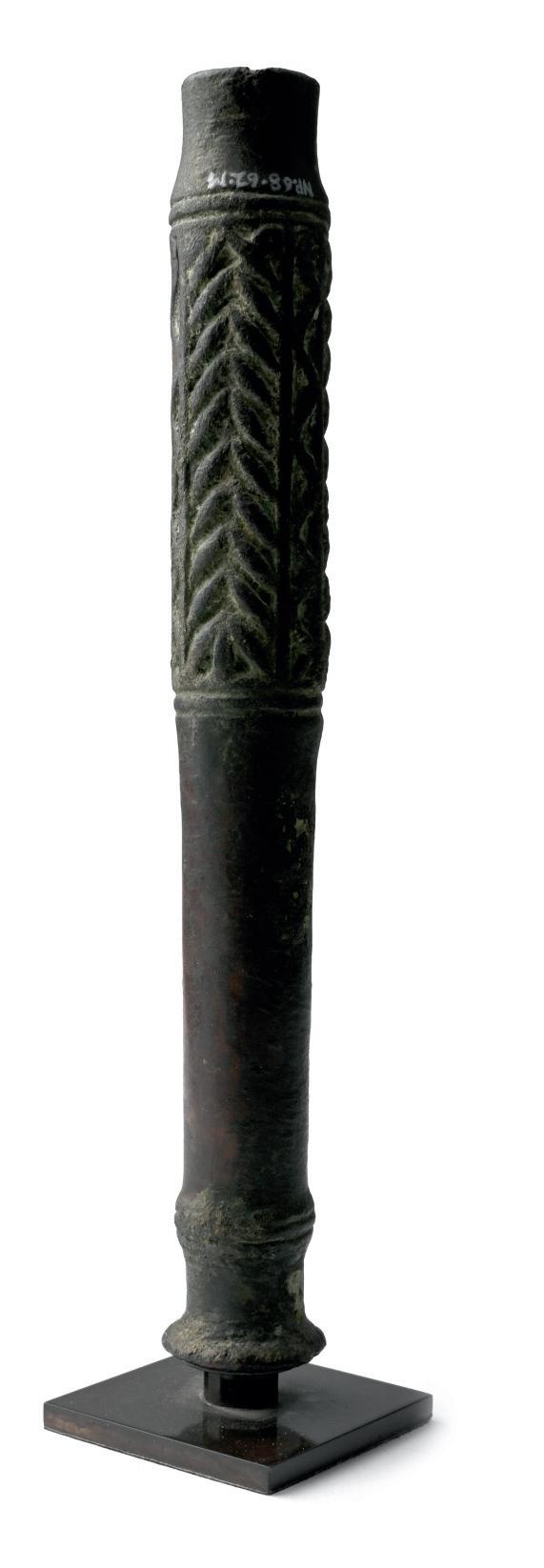


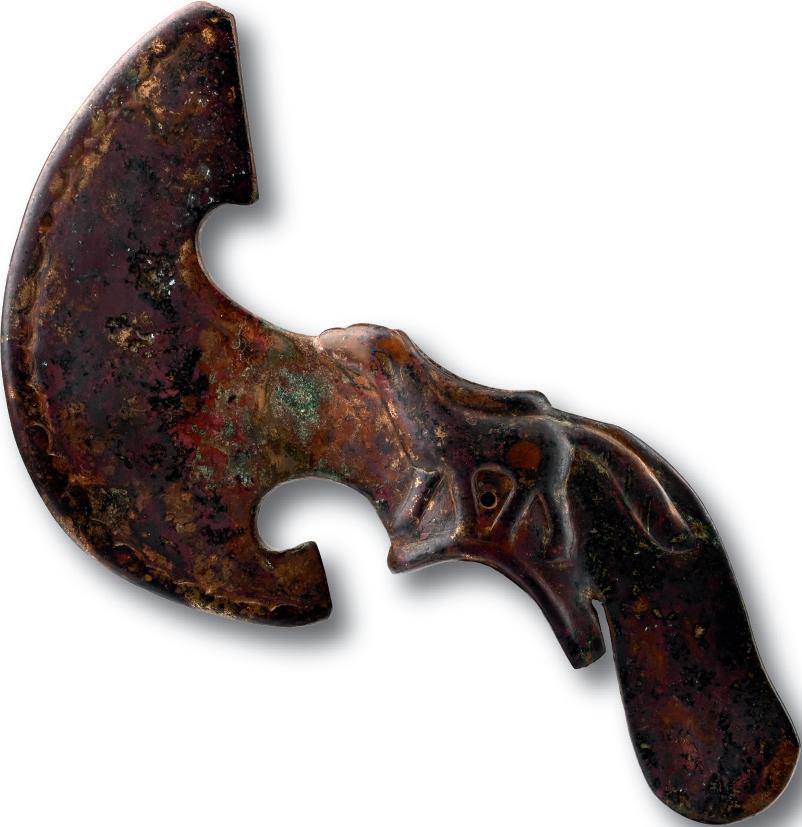


294
MESOPOTAMIAN ‘CHRYSLER MUSEUM’ BRONZE MACEHEAD WITH INCISED DECORATION
EARLY 2ND MILLENNIUM B.C.
10 in. (647 grams total, 25.6 cm including stand)
Tubular in plan with low-relief braided panel and undulating lines; scooped profile at each end and securing collar; mounted on a custom-made stand.
£1,000 - 1,400
PROVENANCE:
Ex Chrysler Museum of Art, Virginia, accession no.NP.68.62.M. with ArtAncient, 2010.
Private collection, London, UK.
295
MESOPOTAMIAN BRONZE MACEHEAD WITH RAISED BOSSES
EARLY 2ND MILLENNIUM B.C.
8¼ in. (630 grams total, 21 cm including stand)
Of cylindrical shape, the upper section with prominent bosses and flanges, short cylindrical shaft edged at top and bottom with collars; mounted on a custom-made stand.
£700 - 900
PROVENANCE: with ArtAncient, 2010.
Private collection, London.
296
BACTRIAN BRONZE ANIMAL AXEHEAD
13TH-12TH CENTURY B.C.
8 in. (780 grams total, 22 cm including stand)
Featuring a low-relief depiction of a hunting dog on each side of the socket, lobed rear plate and broad, D-shaped blade with a raised, dentilled panel along the cutting edge; mounted on a custom-made stand.
£1,800 - 2,400
PROVENANCE:
Private family collection, acquired in the 1970s. with a London gallery. with TimeLine Auctions, 24 February 2018, no.341.
Private collection, London, UK.
297
ARAMAIC INSCRIBED BRONZE ARROWHEAD
1ST MILLENNIUM B.C.
3¾ in. (14 grams, 94 mm)
Comprising a two-edged lentoid-section leaf-shaped blade and lozenge-section tang; each side with a short incised Aramaic inscription.
£1,000 - 1,400
PROVENANCE:
From the collection of a gentleman, acquired on the London art market in the 1990s.
298
LATE ROMAN IRON SWORD WITH DECORATED GUARD
5TH-6TH CENTURY A.D.
29 in. (696 grams, 74 cm)
A two-edged spatha type with a lentoid parallel-sided blade, sloped shoulders and short tang pierced by an attachment rivet for the grip; the bronze lower guard rectangular in plan and scaphoid in section with inset garnet cloisonné in gold cells with rhomboid patterns alternating with circles; the upper top roundel of the pommel or insertion of the hanging stone divided into four gold cells in garnet cloisonné; accompanied by a barrel-shaped polished hilt stone.
£3,000 - 4,000
PROVENANCE:
From the private collection of a London gentleman, from his grandfather’s collection formed before the early 1970s.
FOOTNOTES:
The sword is a Migration Period sword which usually had stones hanging from the pommel or hilt, like the one preserved here, which finds a parallel with the sword of Lord of Morken (Strassmeir, 2019, p.55, lett.G). This typology was widespread in Central Europe by the Huns and there are also specimens attested in Gaul and Spain in the 5th century.
299
VIKING AGE IRON SWORD DECORATED HILT
11TH-13H CENTURY A.D.
34 in. (814 grams, 88 cm)
Double-edged cutting sword of Couronian type with tapering fullers, bronze cross-guard with Jellinge Style type decoration; five-lobed bronze pommel rivetted at the top.
£3,000 - 4,000
PROVENANCE:
From the private collection of a London gentleman, from his grandfather’s collection formed before the early 1970s.
FOOTNOTES:
The Couronian swords of this type with animal head decoration were widespread and used in the Eastern Baltic lands from 10th to 13th century.



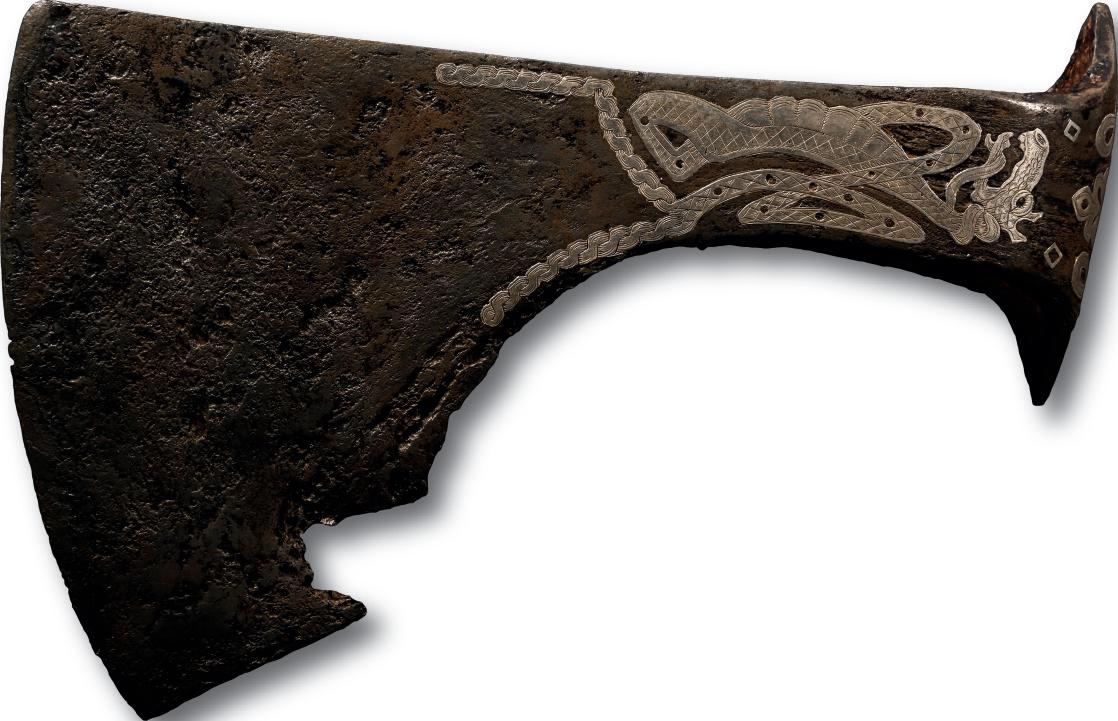

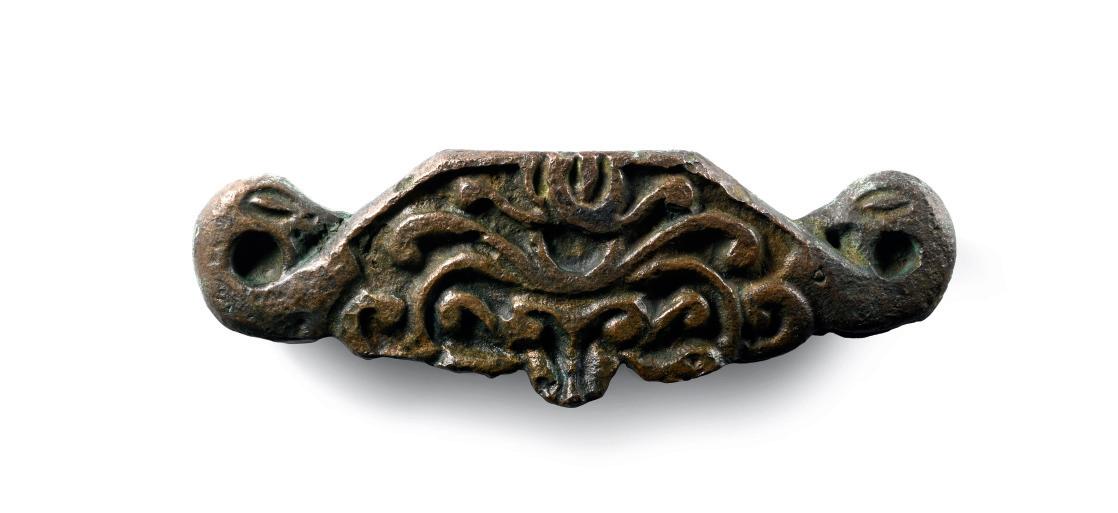
300

VIKING BATTLE AXE HEAD WITH SILVER INLAYS ‡
NORTHERN EUROPE, 9TH-11TH CENTURY A.D.
6¼ in. (10¼ in.) (390 grams, 15.7 cm (813 grams total, 26.2 cm high including stand))
With short, cylindrical socket to rear, narrow neck, flared blade with curved cutting edge; underside of the blade swept in a gentle curve; short flanges above and below the rear of the socket; decorated overall with finely engraved silver inlays forming two dragons and interlace patterns (probably not original); provided with a display stand.
£7,000 - 9,000
PROVENANCE: Acquired 1982 in Kaliningrad and transported to Riga in 1986, moved to East Berlin in 1988, and again to Germany in 2000, then UK in 2014.
Ex West London collection.
301
LARGE SAXON IRON SEAX WITH SINGLE-EDGED BLADE
7TH–8TH CENTURY A.D.
19¾ in. (610 grams, 50 cm)
Ferrous seax blade of Wheeler’s Type I with point at the median line, broad with thick back and wide, flat tang for a whittle-tang hilt assemblage; incised lines to both faces following the profile of the back and cutting edge. [No Reserve]
£800 - 1,000
PROVENANCE: Private collection, UK.
302
VIKING AGE BRONZE LOWER SWORD GUARD WITH DRAGONS
11TH-13TH CENTURY A.D.
4 in. (124 grams, 10 cm)
Sloping shoulders and transverse slot to the upper face, lateral beasthead terminals; panel of palmette ornament to each broad face with tendrils, dentilled lower edge; Baltic Curonian type.
£1,200 - 1,700
PROVENANCE:
From the private family collection of a lady, UK; acquired in Germany mid 20th century.
FOOTNOTES:
The cross guard finds good parallels with Baltic swords used by Prussian, Curonian, Estonian and Lithuanian pagan warriors; see a clear parallel in Tomsons, 2012, fig.2,7 but especially fig. 3. The Curonian Type T swords were thoroughly examined by Tomsons and he was able to date the type to the 11th to 13th centuries.
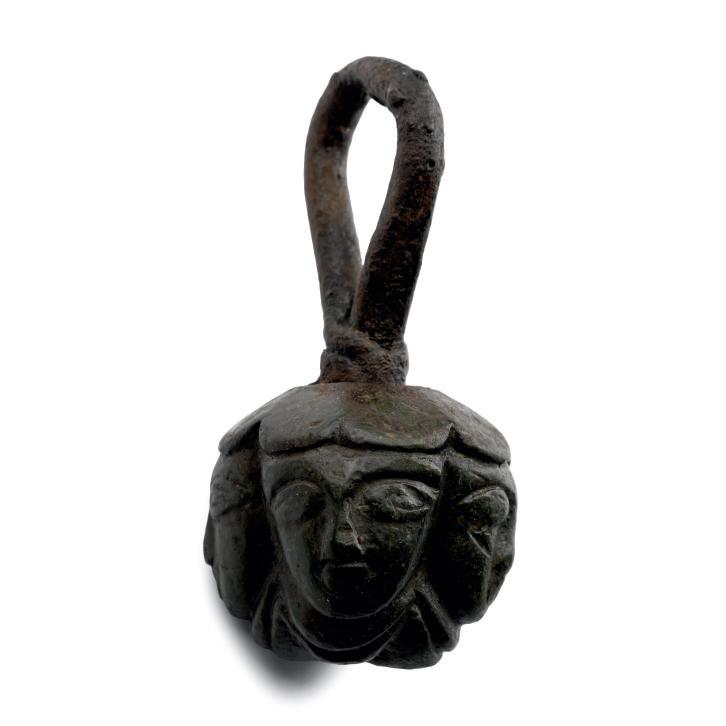
303
MEDIEVAL BRONZE FLAIL HEAD WITH FOUR HEADS
14TH-15TH CENTURY A.D.
2 in. (114 grams, 60 mm)
Formed as four radiating D-shaped masks beneath a rosette, substantial suspension loop.
£800 - 1,000
PROVENANCE:
From the private collection of a London gentleman, from his grandfather’s collection formed before the early 1970s.
304
MASSIVE MEDIEVAL IRON HAND-AND-A-HALF KNIGHT’S SWORD WITH LAMB OF GOD POMMEL WESTERN EUROPE, 14TH-15TH CENTURY A.D.
46¾ in. (1.6 kg, 1.19 m)
Of Oakeshott’s Type XV or XVIII, cross style 8, pommel style J (recessed) with a strongly tapering, pointed blade of ‘flattened diamond’-section; tapering lower-guard with downturned finials; long, slightly tapering grip and a large disc pommel with chamfered edges, inlay to both sides with a low-relief image of Lamb of God, possibly a later addition; some old contemporary repairs.
£4,000 - 6,000
PROVENANCE:
From the private family collection of a lady, UK; acquired in Germany mid 20th century.
FOOTNOTES:
Many swords of this type have long grips, like the war-swords of Type XIII. After about 1350, nine swords out of ten seem to have such grips, and are today variously referred to as ‘Hand-and-a-half’ or ‘Bastard’ swords. The latter term was used in the 15th century, but it is not certain that it was applied to this particular kind of weapon. ‘Hand-and-a-half’’, though modern, is a far more fitting name; these swords were single-handed weapons, but by being furnished with long grips, could at need be wielded easily in both.
305
MASSIVE MEDIEVAL IRON TWO-HANDED KNIGHT’S SWORD WITH CROSSES ON GUARD
GERMANY, CIRCA 14TH CENTURY A.D. 56 in. (1.94 kg, 1.42 m)
Tapering blade with a shallow fuller, long and narrow tang with a pearshaped pommel and a curved cross-guard of Oakeshott Style 6 with incised crosses; professionally conserved.
£3,500 - 4,500
PROVENANCE:
From the private family collection of a lady, UK; acquired in Germany mid 20th century.
FOOTNOTES:
The noteworthy element of this sword is its guard with the engraved crosses. The presence of the cross suggests that the sword once belonged to person belonging to a military order of chivalry. Considering that the Templars were already destroyed when the sword was made, the main candidates could be the Hospitallers or, most probably, the Teutonic Knights.


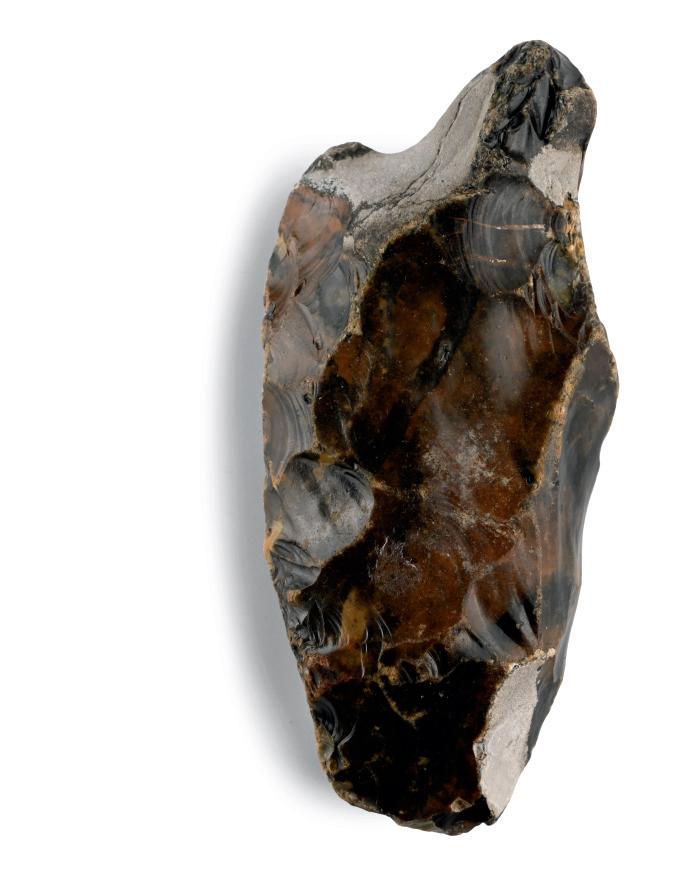



306
STONE AGE HAPPISBURGH TYPE FLINT HANDAXE
LOWER PALAEOLITHIC, CIRCA 600,000-250,000 B.P.
5 in. (293 grams, 13 cm)
Of brown, buff and black patinated flint, the butt (Type A) fairly cortical with two 'horned' projections of the nodule, one much longer than the other, another patch of cortex remains towards the point to the dorsal face.
£500 - 700
PROVENANCE:
Discovered by P Macro at Happisburgh, Norfolk, UK, between Tuesday 1st October 2019 and Saturday 30th November 2019. Ex collection of P James, South England. Acquired directly from the finder.
From the private collection of an East Anglian, UK, specialist collector.
Accompanied by a copy of the British Museum’s Portable Antiquities Scheme (PAS) report no.NMS-3A3691.
307
LARGE STONE AGE ACHEULEAN FLINT HANDAXE
LOWER PALAEOLITHIC PERIOD, CIRCA 500,000-350,000 B.P.
5 in. (404 grams total including stand, axe: 15 cm)
Piriform in profile with broad butt; old collector’s label ‘1899 / Eaux de l’Avre / Colombin / De[...]’; mounted on a custom-made display stand. £400 - 600
PROVENANCE:
Found Eure et Loire, Eaux de L’Avre, Columbies, France, in 1892. Ex famous UK musician and amateur archaeologist, Victor Brox (1941-2023). Acquired on the UK art market.
From the private collection of an East Anglian, UK, specialist collector.
FOOTNOTES:
Attributed to Homo Heidelbergensis.
308
STONE AGE CLASSIC-SHAPED FLINT HANDAXE
PALAEOLITHIC PERIOD, CIRCA 500,000-300,000 B.P.
5 in. (443 grams total including stand, axe: 13 cm)
Cordiform with mottled autumnal patina and glassy flint; traces of fossil marine creatures within the flint, now turned to quartz; mounted on a custom-made display stand.
£350 - 450
PROVENANCE:
Found Thames gravels, Kent, UK. Acquired on the UK art market.
From the private collection of an East Anglian, UK, specialist collector.
FOOTNOTES: Attributed to Homo Heidelbergensis.
309
LARGE STONE AGE ACHEULEAN FLINT HANDAXE
LOWER PALAEOLITHIC PERIOD, CIRCA 500,000-350,000 B.P. 6 in. (669 grams total including stand, axe: 15.6 cm)
Substantial leaf-shaped type with some cortex to the butt; inked findspot ‘St Même / Charente / Car Audouin (FR)’; mounted on a custom-made display stand.
£300 - 400
PROVENANCE:
From the well regarded long closed quarry site of St Meme, Charente, France. From an old large Belgian collection. Acquired on the European art market.
From the private collection of an East Anglian, UK, specialist collector.
FOOTNOTES: Attributed to Homo Heidelbergensis.


310
LARGE STONE AGE FLINT OVATE HANDAXE
PALAEOLITHIC PERIOD, CIRCA 450,000-300,000 B.P.
5¼ in. (535 grams total including stand, axe: 13.3 cm)
With silky cream and pale blue patina; small oval darker area forming part of the original cortex, potentially left to aid grip; inked notation ‘Blandford / Dorset’; mounted on a custom-made display stand.
£500 - 700
PROVENANCE:
Found Blanford, Dorset, UK.
From the collection of John Sharp, former well known archaeologist. Acquired on the UK art market.
From the private collection of an East Anglian, UK, specialist collector.
FOOTNOTES: The Ovate form is uncommon. Attributed to Homo Heidelbergensis.
311
LARGE STONE AGE KNAPPED AXE BLADE ‡
NEOLITHIC PERIOD, CIRCA 5500-2200 B.P.
13 in. (1.29 kg, 34.5 cm)
Worked on all sides into an almost symmetrical shape; lanceolate cross-section; beige flint (silex) with cream-coloured spots and dots; waxy surface sheen.
£1,800 - 2,400
PROVENANCE:
Findspot ‘Reuilly sur C.1927’, France. Ex M.M., Paris. French art market, 2019.

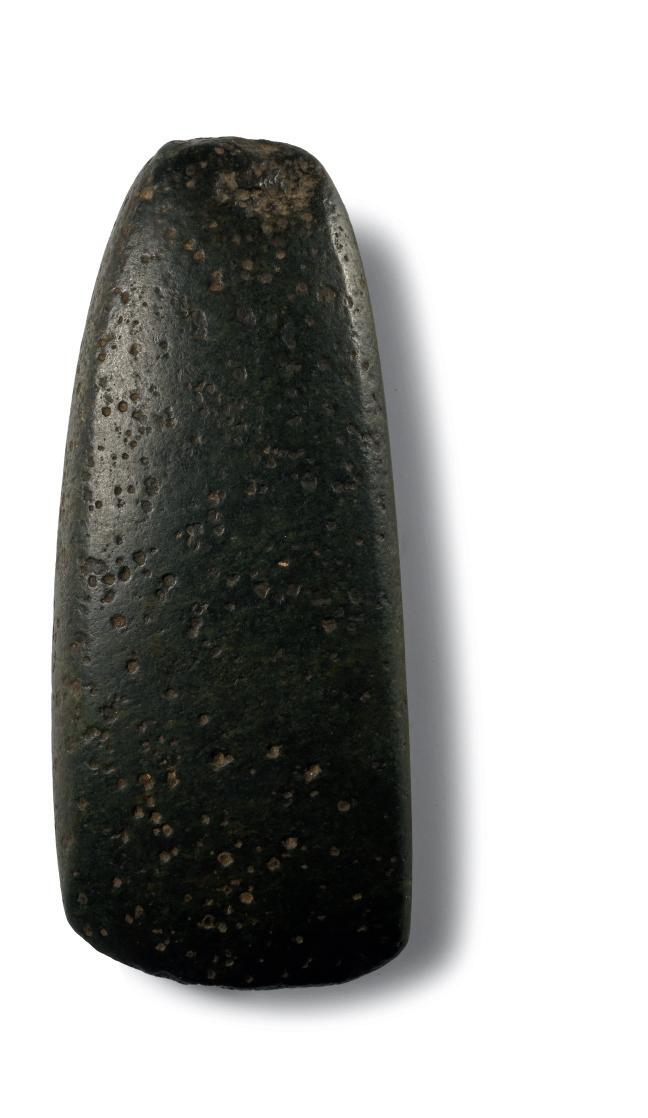
312 VERY LARGE STONE AGE ‘LIVRE DE BEURRE’ FROM LE GRAND PRESSIGNY ‡
NEOLITHIC PERIOD, 5500-2400 B.P.
12 in. (14¾ in.) (2.62 kg, 30.5 cm (3.79 kg total, 37.5 cm including stand))
A substantial flint core or so-called ‘Livre de Beurre’ with vertical traces of blows on the work side, including one pronounced blade negative extending half way along the stone’s length; cortex remains and core preparation traces on other side; proximal end with impact surface, distal end with rounded point; two bifacial wave to chevron-shaped core edges; flat-prismatic cross-section; raw material for blade production, beige stone (silex) with yellow undertone, cream-colored patches and spots, slightly shiny surface (origin: Le Grand Pressigny, Dép. Indre-et-Loire, France); old collector’s label ‘N13310’; supplied with a custom-made stand.
£800 - 1,000
PROVENANCE: Private collection, B.G., Southwest France.
313
STONE AGE POLISHED HAND AXE ‡
NEOLITHIC PERIOD, CIRCA 5500-2200 B.P.
5 in. (489 grams, 13 cm)
Rectangular in section with a narrow rounded butt and asymmetrical curved edge; pitted surface; old collector’s labels ‘France (Bourgogne)’, ‘Saulieu, Côte d’Or’, ‘N15621’.
£500 - 700
PROVENANCE: Ex Hervé Bouraly, Saint Ouen, France, between 1965-1990.
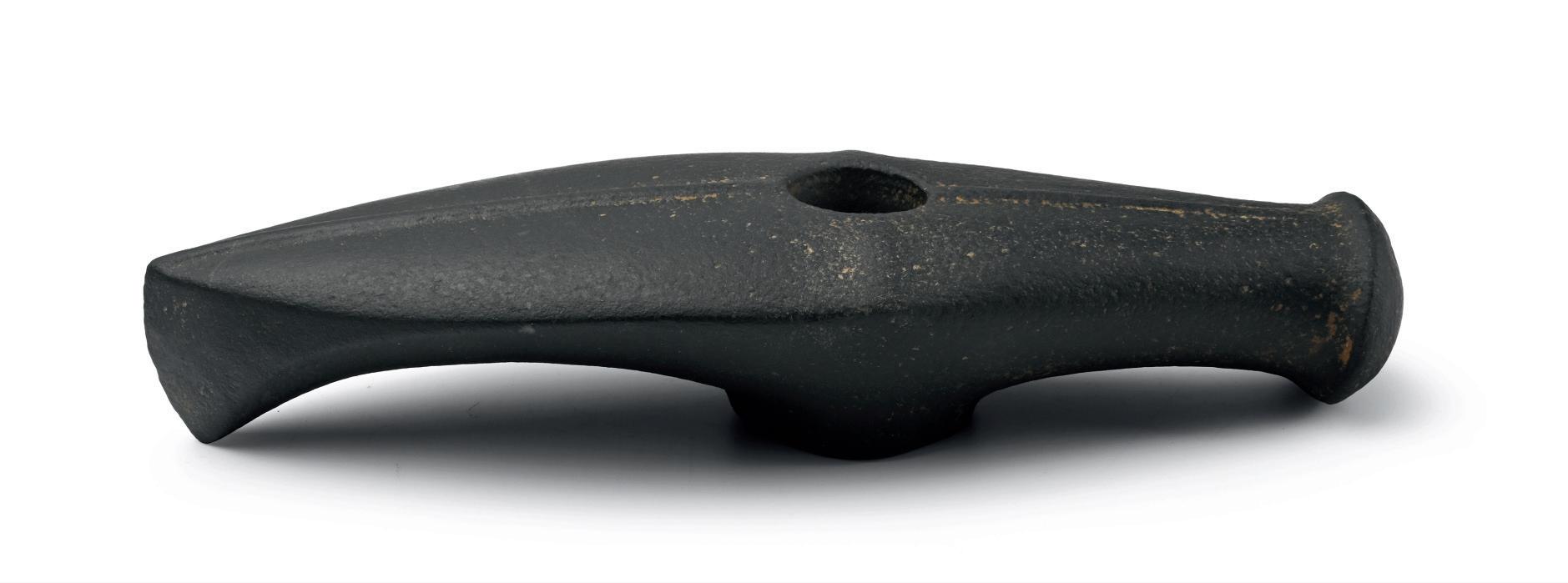
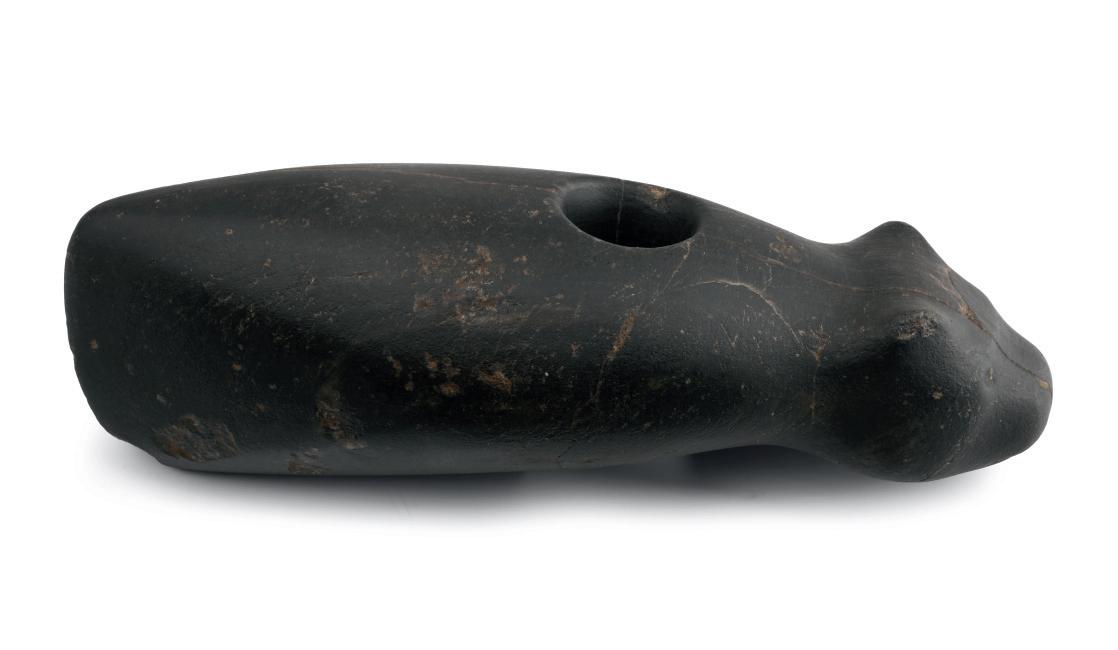


314

STONE AGE CORDED WARE POLISHED BATTLE AXEHEAD
NEOLITHIC PERIOD, LATE 5TH-EARLY 4TH MILLENNIUM B.P.
9 in. (912 grams, 23 cm)
A large and finely formed boat-shaped axe in a dark diorite with asymmetric convex cutting edge tapering, with pronounced ridge to upper surface copying a bronze casting seam, to shouldered and rounded hammer-butt, pierced to receive handle with projecting socket to underside. [No Reserve]
£3,000 - 4,000
PROVENANCE:
From the private collection of a London gentleman, from his grandfather’s collection formed before the early 1970s.
315

STONE AGE FATYANOVO POLISHED BATTLE AXEHEAD WITH BEAR’S HEAD
NEOLITHIC PERIOD, 5TH MILLENNIUM B.P.
7 in. (7¼ in.) (647 grams, 17.7 cm (1.15 kg total, 18.5 cm including stand))
Knapped and polished axehead with rounded body, narrow edge to the blade, butt formed as a bear’s head with small ears; mounted on a custom-made stand.
£2,000 - 3,000
PROVENANCE:
From the private family collection of a lady, UK; acquired in Germany mid 20th century.
316
EXTREMELY LARGE BRITISH BRONZE AGE BATTLE-AXE EARLY BRONZE AGE, CIRCA 5500-3500 B.P.
7½ in. (2.63 kg total including stand, axe: 19.2 cm)
Pecked basalt surface, boat-shaped with straight cutting edge tapering to flat butt; drilled to receive handle; mounted on a custommade stand.
£600 - 800
PROVENANCE:
Found Cumbria, N.W. England. Acquired on the UK art market.
From the private collection of an East Anglian, UK, specialist collector.
317
CELTIC SANDSTONE HEAD OF A DEITY
IRON AGE, 2ND CENTURY B.C.-1ST CENTURY A.D. OR LATER
11¾ in. (10.54 kg total, 30 cm high including stand)
Heater-shaped in profile with reserved low-relief brow, vertical bar nose, shallow socket mouth; mounted on a custom-made stand.
£600 - 800
PROVENANCE: Acquired between the 1970s and 1980s.
From the private collection of John Watson, Cambridge, UK.
318
LARGE BRONZE AGE POSAMENTERIEFIBEL BROOCH
CENTRAL EUROPE, 11TH CENTURY B.C.
11 in. (600 grams total, 28 cm high including stand)
Lacework type with large spiral disc extending to a shank and finial spring returning to form the pin; three pairs of applied wire-coil lateral decorations attached with thick rectangular bands. [No Reserve]
£3,000 - 4,000
PROVENANCE:
From the collection of Dr Guenther Wiedner, Bayern, Germany, 1980s to 2015. Ex Gorny and Mosch, Munich, 22 July 2020, no.346.
From a private collection, Suffolk, UK.
319
BRONZE AGE DECORATED BOWL WITH LOOP HANDLE ‡ CIRCA 1000 B.C.
6 in. (182 grams, 15.2 cm wide)
With carinated profile, and flared rim, ancient rivetted repair to central base; strap handle to rear over ancient crack, with evidence of previous repairs.
£800 - 1,000
PROVENANCE:
Acquired in Austria in 2000.
Acquired by the present owner from the above.
320
CELTIC BRONZE BOAR STATUETTE IRON AGE, 1ST CENTURY B.C.-1ST CENTURY A.D.
2 in. (98 grams, 50 mm)
Modelled in the round with notches to the ridged back, sockets to the eyes, coiled tail.
£400 - 600
PROVENANCE:
From the collection of a Hampshire, UK, gentleman, established from the 1960s.
321

CELTIC BRONZE DUCK MOUNT ‡ 5TH-4TH CENTURY B.C.
2 in. (37 grams, 53 mm)
Ellipsoid in plan with raised wings folded to the back, sturdy neck, small head with large bill and domed lentoid eyes; pierced vertically for attachment.
£700 - 900
PROVENANCE:
Acquired in the mid 1980s-1990s.
Private collection, Switzerland, thence by descent. Private collection, since the late 1990s.


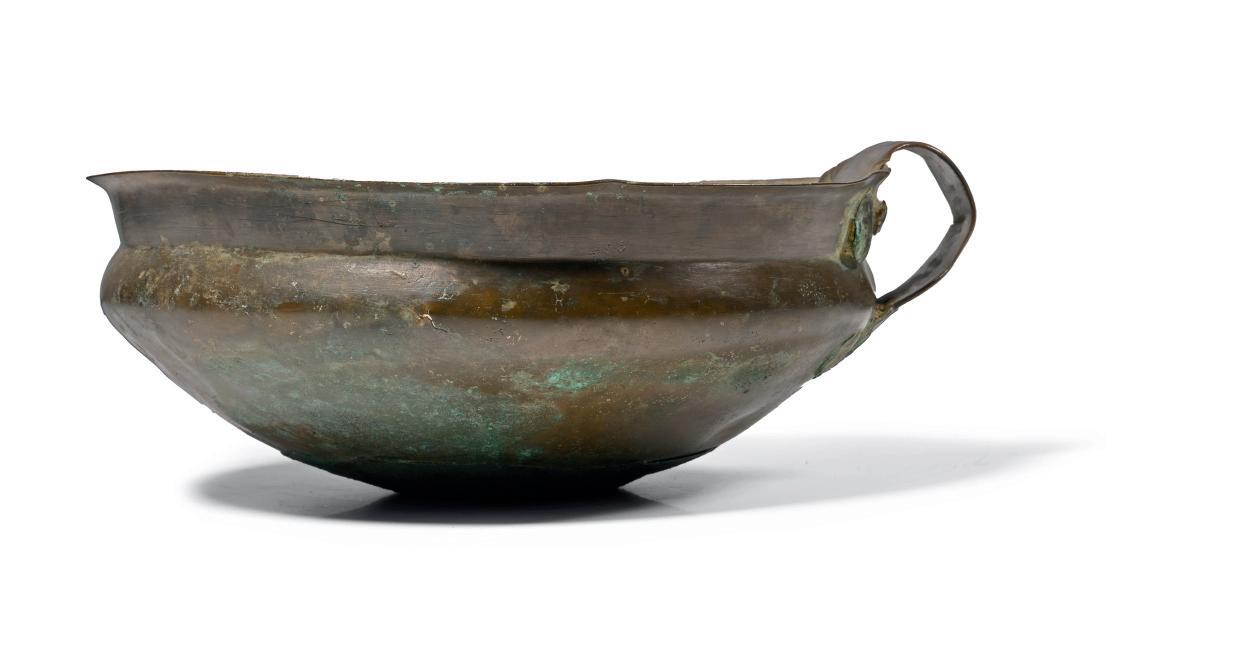
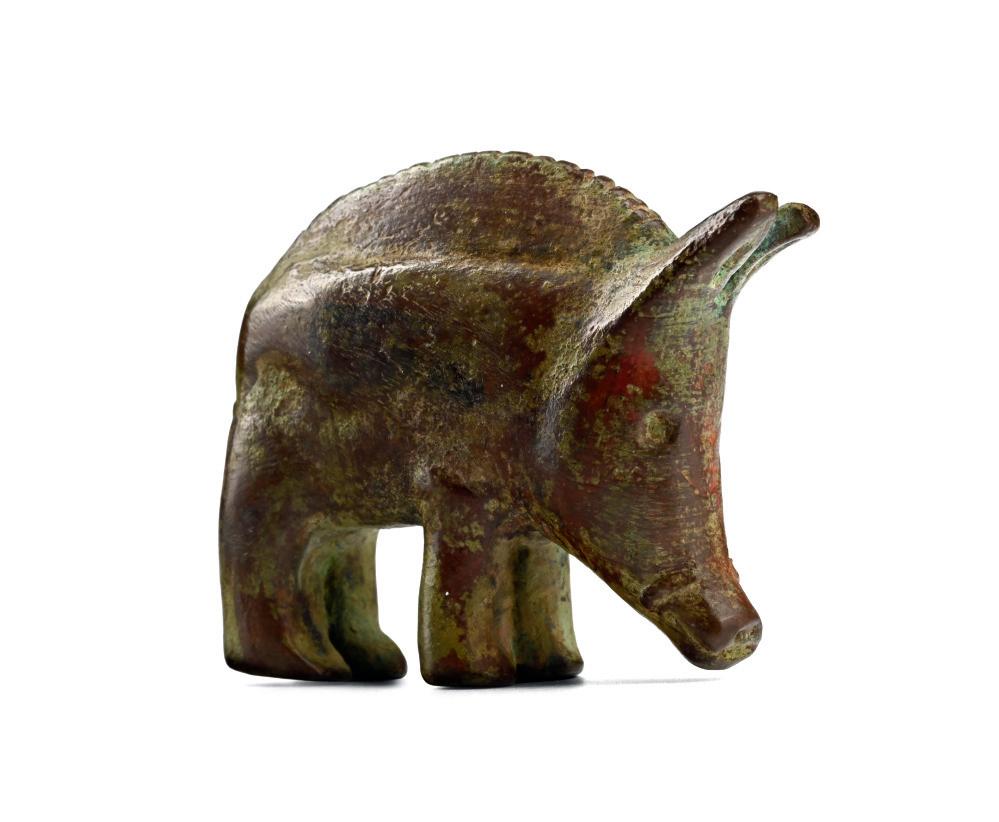
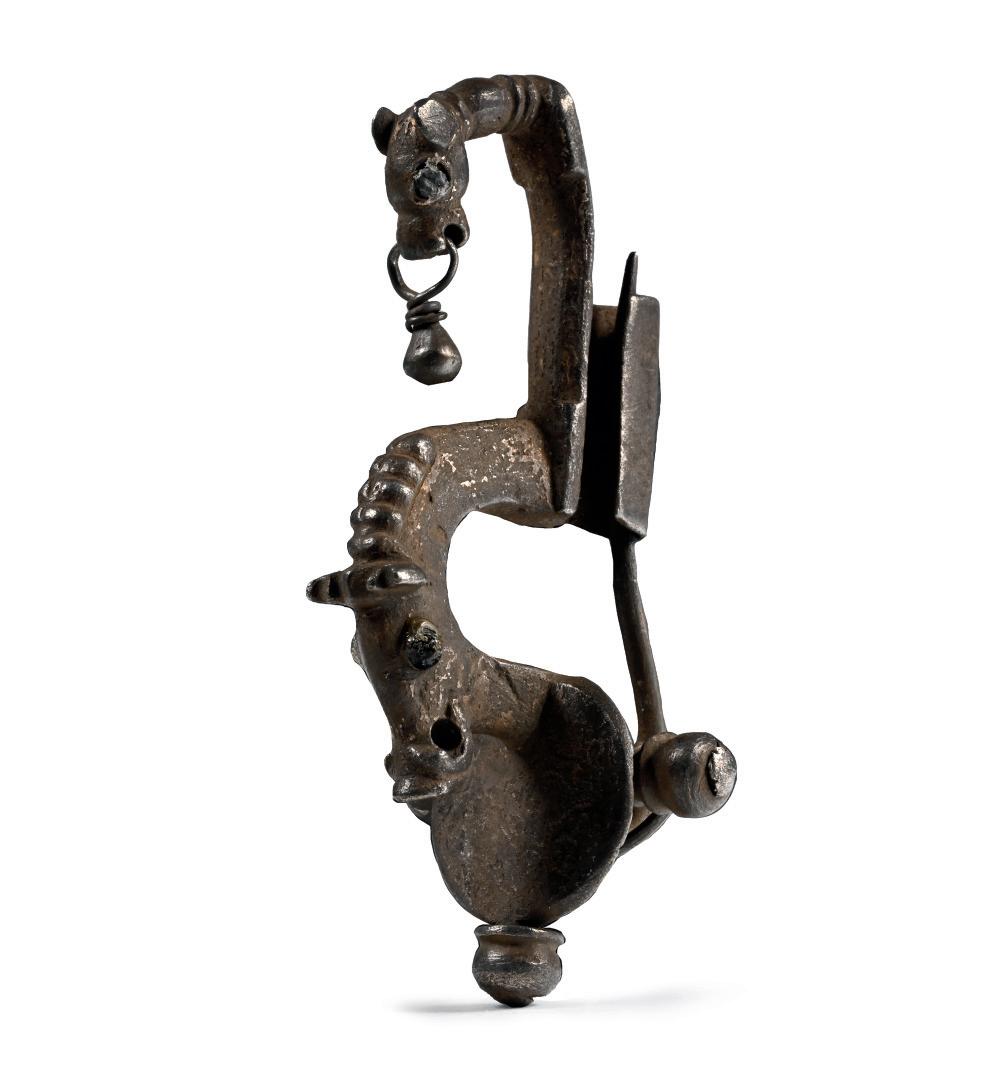
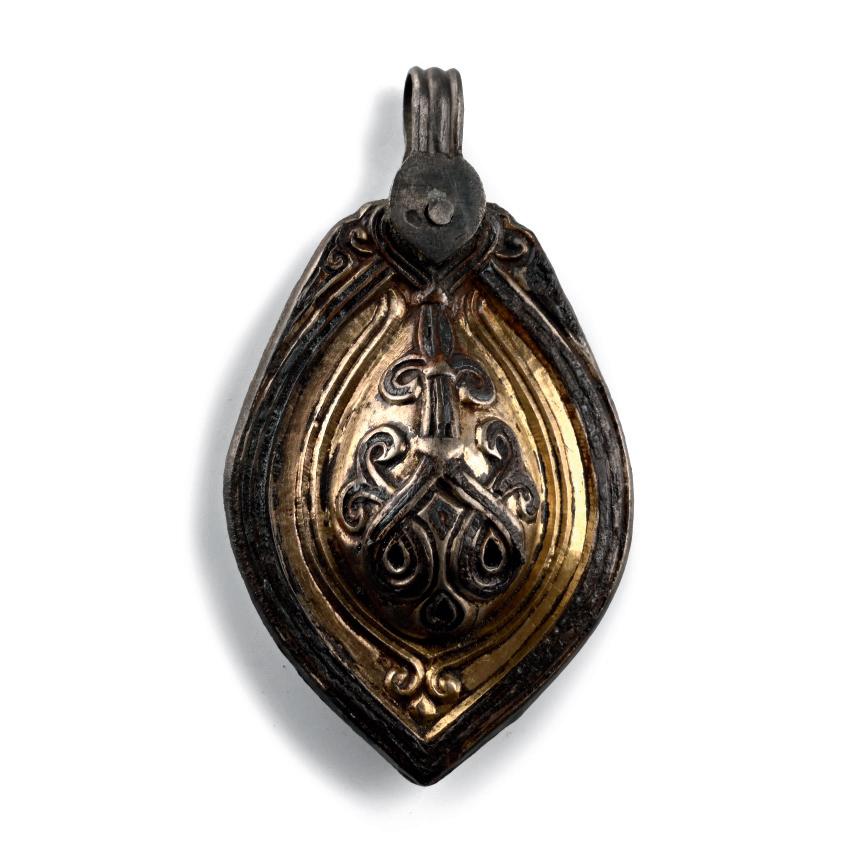

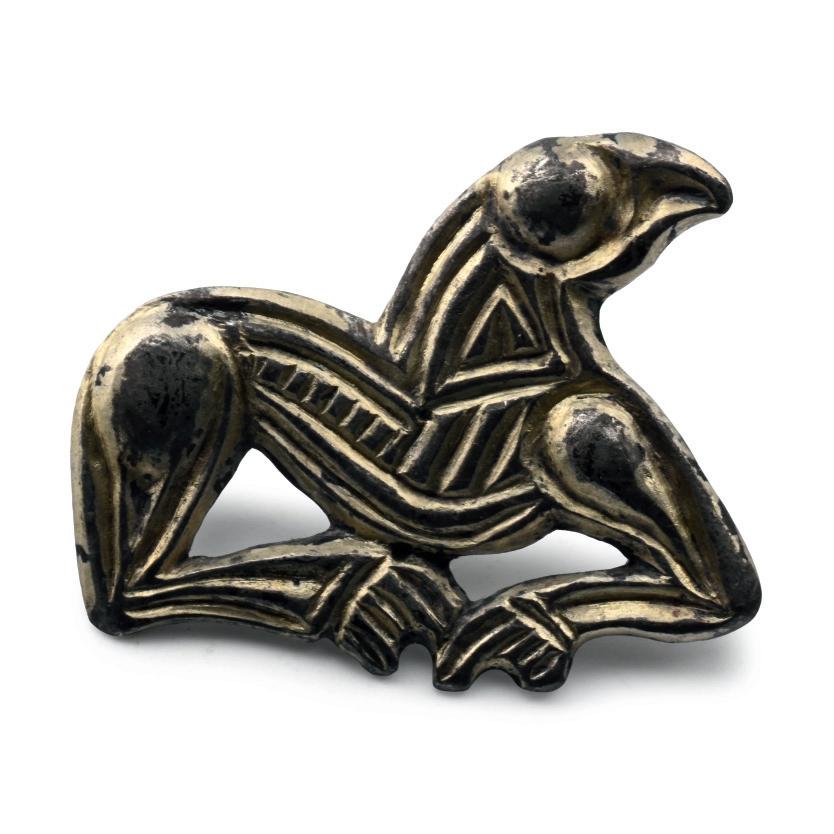
322

DARK AGE SILVER BOAR BOW BROOCH ‡
5TH-7TH CENTURY A.D.
2½ in. (28 grams, 65 mm)
Comprising a circular headplate with pointillé tendril ornament, and three radiating lugs, each with a flared collar below; deep D-section bow with boar-head modelling including open mouth and tusks, bristles and pricked ears; parallel-sided chamfered edges, recurved finial with dog-head detailing and teardrop dangle in the mouth; spring and pin to the reverse.
£1,500 - 2,000
PROVENANCE: with Artemis Gallery, Münich, before 1998. Acquired by the present owner from the above in 2001.
323
MEROVINGIAN SILVER-GILT BEAST BROOCH
4TH-6TH CENTURY A.D.
1¼ in. (8.71 grams, 31 mm)
Modelled in high-relief with billetted panels to the flank, bosses to the shoulder, hip and eye; pin-lug and catch to reverse. [No Reserve]
£300 - 400
PROVENANCE:
Acquired on the UK art market. Property of an East Anglia private collector.
324
VIKING AGE SILVER-GILT RATTLE HORSE HARNESS PENDANT
9TH-11TH CENTURY A.D.
3 in. (29.6 grams, 78 mm)
Teardrop-shaped with central pierced dome and plate to revere, ribbed suspension loop; parcel-gilt and niello design of grooved border with scroll terminal, boss with looped scrolls.
£700 - 900
PROVENANCE:
From the private collection of a London gentleman, from his grandfather’s collection formed before the early 1970s.
325
VIKING AGE SILVER CROSS PENDANT WITH HEAD OF A BEAST
11TH-12TH CENTURY A.D.
1 in (7.88 grams, 40 mm)
In Romanesque style, cruciform with openwork cross at centre, three oval terminals and a fourth modelled as a hound’s head, the beast’s mouth forming the suspension loop. [No Reserve]
£1,000 - 1,400
PROVENANCE: Acquired on the UK art market. Property of an East Anglian private collector.

326
ANGLO-SAXON GILT BRONZE GREAT SQUARE-HEADED BROOCH
6TH CENTURY A.D.
5 in. (75 grams, 15 cm)
With trapezoidal headplate, shallow bow, narrow triangular foot and disc finial, pin-lugs in ferrous accretion and catch to the reverse; the headplate with angled scaphoid panels to the upper corners and band of billets enclosing a band of guilloche with Salin’s Style I facing mask at the end of the bow; broad ribbed bow; lappets of Salin’s Style I profile horse-heads flanking the junction of the bow with the footplate with small facing mask between the necks; vertical bar running to the finial, bisecting a cruciform panel with Salin’s Style I zoomorphic forms; lateral plain lobes; finial comprising a disc connected to the vertical rib. [No Reserve]
£2,000 - 3,000
PROVENANCE: Found Weston Colville, Cambridgeshire, UK.
FOOTNOTES:
This magnificent brooch finds parallels with specimens derived from the group XVI-XVIII, according to Hines classification, from Market Overton II and Beckford A11. They represent, according to Hines, a transitional stage in the introduction of relief ornament into the headplate frame of brooches associated with group XVI.
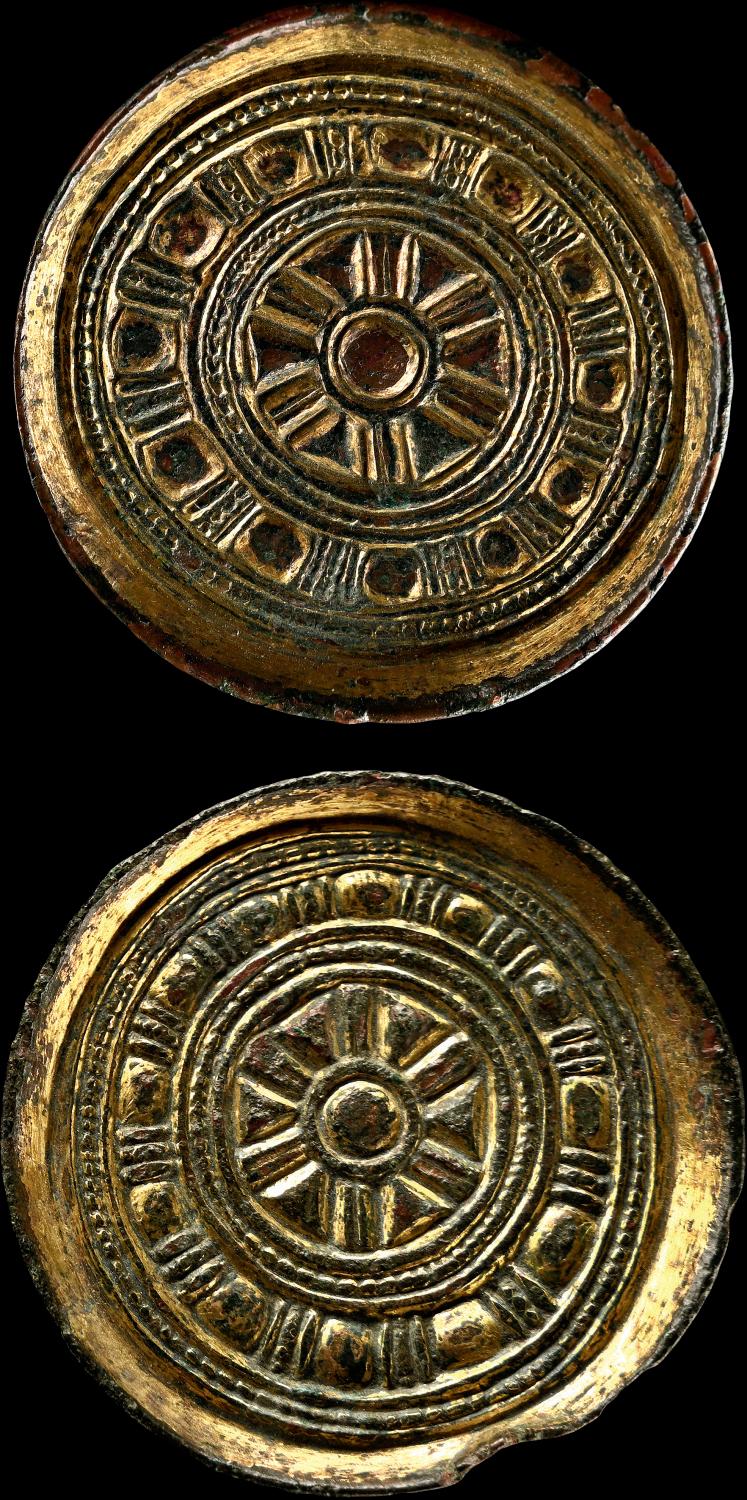
327
ANGLO-SAXON GILT BRONZE SAUCER BROOCH PAIR
5TH-6TH CENTURY A.D.
1 in. (50 grams total, 41-42 mm)
Matched pair, each with an upturned rim; concentric bands of pellets and segmented circles; pin-lug and catch to the reverse. [2, No Reserve]
£1,800 - 2,400
PROVENANCE: Found near Evesham, Worcestershire, UK, in 1992.
FOOTNOTES:
Saucer brooches are a female Saxon fashion, contemporary with the Anglian penannular and cruciform types, normally worn at the shoulders to secure a tubular dress.

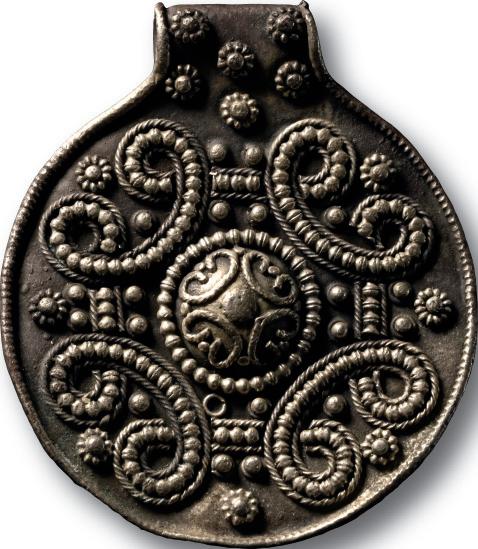

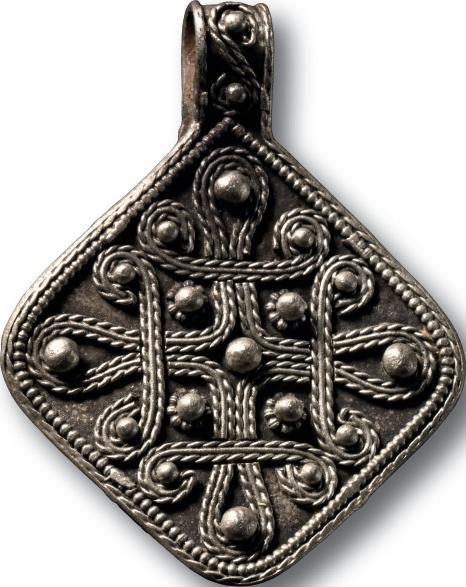
328

VIKING AGE SILVER DECORATED BRACELET
9TH-11TH CENTURY A.D.
2 in. (51 grams, 67 mm)
Penannular in form with thick rectangular panel and the ends thinned to wire and wound about the shank; dense pattern of punched lozenges and pellets.
£600 - 800
PROVENANCE:
From the private collection of a London gentleman, from his grandfather’s collection formed before the early 1970s.
329

VIKING AGE SILVER FILIGREE PENDANT
9TH-12TH CENTURY A.D.
1¼ in. (5.1 grams, 34 mm high)
Discoid with integral suspension loop, central dome, filigree scrolled knotwork and pellets. [No Reserve]
£600 - 800
PROVENANCE:
Private collection formed in Europe in the 1980s. Westminster collection, central London, UK.


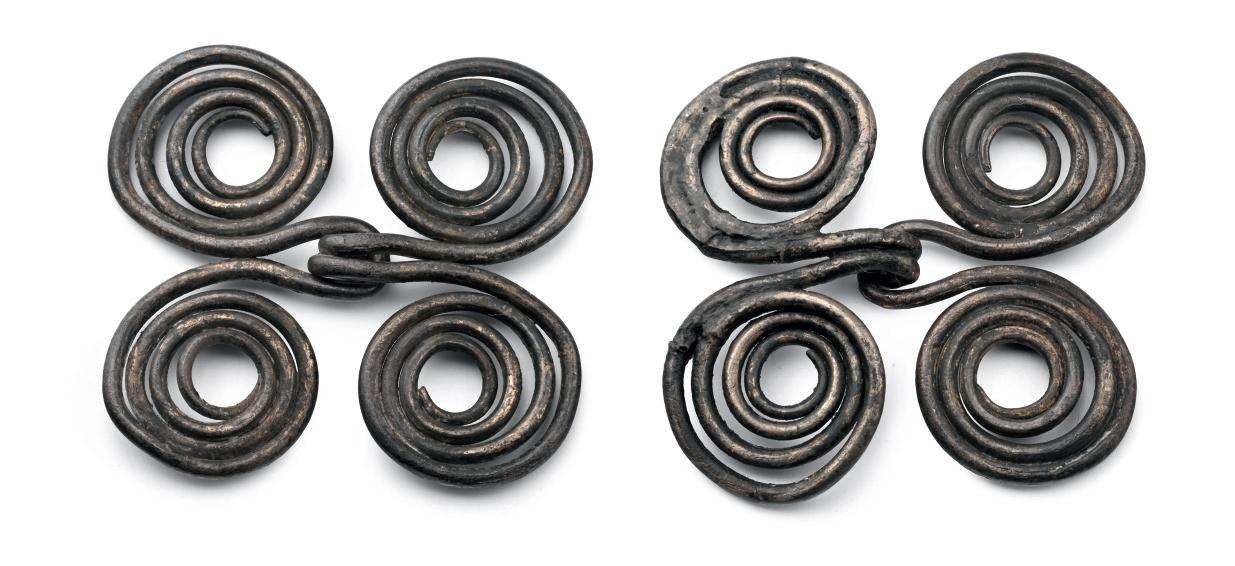
330

VIKING AGE SILVER FILIGREE PENDANT
9TH-11TH CENTURY A.D.
1½ in. (3.19 grams, 35 mm high)
Of lozengiform shape decorated with a knotwork motif in filigree, suspension loop with filigree ornament, faux ropework border around the whole. [No Reserve]
£500 - 700
PROVENANCE:
Private collection formed in Europe in the 1980s.
Westminster collection, central London, UK.
331
SCANDINAVIAN PRE-VIKING SILVER WRIST CLASP PAIR
5TH CENTURY A.D.
1½ in. (22.99 grams total, 36-38 mm)
A matched pair of spiral-coiled wrist-clasps of Hines’s Class A, each pair with one broad rounded loop to the centre and one returned hooked loop. [2]
£400 - 600
PROVENANCE: Property of a gentleman; acquired in the 1970s.
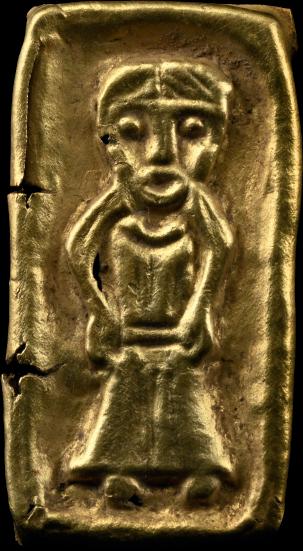
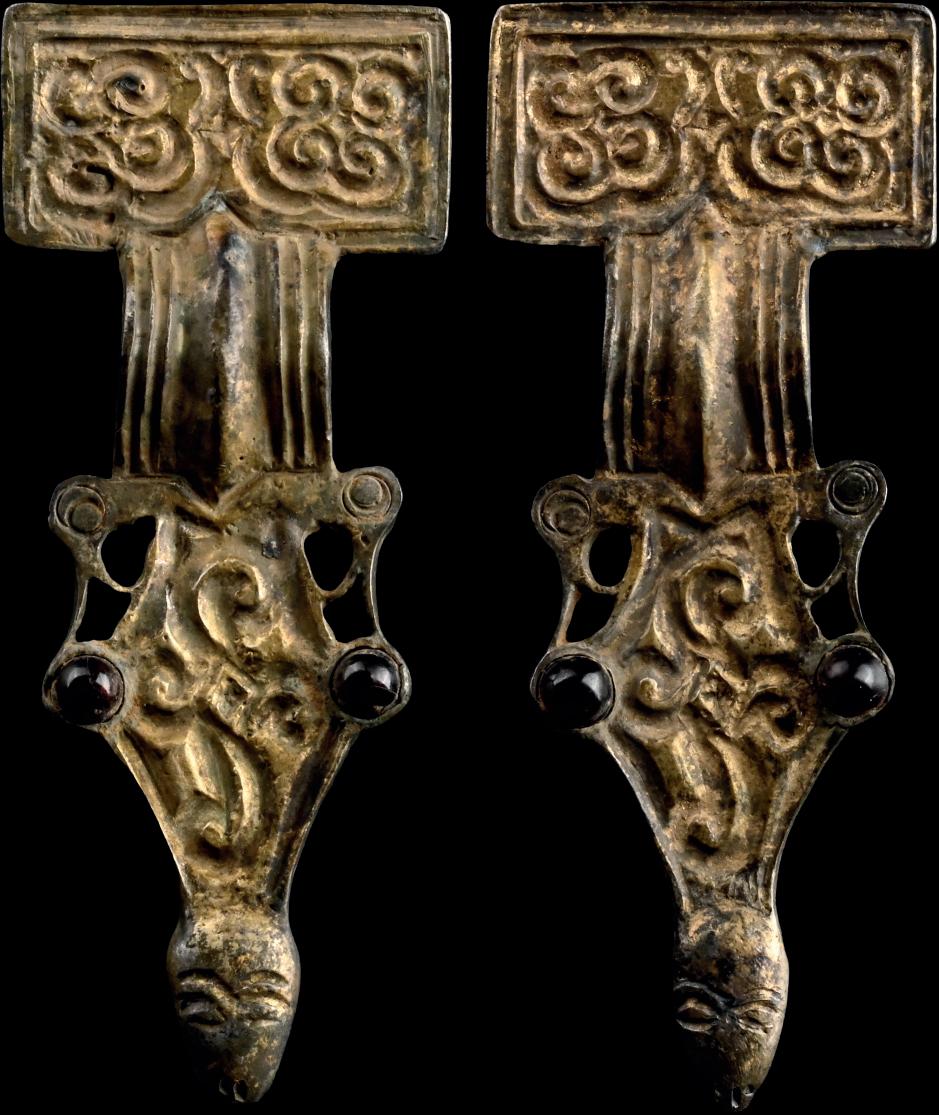
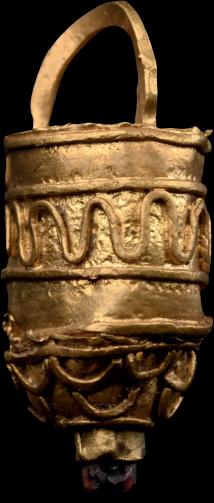
332
MEROVINGIAN SILVER-GILT BROOCH PAIR
CIRCA 6TH CENTURY A.D.
3 in. (35 grams total, 74 mm each)
Matched pair, each comprising a rectangular headplate with raised rim and low-relief scroll detailing; shallow bow with thick median rib and lateral ribbing; openwork bird-head lappets with punched ring detailing; lozengiform footplate with low-relief looped tendril motif, inset cabochon garnets; beast-head finial; pin-lug and catch to reverse. [2]
£1,200 - 1,700
PROVENANCE:
Ex German art market, 2000s.
Acquired from an EU collector living in London.
From the collection of a Surrey, UK, gentleman.
333
SCANDINAVIAN PRE-VIKING GOLD VOTIVE PLAQUE OF GULDGUBBE WITH GODDESS FACING
CIRCA 6TH CENTURY A.D.
1 in. (1.45 grams, 26 mm)
Sheet-gold plaque with folded edges, repoussé image of a facing figure in ankle-length robe, hands resting on the hips.
£2,000 - 3,000
PROVENANCE:
From the private collection of a London gentleman, from his grandfather’s collection formed before the early 1970s.
334

PRE-VIKING GOLD AROMA BUCKET PENDANT 4TH-7TH CENTURY A.D.
¾ in. (1.28 grams, 19 mm)
Miniature drum-shaped vessel with strap handle, beaded wire bands to the bottom and sidewall, polished red stone insert to the base. [No Reserve]
£500 - 700
PROVENANCE:
From the private collection of a London gentleman, from his grandfather’s collection formed before the early 1970s.
335
SAXON GOLD TEARDROP PENDANT WITH CABOCHON GARNET LATE 5TH-EARLY 6TH CENTURY A.D. in. (0.66 grams, 16 mm)
With inset polished cabochon garnet, suspension loop above.
£600 - 800
PROVENANCE:
From the private collection of a London gentleman, from his grandfather’s collection formed before the early 1970s.
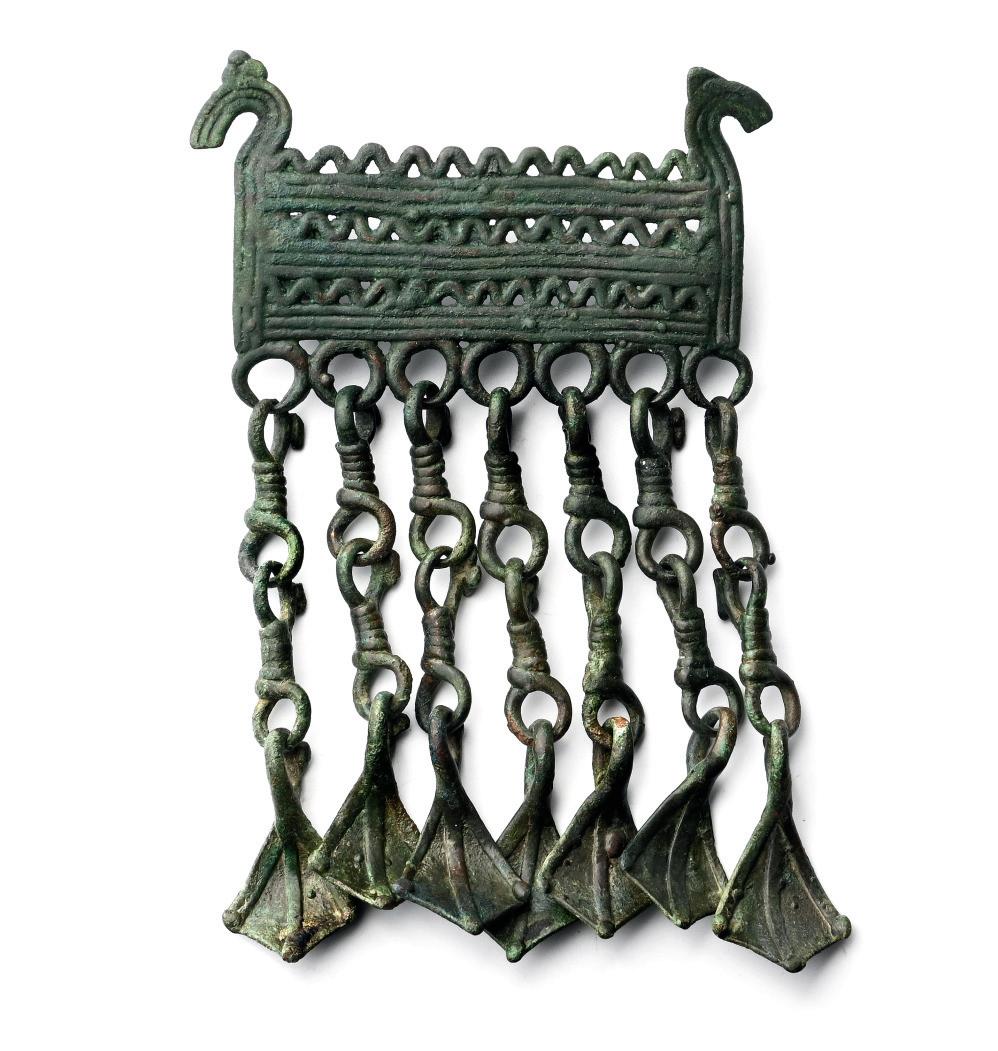
336
VIKING AGE BRONZE PENDANT WITH FOOT DANGLES
9TH-10TH CENTURY A.D.
3 in. (49.2 grams, 98 mm)
Openwork rectangular plaque with stylised curved finials, pair of attachment loops to the reverse; seven suspension loops to the underside, each with a duck foot dangle; Finno-Ugric type. [No Reserve]
£300 - 400
PROVENANCE:
From the private collection of a London gentleman, from his grandfather’s collection formed before the early 1970s.
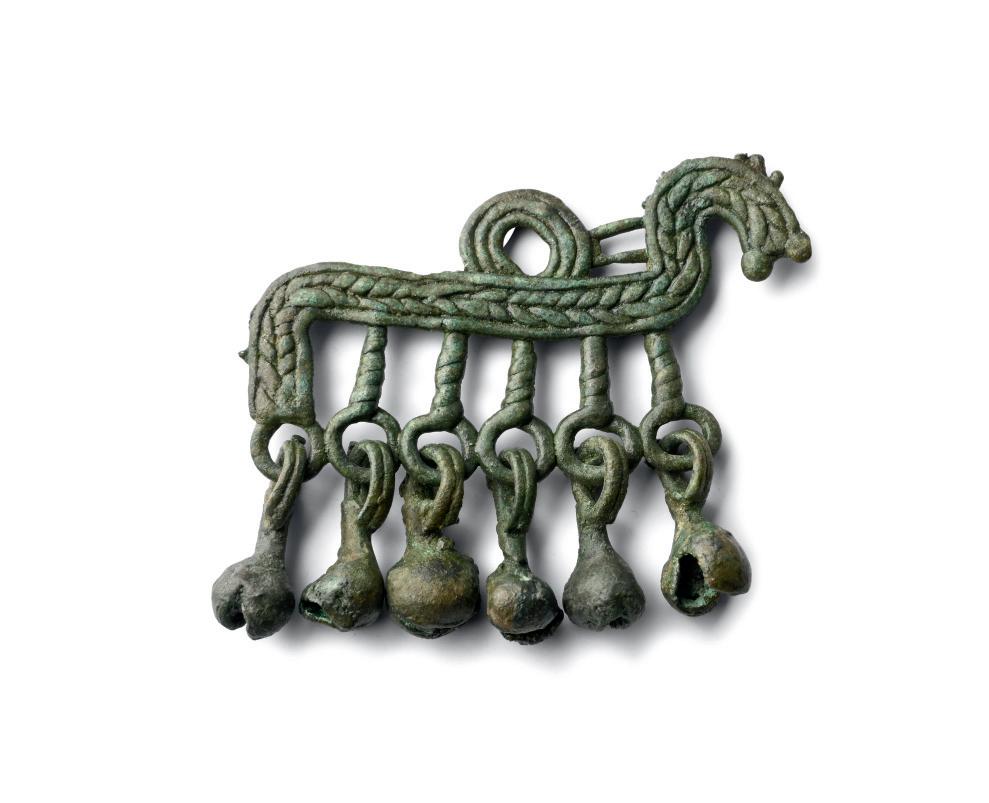
338
VIKING AGE BRONZE PENDANT WITH BELL DANGLES
8TH-10TH CENTURY A.D.
2 in. (18.5 grams, 54 mm)
Horizontal braided band with horse-head finial, suspension loop to the top; band of loops to lower edge, each with a bell dangle; FinnoUgric type. [No Reserve]
£300 - 400
PROVENANCE:
From the private collection of a London gentleman, from his grandfather’s collection formed before the early 1970s.
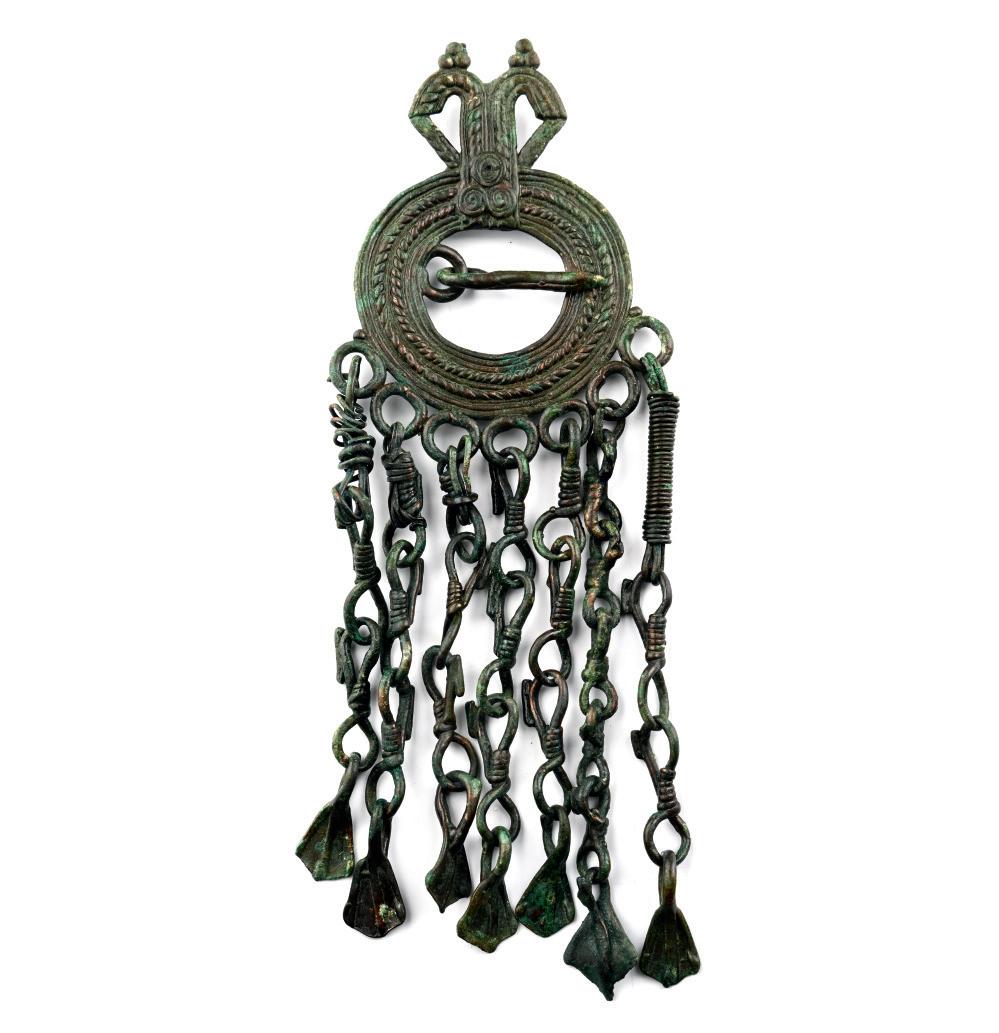
337
VIKING AGE BRONZE ANNULAR BROOCH
8TH-10TH CENTURY A.D.
6 in. (87 grams, 17.5 cm)
With ropework detailing to the hoop, hooks and granule clusters above, row of loops to lower edge, each with an articulated chain and duck-foot finial; Finno-Ugric type.
£300 - 400
PROVENANCE:
From the private collection of a London gentleman, from his grandfather’s collection formed before the early 1970s.

339
VIKING AGE BRONZE ANNULAR BROOCH
8TH-10TH CENTURY A.D.
5 in. (157 grams, 15 cm)
With openwork braid detailing to the hoop, spiral finials above and zigzag band behind the rim with granule clusters, row of loops each with an articulated chain and attached jingle; Finno-Ugric type.
£700 - 900
PROVENANCE:
From the private collection of a London gentleman, from his grandfather’s collection formed before the early 1970s.
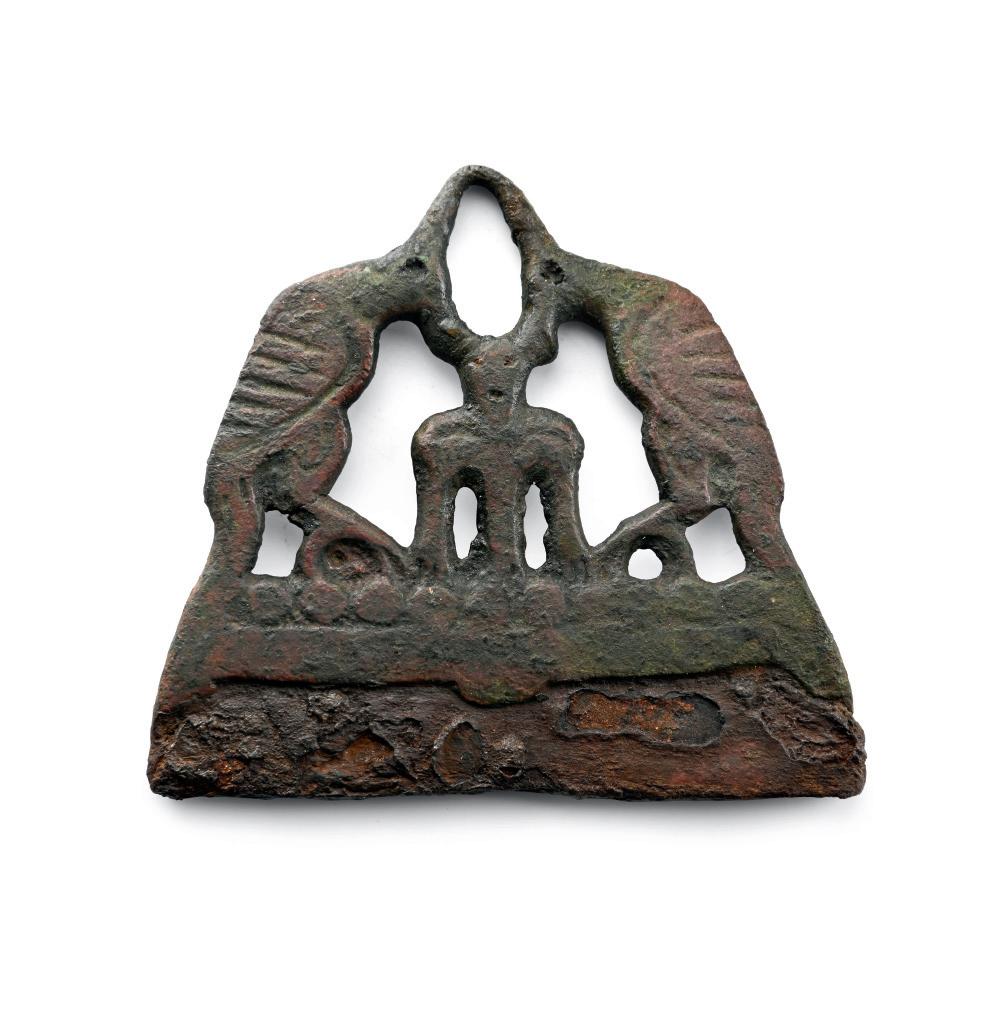
340
VIKING AGE BRONZE FIRE STEEL WITH ODIN AND RAVENS
10TH CENTURY A.D.
2 in. (40 grams, 61 mm)
Comprising a rectangular iron block with striking face mounted in a bifacial openwork bronze handle formed as two large ravens perching with necks bent over a central figure.
£600 - 800
PROVENANCE:
From the private collection of a London gentleman, from his grandfather’s collection formed before the early 1970s.

342
VIKING DECORATED BRONZE LATCH KEY
8TH CENTURY A.D.
3½ in. (19 grams, 90 mm)
A bifacial latch-lifter with square openwork head, flat-section shank with a barbed finial, pierced to accept a suspension ring; three piercings to the head, two B-shaped, and a larger T-shape, scrolled centre bar; scrolled lappets above the junction with the shank, and two scaphoid depressions to each face and ring-and-dot decoration throughout.
£800 - 1,000
PROVENANCE:
From a private UK collection formed since the 1980s.
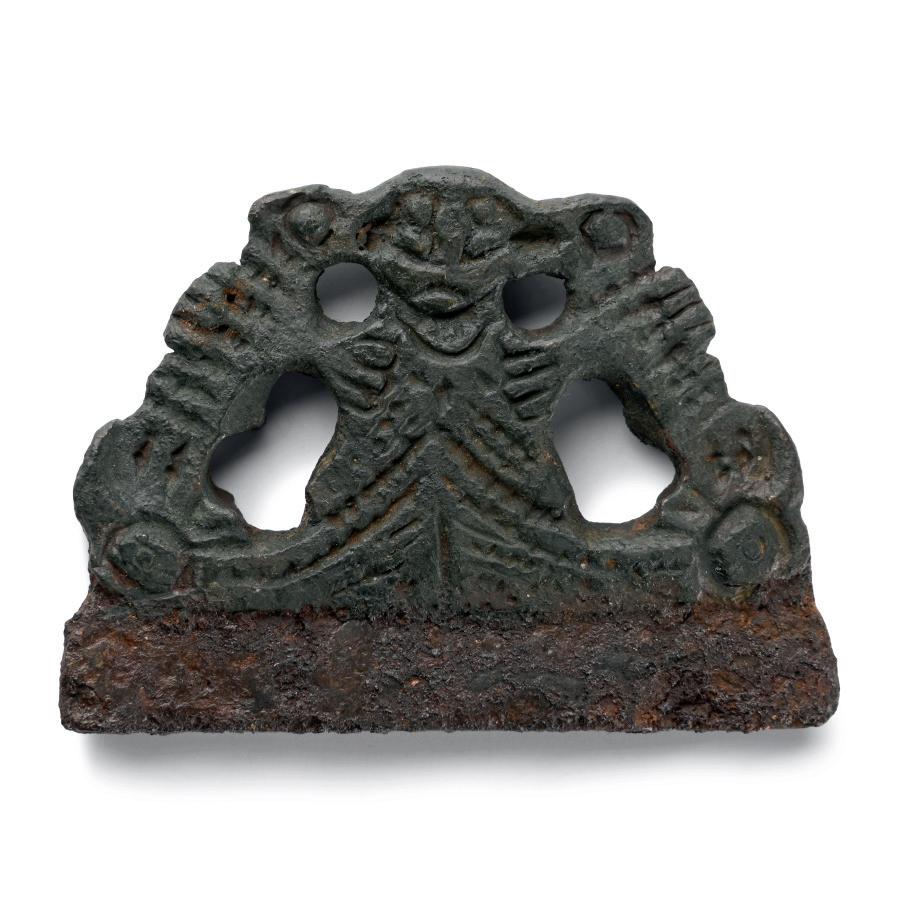
341
VIKING AGE BRONZE FIRE STEEL WITH FIGURE AND ANIMALS
8TH-10TH CENTURY A.D.
2 in. (58 grams, 60 mm)
With openwork bifacial handle depicting central standing figure with arms outstretched towards the necks of two flanking rampant beasts; iron blade beneath; Finno-Ugric type.
£600 - 800
PROVENANCE:
From the private collection of a London gentleman, from his grandfather’s collection formed before the early 1970s.
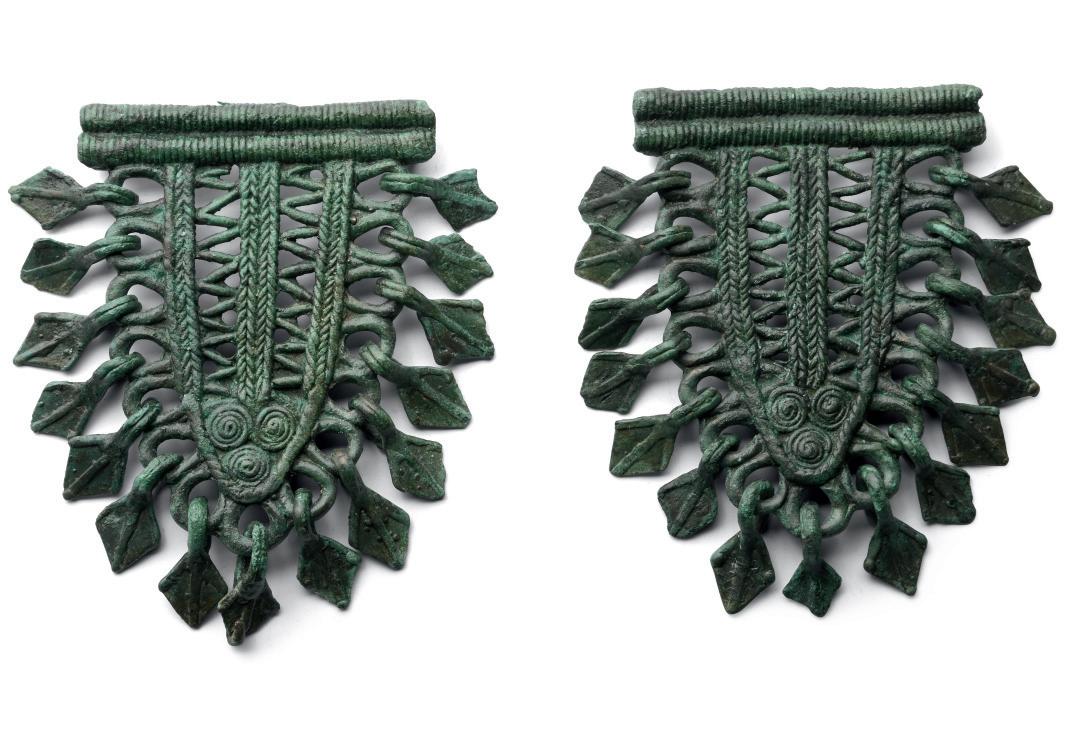
VIKING AGE BRONZE PENDANT PAIR
8TH-10TH CENTURY A.D.
4 - 4¼ in. (255 grams total, 10.5-10.9 cm)
Each a tongue-shaped plaque with openwork construction, ribbed tubes to the upper edge with loops to the reverse, braided wire and concentric circle detailing; rim formed as loops each with a duck-foot pendant; Finno-Ugric type. [2]
£600 - 800
PROVENANCE:
From the private collection of a London gentleman, from his grandfather’s collection formed before the early 1970s.
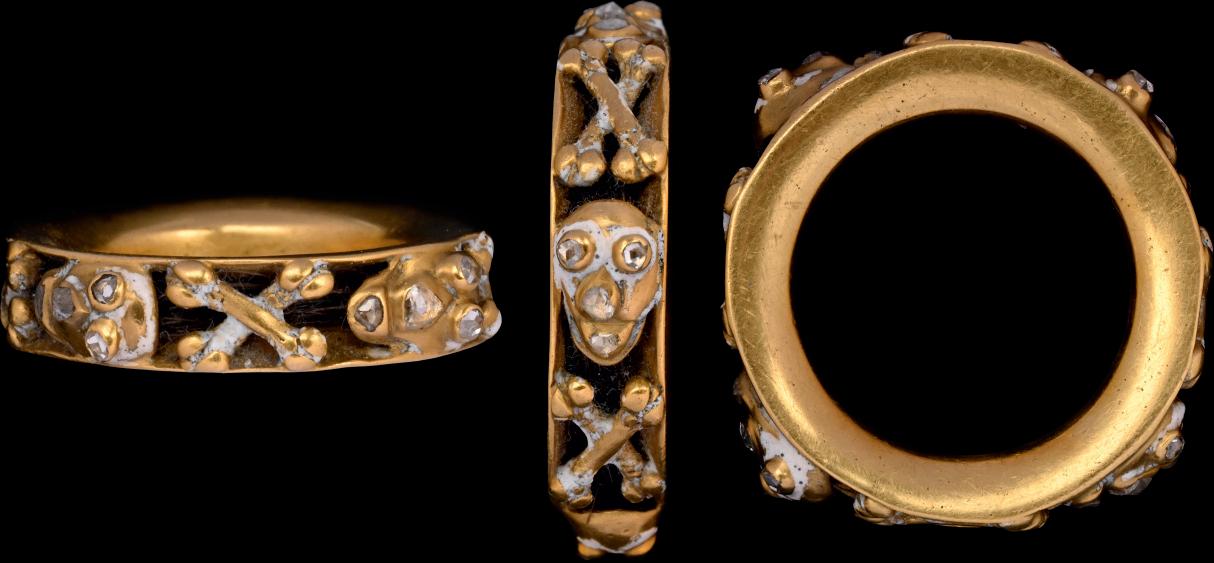
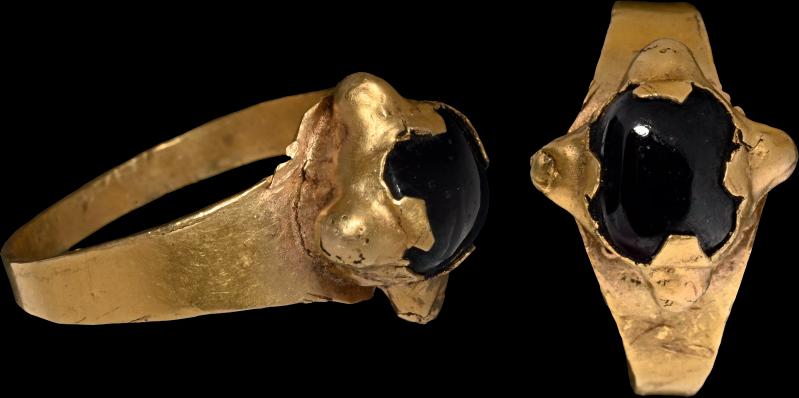
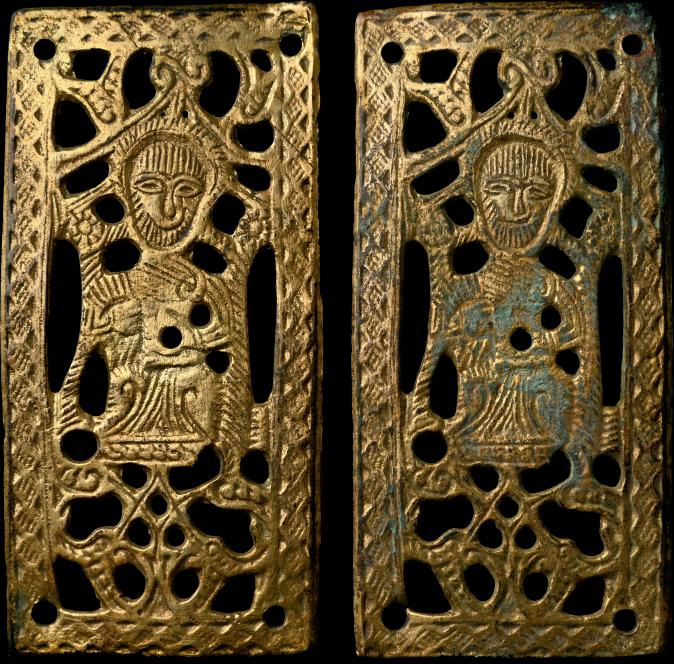

344

STUART PERIOD GOLD MEMENTO MORI RING WITH JEWELLED SKULLS AND CROSSED BONES 17TH CENTURY A.D.
1 in. (10.99 grams, 27.06 mm overall, 15.95 mm internal diameter (approximate size British K½, USA 5½, Europe 10.58, Japan 10))
Comprising a hefty hoop with scooped upper face, alternating applied skulls and crossed bones on the upper face decorated with white enamel, the eyes, noses and mouths of the skulls set with diamonds(?).
£6,000 - 8,000
PROVENANCE:
Private collection of a North London lady before 2000. Property of a London, UK, gentleman.
345
LARGE MEDIEVAL GOLD GLOVE RING WITH CABOCHON 12TH-14TH CENTURY A.D.
1¼ in. (7.98 grams, 33.09 mm overall, 23.73 mm internal diameter (approximate size British Z+3, USA 13¾, Europe 32.57, Japan 31))
Flat-section hoop with applied cell formed as a cushion with four radiating knops on the shoulder, open top revealing inset irregular polished garnet.
£800 - 1,000
PROVENANCE: Acquired on the European art market in the 1990s. UK collection of a European gentleman.
346
MEDIEVAL GILT PLAQUES WITH EVANGELISTS SERBIA, 14TH CENTURY A.D.
2½ in. (13.80 grams total, 61 mm each)
A pair of copper or brass gilt plaques with openwork representation of two nimbate Evangelists, holding a gospel with the left hand, the right hand raised for blessing, four fastening holes at the corners. [2, No Reserve]
£600 - 800
PROVENANCE:
Ex central London gallery; acquired on the UK art market. From the private collection of John Meredith, acquired since the 1990s; thence by descent.
347
SICILIAN GOLD EARRINGS WITH PEARLS SOUTH ITALIAN, 1860-1910 CENTURY A.D.
2¼ in. (7.81 grams total, 58-60 mm)
Matched pair, each formed as a ring enclosing a natural irregular pearl above a tongue-shaped arched panel with two strands of smaller pearls, band of filigree coils to the outer edge, teardrop dangle below with pearl to the centre; hoop and catch to the reverse. [2]
£600 - 800
PROVENANCE: Ex Georgie Chrischilles. Private collection, London.
348

RENAISSANCE GOLD RING WITH DIAMOND CRYSTAL EARLY 16TH CENTURY A.D.
1 in. (4.19 grams, 27.25 mm overall, 17.52 mm internal diameter (approximate size British O, USA 7, Europe 14.98, Japan 14))
Slender hoop with raised shoulders leaves displaying leaves and volutes, quatrefoil bezel with stepped edges and set with a point-cut diamond crystal.
£4,000 - 6,000
PROVENANCE:
Private collection of a North London lady before 2000. Property of a London gentleman.
FOOTNOTES:
This type ring seems to have been very popular in Renaissance Europe during the late 16th and early 17th centuries. Numerous parallels and portraits give evidence for this fashion. Similar ring types are in the National Museum of Bargello, Firenze, and Ashmolean Museum, Oxford.
349

‘THE CAUNTON’ MEDIEVAL GOLD RING WITH COBALT BLUE GEMSTONE
1300-1400 A.D.
1 in. (2.01 grams, 24.17 mm overall, 20.02 mm internal diameter (approximate size British R, USA 8½, Europe 18¾, Japan 18))
With plain circular hoop with circular cross-section, attached to the shoulders of the pentagon-shaped bezel and set with natural cobalt blue polished stone, possibly a cabochon sapphire; the hoop professionally straightened and re-joined.
£1,200 - 1,700
PROVENANCE: Found whilst searching with a metal detector near Caunton, Newark and Sherwood, Nottinghamshire, East Midlands, by David Dillon on Thursday 19th May 2022, declared as Treasure and disclaimed by the Crown with Treasure case no.2022 T752.
Accompanied by a copy of the British Museum’s Portable Antiquities Scheme (PAS) report no.DENO-23C183.
Accompanied by a letter from the finder describing the circumstances of finding.
350

TUDOR PERIOD GOLD RING WITH CABOCHON 16TH-17TH CENTURY A.D.
1 in. (4.01 grams, 23.57 mm overall, 17.17 mm internal diameter (approximate size British M, USA 6, Europe 12.46, Japan 12))
With hatched balusters to the shoulders, dentilled plaque with inset conical glass stud.
£600 - 800
PROVENANCE: Ex German art market, 2000s.
Acquired from an EU collector living in London. From the collection of a Surrey, UK, gentleman.
351

GOLD FEDE RING WITH HANDS HOLDING A HEART MID-17TH CENTURY A.D.
¾ in. (3.24 grams, 21.13 mm overall, 18.50 mm internal diameter (approximate size British O½, USA 7¼, Europe 15.61, Japan 15))
With a gold flat-section hoop, bezel formed as two hands supporting a heart, a flower ornament to each shoulder with traces of white enamel.
£1,200 - 1,700
PROVENANCE:
From an old European collection, 1990s.
From a Cambridgeshire, UK, private collection.
FOOTNOTES:
The fine craftsmanship and design suggest it could have been a ring commemorating the wedding of Charles II and Catherine of Braganza in 1662.





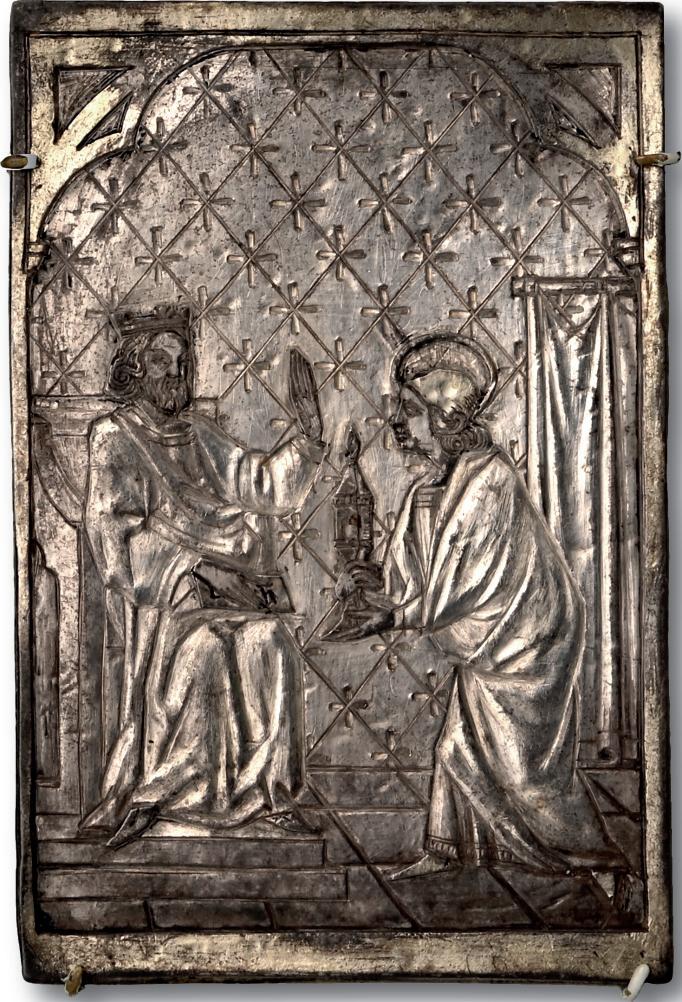
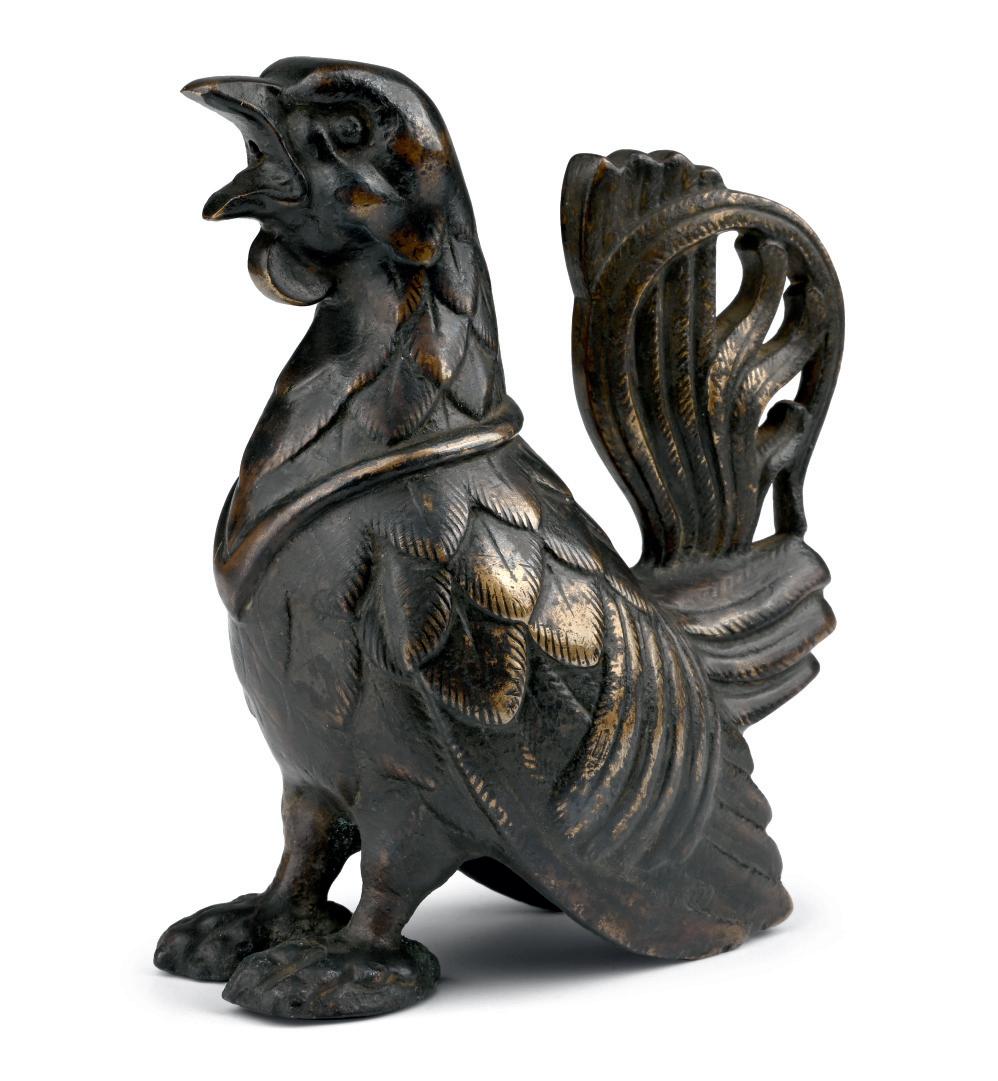
352

MEDIEVAL BRONZE ALTAR CROSS ON TRIPOD BASE ‡ 10TH-11TH CENTURY A.D.
9¼ in. (669 grams, 23 cm)
Comprising an expanding-arm cross supporting a short neck with disc finial above; below, a short shank with trumpet-shaped baluster and triangular base, scooped in profile with segmented radiating legs and domed feet; a knop placed between each pair of legs.
£3,500 - 4,500
PROVENANCE: with Juliette Noujaim, Arqueologie, Islamic Art, Le Louvre des Antiquaires, Paris. Acquired by the present owner from the above in 2005.
353

MEDIEVAL BRONZE AQUAMANILE IN THE SHAPE OF A CAPERCAILLIE
LOWER SAXONY, 13TH CENTURY A.D. in. (670 grams, 11.9 cm)
Hollow-formed perching bird filler-hole to top of head and spout in beak; openwork tail with scroll detailing; hatched borders to feathers. [No Reserve]

£4,000 - 6,000
PROVENANCE:
From the Minervino Gabardi collection.
EXHIBITED:
The Museum Für Kunsthandwerk, Frankfurt, Germany.
354


MEDIEVAL SILVER-GILT PLAQUE WITH THE PRESENTATION
NORTHERN FRANCE OR FLANDERS, CIRCA 1400 A.D.
3¾ in. (5 in.) (245 grams total, plaque: 94 mm, 15 cm including stand)

Rectangular plaque with reserved border, gothic architectural detailing to upper corners, low-relief figural scene comprising: to left, seated figure on dais wearing a crown and floor-length robes holding a book on his knees, his left hand raised palm-outwards; to right, an advancing nimbate figure in ankle-length robe bowing and presenting a reliquary; wall-hanging to rear, the wall with pattern of lozenges with crosses at the nodes; mounted on a display stand. [No Reserve]
£2,000 - 3,000
PROVENANCE:
From the collection of Mrs Chester D. Tripp. Gifted to the Cleveland Museum of Art in honour of William Wixom, 1979. Deaccessioned by the museum prior to 2000.
Ex central London gallery.
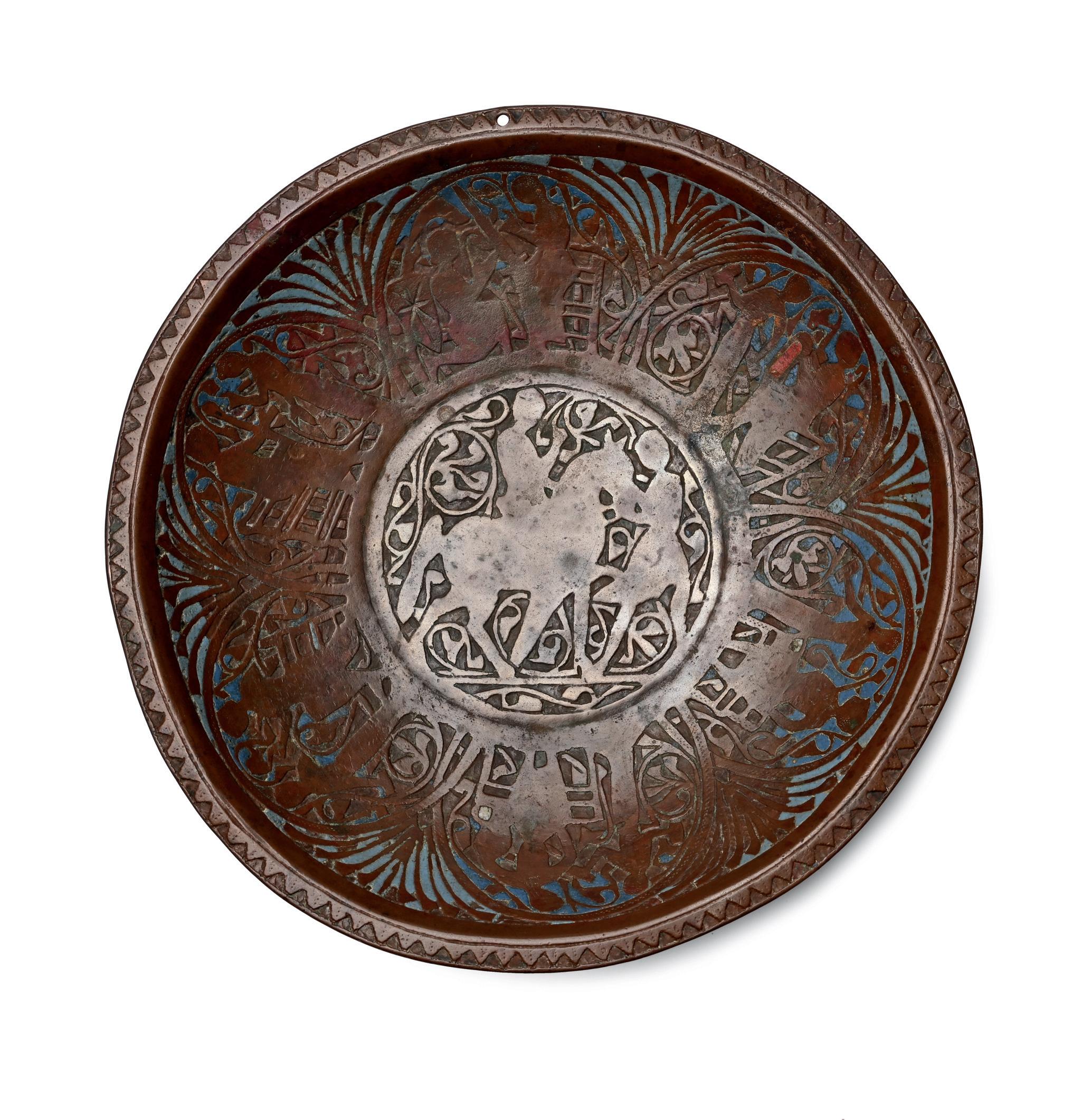
355

MEDIEVAL ENAMELLED COPPER GEMELLION WITH NOBLEMAN ON HORSEBACK
FRANCE, LIMOGES, CIRCA 1220-1240 A.D.
8 in. (642 grams, 22.5 cm)
Hemispherical in profile with broad base and flat everted rim pierced to the top; central image of horse rider and an attendant, encircled with six smaller court scenes; remains of dark blue, pale blue, white and red champlevé enamel; incised to the reverse is twelve-pointed star with fleur-de-lys finials, encircled octagonal flower to the centre with dotted background. [No Reserve]
£10,000 - 14,000
PROVENANCE:
Ex Sotheby’s, London, 9 July 2009, no.5. From a private collection, Suffolk, UK.
FOOTNOTES:
The name ‘gemellion’ comes from the Latin word for twin. They were shallow bowls used in pairs for washing hands, with one usually having a short spout and a strainer. Gemellions produced in Limogenes were commonly enamelled and often decorated with chivalric scenes, such as this fine example.

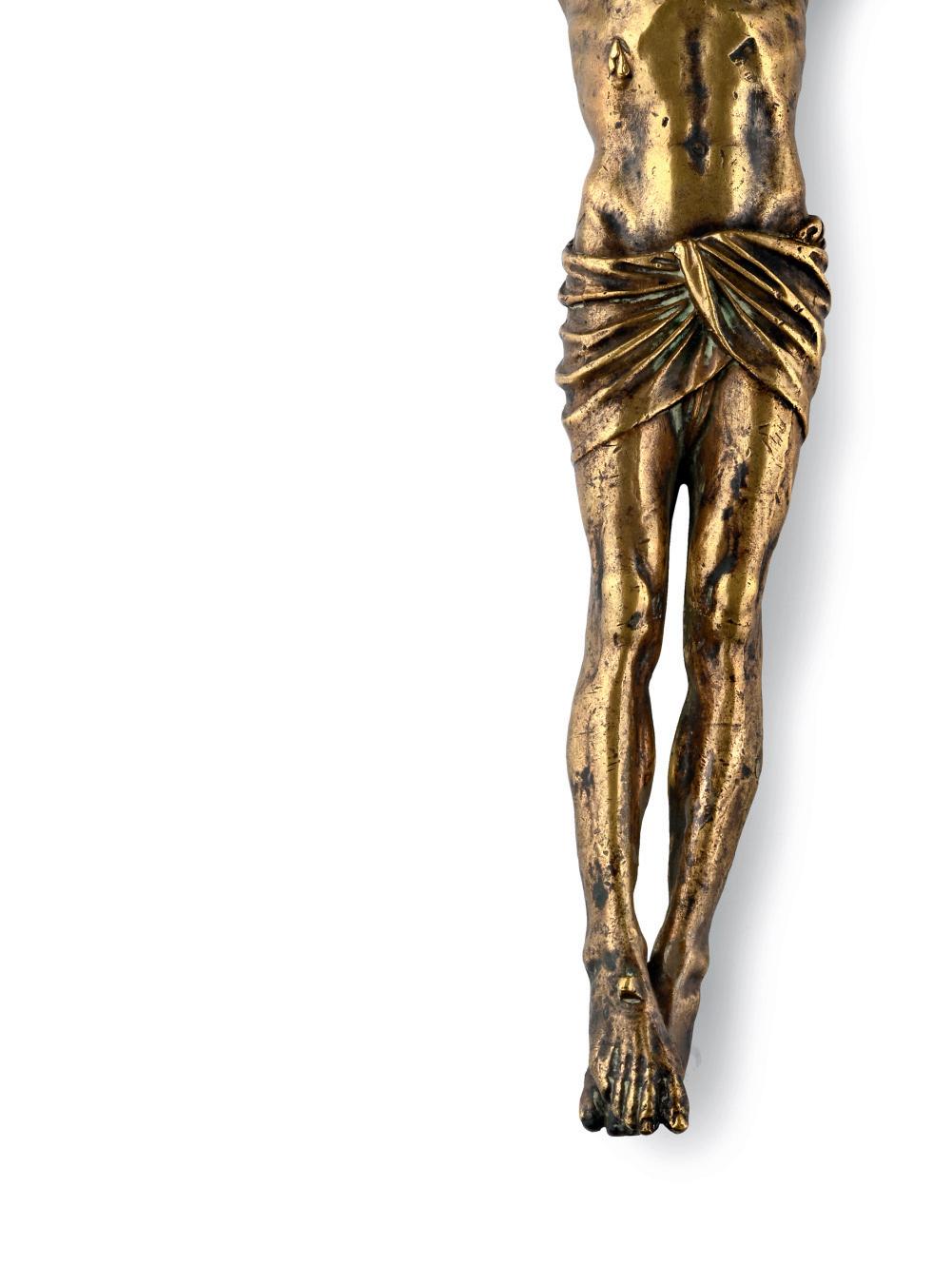
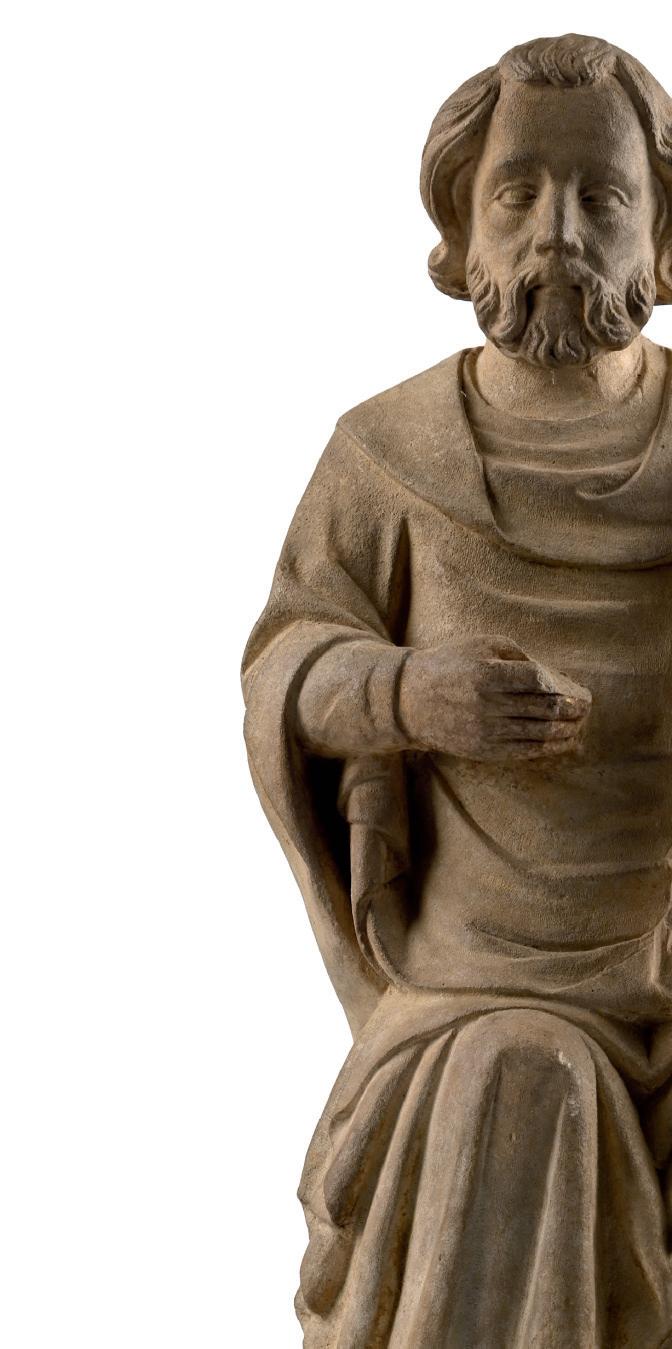


356
LARGE MEDIEVAL BRONZE FIGURE OF CHRIST NUREMBERG, GERMANY, CIRCA 1500-1520 A.D.
11 in. (1.2 kg, 28.2 cm)
Modelled in the round Corpus Christi with downcast head, folded loin cloth; hands pierced for attachment and hole to reverse. [No Reserve]
£3,000 - 4,000
PROVENANCE:
From the Laudon Palace collection, Vienna, Austria.
357

MEDIEVAL LIMESTONE SAINT PETER FROM A RETABLE SOUTH GERMANY, LATE 14TH-15TH CENTURY A.D.
16 in. (7.55 kg, 40.5 cm)
Carved in the round, seated on a chair with dorsal pillar; wearing a tunic and scapular, and with a cowl to the shoulders; sandaled feet on the rectangular base; right hand supporting an object (absent), exaggerated left hand holding the shaft of a symbol (cross?). [No Reserve]
£3,000 - 4,000
PROVENANCE: Sotheby’s, New York, USA, 27 January 2011, no.394.
Ex central London, UK, gallery.
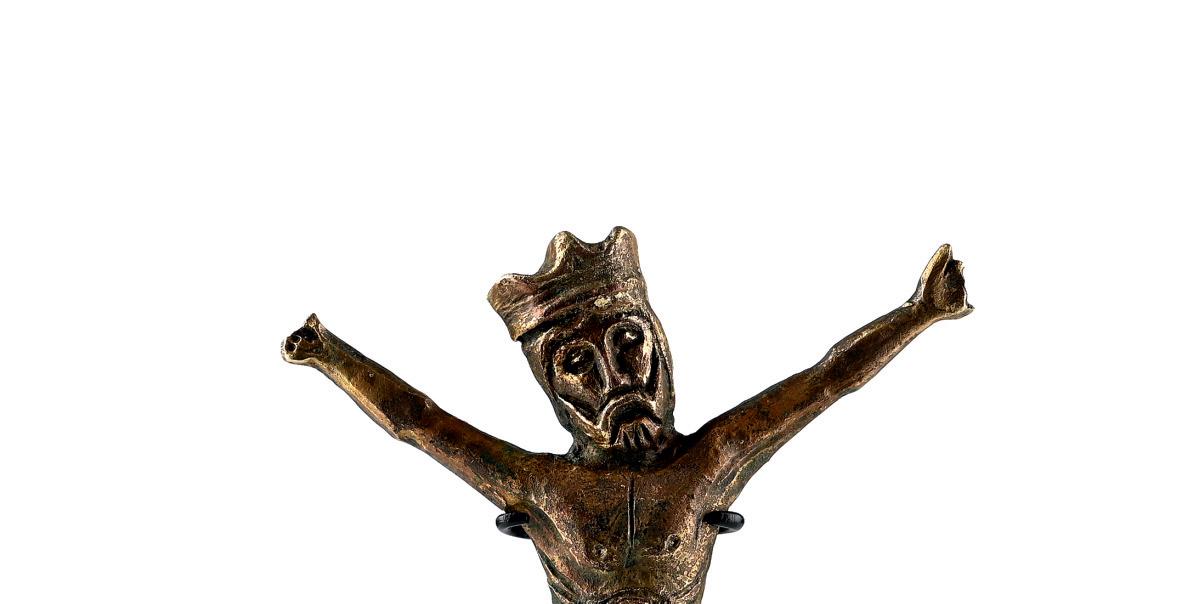




358
MEDIEVAL BRONZE FIGURE OF CHRIST 12TH-13TH CENTURY A.D.
7¼ in. (205 grams total, 18.5 cm including stand)
Modelled in the half-round Corpus Christi, crowned and with the head canted slightly, arms extended and hands pierced (fingers absent); pleated and draped knee-length loincloth; feet resting on a wedgeshaped base; mounted on a custom-made stand. [No Reserve]
£3,000 - 4,000
PROVENANCE:
From the private collection of a London gentleman, from his grandfather’s collection formed before the early 1970s.
359
MEDIEVAL WOODEN HEAD OF SAINT JOHN SPAIN, LATE 12TH CENTURY A.D.
14 in. (1.01 kg total, 36 cm including stand)
Head of a man, probably St John, carved in the half-round with gentle surface texture to the hair, lentoid eyes, small pursed mouth; mounted on a custom-made stand. [No Reserve] £3,000 - 4,000
PROVENANCE: Ex Palau Antiguitats, Barcelona, Spain. From a private collection, Suffolk, UK.
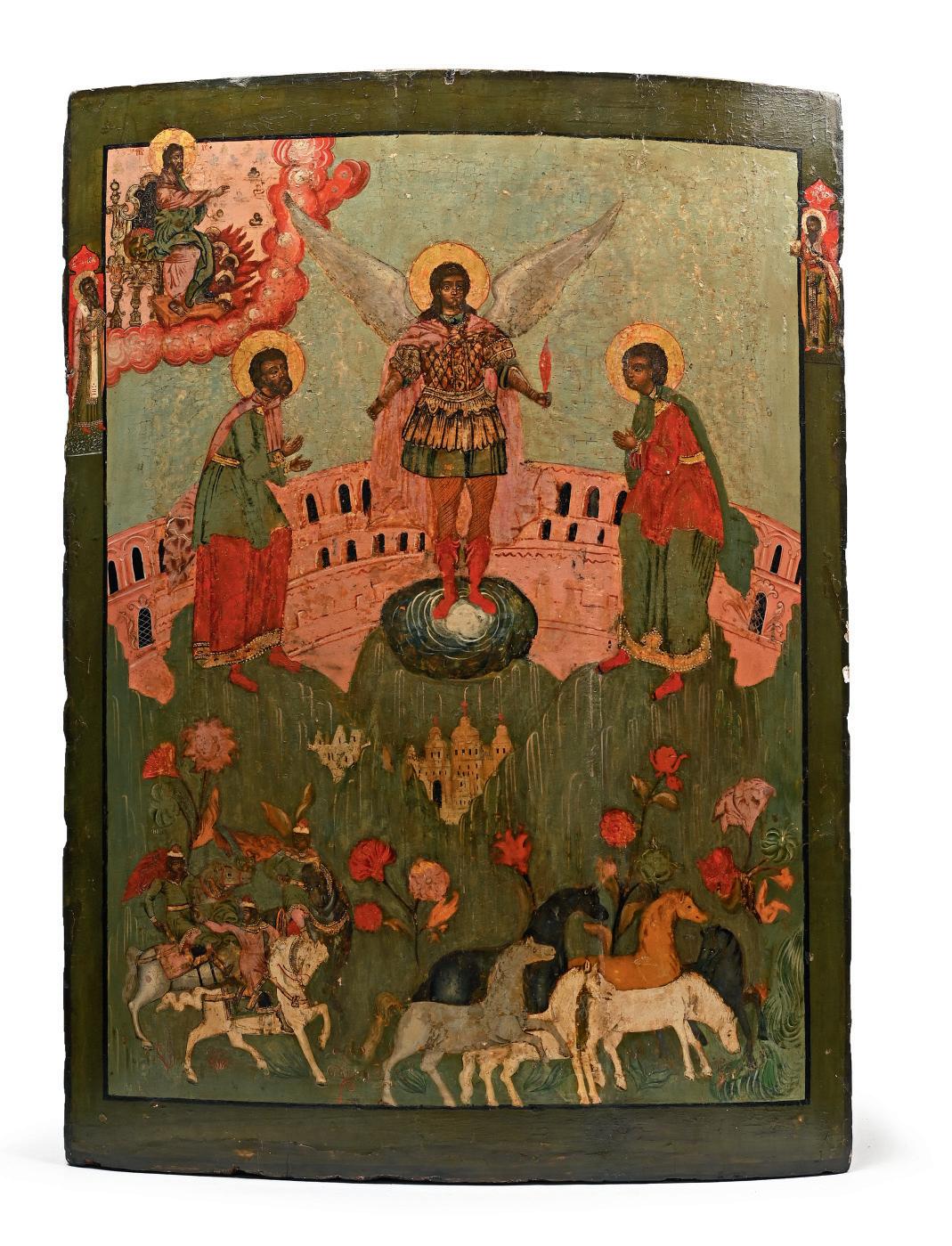
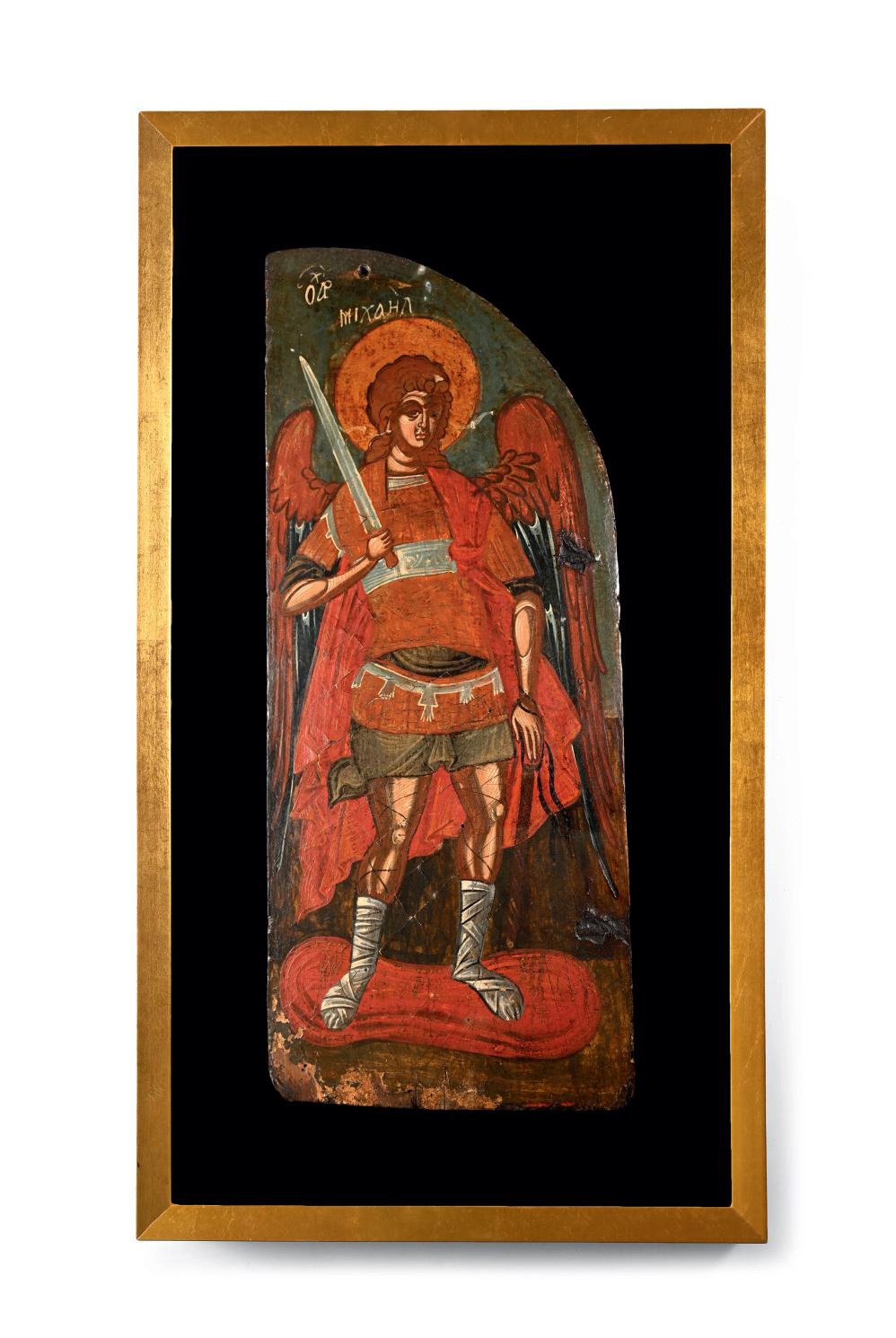
360
LARGE ICON OF ARCHANGEL MICHAEL FLANKED BY SAINTS FLORUS AND LAURUS
17TH CENTURY A.D.
27½ x 19¾ in. (4.2 kg, 70 x 50 cm)
Tempera on wood, the central part of the composition showing the Archangel Michael, dressed in pseudo-Roman armour consisting of a quilted corset and pteryges hanging from the shoulders and waist, wearing tight Byzantine-style trousers and red imperial shoes, his green tunic contrasting with his pink cloak, holding a flickering flame in his left hand, symbolising his flaming sword; at his side Saints Florus and Lavrus, patrons of horses, dressed in cassocks, and red and green overgarments with gold ornaments at the hems, pink and green cloaks closed by a gold fibula on the right shoulder, the two martyrs in an attitude of veneration towards the Archangel; the lower part of the scene with three martyrs Speusippos, Meleusippos, and Eleusippos on horseback, the horses which Florus and Lavrus were patrons of before them; in the upper part, top left, God dressed in a pink tunic and green chlamys, sitting on a golden throne and assisted by angels with wings of fire, blessing the saints and the martyrs; at his side inscription in Greek letters ‘ ’ ( = Jesus Christ); images of the saints Basil, Bishop of Caesarea and Blaise, Bishop of Sebastia visible on the borders.
£5,000 - 7,000
PROVENANCE: Acquired on the European art market. Private collection, London, UK.
361
LARGE WING OF A TRIPTYCH SHOWING THE ARCHANGEL MICHAEL GREEK, 17TH CENTURY A.D.
27½ x 15 in. (3.5 kg, 70 x 38 cm with frame)
Tempera on wood panel depicting the Archangel Michael standing on a red cushion in the guise of a guardian angel, holding a drawn sword in his right hand and a scabbard in his other hand; the face with a brown base, features formed in shades of tan and beige with white highlights on a terracotta and deep green background.
£1,200 - 1,700
PROVENANCE: Acquired on the European art market. Private collection, London, UK.
FOOTNOTES:
Even after the fall of Constantinople, icons painted on wood remained the principal object of devotion for Orthodox Christians both within the former borders of Byzantium and wherever the commonwealth of the Eastern Roman Empire left its traces. The painted icons are still today used by the Orthodox for personal devotion, for display in churches on feast days, and to decorate the iconostasis (partition) of the church, i.e. the dividing wall erected in front of the Bema, where the sacred altar of the Apse is collocated. The Archangel Michael was the commander of the Heavenly Host, and venerated by military men and the common people as one of the most powerful protector saints.

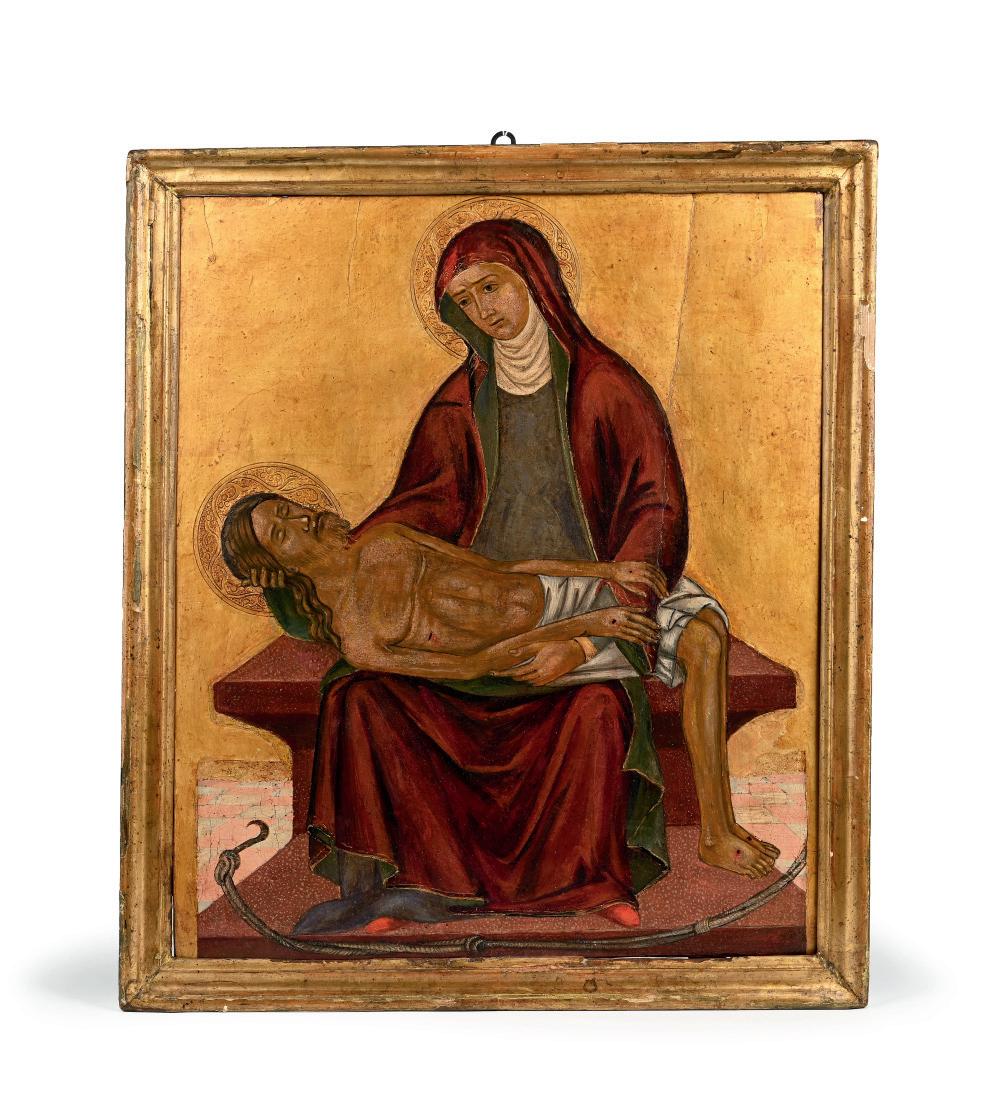
362

LARGE DIPTYCH OF THE MOTHER OF GOD AS HODEGETRIA
EARLY 16TH CENTURY A.D.
19¼ x 21 in. (3.6 kg, 49 x 55.5 cm (opened))
Tempera on two wooden panels executed on a green ground; the upper part of the left panel showing the nimbate Theotokos (Mother of God) with veiled head and mantle, pointing the infant Jesus supported by her left hand, wearing a red-gold maphorion mantle over a dark blue robe with gold cuffs; the infant facing away to left, dressed in blue tunic, wrapped in a red orange shawl, right hand extended towards his mother in a blessing gesture; beside Mary inscriptions in red Greek letters ‘ ’ and ‘ ’ ( ( ) = Mother of God), and beside the child the Greek letters ‘ ’ ( = Jesus Christ); in the lower part of the panel, God emerging as a halfbust from the sky, blessing the three theologians, Saint Basil of Caesarea, Saint John Chrysostom and Saint Gregory the Theologian, all dressed in ecclesiastic high garments, their names written in Greek beside their heads; the upper part of the right panel showing Christ Pantokrator, Lord of the Universe, the right hand in blessing gesture, the left hand holding a Gospel decorated with precious stones, wearing a blue chlamys and red sticharion embroidered with a gold clavus; in the lower part Saints Onuphrius, Saint Nicholas of Myra and Antony the Great of the Desert, the first naked and covered only by a leaf, the second in bishopric garments and the third in monastic garments, their names written in Greek beside their heads; all the haloes are in gold, the ones of Christ marked by a red cross.
£8,000 - 10,000
PROVENANCE: Acquired on the European art market. Private collection, London, UK.
363
LARGE VENETO-CRETAN ICON OF THE PIETA
16TH CENTURY A.D.
20 x 18 in. (2.6 kg, 53 x 45.5 cm with frame)
Mary portrayed with sorrow expression, seated on a marble bench, cradling the body of Jesus on her lap; the maphorion of Mary rendered in red carmine with geometrically shaped folds, embellished with a golden hem, lined internally in grey; the neck and throat of Mary covered by a white fabric, according to the fashion of the time; the haloes decorated with elaborate floral patterns, against a brilliant gold background; on the bottom, hooked rope used for lowering the body from the cross.
£4,000 - 6,000
PROVENANCE: Acquired on the European art market. Private collection, London, UK.
PUBLISHED:
Korban, H.K., Icons from the Orthodox World, A private collection, London, 2013, p.54.
FOOTNOTES:
The painting belongs to the 16th century Veneto-Cretan School. The Venetians, masters of Crete since the 13th century AD, encouraged their Greek subjects to keep and develop their Christian religious traditions while at the same time bringing them into contact with intellectual trends current in Western Europe. The new artistic currents and the great Byzantine tradition were transferred to the Island which was able to adopt that tradition and create a new one. The icon painters were organised into a guild - the Scuola di San Luca - which promoted a specific post-Byzantine style through a system of instruction and apprenticeship which lasted for more than two centuries.
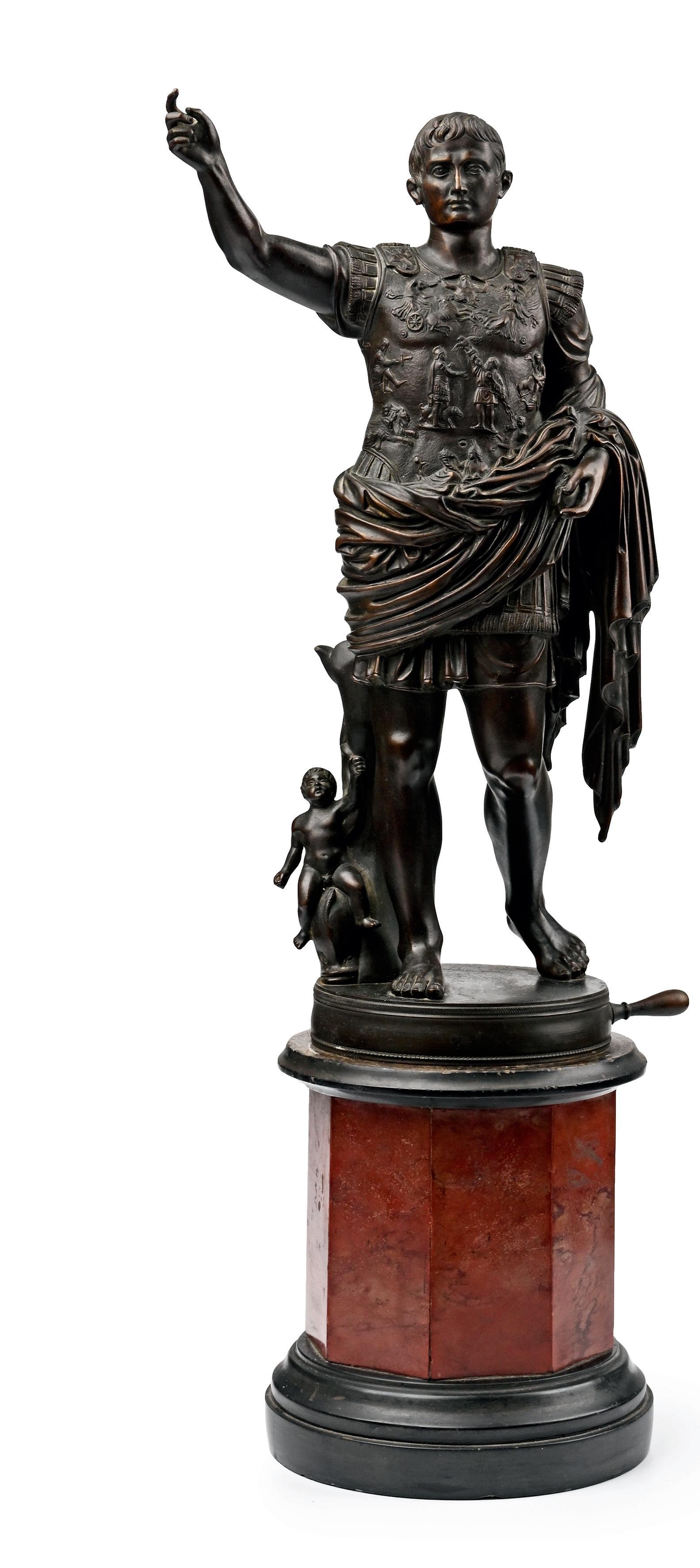


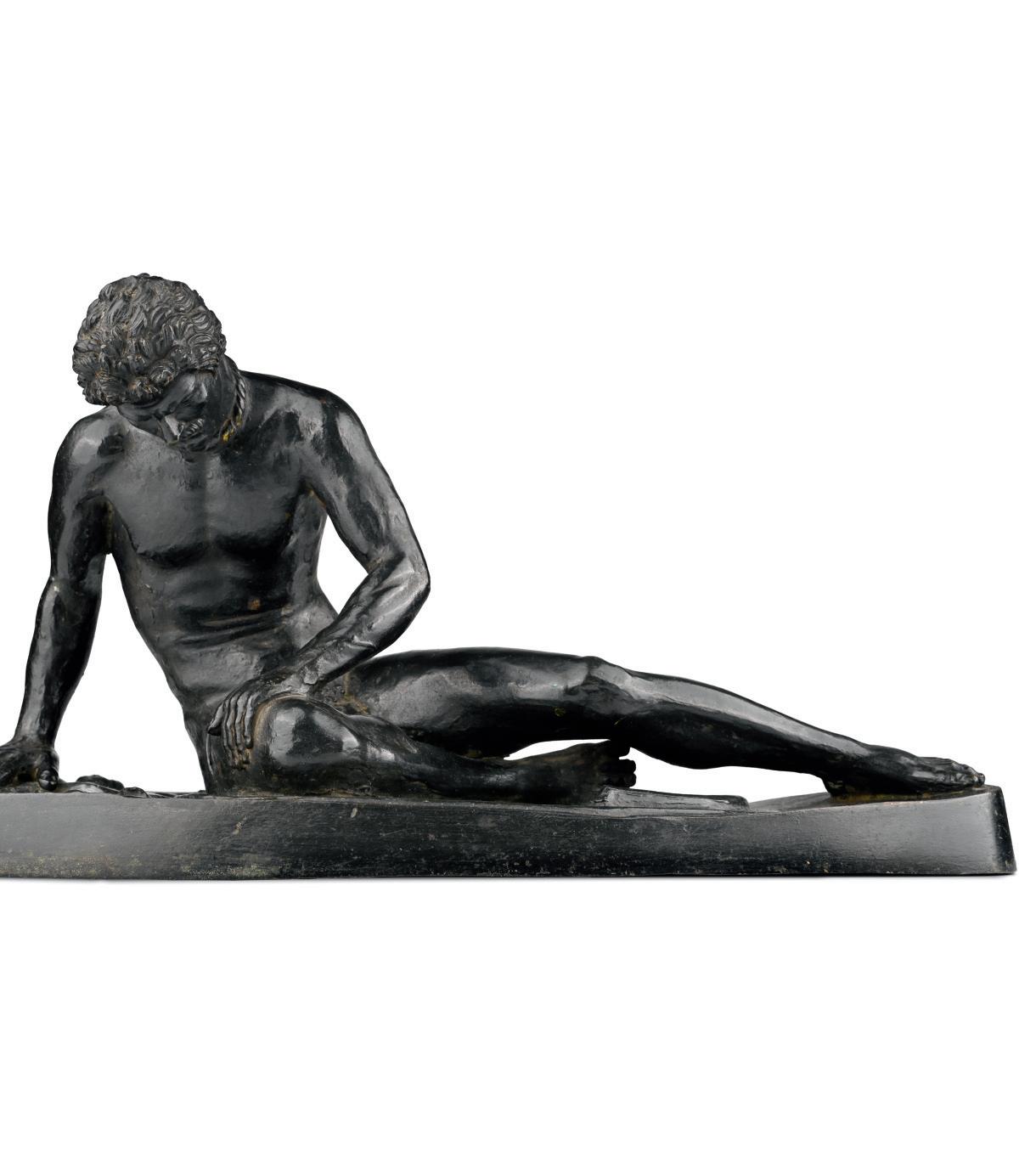
364

BRONZE GRAND TOUR STATUE OF AUGUSTUS OF PRIMA PORTA
ITALY, CIRCA 1870 A.D.
16 in. (6.45 kg total, 40.8 cm high including stand)
Replica of marble statue of Augustus discovered in 1863 in Prima Porta, depicted in advancing pose wearing a military cuirass with mythological scenes, toga draped from the waist over the left arm, barefoot with statuette of Cupid seated on a dolphin beside his right leg; mounted on a custom-made tiered stand.
£1,000 - 1,400
PROVENANCE:
From the private collection of a S.W. London gentleman, acquired in the 1970s.
365

BRONZE GRAND TOUR STATUE OF ‘THE DYING GAUL’ FROM THE CAPITOLINE MUSEUM
ITALY, CIRCA 1880 A.D.
12 in. (4 kg, 32 cm)
Copy of a Greek sculpture (now lost) from the Hellenistic period (32331 BC) thought to have been made in bronze; a young Galatian warrior, wounded in the chest by a sword blow and dying, half-lying with his face turned downwards; with typical features of the idealised Celtic warrior: the high cheekbones, the hairstyle with thick and long locks, and the moustache (mytax); resting on a discarded shield with short sword under his right hand, straps and two tubular war-horns.
£1,000 - 1,400
PROVENANCE:
From the private collection of a S.W. London gentleman, acquired in the 1970s.
FOOTNOTES:
The Dying Gaul statue was rediscovered in Rome in the early 17th century, specifically in the 1620s, during excavations for the Villa Ludovisi. It was initially part of the Ludovisi collection and later acquired by Pope Clement XII for the Capitoline Museums. Except for a torque around the neck (a metal necklace typical of Celtic warriors), the figure is completely naked. It is possible to identify the figure tentatively as the ‘Trumpeter of Epigonos’ mentioned by Pliny (Natural History 34.88).
366
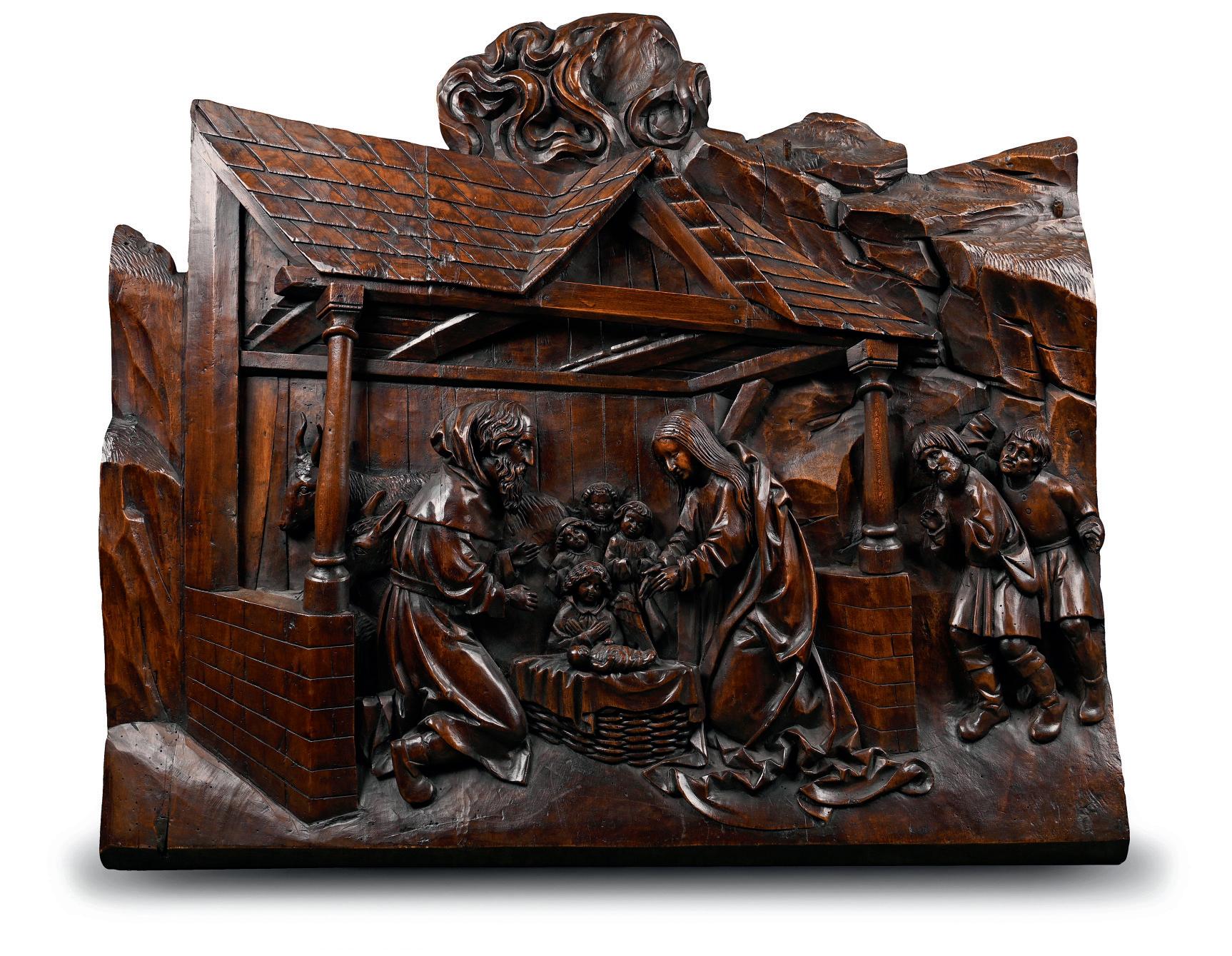
POST MEDIEVAL WOODEN SCULPTURE OF THE NATIVITY
MIDDLE RHINE VALLEY, CIRCA 1500 A.D.
36¼ in. (9.45 kg, 92 cm wide)
Carved in high-relief on boards using forced perspective to show depth; freestanding stable with shingled roof and open front on undercut balustered posts revealing an ox, an ass, three shepherds, kneeling figure of Joseph and bowed figure of Mary. [No Reserve]
£3,000 - 4,000
PROVENANCE:
Private collection, Burgundy, France, since circa 1960.
367
VENETO-CRETAN ICON OF ST FRANCIS OF PAOLA 17TH CENTURY A.D.
7¼ x 5 in. (168 grams, 18.5 x 13 cm)
Tempera on wood panel, on a golden background, erect figure in three-quarter view in dark cowl and habit, holding a staff in both hands; halo ornately punched; the staff with nimbus finial surrounding majuscule legend ‘CHA/RI/TAS’ (‘love, charity’).
£800 - 1,000
PROVENANCE: Acquired on the European art market. Private collection, London, UK.
368
ICON WITH SAINT ALEXANDRA BASIL, FEODOR AND EUDOKIA
LATER 19TH CENTURY A.D.
12¼ x 9¾ in. (1.27 kg, 31 x 25 cm)
Tempera on wood panel with brass basma reveal; gilt field with four nimbate figures standing; the two outer figures each in floor-length female robe with wimple and open-fronted mantle; inner figures bearded with sumptuous vestments, each holding a codex; above, clouds parted to reveal facing figure with metal nimbus applied to the basma; above this, three nimbate figures in the basma with voids; Cyrillic legends Vasili (Basil), Aleksandra, Fyodor (Theodore), Ebdokia; mounting bars in recesses to reverse.
£1,200 - 1,700
PROVENANCE: Acquired on the European art market. Private collection, London, UK.
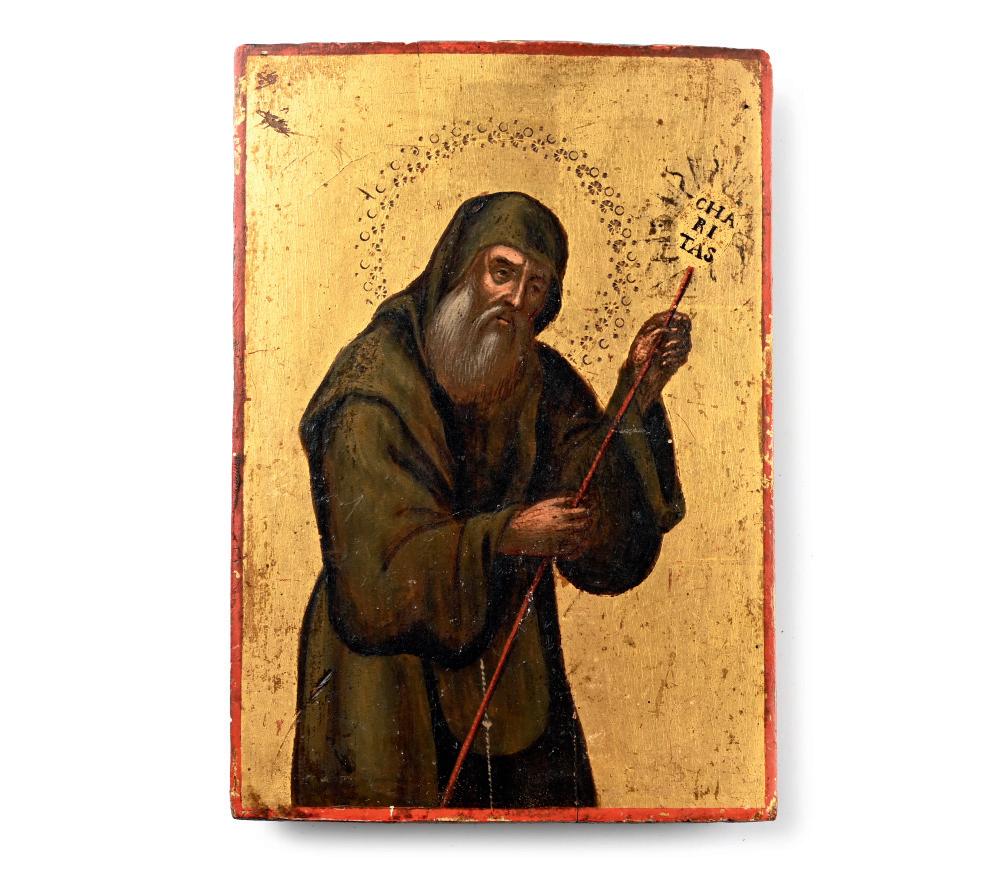

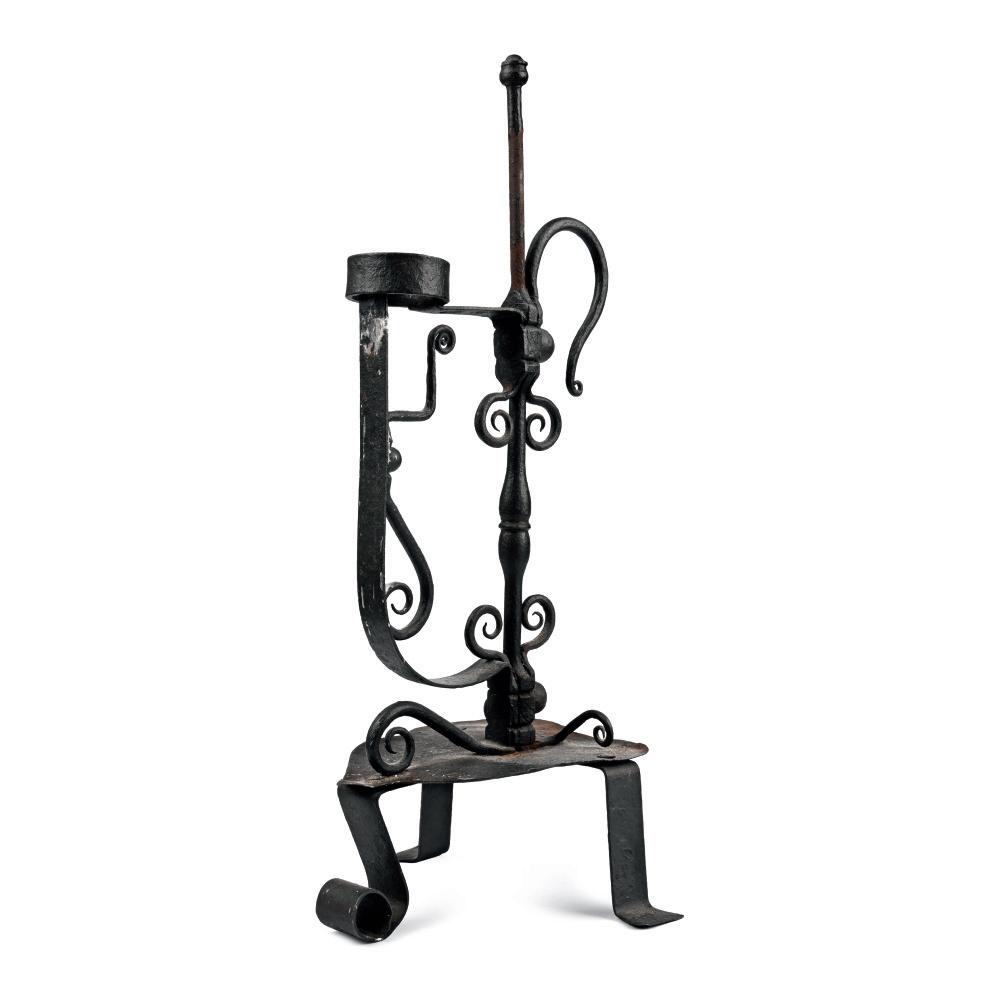
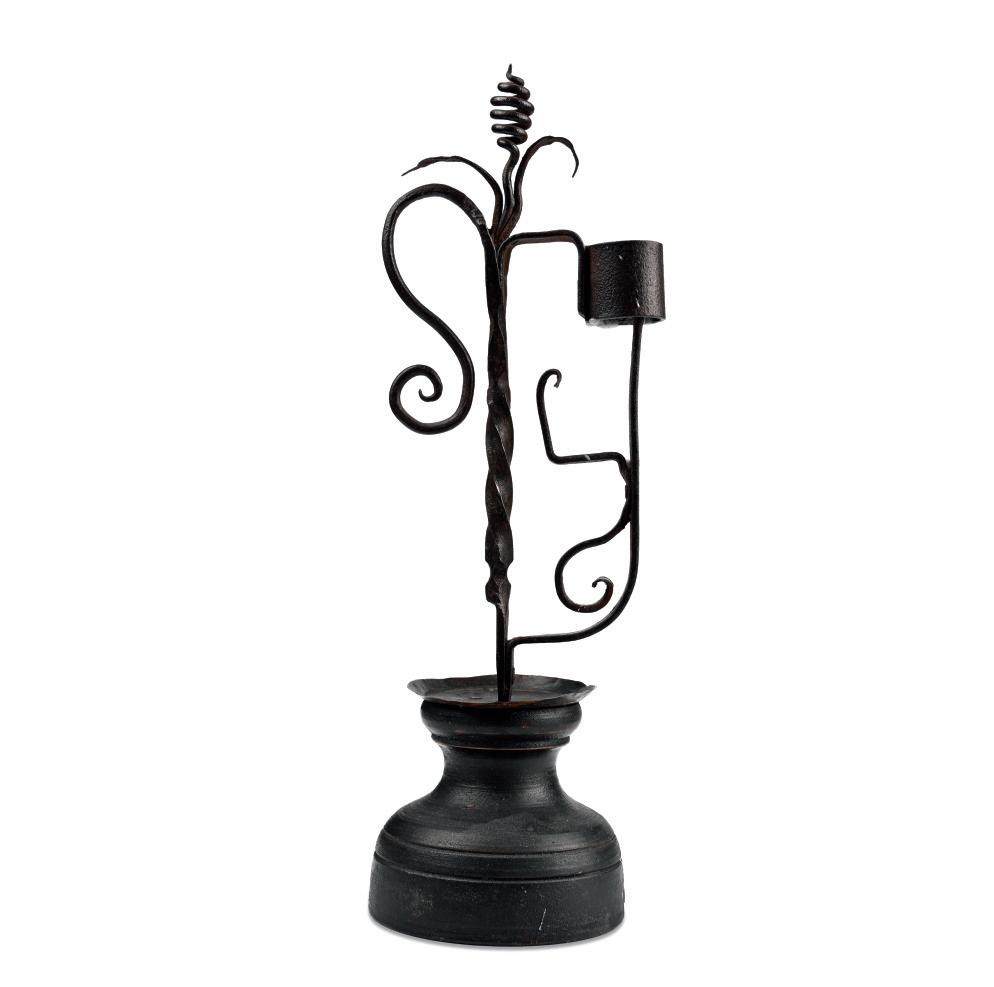
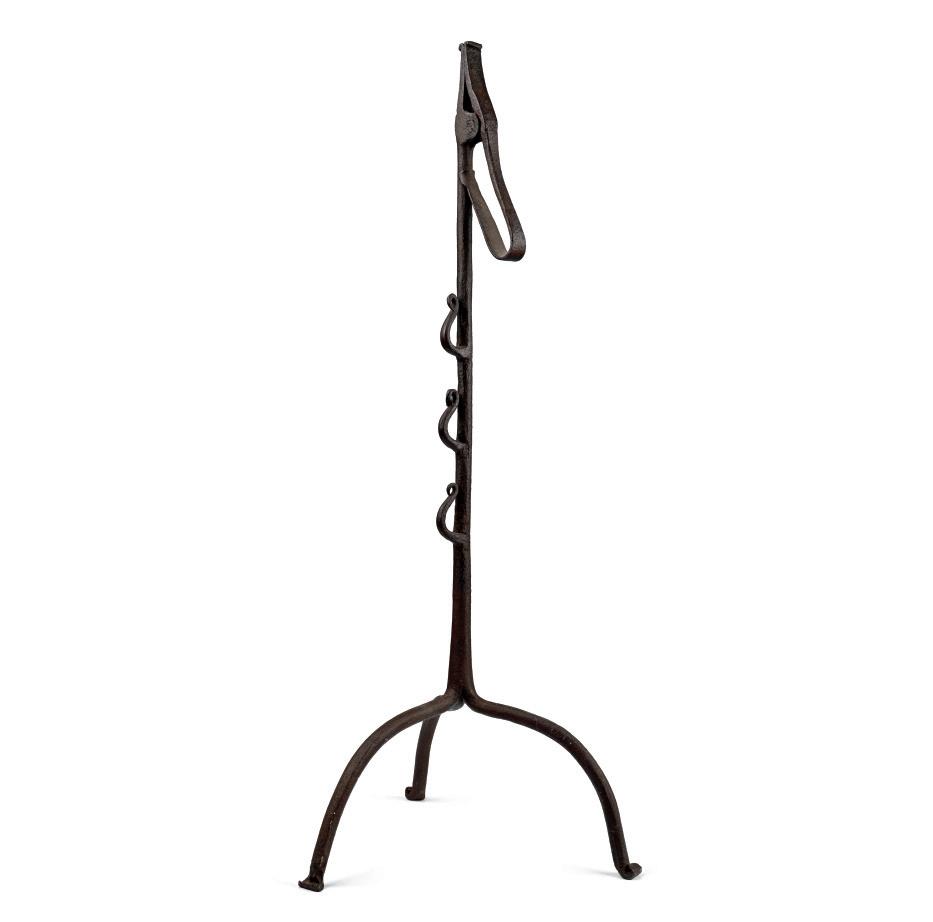
369
IRON CANDLE HOLDER
FRANCE, 18TH CENTURY A.D.
17¼ in. (1.21 kg, 44 cm)
The central baluster knopped column with scrolling ornament and looped carrying handle above a trefoil-shaped platform and rivetted tripod feet.
£500 - 700
PROVENANCE:
Ex Nic McElhatton, former chairman of Christie’s South Kensington. Property of a Berkshire, UK, collector.
Accompanied by a copy of McElhatton’s cataloguing page.
370
PUBLISHED IRON ALPINE CANDLE HOLDER
FRANCE OR SWITZERLAND, 19TH CENTURY A.D.
14½ in. (687 grams, 36.5 cm)
With spring arm to secure the candle, with raised tray feature.
£400 - 600
PROVENANCE:
From a private collection.
Ex Nic McElhatton, former chairman of Christie’s South Kensington. Property of a Berkshire, UK, collector.
PUBLISHED:
Ashley, Robert, The Rushlight and Related Holders - A Regional View, Ashley Publications, 2001, illustrated on p.302, no.274.
371
PUBLISHED IRON ‘PEERMAN’ SPLINT HOLDER
AUSTRIA, 18TH CENTURY A.D.
27 in. (1.7 kg, 68.7 cm)
The sprung nip on a tall stem wrought with three S-scrolls for holding spare splints, on a tripod base.
£800 - 1,000
PROVENANCE:
Ex Nic McElhatton, former chairman of Christie’s South Kensington. Property of a Berkshire, UK, collector.
Accompanied by a copy of McElhatton’s cataloguing page.
PUBLISHED:
Ashley, Robert, The Rushlight and Related Holders - A Regional View, Ashley Publications, 2001, illustrated on p.286, no.249.
372
MEDIEVAL IRON FIRE-STAND IN THE SHAPE OF A DRAGON
SPAIN, CIRCA 1480 A.D.
15½ in. (438 grams, 39.2 cm)
Handmade firedog with stub feet, single rear limb (or tail), arched neck with pierced bulb finial; five holes to the body. [No Reserve]
£1,000 - 1,400
PROVENANCE: Luis Elvira, Spain, 2007. Ex central London gallery.
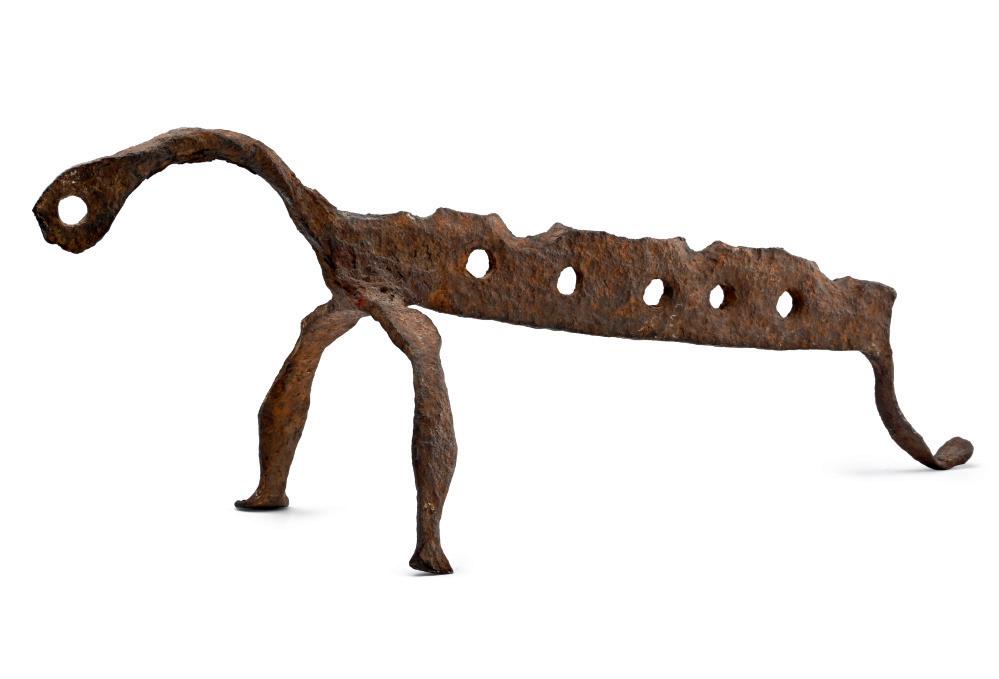
373
MEDIEVAL GILT BRONZE LIMOGES SAINT MOUNT
13TH CENTURY A.D.
2½ in. (24.7 grams, 62 mm)
Comprising a flat tongue-shaped body with segmented surface, enamelled blue and white panels; above the head modelled in the round with inset blue glass eyes. [No Reserve]
£800 - 1,000
PROVENANCE:
Found East Anglia, UK.
374
MEDIEVAL GILT BRONZE LIMOGES SAINT MOUNT
13TH CENTURY A.D.
2¼ in. (17.09 grams, 58 mm)
Comprising a flat tongue-shaped body with segmented surface, enamelled in several colours; above the head modelled in the round with inset blue glass eyes. [No Reserve]
£400 - 600
PROVENANCE:
Found East Anglia, UK.
375
LARGE MEDIEVAL KNIGHT'S ENAMELLED BRONZE HERALDIC PLAQUE WITH THE ARM OF THE VALANCE FAMILY, EARLS OF PEMBROKE AND THOSE OF THE BARONS OF COBHAM IN KENT
CIRCA 1250-1400 A.D.
2 in. (42 grams, 68 mm)
Heater-shaped appliqué with enamelled heraldic design: impaled arms: barry or and azure, an orle of martlets gules; gules a chevron three lions rampant. [No Reserve]
£300 - 400
PROVENANCE:
Found whilst searching with a metal detector in Puddlestone, West Doreset, UK, by Charles Bullock.
Accompanied by a copy of the British Museum’s Portable Antiquities Scheme (PAS) report no.DOR-0FEBB5.
Accompanied by a copy of the UKDFD report no.57413.
Accompanied by a handwritten transcription from an email from Rod Blunt discussing this pendant in detail.
FOOTNOTES:
The arms have been identified by Rod Blunt as possibly those of the Valance Family, Earls of Pembroke with those of the Barons of Cobham in Kent.
376
MEDIEVAL ENAMELLED GILT BRONZE HERALDIC HORSE HARNESS PENDANT FOR PHILIPPA OF HAINAULT, QUEEN OF EDWARD III
EARLY 14TH CENTURY A.D.
1½ in. (11.8 grams, 39 mm)
Heater-shaped pendant with integral loop above; quartered arms, each a lion rampant on an enamelled field; possibly for Philippa of Hainault, Queen of Edward III. [No Reserve]
£300 - 400
PROVENANCE:
Found whilst searching with a metal detector at Steepton Bill Farm, Milton Abbas, West Dorset, on 3 April 2025 by Charles Bullock.
Accompanied by a copy of UKDFD report no.58557 and research by Bryan Phillips.
377
MEDIEVAL KNIGHT’S ENAMELLED BRONZE HERALDIC HORSE HARNESS PENDANT
14TH-15TH CENTURY A.D.
1¾ in. (14.19 grams, 45 mm)
Heater-shaped with integral loop, reserved lion rampant in red enamel. [No Reserve]
£400 - 600
PROVENANCE:
Found East Anglia, UK.
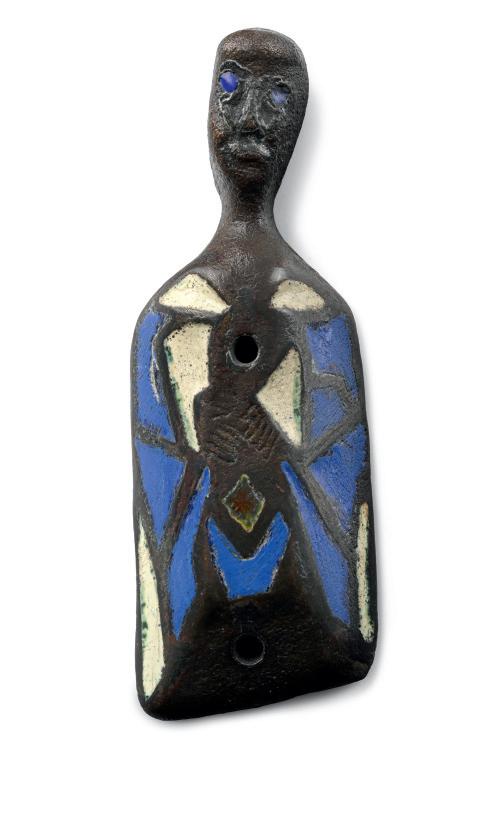
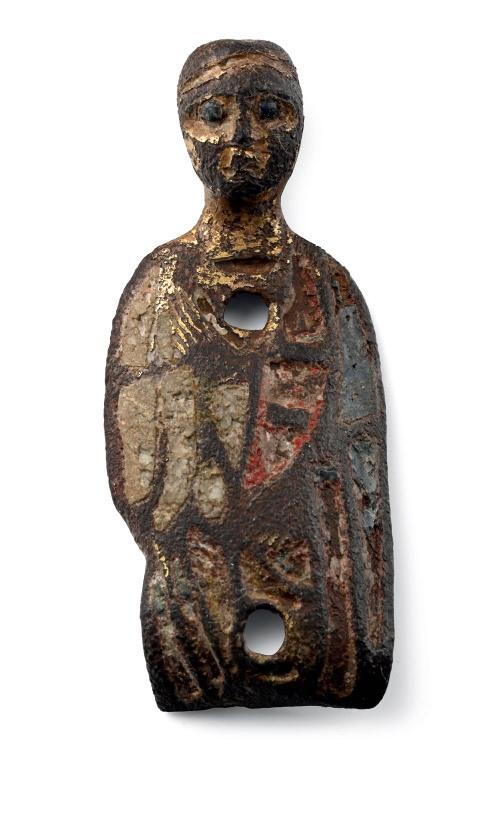
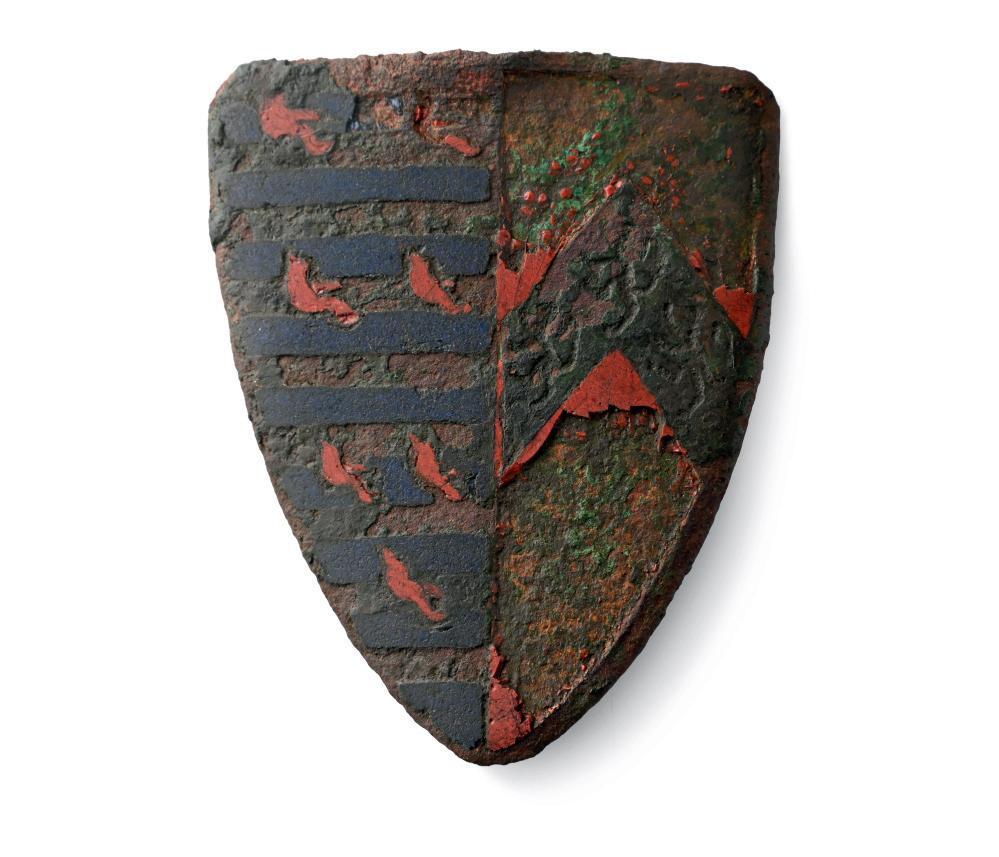

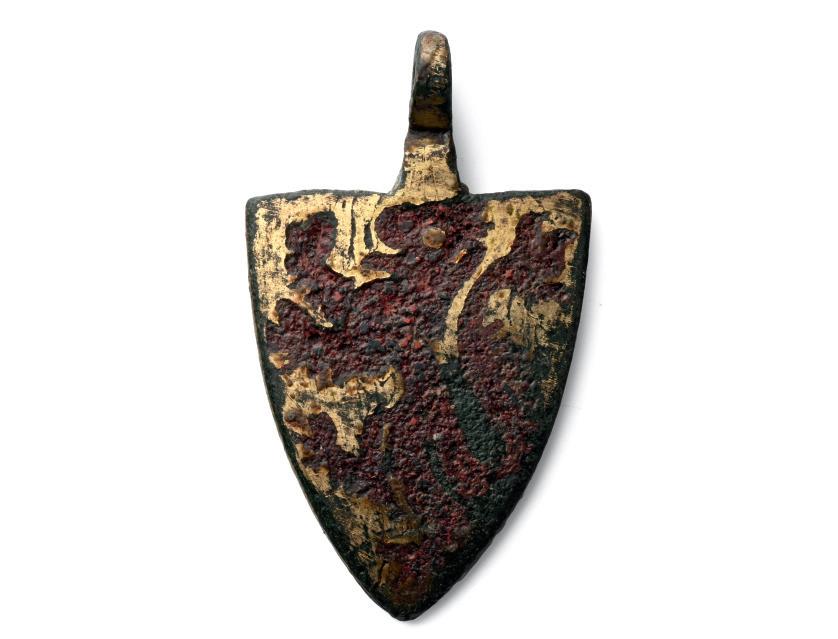
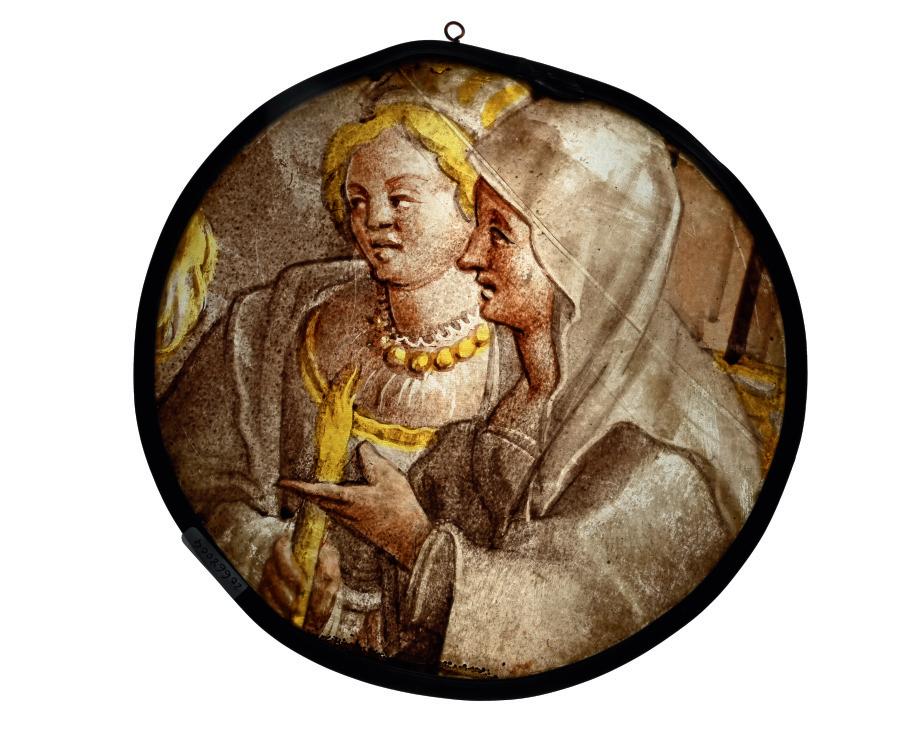

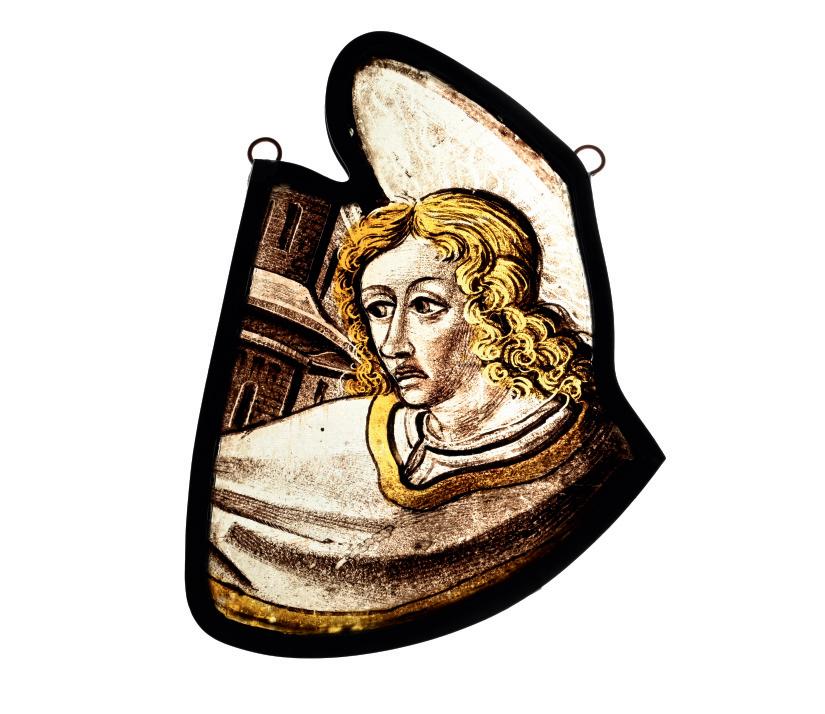
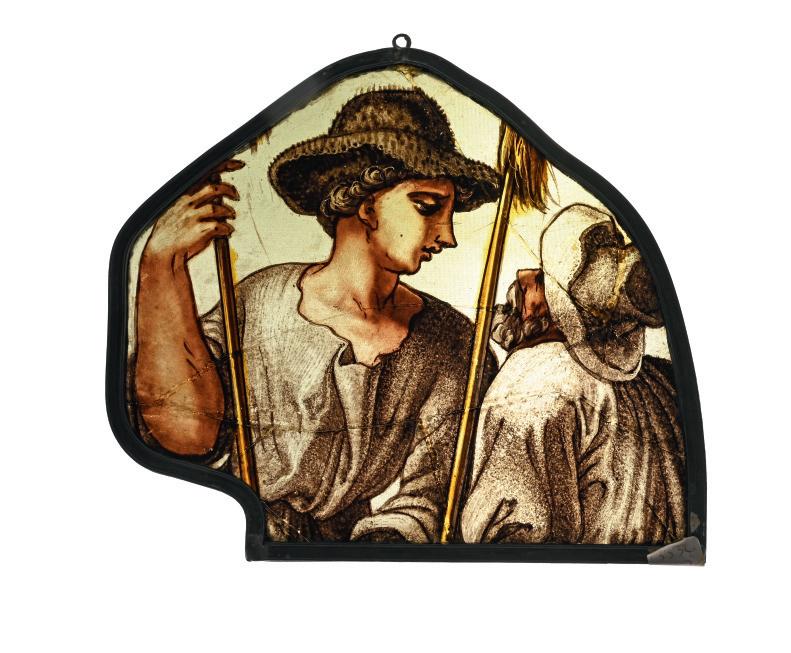
378
POST MEDIEVAL STAINED GLASS PANEL WITH TWO WOMEN IN CONVERSATION
NORTHERN FRANCE, CIRCA 1530-1540 A.D.
8½ in. (259 grams, 21.6 cm)
Discoid panel in lead frame, veiled women in the foreground with raised hand, an unveiled richly dressed woman holding a candle in the background. [No Reserve]
£600 - 800
PROVENANCE:
Ex De Baecque Vente aux encheres, 8 June 2023, no.511 (part).
Ex central London gallery.
379
POST MEDIEVAL TRACERY LIGHT STAINED GLASS PANEL WITH THE BUST OF AN ANGEL
SOUTHERN LOW COUNTRIES, CIRCA 1500 A.D.
16 in. (340 grams, 41.7 cm)
Deep blue stained glass panel in lead cames with crimson panels above; painted profile figure of a an angel’s head in three-quarter view with tiered wing below; attributed to Bernard Flowers (d.1517). [No Reserve]
£1,000 - 1,400
PROVENANCE:
Collection of Mrs Herbert Shipman, Newport, Rhode Island, and the River House, New York, USA, until; her sale, American Art Association, Anderson Galleries, New York, USA, 20-21 November 1936, no.348.
Roy Grosvenor Thomas, London, UK.
George A. Douglass, Sr, Greenwich, Conn. LG-9. Fairford collection; 12 January 1996, no.1049.
Private collection UK, 1999.
Ex central London gallery.
380
POST MEDIEVAL STAINED GLASS PANEL WITH BUST OF SAINT JOHN
NORTHERN FRANCE, 16TH CENTURY A.D.
6 in. (110 grams, 15.5 cm high)
Irregular panel in lead frame, a youthful male head with slightly opened mouth, remains of halo, a building in a background; possibly depicting Saint John in lamentation. [No Reserve]
£600 - 800
PROVENANCE:
Ex De Baecque Vente aux encheres, 5 March 2022, no.52.
Ex central London gallery.
381
STAINED GLASS PANEL WITH TWO SHEPHERDS FRANCE, EARLY 17TH CENTURY A.D.
8 in. (280 grams, 20.5 cm)
Irregular panel in lead frame with pastoral motif of finely painted prominent youthful male in profile, an older bearded male with turned back; both holding a shepherd(?) staff. [No Reserve]
£1,500 - 2,000
PROVENANCE:
Ex Galerie de Chartres, 8 March 2009, no.87.
Ex central London gallery.
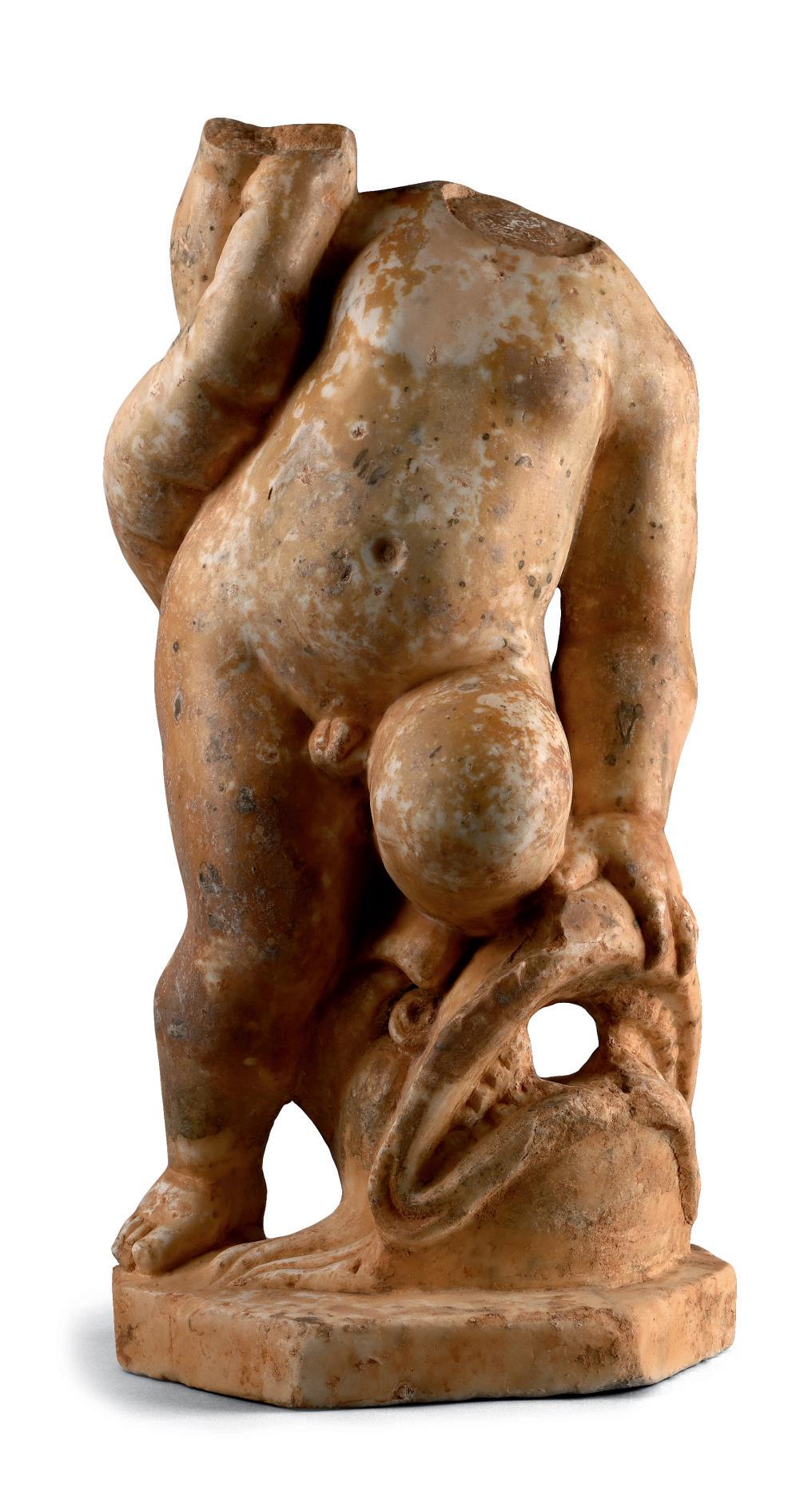
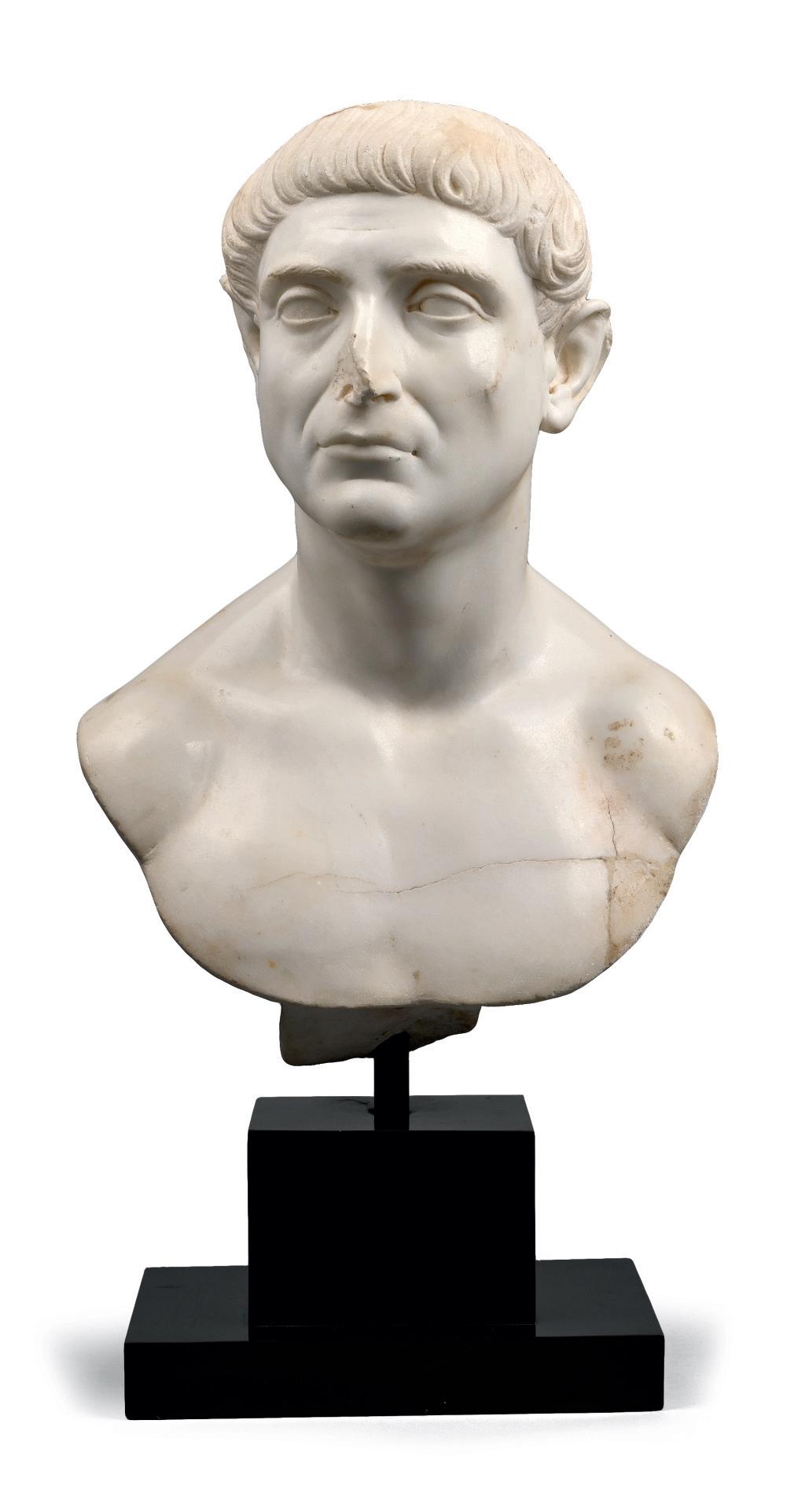
382

MARBLE FOUNTAIN SCULPTURE OF A PUTTO WRESTLING A FISH ‡
BAROQUE, 17TH CENTURY A.D.
18 in. (20.75 kg, 48 cm)
Standing on an angular base resting his left knee on the open jaws of a fish, his left arm holding the jaws open, the body and tail held upright be the raised right hand (partly absent); with heavy sulphured patina.
£6,000 - 8,000
PROVENANCE: Acquired prior to 1970. From the estate of a Swiss gentleman, Ticino. Private collection, Zurich, Switzerland.

383 LIFE SIZE MARBLE JULIAN STYLE BUST
18TH CENTURY A.D.
26¾ in. (33 kg total, 68 cm including stand)
Carved in the round, displaying an emperor or noble with thick hair cut in the Julian style and combed forward onto the brow; with finelymodelled features and stern expression; mounted on a custom-made stand.
£4,000 - 6,000
PROVENANCE:
Acquired on the German art market. European private collection, 1970s-early 2000s. Acquired from the above; thence by descent. Private collection, London, UK.
FOOTNOTES:
The bust is characteristic of the taste that prevailed in France since the Italian wars of Napoleon. The quality of the carving is high and stylistically recalls the school of Antonio Canova.
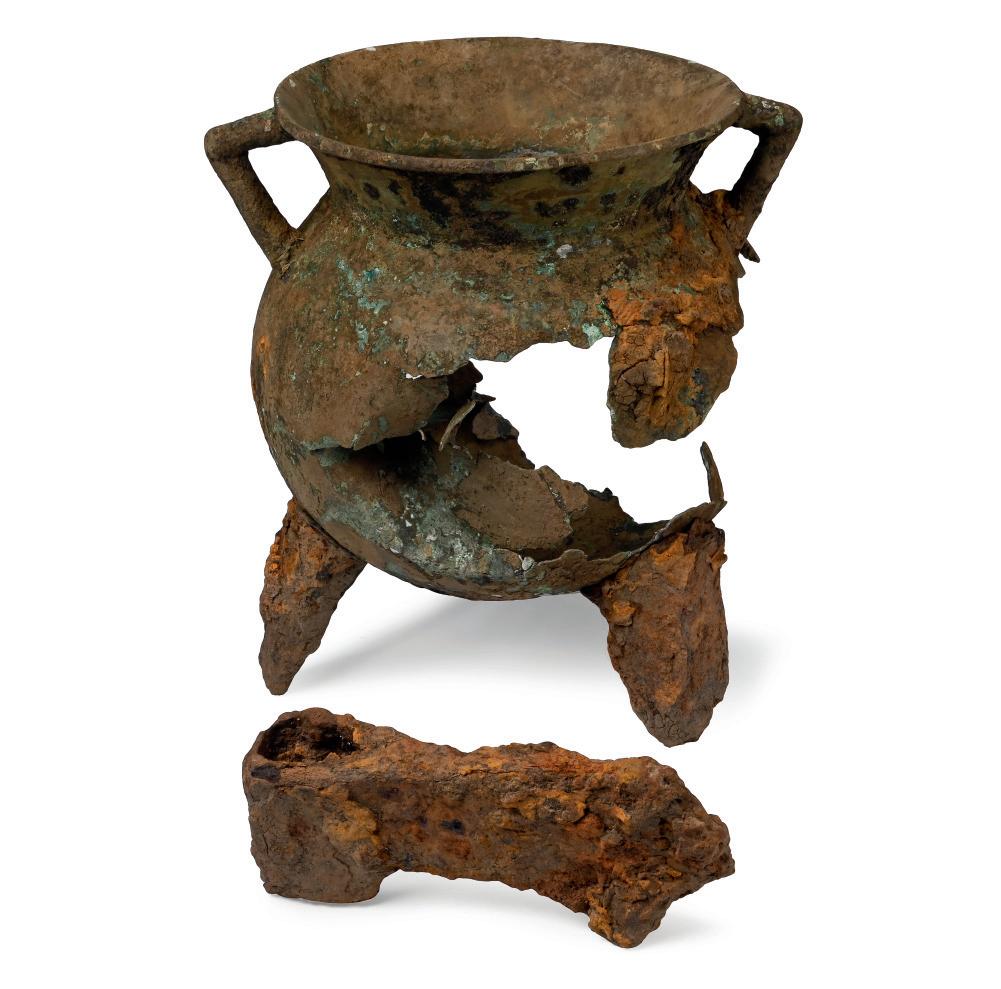
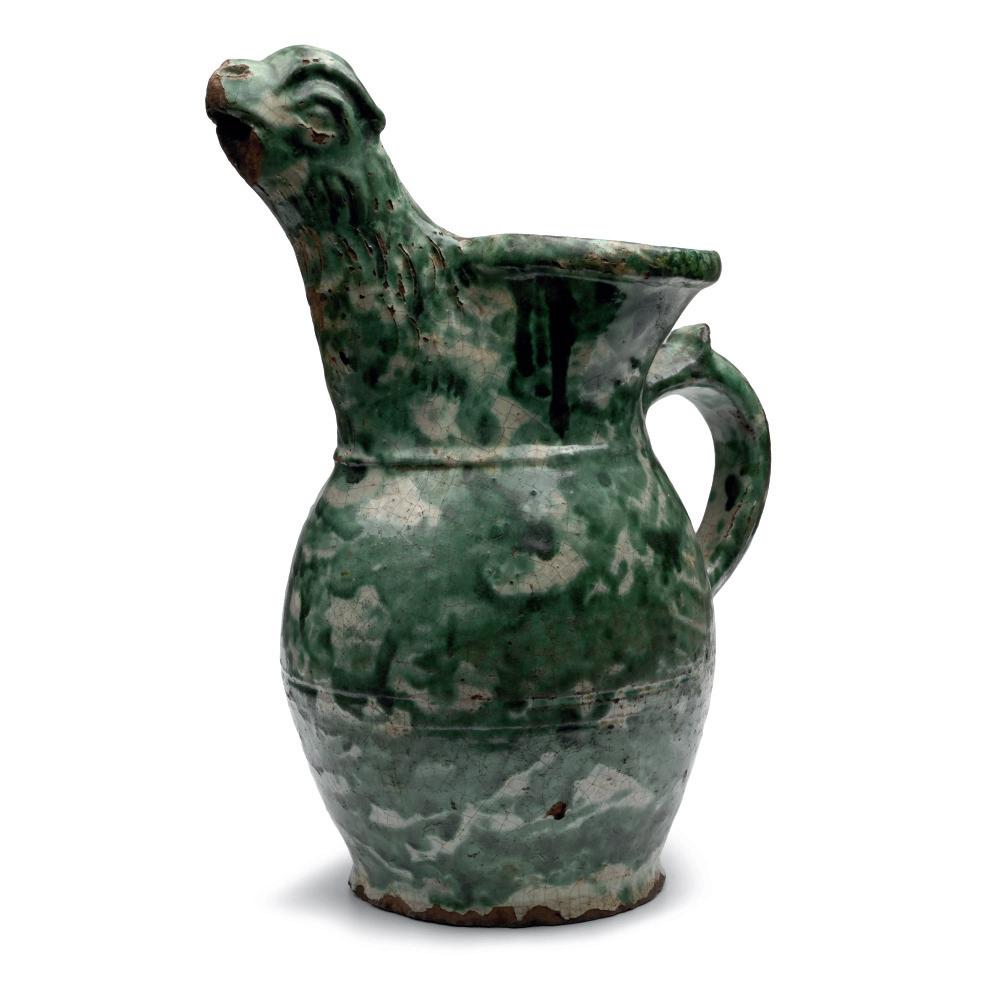
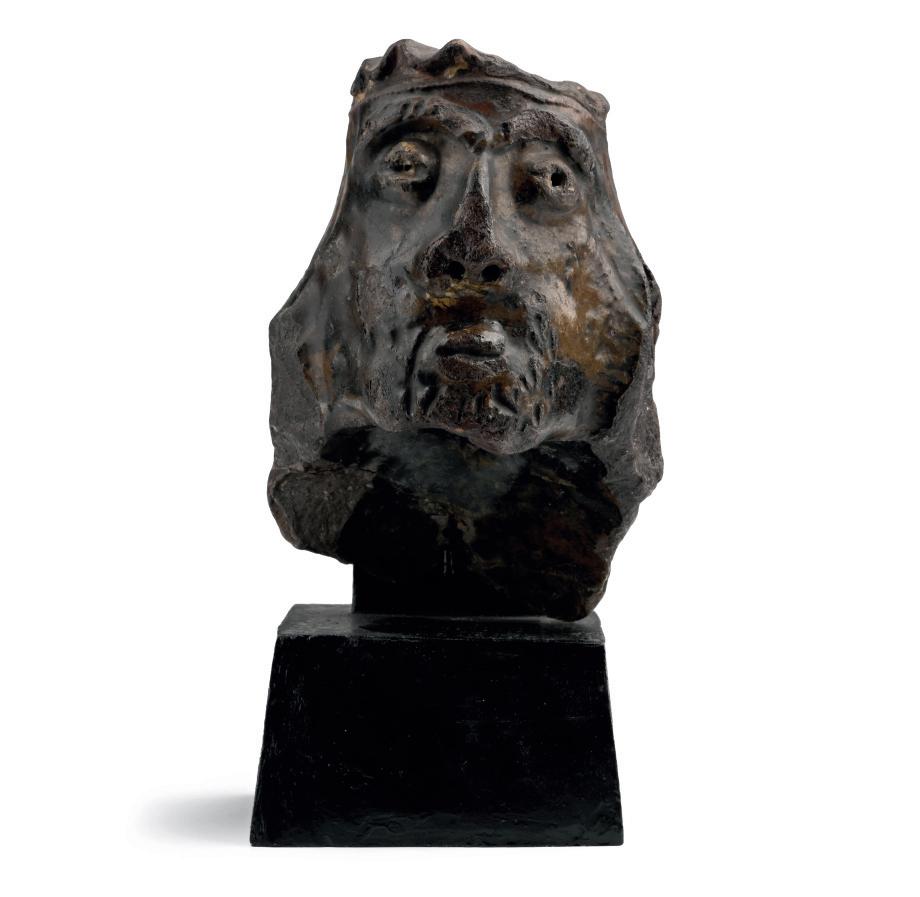
384
RITUALLY SACRIFICED MEDIEVAL BRONZE CAULDRON WITH THE ‘MURDER’ WEAPON
1300-1400 A.D.
12¼ in. (6 kg total, 31 cm)
Comprising: a large bulbous bronze cauldron with three radiating applied iron legs (one detached), squat in profile with flared and chamfered rim; substantial iron axehead with slightly flared blade, thickened butt with socket; the cauldron discovered inverted with the axehead underneath.
£500 - 700
PROVENANCE:
The assemblage found whilst searching with a metal detector in Cumbria, South Lakeland, UK on Friday 23 February 2023.
Accompanied by a copy of the British Museum’s Portable Antiquities Scheme (PAS) report nos.LANCUM-DA7471, LANCUM-F50F1D.
PUBLISHED:
Seal, C., A Curious Cumbrian Cauldron, News and Views, Treasure Hunting Magazine, June 2024, p.10 & 11.
FOOTNOTES:
The find and its likely meaning have been discussed at length with Vincent van Vilsteren, the former Curator of the Drents Museum in the Netherlands, who has studied many instances of cauldrons which have been ceremonially buried after sustaining extensive damage. The ex curator’s PhD is currently in process and will concentrate on the ritual aspects of late medieval bronze cauldrons. The suggested interpretation here is that the cauldron was ritually ‘killed’ or put beyond use, and the weapon used to effect this was interred with it. This would be a rare (if not unparalleled) case in Europe of the deposition of the weapon alongside the item which the ritual was supposed to ‘retire’.
385
MEDIEVAL GLAZED JUG WITH SPOUT IN THE FORM OF A COCKEREL
SOUTHERN GERMANY OR TYROL, 15TH-16TH CENTURY A.D.
10½ in. (1.22 kg, 26.7 cm)
Biconvex in profile with flared foot, strap handle with external rib, Dshaped flared rim, spout formed as an avian head with feather detailing. [No Reserve]
£500 - 700
PROVENANCE:
Oscar Bundy collection, Vienna, Austria. John Philip Kassebaum collection, before 1981.
Brunk Auctions, 21 September 2013, no.12.
Ex central London gallery.
PUBLISHED:
John V.G. Mallet, et. al., The John Philip Kassebaum Collection Volume One, 1981, no.117.
386
MEDIEVAL HEAD OF A KING FROM A RIDGE TILE TERMINUS
ENGLAND, LATE 13TH-EARLY 14TH CENTURY A.D.
6¾ in. (497 grams total, 17.3 cm including stand)
Hollow-formed with exaggerated facial features, crown above and hanks of hair to each side; mounted on a custom-made stand. [No Reserve]
£600 - 800
PROVENANCE:
Ex Pierre-Richard Royer, Paris, France, 2015.
Ex central London gallery.

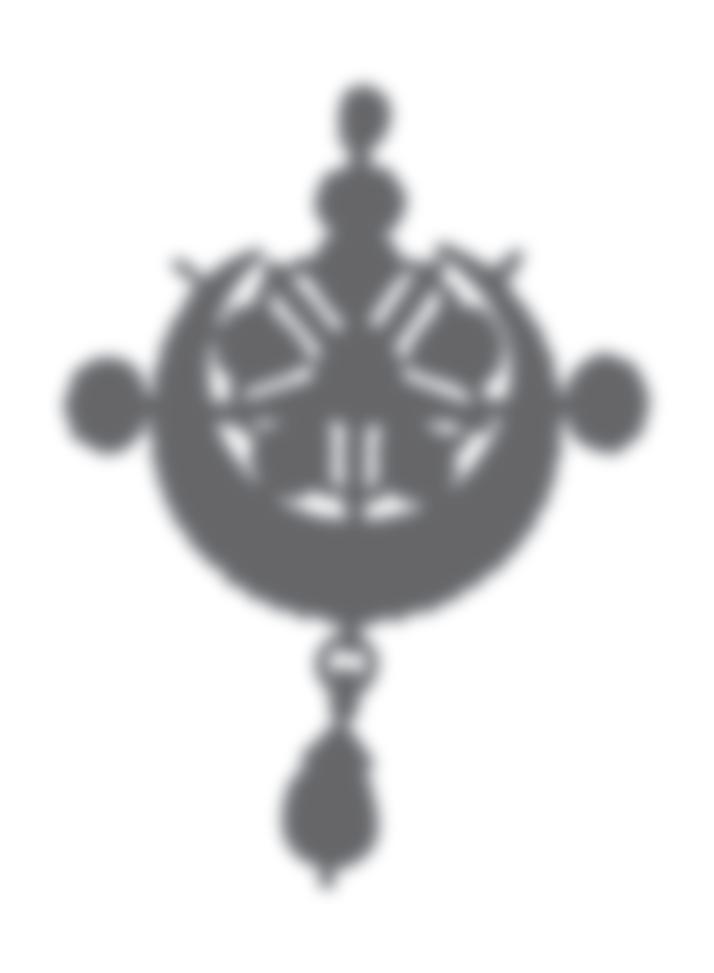
BEJEWELLED NAYA CHAND - NIYAM COMPOSITE PENDANT WITH DIAMONDS IN PACHIKAM SETTING WESTERN INDIA, 19TH CENTURY A.D.
3 3 /4 in. (53.71 grams, 97 mm)
Comprising five different components joined at the back through an invisible sliding cross-like reticulate, designed as a traditional naya chand (crescent moon, also hilal) - niyam (flower) pendant en vogue during the Mughal era, with three diamond-set roundels at the top and sides, one surmounted by an untested bulbous ruby bead, and an unfacetted, drop-like carved emerald charm at the bottom; the centre of the niyam flower section irradiating five linear sprays set with narrow baguette rubies, the facetted diamonds covering the rest of the pendant’s front set in a traditional Gujarati pachchikam (claw-like silver) setting; the reverse with a parcel-gilt sheet incised with dense vegetal meanderings, interlocking foliage, and floral blossoms; mounted in a padded, velvet-lined presentation case with tooled green leather, with integral display stand.
£7,000 - 9,000
PROVENANCE: Acquired in the late 1980s-early 1990s. Private collection, London.
388
INDIAN GOLD BAZU BANDS
19TH CENTURY A.D.
1 in. (8 in.) (23.3 grams total, panel: 43 mm each, 22 cm long)
Matched pair, each a curved lenticular plate with cells to the obverse, articulated ends with attachment cord and tassels, repoussé foliage to the underside. [2]
£3,000 - 4,000
PROVENANCE: Acquired in the late 1980s-early 1990s. Private collection, London.
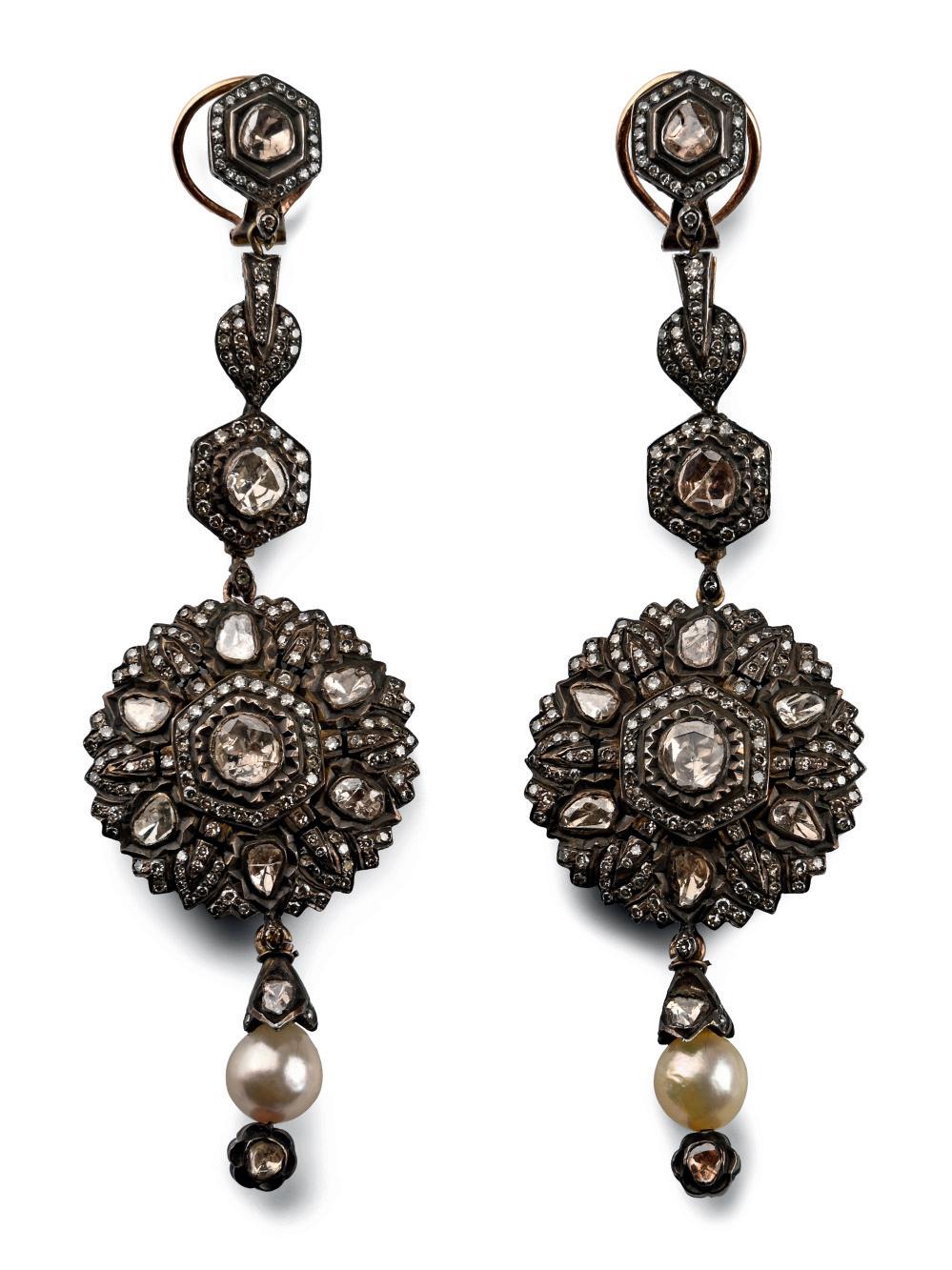
389 PAIR OF ELABORATE SILVER EARRINGS SET WITH DIAMONDS OTTOMAN, 1870-1900 A.D.
4 in. (53.62 grams total, 10.1-10.2 cm)
Each earring composed of five articulated segments, masterfully crafted in silver and gold with an openwork gold base frame executed in the ajour technique extending to the edges; the upper section featuring a hexagonal stud centred by a table-cut diamond within a border of small inset stones, followed by heart-shaped and hexagonal links adorned with further diamonds; the central rosette displaying a prominent diamond encircled by six flat-cut stones, with the interstitial lobes and the hexagonal double frame highlighted by rows of tiny diamonds; the reverse richly ornamented with a stylised flowering plant motif, two leaves flanking a central stem surmounted by a round flower, all defined in silver-set diamonds against the openwork gold ground, further enclosed by a twin ring of zig-zagging diamond lines; suspended below, a claw-form dangle holding a large round pearl, capped above and below with diamond-set finials. [2]
£18,000 - 24,000
PROVENANCE: Acquired in 2010. Private collection, London.
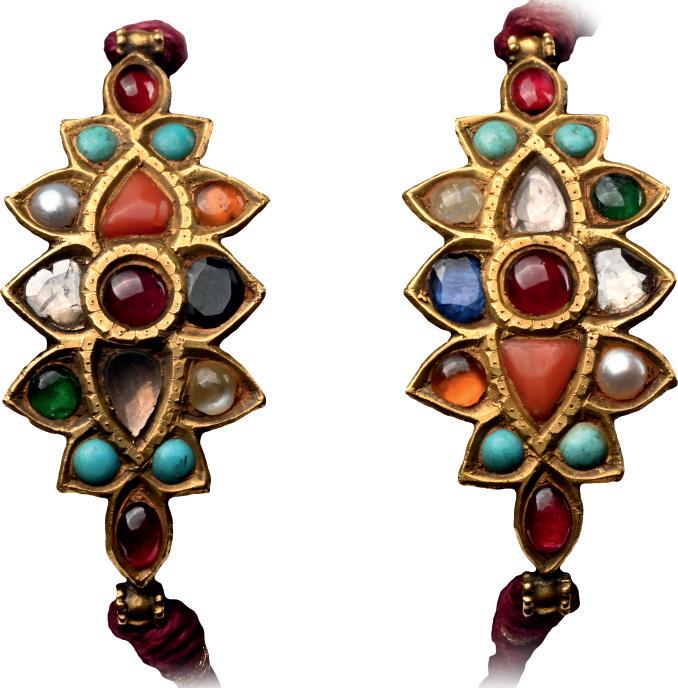
390

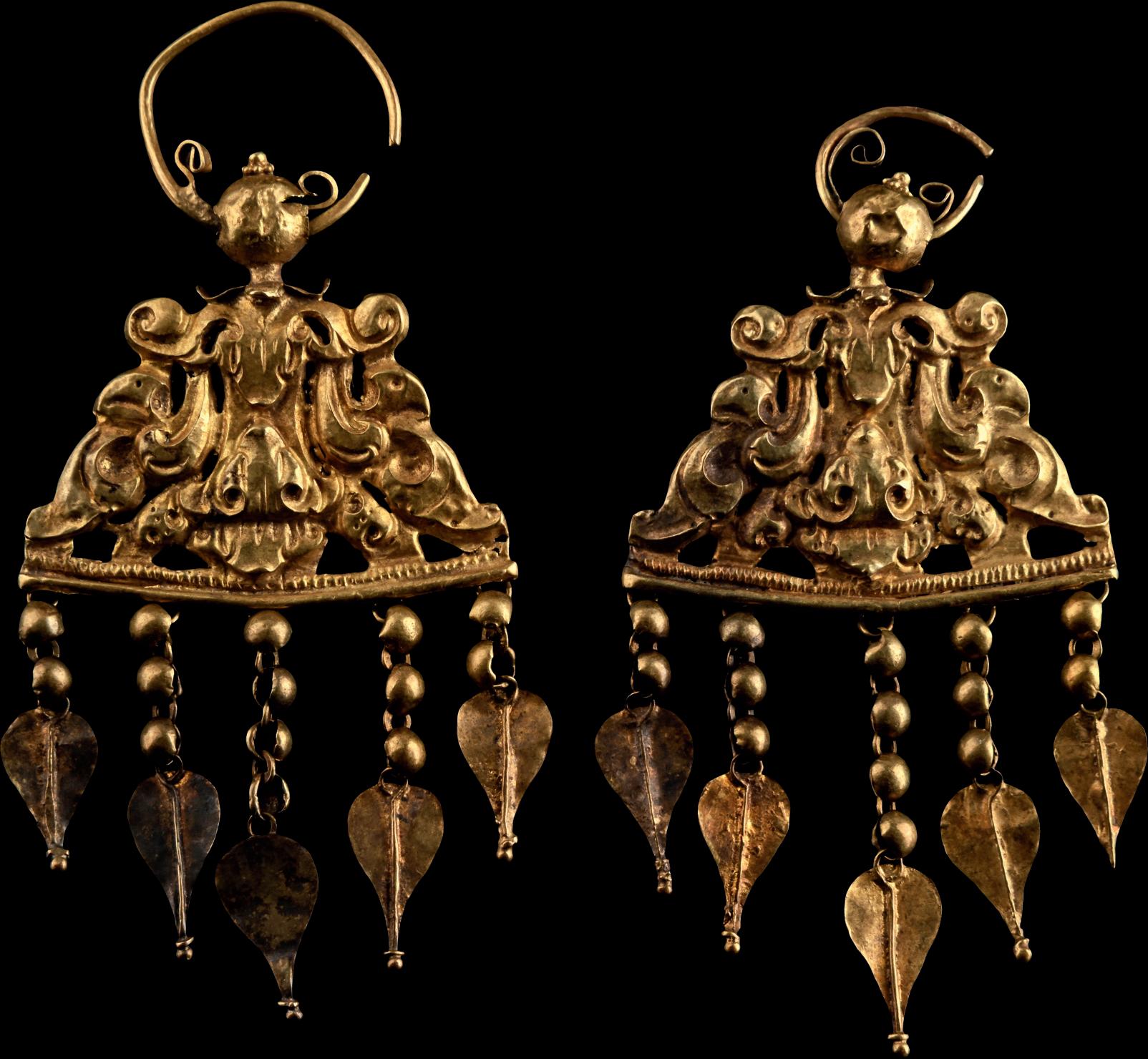
KASHMIR GOLD EARRING PAIR INDIA, 9TH-10TH CENTURY A.D.
2¾ - 3 in. (12.39 grams total, 70-78 mm)
Matched pair of earrings, each comprising a hoop with bulb flanked by small scrolls, a triangular plaque with repoussé pelta-shaped scrolls and openwork elements, beaded band and base with graduated chains ending in sheet-gold vine-leaf motifs with granule finals; mounted in a lined presentation case. [2] £18,000 - 24,000
PROVENANCE: Acquired in the late 1980s-early 1990s. Private collection, London.
FOOTNOTES: The matching necklace is on display in the Metropolitan Museum of Art, New York.
391


ELABORATE JAVANESE GOLD ZOOMORPHIC EAR ORNAMENTS INDONESIA, 1293-1530 A.D. 2¼ in. (73.18 total, 56 mm each)
A magnificent matched pair of highly domed ear ornaments, each displaying the front-facing head of Garuda, the eagle-headed Vahana or celestial mount of Vishnu; hollow-formed and exquisitely worked in repoussé, the crowned and nimbate figure emerging from a dense field of intricate floral motifs, the reverse adorned with a repoussé monkey design; presented in a custom-made lined case. [2]
£40,000 - 60,000
PROVENANCE: Collection of Frans H.A. Claessen, 1930s. Private collection, London, UK.
Accompanied by a copy of the an image of the 1930s photograph with these earrings.
PUBLISHED: Polak, J., Ancient Indonesian Gold of the Central and Eastern Javanese Periods, 750-1550, Leiden, 2022, pp.446-447, pl. 63, for a 1930s photograph showing the earrings while they were still part of the Claessen Collection in Holland.
FOOTNOTES: Garuda, whose epithet Suvarnakaya means 'Golden Bodied', is traditionally depicted with a human form and avian head, his bulging eyes symbolising vigilance and wisdom. Here, his sharp beak, ornate crown, and discoid earrings are rendered in superb detail, framed by a polished nimbus denoting his semidivine status. Delicately chased feather and vegetal designs at the base suggest the sweep of his wings.
F.H.A. Claessen emigrated from the Netherlands to Indonesia in 1919 as a young officer and was initially based in Malang, East Java. In the early 1920s, he relocated to Batavia (now Jakarta), where he held a Civil Service position as Inspector-General of Physical Education for the entire Indonesian school system. During this period, he travelled extensively throughout the Indonesian archipelago, occasionally collecting objects during his journeys. In the late 1939, Claessen returned to the Netherlands on leave but was subsequently stranded in Amsterdam under German occupation. He was later arrested by the Gestapo and died in March 1945 while held at the notorious Bergen-Belsen concentration camp.
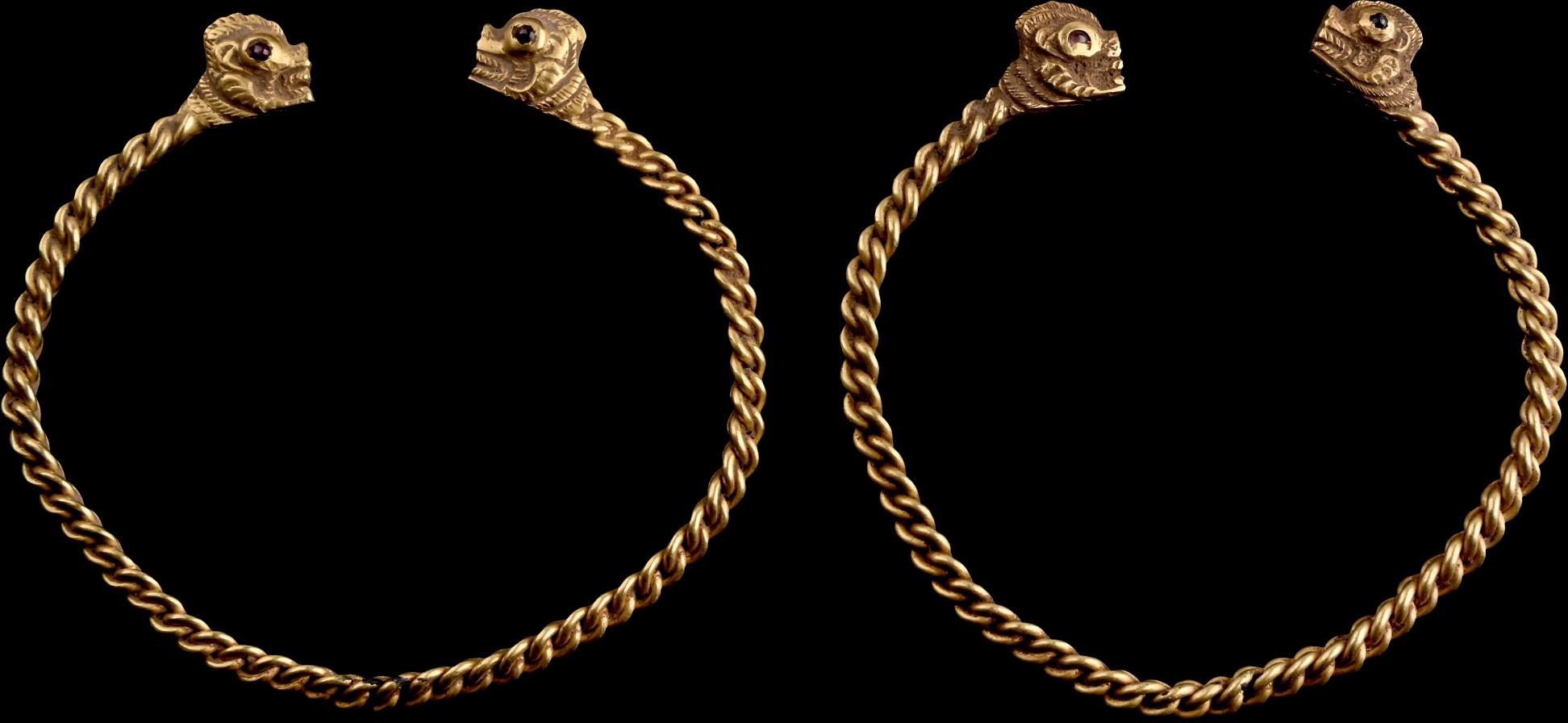

392

NORTHERN THAI GOLD DRAGON-HEADED BRACELETS WITH RUBIES AND SAPPHIRES
18TH CENTURY A.D.
2½ in. (24.18 grams total, 64-65mm)
A matched pair of penannular bracelets, each formed in tightly-bound plaited gold wire with terminals formed as the crested heads of makara, their eyes set with rubies; mounted in a lined presentation case. [2]
£5,000 - 6,000
PROVENANCE: Habsburg, Feldman, GOLD, Important Ancient and Ethnic Jewellery and Works of Art in Precious Metal, Hotel des Bergues, Geneva, 14 May 1990, no.105, 111. Acquired by the current owner from the above sale.
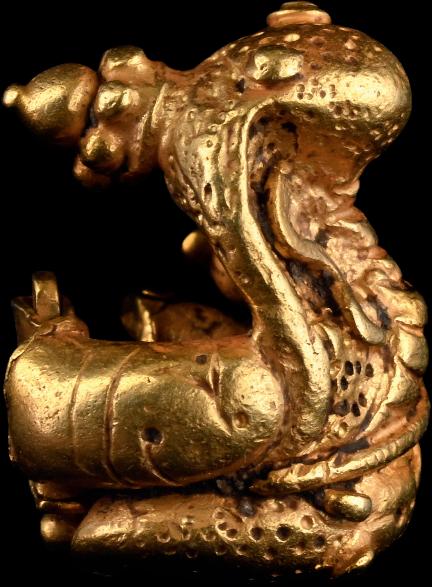
393
LATE GUPTA GOLD HAIR RING WITH MAKARA MASK INDONESIA, 6TH-7TH CENTURY A.D. 1 in. (9.37 grams, 25 mm)
Penannular hair-ring with granulation, formed as an animal mask with crown.
£5,000 - 7,000
PROVENANCE: Acquired in the late 1980s-early 1990s. Private collection, London.
394
LATE GUPTA GOLD HAIR RING WITH SERPENT INDONESIA, 6TH-7TH CENTURY A.D. in. (4.26 grams, 17 mm)
Penannular hair-ring with granulation, formed as an animal mask with crown; suspension loop absent.
£5,000 - 7,000
PROVENANCE: Acquired in the late 1980s-early 1990s. Private collection, London.

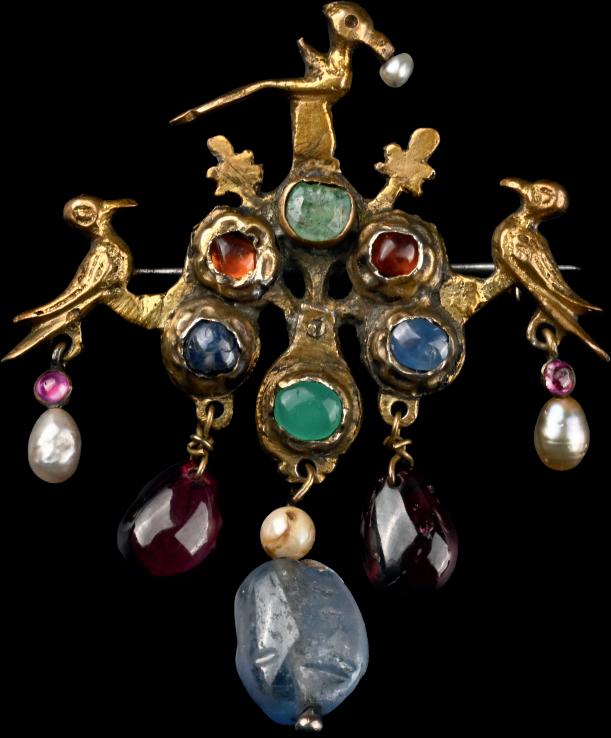
395
SILVER-GILT BRACELET WITH DIAMONDS
ALGERIA, 1860-1910 A.D.
9 in. (100 grams, 22.7 cm)
Comprising five parcel-gilt panels, each a rectangle with openwork floral motif to the centre and frame with hinge knuckles, gilt crescent above, set with eleven later diamonds (one absent); two pendant trefoils below each panel, each with an inset diamond; crescentshaped clasp at each end; mounted in a lined presentation case.
£12,000 - 17,000
PROVENANCE: Acquired in 2015. Private collection, London.
396
SILVER-GILT BROOCH WITH INSET GEMSTONES
18TH-19TH CENTURY A.D.
2½ in. (19.36 grams, 64 mm)
Comprising a circle of cells each with an inset gemstone, radiating birds and interstitial leaves, the upper bird with a pearl in its beak; drop pearls to each end, piriform cabochon drops below; hinged pin to reverse.
£3,000 - 4,000
PROVENANCE: Acquired in the late 1980s-early 1990s.
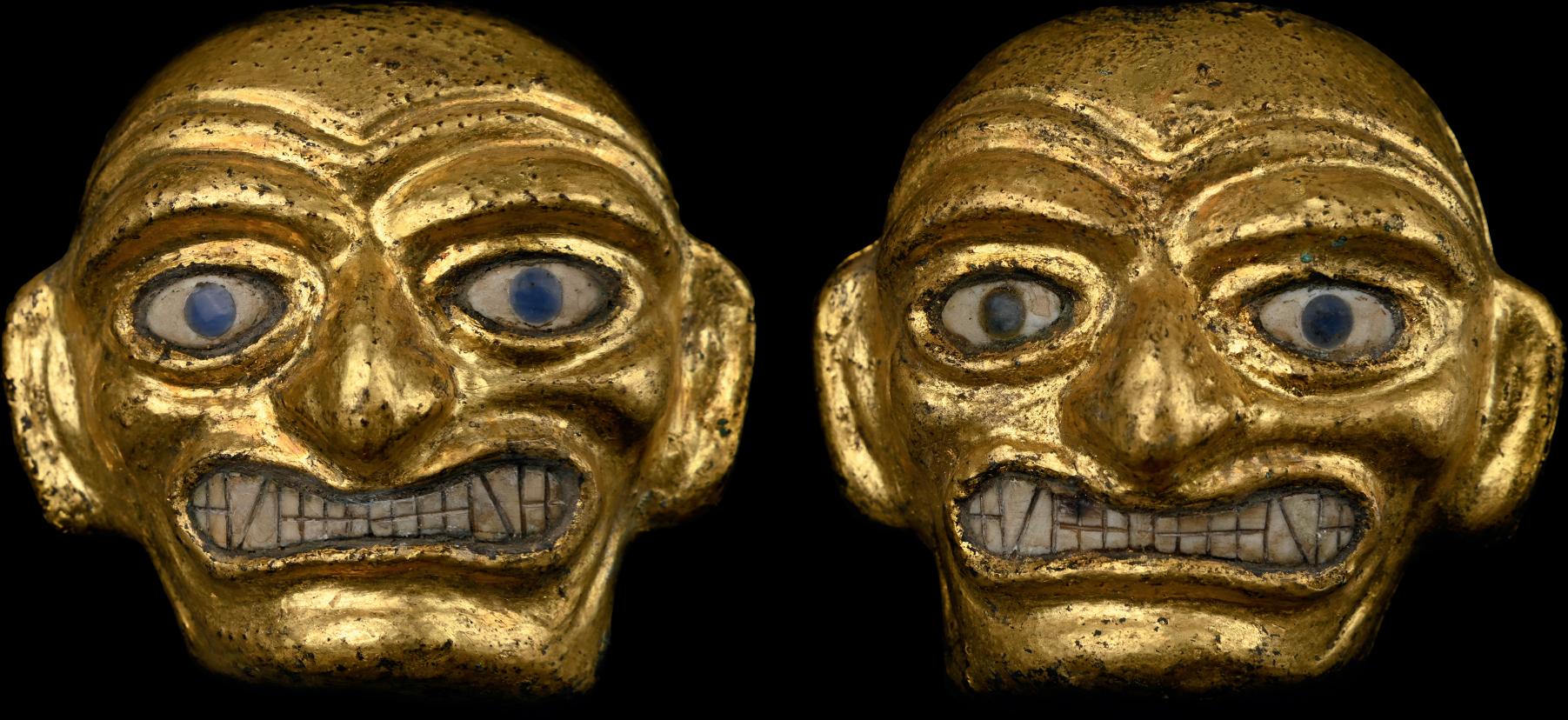
397

MOCHE TUMBAGO ROYAL JANUS PORTRAIT FIGURE WITH INLAID EYES AND TEETH
300-600 A.D.
2 in. (6¾ in.) (305 grams total, figure: 60 mm wide (17.3 cm including stand))
Hollow-formed janiform mask with possibly later shell inlays to the eyes and grimacing mouth; mounted on a custom-made stand.
£6,000 - 8,000
PROVENANCE: Wally and Brenda Zollman, Indianapolis; acquired prior to 1989. Splendours of the World (Jerry Bock), New York, USA.
Acquired from the above at a New York fair by the present owner, circa 2017. Part of the Zollman Collection which was published by the Indianapolis Museum of Art in 1989.
FOOTNOTES: This striking and fine example of Moche metalwork shows the feline deity with threatening snarl and teeth finely carved in shell. This fine and powerful example would have been made for an important individual as a symbol of power.
398

PSITTACOSAURUS FOSSIL DINOSAUR SKELETON
CIRCA 120-100 MILLION YEARS B.P. 10 in. (3.33 kg, 25.3 cm)
Complete fossil skeleton of a Psittacosaurus revealed from its matrix.
£5,000 - 7,000
PROVENANCE: Found China/Mongolia. From a collection since 2004.
Property of a North London, UK, gentleman.



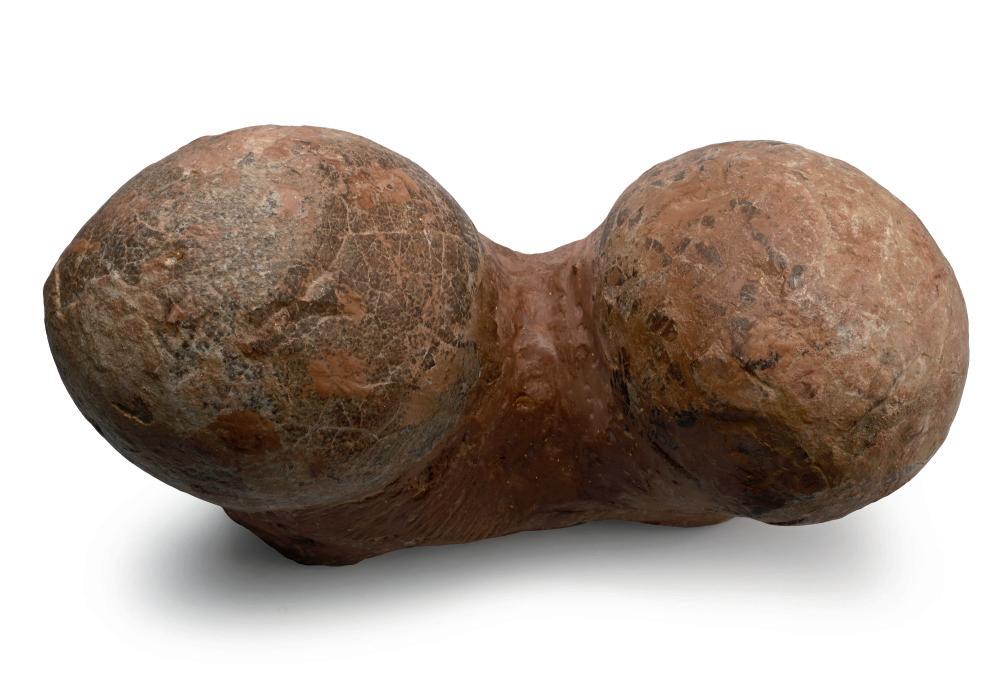

399

ENORMOUS FOSSIL MOSASAUR ‘MARINE DINOSAUR’ SKULL
CRETACEOUS PERIOD, 67-65 MILLION YEARS B.P.
55 x 39¼ in. (164 kg, 140 x 100 cm)
An exceptionally large and spectacular fossil Mosasaurus anceps partial skull on matrix showing both sides of both upper and lower jaws, with dentition; the main skull compressed during fossilisation and thus fragmented but well preserved; the matrix set into a plaster surround.
£2,000 - 3,000
PROVENANCE:
From the phosphate beds, Oved Zem, Morocco.
From an East Anglian, UK, collection.
Property of a Hounslow, S.W. London, gentleman collector.
400
FOSSIL HADROSAUR DINOSAUR NEST EGG PAIR
CRETACEOUS PERIOD, 145-65 MILLION YEARS B.P.
12¾ in. (10.35 kg, 32.5 cm wide)
A pair of Charonosaurus sp. hadrosaur eggs on a matrix retaining evidence of the original leathery surface.
£600 - 800
PROVENANCE:
Acquired between the 1970s and 1980s.
From the private collection of John Watson, Cambridge, UK.
401 LARGE FOSSIL THEROPOD DINOSAUR EGG
CRETACEOUS PERIOD, 145-65 MILLION YEARS B.P.
17¾ in. (11.4 kg, 45 cm)
An elongated egg in matrix retaining some evidence of leathery surface, probably Macroelongatoolithus xixiaensis, a giant form of Oviraptor.
£800 - 1,000
PROVENANCE: Previously from a Hong Kong collection. Ex property of a London, UK, gentleman.

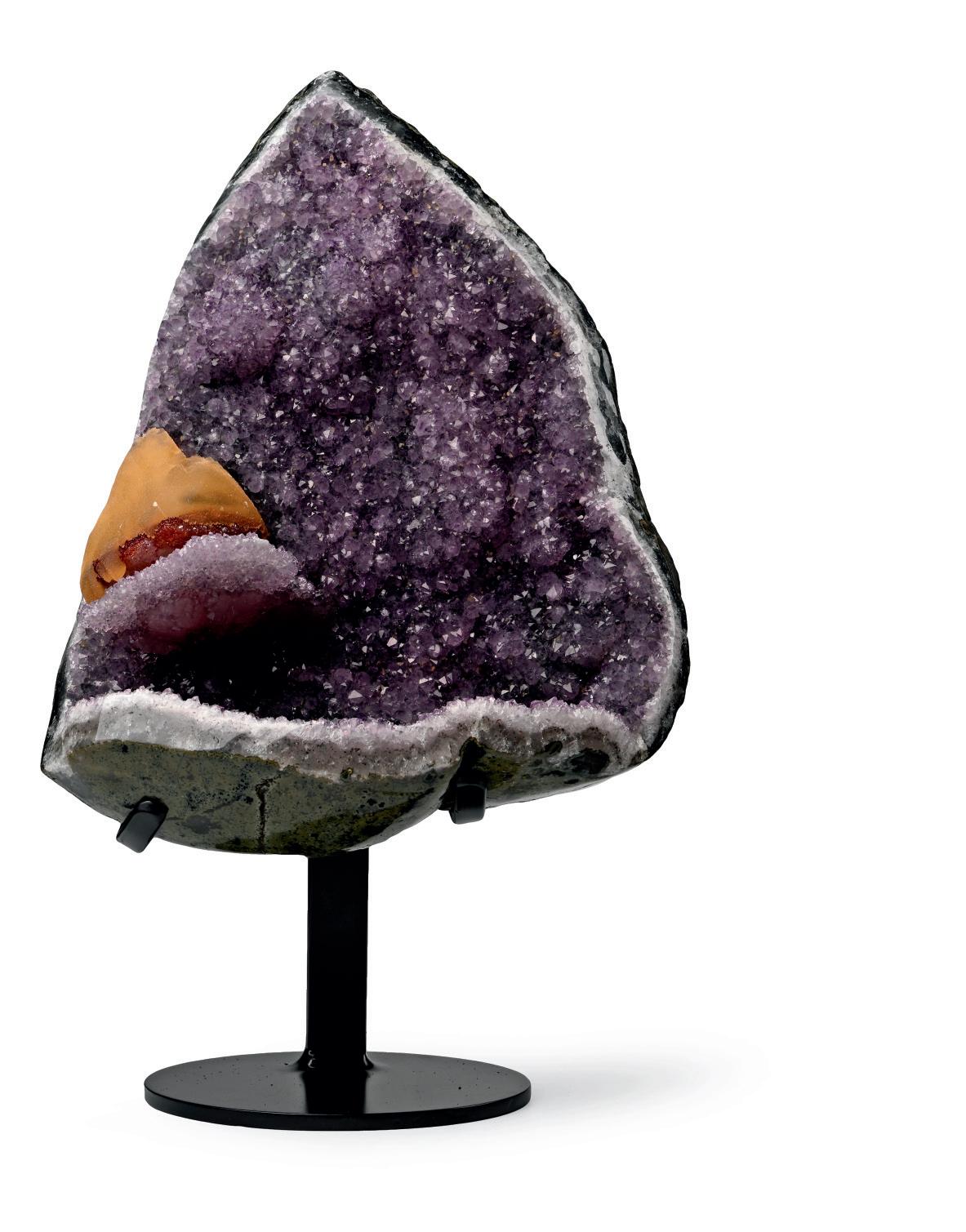
402

AMETHYST GEODE HEART WITH INTRICATE FORMATIONS
20¼ in. (56 kg total, 51 cm including stand)
A large polished display specimen from the centre of a large geode showing various crystal formations, including: dark and light purple prismatic amethyst crystals, stellate white quartz formations and orange druse on the other side; accompanied by a custom-made display stand.
£2,500 - 3,500
PROVENANCE:
From Artigas, Uruguay. Property of a London lady.
403

TRIANGULAR AMETHYST CRYSTAL GEODE SECTION WITH CALCITE
17 in. (8.1 kg total, 44.2 cm high including stand)
The polished geode section lined with purple amethyst crystals, large gold-coloured calcite crystals on a bed of red drusy quartz, a ledge of lilac amethyst crystals below; mounted on a custom-made display stand.
£2,000 - 3,000
PROVENANCE: From Artigas, Uruguay. Property of a London lady.
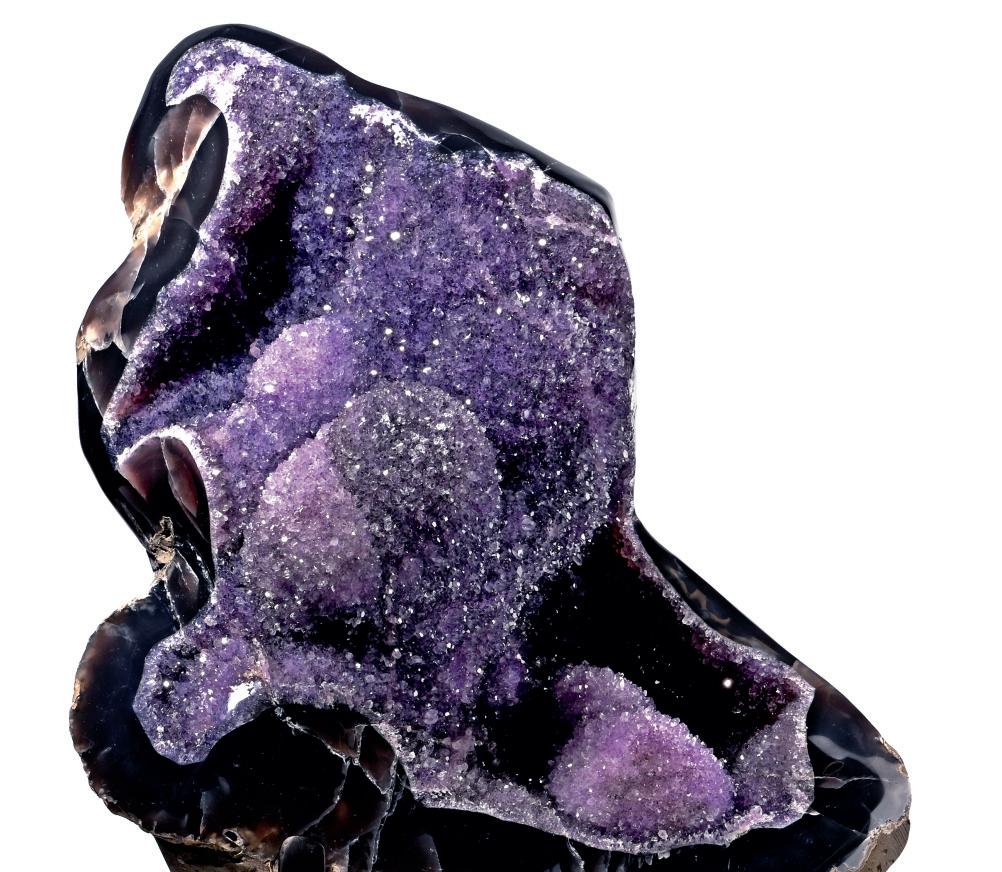
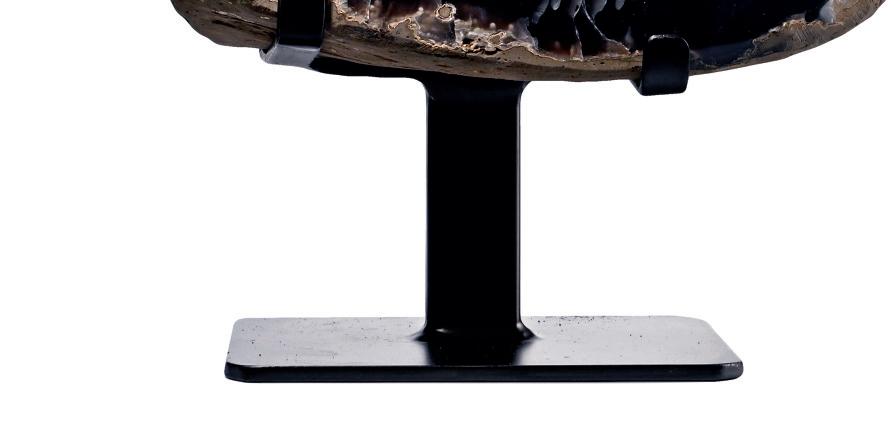

405

CATHEDRAL GEODE HALF WITH AMETHYST AND CALCITE CRYSTALS
13¾ in. (17.35 kg, 35 cm)
The cathedral lined with large deep purple amethyst crystals, white dog tooth calcite crystals emerging from the left corner; mounted on a custom-made display stand.
£2,500 - 3,500
PROVENANCE: From Artigas, Uruguay. Property of a London lady.
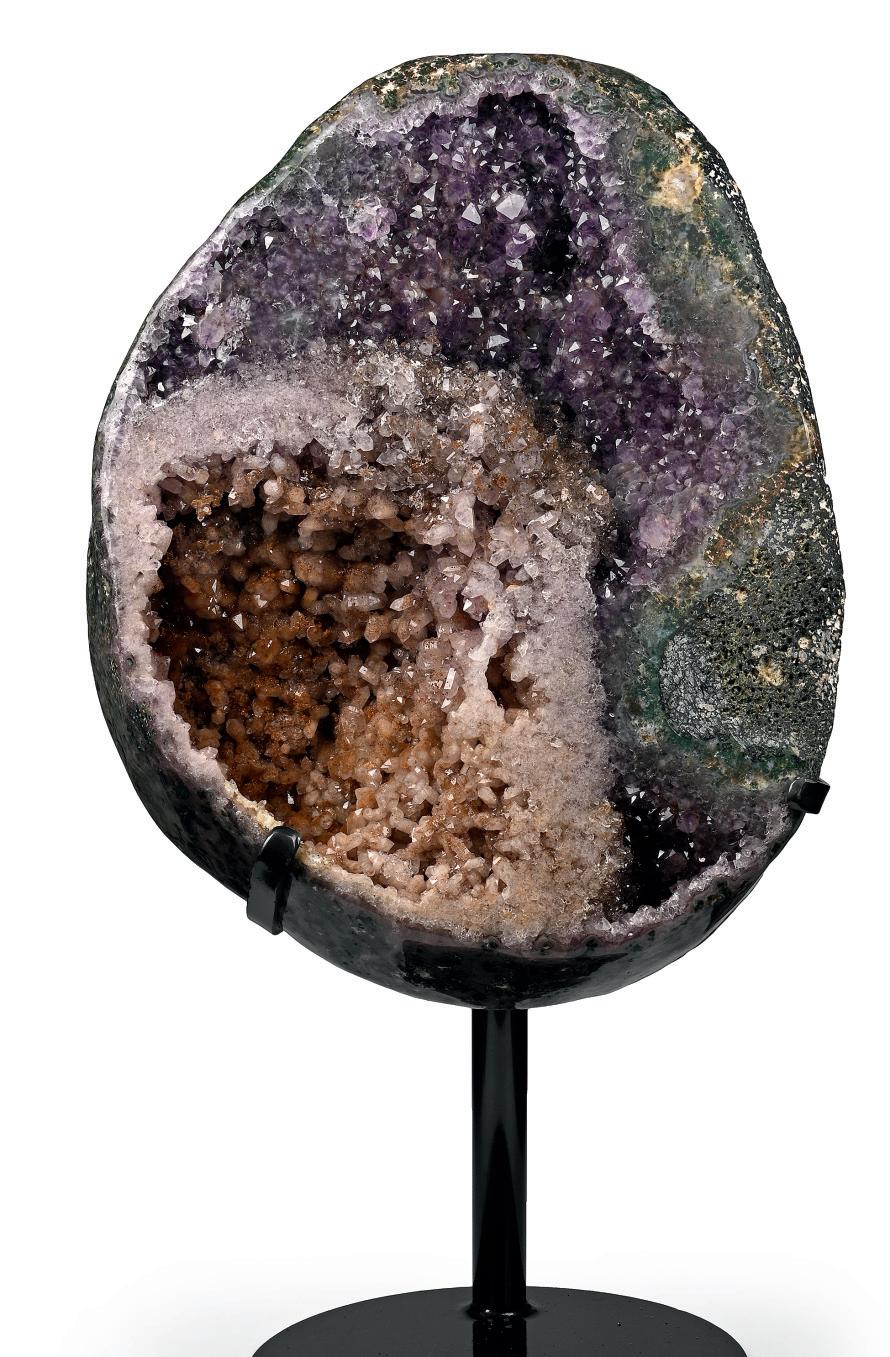
404

AMETHYST CRYSTAL GEODE FORMATION WITH AGATISED BORDERS
20 in. (23.8 kg total, 53 cm high including stand)
A large geode specimen, cut and polished with undulating lines, the interior of the geode lined with light and dark amethyst crystals; accompanied by a custom-made display stand.
£1,500 - 2,000
PROVENANCE: From Artigas, Uruguay. Property of a London lady.
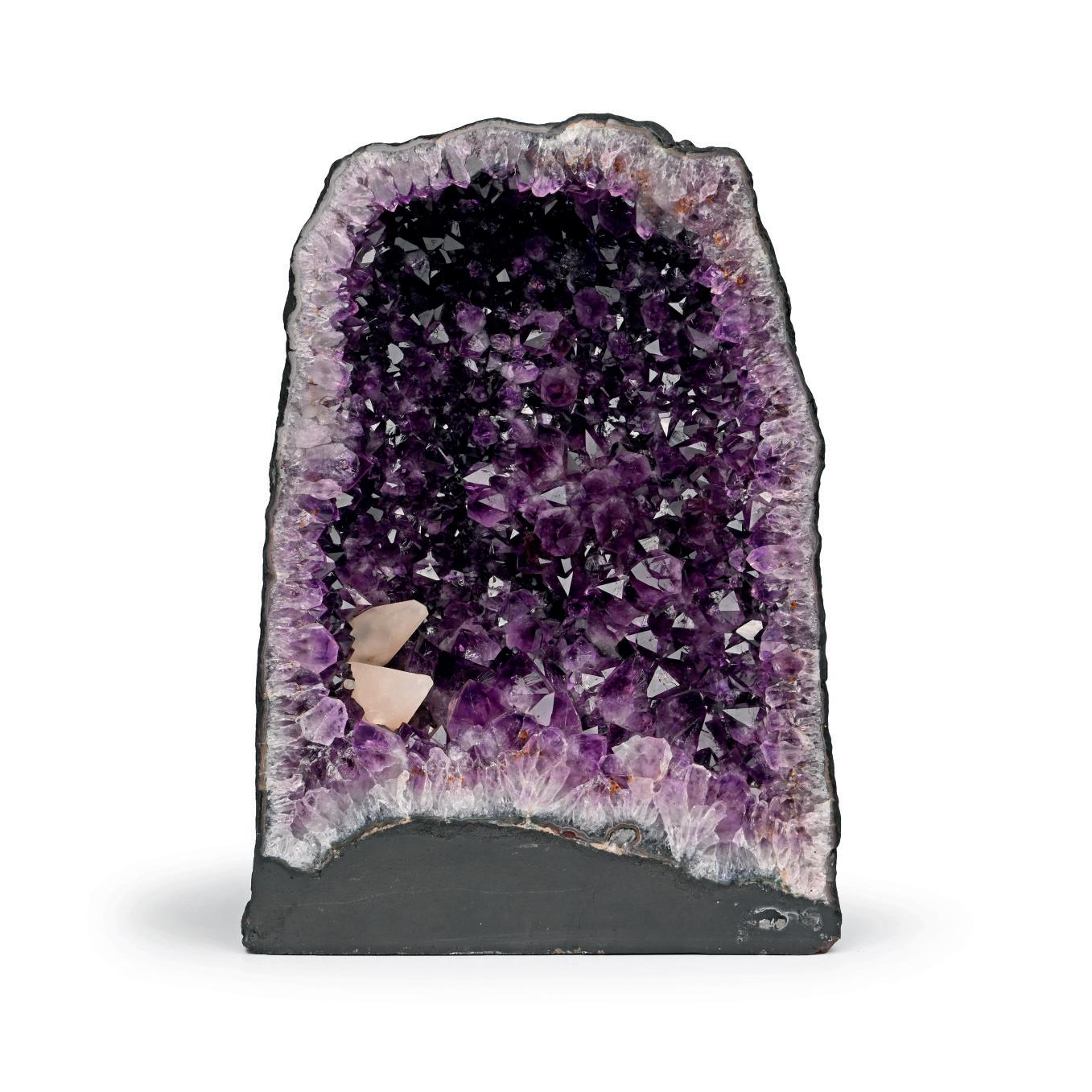

406

AMETHYST AND QUARTZ GEODE SECTION
33 in. (55 kg total, 83 cm including small stand)
A very large geode section with polished edges, the interior composed of two interlocking sections, one lined with richly coloured purple amethyst crystals, the other side with orange and white quartz crystals, some double-terminated, some light purple amethyst crystals to the edge wall; accompanied by two custom-made display stands, one tall and smaller.
£2,500 - 3,500
PROVENANCE: From Artigas, Uruguay. Property of a London lady.
407

‘ICY LANDSCAPE FORMATION’ IN WHITE QUARTZ
9½ in. (1.56 kg total, 24 cm incuding stand)
A cut geode section with flower-like formations of white, clear and grey quartz crystals, with black hematite(?); accompanied by a custom-made display stand.
£500 - 700
PROVENANCE: From Artigas, Uruguay. Property of a London lady.
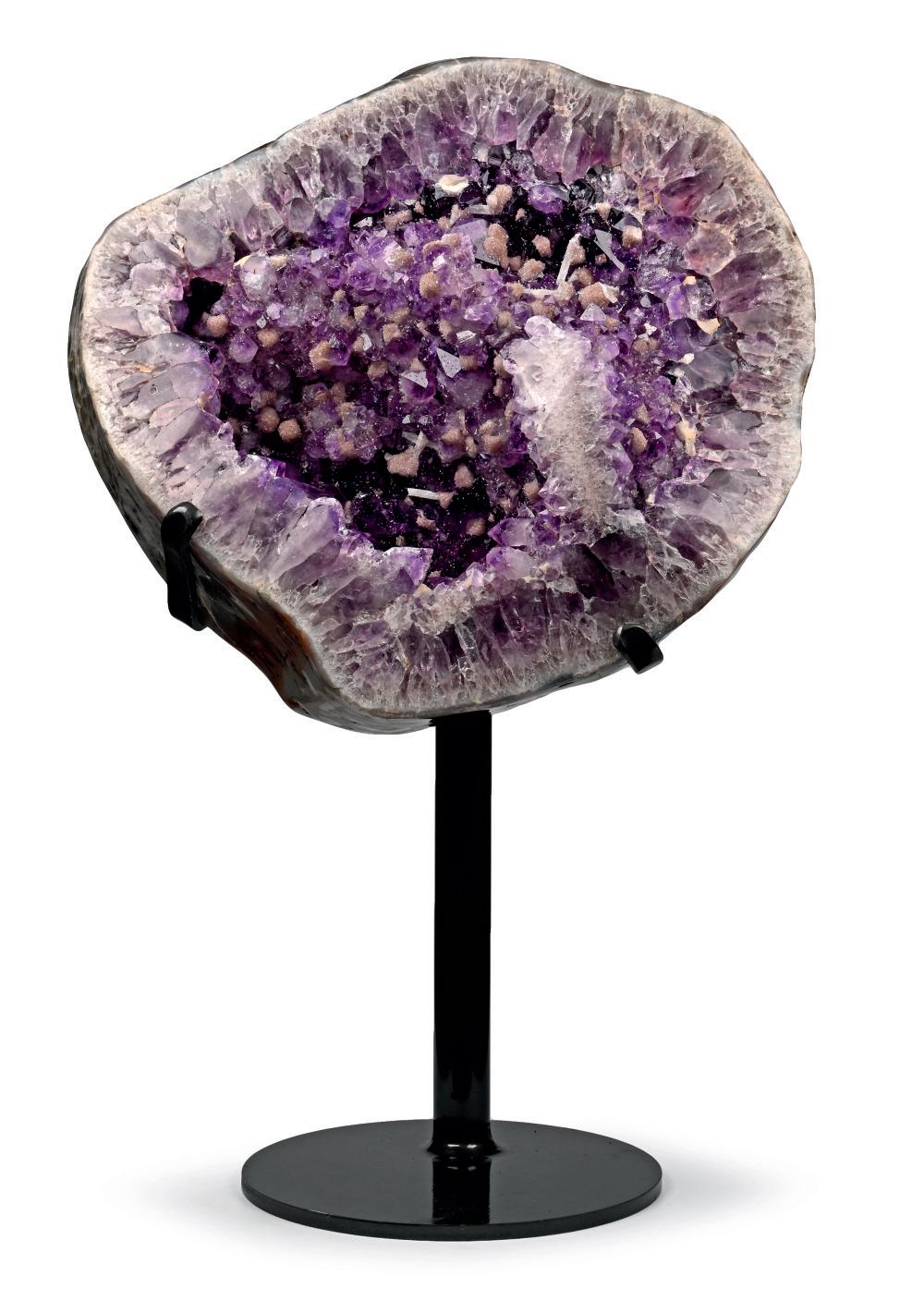
409

LILAC AMETHYST WITH CENTRAL CALCITE ROSETTE
12 in. (8.19 kg total, 32 cm wide including stand)
A large bowl-shaped piece formed of small lilac amethyst crystals with a stunning central honey-coloured calcite formation resembling a rosette; at the base of the calcite, pink druzy quartz formation; accompanied by a custom-made display stand.
£1,500 - 2,000
PROVENANCE: From Artigas, Uruguay.
of a London lady.
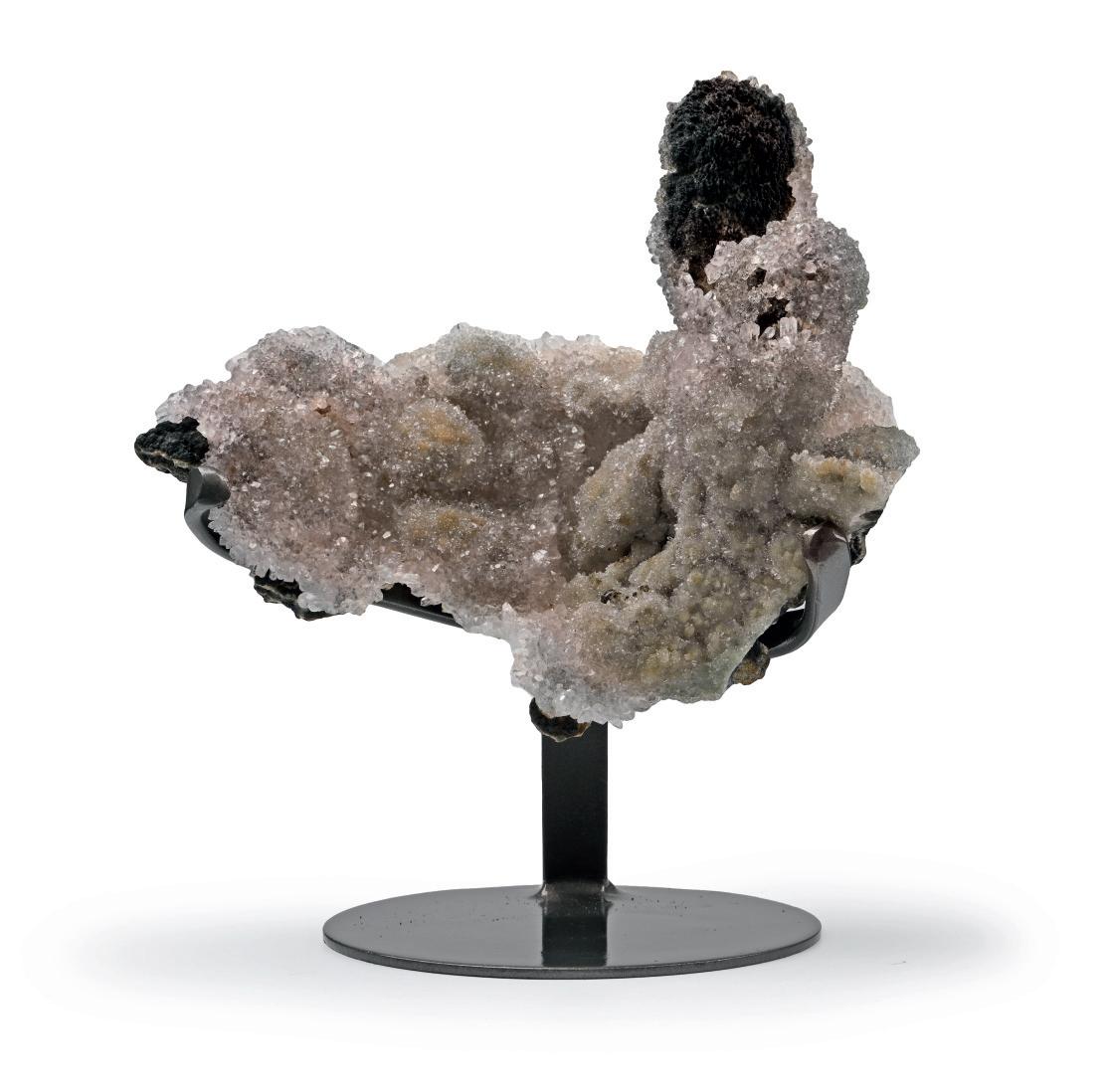
408

DEEP PURPLE AMETHYST CRYSTALS WITH CALCITE ‘SNOWBALLS’
29 in. (45 kg total, 73.5 cm including smaller stand)
A cut section of a geode with polished edges, lined with well-formed deep purple and lavender coloured amethyst crystals, prismatic quartz crystals, and snowball-shaped formations of calcite with druzy quartz, most amethyst crystals with minute quartz crystals; accompanied by two display stands, one tall and one smaller.
£1,500 - 2,000
PROVENANCE: From Artigas, Uruguay.
of a London lady.
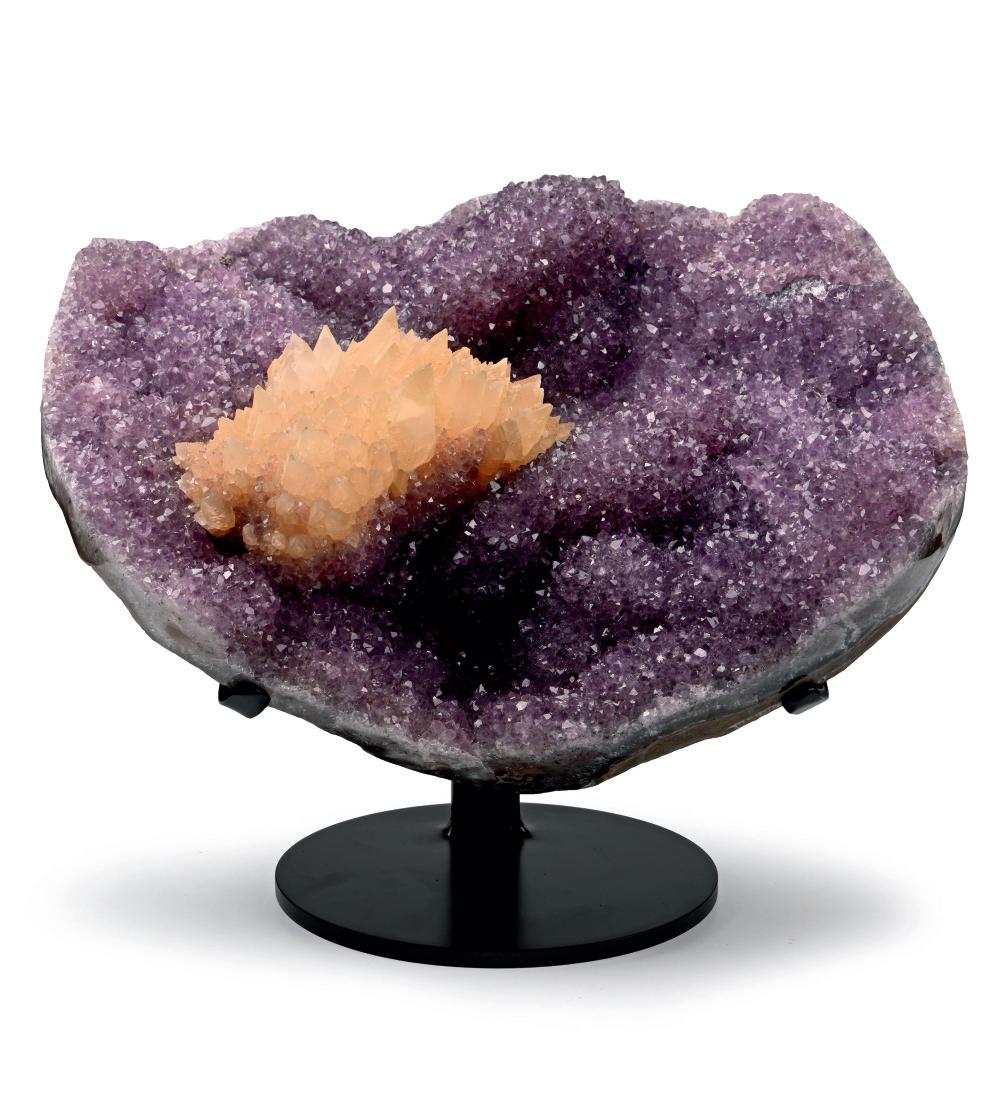
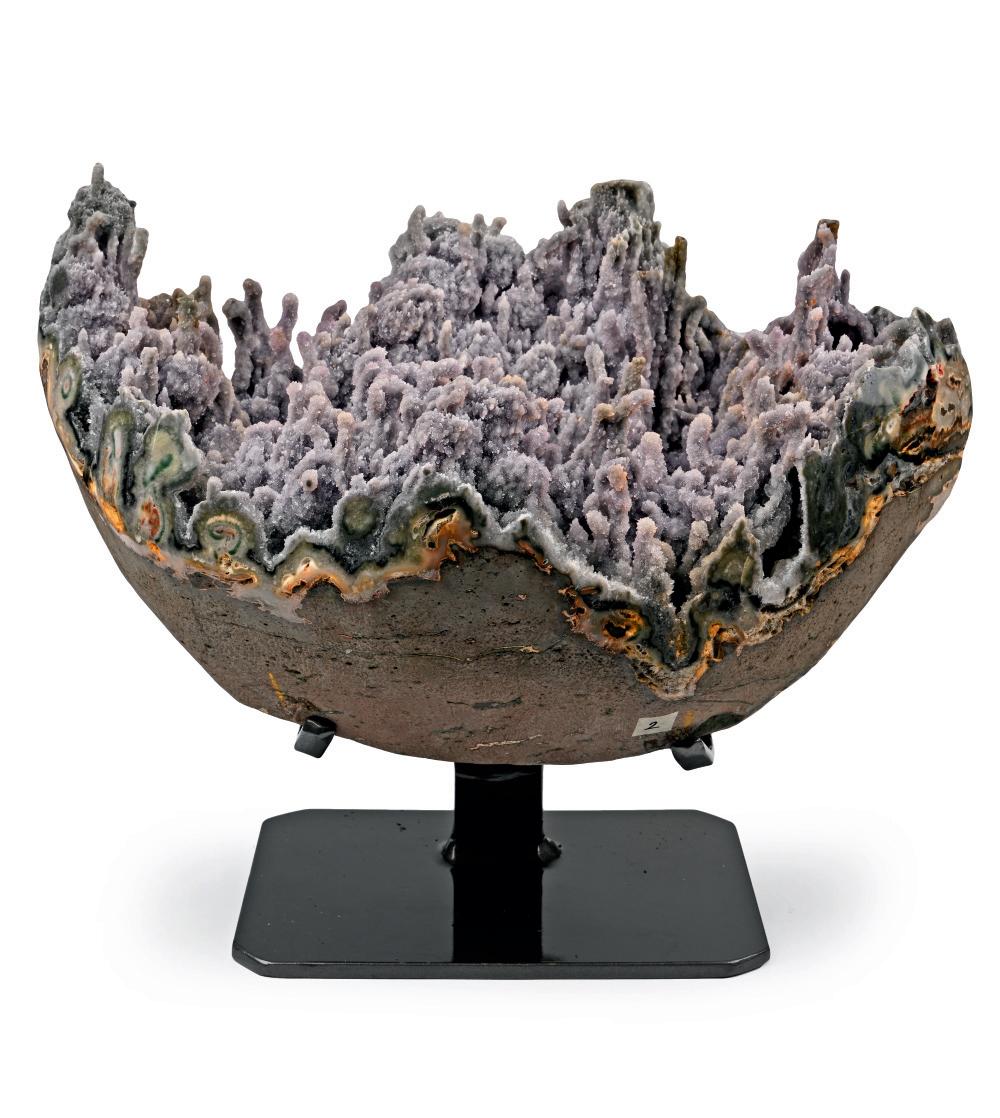
411

BOAT-SHAPED FORMATION OF QUARTZ AFTER ANHYDRITE
12 in. (2.6 kg total, 32 cm wide including stand)
A boat-shaped cut section of a geode with large blade-shaped white crystals of quartz after anhydrite; accompanied by a custom-made display stand.
£1,200 - 1,700
PROVENANCE:
From Rio Grande do Sul, Brazil. Property of a London lady.
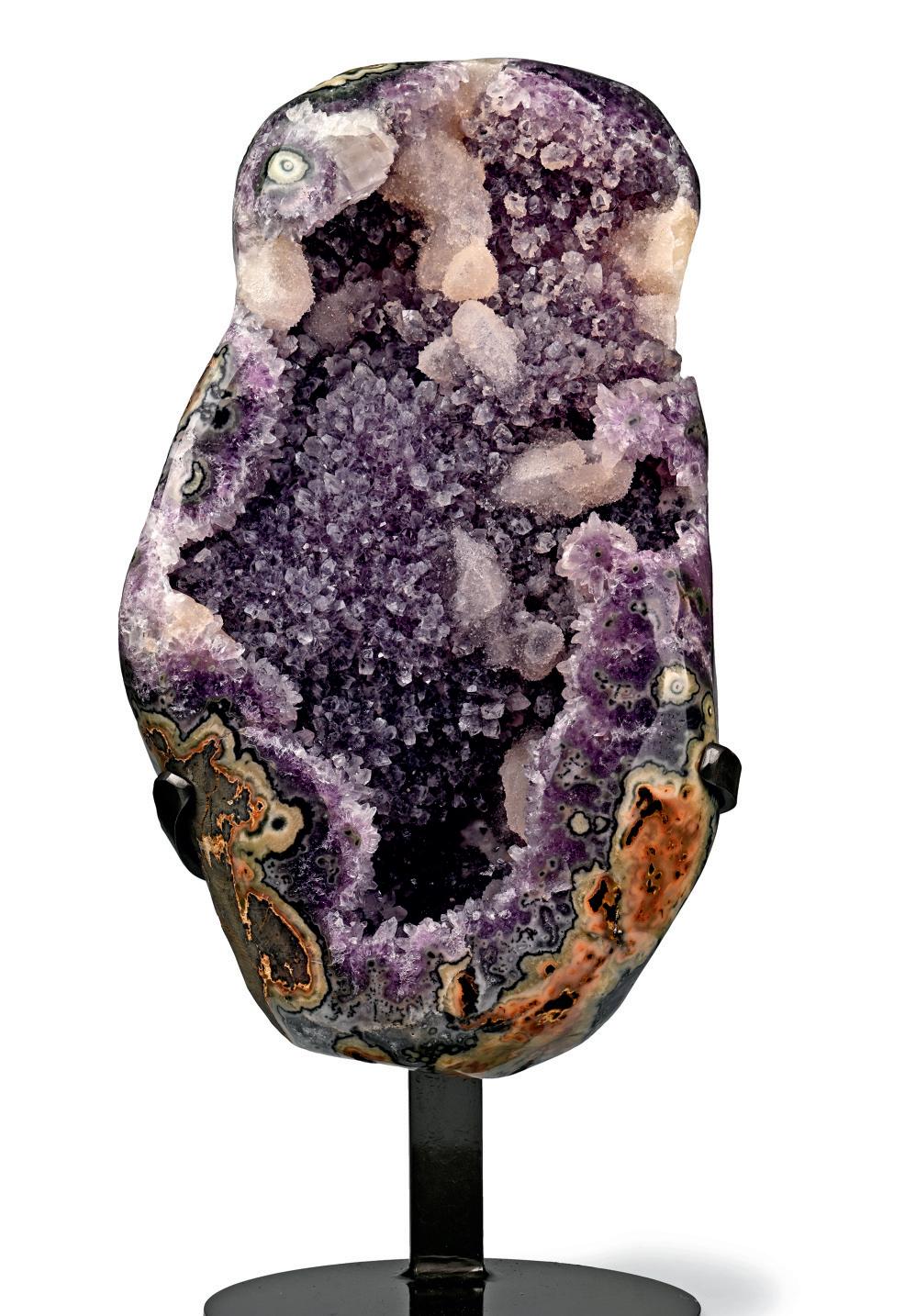
410

ROUND AMETHYST CRYSTAL GEODE WITH POLISHED BORDERS
11½ in. (17.5 kg total, 29.5 cm high including stand)
An unusual rounded geode section with stalagmite-like formations of calcite and quartz rising from the base, polished borders revealing the celadonite shell with some exterior basalt visible; accompanied by a custom-made display stand.
£3,000 - 4,000
PROVENANCE:
From Artigas, Uruguay. Property of a London lady.
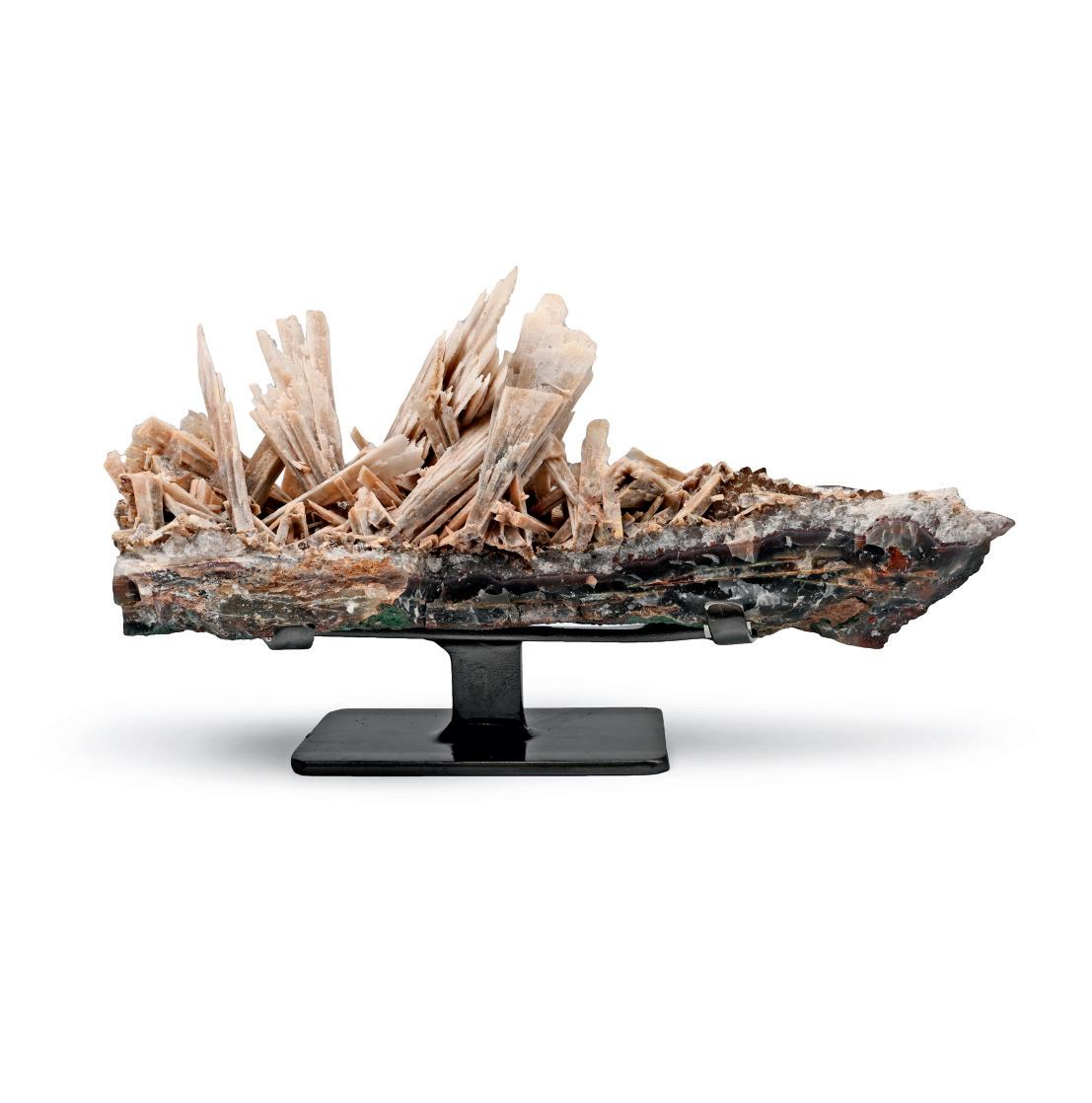
412

AGATISED AMETHYST CRYSTAL GEODE SECTION WITH POLISHED EXTERIOR
25½ in. (24 kg total, 64.5 cm high including stand)
The borders polished to emphasise the beautiful agatised layers; the inside cavity lined with purple amethyst, creamy calcites and white quartz, creating a frosted appearance; accompanied by a custommade display stand.
£2,500 - 3,500
PROVENANCE:
From Artigas, Uruguay. Property of a London lady.
413

LARGE SPHERICAL AMETHYST CRYSTAL GEODE
18 in. (21 kg total, 45.5 cm high including stand)
A substantial rounded geode section lined with rich, deep purple amethyst crystals enveloping white calcite at the base; accompanied by a custom-made display stand.
£1,500 - 2,000
PROVENANCE:
From Artigas, Uruguay. Property of a London lady.

415

LARGE AMETHYST GEODE WITH CALCITE FORMATION
13¾ in. (17.65 kg, 35 cm)
Cut geode lined with richly-coloured dark purple and lavender coloured amethyst crystals; to the centre of the geode, large creamcoloured calcite crystals bordered by green celadonite and white quartz, typical of Uruguayan crystal formations.
£1,500 - 2,000
PROVENANCE: From Artigas, Uruguay.
London lady.
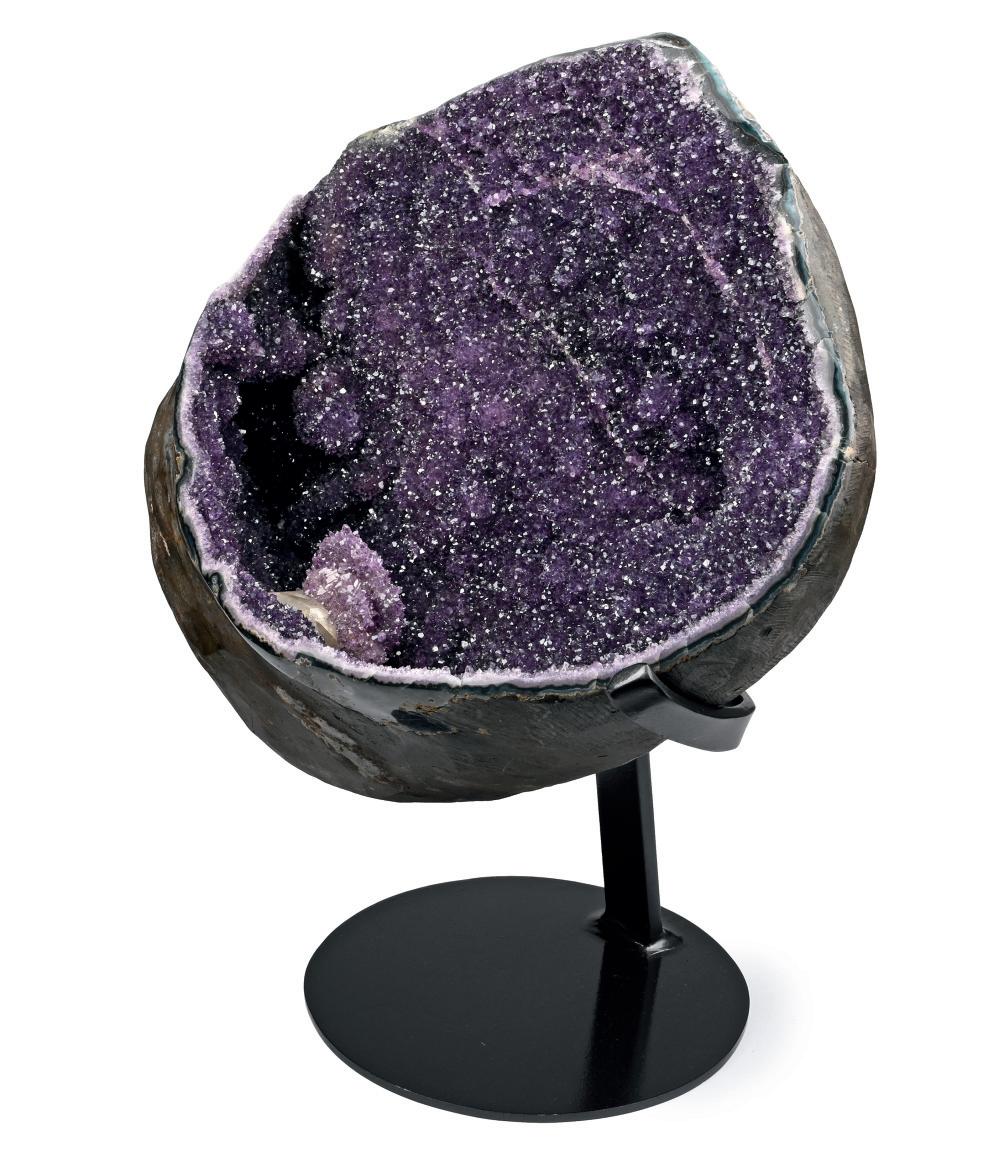
414

DEEP PURPLE AMETHYST CRYSTAL CLUSTER FORMATION
20½ in. (10 kg total, 53 cm high including stand)
A cut section of beautifully layered amethyst crystals with orange druse, polished stalactite formations on the field formed of green celadonite, red-brown agate and white quartz; mounted on a custommade display stand.
£1,500 - 2,000
PROVENANCE: From Artigas, Uruguay. Property of a London lady.
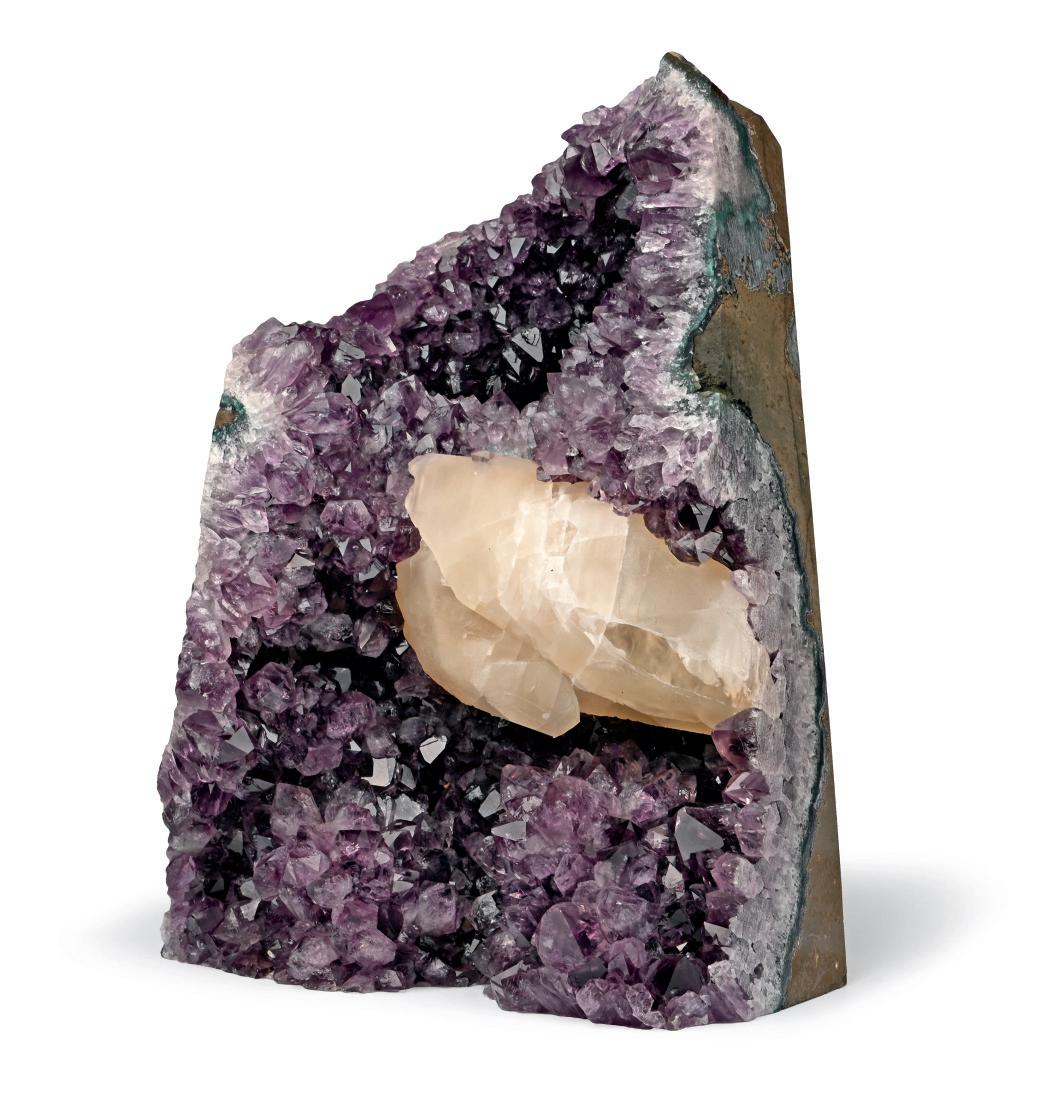
Bidder/Buyer Terms and Conditions
1. Interpretations and Definitions: the following terms generally apply within these Terms and Conditions; other terms are defined within specific sections following:
Auctioneer – the firm TimeLine Auctions Ltd (“TimeLine” hereafter) or its authorised auctioneer, acting as Agent for the Seller.
TimeLine is a company registered in England and Wales (company no: 06873501) with registered office at The Court House, 363 Main Road, Harwich, CO12 4DN, UK. The website and telephone number are https://timelineauctions.com and +44 (0) 1277 815121.
Agent – a person or body acting on behalf of another.
ALR – Art Loss Register - All lots with an upper estimate value of £1,500 and above and all ancient Western Asiatic lots are searched against the Art Loss Register database.
Auction – a sale event whether taking place live in real-time or of extended duration (Timed Auction).
Bid – a sum offered by a Bidder to purchase the Lot.
Bidder – the person offering a Bid.
Buyer – the Bidder who the Lot is Knocked Down to.
Buyer’s Premium – the percentage of the Hammer Price payable by the Buyer to TimeLine in accordance with clause 21.
CITES - Convention on International Trade in Endangered Species.
Data Protection Legislation –all applicable data protection and privacy legislation in force from time to time in the UK including the General Data Protection Regulation ((EU) 2016/679) (83) (GDPR); the Data Protection Act 2018; the Privacy and Electronic Communications Directive 2002/58/EC (as updated by Directive 2009/136/EC) and the Privacy and Electronic Communications Regulations 2003 (SI 2003/2426) as amended, and any and all applicable national data protection laws made under or pursuant to the GDPR, as may be amended or superseded from time to time.
Date of Sale – the date on which the Auctioneer Knocks Down the Lot. Group – any Lot comprising more than one item.
Hammer Price – the amount of the winning bid when Knocked Down by the Auctioneer to a Bidder.
Knock(ed/ing) Down – the act of the Auctioneer in bringing the Hammer down to complete the contract for the sale of the Lot to the Bidder submitting the highest bid.
Lot – the goods for sale.
Purchase Price – the total sum due for any Lot, including the Hammer Price, the Buyer’s Premium, any internet bidding fees, any shipping charges, taxes, duties or any other costs payable to TimeLine.
Registered Bidder –a Bidder who has registered with TimeLine for the purpose of taking part in any Auction. Reserve Price –the minimum Hammer Price at which a Lot may be Knocked Down.
Seller – the person offering the Lot for sale. Terms – means these Terms and Conditions. Title – legal rights of ownership of the Lot.
2. Application: the singular includes the plural and vice versa and any reference to ‘he’, ‘she’ or ‘it’ applies to all of them.
3. Basis of Contract:
a. These Terms and Conditions apply to the exclusion of any other terms that the Bidder/Buyer seeks to impose or incorporate, or which are implied by trade, custom, practice or course of dealing.
b. Each Buyer is required to carefully read the Terms and Conditions before offering a Bid. When a Buyer makes a Bidhe/she acknowledges that he/she has read, understood and accepted these Terms. c. TimeLine does not act for or give any advice to Bidders/Buyers.
4. Dimensions, weights and colour: All dimensions and weights (including ring sizes) are approximate and are for general guidance only; a single dimension given is normally the greatest dimension for the piece(s). Although TimeLine have made every effort to precisely display the colours and condition of a Lot, TimeLine does not guarantee or represent that a device displays them accurately. The Lot may vary slightly from those images.
5. Condition: A condition statement for Lots
is not given in the catalogue, printed or online. This does not infer that any Lot is free from faults and prospective Bidders must satisfy themselves entirely as to the fullcondition of each piece before placing Bids. Condition Reports may be requested for any lot but are given only for general guidance and are inevitably subjective in character. Requests for Condition Reports should be made as early as possible; requests received at a late time may not be available before the lot is offered. Bidders are encouraged to carefully examine in person any Lot(s) for which they intend or do Bid for. It is not possible to note all marks or defects and neither TimeLine or the Auctioneer make any guarantee as to the physical quality or condition of any Lot(s).
6. Dating: Dates may be given in several forms, as examples below:
527 AD - an item that bears a date upon it or that can otherwise be dated with precision; 6th century AD - an item that can be dated with considerable confidence to a specific period;
Circa 6th century AD - an item that can be approximately dated by comparison with other pieces;
Probably 6th century AD - an item that is likely to be of this period in the light of similar pieces; Possibly 6th century AD - an item that might be of this period by comparison with items of a broadly similar character; and Undated - no date is known or suggested for the piece.
6th Century AD or later – an item is dated to a specific period but may also be a revival of style of a later date.
7. Attributions: Works of art attributions may be given in several forms, as examples below:
Signed – a work bearing the signature of the named artist;
Attributed to – a work of the period of the artist which may be in whole or in part the work of the artist named;
Circle of – a work of the period of the artist and showing his influence; Follower of – a contemporary or nearly so work executed in the style of the artist; Manner of – a work executed in the style of the artist but of a later date; and After – a copy of any date of a work of the artist.
8. Other Descriptive Matters: Some other words or phrases are used descriptively, as examples below:
Style - an item made in the style of an earlier age but thought to be probably of later date.
Archaistic - an item made in the style of a much earlier age; Grand Tour - an item usually of some age but in the style of an earlier age; After the Antique - an item made as a reproduction, usually of quite modern date; and Faux - used descriptively when the material used is probably imitative in character.
9. Lots including Archaeological or Cultural Property: A UK export licence from the Department for Digital, Culture, Media and Sport, is required for Lots originating from UK soil or territory leaving the UK and for such Lots of non-UK origin when leaving the UK. TimeLine will make applications for the necessary Cultural Property Export Licence as a ‘free of charge’ service to Buyers, where the Export Licence is legally required. If a Buyer requests for TimeLine to apply for an Export Licence where this is not legally required, an additional fee of £24 (VAT inclusive) will be invoiced to the Buyer. Buyers are advised to check concerning any Regulations applicable in their country of residence regarding importation and to enquire prior to bidding. The deferment of any Export Licence shall not be reason to cancel any bid nor to delay payment.
10. Compliance with Cultural Goods Regulation: Each Bidder/Buyer acknowledges that the importation of cultural goods into the EU is subject to EU Regulation 2019/880, effective from 28 June 2025. Each Bidder/Buyer agrees to comply fully with all applicable laws and regulations governing the importation, including but not limited to:
a. Obtaining any required import licence (for Category B items: archaeological objects or items >250 years old).
b. Submitting a valid importer statement for
Category C items (objects >200 years old valued ≥ €18,000).
c. Providing proof of lawful export from the country of origin (including the UK) where applicable.
11. TimeLine’s limited obligation in relation to the Cultural Goods Regulation: TimeLine shall, to the extent it has received from the Seller and the Buyer has paid in full the due Purchase Price in accordance with clause 30, provide supporting documentation to each relevant Bidder/Buyer, relating to:
a. Provenance and ownership of the relevant Lot.
b. Customs export declaration from the UK.
c. Any UK cultural property export licences (if required under the UK’s own export control regime).
However, TimeLine shall not be liable to any Bidder/Buyer for:
i. Delays in EU customs clearance.
ii. The Bidder’s/Buyer’s failure to obtain the required import documentation or statements.
iii. Any seizure, forfeiture or return of Lots by EU customs or authorities.
iv. Delays caused by the Seller’s failure to provide any requested information. TimeLine makes no representation or warranty that the Lot(s) will be accepted for import by the EU authorities, and shall not be liable for any rejection, seizure, or delay once the Lot(s) have left the UK.
12. Lots including materials from Endangered Species: Buyers are responsible for obtaining a CITES licence when required for the export from the UK of any item(s) made of or containing materials such as ivory, tortoiseshell, rhinoceros horn, whalebone, etc.
13. Import Licences: Buyers are responsible for checking and ensuring compliance with any regulations applicable in their country of residence regarding importation.
14. Copyright: all cataloguing text, images and other material published by TimeLine whether physically or electronically is the property of TimeLine and may not be reproduced, stored in any retrieval system or otherwise transmitted in any form or by any means, electronic, mechanical, photocopying, recording or otherwise without the prior written consent of TimeLine.
15. General Conduct of Auction: TimeLine shall have absolute discretion as to lots offered for sale, lots withdrawn and the conduct of any Auction. TimeLine shall have absolute discretion to refuse entry, decline bids and expel any person from the Auction whether present in person or by agent or proxy or attending by way of any electronic media or telecommunications.
16. Viewing: all Lots are available to view. All prospective Bidders are advised to view any Lot(s) prior to bidding and the Bidder must form their own opinion before bidding. Public viewing arrangements will be advised in advance of the Date of Sale and private viewing can be arranged at the TimeLine premises by appointment.
17. Lot Descriptions: all Lots are offered ‘as seen’ and ‘as is’ and are available for inspection. The Buyer is obligated to make all and any enquiries he wishes as to the accuracy and authenticity of any sale description (including Condition, Dating and Attributions, as set out in clauses 7-9).The principle of caveat emptor applies except where expressly excluded by operation of law. While materials (such as catalogues) are vetted by an external committee of experts, TimeLine do not make or give any guarantee, warranty or representation or undertake any duty of care in relation to the description, illustrations or photographs of any Lot, including condition, quality, provenance, authenticity, background, style, period, age, origin, value and estimated selling price. TimeLine undertakes no obligation to examine, investigate or carry out any tests either in sufficient depth or at all to establish the accuracy or otherwise of any description or opinions given by TimeLine whether in the catalogue or elsewhere. Lots comprising Groups are sold strictly subject to them not being returnable for any reason whatsoever; the provisions set out under clause 45 are specifically excluded in respect of such Lots. For coins that have been authenticated, graded and
encapsulated ('slabbed') by an independent grading company, no guarantee of any kind is offered by TimeLine. Buyers should note that removal or attempted removal from any slab will immediately void any independent guarantee that might have been offered by that grading company.
18. Condition Reports: All Lots are available for inspection. TimeLine will provide a report on the physical condition of any Lot on request. Bidders should note that reports are provided as a free service to interested Bidders. Descriptions therein are not warranties and all Lots are offered ‘as seen’ and ‘as is’.
19. Estimates: estimates are for general guidance only and Lots may sell outside their indicated range(s). Bidders must make their own assessment as to the value of any Lot and conduct their bidding accordingly.
20. Reserves: Lots may be subject to a Reserve Price set by the Seller, at a level not exceeding the low estimate, below which bids cannot be accepted; TimeLine reserves the right to bid on behalf of a Seller, up to the amount of any Reserve Price.
21. Buyer’s Premium: the Buyer’s Premium is 30% of the Hammer Price [inclusive of VAT] for all successful Bidders. Use of the TimeLine Auctions online in-house bidding service is free of additional charge. For those using any other internet bidding platforms, the provider’s normal charges at up to 6% (inclusive of VAT) will be payable by the Buyer in addition to the Buyer’s Premium.
22. Registration and Bidding: all prospective Bidders must register their personal details with TimeLine before bidding and a Bidder Number will be allocated for their use in relation to a specific sale; prospective Bidders will be asked to provide proof of identity and address. TimeLine reserves its right to refuse any Bidder or any Bid at its discretion. A deposit in accordance with clause 29 may be required before accepting any Bid(s). The Bidder Number must be shown by Bidders to the Auctioneer when placing a bid and by the successful Bidder when the Lot is Knocked Down. The auctioneer shall conduct the Auction at his sole discretion for all matters, accept Bids from any source and may exercise bids on behalf of absent Bidders or on behalf of Sellers up to any Reserve Price. Bidding shall be in pounds sterling only and generally in accordance with the increments set out below:
1. £0 to £99 – in increments of £5
2. £100 to £199 – in increments of £10
3. £200 to £499 – in increments of £20
4. £500 to £999 – in increments of £50
5. £1000 to £1999 – in increments of £100
6. £2000 to £4999 – in increments of £200
7. £5000 to £9999 – in increments of £500
8. £10000 to £19999 – in increments of £1000
9. £20000 to £49999 – in increments of £2000
10. £50000 to £99999 – in increments of £5000
11. £100000 to £249999 – in increments of £10000
12. £250000 and up – in minimum increments of £20000
23. Absentee Bidding/Auto Bidding: Registered Bidders may leave absentee/auto Bids in advance of a live Auction directly through the TimeLine website or in writing by mail, email, fax or other delivery means and will be automatically exercised at the Reserve Price or at one bid increment above any competing Bid up to the submitted maximum Bid amount.
24. Commission Bidding: while Bidders are advised to attend the Auction and to bid in person, TimeLine will accept written instructions in advance of a live Auction from a Registered Bidder to personally execute bids on behalf of the Bidder up to a stated maximum. Unlimited bids or bids to ‘buy’ will not be accepted. In the event of identical bids being received from more than one Bidder, the earliest received will have priority. TimeLine offers this as a free service for live Auctions but] no liability is accepted for any errors in bidding or in the event that a Bid is not placed. A deposit may be required In accordance with clause 29.
25. Internet Bidding: live, real-time bidding is available to Bidders through the TimeLine website for all live Auctions. Bidders intending to use any other internet bidding service must Register in advance with that service and the provider’s normal charges at up to 6% (VAT inclusive) will be payable in addition to the Buyer’s Premium. It is entirely the responsibility of the Bidder using any bidding service to ensure that Bids are made accurately; Bids cannot be retracted once made and are binding on the Bidder in all circumstances. TimeLine are not responsible for any technical or other failure which results in Bids not being received.
26. Telephone Bidding: facilities for telephone bidding are available at live Auctions at the discretion of TimeLine for Bidders on Lots with a low estimate in excess of £250 and must be booked and confirmed in advance. It is a condition for acceptance by TimeLine of any telephone bidding request that the Bidder undertakes to execute a minimum Bid at the low estimate sum. TimeLine offers telephone bidding as a free service but no liability is accepted for any errors or in the event that a connection cannot be made or is interrupted before the Lot is Knocked Down.
27. Agents: all Bidders making Bids through any means shall be deemed to be acting as principal in their bidding and shall be directly and fully liable for all Bid amounts, Buyer’s Premium and any other charges or costs. If any prospective Bidder wishes to appoint a person to bid on their behalf, then this must be agreed and authorised in writing by TimeLine in advance of the Auction. A deposit may be required in accordance with clause 29.
28. Value Added Tax and Duties: VAT is charged on an inclusive basis, under the Auctioneer’s Margin Scheme on all Buyer's Premiums and other charges and is not claimable as Input VAT. For some items, such as investment gold, modern jewellery and gemstones, where marked with a ‘dagger’ (†) symbol, VAT on the Hammer Price will be payable in addition. Where import duties are payable, these lots are marked with symbols ‡ or Ω and are payable by all buyers at the corresponding rates; for overseas buyers, a refund of import duty will be payable or credited, provided that the item(s) have left the UK within 30 days of date of payment.
29. Deposits: Timeline reserves the right to request a deposit in certain circumstances. The amount of the deposit will be set by Timeline. If a Bid is not placed the deposit will be paid back within a reasonable timeframe after the close of the auction. In case of a successful bid, the deposit will be reduced from the Purchase Price payable by the Buyer.
30. Payment: the Purchase Price becomes due and payable when the Lot is Knocked Down by the Auctioneer. Requests and Statements detailing the purchase information will be sent out by email or post; Bidders may be telephoned or otherwise contacted when payment is not received promptly or where there are queries in any respect.
a. The full Purchase Price must be paid in Pounds Sterling and can be made by bank transfer (for transfers from outside the UK, subject to payment of an additional £10 overseas bank transaction fee), by cash up to the value of £7,000, by cheque from a UK bank (subject to clearance) or by bank debit card or credit card (up to a maximum of £500). It is the responsibility of the Buyer to ensure that TimeLine receives the correct amount payable.
b. Unless agreed by TimeLine in writing in advance of the Auction, the Buyer must pay the Purchase Price in full in cleared funds to TimeLine by no later than 4.30pm on the third working day following the Date of Sale. In case of delayed payment, clause 34 applies.
31. Title, Risk and Insurance: Title to any Lot is retained by the Seller until the Purchase Price and all other sums payable by the Buyer have been paid in full in cleared funds to TimeLine; at this point, Title will transfer from the Seller to the Buyer. Risk for the Lot passes to the Buyer at the time the Lot is Knocked Down to the Bidder. TimeLine does not hold property insured after the Lot has been Knocked Down. In addition, risk and
responsibility for compliance with EU cultural goods import laws (or any other equivalent laws affecting the import of the Lot(s))shall transfer to the relevant Bidder/Buyer upon(i) delivery to the carrier at the UK export point or (ii) collection by the Buyer (or their agent), from that point forward, the relevant Buyer assumes full responsibility for securing the Lots lawful entry into the EU or non-UK country.
32. Collection of Lots and Storage: Once the Buyer has paid the Purchase Price in full, TimeLine will release the Lot to the Buyer for collection. The Buyer must collect, or arrange the collection of, all purchases from the location advised by TimeLine by 4.30pm on the seventh working day following the Date of Sale. The Buyer must present photographic ID for any collection. If a third party is collecting on behalf of the Buyer, please contact TimeLine in writing to provide prior written authorisation confirming the third party who would be collecting on the Buyer’s behalf. The third party will need to present their photographic ID for collection also.
TimeLine may provide the Buyer with a quotation and contact details for the services of Mail Boxes Etc on TimeLine documentation (any storage/shipping contract is between the Buyer and Mail Boxes Etc). The Buyer may arrange a service of their choice for collection, packing and shipping services. Lots not collected by the seventh working day following the Date of Sale will be moved to storage at a transfer cost of £20 plus VAT per Lot and storage charges will thereafter be applied at the rate of £1.90 plus VAT per Lot per day until collected; no Lots may be removed/released to the Buyer until all storage and transfer costs have been paid in full. In the event that the accrual of storage charges reaches 50% of the Hammer Price paid or after the expiration of three months from the transfer date, whichever occurs first, Timeline reserve the right to re-sell any and all Lots stored without notice and in any manner at their sole discretion and to apply any proceeds in defrayment of such costs. The Buyer will be entitled to receive any credit balance above the amount of the costs on request but will remain liable for any deficit.
33. Delivery by TimeLine: at the absolute discretion of TimeLine, TimeLine may, on request, directly arrange delivery of certain Lots to the address registered to the Buyer, on payment by the Buyer to TimeLine of any advised handling and delivery charge.
34. Remedies for Buyer’s Failure to Make Payment and/or Remove Lots: if the Purchase Price and/or all sums payable are not paid in full when they fall due and/or the Lot is not removed in accordance with these terms, TimeLine may without further notice to the Buyer be entitled to exercise one or more of the following rights:
a. To terminate the agreement immediately for breach of contract;
b. To retain possession of the Lot;
c. To remove and/or store the Lot at the Buyer’s expense, as detailed at clause 32 at a cost to the Buyer of £20 + VAT for the transfer per Lot plus a daily cost of £1.90 plus VAT per Lot for the storage;
d. To take legal proceedings against the Buyer for payment of any sums due to TimeLine by the Buyer;
e. To be paid interest on any monies due to TimeLine at the annual rate of 8% per annum from time to time to be calculated on a daily basis from the date upon which such monies became payable until the date of actual payment;
f. To sell the Lot without a Reserve Price at Auction or by any other means and apply any proceeds against the amount owing by the Buyer to TimeLine;
g. To apply any monies received from the Buyer in payment or part payment of any sums due from the Buyer to TimeLine under these terms;
h. To refuse to allow the Buyer to register for a future Auction or to reject a bid from the Buyer at a future Auction.
35. Limitation of Liability: The Auctioneer has obtained insurance cover in respect of its own legal liability for individual claims. The limits and exclusions in this clause reflect the insurance cover the Auctioneer has been able to arrange and the Buyer is responsible for making his own arrangements for the insurance of any excess loss.
Timeline will under no circumstances be liable to the Buyer, whether in contract, tort (including negligence), breach of statutory duty, or otherwise, arising under or in connection with the contract for:
a. any loss of profits, sales, business or revenue
b. loss of business opportunity
c. an indirect or consequential loss.
Our total liability to you for all losses arising under or in connection to the contract, whether in contract, tort (including negligence), breach of statutory duty, or otherwise, will in no circumstances exceed £500.
Nothing in the Contract limits any liability which cannot legally be limited, including but not limited to liability for:
a. death or personal injury caused by negligence;
b. fraud or fraudulent misrepresentation; and
c. breach of the terms implied by section 12 of the Supply of Goods and Services Act 1979 (title and quiet possession).
The sale and purchase of the Lot(s) that is completed under these Terms and the delivery to the carrier at the UK export point or collection by the Buyer (or their agent), shall not be subject to rescission, return, or non-payment due to:
a. Unforeseen EU customs measures;
b. Reclassification of the item by import authorities;
c. Non-issuance or denial of import licence; and
d. Delay in clearance, inspection, or release.
Failure by the Bidder/Buyer to comply with the requirements set out at clause 10 shall not constitute grounds to terminate, cancel, or void the contract of sale.
This clause 35 shall survive termination of the Contract.
36. Buyer’s Indemnity: The Buyer agrees to indemnify and hold TimeLine harmless on a full indemnity basis all claims and all direct, indirect or consequential losses (including loss of profits, loss of business, depletion of goodwill and similar losses), costs, proceedings, damages and expenses (including legal and other professional fees and expenses) awarded against or incurred or paid by TimeLine as a result or in connection with as a result of:
a. TimeLine taking steps under clause 35; b.the Bidder’s/Buyer’s failure to comply with EU import requirements;and c. incorrect or false importer statements.
37. Use of your personal information: TimeLine will only use the Seller’s personal information as set out in their privacy policy. TimeLine may amend this policy from time to time. Where Timeline processes any personal data, it will comply with the requirements and obligations under the Data Protection Legislation.
38. Anti-Money Laundering: TimeLine’s AntiMoney Laundering Policy sets out TimeLine’s policy for ensuring compliance anti-money laundering legislation that applies to some of TimeLine’s activities. TimeLine may amend this policy from time to time.
39. Sale of Goods Act: The terms implied by sections 13 to 15 of the Sale of Goods Act 1979 are, to the fullest extent permitted by law, excluded.
40. Severance: If any provision or partprovision of these terms and conditions is or becomes invalid, illegal or unenforceable, it shall be deemed modified to the minimum extent necessary to make it valid, legal and enforceable. If such modification is not possible, the relevant provision or partprovision shall be deemed deleted. Any modification to or deletion of a provision or part-provision under this clause shall not affect the validity and enforceability of the rest of the terms and conditions.
41. Amendments: TimeLine may amend these Terms and Conditions from time to time. Please check our website for our latest terms and conditions.
42. No waiver: No failure or delay by TimeLine to exercise any right or remedy provided under the these Terms and Conditions or by law shall constitute a waiver of that or any other right or remedy, nor shall it prevent or restrict the further exercise of that or any other right or remedy.
43. Third-Party rights: These Terms & Conditions are between Timeline and a Seller. No other person shall have any rights to enforce any of these terms.
44. Governing Law: these terms and conditions and any dispute or claim arising out of or in connection with them or their subject matter or formation (including noncontractual disputes or claims) shall be governed by, and construed in accordance with, the law of England and Wales.
45. Jurisdiction: the Bidder irrevocably agrees that the courts of England and Wales shall have exclusive jurisdiction to settle any dispute or claim arising out of or in connection with these terms and conditions or its subject matter or formation (including non-contractual disputes or claims). At the sole discretion of TimeLine, the auctioneer may instigate any proceedings within the jurisdiction of the bidder's country of residence.
46. Disputes: in the event that the Buyer has any dispute in relation to any Lot, not being a Lot described as a Group, Collection or other term indicating that the lot comprises more than one object, (such lots being sold cannot be returned in accordance with clause 17), which has been sold, that dispute must be notified to TimeLine in writing within 14 days following the Date of the Sale in order that TimeLine can hold the proceeds pending resolution of the dispute. In the event of deliberate forgery being claimed for any Lot, the Buyer shall submit two opinions in writing from recognised experts for consideration; the inability of different experts to agree shall not be sufficient grounds. No liability is accepted by TimeLine for any costs/losses of the Buyer, including but not limited to fees, shipping, loss of profit, consequential costs or any other matters beyond the Hammer Price and Buyer's Premium. In all cases, any item must be returned to TimeLine, strictly in the condition it was in at the date of the sale being held; Buyers are advised that any form of destructive examination or testing undertaken will result in claims being rejected; claims resulting from results of tests under a scientific process not generally accepted for use at the Date of the Sale or which were unreasonably expensive in relation to the estimates for the lot or impractical or likely to have caused damage to the Lot at the Date of the Sale will not be allowed.
TimeLine will have no liability to the Buyer after a period of 14 days as then TimeLine will release monies and make payments to Sellers.
47. Import restrictions: Auction lots (or individual item/s within any given lot) of either Persian or Iranian origin are subject to United States trade restrictions which currently prohibit their import into the US, without exception. Buyers should be aware that similar (or other) restrictions may apply to other categories of items offered for sale. It is the sole responsibility of the buyer to satisfy themselves that any lot/s purchased at auction can be legally imported into the desired shipping destination prior to bidding.
Seller’s Terms and Conditions
1. Interpretations and Definitions: the following terms generally apply within these Terms and Conditions; other terms are defined within specific sections following: Auctioneer – the firm TimeLine Auctions Ltd (“TimeLine” hereafter) or its authorised auctioneer, acting as Agent for the Seller. TimeLine is a company registered in England and Wales (company no: 06873501) with registered office at The Court House, 363 Main Road, Harwich, CO12 4DN, UK. The website and telephone number are https://timelineauctions.com and +44 (0) 1277 815121. Agent – a person or body acting on behalf of another.
ALR – Art Loss Register - All lots with an upper Estimate value of £1,500 and above and all ancient Western Asiatic lots are searched against the Art Loss Register database.
Auction – a sale event whether taking place live in real-time or of extended duration (Timed Auction).
Bid – a sum offered by a Bidder to purchase the Lot.
Bidder – the person offering a Bid.
Buyer – the person who the Lot is Knocked Down to.
Date of Sale – the date on which the Auctioneer Knocks Down the Lot.
Data Protection Legislation –all applicable data protection and privacy legislation in force from time to time in the UK including the General Data Protection Regulation ((EU) 2016/679) (83) (GDPR); the Data Protection Act 2018; the Privacy and Electronic Communications Directive 2002/58/EC (as updated by Directive 2009/136/EC) and the Privacy and Electronic Communications Regulations 2003 (SI 2003/2426) as amended, and any and all applicable national data protection laws made under or pursuant to the GDPR, as may be amended or superseded from time to time.
Estimate – the estimate for any Lots as set out in the Property Receipt.
Group – any Lot comprising more than one item.
Hammer Price – the amount of the winning bid when Knocked Down by the Auctioneer to a Bidder.
Knock(ed/ing) Down – the act of the Auctioneer in bringing the Hammer down to complete the contract for the sale of the Lot to the Bidder submitting the highest bid. Lot – the goods for sale.
Net Proceeds-the Hammer Price less the Selling Commission and any charges or expenses levied at Timeline’s discretion in accordance with these Terms and Conditions.
Purchase Price – the total sum due for any Lot, including the Hammer Price, the Buyer’s Premium, any internet bidding fees, any shipping charges, taxes, duties or any other costs payable to TimeLine.
Reserve Price – the minimum Hammer Price at which a Lot may be Knocked Down Seller – the person offering the Lot for sale.
Selling Commission – the sum due to TimeLine from the Seller in accordance with clause 11.
Timed Sale –in relation to an unsold Lot, a 28 day timeframe to allow a sale post Auction in accordance with clause 16.
Title – legal rights of ownership of the Lot. Unsold Fee – 6% (VAT inclusive) of the Reserve Price.
Withdrawal Fee – the fee payable to TimeLine in the event the Seller withdraws a Lot in accordance with clause 15, which shall be 6% (VAT inclusive) of the low Estimate or Reserve Price, whichever is higher.
2. Application: the singular includes the plural and vice versa and any reference to ‘he’, ‘she’ or ‘it’ applies to all of them.
3. Basis of Contract:
a. These terms and conditions apply to the exclusion of any other terms that the Seller seeks to impose or incorporate, or which are implied by trade, custom, practice or course of dealing.
b. Each Seller is required to read the terms and conditions attached to the Property Acceptance/Receipt and acknowledges that he/she has read, accepted and acknowledged the terms of such attachment, in advance of signing the same.
c. As auctioneer, TimeLine acts solely for, and in the interest of, the Seller.
4. Copyright: all cataloguing text, images and other material published by TimeLine (including in relation to any Lot) whether physically or electronically is the property of TimeLine and may not be reproduced, stored in any retrieval system or otherwise transmitted in any form or by any means, electronic, mechanical, photocopying, recording or otherwise without the prior written consent of TimeLine. Timeline does not guarantee that a device accurately displays the colours and condition of a Lot.
5. Rights to Photographs, Illustrations and Documents: the Seller grants to Timeline full and absolute right to photograph or illustrate any Lot and to use such photographs or illustrations, and any photographs, illustrations or documents provided by the Seller, at any time and at TimeLine’s absolute discretion (whether or not in connection with any Auction).
6. Title, Risk and Insurance: Title to any Lot is retained by the Seller until the Purchase Price and all other sums payable by the Buyer have been paid in full in cleared funds to TimeLine; at this point, Title will transfer from the Seller to the Buyer. Risk for the Lot
passes to the Buyer at the time the Lot is Knocked Down to the Bidder. TimeLine does not hold any Lot insured after the Lot has been Knocked Down.The relevant Seller shall indemnify and hold harmless TimeLine against all and any claims, fines, penalties, or losses (including legal fees) arising from, (i) the Seller’s failure to comply with EU import requirements; (ii) incorrect or false importer statements; (iii) misrepresentation of the Lot’s origin, age, value, or cultural classification.
7. Compliance with Cultural Goods Regulation:The Selleracknowledges that the importation of cultural goods into the EU is subject to EU Regulation 2019/880, effective from 28 June 2025. The Seller agrees to comply fully with all applicable laws and regulations governing the importation, including but not limited to:
a. Obtaining any required import licence (for Category B items: archaeological objects or items >250 years old).
b. Submitting a valid importer statement for Category C items (objects >200 years old valued ≥ €18,000).
c. Providing proof of lawful export from the country of origin (including the UK) where applicable.
The Sellerwarrants and represents to TimeLine and it shall carry out reasonable due diligence of the Lot(s) in line with industry standards, and shall:
a. discloseto TimeLine in writing any known export restrictions or provenance concerns;
b. consent to TimeLine notifying any potential Bidder/Buyer if the Lot may fall under Categories B or C under EU Regulation 2019/880; and
c. provide to TimeLine all and any supporting documentation and consent to the same being shared with any potential Bidder/Buyer.
8. Seller’s Representations and Warranties: in submitting any Lot for sale, the Seller warrants and represents to TimeLine the matters set out in the Property Acceptance/Receipt and Seller’s statement of provenance. The Seller will be asked to provide proof of identity and address.
9. Limitation of Liability: The Auctioneer has obtained insurance cover in respect of its own legal liability for individual claims. The limits and exclusions in this clause reflect the insurance cover the Auctioneer has been able to arrange and the Seller is responsible for making his own arrangements for the insurance of any excess loss.
Timeline will under no circumstances be liable to the Seller, whether in contract, tort (including negligence), breach of statutory duty, or otherwise, arising under or in connection with the Contract for: a. any loss of profits, sales, business or revenue;
b. loss of business opportunity; and c. an indirect or consequential loss.
TimeLine’s total liability to the Seller for all losses arising under or in connection to the Contract, whether in contract, tort (including negligence), breach of statutory duty, or otherwise, will in no circumstances exceed £500.
Nothing in these terms and conditions limits any liability which cannot legally be limited, including but not limited to liability for:
a. death or personal injury caused by negligence;
b. fraud or fraudulent misrepresentation; and c. breach of the terms implied by section 12 of the Supply of Goods and Services Act 1979 (title and quiet possession). The sale and purchase of the Lot(s) that is completed under these Terms, shall not be subject to rescission, return, or non-payment due to:
a. Unforeseen EU customs measures;
b. Reclassification of the item by import authorities;
c. Non-issuance or denial of import licence; and
d. Delay in clearance, inspection, or release. This clause 9 shall survive termination of the Contract.
10. Seller’s Indemnity: The Seller shall indemnify and hold TimeLine harmless from all claims and all direct, indirect or consequential losses (including loss of profits, loss of business, depletion of goodwill and similar losses), costs, proceedings, damages and expenses (including legal and other professional fees
and expenses) awarded against or incurred or paid by TimeLine as a result or in connection with:
a. any breach of the warranties referred to in clause 8;
b. any claim made against TimeLine concerning the authenticity of any Lot;
c. any alleged or actual infringement, whether or not under English law, of any third party’s Intellectual Property Rights or other rights arising out of the Auction or sale of the Lot;
d. any failure of the Seller’s to comply with EU import requirements;
e. incorrect or false importer statements made to TimeLine that are shared with any potential Bidder; and f. misrepresentation of the Lot’s origin, age, value, or cultural classification.
11. Selling Commission: The standard rate of selling commission payable to TimeLine shall be 18% of the Hammer Price (VAT inclusive).
12. Additional Charges: TimeLine may levy additional charges regarding:
a. Collection of goods from Seller’s premises, storage of goods submitted for sale by a Seller and storage of Lots unsold in accordance with clause 16;
b. Further charges at the discretion of TimeLine on advance warning to the Seller for any unusual research, special or additional imaging, testing, consultation with external specialists, conservation, cleaning or other services concerned with presenting the Lot, including VAT or other taxes or duties as applicable.
c. All items submitted for sale in the 'Western Asiatic' category (other than items designated as 'style') and all lots over £1000 will incur an administration charge of £6.00 (VAT inclusive) per item for additional checking, including searches against the ALR.
13. Lots: all goods submitted to TimeLine will be lotted, catalogued and offered by live auction sale, limited timed auction sale, 'buy it now' direct sale or other method at the sole discretion of TimeLine; antiquities, antiques and collectables Lots with a low Estimate of £200 or less and coin Lots with a low Estimate of £100 or less will not normally be illustrated in any printed catalogue and printed text entries may be minimised (images and full text will always be shown on the TimeLine website); Estimates are provided for information only and Hammer Prices may differ from the estimated range.
14. Reserve Price: The Seller may set a Reserve Price on any Lot where the low Estimate exceeds £120 subject to agreeing that an Unsold Fee will become payable to Timeline for any such Reserved Lot which fails to sell; in addition the Seller agrees that the auctioneer may accept a bid received at one bid increment or 10% of the Reserve Price (whichever is higher) below the Reserve Price sum if necessary to sell the Lot.
15. Withdrawal of Lots: Once entered for sale, Lots may be withdrawn by the Seller only upon the agreement of TimeLine and payment to TimeLine of the Withdrawal Fee; a Withdrawal Fee will also be payable should any post-Sale offer be received in accordance with clause 15 but not accepted by the Seller. TimeLine reserves the absolute right to withdraw any Lot from sale for any reason in which circumstance no Withdrawal Fee will be payable. The Seller is thereafter responsible for collection of any Lot which has been withdrawn and clause 16 applies.
16. Unsold Lots and Storage: in the event that a Lot is not sold no Selling Commission is payable unless the Lot was subject to a Reserve Price in which case a sum of 6% (VAT inclusive)of the Reserve Price is payable by the Seller to TimeLine. TimeLine shall retain possession of unsold Lots for a period of twenty-eight days from the date of any Auction for entry into any Timed Sale or against the possibility of receiving post-Sale offers for such Lots. The Seller is thereafter responsible for collection of any unsold goods immediately after this period and Lots will be released after any charges due have been paid in full. Lots not removed by 4.30pm on the seventh working day after the due date will be moved to storage at a transfer cost of £20 plus VAT per Lot and storage charges will thereafter be applied at
the rate of £1.90 plus VAT per Lot per day until collected; no Lots may be removed until any storage or other amounts due to TimeLine have been paid in full. In the event that the accrual of storage charges reaches 50% of the Reserve Price or after the expiration of three months from the transfer date, whichever occurs first, Timeline reserve the right to re-sell any and all Lots stored without notice and in any manner at their sole discretion and to apply any proceeds in defrayment of such costs. The Seller will be entitled to receive any credit balance above the amount of the costs on request but will remain liable for any deficit.
17. Payment to Sellers: the Net Proceeds of the Auction will become due and payable to the Seller 30 days following the Date of Sale provided that TimeLine have received cleared payment of the Purchase Price in full from the Buyer. The Seller agrees and accepts that TimeLine shall not payable the Net Proceeds to the Seller until it has received in cleared funds the sum equal to the Purchase Price from the Buyer.
18. Use of your personal information: TimeLine will only use the Seller’s personal information as set out in their privacy policy. TimeLine may amend this policy from time to time. Where Timeline processes any personal data, Timeline will comply with the requirements and obligations under the Data Protection Legislation.
19. Anti-Money Laundering: TimeLine’s AntiMoney Laundering Policy sets out TimeLine’s policy for ensuring compliance with antimoney laundering legislation that applies to some of TimeLine’s activities. TimeLine may amend this policy from time to time.
20. Sale of Goods Act: The terms implied by sections 13 to 15 of the Sale of Goods Act 1979 are, to the fullest extent permitted by law, excluded.
21. Severance: If any provision or partprovision of these terms and conditions is or becomes invalid, illegal or unenforceable, it shall be deemed modified to the minimum extent necessary to make it valid, legal and enforceable. If such modification is not possible, the relevant provision or partprovision shall be deemed deleted. Any modification to or deletion of a provision or part-provision under this clause shall not affect the validity and enforceability of the rest of the terms and conditions.
22. Amendments: TimeLine may amend these Terms and Conditions from time to time. Please check our website for our latest terms and conditions.
23. No waiver: No failure or delay by TimeLine to exercise any right or remedy provided under the these Terms and Conditions or by law shall constitute a waiver of that or any other right or remedy, nor shall it prevent or restrict the further exercise of that or any other right or remedy.
24. Third-Party rights: These Terms & Conditions are between Timeline and a Seller. No other person shall have any rights to enforce any of these terms.
25. Governing Law: these terms and conditions and any dispute or claim arising out of or in connection with them or their subject matter or formation (including noncontractual disputes or claims) shall be governed by, and construed in accordance with, the law of England and Wales.
26. Jurisdiction: each party irrevocably agrees that the courts of England and Wales shall have exclusive jurisdiction to settle any dispute or claim arising out of or in connection with these terms and conditions or its subject matter or formation (including non-contractual disputes or claims); however, Timeline may, at its sole discretion, elect to institute proceedings in a different court or jurisdiction, including that of the country of residence of any party, in connection with any dispute or claim.
